Tweet
Back to home
Sat, 16 May 2020 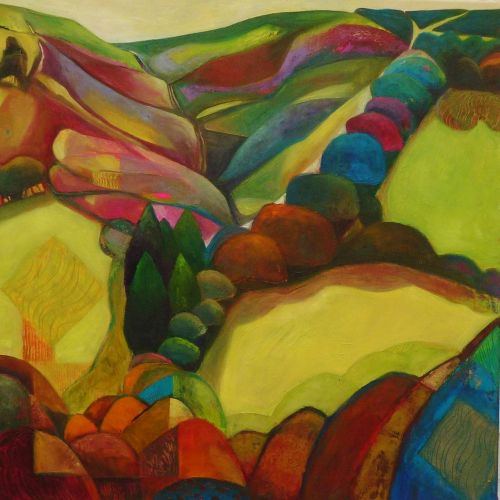 This recently found file reminds me of the frustration of not going to Exmoor during lockdown! |
Fri, 15 May 2020 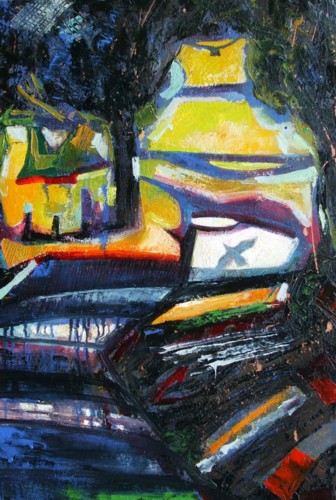 |
Thu, 28 Nov 2019 After Christmas I'm going to take my students through a portrait painting project. In particular we're going to study the portraits painted on coffins in Roman Egypt - the faces are stunning; looking at them gives me the feeling that I'm shaking hands with the past. This painting was painted in approximately AD60 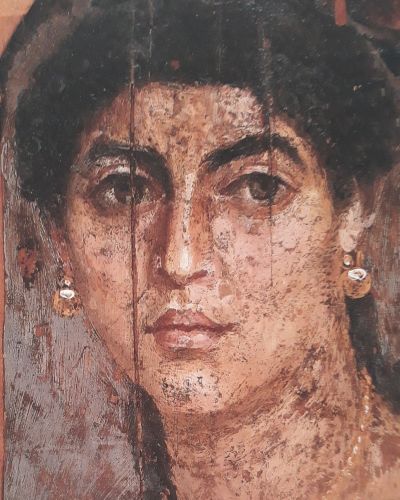 |
Wed, 27 Nov 2019  Sunrise through my shed this morning. |
Thu, 14 Nov 2019 A sample of a project for my students, balancing crisp watercolour with loose watercolour... 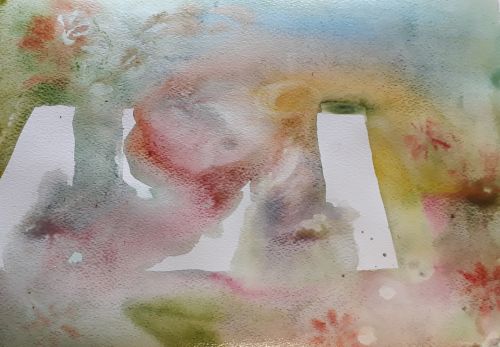 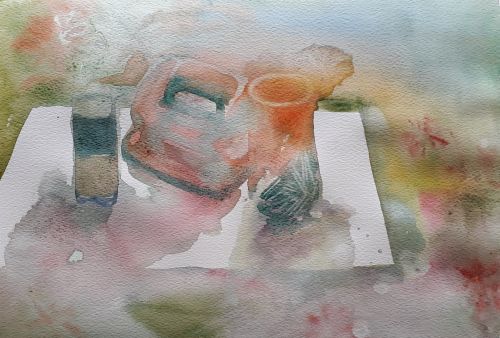 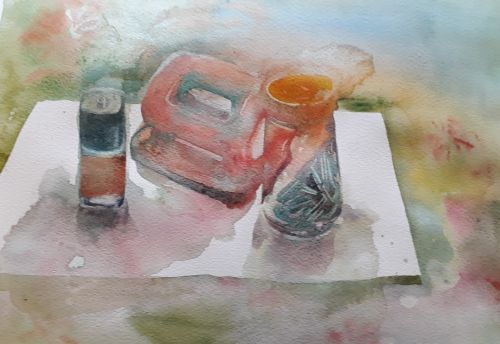 |
Mon, 11 Nov 2019 ...and here is the work I have in the Young Gallery in Salisbury until the end of November... 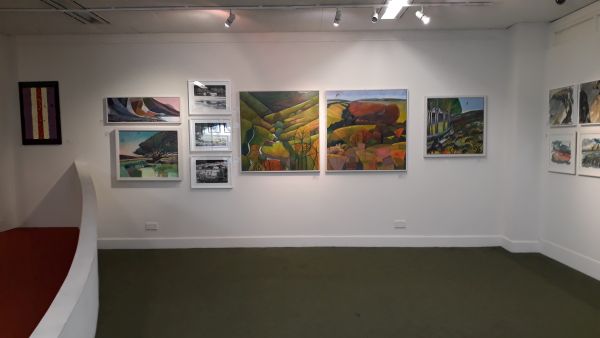 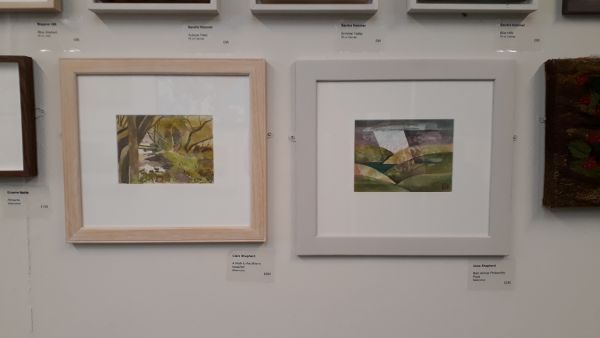 |
Sun, 10 Nov 2019 I have work in two mixed shows at the moment, one in Shaftesbury (Dorset) and the other in Salisbury (Wiltshire). Here are two images from the Shaftesbury show. Tomorrow I'll see the Salisbury show and post images. 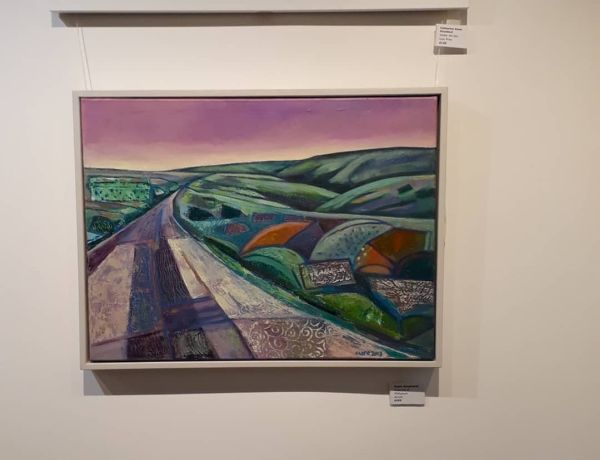 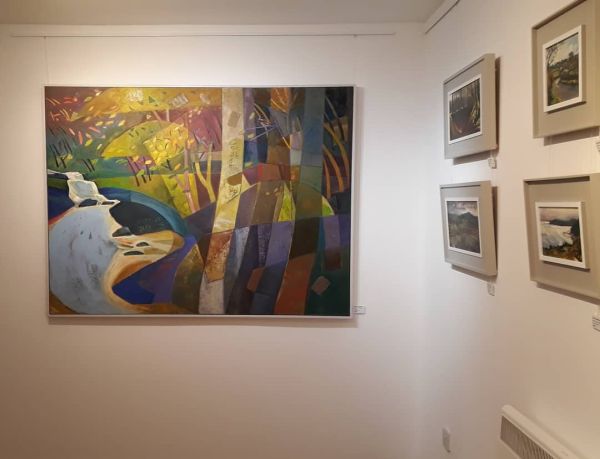 |
Thu, 07 Mar 2019 A wonderful morning on Studland Beach - a welcome birthday present, a beach ride. 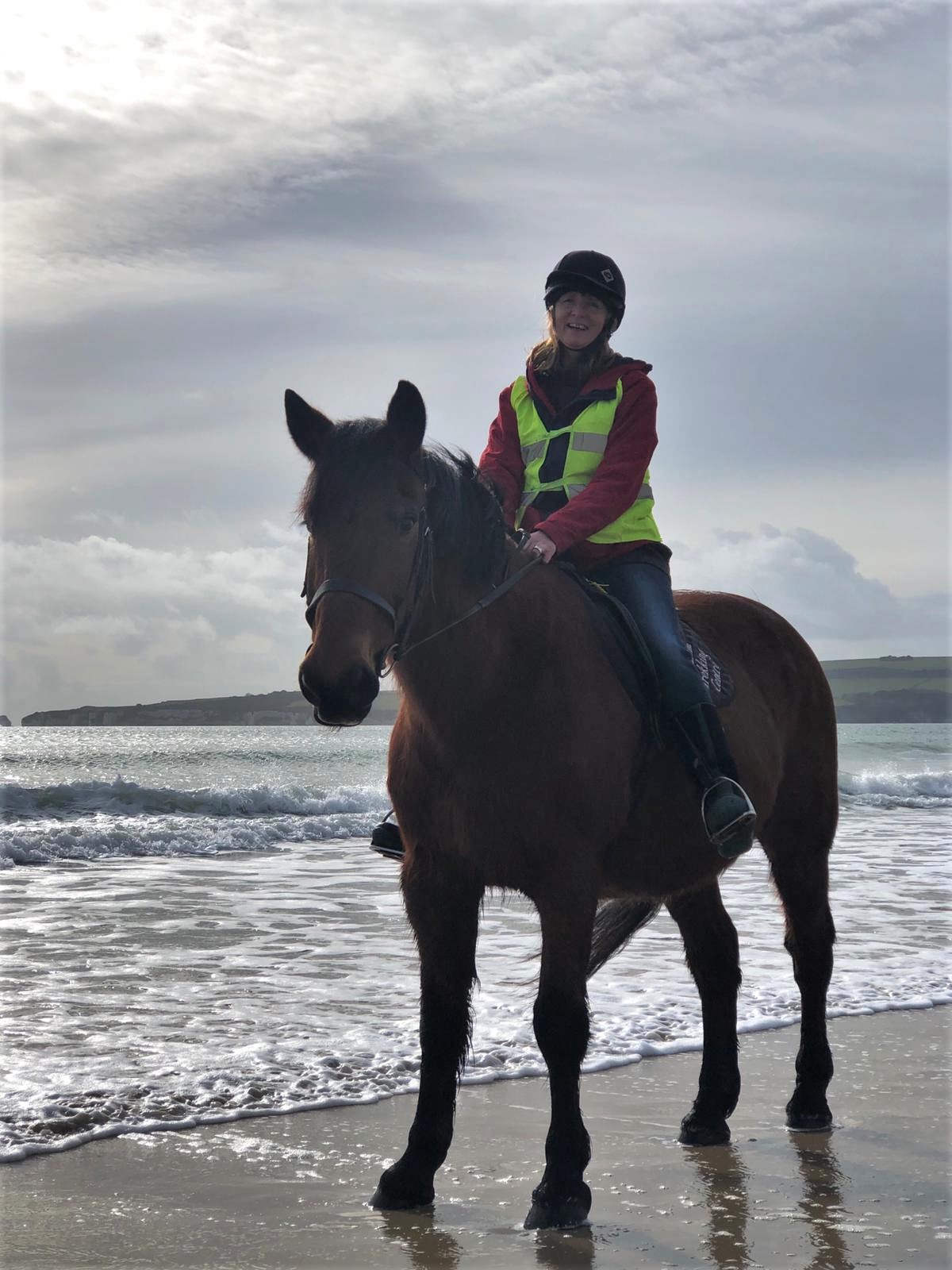 |
Tue, 27 Feb 2018 Some of the work currently on show at 54 The Gallery, Shepherd Market, London W1J 7QX. Phone: 020 7491 7322 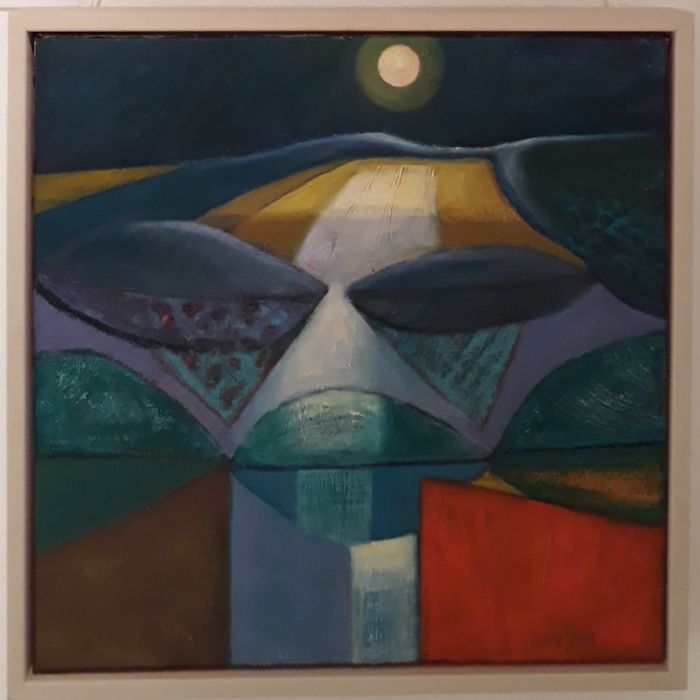 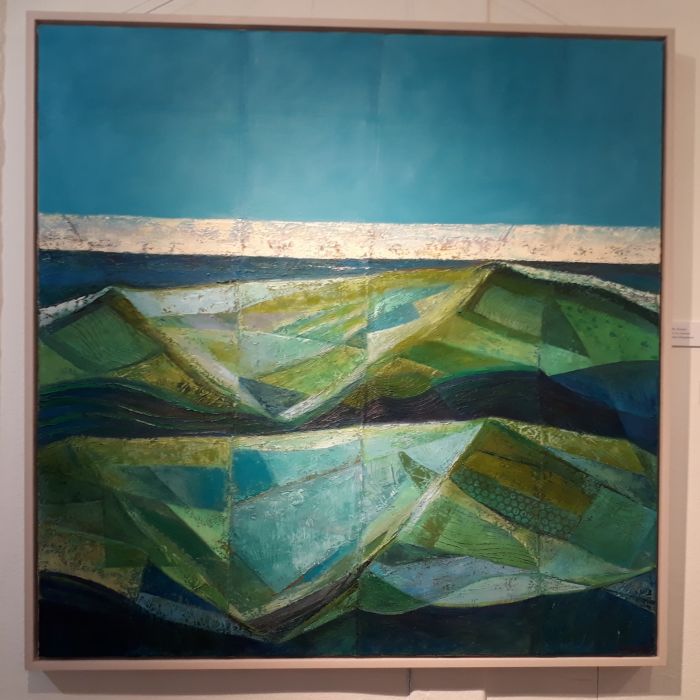 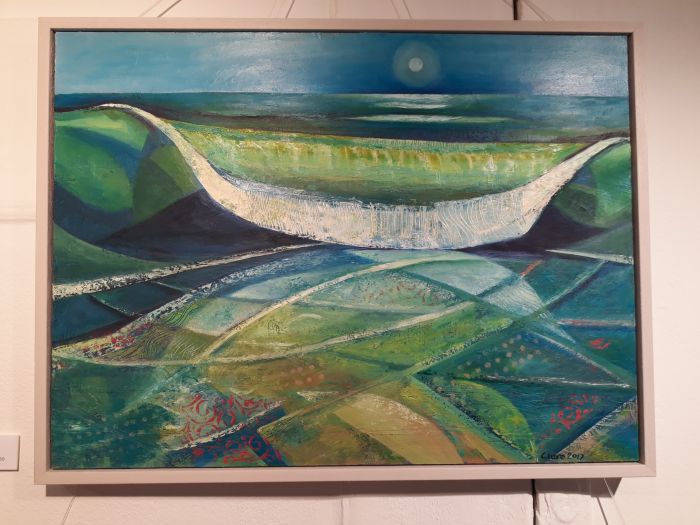 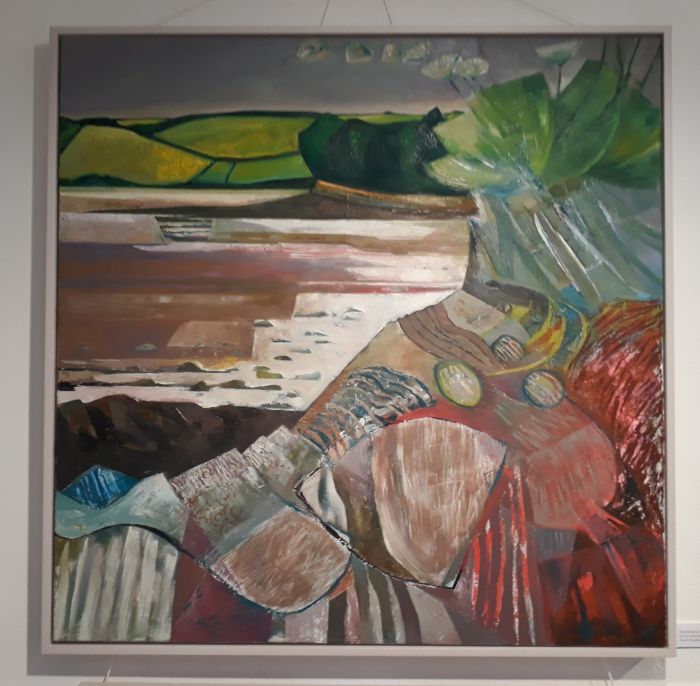 |
Fri, 23 Feb 2018 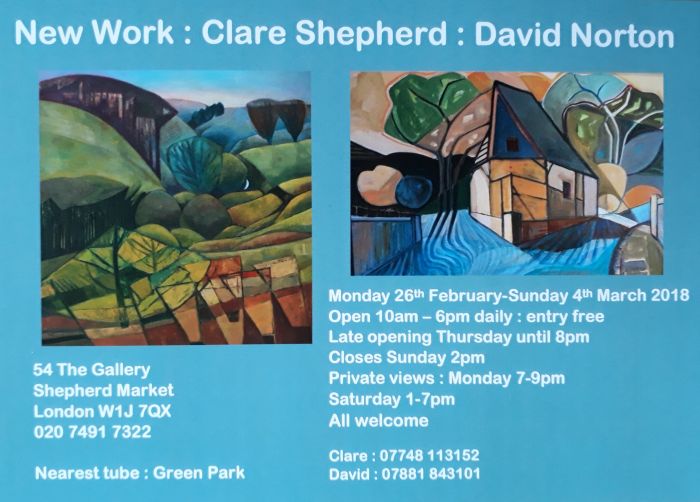 Exhibition invite and details! |
Thu, 22 Feb 2018  Exhibition, next week, all welcome! 54 The Gallery, Shepherd Market, London W1J 7QX, 020 7491 7322 . Open Monday 26th Feb - Sunday 4th March 2018. 10am to 6pm. Closes at 2pm Sunday 4th. |
Thu, 02 Feb 2017 Just heard on the news that there's been a 5% drop in university applications and one of the reasons is a significant drop in applicants to nursing degrees since the nhs bursary was scrapped. Nursing degrees are different from normal university degrees because student nurses spend 50% of their courses working on wards. Because of this they don't have long university holidays -meaning they have little or no time to earn extra money. I know this as my daughter was a student nurse. My sons did ordinary degrees and both worked during holidays (and during term time too). Many student nurses are older than the average student age and have responsibilities which mean becoming a student without some sort of support like the old nhs bursary makes it impossible to do. It seems we'll continue to have a shortage of nurses in the nhs and post brexit will need to keep immigration up to fulfill those shortages. |
Sun, 20 Nov 2016 My daughter and her partner have bought a house, a three bedroom council house in Nottingham. It's something I had thought would be impossible -an insurmountable problem facing young people these days but I'm utterly amazed that not only have they done it but they've done it at a younger age than we did. But the added cost, over and above the price is that if they have a family we shall be a long way away...however not as far as from our son and his wife in Japan. I'm sitting in the house now, a 1930s ex council house on a quiet leafy estate set away from the road and reached by a lane, a house with a big old fashioned council house garden. I'm full of wonder as I watch the houses around us turn on their lights and come to life, thankful and grateful that this is the situation. My daughter and her partner both work hard -many people work hard and deserve as much. The benefit of my daughter and partner's work is that they can take it to areas of the country where property prices are cheaper. I can't see how London can avoid a cataclysmic exodus of key workers unless the lack of affordable housing is addressed. The ticking time bomb as I see it is that as their generation grow old, those who haven't managed to buy a property own no asset to set against later care costs. |
Fri, 14 Oct 2016 We're all in this together... UK, US, Russia, Saudis, Iran, Iraq et al. Shamed. All of us. https://theintercept.com/2016/10/10/u-s-and-u-k-continue-to-actively-participate-in-saudi-war-crimes-targeting-of-yemeni-civilians/ |
Fri, 09 Sep 2016 A new discussion in parliament and on all the news programmes...to reintroduce new grammar schools in order to 'give parents choice'. I like to use the school dinner queue to illustrate how choice works. When I was at school (a girls' grammar school coincidentally - I was a 'free school dinners' child too) we had a system of a school lunch, you had what was provided and ate it. After a few years a new canteen introduced 'choice'. If you were at the front of the dinner queue you had an amazing choice of food for your lunch...not so at the back of the queue, you had what was left over. The great thing about a dinner queue is that one day you might be at the back but the next day you could well be at the front. Not so with schools...it's the school you end up in for the bulk of your education. In order to introduce 'choice' for everyone, you would have, by necessity, to introduce WASTE. Think again to the dinner queue, enough of every choice must be available all through -therefore bringing about the leftovers at the end that have not been 'chosen'. Choice is a myth or a waste. Take your pick. In every sentence Justine Greening spoke on the radio this morning in support of new grammars, she inferred the failure of most of the comprehensive schools in this country today. Our bog-standard local authority comprehensive school had some of the best English results in the county which stand up well against nearby public and grammar school results...and that's a school which hasn't creamed off the top 15/20% of kids for an 'academic' education. Some honest research should be done as a matter of urgency into education systems in other countries which use extreme selection. The really unfair selection process (and it can't be denied, however you feel about it) is selection by money. Here I draw a blank as to what to do about that -money will always sift those who haven't from those who have. It's a struggle for many to swim against that current. But how else do you allocate limited resources? |
Thu, 17 Mar 2016 My lovely dad died in January and it's knocked the stuffing out of me so I'm glad that I'd made the decision even before he died that I would do no exhibiting this year, just paint. 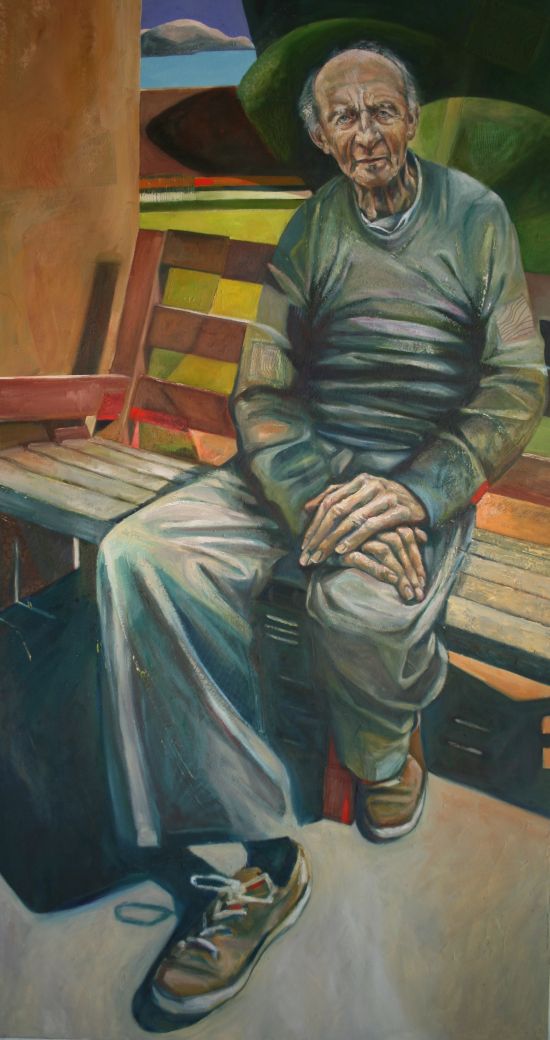 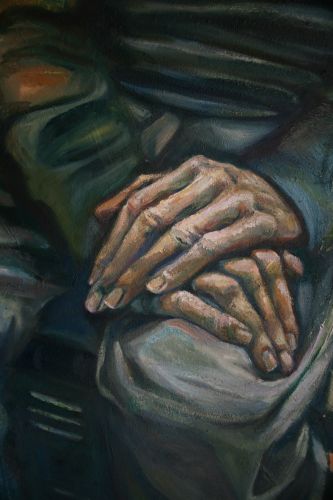 I've also been working on a new website on which I post each week's art lesson for my various classes. It's open to the world although I primarily post so that any of my students can catch up on missed lessons or get a sneak preview of upcoming lessons. They can also see examples of other students' work as I post a selection of work from each project. You might have to copy and paste the website address below to see it, or you can click on the live link near the bottom of my homepage. http://clareshep.wix.com/weeklyartclass |
Wed, 15 Jul 2015 As my son's favourite book ever is 'To Kill a Mockingbird' I asked him (as he lives abroad) how he was going to read 'Go Set a Watchman'. He told me first he was very anxious about reading it because of his feelings for 'To Kill a Mockingbird' but that he had actually bought the e-book and in fact read 'Go Set a Watchman' already. The following is his review when I asked him how did he feel about it: I'm not sure how I feel about it. I realise that the Atticus who appears here is an earlier iteration of the character. But the great moral of mockingbird was his line that "you never really know a person until you climb inside their skin and walk around in it". That was, when it came down to it, the whole meaning of the book (and it may be an obvious lesson but it's one that 99% of people fail to take to heart 99% of the time). But that's the one that Watchman Atticus completely fails to do. So that enraged me. He utterly fails to consider the situation from the point of view of anyone else. And this is the character that, in mockingbird, was able to try and empathise with the drunk, violent racist who pinned a capital crime on an innocent man and possibly beat his own daughter. On the other hand the writing (especially anything from scout's point of view) really sparkles. A lot of the book is really funny. |
Thu, 09 Jul 2015 On the one hand we have an article like this https://www.thestage.co.uk/news/2014/education-secretary-nicky-morgan-arts-subjects-limit-career-choices/ and on the other hand an article like this... http://www.bbc.co.uk/news/entertainment-arts-33344326?SThisFB I've put these links into my blog unsure as to whether they'll work so you may have to copy and paste! |
Thu, 04 Jun 2015 My cactus has a flower!!! 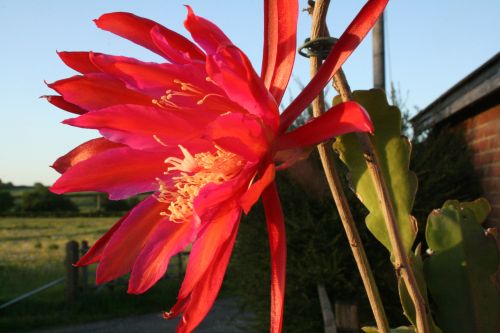 |
Thu, 21 May 2015 Frustration as our house is no.82 but only one other house (no.83) next door leaves delivery companies confused and me seething as I see their vans drive up and down the lane but drive away before turning into the farm track at the bottom of which is a signpost with our address clearly on it. They just don't expect nos.82 & 83 to stand alone! The postman always knows where we are...I wish everything came through the postal service. 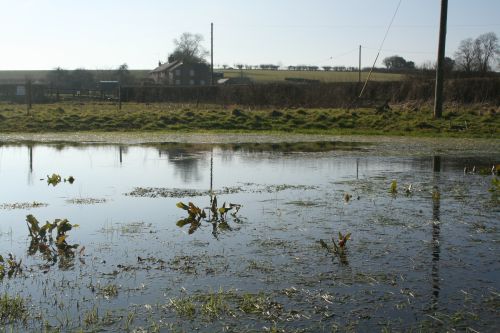 Nos. 82 & 83. |
Wed, 13 May 2015 A lovely evening in Dorset 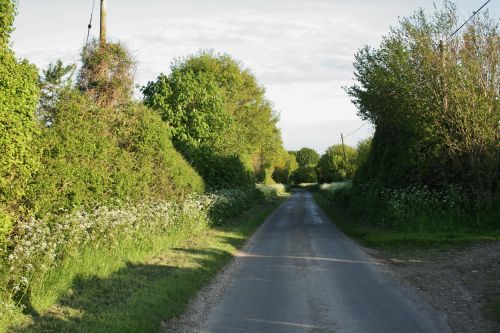 I went out on my bike 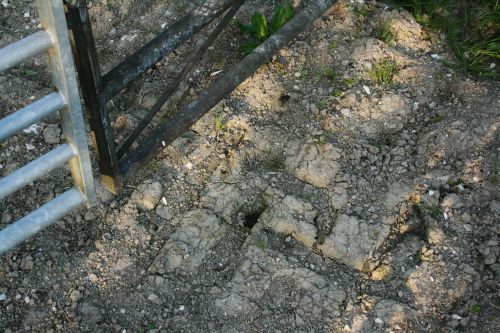 which means crossing fields and following muddy tracks as well as riding the roads  the oilseed rape is up everywhere 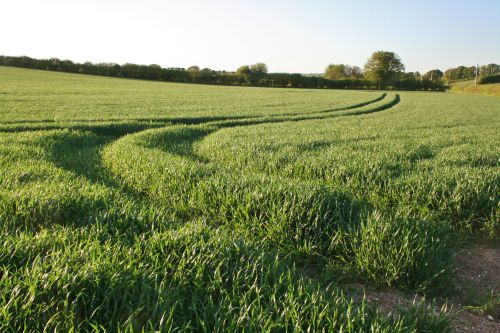 and the wheat is on its way. |
Sun, 10 May 2015 I'm painting my dad. 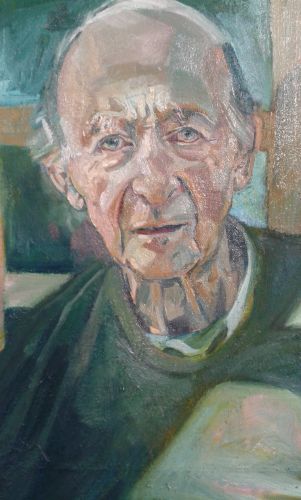 *** I helped one of my lovely students, Lupita Zamora de Aish, put up her lovely exhibition and ... look what I got! 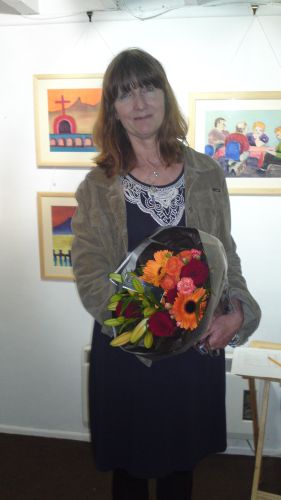 Here they are at home delighting my heart and eyes! 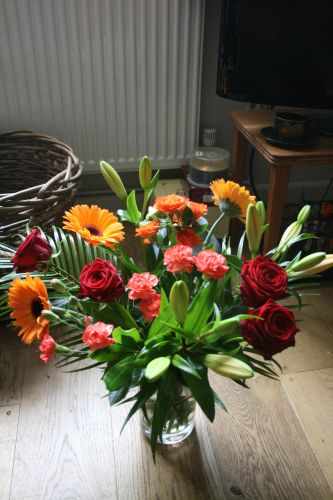 |
Sat, 09 May 2015 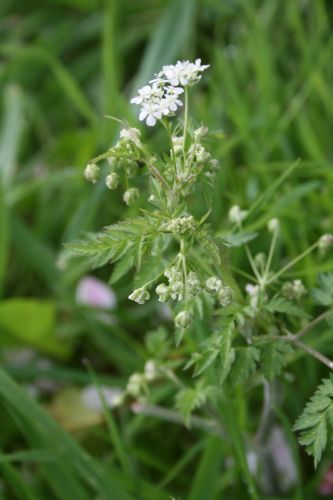 I love it when Simon doesn't mow the garden for ages...we find a mass of dandelions and dandelion clocks... 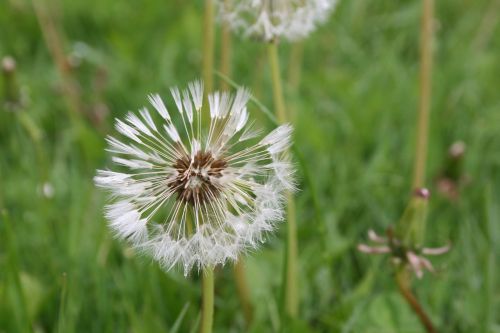 ...these little purple flowers coming up everywhere... 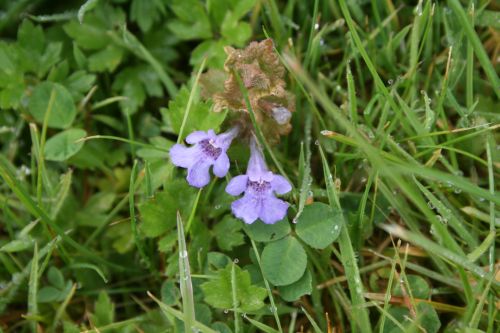 ...masses of cowslips, more every year... 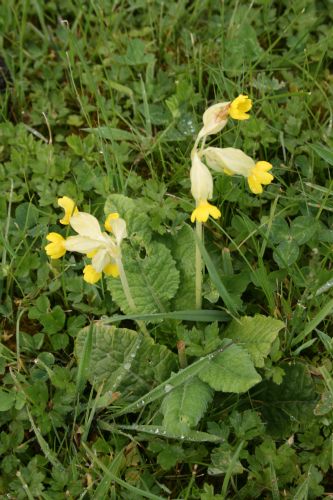 ...cow-parsley under the apple tree -the plant that makes me homesick when I'm away for long periods of time...(see picture above) ...clumps of ox-eye daisies emerging... 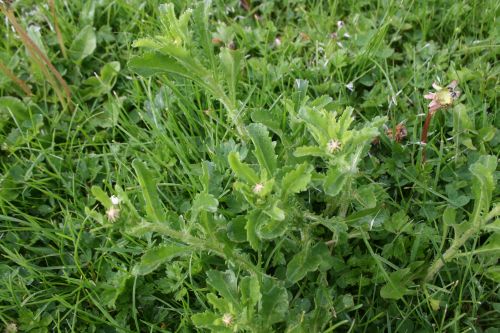 ...and piles of discarded seed heads where the Goldfinches have been eating the dandelionn-clocks! 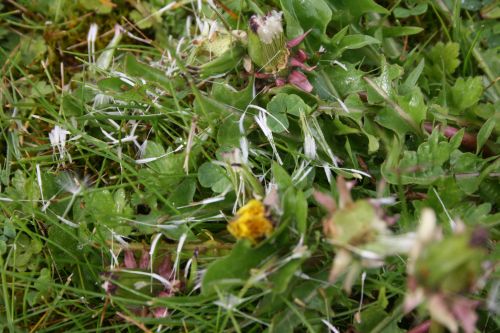 |
Thu, 07 May 2015 It was another extraordinary flight home from Japan over Siberia. Since the law changed a couple of years ago aircraft have been able to fly outside the 1000 mile range from the nearest airport which means that we flew much further north just clipping the Arctic circle and flying north of the Urals. 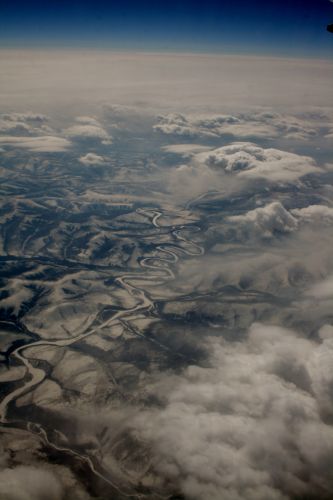 This was the first time I'd flown at Spring time rather than winter, so although Siberia still looked frozen solid in most places, every now and again I caught glimpses of rivers glistening in the sun as the ice looked on the brink of flowing. 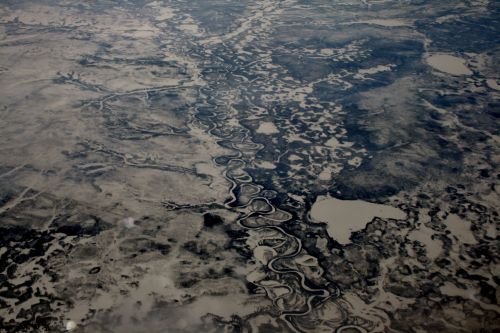 Even the defrosting rivers didn't make Siberia look remotely or conceivably hospitable. Rarely did I see signs of humanity...until this... 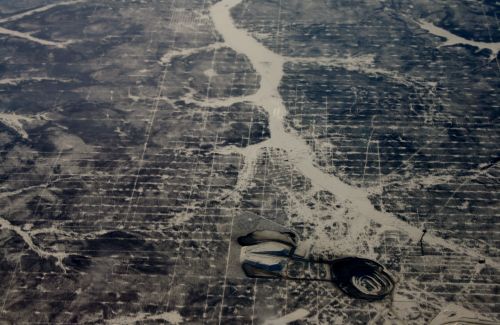 The further north we reached, the deeper the snow became until I saw deep gorges whose depth I could discern because the tops of the mountains appeared to move faster than the depths. The photograph doesn't make clear how deep these gorges actually must be. I saw land mass edges barely visible under deep snow, and occasionally I saw roads, railways and what I think were cuttings for electricity pylons. The most enigmatic marks were the grids around the open mines -what looked liked miles and miles of track that I really couldn't work out at all. 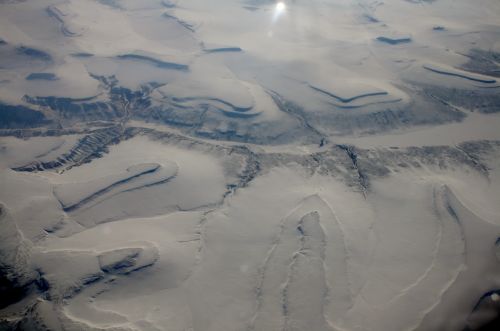 |
Wed, 06 May 2015 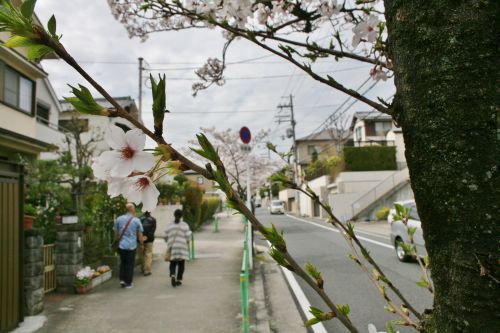 Wolf Hall on the TV was amazing but equally amazing was the Wolf Hall production at The Aldwych Theatre in London. The set looked like polished concrete with a cross of light cut into the end wall -imagine my surprise when I discovered it was based on a Church in Osaka called The Church of Light built with polished concrete and with a cross cut into the end wall. 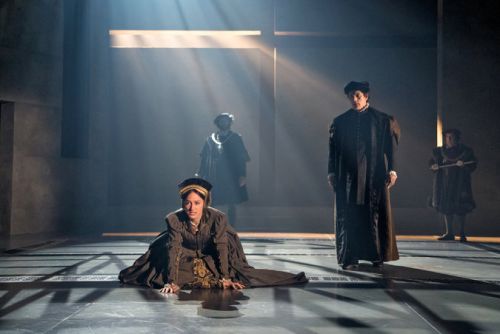 The church was built by an architect called Tadao Ando for a Christian community with enough money to build the church without the roof. The construction company were so impressed with the design, the architect and the community that they built the roof for free. 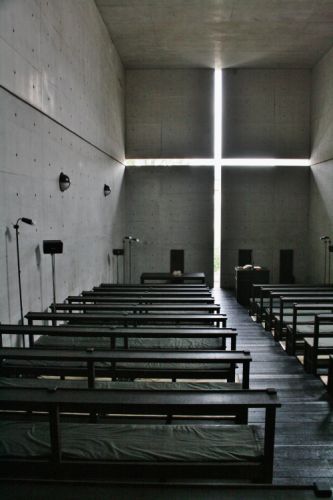 The walls were made of reinforced concrete dense enough to create the sheen. The wooden scaffold used while making the walls was taken down at the end and reused for the internal furniture, black-stained plain wooden pews. 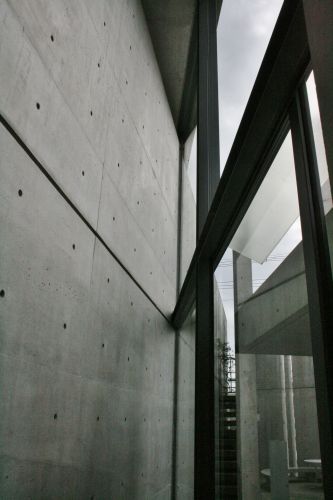 Our son lives in Osaka so on our most recent visit to him it felt like we were honouring a sort of devotion to the church, the play, the architect, the Christian faith and the lovely uncluttered Japanese way in their homes and temples by visiting the church. Actually, some temples are uncluttered and orderly, spaces for thinking rather than looking, but some are abundant with decoration, huge golden Buddhas, statues, lanterns and more!  The Church of Light sits on the corner of a quiet residential street and when we were there the cherry trees were in full blossom. |
Mon, 09 Feb 2015 Today I went on a 'Bodies of Water' walk. It was such a lovely sunny day -wrongly predicted by BBC weather forecast, I thought I'd go and see how the water levels are this year. 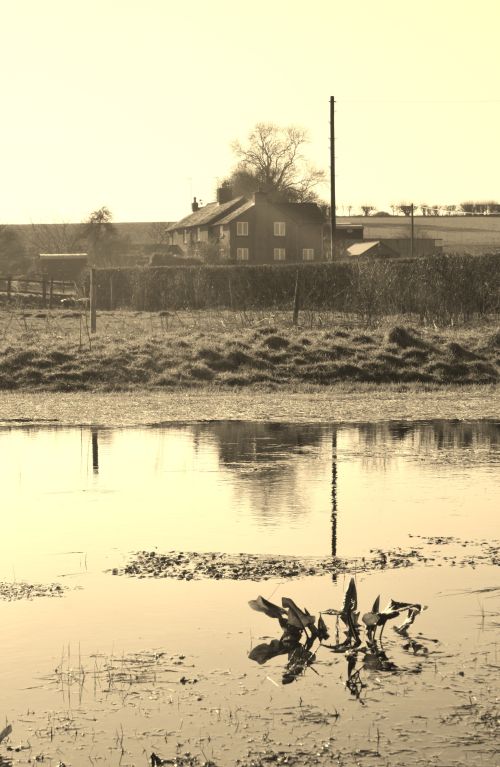 The winter pond -at the level I would expect. Last year the high water levels were unprecedented, at least in the 26 years we've been here. It's better to see the levels where we'd expect them. 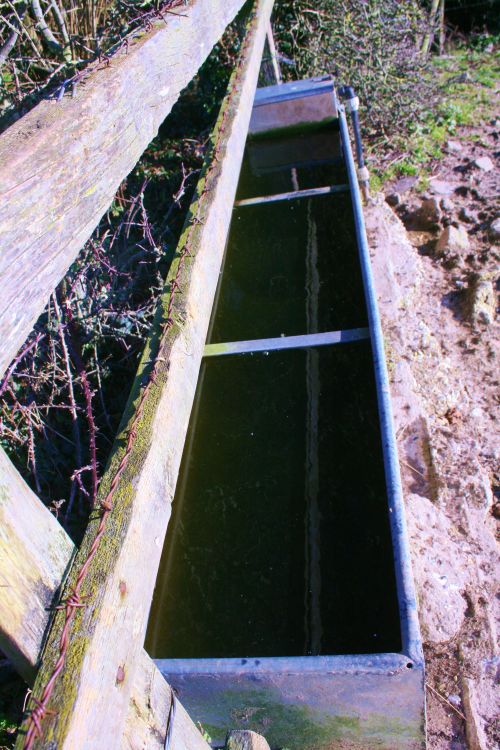 This water trough reminded me of Richard Wilson's oil installation at The Saatchi Gallery...smaller scale but equally mysterious. 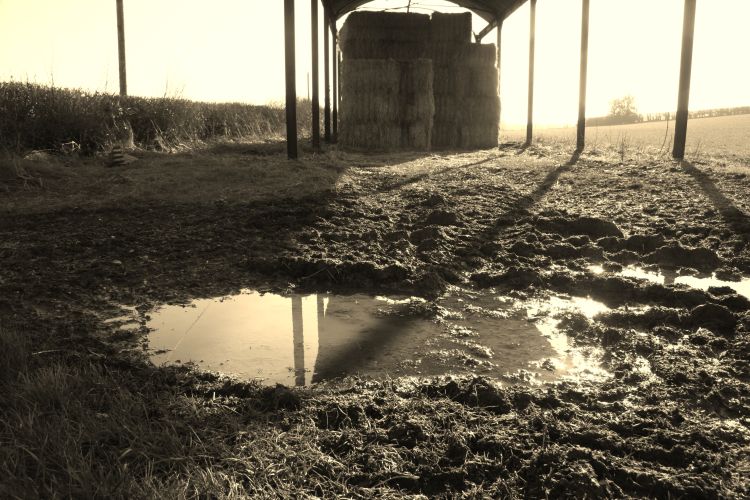 Mud and puddles, barns and sunshine -best places for kids to play. 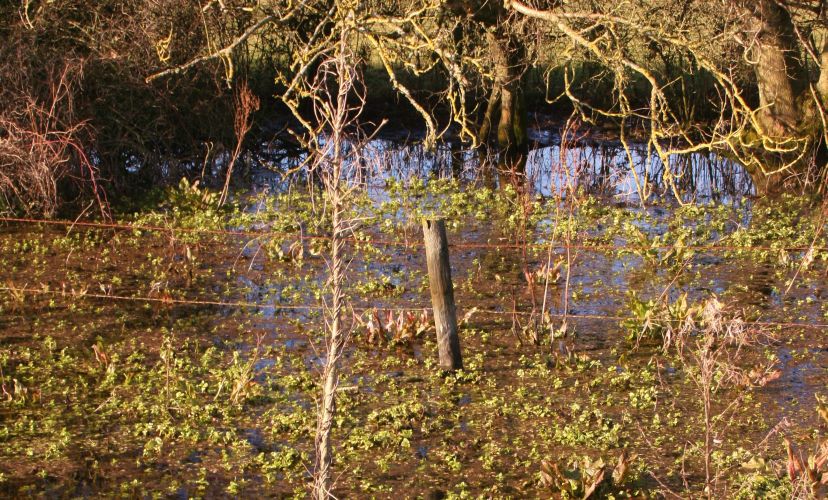 Springs come up all over the place at this time of year -this one is a regular and is also the place to pick the best blackberries at the other end of the year. |
Wed, 14 Jan 2015 So why do we paint? I need to dig uncomfortably deep to both work it out and then describe it. I’d happily shut myself away in my shed and paint for the sheer enjoyment of the process and the feeling of fulfilment and completion it gives. I frequently ask myself how can such a narrow collection of implements and substances –brushes, canvas and paint, used by so many people through generations, be so comprehensively satisfying as a means of…of what? Is it to ‘express’ oneself? Is fulfilment achieved in working with a significant image? or in applying paint to the canvas as practical recreation? I note that the word ‘recreation’ is a composite of ‘re’ and ‘create’ tying in nicely with the notion that a painting is an artist’s re-creation of a place, an experience or some wisdom they’d like to impart. What have we established so far? That people paint. That people who paint have experiences or wisdom that they wish to do something with. That people who paint choose painting as the most relevant option to do that something with. That the something is sometimes called ‘expressing oneself’. In a framing shop recently the framer was telling me that an artist about to present an exhibition had said that if she didn’t sell enough of her paintings she would give up painting –this was her last chance. She was painting for different reasons. She was creating a product for a purchaser, conscious of what the purchaser might want to buy. The value of her paintings were the prices that a buyer might pay for them; in their creation she was accommodating an outside force, not a need to recreate her own experience or express some acquired wisdom. Van Gogh is known as a great painter. Whether or not he was great is immaterial. Whatever he thought himself to be he was not going to stop painting. He may have desired to be seen as ‘great’, he may have felt himself ‘great’ but being unrecognised as ‘great’ in his lifetime didn’t stop him expressing himself through his painting. ‘Greatness’ is an odd term in relation to painting because the painting will continue despite recognition (or not) –and this is very hard for an outsider to understand in world where things are measured by their monetary value, like the artist who was about to give up if she didn’t sell enough paintings. Painting for Van Gogh came from the need to find an expression for things he felt deeply inside himself –which could be as practical as noticing and understanding the perspective of a chair or expressing the feeling that a wild and stormy sky over a wheat field invoked in him. Like Van Gogh, the content of my work has nothing to do with anything that hasn’t had an alchemistic effect deep within me. As Albert Einstein said ‘The most beautiful thing we can experience is the mysterious. It is the source of all true art and science’. The process of painting feels like a self-driven learning, a process through which those things we see and feel are tussled with, experimented with, negotiated with and brought out into the world as a representation. It is not a desire to be recognised for ‘greatness’ that drives an artist but more to be able to present something that might resonate with the viewer’s inner life. Now we come to teaching. ‘If you can’t do it teach it’ I heard recently. A lazy quip made by someone who couldn’t think beyond trotting out an old cliché. Lee Iacocca, engineer, philanthropist, writer, and generally influential thinker had another view. He said ‘In a completely rational society, the best of us would be teachers and the rest of us would have to settle for something else.’ In the teaching of art, a teacher’s aim is to lead the students to the place where they are able to mine their own inner wealth. For the student it’s not a game, or a race to greatness. It’s not a journey with a fixed outcome or a definable monetary value. It is a path to discovering what makes you think and how then you might express that in a piece of ‘art’. What is it we want for our children? Good teachers. Teachers who can both ‘do’ and ‘teach’. How can a teacher who can’t ‘do’ teach? What would they teach? Teaching is a two-way highway. The teacher leads the student to the subject, the student helps the teacher to think about and understand their subject in the disseminating of it. Both teacher and student glean from each other. Particularly with art teaching it becomes a collaboration in which understanding is gathered on both sides. Jiddu Krishnamurti said ‘Real learning comes about when the competitive spirit has ceased.’ It is important to lose any notion of competitiveness when making art. Mine deep into the marrow of your own bones, forget the outside world until you present your art, forget ideas of ‘greatness’ which will only hold you back from attempting the process of expression and maintain your integrity in your work. Don’t hesitate to experiment –how else can you learn? You don’t need to be repetitive in your work, find many ways of saying what amounts to the same thing or alternatively say lots of different things. Art is available to everyone –it takes a really good artist and teacher to lead them there. |
Tue, 18 Nov 2014 Why do I believe Winslow Homer was the best painter in watercolour ever? 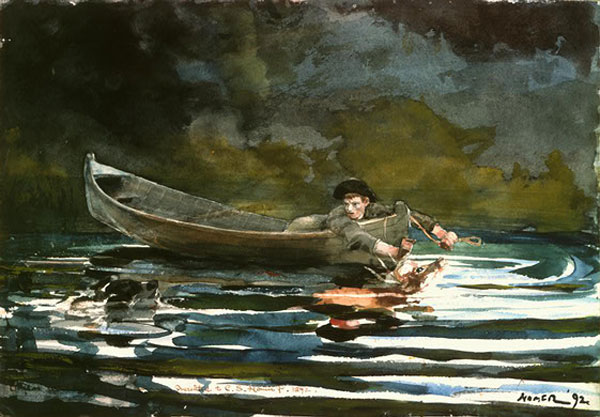 Is it because he leaves the lightest places white? He's absolutely clear on what shape they are and where they sit within the page boundaries. Is it because he builds up his tones in layers without losing the transparency of his paint? -the darkest tones have the greatest number of layers. Is it because he simplifies many areas and leaves detail only for those places that need it? I was looking at some of his paintings, quite spellbound by the ease with which he manages to leave such significant light places and always effortlessly in the right place when I came across some drawings...and something huge dawned upon me...what was it? 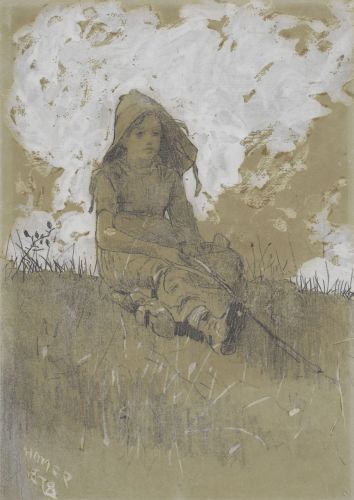 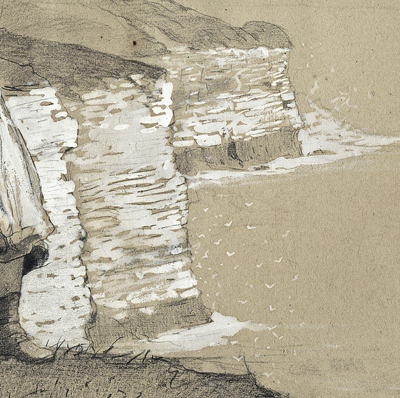 These, and many other drawings, were made specifically for him to work out exactly where the lightest places would be. He made these drawings in order to establish precisely where he would be revealing his lightest places and exactly what shape they would be. Be warned any of my students reading this...we are soon to embark on a project based on the way Winslow Homer drew for watercolour! |
Sun, 24 Aug 2014 I’ve seen three exhibitions this summer; ‘Making Colour’ at the National Gallery, ‘Virginia Woolf, Art Life and Vision’ at the National Portrait Gallery and an exhibition called ‘Back from the Front’ at Royal West of England Academy (RWA) in Bristol. Within the ‘Back from the Front’ exhibition was a two-room collection of work (not war work) by Paul and John Nash ‘Brothers in Art’. Seeing Nash paintings in the flesh has a few major revelations and many small ones. They both knew how to use watercolour and did so supremely well except that neither of them had the confidence to use it without pencil –and where, in the earlier watercolours, they used pencil as boundary markers for the lines within which they wanted to paint, those pencil marks reduce the clarity of a watercolour edge. A watercolour by John Nash, made in 1969 and called ‘Penwalk Cove’ shows that when he uses a minimum of pencil line is when he creates the clearest shapes with the crispest edges. In it he built up tones by adding translucent layers, he was clear about his lightest places –they remained white, unpainted, the white of his page -and the painting is a profoundly satisfying composition. Without all the analysis, it’s a lovely painting which evokes all the feelings you have when you sit beside the sea and watch waves crashing. 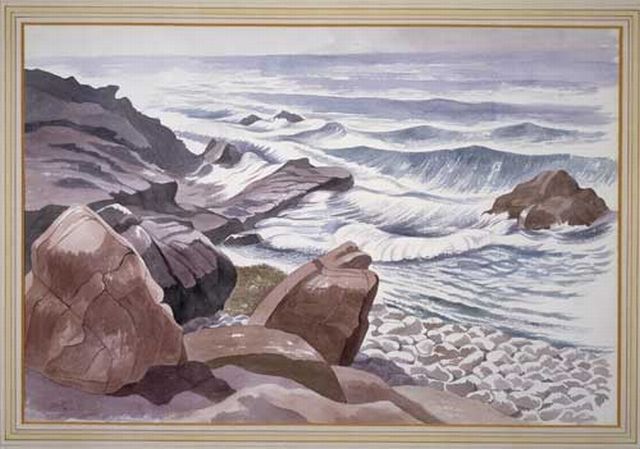 I was surprised to see what was apparent with so many John Nash paintings in one place, that he took risks including placing key elements absolutely central in the composition. In ‘Penwalk Cove’ one large rock sits central in the lower third of the painting. In ‘Wild Garden, Winter’, 1959, John Nash places his foreground element almost from top to bottom along the central line of his page. This is another watercolour with an exquisite use of left lights. All the light places in this complex composition are un- painted, they remain the white of his page. If you look closely though there are fewer whites than you might think initially –you can find the subtlest of tones on the snowy areas. Most wonderful are the slender trees against the dark barn –from the ground up, they are dark against the light snow, across the barn they are light against dark and in contrast to the snowy barn roof they are spare and willowy darks. It is a complex painting but nothing is slick or overstated, nothing is a trick with the brush and colour, everything about it is a clearly and carefully seen construction executed with honesty and loyalty to the exacting medium of watercolour. 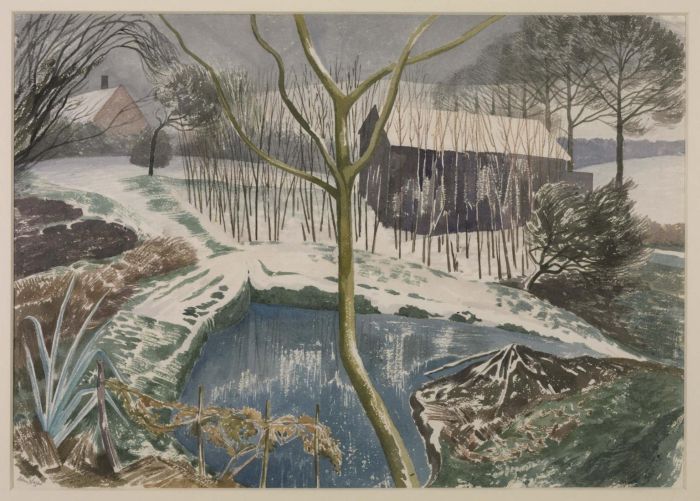 Paul Nash studied for a year at The Slade School of Fine Art in London but he advised his brother not to study at all. John Nash remained self-taught. Both brothers served on the WW1 front line, John for longer than Paul who was injured. Both became war artists working alongside combatants, both produced memorable work and both were appointed official war artists again during WW2. How did it influence the work they made outside the war years? Paul became interested in those things which have marked the landscape across millennia, both man-made and natural landforms. It’s a guess, but I wonder if he needed to find something which even war couldn’t expunge? Something more lasting than man’s powers of destruction? His ‘Landscape of the Megaliths’, 1934 and ‘Eclipse of the Sunflower’ 1945 are both testament to his interest in more than just the landscape itself. Paul Nash died in 1946 of heart failure linked to his asthma. He was in Dorset visiting some of his favourite places.I’ve given up reading the little write-ups beside each painting. I’ve decided 1. They’re a load of tosh and 2. They stop me looking at a painting and making up my own mind about things. Proof that what they write is tosh is clear in the description of John Nash’s painting ‘The Edge of the Plain’ as having a ‘snow covered hill on the right’. Look at the painting. If any of you have lived on or near Salisbury Plain or come from a chalkland area (as I do) you will recognise the chalk path in the painting a third in from the left. The chalk path curls around the lower part of the hill in three or four streaks of white. Note also the fully leafed trees and bushes throughout the painting –clearly not winter! And now all of you from chalkland areas will see that the ‘snow covered hill’ is actually exactly what a ploughed field on a chalk down looks like. This wonderful painting shows the risks John Nash took in constructing his skies. He was prepared to give the clouds shape and form as though they too were landscapes with solid structure –he looked for the simplest and strongest elemental shapes to describe clouds in the sky. Note also the strong vertical element up the centre of the painting in the row of trees near the bottom of the chalk hill and how closely it aligns with branches at the bottom of the painting. 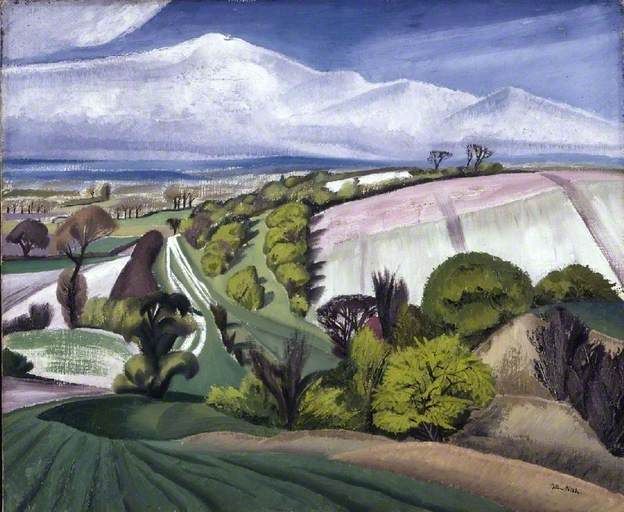 Very briefly –the Nash exhibition and the concurrent ‘Back from the Front’ with its various paintings by living artists of work made in response to war (Afghan, Iraqi etc.) far outshone ‘Making Colour’ and ‘Virginia Woolf’ which were both a bit too worthy and dull except for a Hans Memling painting which I bumped into in the ‘Making Colour’ exhibition. Deceptively simple clarity…need I say more? 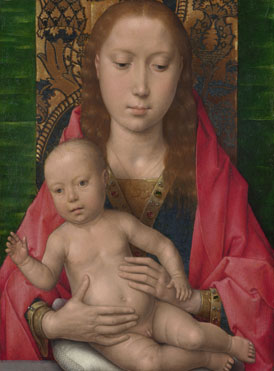 |
Wed, 23 Jul 2014 It's that time of year again - Chettle Summer School. I have an unusually quiet and focused group this year, or many of the same people as last year but in a very quiet and focused mood. Here are some examples as they are so far... 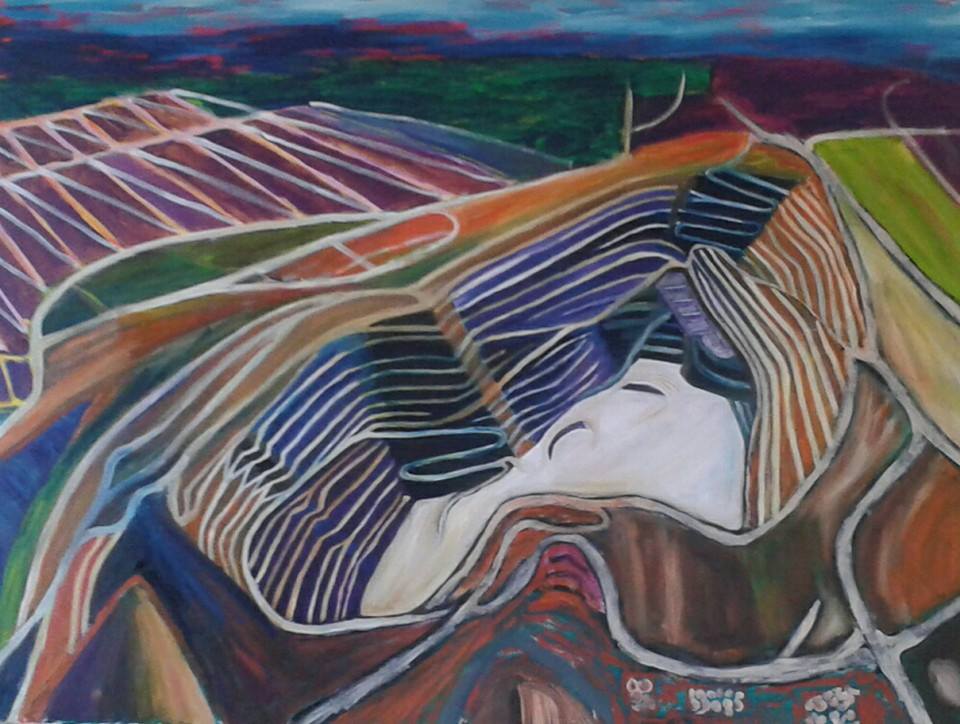 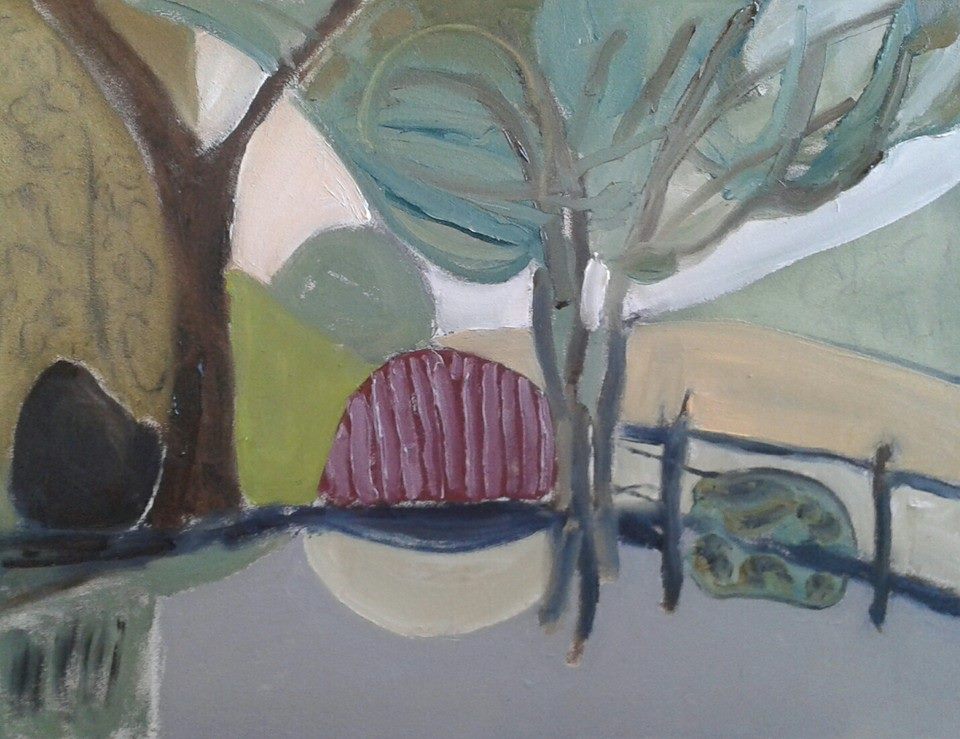 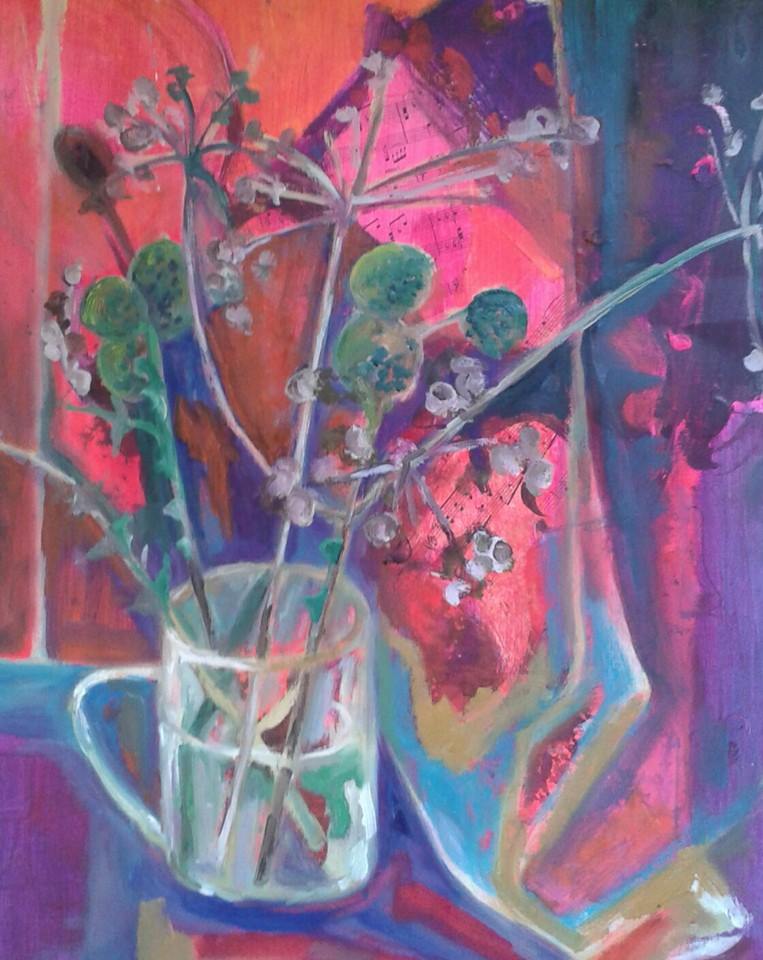 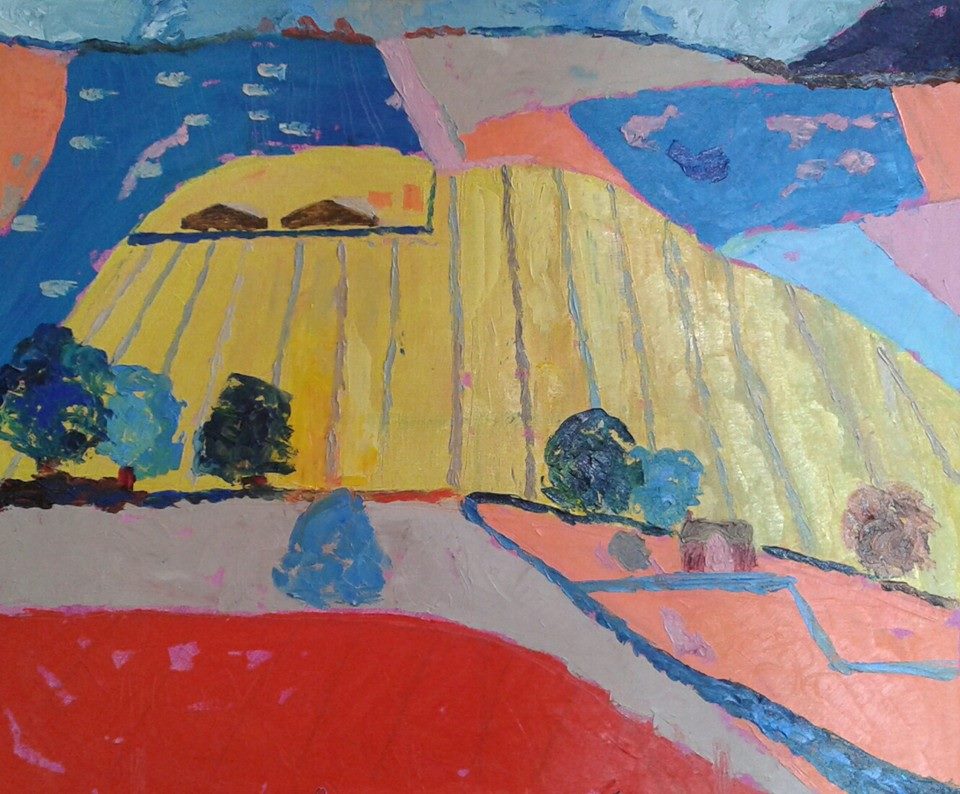 |
Sun, 20 Jul 2014 A week with my dad, doing something every day including picnics at Knowlton and Badbury Rings, has reminded me how utterly great Dorset's neolithic history is.  My dad is a little lame so trudging up Hod or Hambledon Hills would have been out of the question, but a picnic at Knowlton was absolutely sublime. Knowlton's grassy areas have never been controlled in any way with pesticides and so, where the grass is left to grow, is full to bursting with the wild-flowers that must once have inhabited vast areas of UK, and therefore rich in bee, bug and butterfly life -everywhere. Kowlton is a neolithic henge, built approximately 2500BC. The original church will have been built at a time when Christianity was trying to persuade locals to give up any 'pagan' practices or rather meld local practices into the Christian Church. 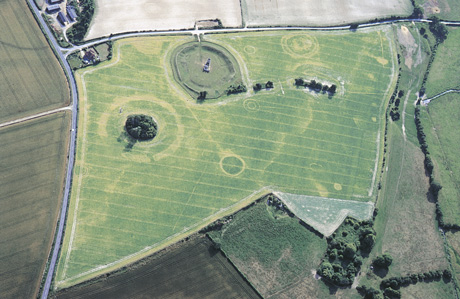 Above - Knowlton and a few of its surrounding earthworks as seen from above. The current church within Knowlton's henge is a Medieval ruin with some remaining Norman features. 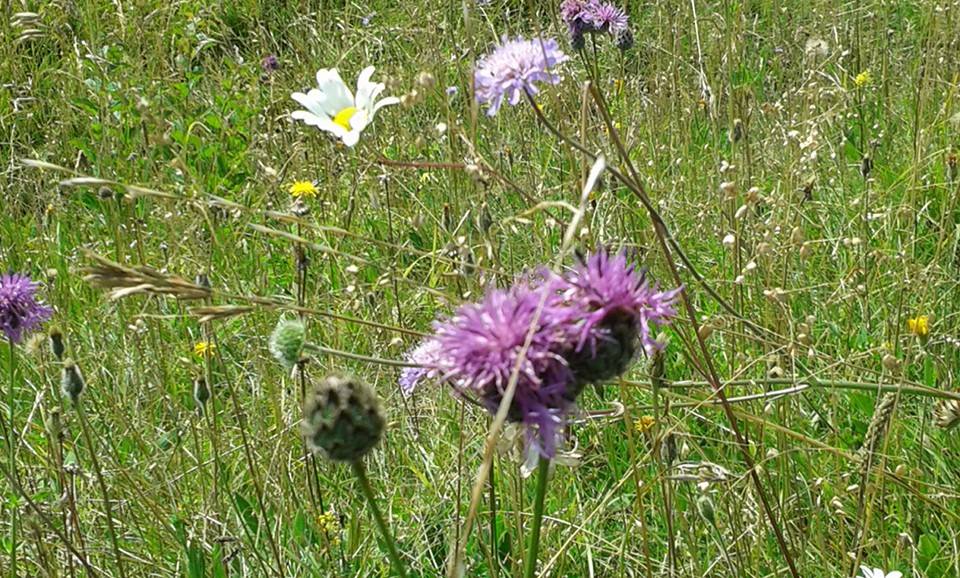 |
Tue, 15 Jul 2014 'Land of my Fathers' -Welsh national anthem...pah! Time for a 'Land of my Mothers' anthem for England. Within minutes of registering the fact that I'd given birth to a daughter (22 years ago) it was my mother, my grandmothers and my great grandmothers that I thought of and I saw them all as part of a great chain, like a Titanic anchor chain stretching back into the distance. The chain may be read as a symbol of confinement, subjugation, obedience, but the women in my past have been strong and full of character if perhaps accepting of their place, and I see the chain symbol as representing the unbroken path through the past via the women in my history. 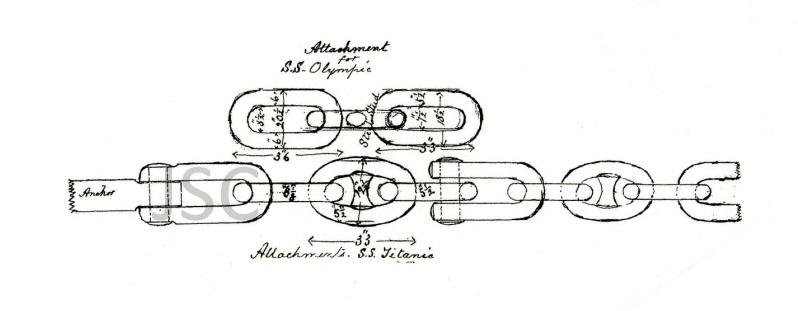 Titanic anchor chain link illustration. |
Thu, 10 Jul 2014 Things that made me happy today: 1. Watching my students making in depth studies from Piacsso drawings, immersing themselves in the task when in the past they might have been very sceptical. 2. Being told by the man in the glass shop that the corners of the frames I've made are 'the best' he's 'ever seen'...yup!! his words!! What a fine man! 3. Watering the plants. 4. Seeing my sister-in-law, nephew and mother-in-law when I didn't expect to. 5. Looking for the barn owl this evening (didn't see her). 6. Being sent pictures of my son in Japan. Things I'm not minding but do sometimes mind. 1. the ironing -I'm about to do it. |
Tue, 08 Jul 2014 So we've been looking at faces in class, proportions, positions, what happens when a face turns slightly or isn't seen head-on. We've negotiated with charcoal and chalk and then later with what I call a 'negotiating' paint -oil, acrylic or gouache. Now we come to the last lesson of this term and they have a 'fun' thing to do...you're hearing it here first people...I'm giving them sections of some Picasso face drawings to work from, with proportions and positions all over the place. They're going to draw from the sections they're given and then have to work their way around the room to see who's drawing the sections which attach to their sections. They'll then work out if they can fit their sections together to create the complete original Picasso drawing! 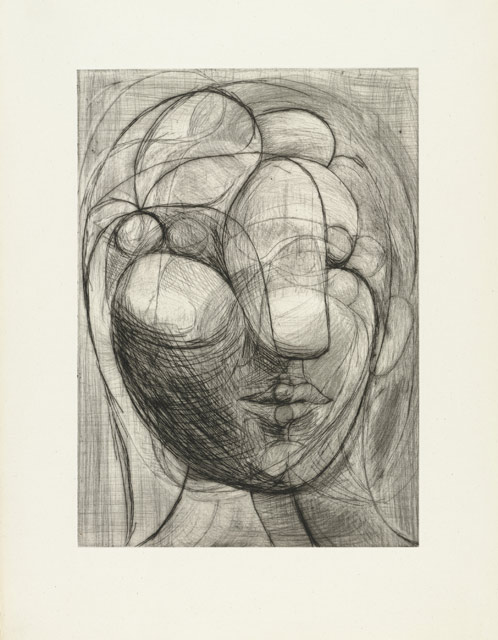  |
Sat, 05 Jul 2014 Sitting at the back of the garage at the end of a day painting, gardening, clearing out my gallery -I watch the sun setting through my apple juice. 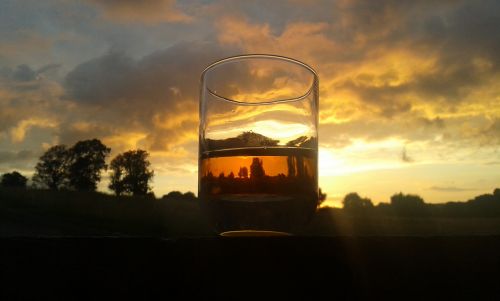 I hear pigeons everywhere and the odd squawk of a jackdaw. A barn owl is criss-crossing the meadow, hunting hard. She's flying no higher than 2 or 3 feet from the grass tops. Every now and again she swings up sharply and then head down into the long grass. Sometimes she's there for quite a while and then I guess she's got herself a meal. Either barn owls are not shy, or they are so intent on hunting that they don't notice quiet viewers. She came sailing by, close enough for me to see her big flat face and dark eyes but all I managed to capture with my phone camera was this rather blurred shot. 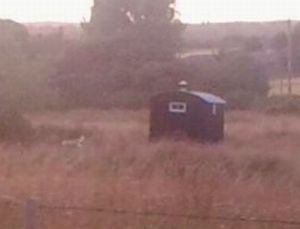 Just as I was thinking to myself that swallow numbers seem down this year, about 40 of them went over towards the sunset. Ambling the other way in groups of about 10 to 12 but numbering hundreds in total were jackdaws going to roost over at chapel farm, and chattering all the way like gangs of school boys. By 9.30pm everything was quiet. |
Sat, 29 Mar 2014 Listening to the dawn choruses this year, thankfully much more noise than last year (when it was colder at this time). I can hear noise from here to the horizon like a thick blanket of trills and tweets. Lovely! Cheery! Feels like summer is coming. |
Thu, 27 Mar 2014 A group of Dorset artists are woking on a collaborative (in that we meet to share what work we've done rather than work together) project called 'Interrogating Landscapes'. As soon as I was invited to join I knew 1. that I wanted to be part of it and 2. that I wanted to link what I did to the history of language relative to the site I chose to study. My landscape interrogation is about Hod Hill, an Iron Age hill fort in Dorset thought to have been built approximately 500BCE. As well as simply climbing, sketching and painting Hod Hill, I wanted to learn more about its context; what the people spoke, believed in and how they lived. I began by looking back to the roots of the languages we speak here in UK, and the language probably spoken in Britain in 500BCE. It took me to 4,500BCE and an area we now know as Ukraine where a mother-language was spoken that we call Proto-Indo-European and from which, through different routes and daughter languages, both Celtic (and later Brythonic spoken at Hod Hill 500BCE) and English (via Germanic) derived. I’m busy working my way, with words such as ‘wool’ and ‘wheel’ through the language changes and the European journeys of people from the Asian Steppe 4,500BCE to Hod Hill 500BCE. Below - on Hod Hill. 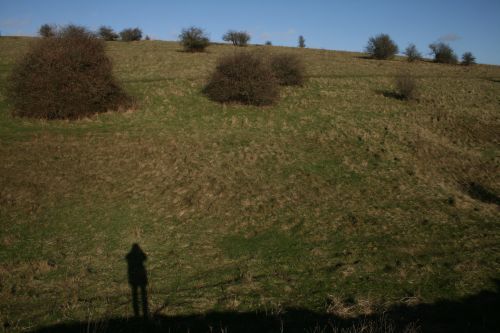  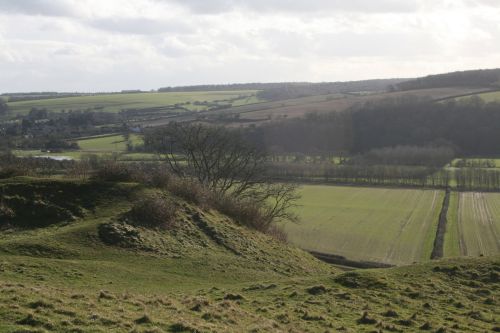 You can cut and paste this link to see the 'Interrogating Landscapes' blog. http://interrogatinglandscapes.wordpress.com/2014/03/15/investigating-landscapes-hod-hill-dorset/ |
Tue, 18 Mar 2014 In the midst of these confusing times...I heard an afghan woman talking about women's rights on the radio this morning. Obviously she fears for the time that we move out. She mentioned that she was brought up in a time when women had many more freedoms and rights, in the 70s and 80s. The downfall began when the Mudjehedin were armed and began fighting the.... Russians. I've often wondered what would have happened if we'd left the Russians there and hadn't mobilised the Mudjehedin quite so successfully against them. The Russians, being communist then, will have enforced by law equality and education for women. It seems it was the warlords who didn't like that and won't like it again as soon as we're gone. Did our support of the Mudjehedin blow up in our faces finally? And once they became our enemies have we simply held them at bay until the moment we leave? What will be the fate of Afghanistan's women and children? I wish there was a spare land they could go and inhabit and leave everything cruel behind them - what other answer is there?? |
Sun, 16 Mar 2014 In the week that Bob Crow and Tony Benn die, George Osborne says that the lower/middle classes who find themselves in the 40p tax bracket are proud to be there -it appeals to their sense of aspiration. They feel they are reaching the higher classes. I\'m writing this with a broad smile on my face as I contemplate the lack of sensitivity displayed by the chancellor. Neither Bob Crow nor Tony Benn were popular but if you are languishing some way down the national pay scale you could feel absolutely 100% that these two men would be loyal to you and might be prepared to fight a cause in your interest. It that sense, and perhaps surprisingly, they remind me of Ariel Sharon. Ariel Sharon was not loved by all his people -by a long way. He was hated by the Arabs but what the Arabs saw was that Israelis had a leader who was absolutely committed to the cause of his own people and the Arabs lacked just such a person on whom they could depend. In fact, re: tax, I think that raising the point at which people pay tax to £10,000 and beyond is a good thing. It\'s clear that reducing the point at which people pay 40p in the £1 tax to £41,000 is the way of funding it. George Osborne would have been better off making such a point rather than displaying his ineptitude at comprehending how difficult it is to manage money when you don\'t have as much as him. It\'s been the first moment when I\'ve thought I might actually vote for Ed Milliband in the next election -except that my vote will mean nothing. You could put a blue rosette on a goat here and it would win.  George Gideon Oliver Osborne |
Fri, 14 Mar 2014 Just watching 'Russia Today' news .. they're saying that we in the west supported the secession of South Sudan from Sudan, we supported the Falklands referendum and their choice to remain British, we support Scotland in their choice of a referendum to vote for or against independence...why are we so against the Crimean referendum? Perhaps its all in the two questions on the ballot paper, just one of which voters will have to 'agree' to The Crimean voter will have the right to choose only one of two options in the referendum. According to a format of the ballot paper, published on the parliament's website, the first question will ask: "Are you in favour of the reunification of Crimea with Russia as a part of the Russian Federation?" The second asks: "Are you in favour of restoring the 1992 Constitution and the status of Crimea as a part of Ukraine?" But the 1992 national blueprint - which was adopted soon after the collapse of the Soviet Union and then quickly abolished by the young post-Soviet Ukrainian state - is far from doing that. This foresees giving Crimea all the qualities of an independent entity within Ukraine - but with the broad right to determine its own path and choose relations with whom it wants - including Russia. With the pro-Russian assembly already saying it wants to return Crimea to Russia, this second option effectively offers a slightly longer route to the same result -shifting the peninsula back under Russian control. The option of asking people if they wish to stick with the status quo, in which Crimea enjoys autonomy but remains part of Ukraine -is not on offer. Any mark in one of the boxes is regarded as a "Da" vote. Ballot papers will be regarded as spoiled if a voter fills in both boxes or does not fill in either. Those who stay away will not influence the outcome, since the result will be based on the option preferred by a majority of those voting. Other than for the above reasons, is it fair to oppose a Crimean referendum? Is our fear based on Russia's determination to expand its borders? possibly beyond Crimea? Plus -however much we prefer the look of the new Ukrainian Govt. to the old one, was the new one legally achieved? |
Thu, 13 Mar 2014 So….nurses among other NHS staff are not to receive that which their pay body recommended because Jeremy Hunt says that if they allowed the recommended pay rise to go ahead, to fund it, some nurses would lose their jobs. Apparently if we want our hospitals staffed sufficiently then we must underpay nurses. That sounds to me like nurses, therefore, are the ones paying for staffing levels to remain where they should be. I’m clear that, after this, MPs should not take the 11% pay rise recommended by their pay review body but instead be part of ‘we are all in this together’ ethos and offer their proposed pay rise to fund that of the nurses. As the parent of a newly qualified nurse I don’t feel very happy. She will have to pay off her student debts and attempt to save for a deposit on a flat (far in the future) and possibly bring up a family one day (also in the future) while living on her NHS nurses wage. All the while she would like to feel pleased to be appreciated, valued for the extra hours she already puts in, happy that she earns enough to function in the current financial situation :( *Fed up with this mean situation and staggered at the double standards of the Govt., -can’t believe Jeremy Hunt stood up and said ‘in order the keep staffing levels where they need to be nurses must accept that they won’t receive the pay award their pay body recommended* :( |
Tue, 04 Mar 2014 I've just found that a few Exmoor photos were left on my camera having thought I'd lost them all. 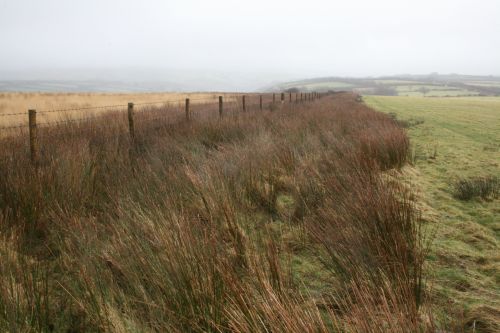 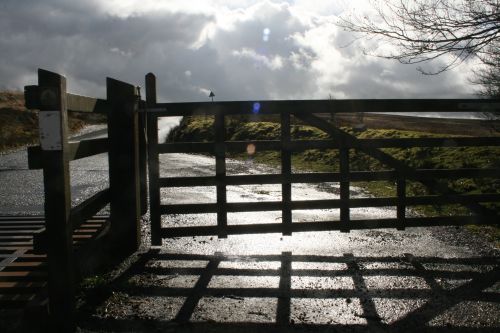 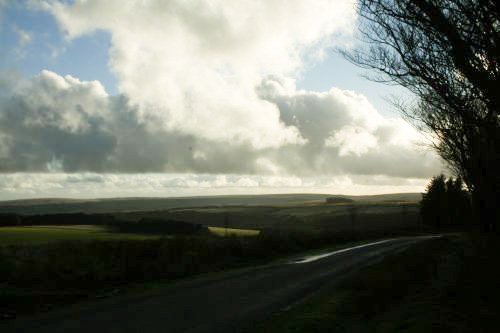 |
Mon, 03 Mar 2014 Here it is! A dress that I bought for £99.99p, reduced from £1010.00p!!! It's hard to believe I've spent almost £100 on one dress but it seems unimaginable to spend more than £1000! It is however a lovely dress and when I saw it on the rail I knew it had been made for me. It's outer layer is silk and metal and it has a silk lining. It has a really unusual cut of fabric and was designed by Calvin Klein. 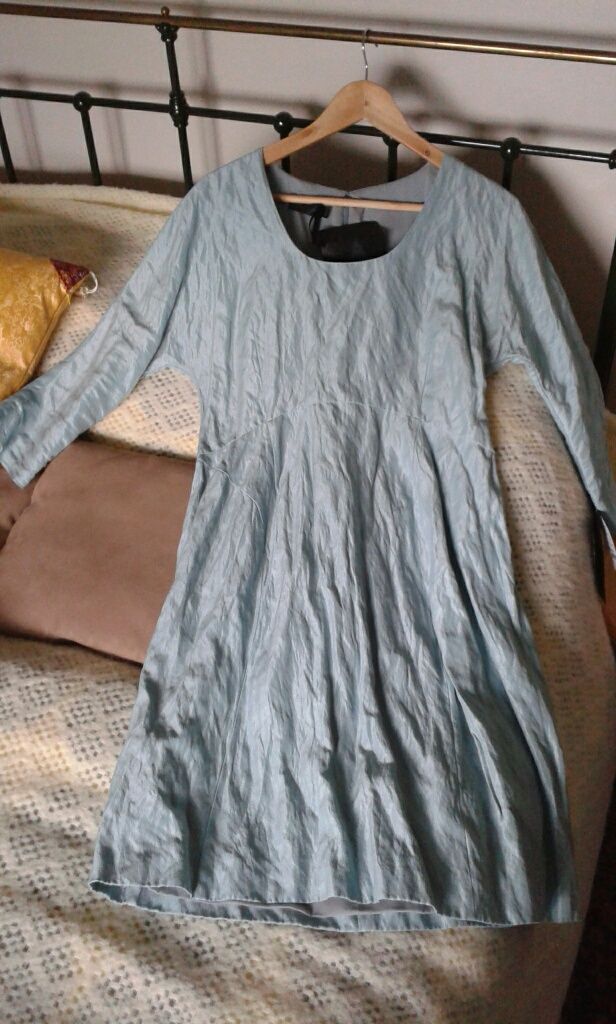 I've bought it to wear at my son's wedding in May. |
Fri, 28 Feb 2014 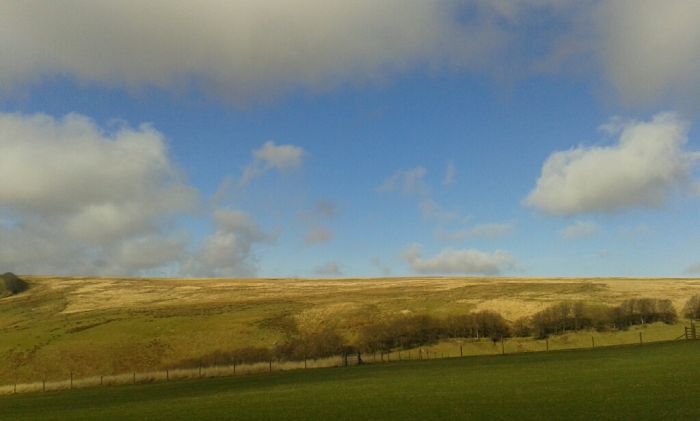 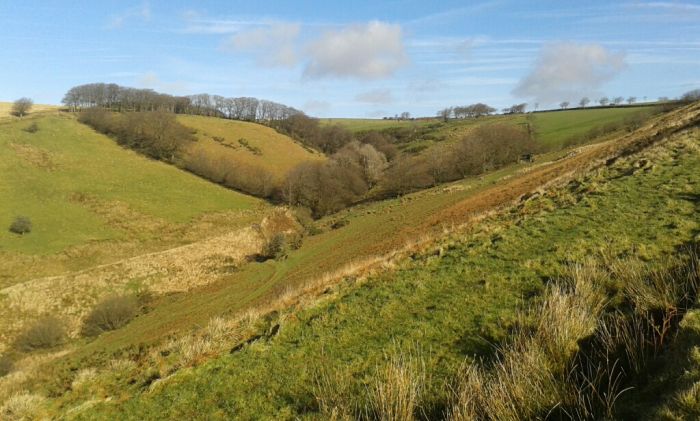 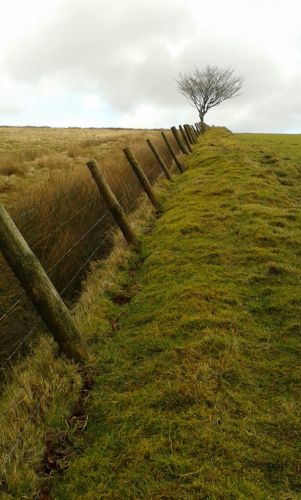 These were taken on Exmoor last week from my phone camera (read below). This morning I saw lapwings in the field beside the house. Two of them saw off a crow -in the past I've seen them send off buzzards who fly too close to their territory. And then when I got back from teaching and was putting the car in the gsrage, two ravens flew over. I saw them and checked their bills to see if they were crows or rooks. As soon as I saw the bulk of their thick bills I checked the tails for the classic raven wedge-shaped tails -affirmative! and then as they receded into the distance, against the trees, they were clearly very large black birds...not crows, not rooks! We've had a great week on Exmoor which has suffered much less than other parts of Somerset from the floods. The Exe wasn't particularly high and the ground was not more soggy than normal. We did however travel through Langport which sits on a bank of high land across the Somerset levels. We stopped at the top end of Langport to look across the levels towards Muchelney, and although we've seen it all on the telly it was a salutary sight. Like and inland sea, the hills rolled down into the water creating the look of a coastal scene. My laptop died a death on Exmoor, and as I'd downloaded all my Exmoor photos from my camera (and deleted them from the camera) unless I can find a way of accessing them I've lost them for the moment! Rather frustrating!I did a lot of drawings on good old fashioned paper so at least they won't disappear into the ether but are fixed on my pages and will be leading to paintings (are doing already). |
Wed, 12 Feb 2014 I had a wonderful trip back to Japan over new year, this time Simon came with me for his first visit there. George had borrowed a bicycle from his wife's sister's boyfriend's sister so it meant both Simon and I had a bike to ride. Of course when we went to check the bikes George's bike had flat tyres and the pump we'd brought from UK wouldn't fit the valve so we wheeled the bike to a nearby bike repair place where the man pumped both tyres up for nothing! It meant Simon and I did a lot of cycling. We travelled further than I have done previously; one of George's students, Akiko, took us on a train ride to Koyasan, a mountain covered in snow and shinto shrines where we ate vegetarian food cooked by the monks and experienced deep crunchy snow and that strange grey and orange light that goes with a sky ready to drop more snow, George's in-laws took us on a train across the peninsula to Ise, a place of more shrines where we saw out the very auspicious year of 2013; Simon was enamoured of the malls and their fashions and cycle gear -I went with him a few times but he prefers to shop without me...calls me Eeyore! The flights to and from Japan have changed their route. I think an old law has been discarded -that an aeroplane had to be within 1000 miles of an airport, so now we flew much further north, clipping the northern end of the Ural mountains and flying within the arctic circle. It meant we flew both ways largely over Siberia (or so it seems) as it takes hours and hours to cross that bleak territory. I can't imagine who lives in the frozen vastness of wind scraped mountains and twisting white rivers of ice. 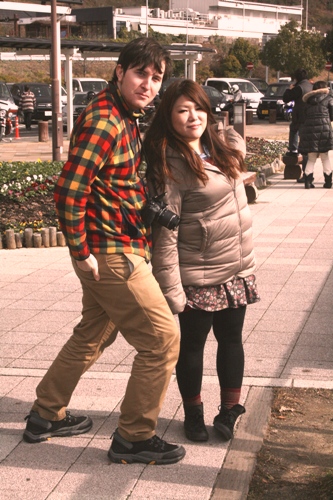 George and Namiki -we were heading into the mountains to spend a day with a potter. His wife made us lunch and he put us to a potters wheel each where we had the joy of raising pots up out of lumps of volcano shaped clay. I definitely want to do THAT again! 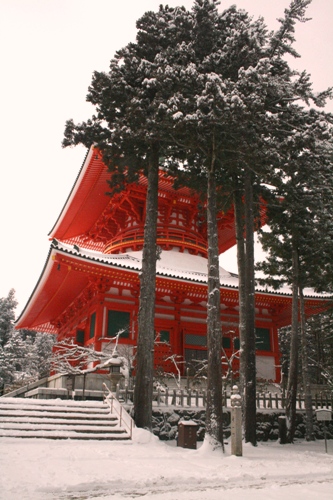 One of the shrines on Mt. Koya (Koyasan) 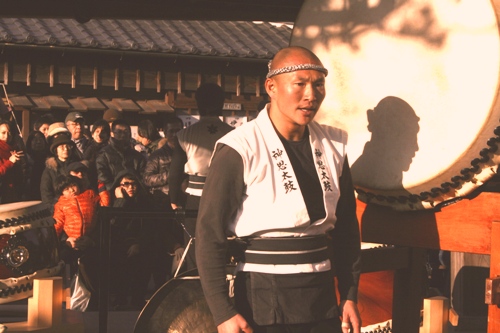 These drummers were drumming at the Ise shrines. They were astonishingly energetic and powerful, the drumming felt elemental like it passed right through your body. I spoke to this man briefly afterwards when he told me that its not music, that he does it for God. 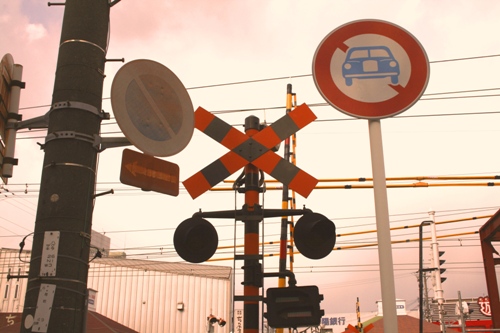 Japan is lovely for its signs and wires, here we were crossing (and frequently crossed) a level crossing on our bikes. |
Thu, 18 Jul 2013 Look at this exquisite thing that is sitting on the dining room window. 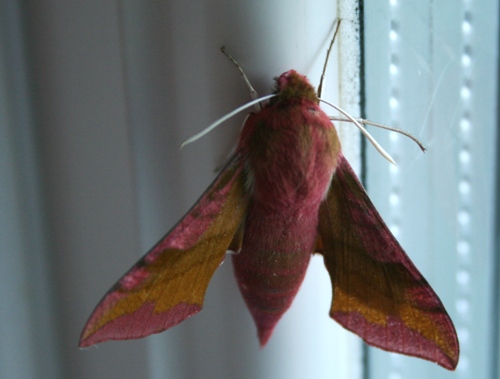 Mulberry and yellow ochre, what great colours together. 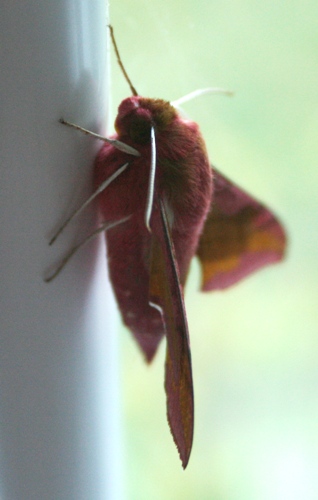 The fur coat is so thick, I can't work our if it's feathers or fur...or something different. In reality it's body is less than an inch long -it's probably one inch from wing tip to wing tip. |
Sun, 30 Jun 2013 Extraordinary that the U.S have been spying on Europe but what on earth have they discovered that interests them and what should the E.U have to hide anyway?? (perhaps the Euro-MPs travel expenses for starters). Obviously the U.S want to hide the fact that they've been spying on everyone so they're really angry that Edward Snowden has let the cat out of the bag; I'm not sure if Snowden has put himself in a safer position or a more difficult one. I would hate a son of mine to be where he is now -and if the U.S can be so deceiving about their surveillance practices, can one trust their powers-that-be to give Snowden a fair trial? You can answer that one. On a brighter note, I went on a great cycle ride this evening. 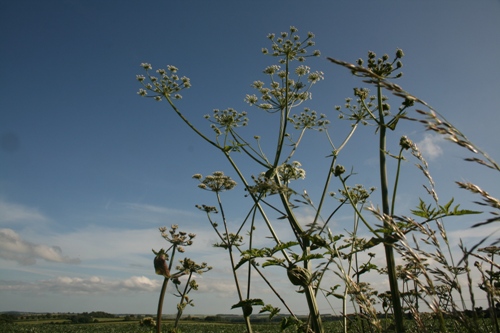 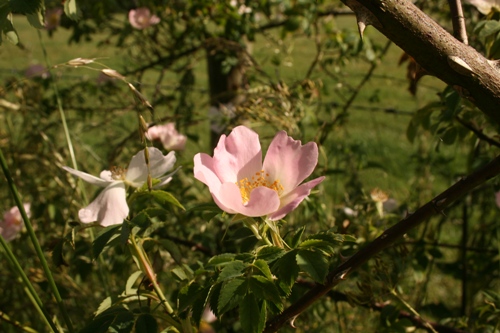 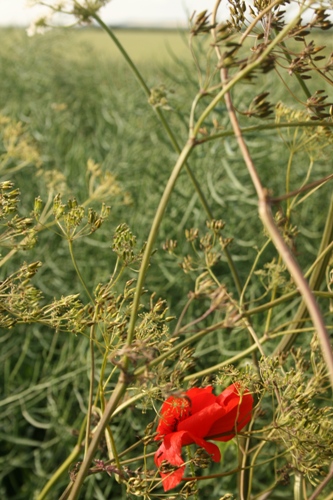 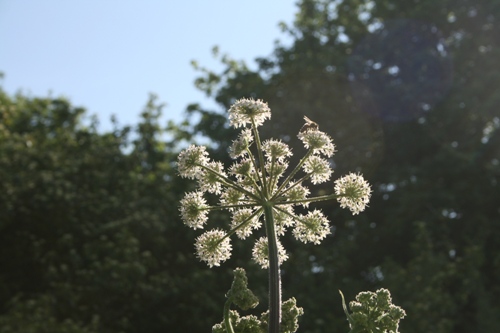 |
Wed, 26 Jun 2013 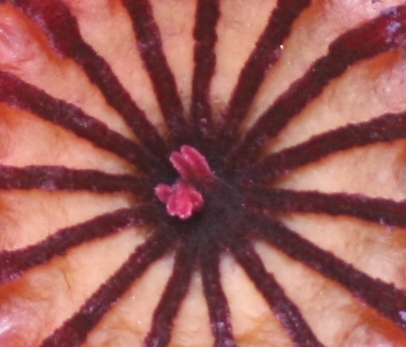 What is this?................... 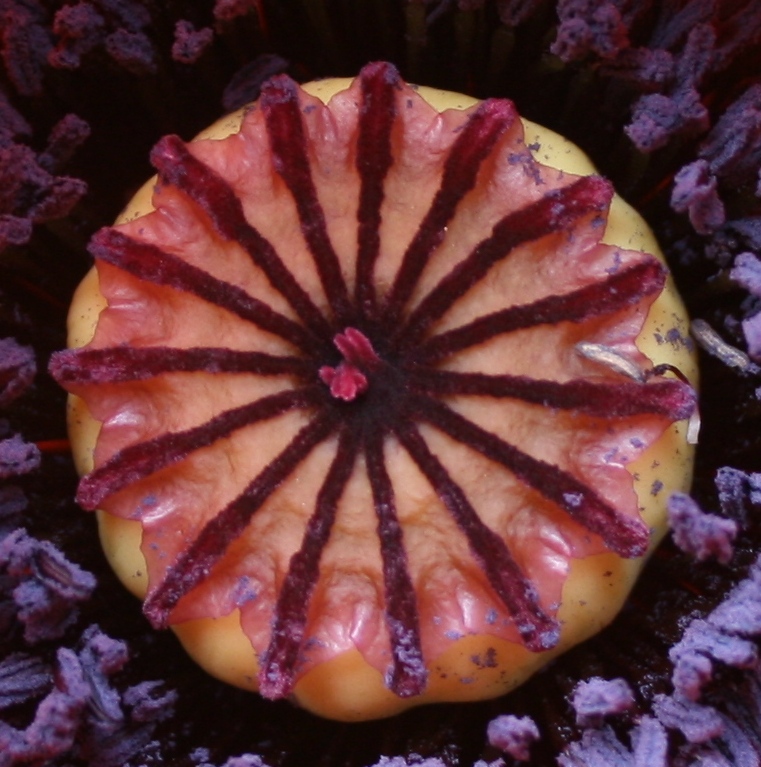 Does this help?................... 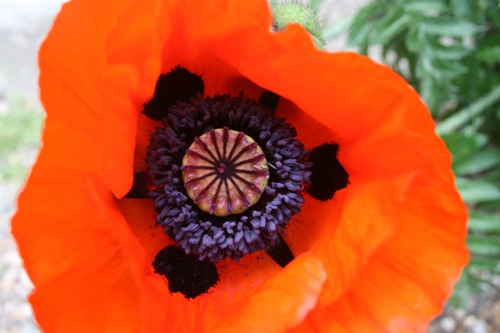 Amazing! I can see what led Georgia O'Keefe to the centre of flowers. |
Sun, 23 Jun 2013 Just musing on the fate of two young men in the world who, it seems to me, have unlikely links; they are Bowe Bergdahl held by the Taliban in Afghanistan and Edward Snowden, currently thought to be on his way to Venezuela via Moscow and Cuba. In 2009 Bergdahl, a U.S. soldier doing his stint in Afghanistan, was reported missing at morning roll call; it was claimed he had ‘walked away from his post’ in the middle of the night causing some U.S. senators to accuse him of being a ‘traitor’ –a label hard to shake off. It transpired that what actually happened was that he had been captured as he lagged behind on patrol the day before. He has been held ever since (four years now) by the Taliban and offered as a swap for five men currently held in Guantanamo Bay. The U.S. Government is doing its best NOT to bring this wrongly accused young man being held by the Taliban home again because Senator John McCain insists that America doesn’t trade ‘killers who’ve killed Americans’ (Guantanamo inmates). Meanwhile Bowe’s parents continue to hope for their son and keep the issue alive and kicking. Today they arranged a rally in their home state of Idaho to call for the safe return of their 27 year old son. Meanwhile, 30 year old Edward Snowden, also branded a ‘traitor’ by many U.S. senators, is doing his best to avoid being handed over to the U.S. Government after leaking to the world the extent of the U.S. and U.K. surveillance of all of us. He is keen not to return at the moment and I suspect it’s because he feels he is unlikely to be given a fair trial if he ever does return. Part of the problem, as I see it, is the term ‘Whistle Blower’. ‘Whistle Blower’ should be replaced IN EVERY CASE with the term ‘truth teller’. ‘Whistle Blowers’ almost always tell us things we are really keen to know once we know them. They call people to account on our behalf. They usually tell a truth which seems cataclysmic to those who don’t want it known but perfectly reasonable to the rest of us. The fact that he now has the weight of U.S. power bearing down on him suggests that return to his home is unlikely –ever. I hope he realised the beast he unloosed when he told the truth. Freedom of speech in the U.S. (and here in U.K. too) goes only so far; if I were his parents I would wish that he had kept his mouth shut –and yet many people may feel they’ve had their rights so fully trampled on that he has done us all a huge favour. So, the U.S. wants both men back but will do its utmost to bring one back and not work quite so hard for the other. |
Thu, 13 Jun 2013 Two things: I came up from my shed this evening and by chance caught the film Billy Elliot (which I've never entirely seen before) on the telly. What a film of loss and life -what an awful lot of things were covered; irrepressible need for self expression, bigotry, family dynamics & responsibilities, teaching and what it means to teach, the rich tapestry of life which ties one man in to one place and another into somewhere completely different -rarely are the two bridged thanks to the assumptions we make and a glass wall (as opposed to a glass ceiling) which allows one party to look at another and judge and the other to look back and judge also. I was fighting back the sobs at the end so I'm not sure if it was a feel-good or feel-sad film. Second thing (which brought me right back to earth with a thump): I heard on the news that the USA has decided Assad has 'crossed the red line'. They have enough evidence to show that Assad has used chemical weapons on his own people (I'm not sure they would claim to be his own people) and so USA will now provide military assistance to the Syrian opposition. That brings two questions to mind 1. What plans to the USA have for the many people in Syria who clearly DO support Assad, once Assad has been ousted with the American military help? 2. What plans do USA have to ensure that the military assistance they give will be used 'in accordance with international norms' (supposing that it's clear what 'international norms' are)? The world is like a giant set of scales...one side up the other down, so if the USA sees the 'wrong' side up they (and we by default) will wade in to tip the balance. I can't see a pretty ending either way and I don't think for a minute it'll go the way USA want or anticipate...as nothing ever does. |
Sat, 27 Apr 2013 I’ve been trying to look at the work of an artist called Joe Davis who only has one leg...or rather he has two but one is metal. I put ‘Joe Davis’ into google and came up with joedavis.co.uk which took me on an intriguing journey...follow it and laugh! Anyway, this turned out not to be the Joe Davis I was looking for. The Joe Davis I wanted to read about walked into MIT in Massachusetts in 1984 and persuaded then to make him a research affiliate; he wanted to work in the fields of both science and art, to marry the two...and that's just what he's done. Here is a list of some recent work: • Microvenus (embeded artwork in a bacterial genome) • Audio Microscope (a microscope that translates light information into sound allowing you to "hear" living cells, each with its own "aucustic signature." • Experiments with how E. coli respond to jazz, and other sounds, with Andrew Zaretsky - "the project is not too far afield from the work of the Demain lab, which concerns itself more with microbiology and the production of secondary metabolites such as antibiotics by bacteria. If the sound waves prove stressful to the bacteria, the stress might result in increased production of antibiotics, according to Zaretsky." • Putting a map of the Milky Way into the ear of a transgenic mouse - "inspired in this project by a children’s story an ex-girlfriend wrote eight years ago. He has taken the map of the Milky Way and reduced that information to sequence of 3,867 DNA base pairs. He has an agreement with Millenium Pharmaceuticals to synthesize the DNA sequence in 100 base pair chunks." • "‘primordial’ clocks, his own test of theory that life spontaneously self-assembled. To Davis, if life could assemble from simple molecules, so could clocks, a much simpler system." • "For seven years he championed a space shuttle experiment that would have shot a 100,000-watt electron gun into the magnetosphere to create the first artificial aurora..." • "...ways to make artistic use of high-voltage electricity and spacebound signals. In the early 1980s, he drew up plans for channeling lightning bolts into a pulsed laser of almost unparalleled energy and into towering sculptures that would change the bolts' color and emit incredibly loud tones..." • "recorded the vaginal contractions of ballerinas with the Boston Ballet and other women, then translated this impetus of human conception into text, music, phonetic speech and ultimately into radio signals, which were beamed from MIT's Millstone radar to Epsilon Eridani, Tau Ceti, and two other nearby star systems… from New Scientist - ‘In another sexually charged example of performance art Davis sets out to correct what he feels is a case of censorship in scientists’ efforts to communicate with extraterrestrials. He explains that researchers have sent images of an anatomically correct man into outer space but the image they sent of a woman lacked genitalia. To right this wrong, Davis transmitted the sound of vaginal contractions of ballet dancers to several nearby stars. The audio recording was beamed from MIT’s Millstone Hill radar for several minutes before the United States Air Force shut him down.’ The thing is that last night I saw a programme about Turner and his response to his ‘modern’ world; industrial revolution in terms of buildings, factories, trains, steam etc. and it struck me that Joe Davis doing the same with his ‘modern’ world. It seems that years ahead of a recent Japanese invention to store information in bacteria (The Japanese researchers wrote a message by first converting it into binary. This code was then built into artificial strands of DNA, using letters such as AG to mean 1000 and TC to mean 0111. The strands were then injected into the bacterium. Each hay bacillus bacterium can store two megabits — the equivalent of 1.6 million Roman letters. The scientists can take out the microscopic implants in a laboratory and read them so they appear as ordinary text) Joe Davis was doing the same at MIT –the trouble was that he was using potentially fatal-to-humans bacterium and got himself into all sorts of trouble for doing so. He has the air of a mad scientist, but I’m certain everything is clear and straightforward to him. He was born in Mississippi, and clearly never one to conform was expelled from three schools and two colleges. He is described as having a zany innate curiosity about how things in nature work, and harnessing their attributes and characteristics to his works of art. Coming from the deep south meant that he had many family members who suffered in Hurricane Katrina. He had an idea to build a 100ft memorial to the hurricane something like a lightning rod, but with three vertical masts made of aluminum. When lightning strikes the tower, a resonant cavity is formed that breaks down nitrogen in the air and triggers an ultraviolet laser discharge, sending the beams back into the sky. Ive searched on line but I can’t find any evidence of its having been built (yet). 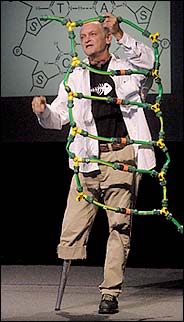 |
Fri, 19 Apr 2013 yiippeeeee yiippeeeeee yiippppeeeee Friday night is music night and it's another of Simon Russell Beale's Sacred Music series looking at Allegri's Miserere tonight. I love hearing the music but I love as much hearing about the music. Good old Simon R.B.!  |
Tue, 16 Apr 2013 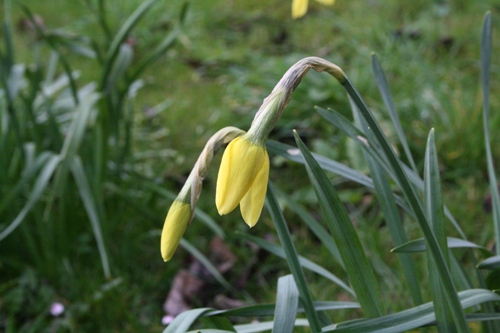 Spring has been a long time coming this year but evidence of its arrival is finally showing in the garden. Although by April 16th, astonishingly, not all the daffs are out yet, there are hundreds of little cowslips poking up through the mossy sponge at the lower end of our garden. And I saw five swallows today –the first I’ve seen since being in South Africa less than two weeks ago...so the saying may go ‘One Swallow does not a summer make...’ but I have seen five here today and I saw some just as they left for their mammoth trip north. 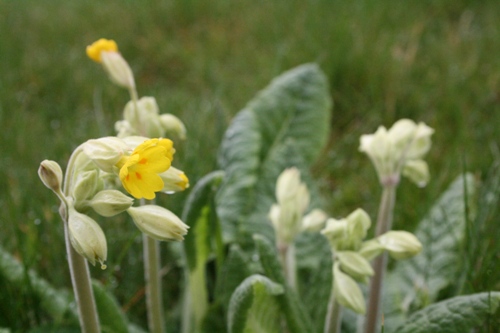 I have just finished reading a triple-book called 1Q84 by Hariku Murakami. It’s certainly an odd set of books. As with a book like Tristram Shandy, the best thing is to read and don’t question; to let everything ride through you like a sirocco and asses it over the spaces of time when you’re not reading. In ways the writing is artless and clunky but that may be down to its translation. It had moments of sounding more like an Enid Blyton than an award winning novelist, but from my slowly growing experience of Japan and Japanese I can see that the language is so very different from western language that translating it means joining two unrelated and alien elements and meshing them somehow in order to transit the story from one form to another. Years ago I studied Hebew in Israel. It has an alphabet (aleph-bet) of mostly consonants and a system of dots and dashes for vowels, but that alphabet is clearly related to ours (or ours to it) making learning the language relatively straightforward, but Japanese with its pictogram-based language expresses its ideas in a completely different way, right to and from its roots. It’s possible that clunky descriptions in 1Q84 were a result of translating complex concepts which are described in Japanese with single composite-pictograms. We construct words with collections of vowels and consonants which can be reduced to their bits and rearranged into other words and sentences. I have a feeling Japanese uses pictograms which describe a concept very precisely, and to describe another you’d have to come up with another pictogram. It means in the translation to English, collections of concept-bits have to be put together to translate the meaning of one pictogram. Sometimes I think that to name a thing precisely gives us the ability to ‘see’ it. If there were a word for ‘the space between one thing and another thing and the shape they create between them’ my job as an art teacher would be infinitely more easy. Let’s give it a name ‘deframe’. I would say ‘look at that ‘deframe’ there’ and in one word I have stated my case and my student would be seeing. Japanese Kanji (pictograms) are more precise in their composite concept which means they must learn thousands of different Kanji whereas we can construct words and then sentences from an alphabet of letters representing ‘sounds’. Our writing fixes the sounds on the page to the words we understand; Japanese writing fixes a complex concept on the page in one Kanji. Anyway, the book’s story kept me gripped right to the end although in many places I predicted rightly what I thought was about to happen or might happen a fair way on in the book, I couldn’t decide if this was what the author had intended or if it was the translator’s opinion that he had to extract every bit of meaning from each Kanji so that we missed nothing. On beginning book three I felt that it had been translated by a different person from books one and two –I was gratified to see that I was right when I read the frontispieces. Book three’s translation is better than books one and two. Now I’m feeling that bereft-book feeling so I’m going up to my son’s bookcase where I know some more Murakami books are waiting and I’m intrigued to see what the translations are like. 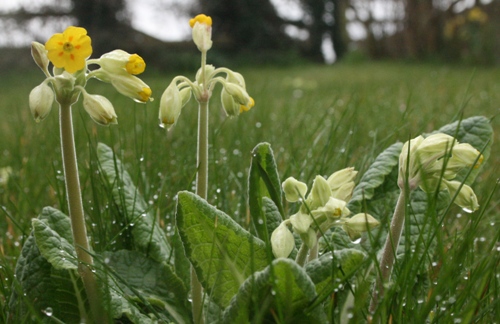 |
Wed, 27 Mar 2013 ...Off to South Africa and The Klein Karoo tomorrow... |
Fri, 08 Mar 2013 Some Exmoor wildlife...typical Exmoor pony, long sturdy body, short legs, good camouflage for Exmoor living... 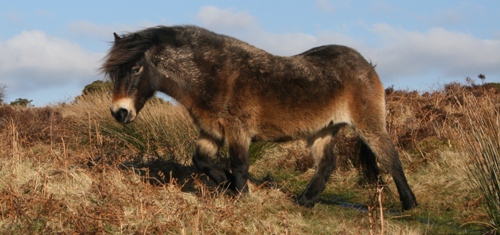 and a good thick coat. 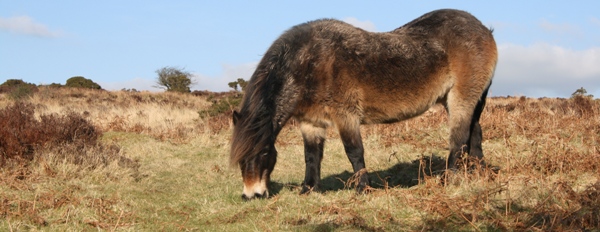 She was quite tame and was happy to come close and chomp grass. I also saw this happy stag with all his hinds. 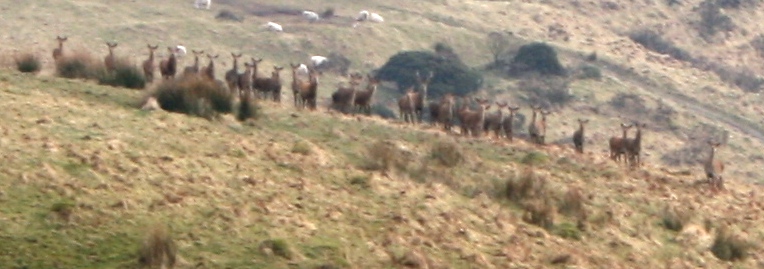 They looked at me for a while and then turned tail... 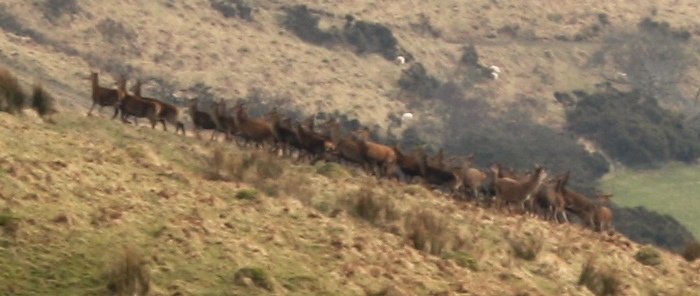 |
Thu, 07 Mar 2013 I'm just emerging from nearly two weeks of a cough and cold...bad enough to keep me out of the teaching room -not nice. We've been looking at pop-art in class, at Richard Hamilton, initially, and his collage 'Just what is it that makes today's homes so modern, so appealing?' 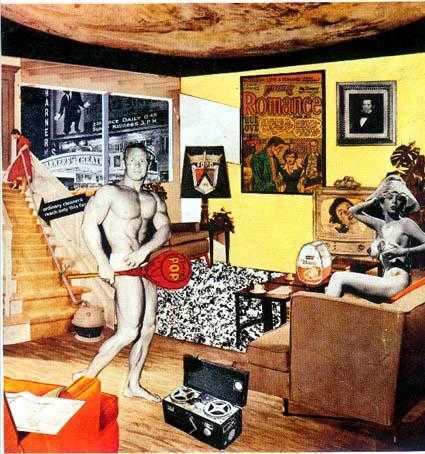 We were looking at the way he placed elements in the room to be in keeping with perspective. I define perspective as follows -the way distance is described by the effect distance has on any one object or element in relation to another. So, if you look at the Richard Hamilton collage, in the foreground you'll see the corner of an orange sofa. It interrupts the figure of the man by covering his foot so that we understand the sofa to be nearer to us than the man. The man's size compared to that of the foreground sofa also places him further from us than the sofa. He would have to step towards us to reach the sofa. But Hamilton also plays with scale in this collage -look at the tin of ham on the table beside the woman -way too big! He becomes much more of a stickler for getting scale and perspective 'correct' in later work -the first one was an experiment with technique which sent him down that path (and after which Pop-Art was named).  In this one his perspective is impeccable; note the diminished size of the further lamp of the pair of black-shaded lamps. He was clearly interested in interiors and the journey through the space of the interior. I had thought this one was a collage too but I've discovered that it's a computer generated work made much later and which would account for it's flawless conjoining of the separate elements. We went on to look at Lichtenstein's interiors (not his comic book characters) and the way he flattened objects but allowed us to understand their place in the room's space because of their position and scale. 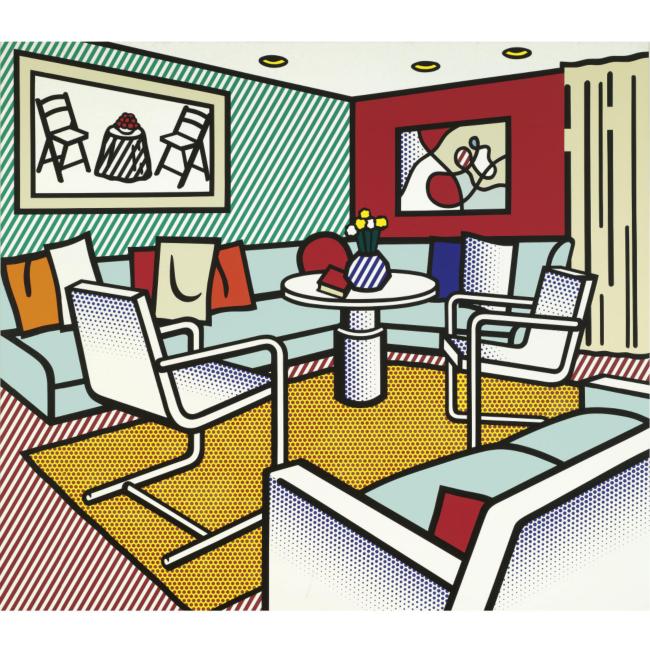 Note the foreground sofa, not unlike the Hamilton sofa in the first picture. This painting is not about the subtlety of light-fall and tone in the room, it is entirely about perspective -how one element relates to another in terms of size and positioning. Finally we looked at Patrick Caulfield who was altogether more subtle and enigmatic. His paintings certainly were about the complexities of light-fall and objects 'interrupted' by things in front of them. He finds a balance between putting information in and leaving information out but inferring by 'revelation'. 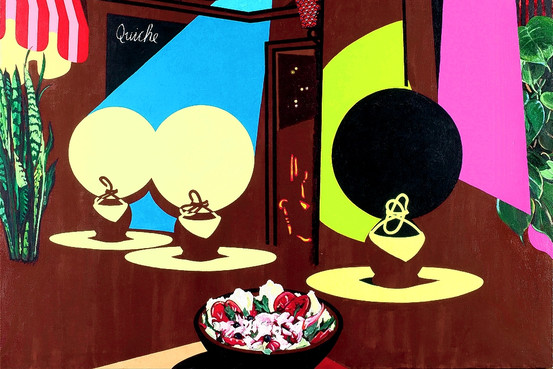 It seems that the three lanterns on the three tables are all the same size but if you measure them one by one you'll discover they become increasingly reduced in size from the one on the right to the one on the left. Intuitively we understand them as 'going into the distance' because their size reduces...but actually they all sit on the same flat surface of the canvas! |
Thu, 21 Feb 2013 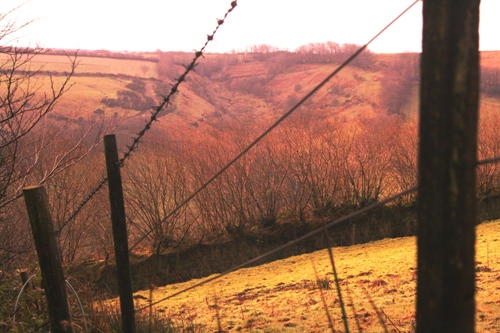 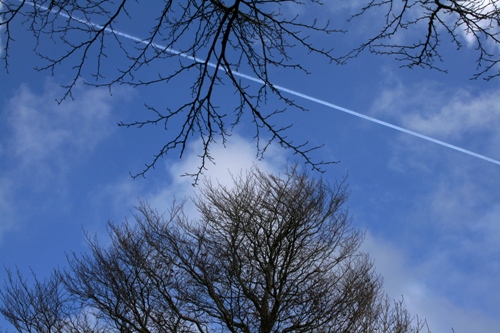 On Exmoor, in Dulverton in as cafe called The Tantivy with free wifi...It's being a great week with loads of warm sunshine or frfeezing mist. (That was a mis-spell but I think it looks appropriate) 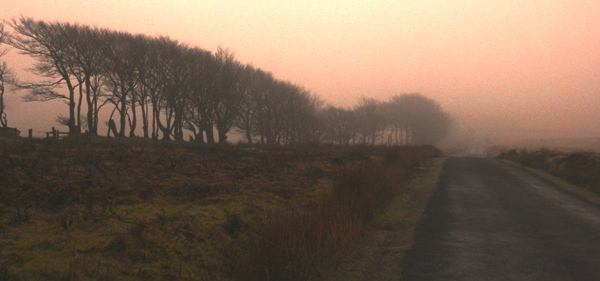 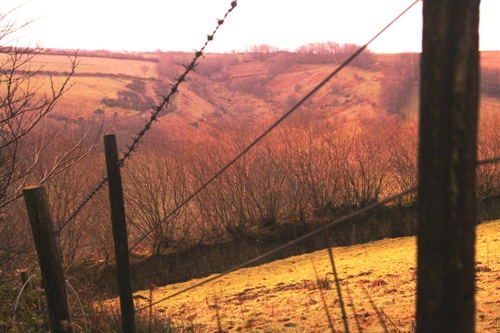 I've been out with my paints...more when I'm home, other that to say I've been thinking about tone, texture and colour as I had planned, and really loving it as the hours whistle by. |
Fri, 15 Feb 2013 I'm working on a self portrait in two parts, a bigger and a smaller canvas...but as I'm off to Exmoor for the week, where I'm going to concentrate on colour, tone, texture and 'marks' in oil paint... the portrait will rest for a week.  |
Sun, 10 Feb 2013 It was, as I anticipated, a lovely day! I'm off to teach a day's workshop at Chettle (village near here). Lovely village hall with fireplace; first I'm going to light the fire then make coffee for the early-birds. I have lovely enthusiastic students and although it's hard work I'm looking forward to the day. I may have misgivings about the painting I do but not the teaching...perhaps I was born to teach?!! |
Fri, 25 Jan 2013 I'm at the gallery in London; other Claire has gone for her evening off, having supper with an old friend. It has been an amazing week so far with old friends, family, our students and new-to-us people coming in and all with plenty to say. The Haiku board has caused as much fear as pleasure...but when people get down to writing their Haiku it causes much mirth and they go away with a small watercolour study which they choose from the board. 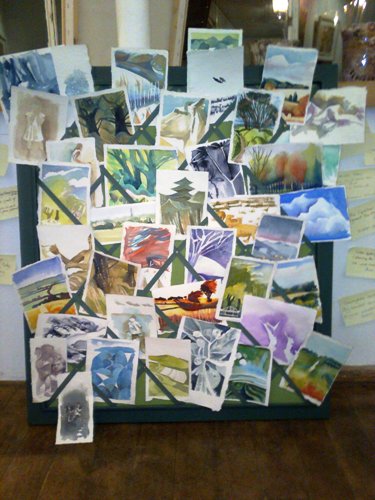 The Haiku board -people write the Haiku on a post-it note which we stick on the wall alongside the board. 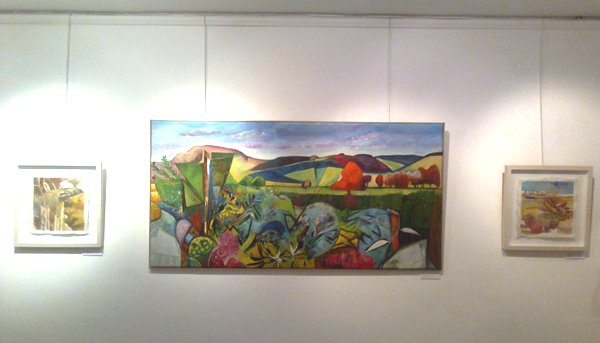 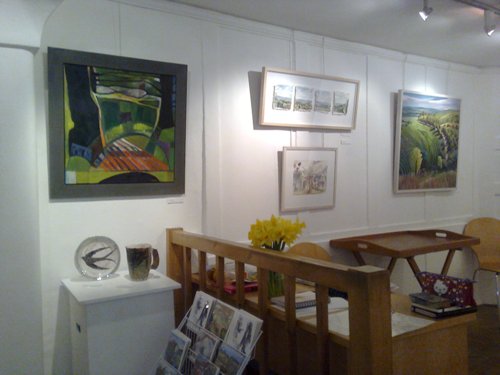 I'm regretting not bringing my camera as I would have enjoyed spending the evening photographing the show and my phone is somewhat lacking in the camera dept. Tomorrow is our busy day -contrary to the normal...we are having our preview at the end of the exhibition, an all day party! |
Mon, 21 Jan 2013 This Ford Anglia is just waiting for the snow to pass... 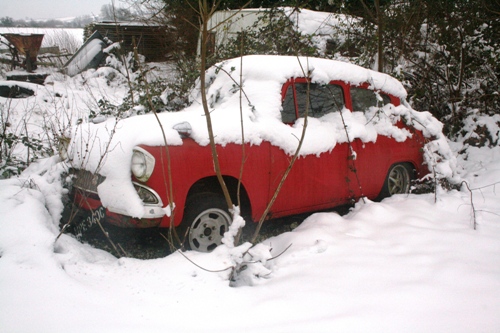 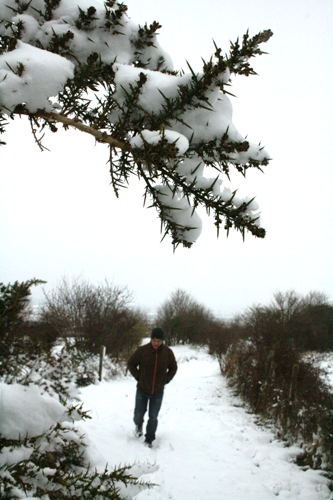 I'm feeling more relaxed that I have in a while; Claire (Thomas) and I got our work into London on a snowy day -thanks to Claire's husband Paul and his van, we spent several hours curating rather than just putting up the work and after a day living on cups of tea I got back to my sister-in-law's house to be fed, watered and generally looked after with no notion of having to 'set up a show' lurking somewhere in the near future to unsettle a person! It means I can look through some of the pictures I took yesterday when Simon and I went for a walk, enjoying the snow...  This solitary spot of red glowed in its grey surrounding, but Simon being red/green colour-blind thought I'd taken this picture for the sake of the dotty ivy flowers. The sky was remarkable for being so grey; the snow was brighter which seems odd as the light lighting it must have come from the sky...so how was the snow lighter than the sky? This photo is called 'Barn'. 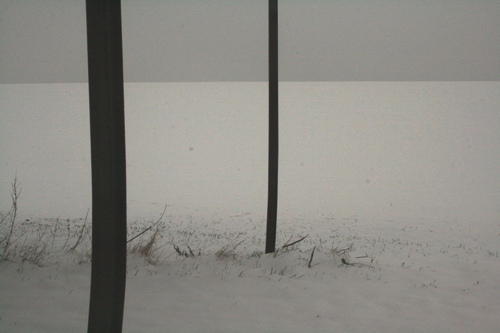 We ended our walk at the pub...of course!! with a pint of beer and a bowl of chips...last of the big spenders. 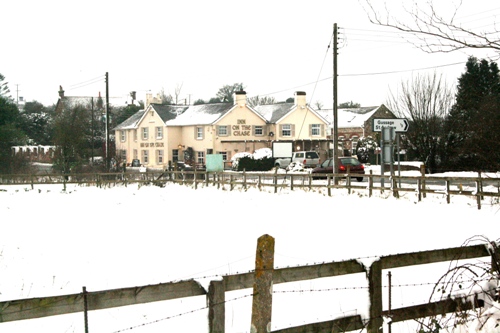 |
Thu, 10 Jan 2013 One of the astonishing things about the flight home from Japan was that we seemed to travel just inside the six-months-of-winter line. It meant that we had dark sky above us but because I was on the south side of the plane I was looking across at a setting sun which never set. For hours and hours I waited for it to fully set, but travelling west with the day meant this was the furthest down it got. 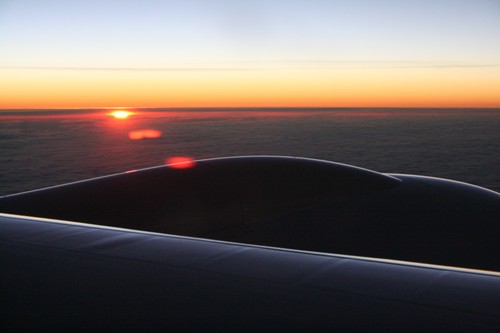 I had a window seat right above the wing which, for me, was very frustrating but once when the plane banked just as we headed into the depths of Siberia, I was able to capture a shot of this fairly extreme looking place -some way north west of Vladivostok. 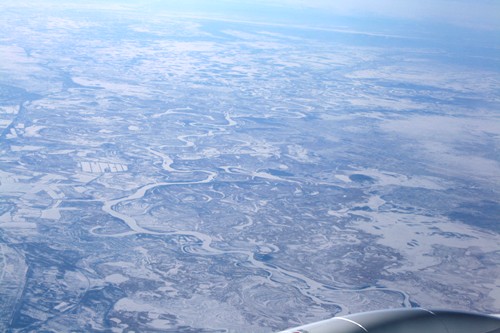 An odd moment happened when I looked out of the window and saw something so close that it took my breath away; initially I couldn't work out what it was but after some deliberation I saw that it must be the condensation trail from whatever aircraft was ahead of us -I realised that we must have been on an 'air-highway', we were simply following the previous plane's trail. It was so close I could see it reflected in the wing from above it. Like the never setting sun, we followed it for hours and hours. 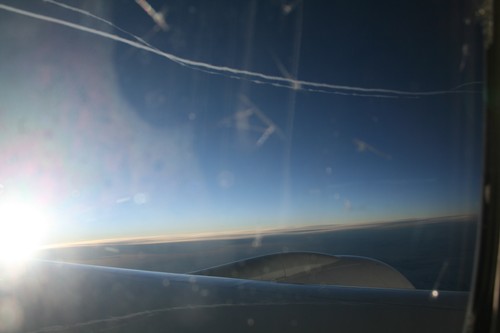 Here you can see the moon in the wing, a nice waxing moon unless I've made another big mistake (like I did in South Africa) and due to our position the moon would be 'the other way around'...I'll have to work that one out. 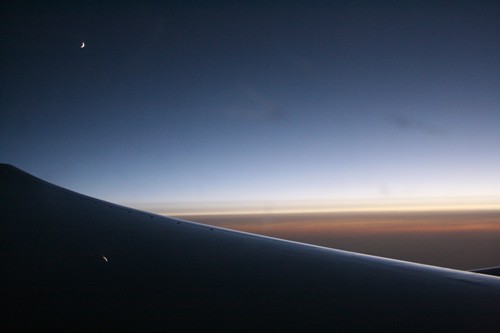 |
Tue, 01 Jan 2013 One of my days in Japan was spent in central Osaka at their National Art Museum seeing the El Greco exhibition. I didn't take pictures myself but have found this set taken by someone who had access the days before it was open to the public. For me it was a mix of overwhelming and underwhelming depending on what I was looking at. Some of the paintings were surprisingly small and busy; too small and cramped for the mass of activity, beautifully painted but lost in a mix. 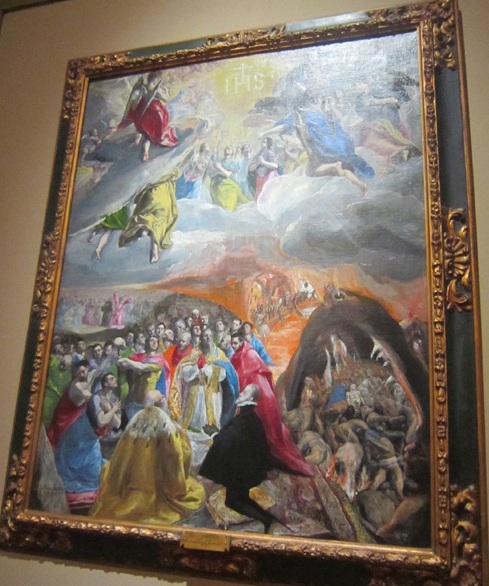 One huge mistake on the part of the curator, as I saw it, was that for most of the people filing through the exhibition, the western-style religious themes they were depicting are stories completely unknown to them. I asked Namiki, with whom I was seeing the exhibition, what the descriptions beside each painting were saying, Were they telling you about the story depicted? And she said no, they describe how, where and why the paintings were made. I asked her if she knew what the paintings were depicting and she said no, she had no idea about the stories except that the baby is Jesus. She asked me 'Did Jesus really exist?, he's just a myth right?' Namiki was bought up typically Buddhist as are many Japanese, not with our typically Christian-saturated schooling. 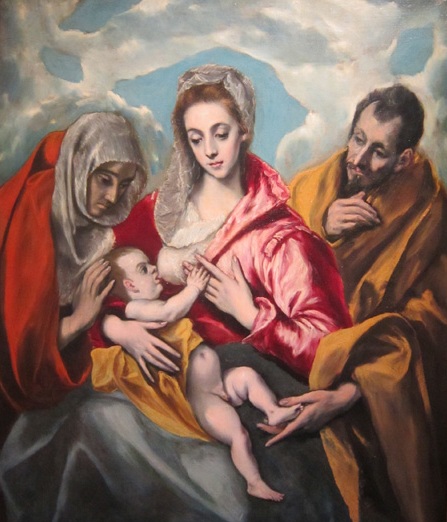 The paintings which took my breath away were the far more intimate portraits; to clap eyes on them is to be caught in the magic of almost 500 years melting away to nothing as you feel yourself, viscerally, in the presence of the sitter. The paint-work is fresh and subtle with an exquisitely light touch, capturing extraordinarily convincing expressions of the sitters as if they'd been there just minutes before and had perhaps popped off to the loo. 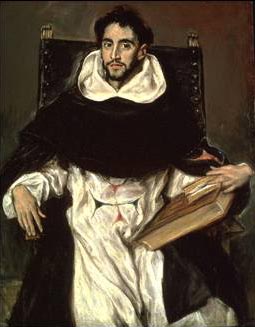 There were far too few of these sublime paintings. I feel sure he did these for the love of them and the religious paintings for his day-job 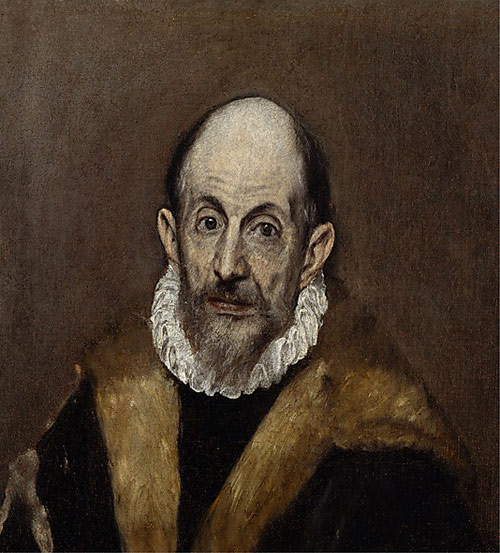 |
Thu, 27 Dec 2012 One of my favourite Japanese artists is someone called Kamisaka Sekka; I saw his work last year in the Art Museum in Kyoto -he is wonderful both with woodblock printing and with watercolour. On the same day that Namiki's parents took me to Kyoto for the meal, they also took me to visit an old printer who explained that in Japanese printmaking there are three experts...the artist who makes the drawings, the cutter who cuts the woodblocks and the printer who prints from the blocks. He taught me to ink up a woodblock and print from it - and also, through him, Namiki's parents gave me as a present a print from Sekka's original woodblocks of one of his most wonderful images 'Sparrow and Bamboo'. I have it here with me...it travelled right next to me all the way home from Japan...and now I'm waiting until after Christmas to get it framed and know exactly how I want it done. 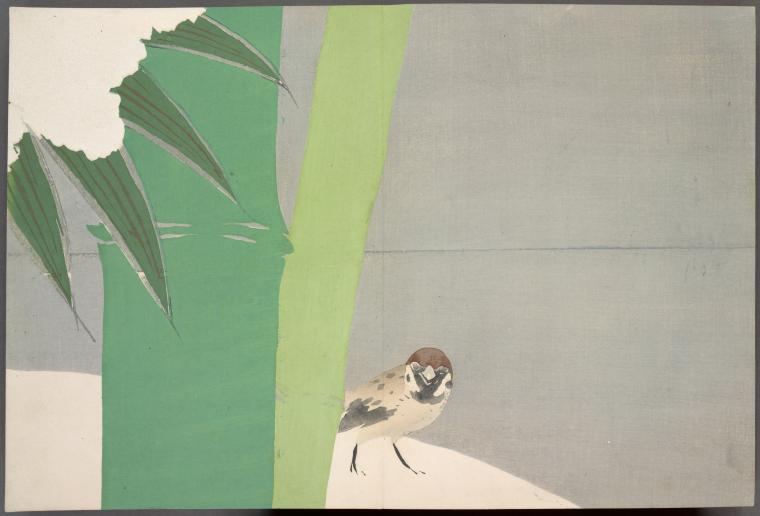 Of course it brings Colin and the lovely summer of 2010 to mind, although this is a tree sparrow with his little brown head (common in Japan) and Colin is a house sparrow. |
Tue, 25 Dec 2012 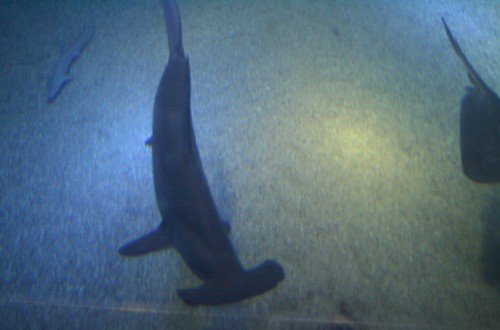 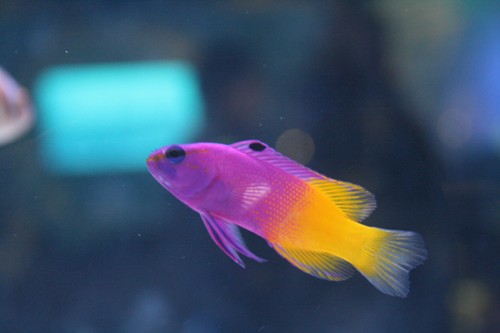 On my last evening in Japan we went to the aquarium in Osaka. As well as various ocean environments represented in different large tanks, and some water's edge environments for marine mammals (sea otters, sea lions etc.), there is one enormous tank in the middle containing a mix of small and huge fish including a whale shark and a variety of rays. 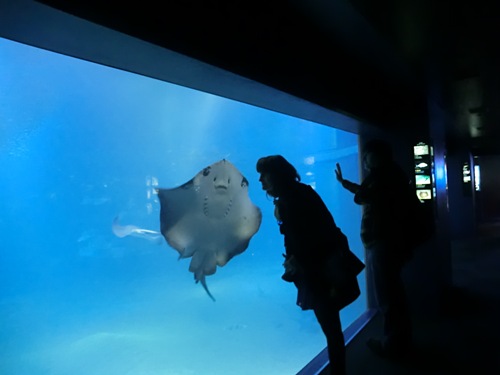 It was evening which created an enigmatic lighting to the whole place allowing the tanks to glow from our dark place outside them. 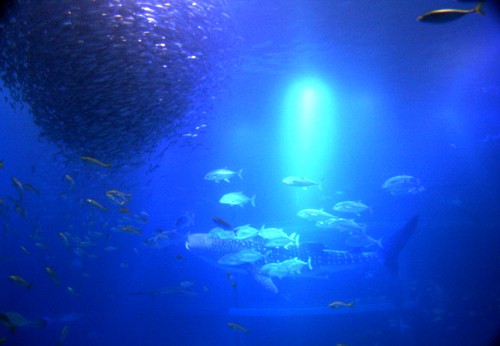 We watched as a small sardine broke away from the main shoal and darted across the tank -he got caught in a dividing net but his furious attempts to escape alerted two rays who slid up either side of the net and, after a bit of cufuffle as they fought over him, he was eventually sucked up into one of their mouths and gone completely...it was a bit odd -a bit disturbing. 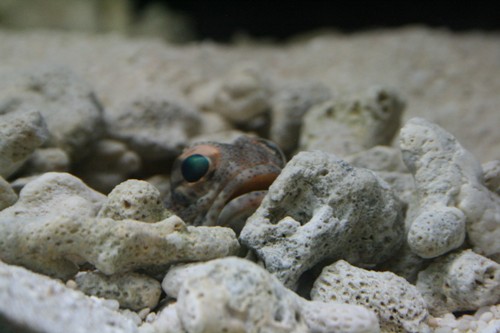 As well as the bigger fish there were wonderful tiny things too, including this fish with the look of Eeyore to him...he's saying...'oohh no, not YOU again!' 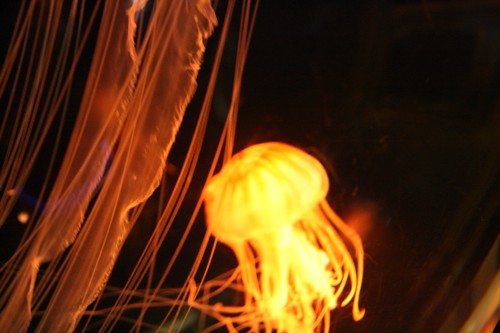 The jellyfish were lovely, beautifully lit, all filaments trailing and gentle thrumming through the water, reflecting light right through themselves. |
Sat, 22 Dec 2012 On the subject of food still (which is very good in Japan) we had a party at George's flat one evening, some friends came round and produced this wonderful dish of Nabe (boiled veg, mushrooms and meat in one big pot) placed in the middle of the table and from which we all scooped some into our bowls. 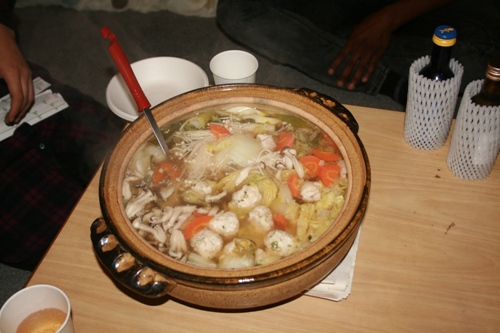 The following day George and I were invited to the house of one of his students, Akiko, for lunch. It was a very traditional home with a low table on which she cooked much of the food (on a griddle) as we ate. The food was delicious, a combination of typical Japanese and international food with lots of seafood and vegetables.  Akiko lives further out of Osaka than George, on the Nankai line, in a beautiful area where the trees were turning, and with a blue sky autumn felt present and good. 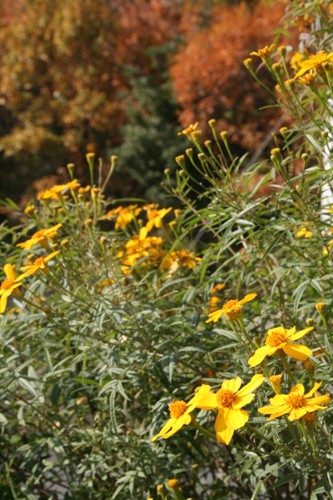 This is an old onion shed used to hang (and dry) onions. There were lots of small patches of crops, much like allotments but in the oddest corners! -lots of cabbages, onions and leeks growing. 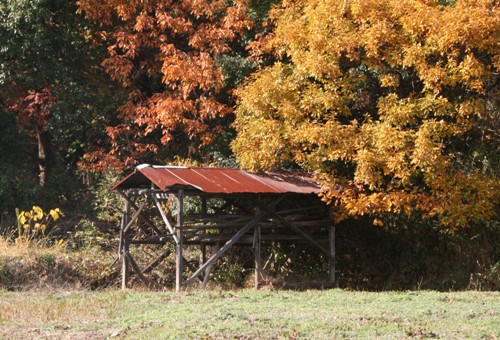 |
Sat, 15 Dec 2012 Yesterday I was taken by Namiki's parents to Kyoto. They had booked a table at an exquisite restaurant in a beautiful garden. It wasn't one large restaurant room, it was a collection of private rooms screened with paper screens and overlooking different parts of the garden, reached through corridors of fragile glass panels. The food was unbelievably good, much of it completely alien to me with delicate and indescribable new tastes -turtle cooked with ginger in a savoury custard, raw prawns, bream and tuna, a tiny grilled Spanish mackerel steak with spring onions made to look like chrysanthemums -about eight courses in total. 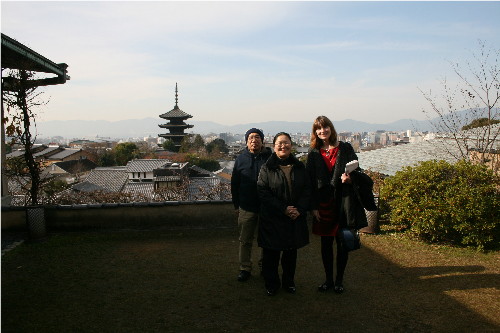 It was a treat for Namiki's parents -I could tell because as each new dish came out it was reverentially described to us by our waitress, both in Japanese and English; we listened intently so as not to miss anything and as we tried each new taste we fell into silence in order to take it in with full concentration. It was quite amazing!  The quote on the tag is 'time flies like an arrow'. 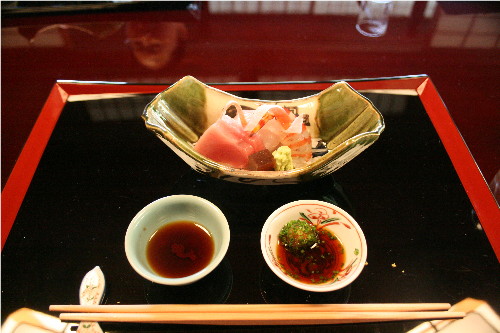 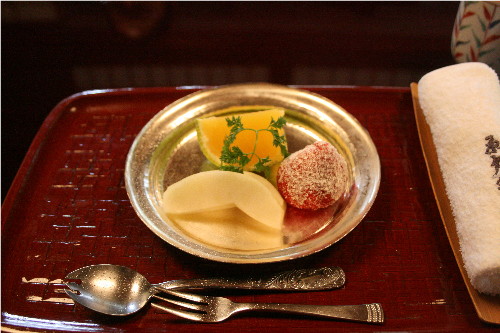 It was classic food with a very modern twist, so you might think that's a sprinkle of caster sugar on the strawberry but it's the finest grated white chocolate. It was a delight from start to finish and in the most wonderful surroundings. Afterwards we had a visit to one of Kyoto's many wonderful temples, Kodai-ji temple and then to a master printer who allowed me to ink up one of his woodblocks and print some copies for myself. It was a day full of lovely experiences. |
Wed, 12 Dec 2012 George's new bike is fantastic -basic sturdy one-geared made-in-China sit-up-and-beg bike with built-in dynamo light, bike stand, front basket, back rack and bike-lock -all for about £60 brand new. Everybody rides them here, the ethos among car drivers is to be careful of both cyclists and school children so that hundreds of the teeniest kids wander home from school alone, weaving down the narrow and larger roads, well drilled in road crossing to which everyone pays attention. I saw a mother with her tiny baby asleep in the front basket of her bike and frequently see old and what look like very old people riding bikes. 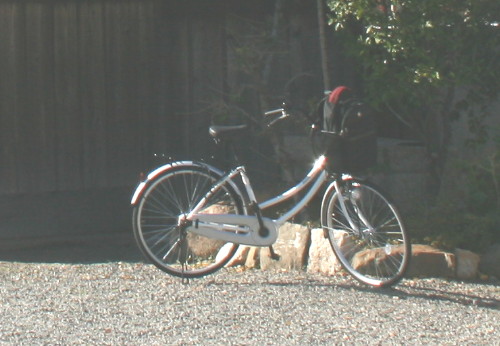 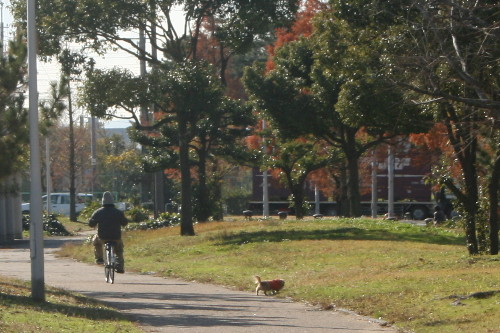 Taking the dog for a walk (above). Heading towards central Osaka working my way in, out and across some busy highways, but as cycling is allowed and ecouraged on the pavements everyone feels safe to do it -even when there are no cycle-paths indicated. Town planners should come here and take a look -it works.  It's fascinating to see how old and new buildings are mixed here... U.K.planners would have a fit if anyone applied to do something similar there. 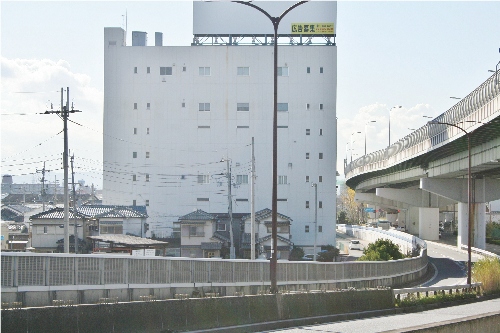 |
Tue, 11 Dec 2012 I'm back in Japan with George after that gruelling flight over Siberia...its like this...10 mins out of western Europe, another 10 or so and you're over Gotland, then on a bit and you're somewhere between St. Petersburg and Moscow approx twenty minutes later. A futher hour maybe and you cross the urals into...Western Siberian Lowland -and from then on its hours and hours of bleakness, past Lake Baikal, eventually over equally bleak Mongolia and then across China to Beijing at which point the dawn breaks and there's Orion disappearing over the south west horizon (odd to see him there!) and the soft pink sunrise icing the fluffy clouds below as we head out over the China Bay and towards South Korea. South Korea is surprisingly mountainous and looks incredibly good fun with snow-runs and ski slopes everywhere, all covered in snow. After landing at Kansai airport out in the bay (on a man made island) at Osaka, when I got through to baggage collection I was delighted to find that my suitcase had arrived (unlike last year) and, after a moment of thinking the stern customs man was going to go through ALL my stuff (until I told him I'd come to visit my son who teaches at AEON in Izumisano -turns out the customs man is a student of George's, he slid my baggage apologetically back on to the trolley un-rummaged) I found George outside with a hot coffee for me. We spent the day shopping in the 100yen shop, having coffee in the London Cafe, catching up and having a delicious supper cooked by Namiki; boiled pork and Daikon radish. I stayed awake as long as I could and slept right through to 7.30am. Ive been out on George's bike for much of today...will blog about that in time. 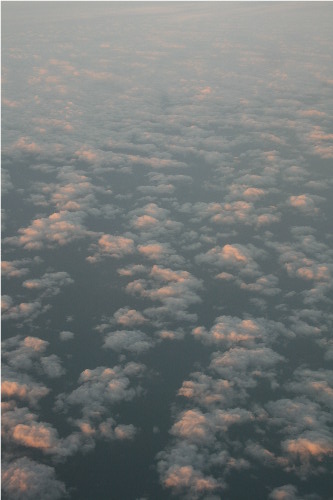 Dawn over China. 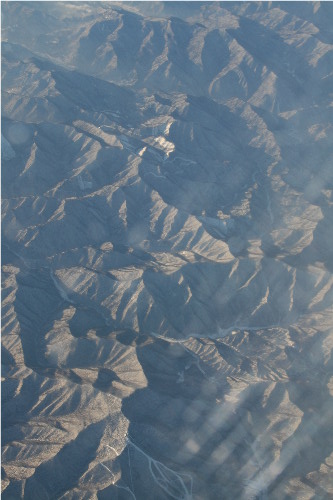 Ski slopes in South Korea. 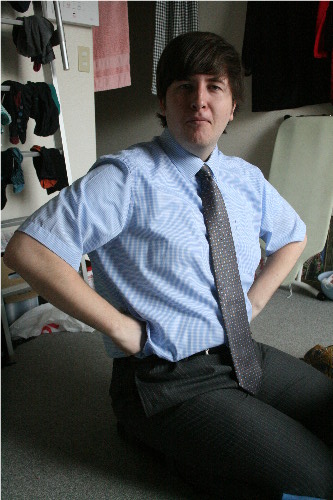 George dressed for work in new shirt and tie.  I'd like this pick-up truck...not much bigger than a Tonka Toy. |
Thu, 06 Dec 2012 I'm going back to Japan to see George...pressure was on to get the tree up before I go at the weekend so... 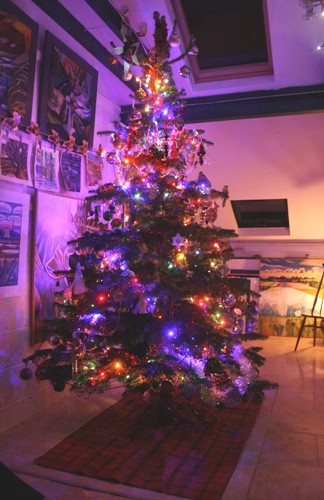 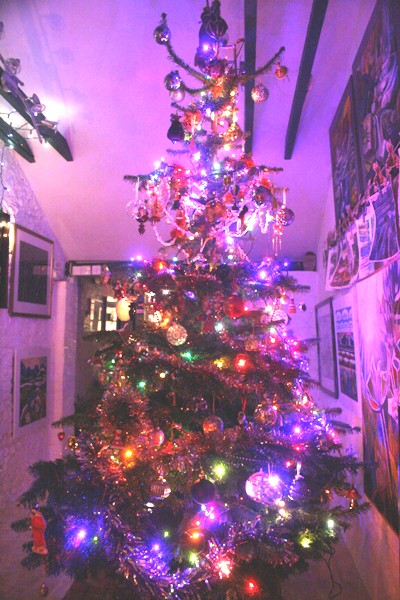 ...this year it's gone into the gallery so it could be a tall one. I'll blog from Japan if George's laptop is working (no reason to assume otherwise). I'm trepidatious about two long flights over Siberia again. |
Sat, 01 Dec 2012 The field through which the winter river runs is fairly flooded; the gulls love it, and I saw what I thought was a flock of field-fares although why they like sodden fields I'm not sure (perhaps they like the insects hovering over the cow-poos (it's a field of heifers) or maybe the worms coming off the flood-water). A flock of about 30 lapwings went over and I managed to get this picture. 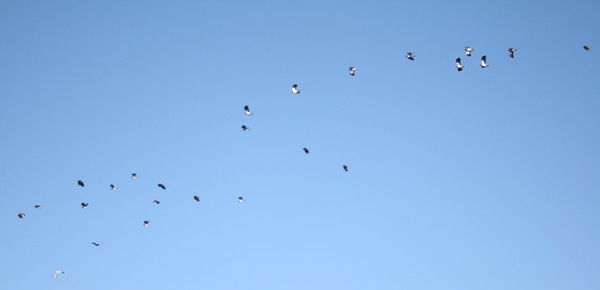 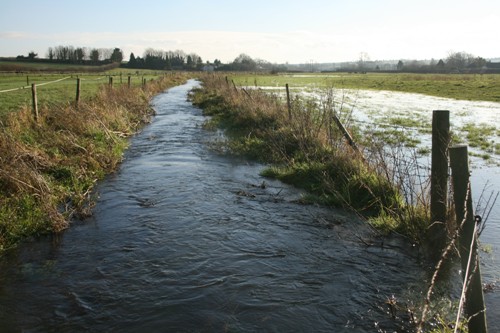 In the past the river ran freely through the field during winter (except of course, and unusually, all last summer too) but some years ago a law was made saying that farmers must fence off running water from livestock so as not to pollute the rivers with manure-nutrients. 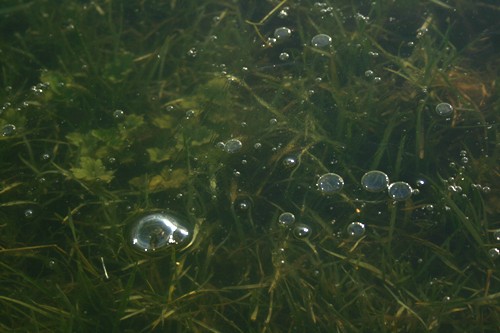 Where the water wasn't running it had a thin sheet of ice on top, even though it was after mid-day. Bubbles collected below and above. 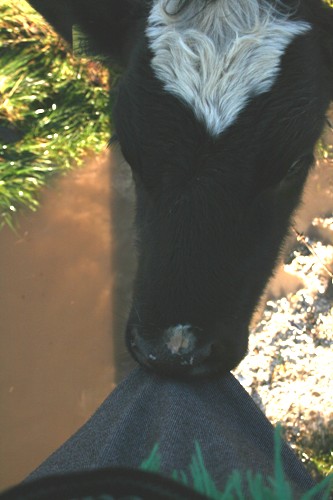 Cheeky heifer trying to eat my skirt. It's been a lovely sunny day but no drop in the water levels along the lane. 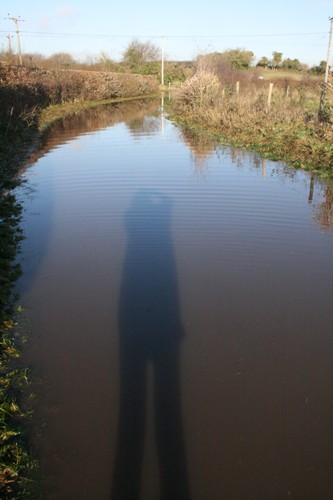 The force of the water has brought some hedge and a river gate down where the river flows into the winter pond. 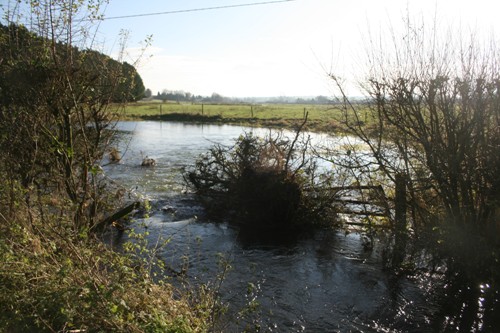 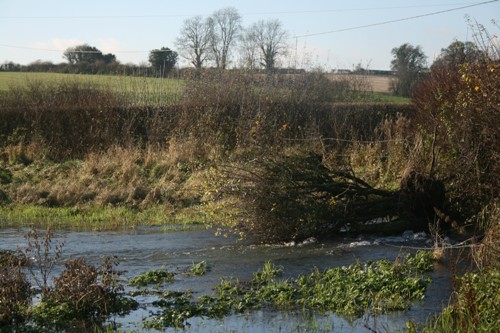 Hedge from the side view. 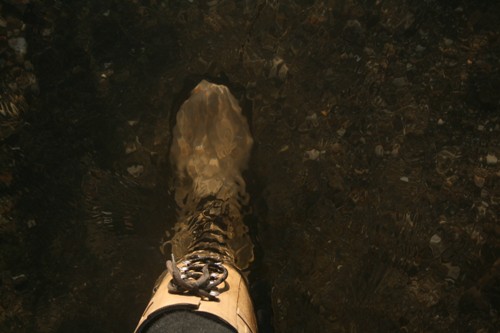 My Wellington boot in the road water. |
Fri, 30 Nov 2012 Hooray hooray hooray Simon Russell Beale is doing his Friday evening programmes on BBC4 about sacred music again. I love Simon Russell Beale and his music programmes, tonight it's plainsong and polyphonic singing -he explains everything including the building of the churches where it was sung and translations of the Latin chants. 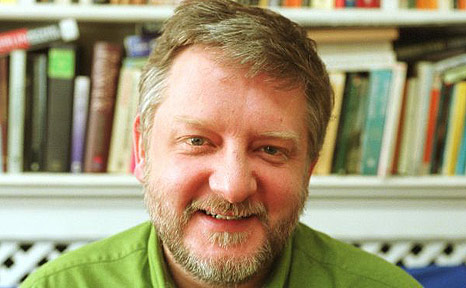 Simon Russell Beale, aka actor of some renown and popular choice as a possible Dr. Who (one day). It's been glorious...we've had some sunshine finally after so much rain. However with it comes the frost and the piggies in the neighbouring field must have chilly toes. 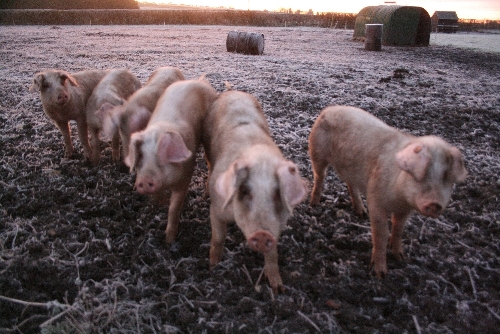 There's still plenty of water on the road at the bottom of the track and I guess that's why the recycling lorry didn't come this morning to take away our recycling.  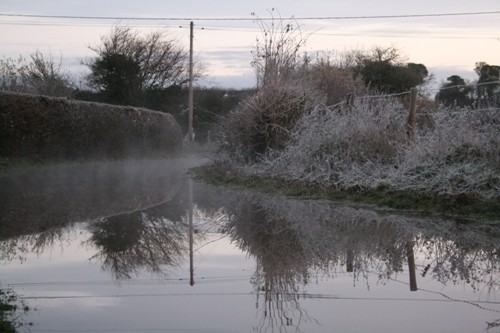 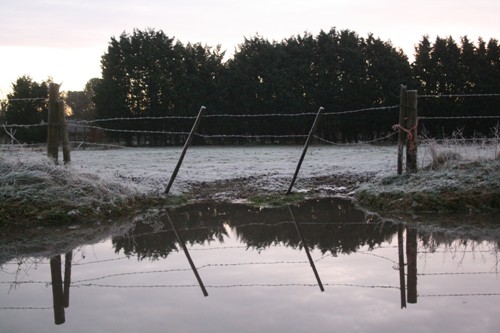 I like the way the wire is light against dark above but dark against light in the reflection. |
Tue, 27 Nov 2012 So...Michael Gove has now sent the ofstedders in to 'ofsted' local authorities to build league tables so that we can rank their success one against the other (adversarial -as is ubiquitous these days). What I want to know is who will rank the Academy schools which have seceded from local authority control. They live under very different rules such as being allowed to choose 10% of their pupil population and having far greater powers to exclude pupils (meaning schools choose their pupils rather than parents choose their children's schools)and they, unlike the LEA controlled schools, can employ people to teach who are not qualified teachers but deemed 'appropriate' by the school. Reading this morning about rates of success/failure of the academies, they are no better nor worse than success rates in LEA schools. In fact with their vast and unfair added investment some of them have done spectacularly poorly and upset parents and pupils across their areas. I think that Academy schools and Free Schools are walking into a minefield...because ultimately their funding (except for a tiny and ever decreasing amount from 'sponsoring local businesses') comes directly from Government and once Govt. have bullied all schools into being Academy/Free Schools they will then hold the purse strings which will no doubt be pulled or loosened according to the whims of people like Michael Gove. Choice...as we're so often told is our right... is nothing of the sort when it comes to schools. It's like the dinner queue at school -if you're last in the queue you get no choice, you eat what's left. At least you might get to the front of the queue the next day. You don't have that option with your school. Why isn't investment all about improving all education instead pitting one school/local authority/system against the other which pressures schools more than ever to teach to a 'success league table' and that only skews matters and is as unreal in fulfilling the needs of pupils as expecting everyone who runs a marathon to be 'good' or 'outstanding' but not 'satisfactory' (and God forsaken should you be near the back). 'Satisfactory' has taken on a new meaning in Govt...'not good enough'. Time to change all the dictionaries. |
Sun, 25 Nov 2012 Apropos of what I've written below, my latest paintings are about water and the effect it's having on our landscape, both from the summer just passed and the autumn/winter so far. Oh dear! Once again I'm reminded of what James Lovelock (author of the Gaia hypothesis) said when asked 'So what are the implications of Global Warming...?' and he replied 'Many surprises'. I wish, like Nigel Lawson (ex-chancellor of the exchequer) I could believe that global warming, as we are experiencing it now, is a natural phenomenon...I'm sure it's man made (or man-encouraged) and this is just the beginning. 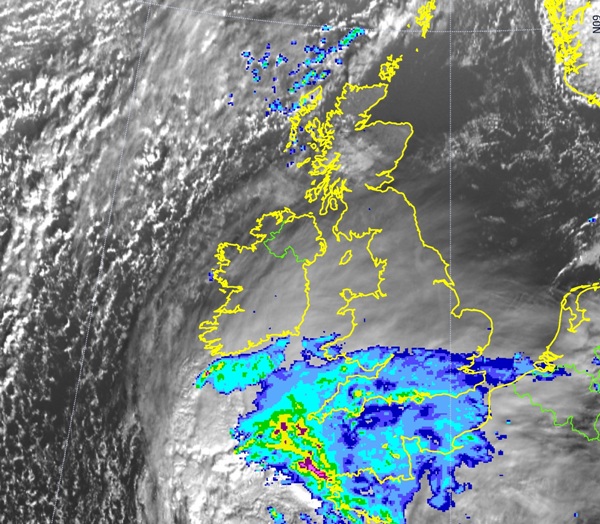 This is yesterday's met office picture of UK as a band of heavy rain approached us overnight in Dorset. We're onto a newer lot today after a short sunny respite. |
Sun, 18 Nov 2012 Yesterday we went to see Alan Bennett’s ‘People’ which was written after visits to National Trust properties where he baulked at the idea that these places in natural decay were re-gentrified and held in aspic to accommodate the reverential visitor (and too many of them). I have to claim allegiance here and say that my sister and father work in National Trust properties, one employed and one as a volunteer, but for all that I was able to recognize and concur with what the play was suggesting –that perhaps things were more interesting when properties were left alone, not made presentable and invested with the ‘I Am Your History –Come And See Me And Be Part Of Saving Your Heritage' ticket. Trouble is...I love going to National Trust properties. I love seeing the working rooms with all their clues as to how (certain) people lived, I love being upstairs in those houses and taking moments when no-one else is there to breathe in the air and imagine a different world outside the windows –a world belonging to people who lived a long time ago. We know enough of our past to involve ourselves in fantasy, imagination and the stories we have taken from behind us but our future is far more uncertain and our fantasies taken from the future hold too much from the realms of make-believe to root us in the way our history, for good or for bad, does. The play is terribly funny, with two sisters and an old retainer trying to decide what should become of the house –should it be used for porn movies? go to the National Trust? or to a nefarious consortium looking for just such a property to pick up and move lock, stock and barrel from south Yorkshire to Dorset where its warmer? Alan Bennett is so funny with the dialogue – and from the actors it feels effortless, as if they don’t do it every day and sometimes twice a day, the main three being Frances de le Tour, Selina Cadell and Linda Bassett. Bennett is fantastic with the subtle plots and turnarounds, leading you up one quiet garden path and very suddenly off it and to another quiet conclusion but not before the Bishop has (almost) seen live sex on a four-poster bed but thanks to his blindness believes it’s the WI busy with something or other and not before, also, we discover that the old retainer is the half sister of the other two thanks to a liaison between their father and one of the girls in service. What happens in the end? It goes to the National Trust but I’ll say no more except that we were laughing our heads off. |
Thu, 08 Nov 2012 The new Wellington College in China!! And its ethos is to encourage creativity, enquiry and self reliance!!! While our education system heads in the other direction as all arts subjects are omitted from the new e-bac. Will we come to regret our narrowing of the accepted curriculum when China becomes and arts and design centre of the world? |
Wed, 07 Nov 2012 I had a lovely week on Exmoor, largely wandering on the top of the moors with my drawing stuff. It was very wet so I rarely carried my camera -therefore fewer photos than normal. I saw the stag I encountered last year but frustratingly much more fleetingly and this year I saw no rutting or female deer. The birds on the farm where we stay are plentiful, loads and loads of sparrows, blue tits, great tits, wagtails, robins, bulfinches, wrens, kestrels, buzzards, woodpeckers, masses of starlings and one small pale bird with black stripes across its eyes that I have no idea what it was. 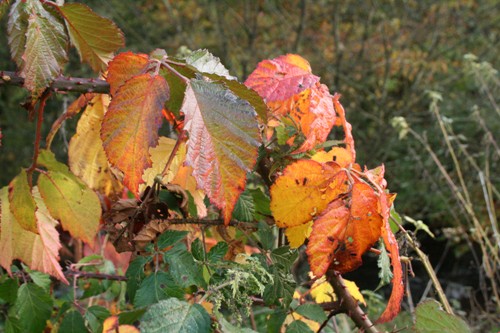  On another note -the larch are in trouble on Exmoor -lots of dead and dying larch. There's likely to be trouble when the ash die-back spreads as a huge proportion of the trees planted by the farmer recently are ash...hundreds of young ash all planted along the river Exe, probably with Govt. grants...well it's a shame that the Govt. didn't listen to the Horticultural Trades Association when they warned them in 2009 about ash die-back. No doubt a fair bit of tax-take was spent on grants for tree planting which will have included a significant quantity of ash saplings. I heard a nurseryman interviewed on the radio; he said that we have too few tree nurseries in UK because there was no Govt. support while Dutch and German nurseries were getting grants from their Govts. It's meant we've had to import to fulfil our needs. It's a shame we didn't make better use of our natural ocean barrier. I worry that being such a London-centric nation, people in power see too little of the rural world where all this change is starkly clear. 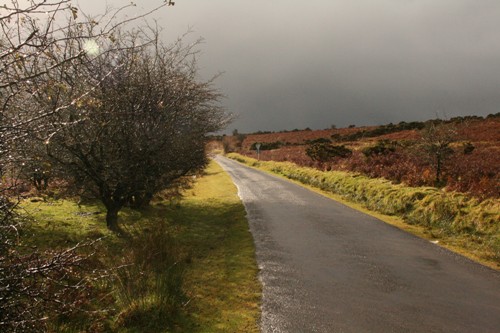 When we bought our house 25 years ago I was so proud that we owned a huge tree. It felt amazing to go from not believing that we would have a large garden to having a large garden with trees including one really big tree under which my shed (mark II) now nestles. The sad thing is that our large tree is an ash tree, and for all that Environment Secretary Owen Paterson says the Govt. are doing what they can, it's clearly too late. Once again we've waited until it's too late to react -depressingly repetitive of Govts. one after the other. I'm devastated in advance for our ash tree, also for the larch and for all the horse chestnut trees which, all over the country, are suffering from bleeding canker. Finally - there's this - Acute oak decline - a condition affecting oak trees in parts of England and Wales, in which bacteria, including one species previously unknown to science, are believed to be involved. So, in 2050 will we have any more oak, ash, horse chestnut and larch? We already don't have elm except in a small area around Brighton. Sadly, I can't even remember what an elm tree looks like. I think, in the future, we'll be the land of thorn trees and bracken. |
Tue, 06 Nov 2012 Last week on Exmoor we went to see Damien Hirst's Verity at Ilfracombe, and although I think she's spectacular and a great thing for Ilfracombe...I have reservations about one particular element -the sword arm is far too short and it appears to swivel as if it had no shoulder-blade but swings round on some two-dimensional joint. It isn't clear from every angle but where it does show it is distracting in its wrongness. It may be that Damien Hirst was trying to exaggerate the look of perspective as the arm diminishes into the distance...but I'm not convinced. 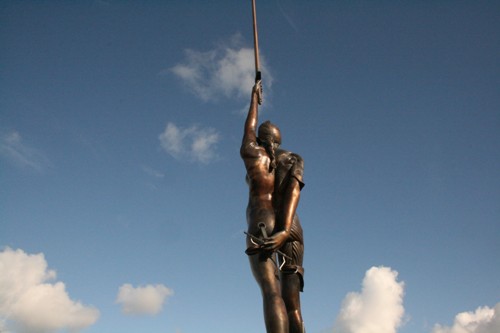  I can see clear correlations between the sculpture and Leonardo's drawings of foetuses in situ. 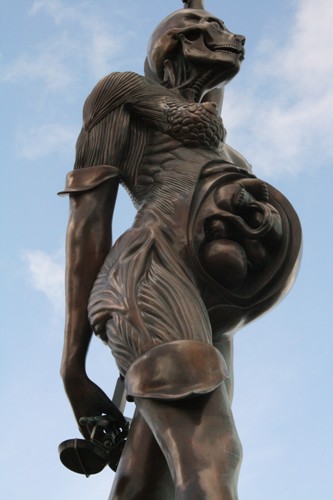 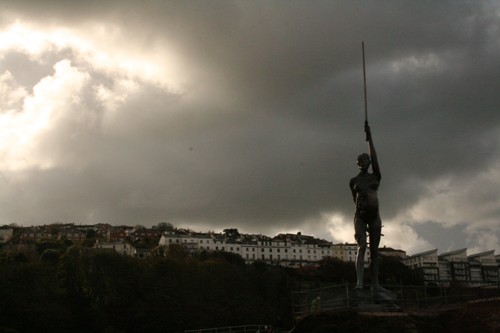 On the whole people in Ilfracombe seemed really pleased with her because she's drawing in loads of extra tourists. One man in a nearby farm shop was cynical saying Hirst owns acres of land here and is applying to build 500 eco-homes...but as a friend of mine was saying that she'd done a survey for the local authority which showed Ilfracombe has a particularly high population of men between the ages of 19-35 from Liverpool who've decided they don't want to work and find it cheap to live on benefits in Ilfracombe...perhaps 500 eco-homes might get them into work! 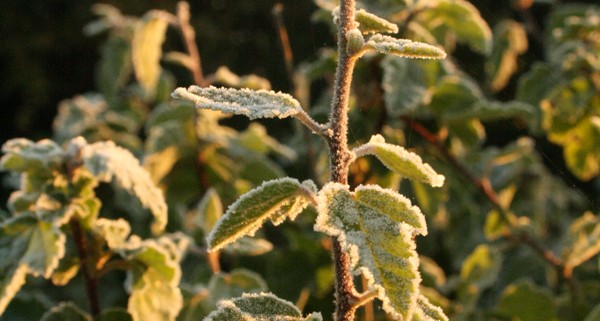 More evidence this morning of the arrival of winter...but today went on to be a beautiful sunny day almost good enough to dry a line of washing (which I almost did). I went out drawing near this flooded field, and later cycled to the nearby ford which already is flooding the road across which it flows and beyond for about a half mile. 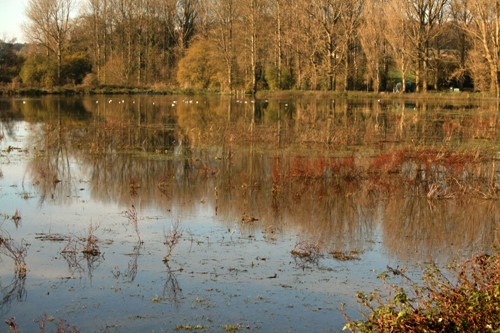 The gulls are enjoying the water. 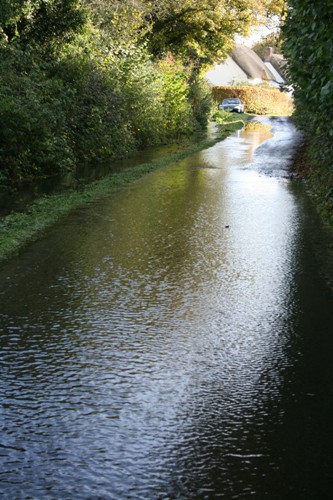 River (on the left) and road merge. |
Mon, 05 Nov 2012 Rising over the eastern horizon in all his magnificence when I got home from work tonight...Orion! proving that winter is indeed here. |
Fri, 26 Oct 2012 beloved beloved beloved beloved beloved beloved beloved beloved beloved beloved beloved beloved beloved beloved beloved beloved beloved beloved Exmoor! tomorrow, for a week! |
Mon, 22 Oct 2012 I hope that the BBC don't throw the baby out with the bath water. I have a horrid feeling that the current problems will be picked up by people who don't like, or have some grudge against, the BBC and seek to change it dramatically. Peter Rippon of Newsnight may well have been wrong not to air the Newsnight investigation accusing Saville of paedophilia but the investigation WAS made and was ABLE to be made because of other people in the BBC. I love the BBC, especially the radio. I don't love it without discrimination of course; it can rightly be accused of accommodating quite a dull common denominator with some of what it airs, but it consistently airs more interesting programmes than any other broadcasting company, both on radio and TV. |
Mon, 15 Oct 2012 Here is a lovely recent picture of George in Japan. I can't wait to go and see him again -just before Christmas and only for a week. 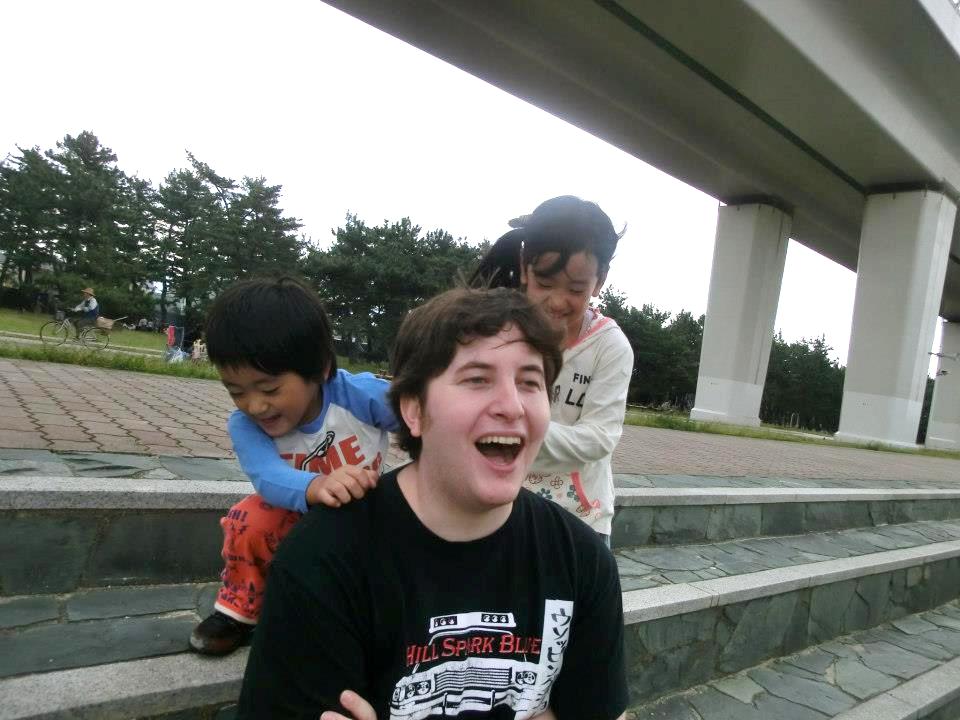 |
Sat, 13 Oct 2012 Simon's school, initial ofsted feedback -'Good and on the path to Outstanding'...that feels like a fair judgement. Apropos of the other day's blog re: Ted Wragg being an advocate of 'warmth, humour and humanity in the classroom'...the current head of ofsted, Michael Wilshaw, was recently heard to say that 'if teachers' morale is high then I'm not doing my job'. Well God help all the students if Wilshaw wants them taught by a load of cowed, depressed and anxious teachers. I expect you remember your best teachers as being the frustrated, surly and unhappy ones? (NOT) I don't recall our motivated and successful Olympic teams having low morale this summer. I think Ted Wragg would have something to say about Wilshaw's attitude but as Ted (disastrously for education in UK) is dead and Gove, who calls Wilshaw 'My Hero', is alive (apparently) my suspicion is that good sense will not prevail.   The Michaels Gove and Wilshaw...and look! Wilshaw is in a classroom. |
Fri, 12 Oct 2012 Thank the Lord!!!!! A B-i-i-i-i-g blue sky; a few clouds at the edges with a twang of red, an old moon in the east sky as skinny as Kate Moss...but NO rain! I could feel the autumn nip filter through my sweaters as I took two week's recycling down to the end of the track. Hmmmmmmmmmm |
Thu, 11 Oct 2012 I've just caught the tail end of what looked like a fantastic programme on the telly presented by Huw Edwards (yes, he of the BBC news) about Wales and its history across 1000 years. Of course there was plenty about coal-mining and harsh environments, welsh language and identity, but as he pointed out...the Welsh have always loved 'their square mile' and, seeing some of the glorious landscapes, I'm not surprised. It reminded me of just how loyal I feel to the South West of England, and a desire from my young years to live in a house 'with grass up to the front door'. I remember forming the words in my mind on a family day out walking on Exmoor. I can picture the house I was looking at as I thought the words. Perhaps it was in defiance of having been brought up on the High Street smack in the middle of Taunton (hardly a metropolis...but Somerset's main market town and County town). From our roof we could see the Blackdowns, the Quantocks and the Brendan hills which lead on to Exmoor. My own kids have all rebelled at the notion of living with grass up to their front doors by leaving home and going to the city (two to London, one to Osaka). I wonder, if they have children, what they will do? 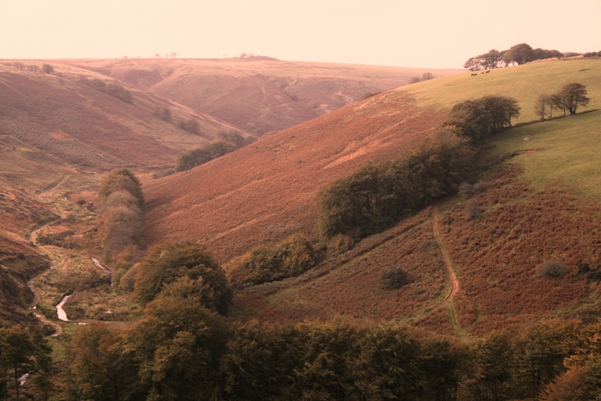 One of my favourite Exmoor views, looking down on the river Exe as it winds through the Exe Cleave. |
Wed, 10 Oct 2012 Simon has just been told he has ofsted coming into his school over the next two days. I hope its a positive, meaningful, friendly and constructive two days but, as ever, worry that it will become something of a battle ground between the practitioners and...well I'm not sure what -I've just read that some ofsted inspectors are not even holders of a teaching qualification. The 'them and us' feeling doesn't go away after years of ofsted inspections. It would be helpful if some kind of meeting of minds could be facilitated but teachers will always be cornered by the fact that they have no power to inspect the inspectors in whom they frequently have little faith -being so far from having done or even never having done any teaching themselves. The biggest and best voice EVER on education was Ted Wragg, head of St. Luke's School of Education at Exeter University. He was often on the radio expressing good sense about teaching and the practicalities of it. He died too young with too much left to do in terms of outing the idiocies of the over bureaucratic and rarefied ofsted organisation. Throughout his academic career he would always make time to teach a class of children for one or two days a week so that he would remain in touch with the profession at the 'chalkface'. This following, from Wikipedia, is absolutely as I remember him when he was my personal tutor at St. Luke's school of education where, thanks to him, I often feel I had the best year of my entire education - 'He was a frequent broadcaster on radio and television and wrote regularly in newspapers including the Times Educational Supplement and the Guardian. Wragg was an advocate of warmth, humour and humanity in the classroom and defended these ideals with passion against a narrowly utilitarian approach to learning; he was vociferous in opposing attempts to roll back the education changes of the 1960s. He had a ready and sharp wit, which worked well with his savage indignation at politically-inspired educational reforms. Although initially his beliefs were reflected by the government of Tony Blair, he later fell out with it and attacked it, nicknaming Ruth Kelly "Ruth Dalek" and "The Duchess of Drivel"; he also coined the nickname 'Tony Zoffis' (Tony's office) for Andrew Adonis, then a member of the Downing Street policy unit but subsequently ennobled and appointed as Parliamentary Under Secretary of State for Education.'......has anything in education changed since Ted Wragg's death in 2005?? |
Fri, 05 Oct 2012 My Dad always talked about his dog Sally who went away in the war to do war service. My Dad was a boy in London, just off the Holloway Road, during the war. He had three attempts at being an evacuee but they were so unhappy that he went back home. I imagine Sally will have gone off early in the war as Grandma didn't have the time or money to look after her. My Dad says that one day after the war was over, a soldier came to the door and said 'I've got something for you...' -he took Dad out to his lorry where Sally was sitting in the passenger seat. From the moment she first saw him Sally went bananas. She danced around him and wagged her tail for the rest of the day. My Dad told me she won a medal for her war service and I'm wondering now if it was the Dickin Medal, about which I've just heard, awarded to 'honour the work of animals in war'. Here they are after the war and Sally's return, My Dad, Grandma and Sally. 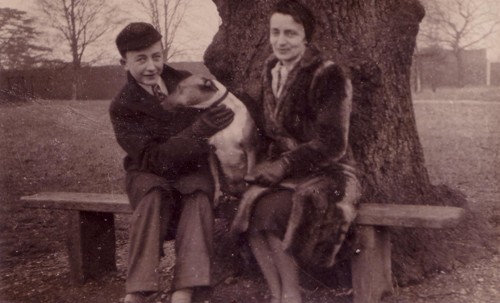 |
Tue, 02 Oct 2012 Howling gale, horizontal rain, flying leaves, bending trees, falling apples, tea, toast (Simon's bread), marmelade (lashings of), radio 4...oh crikey...and now the sun is shining! |
Fri, 21 Sep 2012 I'm just reading 'Jerusalem' by Simon Sebag Montefiore. It's not exactly a light read...here's a not untypical paragraph 'Atrius was on his way through Constantinople after a meeting with Constantine when he felt a 'relaxation of the bowels'. Before he could reach a convenience , wrote Socrates, Atrius' bowels burst in the middle of the forum with his intestines, liver and spleen haemorrhaging out of him, a clear demonstration of the evil of his heresy.' (He had been preaching that Jesus was subordinate to God and therefore nearer to human than divine). It's not a beautifully written book; the sentences are stuttered and filled with death, destruction, marching armies and clunky facts...I preferred reading 'The Life and Opinions of Tristram Shandy, Gentleman' which is still number one on my book list. So many things happen in 'Jerusalem'; empires are born, live and die in a single sentence. Tristram Shandy is a tour de force in digression...it takes till half way through the book to get him born. Almost nothing happens in a sentence! |
Wed, 19 Sep 2012 I've been out on my bike today, and what did I see? I saw big fat blackberries of which I ate loads and considerably upped my day's intake of vitamin C -they were lovely, bready, not so sharp they twist your tongue in your mouth. I left enough for the birds. I saw unripe blackberries as red as rosehips and shiny like brass. I saw a spider about one inch across, in the middle of his big web, poop! I saw clouds in a blue sky against, the sun, with their silver linings on the outside. I saw a dead chicken on the road which will make someone very sad when they find her. I saw my life pass before me as I skidded on a steep slope across a ploughed field. And I saw great wide open landscapes on top of The Chase, gleaming in the sun. Phew! It was nice, I stopped to draw but the drawings don't capture the half of it! |
Sun, 09 Sep 2012 Listening to The Archers and young Freddie being thrown off his father's rearing horse...and the typical rather goody-goody speech from Shula about his being too young -reminded me again of our teenage years with the polo ponies and one particularly difficult horse called Espaldo. He was feisty and single minded and tended to rear a lot. It's probably quite amazing that there were no accidents. The thing is that if I were a horse I'd be like Espaldo, wanting to go the way which took my fancy and not compliant like the two lovely horses I looked after. One day, in the short part of the woods, he'd thrown his rider (whose name I can't remember -just that she was younger sister of Vicki) off and I got on him to give her a break. He was such a handful, hats off to Vicki's sister who rode him most of the time. But what a pleasure it was to get back on Diablo. Diablo was smaller than most polo ponies, he was not handsome like the other polo pony I looked after; he was plain but could turn on a sixpence. He was like a snowflake, responsive to every breath and so good natured. I was lucky to have had those years. Thank goodness the Commander, who took the risk engaging us girls to look after the ponies, wasn't as goody-goody as Shula. |
Fri, 07 Sep 2012 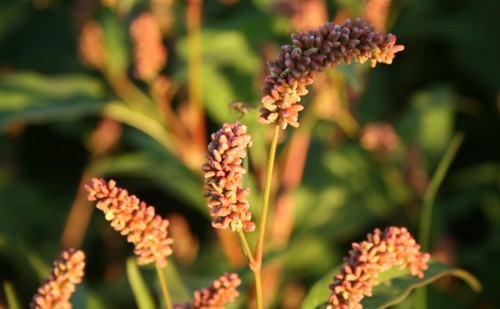  My neighbour's pumpkin patch this year has not been too successful in terms of pumpkin growing (the wet weather has rotted the roots) but it has produced a profusion of wonderful weeds. I went out to enjoy the sunset and took some pictures of the weedy bounty. 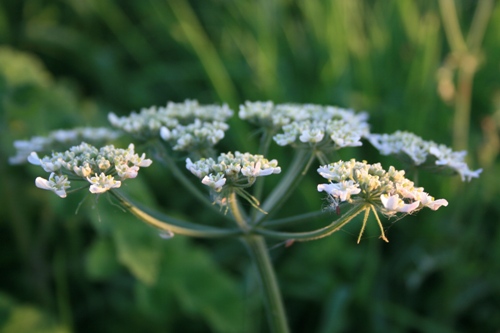 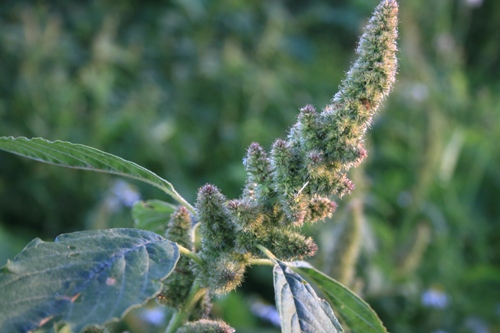 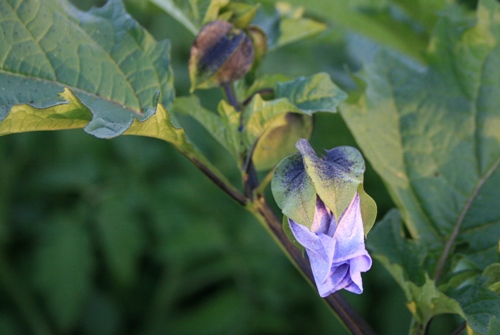 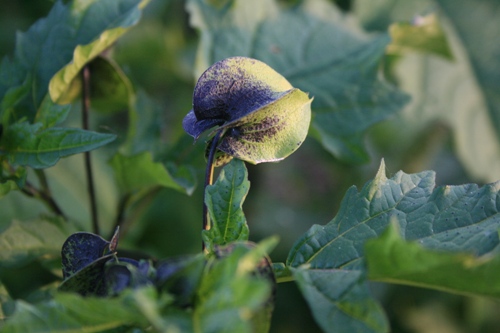 Shoo fly plant (Nicandra) is a member of the potato family and originates in Peru. It's growing in abundance across the pumpkin field. 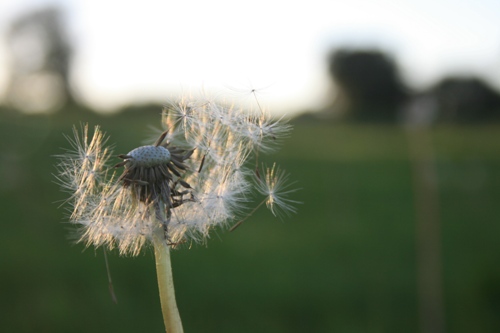 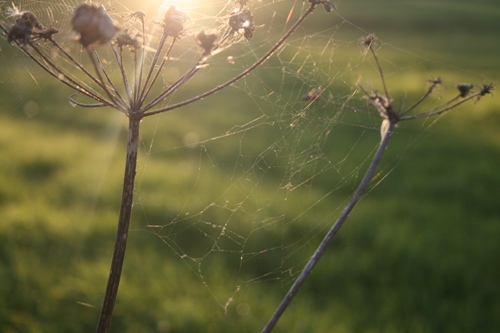 It's an astonishingly blue sky from horizon to horizon except where the sun is setting and has bleached out the blue. |
Tue, 28 Aug 2012 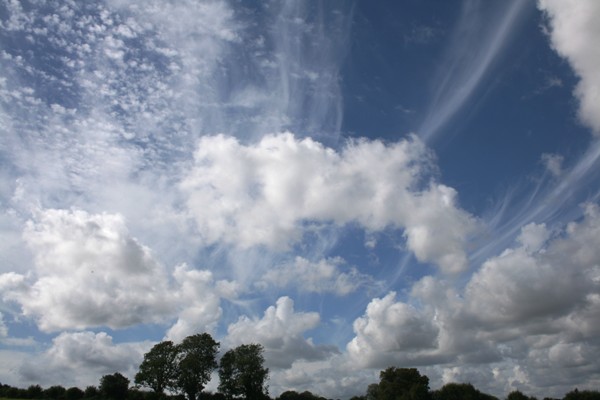 The sky is painting pictures again today that I can't match. 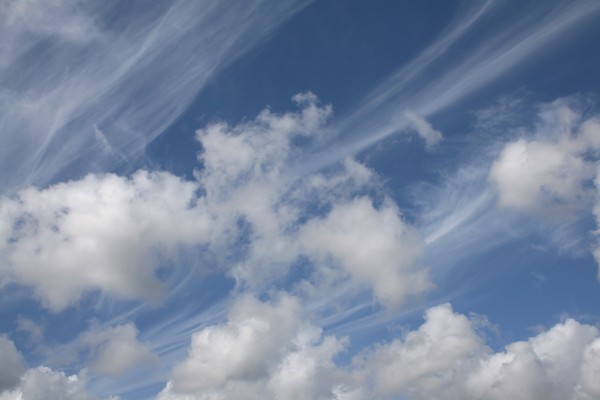 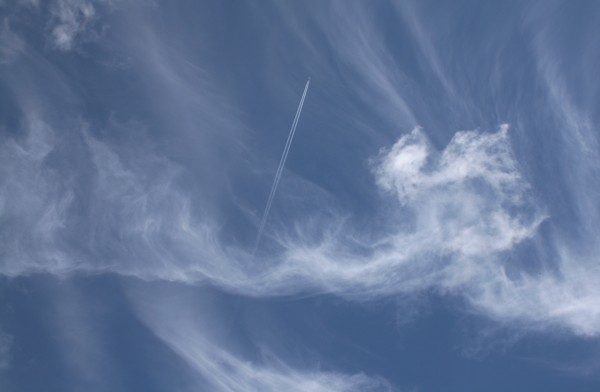 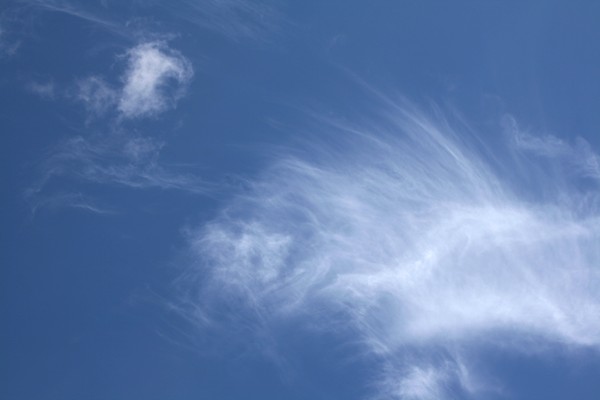 |
Sun, 26 Aug 2012  Today we went to see an old mill called White Mill, part of the Kingston Lacy estate near Wimborne. It is likely that there has been a mill on the same site since Roman times but certainly it is mentioned in The Domesday Book as one of the eight mills on the Stour near Wimborne. It was occupied by the Joyce family (including a James Joyce) from 1776 until 1906 when the last miller, T.D. Joyce died. I learned about waterwheels, under-shot and over-shot wheels, paddles, buckets, spur wheels, cogs and crown wheels. This mill had two mill-wheels which ran four millstones, and was unusual because all the wheels, cogs and spurs were wooden. The grinding sides of the mill-stones were made from chucks of French Burr stones from a quarry near Paris. Burr stones come in sections too small to make one complete mill-stone so they were jig-sawed together and bound with a hot and rapidly cooled steel band. To deepen this Burr stone, plaster was poured on top and shaped to fit -hence 'plaster of paris'. We saw how the white flour was separated from the less 'pure' flour, the 'middling' flour -from where the saying 'fair to middling' comes. I'd like to go all around it again and see again how all the clever bits and pieces work together, all the ingenious designs right down to a wooden handled hook for twisting the straw to make binder with which to tie the sacks of flour.  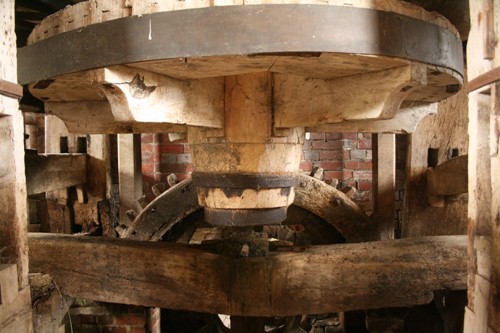 In one of the cupboards I found this old bike...  ...which has seen better days. |
Sat, 25 Aug 2012 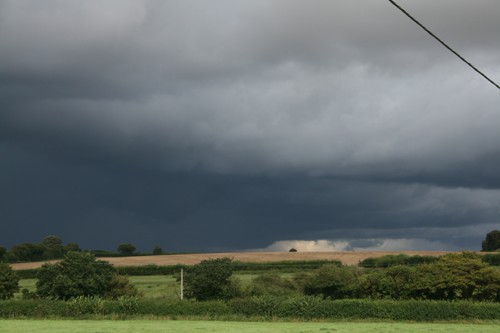 It's lovely watching a storm go by in the distance while we bask in our bit of sunshine...petulant -like the wrath of Moses as he comes down the mountain before slaying 3000... 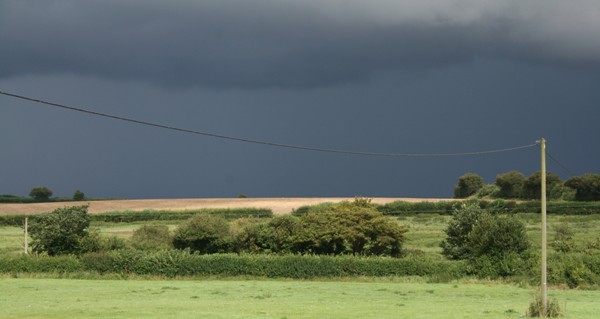 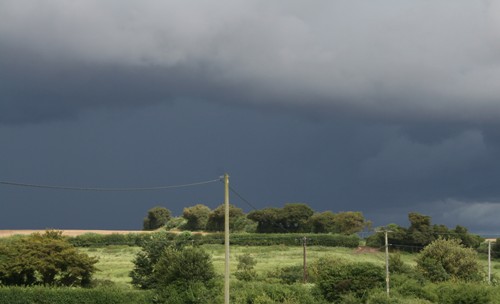 The thunder and lightening reached us finally and blew our very sensitive residual current device -several times! |
Thu, 23 Aug 2012 More than 600,000 schoolchildren get their results today amid controversy over the introduction of tougher exam marking. Meanwhile my husband, who is head of English at what Government has been known to refer to as a ‘bog standard comprehensive’, is the conduit through which this unfortunate news is delivered to his hard working students. Yes he has noticed a drop in marks; he said to me about this year’s results ‘It doesn’t tie up; one person gets an A* in literature and a C in language, another gets a B in literature and a D in language. Something has happening beyond our control’. Once again the teachers and their students are pawns in the Great Government Game of moving the goal posts. Teachers have assiduously followed government directives year after year; some of them close to unworkable, all of them requiring large amounts of course design and research. Teachers have danced to an orchestral morass of tunes from consecutive education minsters, often feeling that their own skills and ideas might be more appropriate but unable to emerge through the weight of bureaucracy flowing from above. Teachers’ sense of autonomy in a class room is customarily diminished as education ministers believe that they have the better ideas on what and how teachers should be teaching and managing in class, forgetting that what teachers do at any one time has depended heavily on what the previous cohort of education ministers have decreed. My husband has given 28 years of wonderful, exciting and committed teaching to a school where he has had consistently good results and where he manages a fabulous english department despite the vagaries of education ministers. For the sake of the students (this year’s lot for whom I feel very sorry) and for the sake of the teachers, it’s time a government education minster talked about education and teaching in a way that allows teachers to feel confident that the minister has been into school for a good length of time and has a profound understanding of the nature of schools and the fantastic job that most teachers do. Is Mr. Gove chuckling about all the good he can be seen to be doing as he ‘raises standards’ (moves the goalposts) next year? As you may have seen from a previous blog, the reason I left the much smaller institution of the Adult Education was for reasons not dissimilar to the idiocies of the general education system; pointless requirements, aims and objectives needed to justify the existence of the bureaucracy above. Keep it simple -let us teach!!! |
Tue, 21 Aug 2012 Bailey, sleeping but in the clear knowledge that his tennis ball is nearby. 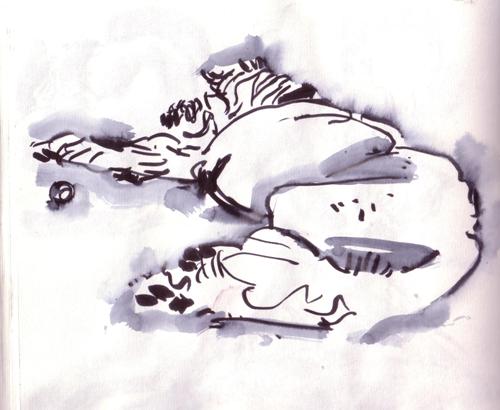 The Blade of Light -from St. Paul's Cathedral across the Thames to the Tate Modern, looking at the new building on the south side of the river, near Blackfriars Bridge, known as The Shard. 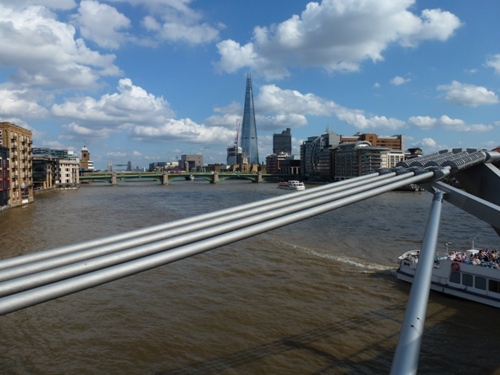 Tate Modern has a peregrine falcon perching for the day on its tower; the RSPB had set up with telescopes for all to view the bird -glorious that it loves London, nests on the Barbican and perches on the Tate Modern! 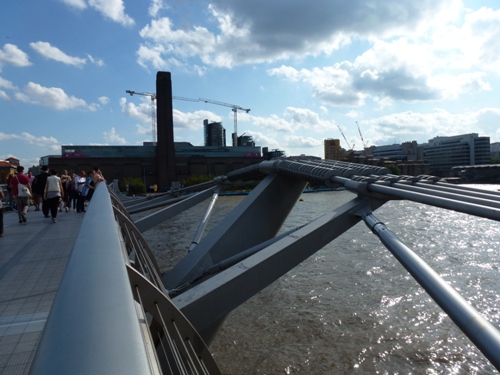 You can make out Shakespeare's Globe Theatre (replica -picture below) squished into the modern world on the banks of the Thames between The Shard and Tate Modern. 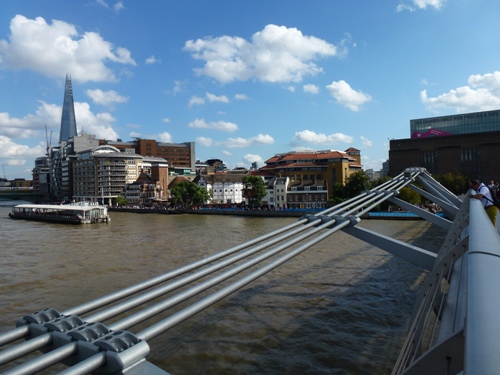 And finally, when we got into Tate Modern we saw the new underground tanks which are exciting but nothing moved me as much as this Dot Procter painting 'Morning'. 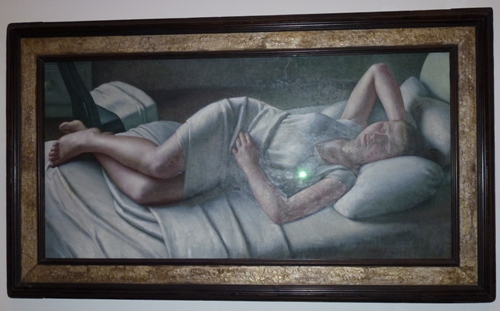 In Tate Modern shop I bought another landscape-shaped watercolour-paper block. |
Sun, 19 Aug 2012 Last time I was here in Ealing I think I blogged about the moorhen on her nest of sticks with relentless rain pouring on her. I had hoped she wasn't sitting in vain so I was delighted this morning to see, on that very same nest.... 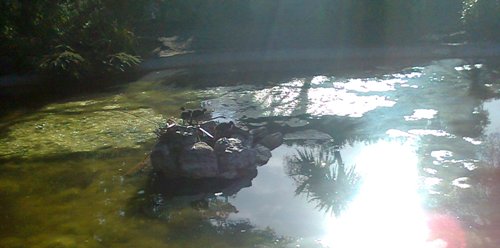 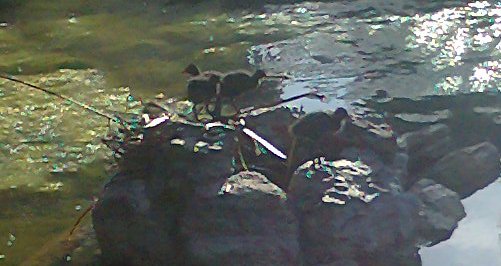 ....four leggy chicks!! |
Sat, 18 Aug 2012 Back in Ealing walking Bailey the optimistic labradoodle in Walpole Park, woohoo!! |
Fri, 17 Aug 2012 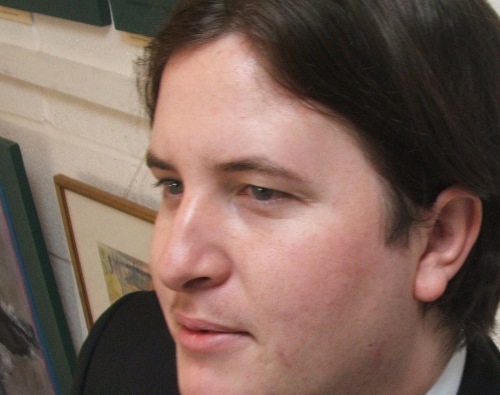 Off to London for a few days...Simon to watch some cricket and me to help Mary move into her new house with three other student mental health nurses. I've just seen Cilla Black on the telly with her original nose which I LOVE! I don't understand why she changed it. Years ago when I was a gallery attendant at the Hayward Gallery, to diffuse the boredom I would play 'most interesting nose' competition. One day I saw a perfect nose and must have spent too long looking, because eventually I realised it was Michael York; he thought I was staring at him because he was him. I should have had the courage to tell him he'd just won 'most interesting nose' competition but I didn't. Above: A fine nose (my son George's nose). Below: the winning York nose  |
Thu, 16 Aug 2012 I went to see my 95yr old Great Aunt Sue today; we went to the pub for lunch. She talked about family from the past and I'm writing it down here before I forget -her father was called Herbert Lavallin Puxley, I knew that already, but her father's sister, always known as Aunt Kitty, married a first cousin also called Herbert Lavallin Puxley -that was something I DIDN'T know! Aunt Kitty, like her brother, had four children one of whom was called Ruth Lavallin Puxley and played lacrosse for England. Aunt Sue, whose real name is Rosemary Lavallin Puxley, kidded her school friend that it was SHE who played lacrosse for England as the initials on the England play list were 'in goal - Miss R L Puxley'. When her friend suggested if she were that good she should play for the school Aunt Sue said 'No; I'd be too good and don't want to embarrass anyone'. On my way there I stopped at Uncle Phil's memorial on the Berkshire downs. He was Aunt Sue's mother's brother. He died in the 2nd battle of Gaza and is buried in the commonwealth grave in Gaza. 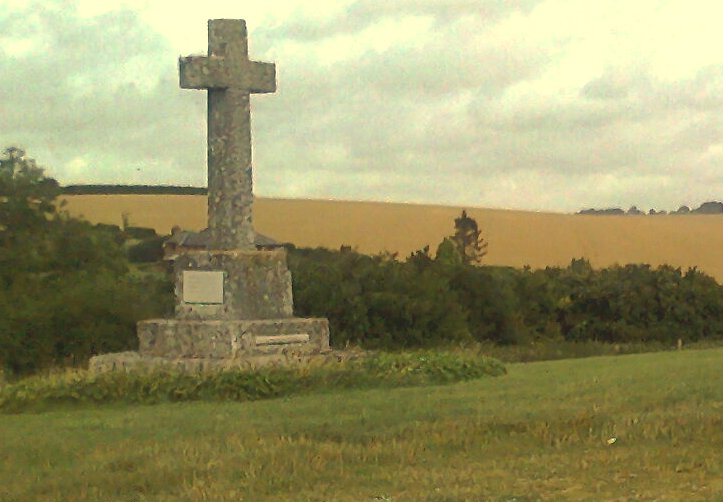  Uncle Phil in Gaza. While I was at his memorial, a man was there with what I thought was a crate of rabbits enjoying the fresh grass...until he lifted the crate and out flew 16 homing pigeons. They lifted up into the sky above the memorial and made several circuits. I thought they'd found their direction as they disappeared south west. The man drove off east...and moments later the pigeons were back! It seemed to take them a long time to decide on a final direction. They then got caught up in a long languid flock of sea-gulls and I couldn't keep up with them any more so I'm not sure of their final decision. |
Wed, 15 Aug 2012 We also visited Uppark on our jaunt to Sussex, a lovely 18th century house. I particularly liked it for its wide open outlook and because it was placed on top of a hill with swathes of wild-grass meadows all around -landscaping on an elegant, even bleak, rather than ornate design. 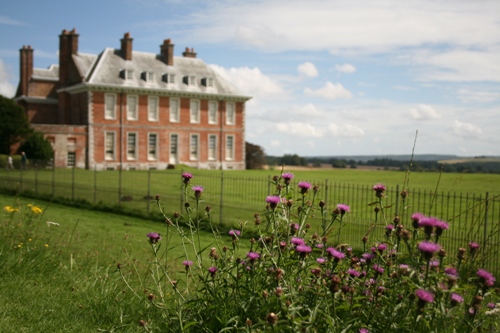 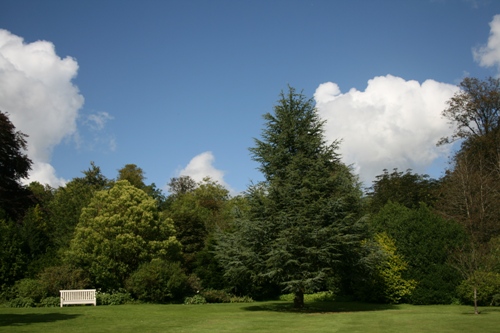 One remarkable thing about Uppark is that it was rebuilt, after a major fire in 1989, as close as possible to the way it was before the fire. It gave craftspeople the chance to work on old stone masonry, woodworking and decorative plastering techniques. The servants' quarters are in fantastic nick; H.G. Wells' mother was housekeeper there for some years, not wholly successfully. I think she was 'let go' when her organising skills didn't match the job required! 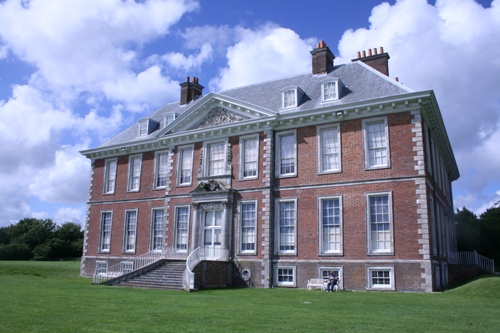 In the housekeeper's sitting room is a framed application for Herbert George Wells to attend the local grammar school. Later, he based many of his characters on people he came across in the house. |
Tue, 14 Aug 2012 Clearing out the loft I found this...which reminded me why I left the Adult Education system (in a fit of frustrated pique). Now you'd be mistaken for thinking that the most important people in the Adult Ed. system were the tutors. If you look at this you might eventually find the little box which says 'tutors'; to help you I've drawn lots of arrows pointing to it. This document was the new staffing structure for 2006. The system was a bureaucratic nightmare and if you know anyone else who taught/teaches for Adult Ed., ask them what they think of their 'staffing structures'. I'll wager you don't get a positive response.  One of the National Trust houses we visited on our Sussex jaunt (but is actually in Hampshire) was Hinton Ampner; lovely house and gardens, here are some highlights. 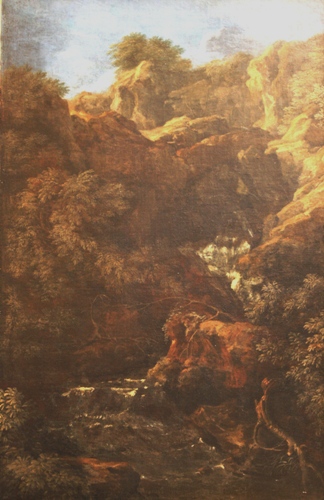 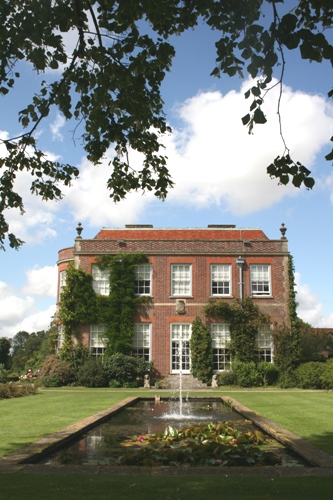 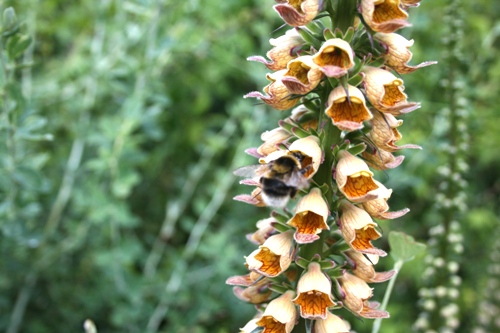 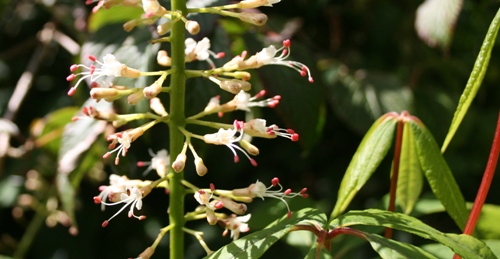 Apparently the original Tudor house attained notoriety in the 18th century after it became uninhabitable due to a severe haunting. The tenant, Mary Ricketts, wrote extensively on the subject for her children's benefit after having been forced to flee the property with a few remaining retainers (many had already left in terror). The house was pulled down in 1793, after its replacement had been built about 50 meters to the south. The current house is a much re-modelled (and simplified) version of the 1790 rebuild. |
Fri, 10 Aug 2012 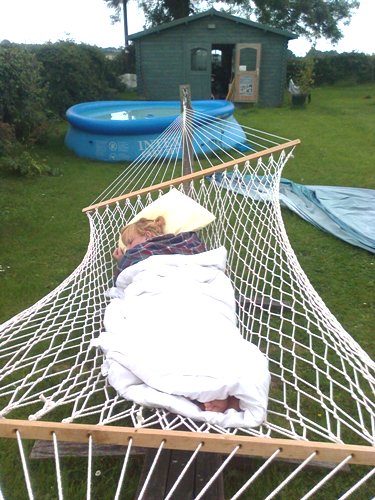 My daughter's home for a week of R&R... |
Thu, 09 Aug 2012 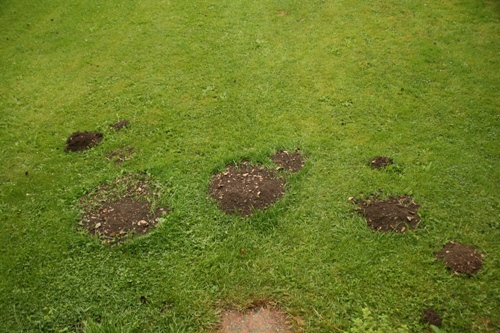 Yet more molehills across the garden, it looks like a plague of boils, bubonic and black -those pesky moles! However the little sparrows are still loving it, dismantling most of the molehills eventually with their dust-bathing -and I like to collect the bits of broken china that the moles dig up. |
Wed, 08 Aug 2012 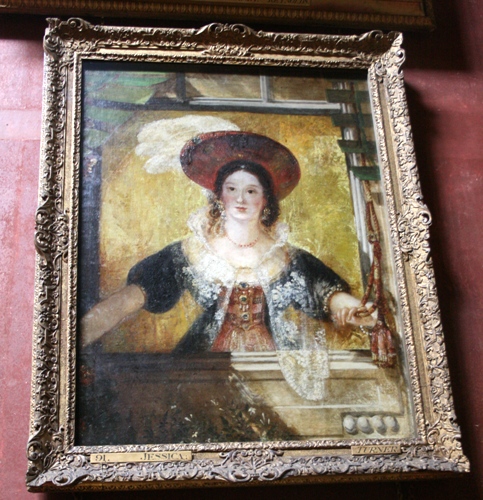 This was one of the very questionable Turner paintings at Petworth. I looked at it and thought...Ahhh, I think he was being influenced by Rembrandt... It was a painting about which The Morning Chronicle said 'It looks like a lady getting out of a large mustard pot' and Turner's 1862 biographer, Walter Thornbury, said 'None but a great man dare have painted anything so bad...' |
Tue, 07 Aug 2012 Some Robert Hughes quotes: "Drawing never dies, it holds on by the skin of its teeth, because the hunger it satisfies – the desire for an active, investigative, manually vivid relation with the things we see and yearn to know about – is apparently immortal." "A determined soul will do more with a rusty monkey wrench than a loafer will accomplish with all the tools in a machine shop." "The auction room, as anyone knows, is an excellent medium for sustaining fictional price levels, because the public imagines that auction prices are necessarily real prices." "What does one prefer? An art that struggles to change the social contract, but fails? Or one that seeks to please and amuse, and succeeds?" "The greater the artist, the greater the doubt. Perfect confidence is granted to the less talented as a consolation prize." "The new job of art is to sit on the wall and get more expensive." "One gets tired of the role critics are supposed to have in this culture: it's like being the piano player in a whorehouse; you don't have any control over the action going on upstairs." "So much of art – not all of it thank god, but a lot of it – has just become a kind of cruddy game for the self-aggrandisement of the rich and the ignorant, it is a kind of bad but useful business." We went to Petworth House today and here are some highlights...  One of the really good Turner paintings. 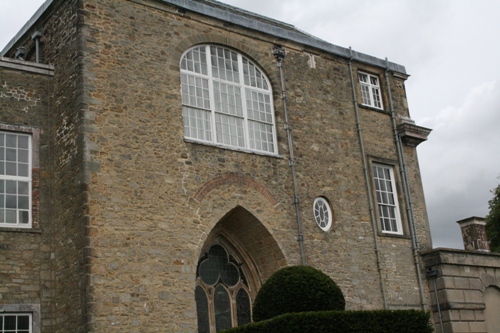 The window behind which Turner painted.  A letter written by Kitchener on show in the house. 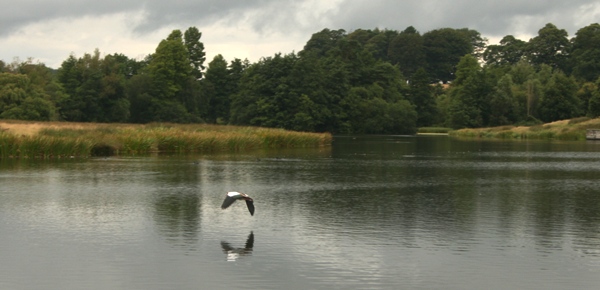 The Capability Brown lake about which it was said at the time...'it took so many men to dig it, line it and stop the leaks, it would have been cheaper to line it in copper'. 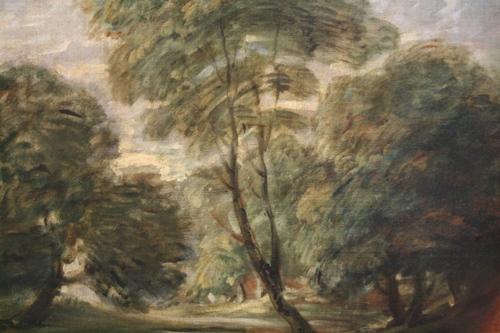 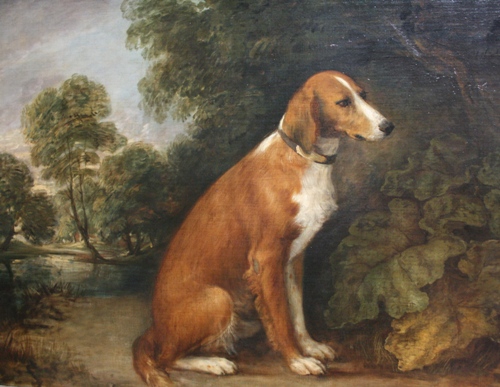 Detail from Gainsborough's 'A Setter'and the painting from which it came. 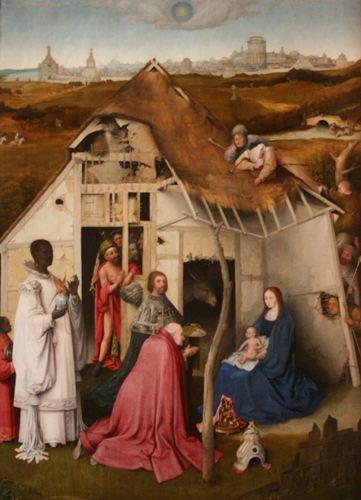 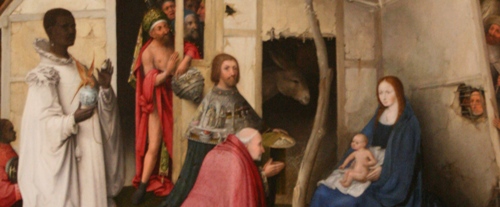 Why was the man in the middle of this Hieronymous Bosch nativity scene naked? |
Fri, 03 Aug 2012 Yesterday I was with my mother in Taunton to look after her dog while Frank, her husband, spent a day in hospital. I was born and grew up in Taunton so walking the dog meant visiting old stamping grounds. As teenagers my twin sister and I worked after school and during the weekends, all summer, at The Taunton Vale Polo Stables. It was run by Commander Wickham on behalf of the Royal Naval Polo Club, and he had the brilliant notion that girls love to look after horses and that they might even pay to do so –we did. A group of about 20 of us was each allocated a polo pony; we paid £5 per month for the privilege of looking after them, riding them on weekdays and schooling them before the weekend polo matches. We doted on them with care and attention beyond that of any ordinary groom. One of ‘my’ polo ponies was sold to a private owner whose old groom suggested to me that the girls were useless grooms...but it wasn’t until ‘my’ horse was with that groom that he suffered terribly from laminitis. I’m sure the care was sub-standard and that the thoughtless old codger of a groom was giving the horse too much clover hay. This morning I took my mother’s dog to the polo grounds for his walk. I think we have two or three sublimely happy moments in our lives which burn deep in our memory. One of mine was a morning in fifth-year when I skived double art and cycled out to the stables to ride ‘my’ then polo pony, Diablo. I rode what we used to call ‘short part of the woods’ out past the polo fields and into the woods via a track that led to a woodland cottage called Wytch Lodge. The woods are part of the Blackdowns, a row of low wooded hills in Somerset which were run (then) by the forestry commission and full of paths and tracks through the trees. I’d had a good gallop through the woods and then pulled up on a small grassy hill to give my horse a breather and pat him on the neck. Looking all around, I knew it was an intense sublime moment to be recalled in the future as a whole piece of perfection, momentary and transient. I’m not sure what I would have made of then of the way my life has gone, but looking from this end perhaps the missing element is to be understood (although I suspect everybody with artistic expression in them wants to be understood without being coerced into accommodating their work to the outside world beyond that which they want to do). A couple of days ago I visited Dyrham Park, a National Trust house, just north of Bath. There happens to be an exhibition of work from the Southbank Centre Arts Council collection; they brought in work by artists such as Mark Walinger, Cornelia Parker and Mona Hatoum to create an exhibition with the following title ‘A World Away’. Cath Pye, operations manager at Dyrham Park says ‘This year we have embarked upon a major project to consider how we can better tell the stories of Dyrham. This exhibition is intended to tell one element of William Blathwayt’s (previous owner of Dyrham Park) story in a new and innovative way’. The exhibition did for me the opposite to that which was intended. When I’m in a national trust property my delight is to immerse myself completely in the house, its artefacts, discovery of previous owners, the literary and political situations it evokes and to absorb the house and those things profoundly integral to it. Every painting in the house had its reason for being there; to show the land linked to the house, to show wealth and success of the owner, or an heiress wife who brought wealth, religious affiliations, fine horses and so on. In Dyrham in particular is a pair of paintings showing, in a plan like form, the sieges of Tangier and La Rochelle plus Blathwayt put together an important collection of 48 early maps now in the collection of Brown University. Emma Kay’s response was to draw a huge world ‘memory’ map, a map of the world from her memory with all its, inherent to her, mistakes. The size was really good, her line is lovely and fragile, but I was so very irritated by its being a revelation of what she didn’t know rather than interacting with the house, its people, the political importance of maps and plans in the house; what we got was so completely un-engaging and monosyllabic. William Blathwayt had been employed by James II at the time of his overthrow, and was lucky to have been re-employed in the Government of William and Mary of Orange (probably because he spoke perfect Dutch after having worked in the British embassy at The Hague). He was living at, and part of, a key moment when Protestantism was being rooted firmly into English politics -The Bill of Rights was passed to limit the powers of the Sovereign, to hold parliament to regular elections and accord freedom of speech within parliament and to establish the right of Protestants to bear arms for their defence. We live now in a time of political turmoil and, not to pick up on so many possible links, Emma Kay seems to have missed a point. Or I missed the point of her work –which I did, although I say again, I loved the quality of her drawn line. One of my favourite things to see in a National Trust house is the working area, downstairs; the kitchens, dairies, pantries etc., the mechanics behind a big old house. Quite a few of the working rooms were closed, but one that we might have gone into was closed because a Mona Hatoum illuminated table was in there; we couldn’t get in even to look at the table properly, to pore over it and wonder why she’s produced a dot-lit map of the world on a plain table –it felt like yet more frustration, wanting to understand why she’d done the table and perhaps find the insight in poring over it. With just about every piece of ‘contemporary’ art in Dyrham I wondered why it was done, what it meant, how it engaged with the house and people who had inhabited it, and very often I found the work to be facile, lightweight and dully executed. Anecdotally the visitors were not interested in the ‘contemporary’ art (as we were reminded it was all the way through). As one of the volunteers said ‘I don’t think William Blathwayt will have thought much of that, do you?’ I’ve come to the conclusion that too much of the art we see does its best to keep itself one remove from understandability. Either it is incredibly facile and light, or there’s some deeper meaning which has kept itself far from me. If communication was its aim well I’m deeply frustrated by it and if the point of the ‘contemporary’ art in Dyrham Park in particular was to illuminate further for me the house, its people, their history and place in their societies, then for me it’s failed utterly. I know that I’m vulnerable to being called narrow minded, I’ve tried to give an honest response to my visit to Dyrham. I really would like to go around the house with the artists or someone who can make me feel deeply moved by it all. You can see the work at the following link: http://www.nationaltrust.org.uk/servlet/file/store5/item826113/version1/aworldaway_v6.pdf |
Tue, 31 Jul 2012 I've been delivering paintings in Gloucestershire where this young man is looking forward to being well known for both drumming and running; his drumming is fabulous, I hear his running is fast. 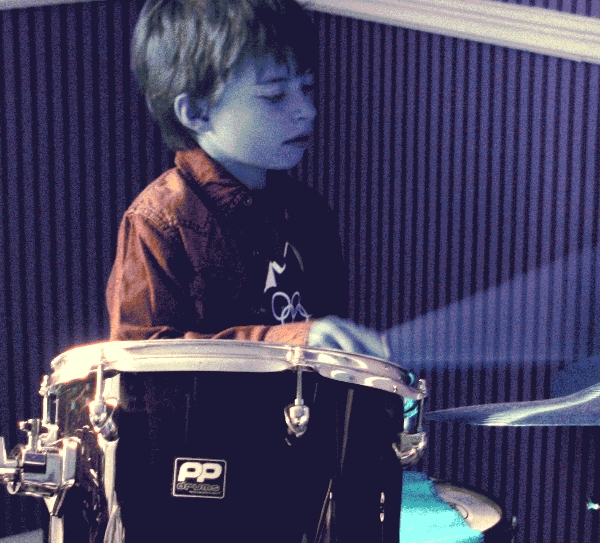 His name is Will Aston...keep a lookout for him... 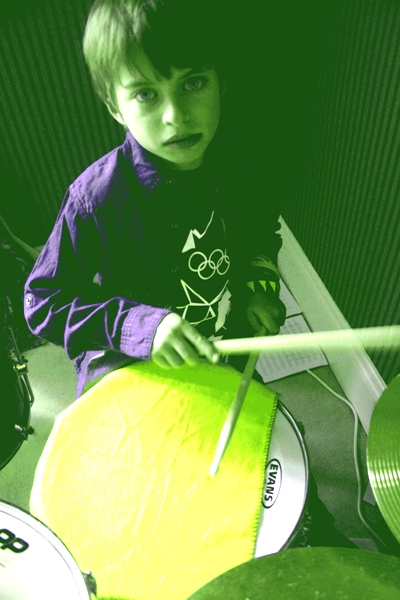 |
Sun, 29 Jul 2012 A little sparrow flew in yesterday and burrowed beneath the newspaper on the dining room table. I chivvied her out after she'd had a rest... 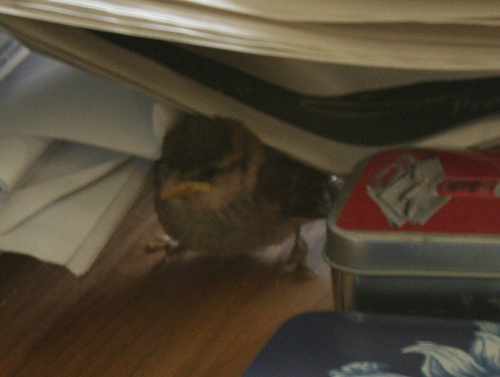 A few moments later she flew back in and had a proper snooze on my phone so I couldn't take this picture until she'd woken up. 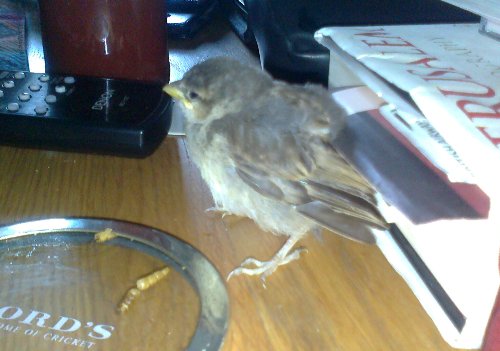 I tried to feed her mealworms, but unlike Colin she wasn't interested. The moles have gone mad in our garden; a couple of small molehills appeared outside the dining room door and then a massive one rose up which the small sparrows have decimated somewhat by having dust-baths on it so now a new one has emerged alongside and is growing ever bigger...I note a few dust-bath pits in this new one today which may annoy the moles further!  It's lovely to watch five or six young sparrows having a dust-bath together on one molehill! |
Sat, 28 Jul 2012 http://www.bloodyniceblazers.co.uk/blog.php Sad that the Sierra Leone team weren't wearing their Bloody Nice Blazers! But *proud sigh* re: the Queen and country!!! |
Thu, 26 Jul 2012 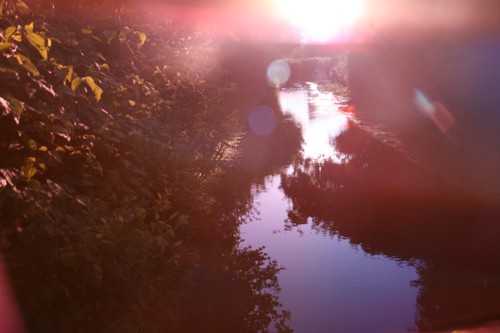 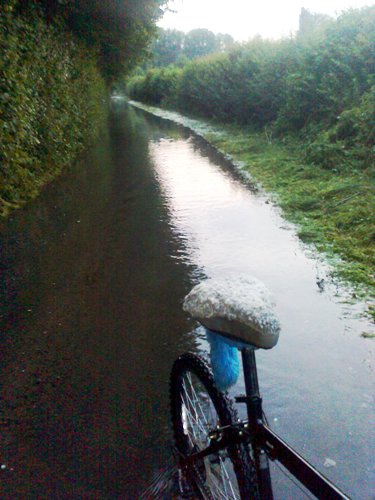 The winter river is as high as it ever is, running along the road all the way from the ford to Miss Moon's cottage where a bump in the road has stopped it flooding the cottage. I once asked her about the river at its highest and she said 'Well it hasn't flooded the cottage in 400 years..' 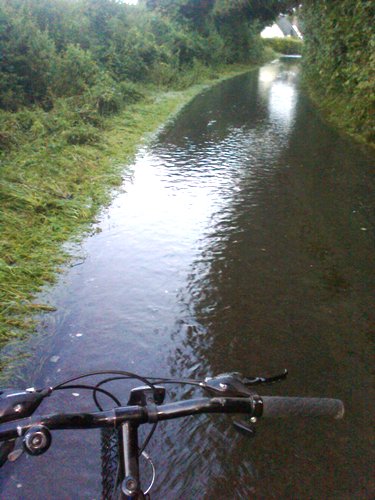 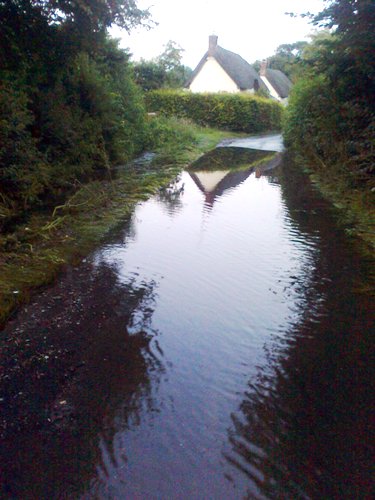 I cycled through and my feet were under water. |
Wed, 25 Jul 2012 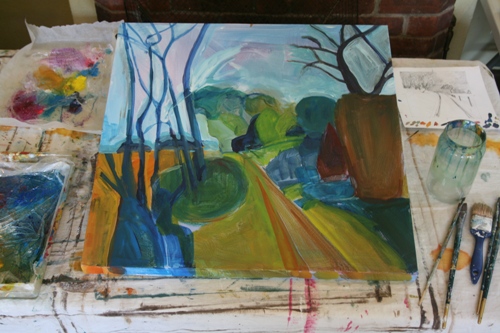 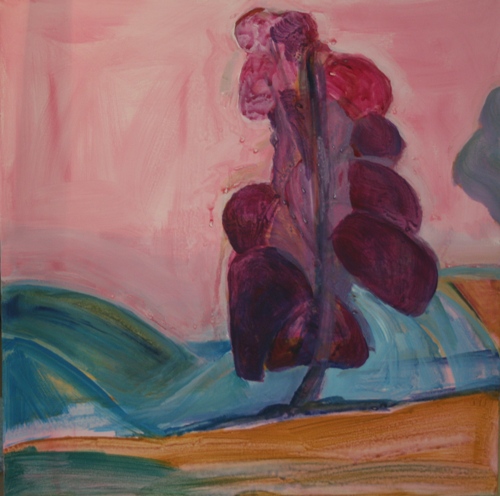 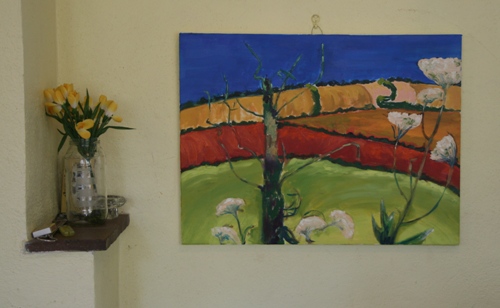 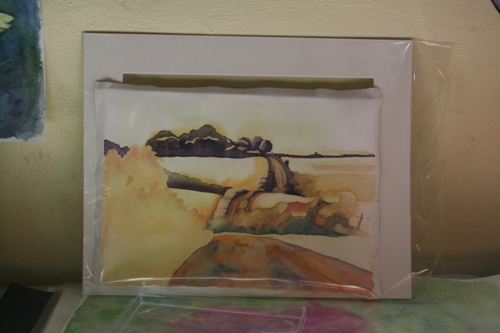 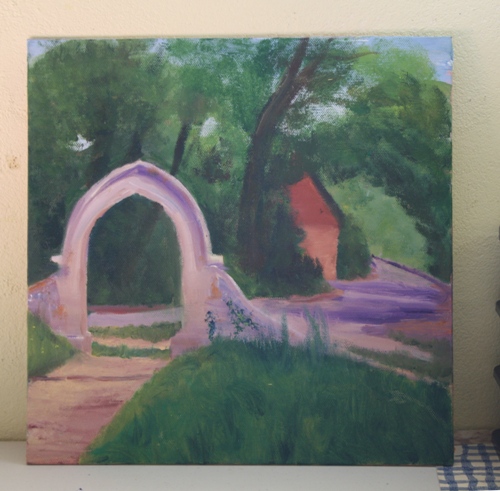 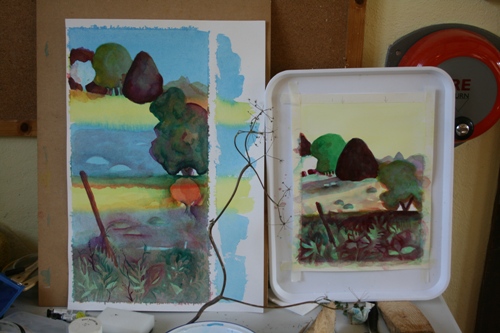 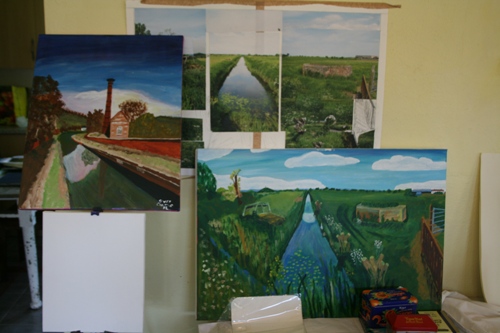 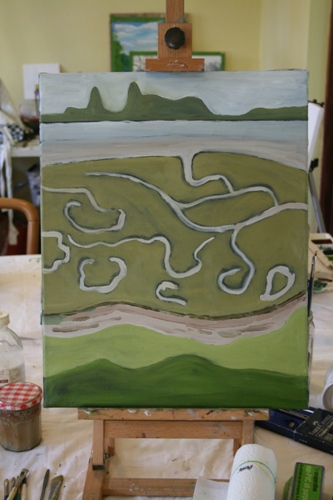 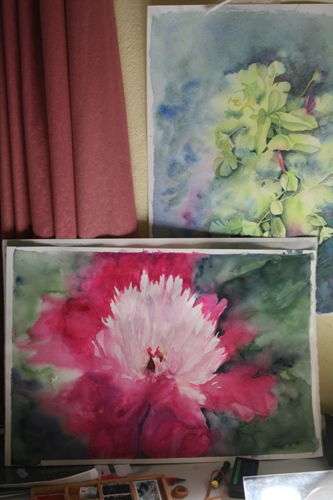 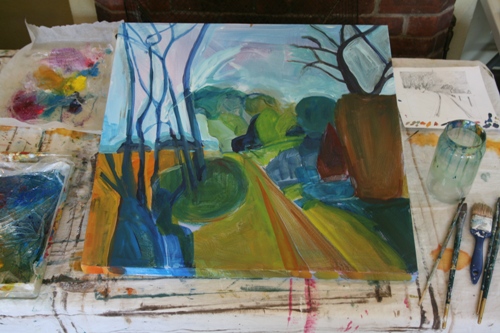 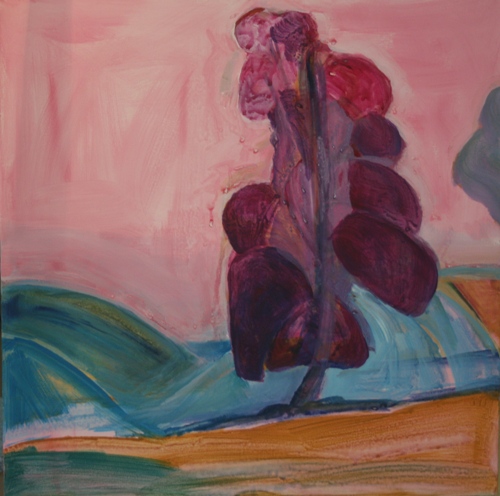 Chettle week 2012, day three: Extraordinary that we've had several weeks solid rain but the sun has come out for Chettle week. So with all doors and windows open to the summer and working their ways through every emotion between excitement, fear (sometimes despair) and pleasure my students have been sketching, drawing, pulling ideas together and begun to come up with some lovely things. 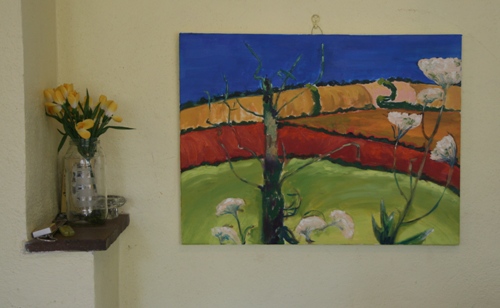 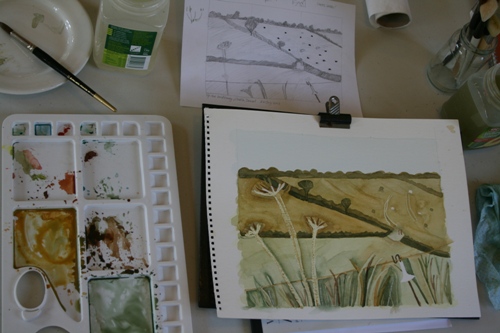 |
Sun, 22 Jul 2012 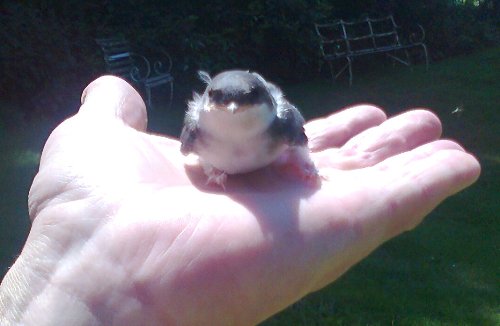 I went to see my friend/student/artist John this morning; he'd found a little house-martin who'd flown down too soon for a house with cat&kittens (anyone in need of a tabby kitten early August? -all wormed, de-loused and vet-checked, please email!). John took the little bird and leaning out of an upstairs window was able to pop him in the guttering just above a row of nests. Hopefully he won't fly down again until he's more adept. (Not John of course...the house-martin) |
Sat, 21 Jul 2012 Mary always says I'm old because I like garden centres... but get this -she and her friends have just found a house to rent in New Cross and the first thing they're going to do is get some grass seed for the garden...am I old mother of old daughter?? Or is it a young trend for youngies? Second warm dry day and all the combines are out making the most of it.  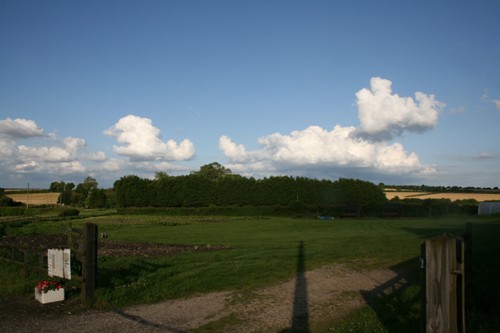 I went out last night with my camera. I decided Danny Boyle came here to work out what to do for the Olympic opening presentation. From what I saw of his plan I think he's taking a huge risk but maybe two things...he'll pull some surprise out of the bag OR we don't appreciate that England's rural idyll isn't on hand everywhere; it exists as in idea for many but still as a reality in north east dorset. 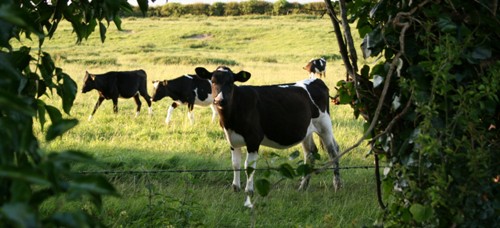 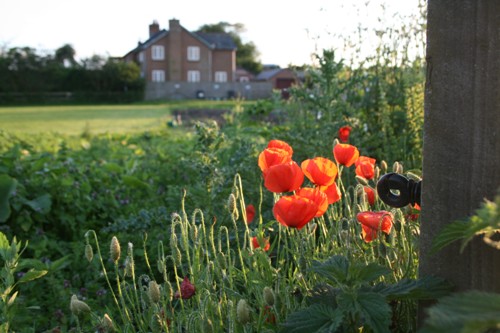 |
Fri, 20 Jul 2012 At some point when I was driving yesterday I heard this poem by Helen Wadell; I was very taken with it...suddenly I want to go to Northern Ireland. Apologies if it doesn't present itself as a poem but as a solid block of prose...this blog can't cope with spaces! *** The Mournes. I shall not go to heaven when I die. But if they let me be I think I'll take a road I used to know That goes by Slieve-na-garagh and the sea. And all day breasting me the wind will blow, And I'll hear nothing but the peewit's cry And the sea talking in the caves below. I think it will be winter when I die (For no one from the North could die in spring) And all the heather will be dead and grey, And the bog-cotton will have blown away, And there will be no yellow on the wind. But I shall smell the peat, And when it's almost dark I'll set my feet Where a white track goes glimmering to the hills, And see, far up, a light --Would you think Heaven could be so small a thing As a lit window on the hills at night?-- And come in stumbling from the gloom, Half-blind, into a firelit room. Turn, and see you, And there abide. If it were true, And if I thought that they would let me be, I almost wish it were tonight I died." 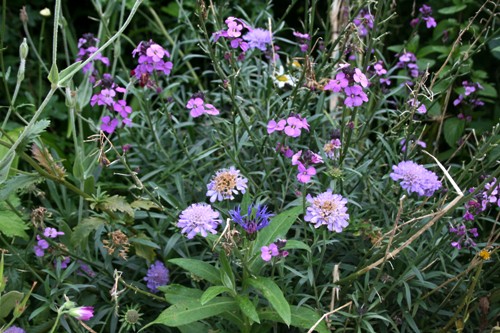 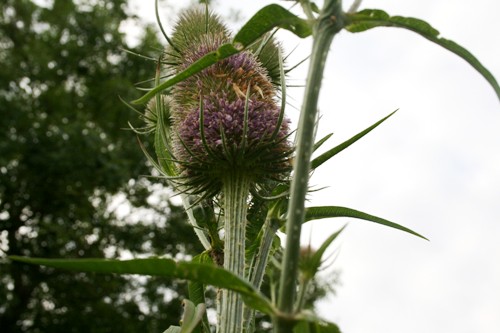 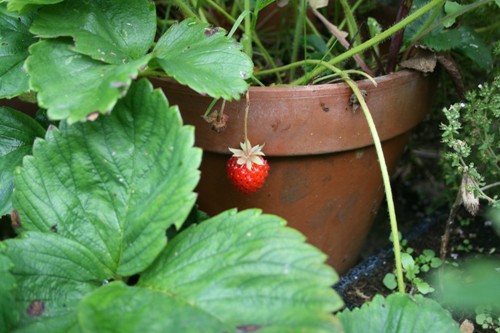 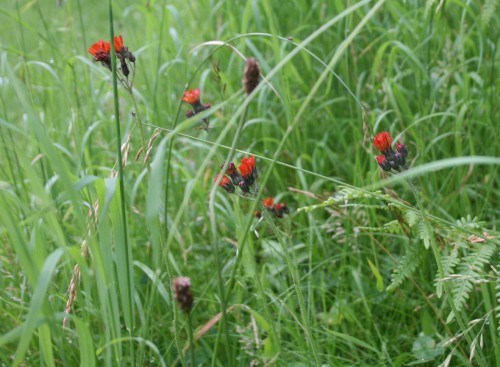 Phew! I had a great drive home last night after packing up and delivering pictures, zig-zagging across north London, avoiding the north circular and not getting lost. I left my in-laws' 1st class and much appreciated accommodation in Ealing at 8.55pm, drove through sunset and summer dusky-evening light with John Martyn blasting all the way until 10.39pm when I turned into the track, and at 10.40pm scrunched up to the back door with the north star twinkling away at me from the right place. 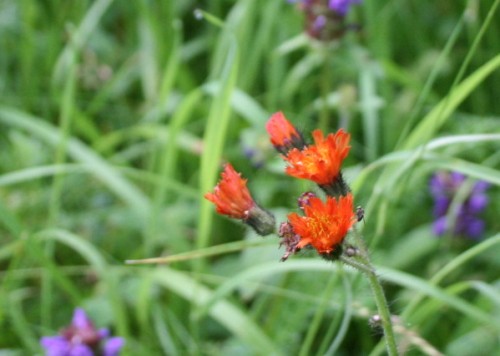 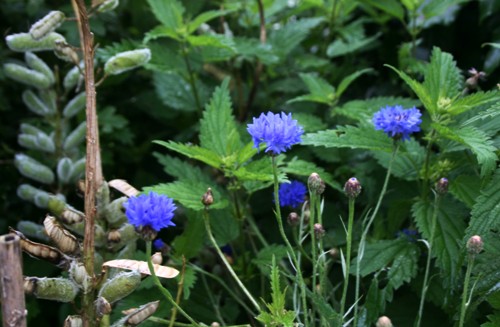 This morning I've been through the garden to reassure myself of its wildness and see what has come through and what has gone over. The little orange foxes and cubs are looking good and my teasels are beginning to flower. And I hear a new little clutch of sparrow chicks in the clematis...yiippeeeee!!!! |
Thu, 19 Jul 2012 Update on Moorhen sitting on her nest...she's still there, stoic in the weather! I'm sad I won't see the results of her sitting as I'm going home today. However I'm looking forward to catching up with Mrs. Chicken, Mrs. Partridge and all my sparrows! |
Wed, 18 Jul 2012 Went with a few of us to Brick Lane for a curry after a the slowest drive back from Highgate to Ealing -there had been a horrid accident between a sports car and a motorbike on a wet north circular road and I was caught on the wrong side of the Hangar Lane Gyratory. Once we got to Brick Lane one of us (Jack!) bartered a great deal in one of the curry houses; food - delicious, especially the nan bread which had lovely little burnt bits -all crunchy and nice, but a doughy-ness in the middle making it seem all home-made and good. We bought wine in Tesco and some plastic wine glasses and went up onto Jack's roof to enjoy the views across the east end. |
Mon, 16 Jul 2012 I've had a lovely day today. We (my sister-in-law and I) started by delivering 60 Olympic blazers made by the company of one of my sons 'Bloody Nice Blazers'. He's made blazers for the Rwandan Paralympic team and the Sierra Leone Olympic team; we delivered them to the centre of London fully expecting to be driving in heavy traffic as I kept hearing that 10,000 extra Olympians were set to arrive at Heathrow today and be coming in to London on the A4 which was the road we were taking. The drive in was a piece of cake! And we came back via Kensington, up Camden Hill Road and past a small street I lived in years ago -Observatory Gardens (looking a little posher now). Being my free day I wandered into Ealing across Walpole Park and spent some time by the duck pond watching the common moorhens (yellow legs). One of them was sitting on a nest and when a duck came too close another one chased it off so I guess that they are the parents of whatever the one was sitting on. 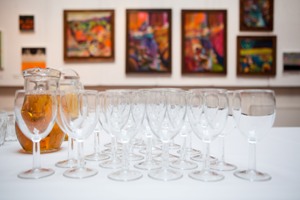 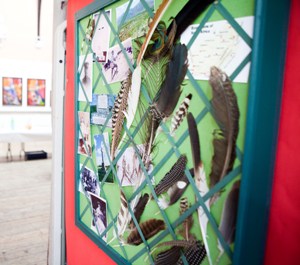 The exhibition is closed on Mondays hence my day off -I've been catching up with lesson plans/ideas and walking the dog in the park. In dog-world he's an optimist, always cheerful, chasing his ball happily, very good tempered and -this makes it a pleasure to take him out, obedient. 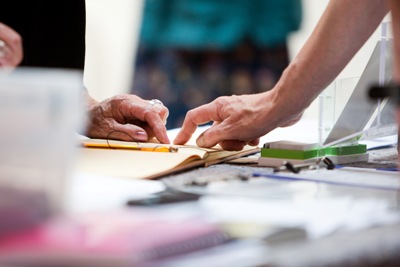 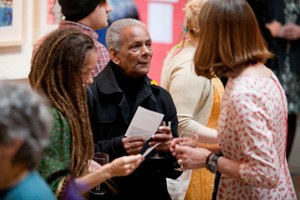 We have had so many people into the exhibition and such positive feedback. I was interested that my bright red wall hasn't been too controversial, in fact its been rather well received. When I went into the first room of the RA summer show last Monday, Tess Jarre who curated it has painted the walls a deep red, floor to ceiling, clearly great minds think alike... The birds in London are a lot less shy. I've been close-up to some really fine glossy crows in the park, and a tiny wren hopped along a wall beside me while I was walking into Ealing earlier. Tomorrow, back to Highgate. |
Wed, 04 Jul 2012 Got to London smoothly although it was quite a squish in the car I felt like Alice in Wonderland in White Rabbit's house -she'd drunk too much of the growing potion -she's obliged to curl up with an arm out of the window and one foot up the chimney. My clothes were all in bin bags packed around the wine bottles as I couldn't get my suitcase in so all the posh frocks needed ironing. When I got here I had a lovely walk in the park with the resident dog, Bailey, a labradoodle who loves his tennis ball and now me! Tomorrow to Highgate! 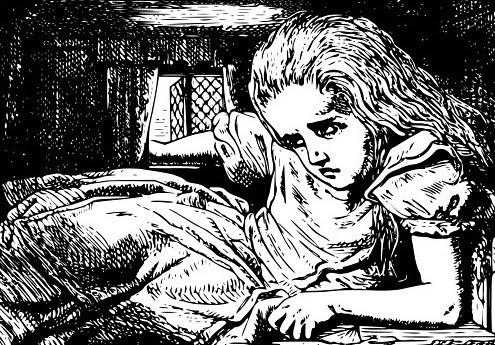 |
Tue, 03 Jul 2012 All in the pouring rain, I've packed the car to its gunnels with paintings, canvasses, framed and glazed watercolours, browser, mounted and wrapped watercolours, cards, tool kit, wine in the roof box clothes in bin bags stuffed around the wine, smart clothes laid out over the paintings....*phew*....I'm setting off to London with it all tomorrow, slow and steady. Thank goodness its a Vauxhall Zafira. I'm soaked now and going to have a bath with bubbles! Please copy and paste this link into your address bar for details: http://www.visitlondon.com/events/detail/25493118-memories-and-remains-at-highgate-gallery |
Tue, 26 Jun 2012 Buzzards a regal, elegant birds; they ride on the crest of the wind, wings outstretched like a ballerina's arms. I've just been watching one pass over the house and I can see the desire to hang-glide but the way a buzzard moves is unmatchable. |
Sun, 24 Jun 2012 It was one of those frustrating nights when I didn’t sleep -from about 2.30am when I looked at the clock and saw the time shining back, registering a time earlier than I’d hoped , I did what I normally do which is to turn the radio on and listen to the world service. Towards a more sane time of the morning I heard a clip from ‘Something Understood’ about John Cheevor’s diaries in which this (quote) neurotic, narcissistic, egocentric, friendless man talks about his confusion at knowing himself to be good at what he does (writing) but never feeling confident that he is. Does that sound like a contradiction? Perhaps the knowledge that he’s good keeps him at it. His endeavors never quite achieve what was in his mind at the beginning and so the work never lives up to his hopes. And yet he was clear enough about his work to be riled when a short story was published in The New Yorker, towards the back, some way behind a John Updike story. He had other troubles and contradictions –alcoholism (like his father and brother), bi-sexuality which he couldn’t come to terms with, an unhappy marriage for which he blamed his wife but his therapist blamed him, and he finally died of cancer which had spread before the first tumour in his kidney was discovered. I found it reassuring to hear about his lack of confidence. By 6.30am I got up and made tea and brought it back to bed where I sat up with closed eyes and holding my warm tea mug. Some wonderful thing had me open my eyes at the moment a large barn owl hove into view over the wildflower meadow. It was unusually full of movement, wings flapping against strong breezes and then stalling and even hovering momentarily like a kestrel. With its massive creamy white wings wide open, it tipped and zig-zagged across the field; three times I saw it wings back, legs and head down, disappear completely into the long grasses for about 30 seconds perhaps, then up and off on the hunt again. It parked-up twice on the fence, looking much smaller with its wings closed, and spun its head round rapidly, stopping stock still before spinning again and staring with its huge black tear-shaped eyes. I saw it hunt one more time, then (and I had been wondering if it could do this) it perched up on the electricity wire, once more looking inconspicuously medium-sized, before opening its wings and dropping to the long grass; after about 30 seconds it headed off across the fields towards the old chapel. Now I’m downstairs with coffee, watching healthy fluffy Mrs. Chicken in the garden and just having seen Mrs. Partridge and…finally…Mr. Partridge back on the scene (he comes and goes…Mrs. Partridge is loyal to our garden!). Top-up of coffee and down to the shed methinks! |
Wed, 20 Jun 2012 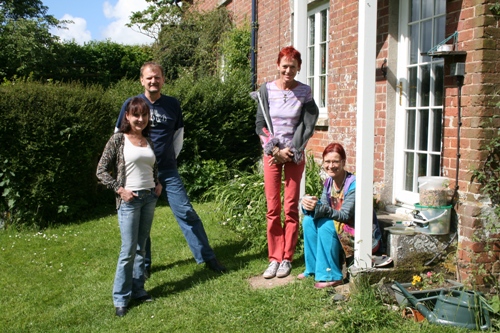 These are my friends from South Africa. We've had a wonderful couple of days visiting Stonehenge, Old Sarum and Salisbury Cathedral. I love the new font in the Cathedral -like a sheet of oil reflecting all the busy goings-on including one pensive member of the clergy! 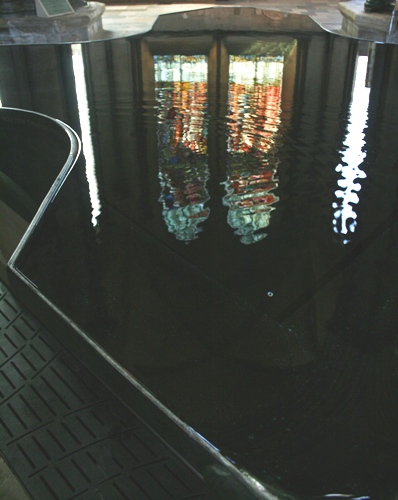 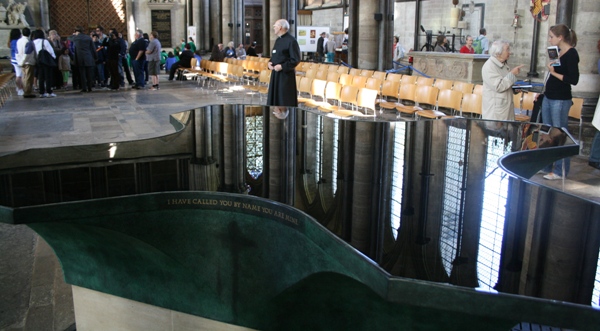 Racing along the road with John Martyn loud in the CD player, evening sun pouring across the fields either side of the car, passing a buzzard sitting on the edge of a tin barn with his chest out and his head tucked in but his focus firmly towards the ground waiting for a mouse to make its untimely appearance...these are moments of peculiar optimism but before long the sun goes in and the wind and rain return with a vengeance. The constant change in weather leaves my mood in an up-down swing, and it’s not only the return of bad weather; the change from storm to sunshine can send my spirits on as much of a dip as the other way around. The ‘James Lovelock’ surprise of the moment is the rising of the winter river in April –and it’s still running. The latest I’ve ever known it run previously is May 27th, just once in the last 25 years. Its normal pattern is to rise between November-January, and diminish and disappear between March and late April. Watch this space –three very happy ducks were on it yesterday. At least the dry aquifers are now brimming, being on chalk ground, approximately two thirds of rainfall seeps down into the aquifers; only a third flows out to sea. The massive amount of rain we’ve had has filled them to a healthy level... more rain forecast for the next few days. I heard a cuckoo the other morning and then two of them flew across the garden. This year I’ve heard more cuckoos than usual –I’m hoping this isn’t because they can’t find enough Dunnock nests into which to deposit their offspring...you sense my feelings of doom??! I’ve also, for the first time, actually watched a magpie steal a baby sparrow and fly off with the little thing as its wings were still flapping –distressing...and the day before yesterday our guests found the feathers of another taken sparrow. Earlier in the year I watched a weasel chase a young rabbit up the garden, catch it by grabbing its throat and hang on tight till its death squeals were quiet. All these anecdotal strangenesses add to my gothic state of mind, so what I’d like is a bit of consistent summer but perhaps its waiting to oblige me for the time of my exhibition in London in July. |
Wed, 13 Jun 2012 I've been watching a family of three recently fledged great tits on the bird table today; they are a smaller, scruffier, more rotund version of their parents but they seem to have a stripe along their tummy that their parents don't have. They were flying quite well and hanging precariously off the seedy fat-balls with a wing-flutter, but still nagging their parents incessantly to be fed...which the parents were doing. It's just anecdotal of course but there seem to be significantly fewer birds this year of those which I would expect to see more. Swallow numbers are down and I wonder if they were hit by the earlier horrible weather which just about coincided with their return. I keep walking through the garden looking for a dunnock -they were plentiful last year but I haven't seen one for probably a couple of months. Last year we had a dunnock's nest in one of the ivy hedges from which I saw one clutch emerge. The sparrows seem to be doing okay but they have been around and plentiful here for years, a long standing community. Last year I watched a wren nest in the old ivy stems up the Ash tree, but I haven't seen a wren this summer. It is all so fragile -if the swallows are not here now, how will they ever return? I think the Govt. is reducing the requirement for farmers to leave the margins and set-aside which are so valuable to bird-life. With so much else to worry about I'm sure Govt. eyes are off the ball and unlikely or unable to respond in time with regards to new rules about field margins, but I really really really hope we have a more bird-friendly summer next year and that it makes a big difference to bird numbers. |
Fri, 08 Jun 2012 We’re about to embark on a landscape project in my classes –all sorts of things in life are appealing like tastes, colours, sounds, ideas, but landscape covers all of these, and to ‘understand’ it has been fundamental to human survival. Imagine –you are an early hominid living, like a chimpanzee, in trees and forests but one day you come to the edge of the trees and find yourself in tall savannah grassland; you can’t see a thing until you rise up on your legs and look across the land to the horizon. I heard recently that man ‘walked’ in order to free up his hands for carrying things, but I’m not so sure. I think that man ‘walked’ because he moved out onto the grasslands of Africa and unless he stood upright he couldn’t see a thing. By standing upright, it instigated the need to unravel those new visions; to realise that colour meant lusciousness and probably water, that a tiny elephant on the horizon was actually huge and might represent a threat, that textures helped to clarify the quality of a thing –the long grass scratching your legs, and so on. Everything about our survival depended on our understanding of landscape; its shapes and tones, its colours and textures - and I’m sure that is why so many people feel compelled to represent it visually in painting. As landscape changes and evolves, as dark nights disappear, as access to the countryside is less easy for so many, the more we should be responding and representing it, to feed our own inner drive and confirm, and conform to, our own inherited memories built up over the generations, when without understanding landscape we would have died. I begin by asking my students to make drawings from their resource material in which they organise their thoughts on paper in terms of the greater shapes and constructions of their chosen landscape images. |
Thu, 07 Jun 2012 There's a summer storm brewing outside, amber warning, 60-70 mph winds, which is all very exciting but my lovely shed sits in the shade (when the sun shines) of a large Ash tree. 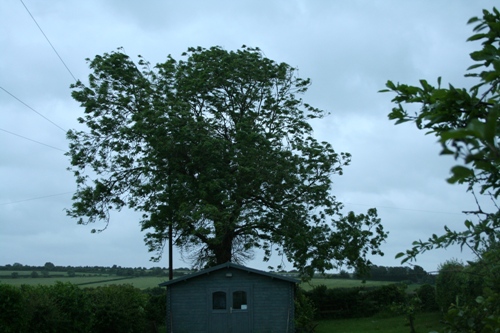 I think the wind is coming from slightly too westerly a direction to land the tree on my shed should it come crashing down, but it will be the first thing on my mind in the morning...and even in the night if I wake. 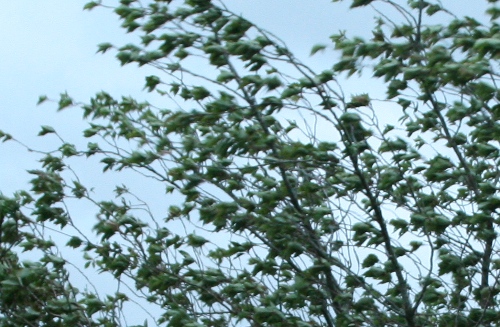 If the tree comes down then three phone lines come down with it as the main telegraph pole stands up through its main branches.  The difference between a summer and a winter storm is the foliage on the trees acting like a giant kite ready to pick up that wind and fly with it. 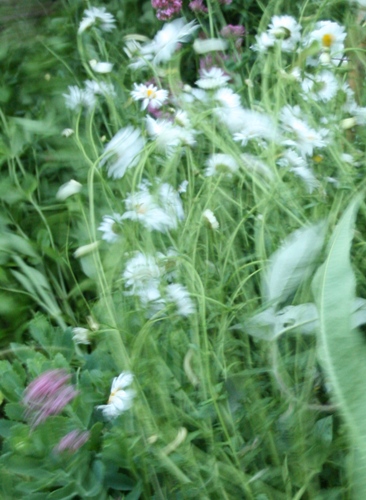 Some of the flowers are all right, dancing around like these daisies, but my lupins are blown right over and snapped at the bottom of their stems. The Rooks are loving it though, defining the directions of the wind by swirling with the storm but I'm hoping all the sparrows have somewhere comfy to spend the night. The new sparrow family in the nesting box will be fine because they're in a nook of wall well protected from the prevailing storm winds. |
Sun, 03 Jun 2012 I downloaded some pictures from my camera and found this to my surprise.  I have put together a new book about painting in watercolour which you should be able to find at the following website address: http://www.blurb.co.uk/bookstore/detail/3289318?pid=New |
Sun, 27 May 2012 After picking my Dad up from Oxford, we diverted on the way home to a place called Dorchester on Thames, a large-ish village with a very nice Abbey. We had a picnic in the churchyard -lovely with cow parsley, grave stones and a large wooden cross beside us on which a very glossy crow came to ponder at us, he probably wanted some sandwich. The reason we came there was to see an exhibition, in the main Abbey building, of work by John Piper. It wasn't a big exhibition, but what was there was a most amazing focus of really wonderful pieces by him. The chance to see approximately 12 mixed media pieces at centimetre-distance from my eyeballs was exhilarating, enlightening, rather overwhelming. There were design pieces for windows and Church vestments, but for me the pieces which caught me from the inside out were drawings of churches and buildings; the free hand of washes over wax resist, more washes, more resist, inks and white gouache. He included collage which I think was a way of creating edge without drawing a line and an efficient method of covering an area. I was intrigued to see collections of scratched marks which he evolved, used and reused always slightly differently through the various pieces and only visible by being close to the real work. I too have been doing similar but, and I guess this is the case if I came to it independently, I thought I had invented it. It's one of the reasons that I shy away from going to too many exhibitions; I want my responses to be deeply personal and from my own creation and invention. The joy of this exhibition was in seeing work that I love, that I wish I had made, that exuded elemental truths, that was full of visible negotiation of shape, tone, texture, and even among all the dark darks...colour! I passed my eyeballs across and back over every scrap of the work like archaeologists over fields with their geo-phys machines. I left with a yearning -to see it all again, to live permanently with a piece like those we saw and wound up like a clock-spring. |
Fri, 18 May 2012 When some people die it creates quite a jolt to the system and the death of Dietrich Fischer-Dieskau has done just that. We have three versions Das Lied von Der Erde but for me his has always been the best -the last song, Der Abschied, The Farewell, is the one you imagine will be sung at your funeral and have everyone weeping but it doesn't really need a funeral for that, the song alone can do it. It ends with the word 'ewig' (endless) repeated over and over, and with the last 'ewig' you are convinced he's going to sink to a final lower 'ewig' but he leaves it high and free, and with it confirms the feeling of forever-endlessness. I guess it was Mahler who constructed it and Dietrich F-D who sang it. The songs are based on a set of Chinese poems and of course that is when I wish that such a thing as a babel-fish (from Hitch-hiker's guide) existed so that I could put it in my ear and read in the original language. |
Tue, 15 May 2012 I've just been spellbound for half an hour until I couldn't hold still any longer and had to come and blog; I was watching a little female sparrow on the doorstep, one of this year's fledglings. I could tell she was young, her feathers were still unruly and all over the place -although she has her flying feathers and I see she can fly, if a little flutteringly, and she still has yellow at the corners of her beak. She was much less nervous of me and more inquisitive than her parents, I could see on her messy beak the white stuff I used to see on Colin's beak that comes from wheat grains. It must have come from wheat grains which have fallen from the bird feeder as the wheat round here is no where near ready, and I saw what I think was her mother actually knocking seed from the feeder down for her. It still seems extraordinary to me that I felt and still feel such overwhelming feelings, after raising Colin, for such a small life but I can feel the smile on my face broadening as I watch the little thing and I know I could while away many hours watching. 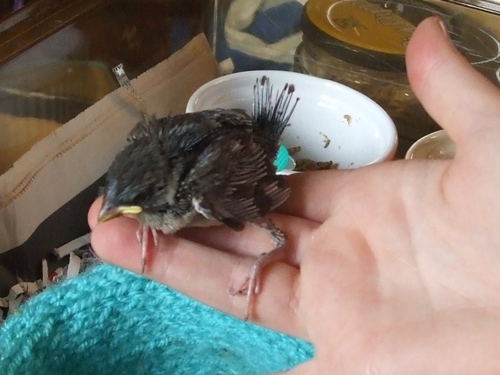 Before we were sure she was a sparrow... 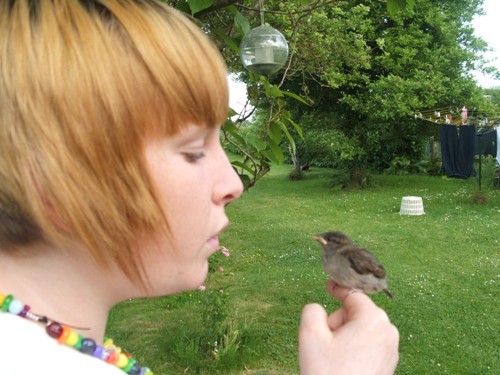 Colin and Mary in the garden. 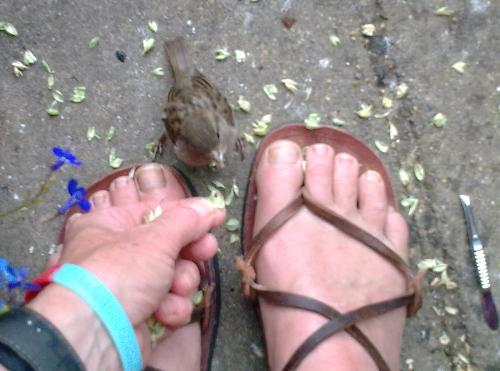 Colin and my toes on the doorstep...note the tweezers -my 'mummy-beak' with which I fed Colin most of the time. |
Fri, 11 May 2012 Very glad to hear Tim Minchin on Desert Island Discs say that he prefers to work with NO FIXED OUTCOME in mind. It was always my biggest bugbear when working for Dorset Adult Education Service that they wanted me to have fixed outcomes for my students and to be able to measure whether or not my students had achieved those fixed outcomes. When I told the lovely adult ed. ofstedders that I could write up all the fixed outcomes in existence but I would never comply to the notion of fixing my students' artistic outcomes -those wonderful edu-talkers told me to write them up anyway and just not follow the process through....ticking boxes for the sake of it??? The frustration of it made my blood boil to explosive levels -just to see an adult ed. letter fall through our letter box had my adrenalin pumping, so to know that our local adult ed., when asked about art classes in our area, say that there are none because I left and took my classes with me, makes me wonder that they never saw the writing on the wall. Remember the hand of God on the wall at Balshazzar's feast 'you are weighed in the balance and found wanting'? They thought they weighed me in the balance -turns out I weighed them...and claimed back what was mine -my teaching, and it has made me much happier. |
Tue, 08 May 2012 Good old James Lovelock talking to Jim Al Khalili this morning on The Life Scientific; he said that a scientist is like an artist -doesn't an artist want to be in his garret working on his masterpiece without being in hock to peer pressure? He was suggesting that he had been better off by keeping outside science institutions during his experimenting life and that his ideas were something he liked to work on alone until he needed to collaborate. It's extraordinary that his Gaia theory has had so much hostility -other scientists don't want to believe that the earth can be a self-regulating mechanism, that for instance huge (what's the collective word for organisms?) groups of organisms can regulate the atmosphere from the ocean, or that the fine balance between methane and oxygen in the atmosphere is somehow balanced by the earth so as not to explode (which they will do if not in the right balance). With every new weather event, I remember what I heard James Lovelock say a few years ago, after being asked 'In the light of climate change, what can we expect?' He replied 'many surprises'. Ohh I love that man, I wish everyone else did too!************** This is Melanie Phillips' take on James Lovelock. http://phillipsblog.dailymail.co.uk/2012/04/apocalypse-deferred.html?cid=6a00d8341c565553ef016304bbc115970d |
Sun, 06 May 2012 http://www.blurb.com/books/3202584 I've made an on-line book to gather some threads together regarding the trip to Africa last year. You can find it at this website address. |
Sun, 29 Apr 2012 It seems the Murdoch empire falls and empires fall with him...in slow motion (watch out messers Cameron and Hunt). The media is extraordinarily powerful; It affects the way people behave, it seeks to (and does) corrupt the way people think, it chooses which stories take priority and which are left untold. How odd it is looking back on some of the things James Murdoch said in his anti BBC speech "The expansion of state-sponsored journalism is a threat to the plurality and independence of news provision; the scope of the BBC's activities and ambitions is "chilling"...and so on. There was much more which must make him cringe to look back on. Although I love the BBC and couldn't bear to be without it, at times I think they too are biased in what they choose to air, and when I've heard enough of their partisan, denominational, partial and cliquish news delivery I don't turn to sky news to hear the opposite...I turn to Russia Today. I can't say that I listen to their news with anything other than scepticism either, but it's great to get two sides of a story and try to work out where the middle is. I went to college with a Buddhist who was brought up in Sri Lanka; he said he was always taught to 'take the middle path'. |
Wed, 25 Apr 2012 While clearing stuff out of my shed recently I came across some of my old Modern Painters magazines and on flicking through caught sight of the words ‘Landscape painting is dead’ in the ‘summer 1997’ edition. Well, you can imagine the statement burned its impression onto my brain so I tore the article out to read later. It turns out the statement was written by Adrian Searle for a Guardian article and borrowed for ‘Modern Painters’ by Robert Macdonald who was using it as a paradigm with which his own feelings could not be more opposite. Although it was a long time ago that Adrian Searle wrote ‘I cannot think of a single landscape painting of the past 50 years that has stuck in the mind or made any difference whatsoever to the development of the art of our time’, I guess there have been no paradigm shifts in his beliefs as he wrote more recently ‘Hockney’s exhibition goes on and on; it is hard to like his most recent work in its entirety’ in a Guardian review of this year’s Hockney show, and his review was a not-so-positive one among mostly approvers. Maybe Adrian Searle is under the impression that artists make paintings primarily for others to look at. I understand it a little differently; starting with the ‘showing’ of paintings, it’s the faustian pact one makes when one paints. One can’t paint and not show, but showing is not always easy. There’s a certain amount of relief, and occasionally excitement, in seeing one’s paintings up on a wall and feeling that some of them have come almost close to capturing some fundamental truth from the depths of one’s experience. But it is the process, the long hours and days immersed in the making of a painting, which is the real reason for doing it. So whether a painter paints landscape or something else should really be of no particular consequence; of more importance is whether or not a painting resonates with its particular viewer. I suggest there’s been a rise in art which sets out to woo, entreat and court the art world by being funky, quirky and shocking (rather passé now), and too many people are taken in by work which is shallow, lacking the feeling that anyone’s soul has been anywhere near it. Those who are not taken in are dismayed by something which they find unengaging and difficult to understand. In the end whether one’s paintings are approved of by that art world or not is irrelevant because the paintings will be made anyway. Adrian Searle believes that landscape painting is redundant; we should be concentrating more on urban or industrial-scapes within the world in which we now live ‘Latter-day landscapists turn their backs on the by-pass curving through the water-meadows and rarely memorialize the local Chernobyl even though it adds a much needed sense of scale and drama to the rubbish-strewn, irradiated foreshore’. To find depth, distance and drama in a painting is less down to what the pictorial elements are representing in a painting and much much more due to how pictorial elements are juxtaposed and then created with paint. You can have a cooling tower or a tree in a foreground; both may make a stunning foreground reference or a weedy flop –it will depend on the painter and his or her skill with the medium. I’ve seen boring and fabulous examples of both. Adrian Searle may be living in an industrial/urban surrounding but I am living in a working rural landscape. I think every child should have access to living rural landscapes, to dig and tumble and dam streams, and I am never surprised to read that people with mental health problems find benefits in being in the countryside. We are hard-wired to understand landscape; colour –to know what fruit to pick or where to find water (at a lush green place), distance –to understand how far an oasis on the horizon is and how long it would take to walk there, dimensions –to know the meaning of form and shape in negotiating our way through rough ground. Imagine…we were (are!) apes living mostly in a forested places; we come out onto a wide savannah and firstly we need to stand up in order to look across the landscape, from that moment we begin to understand landscape in its most fundamental level –for our survival. We still depend on landscape for our survival; I’m not about to eat an apple grown near Chernobyl! So I say that rural landscapes are actually a more powerful part of our psyche than the urban world of Adrian Searle. I wish everyone on the planet had easy access to a rural experience, even if they retreat back to the urban places, I maintain it would help the whole world’s mental health. |
Mon, 23 Apr 2012 I looked out on Saturday morning and was very sad to see under the apple tree that Dinner, the pheasant who has visited our doorstep for the last two winters, had died. I thought maybe it was the weasel that might have got him but I handed him to my neighbour to check him over and it seems he was wasted away; thin and poorly. Simon looked up on-line and discovered that the oldest recorded living pheasant was two years two months -now that seems odd to me because Dinner has been visiting our doorstep for about that long and apart from being very beautiful I can't see him being unusual. I guess he was just an old man. 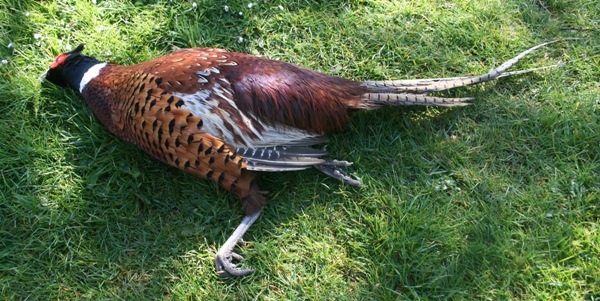 The three lady-pheasants who were his this-year's consorts are still coming to the doorstep; hopefully they have or will have eggs soon? Later in the day I saw this fellow (below); he saw me and loped off. When a hare lopes off he is languid...he lifts slowly forward off his back legs and goes on and on lifting until finally his back legs have finished extending and he can swing them forward towards another long stride. 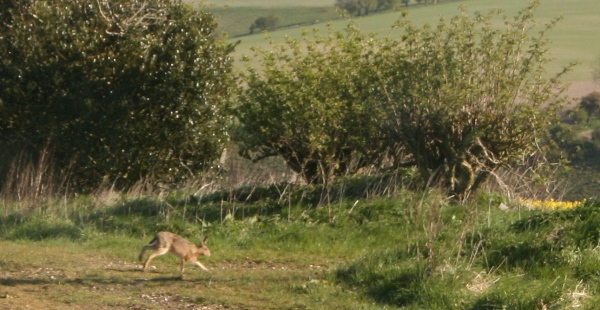 |
Mon, 16 Apr 2012 A mid-April day and the sun was shining, making it a pleasure to sit on the doorstep to eat breakfast. Sparrows were twittering in the hedge and I wondered why they weren’t out foraging but perhaps it’s because I keep them supplied with fat balls and seed, or maybe they were sitting on eggs –it would be about the right time for a first clutch. From under the hedge a small this-year’s bunny ran out onto the grass followed by what I thought at first was a playful sibling...within seconds I could see it wasn’t another bunny but maybe a squirrel although why would a squirrel be playing with a bunny? It became clear that the tail belonged to a weasel, and this weasel was about half the size of even a young bunny. The bunny darted from one side to another –I’ve seen the tactic on wildlife films when antelope avoid big cats- and the weasel followed hot on his tail at every turn. They shot back under the hedge and I heard the death squeals of the bunny. I crept up to watch as the weasel clung with his teeth on to the throat of the bunny; it seemed to take minutes for the squeals to fade. I know it happened so fast but, as I watched, time extended like a stretched rubber band and snapped back into place once it was over. All very sad and rather an abrupt tempering of my sunny mood but it can’t be denied that the weasel must feed its family too.**** I went looking for the bunny later but the weasel must have dragged him clean away. **** On a less startling note, I saw two swallows today, fresh from Africa and darting about after insects, inscribing an invisible web across the sky. |
Sat, 14 Apr 2012 On my mother's orders I have just watched the Grand National on telly and it was so very stressful! Of course my money was on Katie Walsh on Seabass; that she made it round all 30 jumps and has become the highest placed woman at third is truly fantastic but she probably feels she's failed in some way. So many of the 40 horses and riders were down, two before the third jump, that her father must be truly relieved that she got round safely. My mother spent a large part of her childhood on the back of a horse -she was quite a daredevil, taking pleasure in frightening my grandmother by standing on the back of her horse at speed, by taking her father's horse over the Grand National practice jumps, by heading off for days on end across country with her cousin (my godmother Clare) staying in B&Bs and at one point leaving their horses in a field in Lymington while they crossed to the Isle of Wight on the ferry -when they got back the horses had been moved! Watching the race and thinking of my mother, I've decided I need to make some sort of painting about the horses, the jumps and my mother riding. They're talking about the lightest jockey in the race being 10st 1lb which means I can be a jockey at 10st 5lbs maybe??? Katie Walsh has just been interviewed, she has a lovely deep Irish accent. Anyway, congrats to the winner after a very close finish -Daryl Jacob on Neptune Collonges. 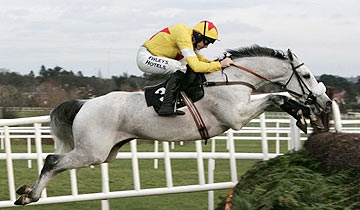 Neptune Collonge: Phew! I'm going to have to have a cuppa to wind down! Perhaps Simon get this excited watching Torquay play!!? Just heard two horses had to be put down, 'According to Pete' and 'Synchronised' -it seems a desperately fickle reason to sacrifice such lovely animals, I suppose it mirrors the extent of the excitement felt about the race and its gruelling nature. |
Mon, 09 Apr 2012 It's an on-going quandary -to what extent does the image in a painting dominate (or not) over the quality, or should I say character, of the paint-work? With experience it becomes clear that image alone is not sufficient for a good painting. There are many good images out in the world, but the best paintings marry a compelling image and enigmatic paint-work. While we were in London recently I saw some Constable sky sketches in oil. I can't find the words to describe how gripping it was to look at these paintings, how clear his captivation was, more than that -he had a compulsion to respond. Part of what made them so good is that he was attending not only to the clouds but the in-between spaces too; the areas which connect the clouds and are therefore a visual manifestation of the relationship between clouds. Every part of the page was worked on but sometimes loosely and other times with thicker more textured paint. To describe texture doesn't always require thicker paint. By criss-crossing areas with thinner dryer paint Constable created the movement and density of a stormy grey sky. Perhaps the most important thing he did was make lots of these studies and so gather the experiences he needed for work on his studio paintings. Sometimes his paintwork is fabulously raw and impressionistic I think Monet must have come to him for all his ideas! 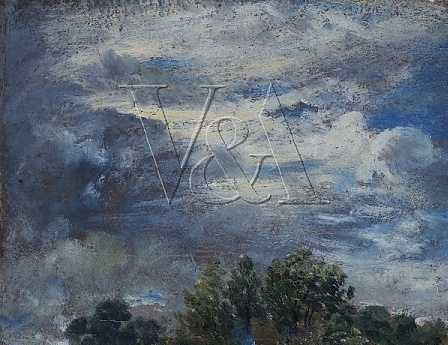 |
Sat, 07 Apr 2012 I'm just remembering as a teenager crossing the USA by train and taking in the landscapes as we travelled through them. The odd thing is that years later, with our kids, we drove almost the same route; the road hugged the train line most of the way, and all the landscapes I re-saw fell back into place. The states I did by train and then by car were, more or less, New York, Pennsylvania, Ohio, Indiana, Illinois, Iowa, Nebraska and Colorado. On my first trip I then flew to California but on the second trip we drove on through the Rockies, Utah, Arizona, New Mexico and back to Colorado and home to where we were then living, Massachusetts. It was a huge trip but I can recall the different landscapes for each place very clearly. |
Thu, 05 Apr 2012 Yesterday we went to visit Dr. Johnson's house (on a small square off Fleet Street) -he of the dictionary, and what a wonderful house it is! On four storeys, the beams, panelling, original built-in cupboards, rickety staircases, peculiar but clever screen-wall system to turn a large first floor drawing room into two intimate rooms and a landing -all wonderful! The lady at the desk was saying that most visitors, when asked, know about Samuel Johnson thanks to Blackadder (Rowan Atkinson) and his discombobulating of Samuel Johnson (Robbie Coltrane) by pretending that many significant words were missed out of the dictionary. Sure enough our daughter, who was with us, said yes, that's how she'd learned about him! http://www.drjohnsonshouse.org/ We went on to St. Brides the journalists' church where I love to go down into the basement and see every strata of history from the Roman paving right through all the various walls, foundations and changes through all the centuries. There was a quiet vigil in the corner of the church to Marie Colvin and Remi Ochlik who died in Homs recently. Being so close to Tate Modern, I wandered over The Blade of Light to see what might be going on...the queue for Damien Hirst was all through the Turbine Hall and out of the door so, rather than combining him and the Yayoi Kusama, I went only to the Kusama show where I saw spots and butterflies and so much more. She is a Japanese artist whose work I had read about when were last on Exmoor. At the age of 8yrs she had a vision of her mother covered in spots, and from that moment her drawing developed so that her 20s, 30s and beyond she was experimenting with spots, dots, repeated marks, but unlike the other spotty paintings on show in the Tate just know, her spots are extraordinary and come from some mad place in her soul. She was born in 1929, was painting in her teens on her family's seed farm and studying painting in Kyoto from 1948. In the 50s she moved to New York feeling that Japan was 'too small, too servile, too feudalistic and too scornful of women'. Her art needed more unlimited freedom and a wider world. After many years away she returned to Japan where her psychological frailty caused her to admit herself voluntarily to the hospital that has remained her home from 1977 to the present day. She has a studio across the road from the hospital paints every day. Her work is witty, poignant, beautiful, profound, full of diversity with her materials and ideas -really great. One particularly lovely installation was a room, hung with coloured Christmas lights which oscillated through various single or mixed colours; you stand in the room as these colours merge, change and blend, but because every bit of floor, wall and ceiling are covered in mirrors, you see these lights to infinity...and every few minutes the lights go out completely for about 20seconds. It's very discombobulating.  I wandered back over The Blade of Light and caught evensong in St. Paul's Cathedral, reminding me of my sons' school days in the choir and evensong in Salisbury Cathedral. |
Tue, 03 Apr 2012 Plenty of stuff about Damien Hirst still; I guess there will be for some while. Julian Spalding (he to whom the Tate refused entry to the Hirst exhibition -and how pathetic of the Tate people!!!??!) writing in The Daily Mail is not a fan... 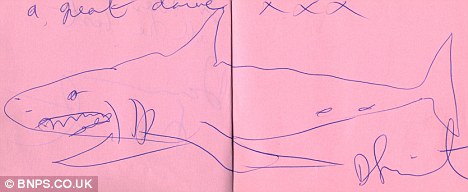 "This child-like scribbled drawing of a shark drawn in a hurry in an autograph book by Damien Hirst has sold for a whopping £4,500. A shark is interesting to look at but it’s not, in any way, Hirst’s creation. All the art critics – and they are my next bunch of fools – who write that Hirst’s shark addresses the big issues of life and death are projecting their own thoughts on to it. It’s all in their minds. So is Hirst’s status as an artist." I love that Daily Mail use of the word 'whopping'. However, it reminds me that when I exhibited a painting of Hamed Karzai half under a burqa and some kid came along and asked 'Is that Darth Vader?'Simon said to me 'We bring to a painting the world we know' and he is so right. It means that if you come to an art-work and it evokes an emotional response in you, the artist has been able to create a common idea -even if it is only 'common' between you and the artist, some kind of successful communication has happened. 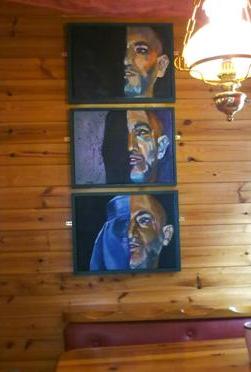 From The Independent, a review by Adrian Hamilton -"Hirst certainly has the courage to take risks but does he, one asks, have the courage essential to the best art of taking risks with himself?" This, I think, is the key. Damien Hirst is so caught up in a world of bold impressive risk that he has failed to tap into whatever that nugget is in the marrow of his bones and show it to us. Perhaps he tried with his paintings shown in The Wallace Collection in 2009, but they were so soundly slated by everyone that he has not had the courage to include them in this retrospective. I think he should come to my art classes -if he could endure the humbling, he would have so much to learn from my students! Off to London today to see Dr. Johnson's house just off Fleet Street...and perhaps a few more things. Have laptop...will blog. 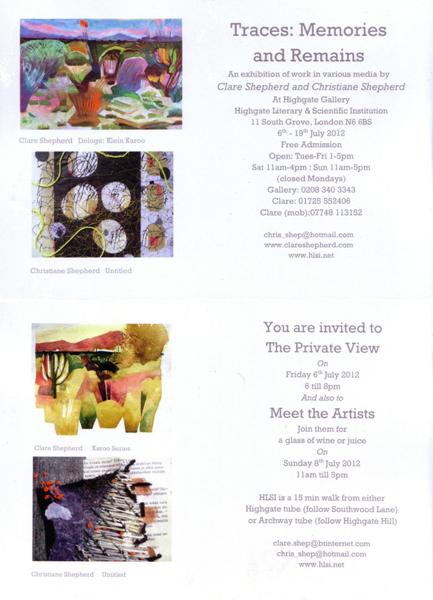 |
Mon, 02 Apr 2012 I've enjoyed all the Damien Hirst stuff on telly&radio tonight, some of the work was sublime and lovely. I was surprised to see none of the paintings he did for 2009 Wallace Collection exhibition and about which Adrian Searle in the Guardian said 'He may have done them on his own, but these doomy, gloomy paintings look positively amateurish'. I'm not sure it's a true retrospective without the paintings...Hirst's interviewer Will Gompertz was heard to say that painting is SOOO old fashioned and perhaps that's the prevailing view among the cognoscenti. As ever it was impossible to tell whether Will Gompertz had his tongue firmly in his cheek or not. Some people want to be like Damien Hirst who has been, and is, very accomplished and adept at presenting himself. Other people mustn't feel that is the only way to do it. It is not a race and success is not measured by other people -ideally one's own success is generated from somewhere within. You know what you are driven to do, you know when it's not 'right' and needs re-working. These things are not governed by the opinions of the outside world, but if the outside world comes to love the work...great! If not, at least satisfy yourself...the outside world is not all it's cracked up to be (quote from my hero Arvo Part!). 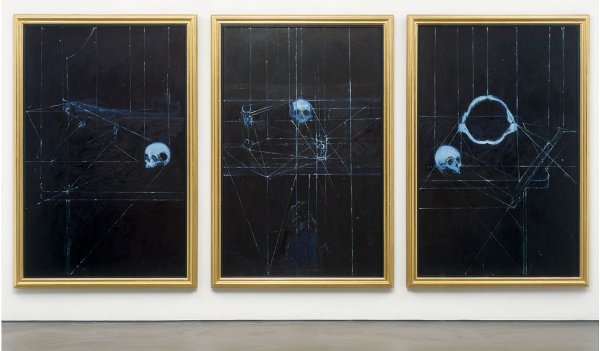 Hirst's 'The Meek Shall Inherit the Earth' http://www.telegraph.co.uk/news/9180084/Siberian-air-crash-kills-at-least-32-people.html After flying over Siberia on my way to Japan, I felt sad above and beyond the sadness one feels on hearing of a fatal air crash. All the way over Siberia, gazing down on the vast frozen emptiness, I thought what a desperate place to fall from an aircraft. I gather this plane crashed while attempting an emergency landing. **** On a lighter note...here I am again! Easter hols and preparation for an exhibition in the summer is well under way; invites designed and printed, envelopes and stamps bought (before a mortgage is required to buy a book of stamps -even I think the latest price hike due in a few weeks is too much, and I\'m a great supporter of our post office as being one of the best in the world having had experience of other countries\' postal services). Almost all the paintings are framed and ready to go but I still have to decide how much to include in the way of artifacts, drawings, sketch books (if at all) and so on. Of course it gives me sleepless nights so I'm trying to think about grow-bags and tomato plants and other delights of the garden instead. 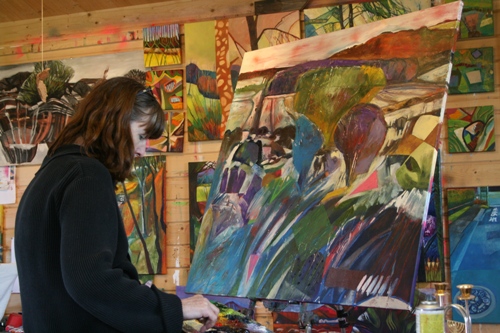 On yet another note, we're hearing about the 30th anniversary of the beginning of the Falklands war; I was in Argentina for two months in 1979/1980 and all that everybody talked about was Islas Malvinas. No sooner had people been introduced to me then they would ask 'What do you think about the Islas Malvinas?'. Initially I knew absolutely nothing about the Islas Malvinas which shocked them greatly as they were talking about nothing else. All through their school years they are taught that the Islas Malvinas belong rightfully to them. I was travelling alone but met many people, both rich and poor and I stayed with many of them in their houses and become part of their dinner conversations...which relentlessly revolved around the Islas Malivinas. I came home in early Feb 1980 thinking 'Well I must have missed this at home; I guess the Govt. know all about it...'. It's my belief now that Governments work at too high a level, at ambassadorial level, so that they have no idea of feelings on the ground of any particular country. Of course the war began two years later, but I am certain that our Government had no idea of the strength of feeling in Argentina. If they did, then we were mislead into not thinking. We weren't even mislead into wrong-thinking, we were mislead into having no idea whatsoever of the impending danger. |
Sun, 26 Feb 2012 Blue sky, buzzards circling, larks twistling, washing on the line, first daffodil blooming...has Spring opened the door? |
Sun, 29 Jan 2012 Mt. Inunuaki: Mt. Inunaki is a Shugendo mountain shrine, unusual in that the training of women in Shugendo is allowed –and at the top shrine we saw a serene and tranquil windowed-to-the-ground classroom with kneeling cushions, low desks and an old fashioned blackboard at the front of the room; it was how I knew which end was the front end. Shugendo is a Buddhic religion with a mystical-spiritual tradition which originated in pre-feudal Japan and in which enlightenment is equated with attaining oneness with the Kami . The Kami is a Japanese word for ‘the spirits’ and ‘natural forces’ although the word is sometimes translated as ‘god’ or ‘deity’, perhaps like the word ‘elohim’ in Hebrew. We caught the bus from outside the Izumisano train station; we were travelling to the end of the line, a journey of about 45 minutes through the outskirts of Izumisano which itself is a satellite of Osaka, through villages and the countryside (which was largely tree-covered mountains turning orange with the fall). It seemed amazing that there was so much greenery left in the middle of December but maybe Japanese seasons work slightly differently from ours. It was lovely to be able to see how the houses and villages look, the buildings were more traditional outside the town, heavy-tiled roofs with upturning corners and house walls looking more like sliding panels but, even though it was countryside, people’s gardens were still small. As in the towns, the houses are surrounded by paddy fields and cabbage fields, but on a larger scale and through the flat valleys between the wooded mountains. The ‘mountains’ are closer to what we would call steep hills but their shape is distinctly mountain-like. We were dropped beside a bus shelter half way up a hill; the bus turned round in a big turning-circle and headed back the way it had come and we dropped down to where a footpath forked off the road. This place at the foot of Mt. Inunaki is where two rivers meet and continue their journey together; apparently many shrines are created on mountains with rivers. We followed the footpath alongside a few quiet hotel buildings, probably busier places in summer, and up through tall trees on both sides. George tells me that the river-pools are big enough to swim in and people come out here in the hot summers to swim and barbeque on their days off. The boys walked ahead of me; it was nice to watch them bantering and messing about, or caught up in conversations perhaps about computer games or life abroad. The climb up was peppered with little shrines in rock-clefts, collections of carved granite deities with, what looks to us, funny red aprons tied on them. The aprons are usually red because red is the colour for expelling illness and demons; red equals health, fertility and life-creating powers. Proper worshipping of the deity who visits sickness on you would mean protection against ill-health. We were among tall larch trees, huge sequoia trees and bright yellow Acers. It made sense of what I’ve seen in Japanese art; trails of leaves and foliage across the foreground of a print or painting. In the modern art museum in Kyoto, Jack and I had seen a painting with bright yellow foliage springing up from behind a wall –we made a reference to it when seeing the Acers on Inunaki. It was my first time in Japan surrounded by countryside, but like our year in Massachusetts, because of all the trees, it’s difficult to get a sense of the lay of the land other than the feel of incline up which we were walking. It was a peaceful walk, we bumped into a couple of families with children and I was reminded of walking with my kids in similar places. The children were enjoying the river, scrambling about just as mine would have in the past. It struck me that this was probably the first time my boys had walked in the countryside like this for many years, perhaps as many as 10 years. Maybe I could count on one hand how many more they might walk like this as their lives continue in their own diverse directions. We continued on up with me able to wander in my thoughts and soak it all in as the boys walked ahead of me. |
Wed, 25 Jan 2012 Nara, once Japan’s capital city (710-784), is home to eight shrines, temples and ruins plus the Kasugayama Primeval Forest which collectively form the ‘Historic Monuments of Ancient Nara’. Roaming free, through the town and among the temples, is a herd of tame deer. According to the legend of the Kasuga Shrine, a mythological god Takemikazuchi arrived in Nara on a white deer to guard the newly built capital of Heijō-kyō. Since then the deer have been regarded as heavenly animals, protecting the town and the country. Vendors in small booths around the town sell deer biscuits to visitors so they can feed the deer. We had heard that some of the deer have learned to bow their heads in response to tourists' bows. Jack was testing them; they certainly bowed, but when he teased them and didn’t give them biscuits in return, they jostled him and even bit him on the bottom. The truest form of Karma I’d say! They understood their dues, they also knew when you had biscuit and when you hadn’t –as soon as you hadn’t, they lost interest. We went first to Kofukuji temple, a Buddhist temple established in 7th century by a powerful ancient aristocratic family ‘Fujiwara’. In some places I read that the first temple was built by Fujiwara no Kamatari, as a dedication to her ailing husband and in the hope that it would aid his recovery and in other places I read that it was Fujiwara no Kamatari who was ailing and her husband who had the first temple built to aid her recovery. Over its history, many of the buildings have been damaged by war and fire and re-built many times. After the last collapse in 1717 it was perceived as impossible to re-build on the same scale as the original buildings and so today not only are there fewer buildings but they are apparently less impressive. Nonetheless I found them impressive and gorgeous; I loved seeing the huge wooden structures held with giant pegs and interlocking beams rather than nails. In one of the vast temples I could see it was held up by a giant inside wooden scaffolding which reminded me of the wooden scaffolding inside the steeple of Salisbury Cathedral, put there to build the steeple around but left there for greater strength. The power of the Fujiwara clan had faded by the 12th century, so the final rebuilding of the temple in 1819, without a guardian clan for funding, was done ‘by the hands of the common believer’. Current re-building of the Central Golden Hall to its original size (which we saw under huge scaffolding and covers) is being funded by the Japanese Govt., the Nara prefecture and donations from the public. Inside the eastern golden hall of Kofukuji temple I saw my first real-life huge golden Buddha. He sits in a vast vertical eye-shape, the same shape in which Jesus is portrayed in almost all medieval art and manuscripts. In the corner of the room was a rack where people were able to write and leave their wishes and prayers, and light a candle –lots of similarities so far, but unlike churches and cathedrals there are no seats, and I don’t think there are services as we know them. As I understand it, monks keep the religious needs of a temple in order and the people keep a small shrine, with a little Buddha inside, in their houses or even in the street outside their houses, and can pray to them whenever they need to. Beside the eastern golden hall are an impressive five storied pagoda and a museum which houses some of The National Treasures of Japan. In the museum we saw a collection of super animated statues, priests of the Buddha, made in the 7th century of ‘dry lacquer’ and all with various and specific attributes. What I saw in them, and which took me aback, was their likeness to figures in Japanese manga books. It seemed to me that manga has come from this; their expressions particularly, were fixed into very specific meanings, so that both in these statues and in manga, if someone is biting their bottom lip, even if the face above looks sanguine it signifies an expression of fury. I mentioned it to my daughter Mary who reads manga, and she said ‘well yeah, of course it does’. She mentioned another off-shoot of manga and Japanese animation called ‘meme-faces’. These too use the same expression for fury -biting the bottom lip. Some of the animated positions of what looked like warrior-priests were so analogous with the figures in action-scenes of the manga books I’ve seen, so that although I read on-line that manga was heavily influenced by the comic books brought over by American G.I.s after the war I think the influences are deeper and much more rooted in their own culture. I wonder if ‘Bunty’ or ‘Eagle’ with its ‘Dan Dare, Pilot of the Future’ are steeped in our culture to the same extent? I suppose so! |
Tue, 24 Jan 2012 Nara: One day we visited a town called Nara with a friend of George’s. We used the subway and city over-ground trains through Osaka and north-east out to Nara on the edge of Osaka. At each train change you exit the line you have travelled and find a new ticket machine. You look on the map above the machine to see where you currently are, check the place to which you are travelling and under it you’ll see the cost of your upcoming journey. You can put money into the machine either as coins or notes and your ticket plus any due change pops out. On exiting each journey your used ticket is swallowed up by a barrier through which you pass. There was rarely a need to queue to buy a ticket. Queuing for the train was orderly; on the edge of the platform were periodic footprint images which, if you stood on them, would place you exactly in line with the doors of the arriving train. The first passenger to arrive on platform stands on the footprints and subsequent passengers queue behind. At certain times, rush hours, some footprints are ‘women only’ meaning that those carriages, at the most crowded times, carry only women. I’m told that if a train is more than three minutes late the station-master walks through the waiting passengers and gives them a note to give to their employer to say that the train was late. I never experienced a late train so I can’t confirm that. Nara is one of the World Heritage Sites. To come to a WHS knowing that we live so close to others (Jurassic Coast, Dorset and Stonehenge in Wiltshire) seals a link between us from the beginning. I know how closely connected I feel to our World Heritage Sites and understand immediately that the Japanese will feel the same about theirs. It focuses one’s thinking on trying to understand what it is about this place which captivates its own people, because it was saturated in a culture very different mine. The huge wooden buildings have roofs with vast eaves which turn up at the edges; I’ve seen it on oriental prints and pictures but here they were in reality. It reminded me, my father told me, when he’d been evacuated to a family who made him hang his feet between the floor and the chair-bar because he wasn’t allowed to make either dirty, that he’d had a terrible row with the man of the house. My Dad had said the word was ‘Pagoda’ but the man had insisted it was ‘Padoga’. I don’t think that looking it up in the dictionary went down well. I think it sealed my father’s fate with that family! pagoda [pəˈgəʊdə] (Non-Christian Religions / Buddhism) an Asian temple; usually a pyramidal tower with an upward curving roof. |
Sun, 22 Jan 2012 I had the rest of the first day to myself. In the apartment I racked my brain and used years of experience to discern the meaning of the squiggles and blocks on George’s washing machine and did some of his waiting laundry. I found tea-bags and drank copious amounts of tea; it must have been the dehydrating effects of flying. I set out my futon and tidied Jack’s futon. I arranged things so that three of us in a compact apartment wouldn’t be tumbling over each other. It felt good to be doing domestic things for George again although he may not thank me to hear it –perhaps he came this far to avoid all that? It’s a need in all of us (certainly me) to claim an area to oneself in a very small space inhabited by several people. As long as I had my futon area, I could place my drawing things and my camera in safe places. My boundary was marked as the area of my futon. George’s bed was in what he called the ‘loft’, a shelf-like area not much bigger than a bed with room for a low bookcase. The ceiling was low, perhaps as high as a dining table and the whole level was accessed by a ladder. His loft space retained for him his privacy while we were invading him. My futon was up against a large window, two thirds as big as the wall itself, and the sunshine shone through with such warmth that for a long time I opened it and soaked up the sounds, kids heading home from school, sparrows and lots of them, very little car noise –more passing cyclists chatting rather than car noise. I had a hot bath! The water heater is a good one and the shower-room too; there's a small deep square bath in a complete pod-like wet-room with shower and sink. I filled the bath and dropped right in under the hot water, soaking off the oddness of having travelled so far. The thought that I was sinking into a bath 6000 miles from a home which I had only just left that morning seemed impossible. I put on the clothes I’d travelled in and felt a lot better having had the bath! Washing is ritual for Japanese; I believe they wash in the shower and THEN get into a bath of clean water, hence, for a small apartment the washing facilities were better than I have known in bigger flats that I’ve rented in London in the past. The way each component of the apartment slotted together was extremely well thought out. Even the loo was separate and placed away from the main living area, giving some privacy in a small place. The whole apartment block had a pod-like feel; constructed off-site and then, like lego, slotted together. I wonder why we can’t do something similar in UK? I used the afternoon to wander through Izumisano with my camera. I found small rice paddies and cabbage fields with houses around them like cottages around a cricket green but more compact in every dimension. Houses had just a metre or two between them and no gardens -instead tubs and pots with plants and small trees and some tubs with pebbles and lush-leaved desert plants. Frequently I saw neat pairs of shoes outside front doors, bicycles stacked in the gaps between houses, washing hanging on balconies in even rows, pegged with giant clothes pegs, small square cars slotted into car-ports. I even came upon shabby old buildings, the remains of wood-yards with rusting machines both inside and out and rough grasses growing up among the wreckage. Cosmos flowers were still out, long finished for the winter in UK, and unrecognisable blossom on trees (which I’ve since learned is a winter flowering plum or apricot) with small green birds that hang upside down off the little branches and push their heads right up into the blossoms. I discover that they are Japanese White Eyes, or ‘Mejiro’ in Japanese. Wikipedia says ‘The species is omnivorous, living on a diet of fruit from several species of flowering plants, various types of insects, and nectar at all levels of foliage. It feeds on insects by searching the leaves of flowers and scouring tree bark for larvae. Consequences of its diet include regulation of local insect populations and dispersal of seeds.’ It surprised me a great deal that nowhere did I find ghettos of poorer areas or smarter areas. Everything was jumbled up; smart houses, occasionally with a garden, scruffy houses, middle class family homes, apartment blocks both tall and short, smart brick blocks and scruffier lego blocks, small factories, warehouses, cafes, clubs and bars, all genteelly mixed together creating something more like Camberwick Green than we have in UK -something more English than England?? Snaking through all this were raised railways, fly-overs on one and two levels and never creating a rumble or an intrusive noise. The trains flow like rivers of mercury. But best of all are the service poles, dangled with wires between them and the next pole, between them and each house in the street, between them and the poles on the other side of the street, carrying routes of communication, routes of power-transportation and routes of connection. On each pole are transformer-boxes, street lighting, traffic signage, hand-pasted posters, shop signage, and as the heavily laden poles diminish into the distance they describe the length and curve of the street to which they deliver so much. |
Sat, 21 Jan 2012 It is testament to the efficiency of the Japanese that I was informed about my missing luggage before I’d tried to collect it off the carousel. A Japanese lady asked me if I was Clare Ann Gillett and informed me, politely, that my luggage was in Paris and would arrive in Japan the following morning with the same flight on which I had just arrived –her apologetic explanation diffused any frustration I might have felt and I had now experienced, for the first time, the famous Japanese courtesy. Together we went out to meet George and arrange for its collection the next day. It was lovely to see George. As it is generally, with family and best friends, the gaps between last meetings melt away and a past time flows seamlessly into the new one. This was the longest space of not seeing one of my children that I had experienced. Is it a cliché to say that everywhere was extraordinarily clean, smooth, modern? No crowds jostled as we got onto the train taking us across the bridge to the mainland. The airport itself was human-scale. There were no hoards trying to shovel through passport control, and no battle for space around the suitcase carousel. The air was soft and warm, the sun shone and we not so much rattled as passed smoothly through two stops on the train to the station which services both George’s workplace and his apartment. I was seeing the places I had visited virtually; most of what assailed my senses felt foreign but visually it was familiar and comfortable. No colours are stark, the beiges, greys and browns of clad houses never clash with the clean concrete rail and road fly-overs, which sit right along-side. Between the station and George’s apartment is a mix of houses, small shops, clubs or bars and service wires like spider webs criss-crossing the narrow streets. People cycle; I saw mothers with two children on one bike -a child in front and a child behind and perhaps an older child on his or her own bike ahead of them. The streets are quiet and everything is seemly –I never heard a car horn during the week and there were many fewer cars than one would have expected in an urban area. The cars were small, box-shaped and snub-nosed, probably 90% were Japanese cars but those who are proud have a BMW or a Mercedes. I know you're asking...'How did the lady at the airport know it was me?'...I was the only non-Japanese passenger on the plane so rather than being a wild stab in the dark...I was a fair bet! |
Tue, 17 Jan 2012 One night in November I dreamt George paid us a surprise visit; in my dream he walked into the big sitting room unannounced. I heard his voice and turned to look; I perceived his pleasure at doing something so nice for us but my was delight was deflated rapidly when I saw an aged version of my son with sore red skin and whose hair was grey and falling out. The dreaming me thought ‘something’s awfully wrong here –the country isn’t doing him any good’ but I couldn’t think with any clarity or make the step to wakefulness and reality. The dream was so vivid that within days I had booked my flight. More than aware of its being a long way to travel for just a week’s visit, I figured a week was a perfectly good length of time if it were a shorter travelling distance, so that all I had to do was come to terms with the journey itself and make the most of my time there. In the days before the journey I went to the ‘google-maps’ website for a virtual tour of the area where George lives. He would be at work for much of my visit and it was useful to both of us for me to know how his apartment related to his workplace. It is absolutely extraordinary that I was able to go online, and not only find George’s precise apartment block but also walk, virtually, to his workplace and around the area. I found small cafes, a little supermarket, the station, bus stops and little streets, all of which I walked in reality only a few days later. It gives me great pleasure now, to go back for the occasional virtual tour and revisit the places I associate with my time there. I love it! -It no longer seems like George lives 6000 miles away; it has the great feeling of being just around the corner. |
Mon, 16 Jan 2012 Japan:---- George’s apartment, small but cleverly arranged ('kick-ass' in George’s words), was where we went first. A spare key had been cut to give me independence to come and go. The block was just two stories, ground and first, or in Japan ‘first and second’ and looked like a lego building in horizontal grey and white stripes. Jack’s futon was already out taking up almost half the sitting room floor and I could see new futon kit and covers packed up and waiting for me. George changed for work and we sauntered back towards the station and his workplace. How does a notoriously crowded country give the feeling calm and order? Instead of vast car parks there were vast bicycle parks where commuters parked their bikes, either then to catch a train further or because they had cycled to work in the area. We stopped for coffee and cake in The London Cafe where I heard George speak Japanese for the first time and so the length of time since I’d last seen him became apparent –here was something about him entirely new to me. In the small pharmacy on the square where he works, George bought a soft drink and being a frequent customer, he again spoke in Japanese. I saw the delighted and surprised looks behind the counter as the ladies realised I was George’s mother. As they giggled and bowed respectfully I found myself doing the same, not for the last time during my week there. |
Sat, 14 Jan 2012 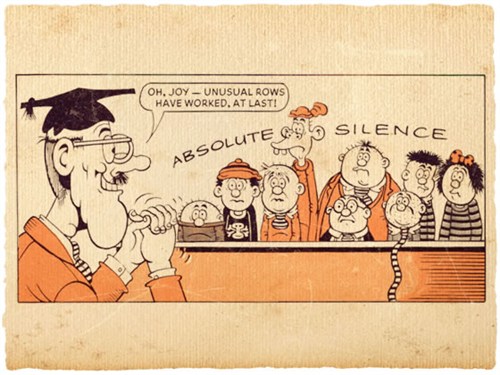 Another day with two reasons to rant before the 9am mark!! Reason one: Gove The Bash Street Kid banging on about the need to be able to sack poor quality teachers in a hurry – within a term instead of a year. My beef isn’t about sacking poor quality teachers; it’s more about the given assumption that there are thousands of poor quality teachers out there in need of sacking. If that’s the case then presumably they are all, at this moment, in the process of being sacked within this very year –so we should be able to count exactly HOW many poor quality teachers there are out there being sacked. And if Govey wants to he can speed their sacking up to within a term....but folks, it’s not about that at all...the whole bluster is a smoke screen from which an education minister is able reveal to you, the people of Britain, how strong he is and how focussed he is on pursuing what you, the parents, are crying out for –Bloody Teachers!! It’s all their faults!! Much more worrying are the poor decisions made by Govt. Ministers, heads of schools and senior leadership teams -decisions not made first and foremost with interest of the education of the pupils/students/children at the forefront of their reason for being made, nor with any thought to the much ignored needs of a teacher to be able to teach effectively. If only every decision made in a school had to go through some kind of filter which swept away the pointless, the unhelpful, the uninteresting downloads which swoop down from Government through senior leadership teams to the teachers on the coalface. The teachers find themselves cornered, having to deliver nonsense in a nonsensical way but having very little freedom to respond to needs of pupils/students/children as they see fit at a given moment in time. The people at the top can battle it out as to whether this teaching method or that teaching method works, as to whether statistics gathering is time wasted or time spent usefully, as to whether statistics interpretation is time wasted or time well spent, and so on. As I see it Rome is burning and way way way too many people at the top are fiddling. Okay, rant two: I heard Will Gompertz on the radio this morning talking about the new David Hockney show. He asked Hockney about the state of art today and why, in the grand tradition of Constable, Turner and more recently Paul Nash, were there no painters following in that great tradition of landscape painting? I liked David Hockey’s answer very much and I liked the way he delivered it –quiet and laconic. He said ‘Well they’re all living in London’. He also went on to say that the art world was far too caught up in conceptual art; it gives little or no regard to ‘painters’ . Ohhh David I so agree!!! There are so many painters across Britain following in that wonderful British tradition of really great landscape painting, and some of them (dare I say?) are as good and some better than David Hockney. The trouble is that Will Gompertz is part of the art world which talks-up conceptual art and moves around the city to do so. I lived in London while I was four years at the Slade, and possibly another 18 months after that until I went travelling to ‘find myself’. I could not have been unhappier or more displaced than when I was living there. How or why I won The Slade Prize I’ll never know but I suspect it was on the strength of the landscape paintings I used to do over the summers when I went home to Somerset, and about which Lawrence Gowing was always extremely complimentary. The point is that I am only interested in art which comes from the gut, from the marrow of my bones or the marrow of the bones of the artist whose work I’m looking at. Too much conceptual work is unengaging and irrelevant to too many people. I hear so often ‘But I don’t understand it...’ and those people who say it feel they have no right to ‘judge’ the work because they don’t understand it. Clearly there’s a complete inability of much conceptual art to communicate that which is engaging or interesting to the outside world (or to communicate anything at all)...and that is how it feels...an inner self-congratulatory circle and an outside world. Well People of The Inner Circle, it’s time you looked out at the rest of Britain and saw some of the extraordinarily engaging and beautiful landscape work which is going on in your wonderful country. It resonates far more deeply with many many more people. It isn’t created as part of a corporate world where the ethereal and the conceptual have a value completely unrelated to anything concrete but are whipped up in a frenzy of fashion like piranhas around a pork chop. It is profoundly and lovingly created and comes from somewhere deep within the psyche of the creator...and is therefore gripping and memorable and lovely. |
Fri, 13 Jan 2012 I have begun to organise my thoughts and write a bit about my trip to Japan. Unlike the Africa trip which had thundering impact on me, the Japan trip is a more gentle absorbing of the experience, like a slow cooking casserole. Every now and again I'm going to put paragraphs from the writing here -the paragraphs which describe small but significant occurrences. - 'The flight was certainly gruelling. I had a stop-over in Paris, but as we left Heathrow more than an hour late we breached significantly into my 90 minutes swap-over at Charles De Gaulle airport. Consequently I got on my connecting flight, just, but my luggage didn’t. I could count in minutes the times it took us to cross each European country; we flew north east over Germany, out over the Baltic Sea, passed over Gotland and on over Moscow. It took a bit more time then to reach the Urals, beyond which I could see on my map the rather cosy sounding ‘Western Siberian Lowlands’. Although by now it was dark, a moon gave good enough light for me to scrutinise what I was looking down on, and a place so vast and bleak and relentless and endless I don’t think I’ve ever contemplated before. I’ve always imagined the poles to be bleak but not like this. I read on Wikipedia that much of the land is poorly drained and contains some of the world’s largest swamps, but being winter and therefore frozen, I was looking down on one giant frozen peat-bog. It says also ‘winters on the Western Siberian Plain are harsh and long’ (understatement!). It took several hours to cross, with very few points of light indicating any life. Occasionally I saw tiny orange gas flares –I’d guess small oil or gas wells, but I could see no evidence of roads or rail-lines which lead to these places; the rivers were white ice, snaking and doubling-back through the dark deep-freeze. Apparently if sea levels rise by fifty metres, this huge part of Siberia will be flooded from the Arctic Ocean in the north to Novosibirsk in the south. It was one of those flights where you get to the five-hour-mark and you think ‘Oh good –nearly half way now’. We were still over scratched, scraped, dry, hard, frozen land, featureless except for the twisting white rivers and orange gas flares. I like to be next to a window to stave off claustrophobia (sounds counter-intuitive?) –I battle with the knowledge of the distance between the ground and me; if I can overcome that demon I’m okay. It is looking at the land below which keeps me engaged, but the aeroplane meal with all its little packages is a good diversion too. The second half of the flight passed over Lake Baikal which was covered in mist, over Mongolia, China via Beijing, over South Korea where the sun came up to reveal soft clouds and a mountainous landscape and finally across sunny southern Japan, north into Osaka Bay and the man made platform of Kansai International Airport out in the bay.' |
Tue, 10 Jan 2012 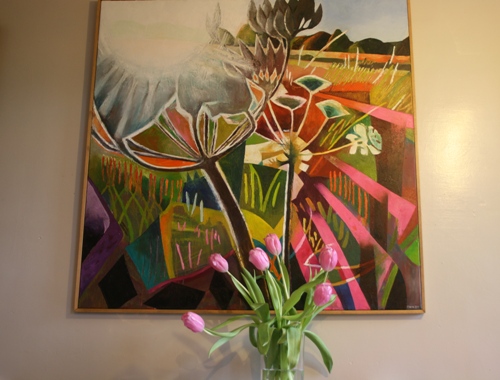 When I painted this painting I had such misgivings about it. It was consigned to a hiding place for many months. At the beginning of winter I brought it out and put it on the dining room wall to see how I felt about it. I have come to love it very much. It has given the feeling of summer light all through winter. I was particularly unhappy about the top left corner where the evening light comes through the seed heads. I didn't spread a thin layer of white over an earlier image of hills, I mixed lighter colours and painted the hills as I saw them -diffused by the light coming my way. I now know I was right to stick to my gut feelings and try to push aside the questions which might have stopped me painting the painting in the first place. I know now that was a painting from the gut. The other day I bought some tulips which were going cheap...put in front of the painting they resonate perfectly with the colours in the painting, all conspiring to give that lovely feeling of an new unfolding year. I'm just this moment listening to Jeanette Winterson on the radio saying that 'Art is a medium for the Soul'. How apposite! 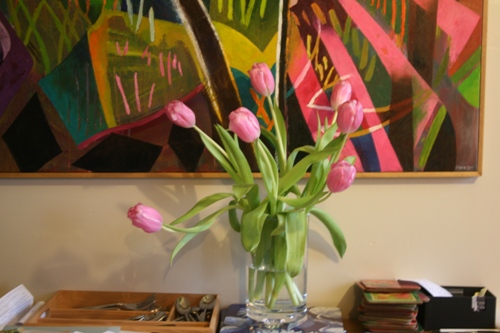 |
Tue, 03 Jan 2012 Lovely things underfoot: Japanese have different drain covers for the different areas and departments. 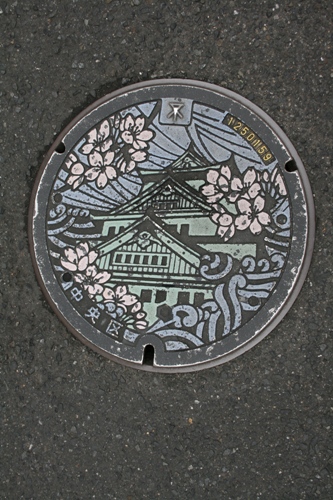  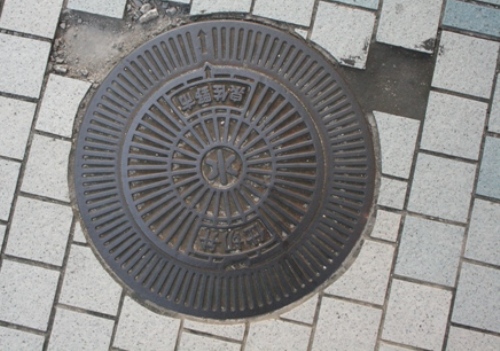  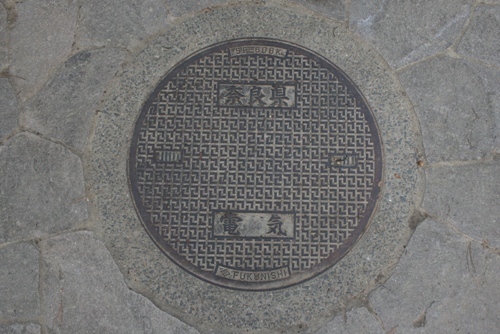 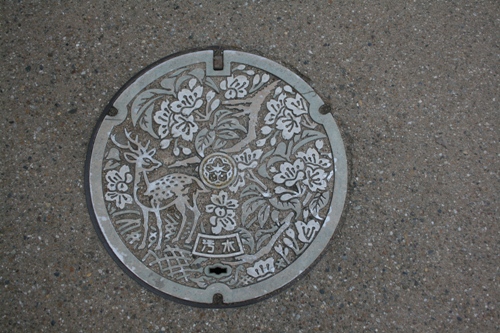 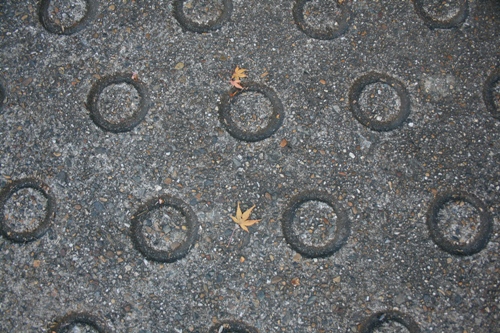 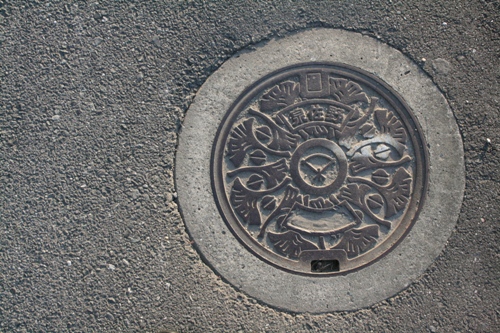 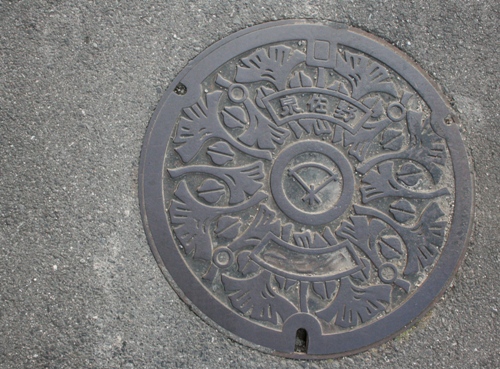 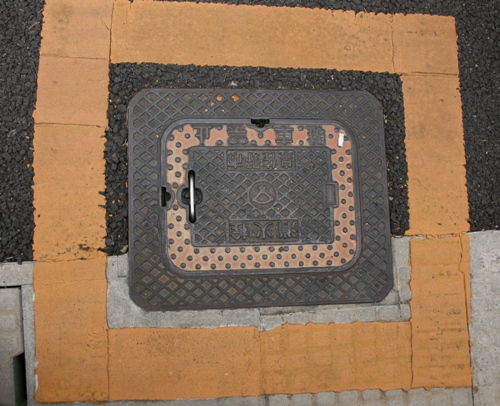 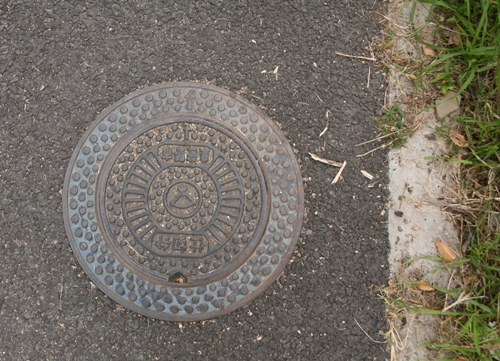 |
Thu, 29 Dec 2011 Day 7; George is at work and so I'm at liberty to entertain myself and do so by going on 'walkabout'. 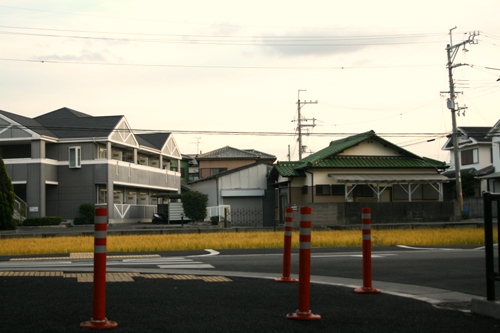 George's neighbourhood, houses and paddy field. 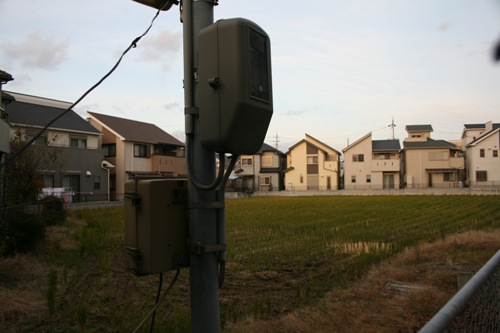 Another group of houses around a small paddy field.  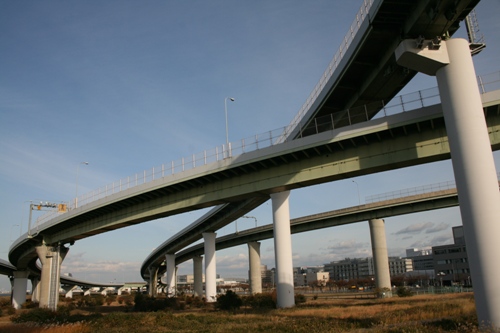 The roads from Kansai International airport heading north to central Osaka. It was a pleasure to have the time just to wander on my last day and absorb the feelings associated with being in another country, one that my son so much loves living in. 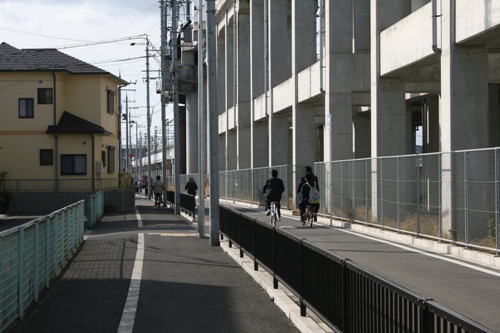 The fly-overs (road and rail) are incredibly close to the houses, including George's apartment, but the traffic never causes a rumble and I think it must be because they are built to anti-seismic specifications; if they have to absorb earth-quake rumble then they must easily absorb the rumble of traffic. 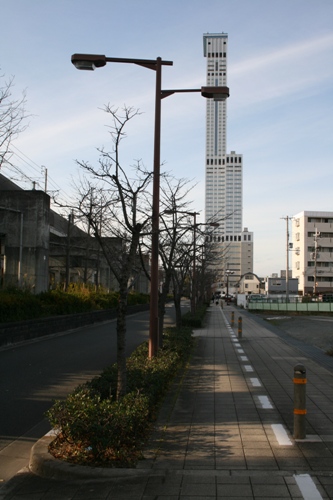 Towards Rinku Gate Tower.  Walking across the road bridge to the airport bridge. 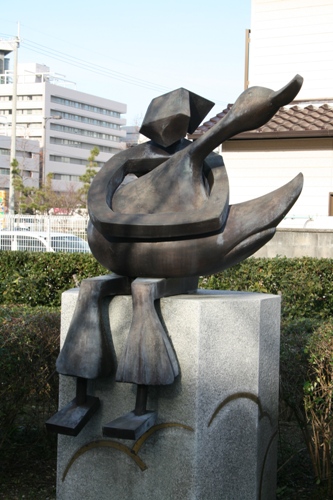 I think there's a story behind this but not sure what it is! I walked through George's area,Izumisano, towards Rinku Town, enjoying soaking up the surroundings and feeling more in tune with them than on my day of arrival when I did the same thing. 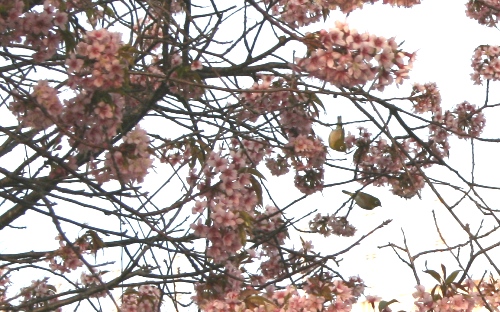 These little White Eyes hang upside down on the branch and poke their heads right into the flower, I guess for the nectar. They gave me great entertainment as I watched them for a long time.  In a park in Rinku. 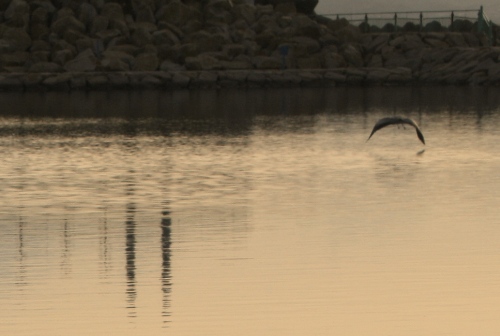  The area near the airport bridge, Rinku Town, was built as a 'new town' in the boom-time early '90s on reclaimed land, but the building of it was never completed as the down-turn came along and money ran out. Consequently large parts of it have become like mini-wildernesses with towers and walkways that look like they were destined for more salubrious surroundings but I LOVE as they are now! There were to have been two Rinku Gate Towers but tower two never materialised.  Walkway to uptown Osaka.  A bit of mini-wilderness by the airport bridge.  An empty park near the airport bridge. 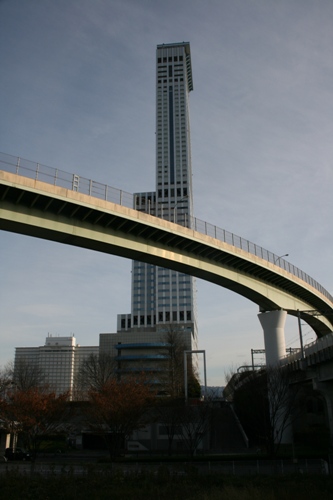 Rinku Gate Tower from the airport bridge. For my last day in Japan I obviously needed to sort out all my things and pack; but I decided to spend the day walking around George's local area, Izumisano, and take pictures which would remind me of everything. Osaka's main international airport, Kansai, is very close to where George lives. It was built on a man-made Island out in the bay so I walked down the water's edge to look at the bridge which carries the train and traffic out there.   Plane landing.   A little garden centre under the bridge!  Many Japanese cars are snub-nosed cubes; I guess they make the best use of space.  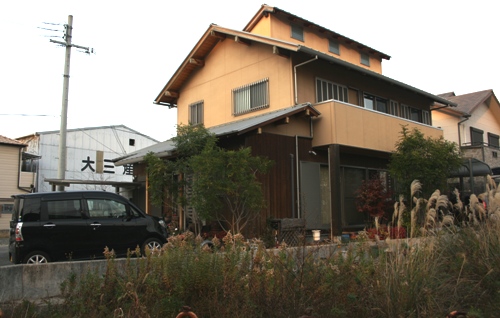 Typical family house. 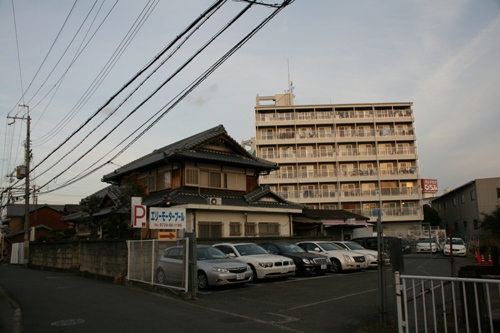 House and apartments; I like the way that housing is so mixed within one area -big and small houses, smart and scruffy apartment blocks, all mixed up. 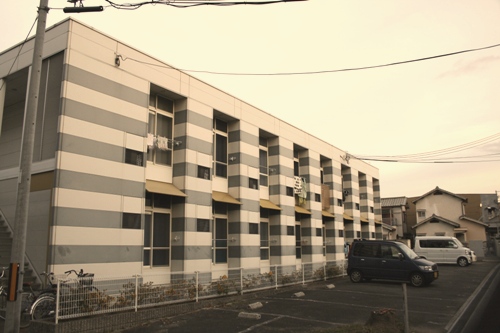 George's apartment block. 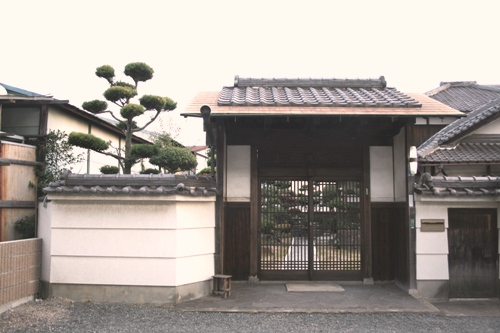 A house near George's with a rare but typical and lovely garden. Very few houses have any sort of garden at all, most have pots and tubs with flowers. 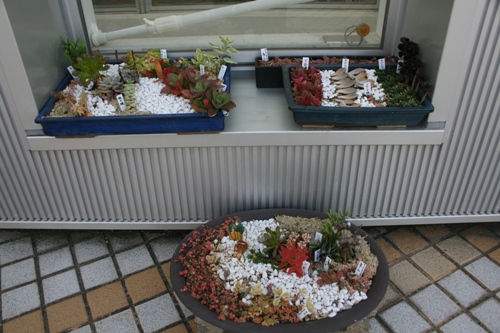 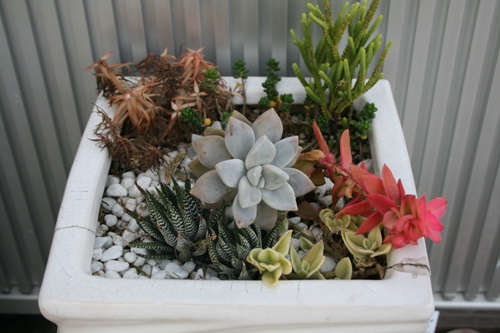 Day six was my last day with George as he was back at work the following day. Jack left us in the morning for his onward trips. We decided to head to the centre of Osaka to eat and continue on after that to Kobe. One of George's friends has a car so we drove alongside Osaka bay northwards and into the centre. I was amazed at the heavy industry so close to the city, infact very much part of the city. 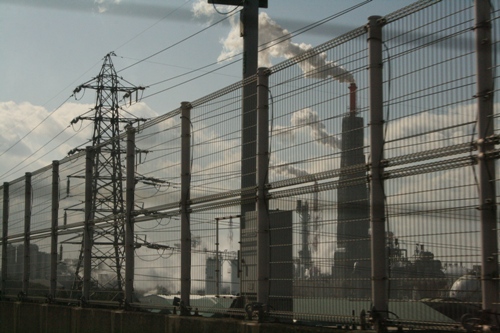 The roads are wide and very good, with many of them being sweeping fly-overs. 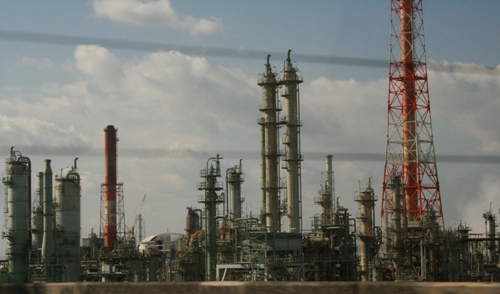 Industry all along the bay. I found the following on-line 'One of the main features of Osaka's industry is the fact that it is known as the City for Small and Medium-Sized Companies. Approximately 65% of the small to medium-sized companies involved in industrial manufacturing in Japan are located in Osaka, and many of these claim a large share of the world's markets with their home-grown technology.' We drove to the centre of Osaka, to an area called Shinsekai; Shinsekai, 'New World' in English, is an old neighbourhood next to south Osaka City's downtown 'Minami' area. The neighbourhood was created in 1912 with New York as a model for its southern half and Paris for its northern half. At this location, a Luna Park amusement park operated from 1912 until it closed in 1923. As a result of minimal redevelopment after World War II, the area has become one of Japan's poorest. Despite its negative image and commonly-held reputation as Osaka's most dangerous area, Shinsekai boasts a colourful history and unique identity. At the beginning of the 20th century the neighbourhood flourished as a local tourist attraction showcasing the city's modern image. The centrepiece of the neighbourhood was Tsutenkaku Tower (the tower reaching to heaven). Before we climed the Tsutenkaku Tower we visited a particular restaurant beneath the tower to eat a particular favourite local dish, Kushikatsu, plates of battered deep-fried meat, fish and veg on wooden skewers which you dip ONCE ONLY (important rule) into a sweet soy sauce dip. 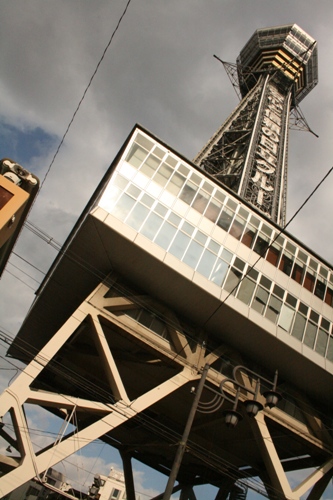 Waiting for a space beneath the Tsuntenkaku Tower for a place in the very busy Kushikatsu restaurant. 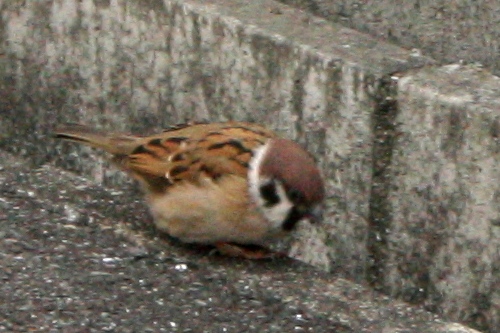 A little tree sparrow in the car park in Shinsekai. 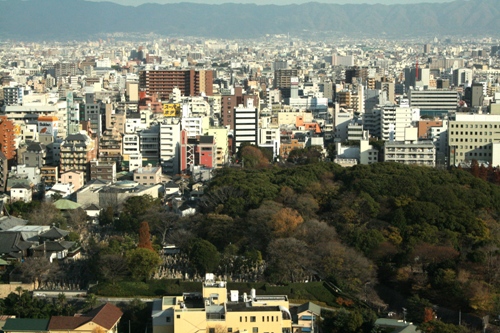 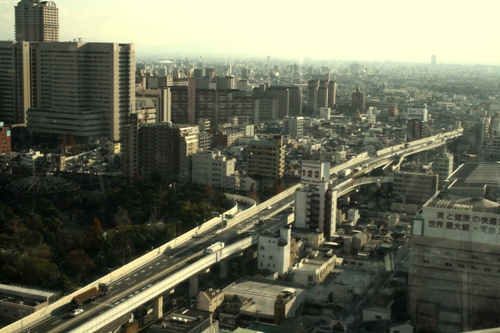 Views of Osaka from the top of the Tsutenkaku Tower. 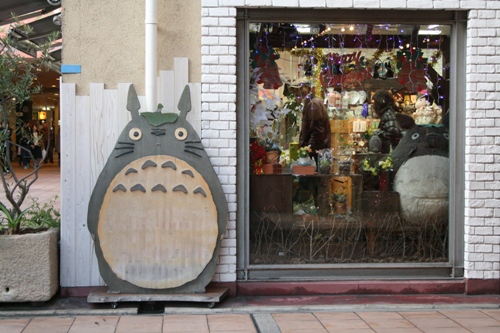 Anime shop in Kobe; 'My Neighbor Totoro' is a 1988 Japanese animated fantasy film written and directed by Hayao Miyazaki and produced by Studio Ghibli. The film follows the two young daughters of a professor and their interactions with friendly wood spirits in postwar rural Japan. The film won the Animage Anime Grand Prix prize and the Mainichi Film Award for Best Film in 1988. That, and other films from Studio Ghibli are still massive favourites of my (now grown up) children, which is how I know about them and have seen them. 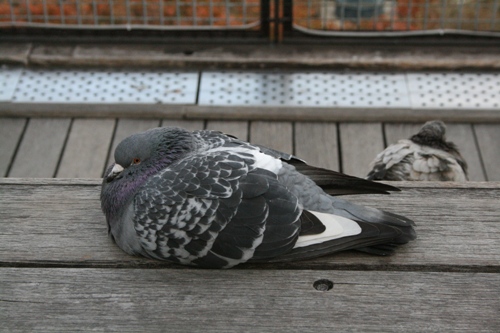 Sleepy pigeons on the Kobe wharf. |
Wed, 28 Dec 2011 Kobe: Day 6. 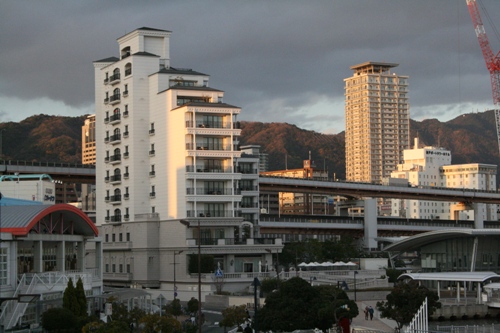 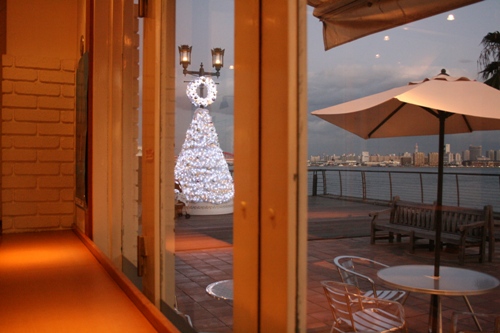 Kobe, cafe. 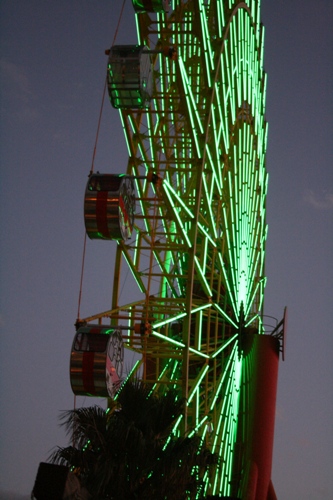 Kobe, dusk. 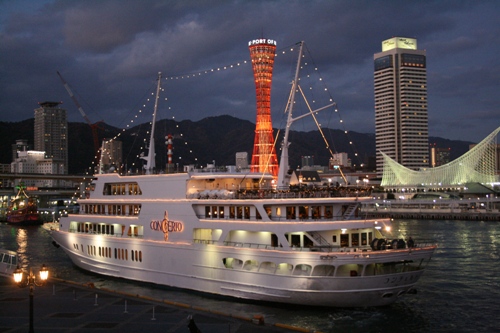 I had a desire to visit Kobe; All I knew of it were photographs I'd seen of the 1995 earthquake which had made a big impression on me at the time.  So I was quite unprepared for the fashionable, contemporary, cosmopolitan city we came to via wide modern roads. It seems that most of the damage (and deaths) were caused by the collapse of pre-1981 wooden-framed clay-tiled-roofed buildings. Buildings put up since 1981 conform to strict anti-seismic regulations. For many families who lost homes (300,000 were made homeless) it was a tragedy because their houses were uninsured due to the difficulties of insuring in such an earthquake prone zone.  What I found at Kobe was a beautiful cosmopolitan city with exciting buildings and a very nice feel to it. 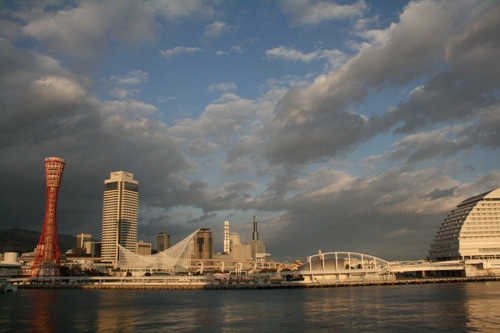 Kobe, now. 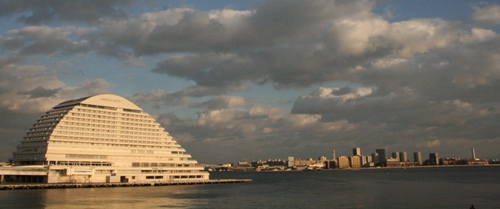 |
Mon, 26 Dec 2011 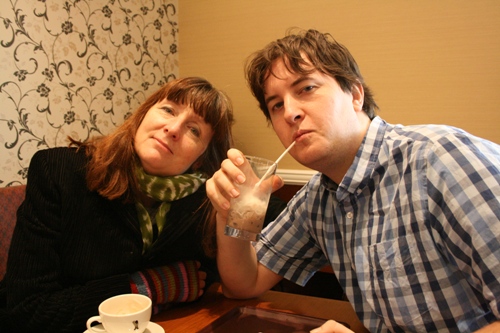 Start the day in The London Cafe!! 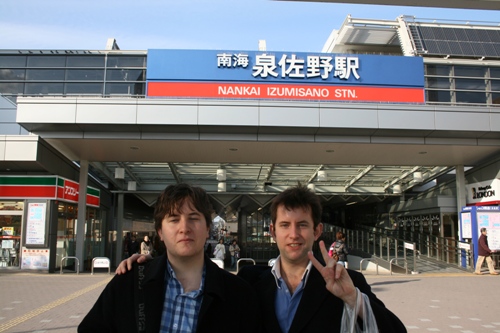 The station at Izumisano from where we caught the bus to Mt. Inunaki. 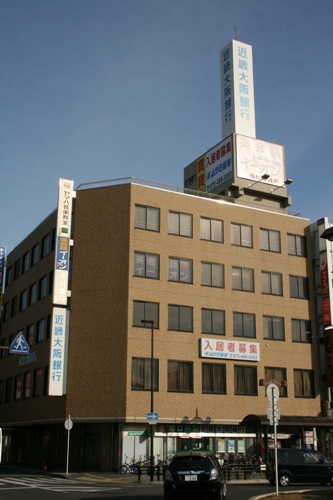 George's place of work as seen from the bus stop.  On the bus to Mt. Inunaki. Day 5 was Jack's last day with us and George's first day off work since I'd arrived. We took the bus from the middle of Izumisano, outside the subway station, to the end of the line and a mountain called Mt. Inunaki, dedicated to a shinto/buddhist religion called Shugendo.  A village from the bus. 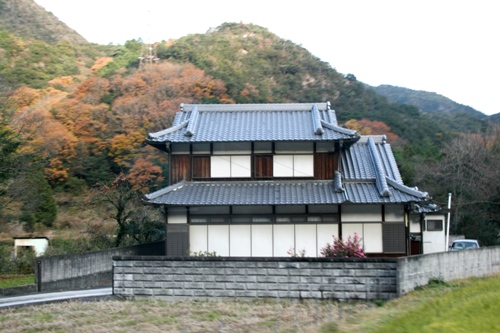 Typical house as seen from bus. At the top of Mt. Inunaki is the main Shugendo temple and training school.   This the Deity we found at the main shrine on Mt. Inunaki. I think I have worked out who he is -as follows; As Fudō myōō, Ācala is considered one of the Thirteen Buddhas in Japan. Fudō myōō, meaning 'Immovable Wisdom King', is the patron deity of the Yamabushi. He usually holds a sword and a lariat, is clad in rags, has one fang pointing up and another pointing down, and a braid on one side of his head. His statues are generally placed near waterfalls and deep in the mountains and in caves. Fudo-Myo-o is the destroyer of delusion and the protector of Buddhism. His immovability refers to his ability to remain unmoved by carnal temptations. Despite his fearsome appearance, his role is to aid all beings by showing them the teachings of the Buddha, leading them into self-control.He is seen as a protector and aide in attaining goals. Shingon Buddhist temples dedicated to Ācala perform a periodic fire ritual in devotion to him. 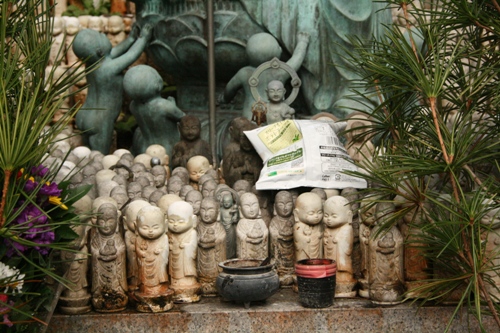 A bag of green tea serves as an offering on one of the shrines. 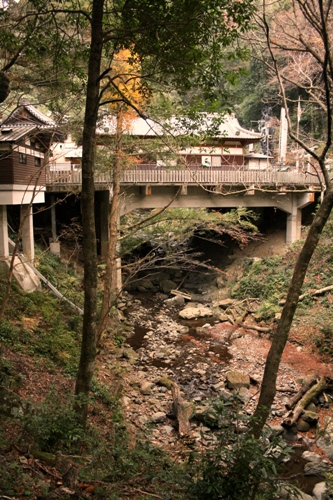 A view of the final Temple as we approached it, the furthest we are allowed to go up the mountain. Mt. Inunaki is known as the location of a hot spring resort, as well as Shippo-ryuji Temple, headquarters of the Inunaki school of Shugendo, which is one of the oldest Shugendo temples founded by En-no-gyoja about 1,300 years ago. In the precincts of the temple 28 pilgrim spots are recognized; some are at main Shugendo training halls, some are near waterfalls, some at rocks, some at smaller Shugendo halls and others at small shrines, so that many visitors can experience making a pilgrimage. Mt. Inunaki is famous as a Shugendo training place where women are allowed to participate in Shugendo training although they are forbidden to enter Mt. Omine, another famous Shugendo training spot. The name 'Inunaki' (dog barking) comes from the legend that when a hunter was about to be attacked by a giant snail in the mountains in the era of Emperor Uda (887 to 897), his dog barked furiously and sacrificed himself to save his master’s life. On the way to Shippo-ryuji Temple, you can see tombs of fine and faithful dogs. The hot spring resort located along a stream at the foot of Mt. Inunaki has an atmosphere of a quiet mountain village, with various seasonal attractions, including mountain cherry blossoms in spring, fireflies and kajika frogs in summer, colourful autumn leaves and snow in winter. . 'Kajika' means 'river deer' in Japanese; croaking kajika frogs sound like deer calling. 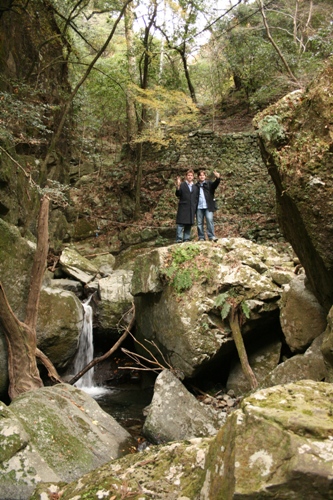 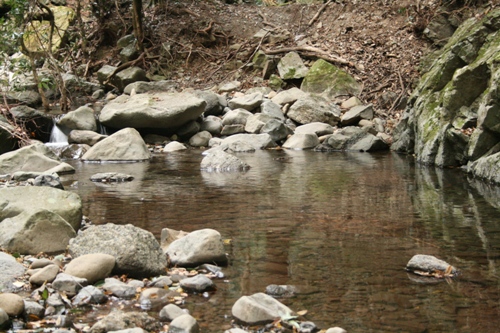 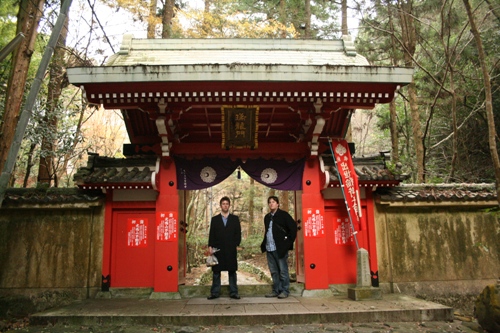 One of the Shrine Gates along the trail. 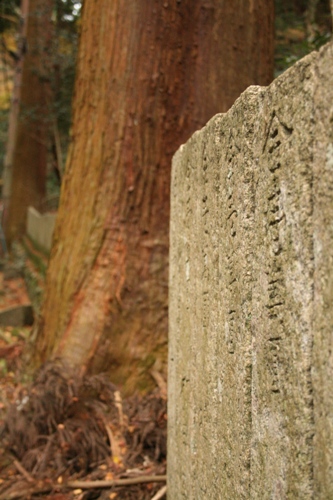 Some of the carved granite memorials along the trail. Heading down Mt. Inunaki. 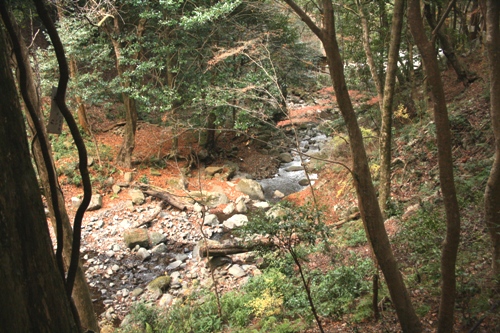 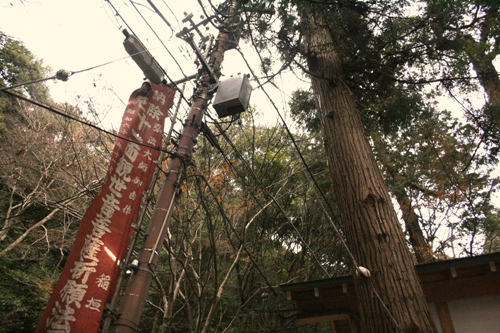 We stopped at a vending machine for a can of HOT coffee! 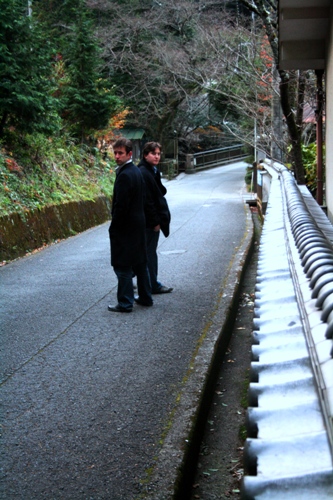 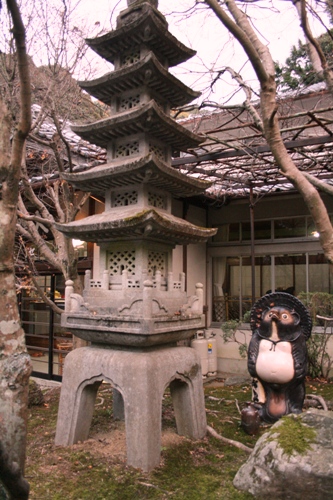 The Shrine at the bottom of Mt. Inunaki. |
Sat, 24 Dec 2011 Day 4; Kyoto and Temples. 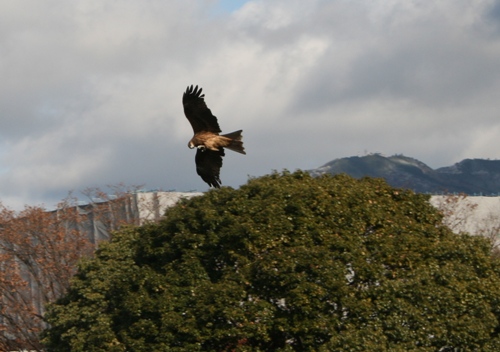 Black Kite with fish.  Walls to the Emperor's Palace. 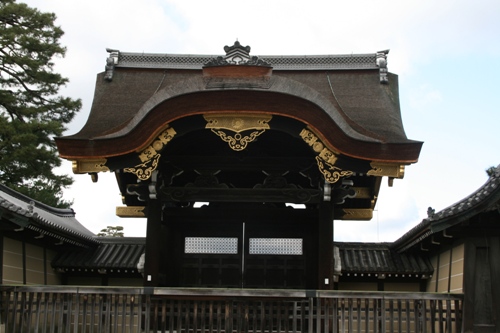 One of the Palace gates to the Emperor's Palace. 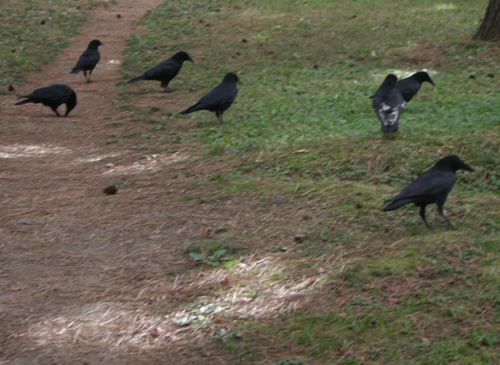 Thick Billed Crows in the Emperor's Palace garden 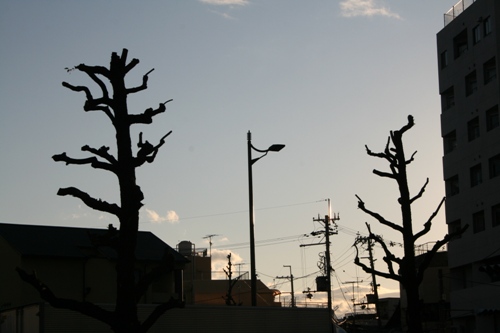 Kyoto dusk. 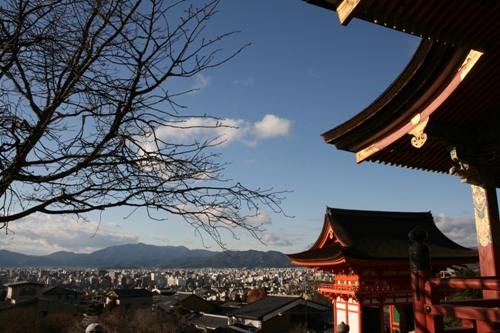 Looking back on Kyoto. 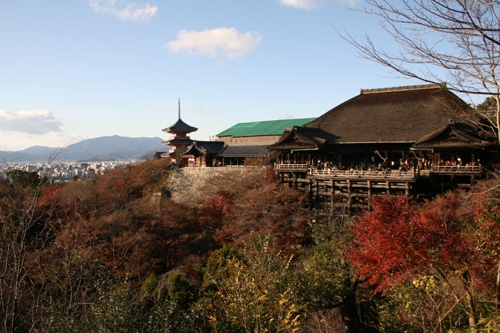 Kiyomizu-dera Temple built on a huge wooden platform. 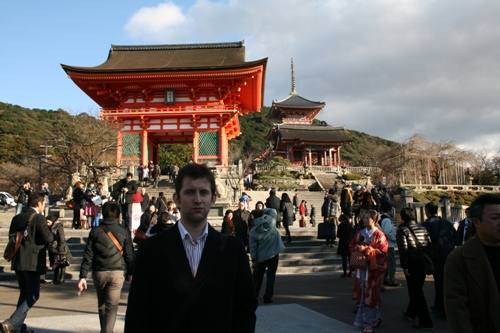 The Japanese visit the Temples on their days off. Day four in Japan; Jack and I took a combination of trains and subways to Kyoto of the Climate Change Forum. Jack had a bus-map of Kyoto all in Japanese but because he knows the characters (through Chinese) he had really good fun unravelling the bus routes and it was amazingly enjoyable criss-crossing the city by bus. The first place we headed to was the very famous Golden Pavilion or 'Kinkaju-ji' in Japanese. Kinkaju-ji is a Zen Buddhist temple which dates back to 1397 when a villa was bought by Shogun Ashikaga Yoshimitsu and transformed into the first complex. His son changed it to a Zen Temple on the death of his father. Below is a photo of the temple as it was in 1885. More recently the Pavilion has been done up with about £5,000,000 worth of gold leaf.  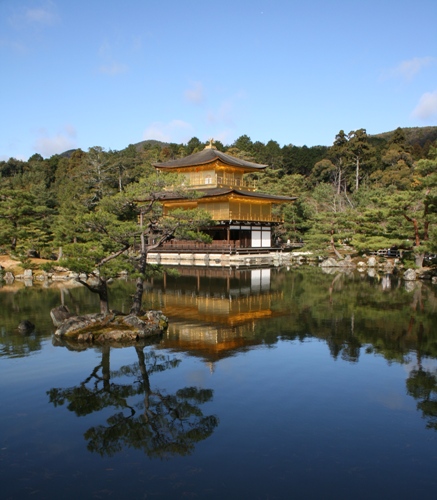 The Temple is set in a Japanese strolling garden. The pavilion extends out over a carp-filled pond which perfectly reflects it from all angles and positions in the garden. 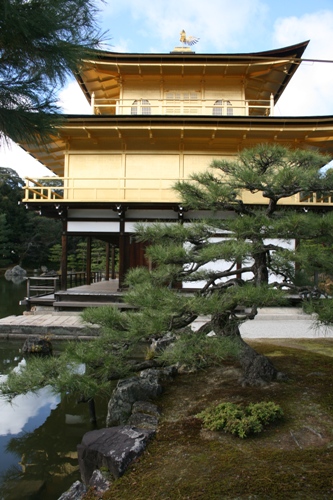 In the middle of the pond is an island in the shape of Japan -this was to allow the Shogun to look out over the pond and feel he was in control of the whole of Japan. 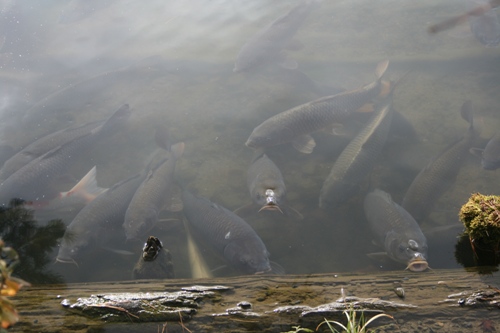 A small fishing deck is attached to the bank beside the pavilion and a small boat would have been moored there too. We left Kinkaju-ji and travelled by bus again to the centre of Kyoto where we decided on a whim to get out and see the Emperor's palace grounds which are open for the public to walk through. The Palace is surrounded by very large walls and that day at least was very well guarded by 100s of police. It's possible something was happening in Kyoto that day because we were not allowed to walk in a certain part of the garden. The gardens were filled with crows, very different from UK crows, Jungle Crows or Thick Billed Crows with a much warmer 'caw' than UK crows! We walked the massively wide driveways through the gardens and again wandered towards the centre of Kyoto and over a river bridge where masses of Black Kites were very successfully fishing. Eventually we found ourselves walking up a tiny wood-building street thronging with people on their day-off. Many, including young people, were in national dress including the wooden sandals which look rather tricky to walk in. At the end of the street we reached the Kiyomizu-dera temple, a temple built on a massive wooden platform and with a wonderful view back across Kyoto. The temple dates back to 798, and its present buildings were constructed in 1633. It was built without the use of a single nail. It is part of the Historic Monuments of Ancient Kyoto (Kyoto, Uji and Otsu Cities) UNESCO World Heritage Site. (See pictures at the beginning of this blog). Kyoto is a lovely wide open city with a mix of old a new buildings. It has it's share of tall, modern shiny buildings but unlike Osaka it doesn't have so many rail and road flyovers and so feels less cramped. In the evening George had a 'Takoyaki' party at his flat; his friends came round with a special Takoyaki griddle and made little round batter dumplings with octopus and ginger in them. |
Fri, 23 Dec 2011 Day 3 in Japan:  Great views of Osaka all round, on the ferris wheel.  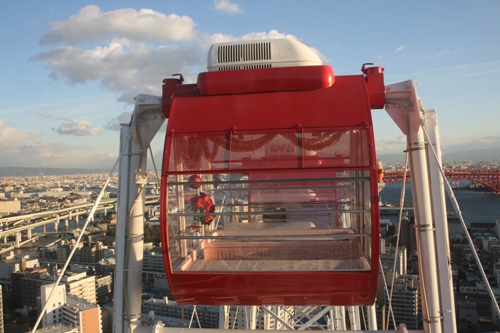  Day three in Japan; poor old George still at work (but I hasten to add that although he works hard he enjoys the work and has great work colleagues), Jack and I went into central Osaka on the subway. Jack had been given instructions to buy something very specific from a large department store, Daimaru (like Harrods) in an area called Shinsaibashi. Shinsaibashi seems to be a long covered shopping street, full of all sorts including, what my daughter loves so much, the Bo-Peep Gothic dress shops with more frills and ruffles than a Victorian wedding dress. 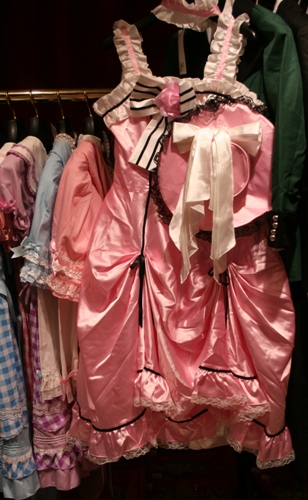 We found the Daimaru shop and went looking for 'Umeboshi' without having any idea what it is except that we needed to look in the food hall. Umeboshi turned out to be pickled plums, a popular delicacy in Japan. Osaka is a mix of old and new, but always the lovely Japanese thing of wires everywhere...my students would understand -they make a wonderful foreground reference. 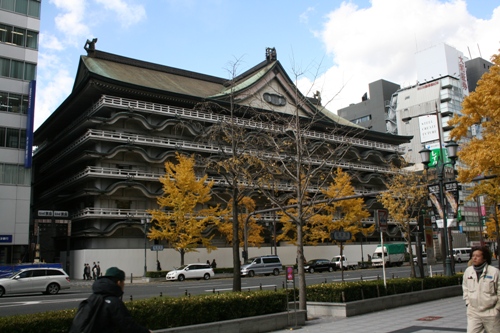  The trains are wonderful, I've heard it said and now I can confirm that they are never late...not even a minute. Apparently, if they are three minutes or more late the people on the platform are given a little tag saying so -to give to their employer in the case of arriving late to work! The only difficulty at the station is in reading the Japanese...  Jack and I went on to an Island in Osaka Bay where the aquarium is, but also what is claimed to be the biggest ferris wheel in the world. (See pictures posted above this blog). It was fairly hair-raising going up over the top on this thing! Also above -I loved the heads these wigs were on...probably wouldn't prompt me to buy one though! |
Tue, 20 Dec 2011 I'd intended to blog as I went along but, unsurprisingly, its been hectic so I'm catching up bit by bit. On day 2 Jack and I travelled, with a friend of George's, via subway and railway to a town called Nara. Nara has been declared a world heritage site because of the eight temples, shrines and ruins there which collectively form 'The Historic Monuments of Ancient Nara'. 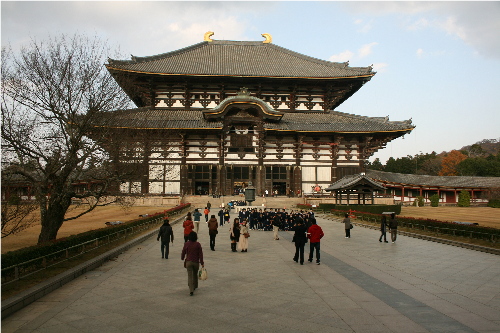 This is the Todai-ji temple which houses an enormous Buddha; Wikipedia claims that the building itself is the largest wooden building in the world...it seems to me it could be! 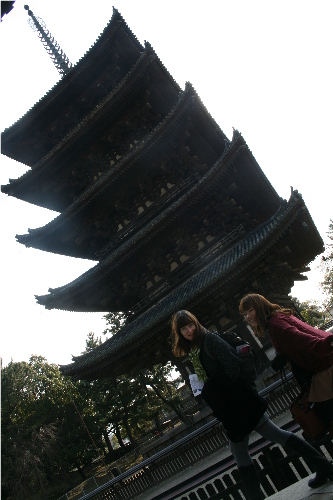 This tower is part of the Kofuku-ji temple, built by Kagami-no-Okimi (originally in 669 -rebuilt later) in the hopes of saving his sick wife - I don't know whether it worked or not! Nara is well known for it's herds of deer. According to the legendary history of Kasuga Shrine, a mythological god Takemikazuchi arrived in Nara on a white deer to guard the newly built capital of Heijō-kyō. Since then the deer are seen as heavenly animals, protecting the city and the country. Tame deer roam through the town, especially in Nara Park. Snack vendors sell "shika sembei" (deer biscuits) to visitors so they can enjoy feeding the deer. Some of the deer have learned to bow in response to tourists' bows. They nudge, jostle, and even bite for food, they did all three to us! 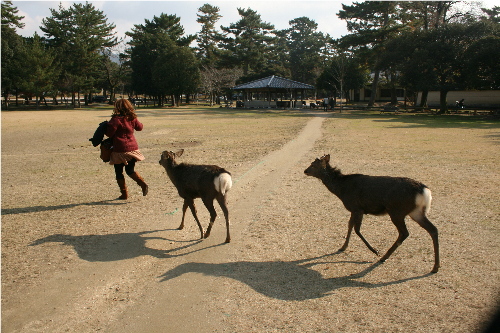 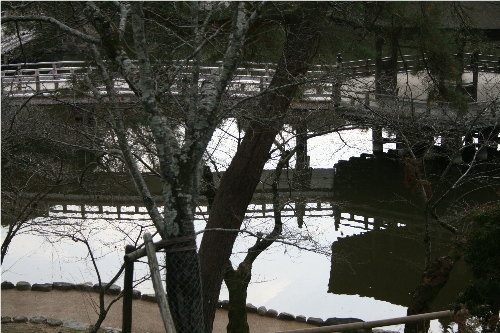 Nara's parks are lovely - we sat in this place relaxing and listening to the Japanese crows talking differently to English crows -a rounder less 'caw-ing' sound. They are longer birds with bigger beaks -more raven-like, than our crows. And they hang around in large flocks unlike our crows but more like our rooks! |
Sun, 18 Dec 2011     I got to Japan four days ago on a long and gruelling flight via Paris. It took a fair time to get over Moscow, then on across Russia to the Urals. Once we got over the mountsins I saw on my in-flight map an area called the Western Siberian Lowlands which looked rather tame and comfortable on the map but in reality was the bleakest, most frozen, inhospitable vast empty open space I've ever seen and it took about four hours before we'd crossed it, passed over Lake Baikal and down into Mongolia which, too, looked bleak and inhospitable. I wondered if, apart from the poles, these might be some of the most inhospitable places on the planet? Once in Japan, I discovered my luggage was still in Paris but it wasn't so bad; George lives just two stops from the aiport and we retrieved it easily the next day. The Japanese are so helpful, quiet and respectful it was all dealt with in an apologetic and friendy way. George's apartment is ..small but perfectly formed.. An odd space-saver is a built in sink on the loo cistern; as you wash your hands, the used water fills the cistern for the next flush.  As Jack is here too I'm sorry for George that we've rather camped out in his small flat; he'd got us these lovely futon sets, I'm so taken with them I'm tempted to take one home!  George's bedroom, called a 'loft' again makes good use of space and is accessed by a ladder.  Once I'd arrived, George had to go to work and Jack was off for the day in Kyoto so I amused myself catching up on George's laundry, wandering around and getting a feel for the area and feeling amazed at being both 'out' of place and 'in' place. What delighted me about this area where George lives, Izumisano on the edges of Osaka, was the mix of old, new, smart, scruffy, urban and rural all in one human-scale block. In this small town I saw rice paddies, cabbage fields, small factories, train fly-overs, small and large apartment blocks, small houses, big houses...and the beginnings of a collection of wonderful drain-covers, all designed for their own areas! (Some of those pics at the top of this blog). 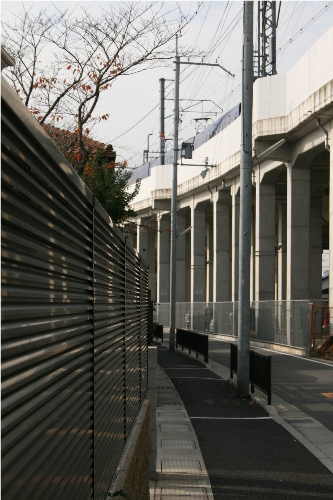 |
Sun, 11 Dec 2011 I'm off to Japan for a whistle-stop visit to one of my sons who lives and works there as an English teacher. My other son is on his way there as I write. In the old days I travelled whenever and wherever I could, but nowadays I'm an anxious traveller. I look around the garden and wonder how I can leave it. Yesterday was a bumper day for small birds in the garden, the oddest by far were the two tree-creepers running up the apple tree from bottom to top; they sort of slithered up the tree, stopping, I guess, to peck insects out of the bark. At first I thought they were weasels, they looked much more mammalian or rodent-like but once they got to the top of the tree and flew off it was clear they were birds...and 'tree-creeper' is the perfect description. The best view were the goldfinches, inches from my eyes, with their lovely red flashes behind their beaks -a treat! 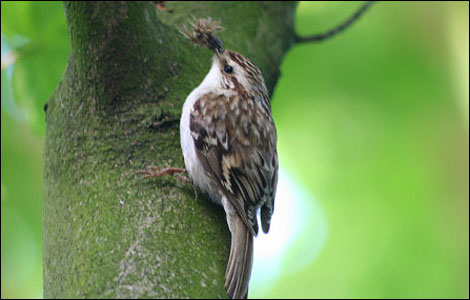  |
Wed, 07 Dec 2011 For my birthday I was given a DVD of 'Sleep Furiously', a film by Gideon Koppel about the Welsh hill village where he grew up. It is just about a perfect film! 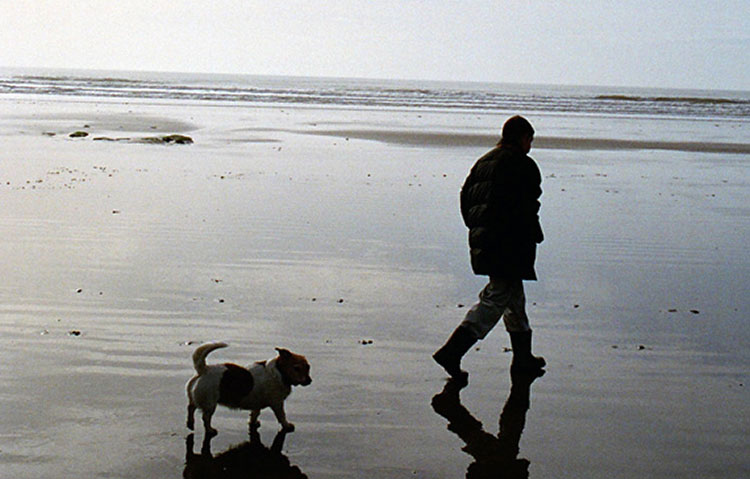 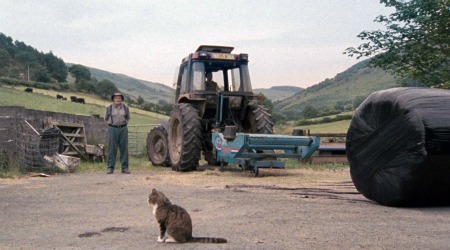 I found the following in wikipedia: "Colorless green ideas sleep furiously" is a sentence composed by Noam Chomsky in his 1957 Syntactic Structures as an example of a sentence that is grammatically correct (logical form) but semantically nonsensical. The term was originally used in his 1955 thesis "Logical Structures of Linguistic Theory". Although the sentence is grammatically correct, no understandable meaning can be derived from it, and thus it demonstrates the distinction between syntax and semantics. As an example of a category mistake, it was used to show inadequacy of the then-popular probabilistic models of grammar, and the need for more structured models. 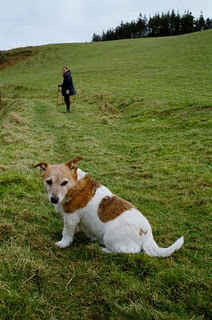 I now need to take time to work out how the title relates to the film, bearing in mind where it probably came from. |
Sat, 03 Dec 2011 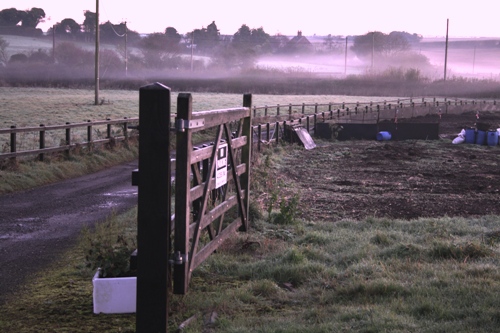 Apropos of my last blog, I found this on today's BBC news website: UK police recorded at least 2,823 so-called honour attacks last year, figures from 39 out of 52 forces show. A freedom of information request by the Iranian and Kurdish Women's Rights Organisation (Ikwro) revealed that nearly 500 of these were in London. Among the 12 forces also able to provide figures from 2009, there was an overall 47% rise in such incidents. Honour attacks are punishments on people, usually women, for acts deemed to have brought shame on their family. 'Mutilations' Such attacks can include acid attacks, abduction, mutilations, beatings and in some cases, murder. Ikwro said its research, carried out between July and November, is the best national estimate so far of the extent of honour violence in Britain, although the charity says the figures do not give the full picture. 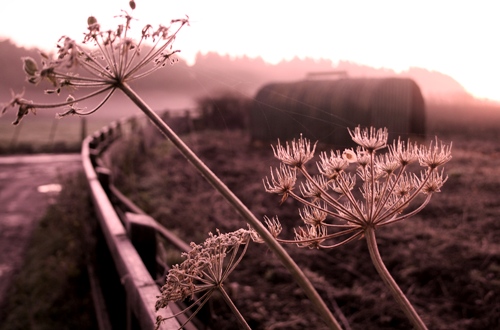 So I'm contrasting the news with some pictures of what was a lovely morning yesterday. 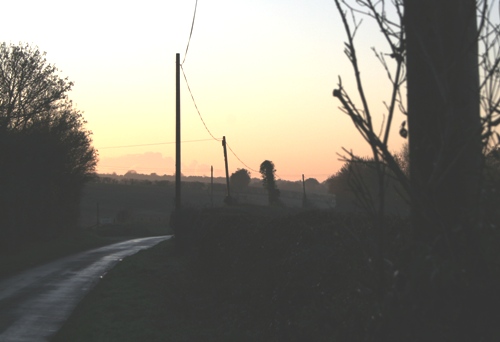 It was the first morning we've had a true frost, at -0.5 deg. when I went out at 8am. 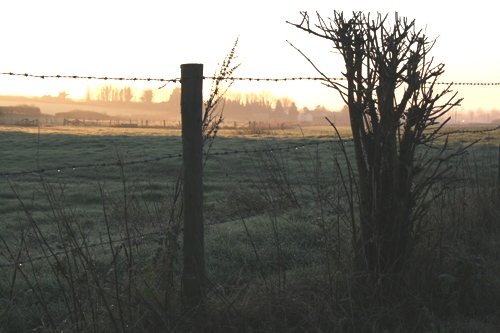 Last night rained a lot and so this morning is well above freezing...and I gather no snow this year in either Scotland or at The Alps -not good for ski-ing! |
Wed, 30 Nov 2011 This recent piece of news was extraordinarily shocking and disappointing: "A group of armed men have stoned a woman and her daughter to death in Afghanistan\'s Ghazni province, security officials have told the BBC. Officials blamed the Taliban for the attack and said they had accused the widow and her daughter of "moral deviation and adultery". The incident happened on Thursday in the Khawaja Hakim area of Ghazni city, where the family lived. The police said two men had been arrested in connection with the murder. Security officials said armed men entered the house where the young widow lived with her daughter, took them out, and stoned them to death. "Neighbours did not help or inform the authorities on time," an official said. Taliban grip Officials said a number of religious leaders in the city had been issuing fatwas (Islamic religious edicts) asking people to report any one who was "involved in adultery". In October last year, a woman accused of murdering her mother-in-law was killed by Taliban in Ghazni. Ghazni has seen an upsurge in violence in recent years. Strategically located on the route between Kabul and Kandahar, the province was once a centre of trade. The BBC's Bilal Sarwary in Kabul says Taliban insurgents now control large parts of the province - and only seven of the 18 districts are in control of the Afghan government. The Taliban have banned celebrations by men and women in wedding halls in the provincial capital - men can celebrate but without playing music and women have been asked to celebrate in their homes. Several radio stations in the provincial capital broadcast Taliban songs." 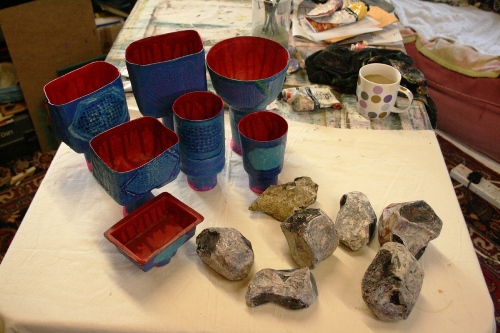 In true Blue Peter style I got out my papier mache and made 'Rocks and Vessels' |
Tue, 29 Nov 2011 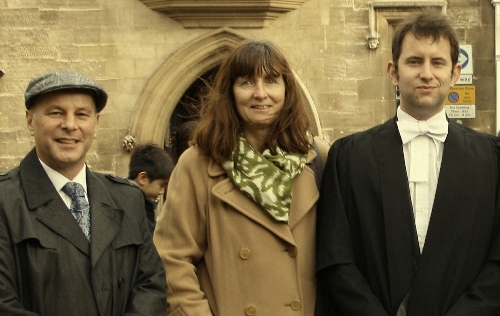 Last Saturday - before the ceremony. Teaching and teachers in the news again -putting so many hard working families in a spot tomorrow by going on strike. Isn't the point of a strike to make oneself heard? Ahhh well. My feeling is that too many parents are letting their children down -if they don't read to them, or don't talk with them, or if they put them in front of the telly or a DVD too readily. Too many children come to school unable to sit down, listen, concentrate or think actively (by which I mean have a well honed inquisitiveness). Too many children have a passive comprehension, they rarely ever think beyond a moment because everything has come to them without them experiencing the work-acquisition balance. If a bird flies up into the air, it has had to find enough to eat to be able to 'fund' that flight. If a child is given a smart phone with games as a Christmas present, he/she has no idea of the work that went into the making of the phone, and often no idea of the running costs either. I come to Art - it's one of those subjects which requires an active inquisitive outlook; it is filled with the necessity to make decisions and act on them, to make judgements about those decisions, to think about the nature of communication, to be resourceful, to be thinking about every aspect of humanity. But education today is more about following a Govt. curriculum which sees each child as an empty pot to be filled up with 'knowledge', and that 'knowledge' must be measurable so that the Govt. can be sure that it can measure the 'learning' that is happening. Govt. designed education confirms what parents have done -treats children as passive receptors. This idea is built upon by reducing the importance of arts subjects to the point where music is almost unavailable unless parents can afford extra-curricular lessons. I suspect P.E. teachers feel much the same about their subject as I do about art. Okay - my next rant is about schools as perceived by Govt. Our Dear Govt. think that schools and teachers are lazy hap-hazard things (with too many gold-plated pensions sucked off the state) unless they are teaching in the way those Govt. ministers received their own education. Almost without exception those Govt. ministers came from families from which they felt an 100% commitment bestowed upon them by their parents, and enough creativity within the family to nurture the inquisitive child. For so many of the children whose parents are unable/unwilling to mentally nourish their children, school is the first place where these children encounter a valid moral code, a requirement to behave within a set of rules which takes other people into account, a requirement to be responsible for themselves (on which point so many fail) and a place to feed their souls and minds, that final point a point which too many children misunderstand and their parents fail to understand too. If only all parents thought that their children's minds were gardens to be tended carefully and lovingly, and brought to a wonderful fruition. I despair at the waste of brain power in this country. The proportion of brainy-ness must be the same among every strata of society, among every group of the population, so why are we so much more able to tap into it from some groups than others? I leave you to answer that -meanwhile, my husband will be on strike in support of the teaching profession as a whole which is in dire need of some creative thinking from the top OR even better, some BIG BIG BIG listening by the top strata (Govt. in particular) of the teachers on the coal-face. (A pipe-dream I think). Oh...and ofsted are as useful as butter in hell. They get it wrong -almost without exception. It would be more helpful if senior leadership teams were less interested in statistics-gathering for a 'proof' hungry Govt./ofsted, and more concerned with having the TEACHING of children at the forefront of ALL decision-making in the school. |
Mon, 28 Nov 2011 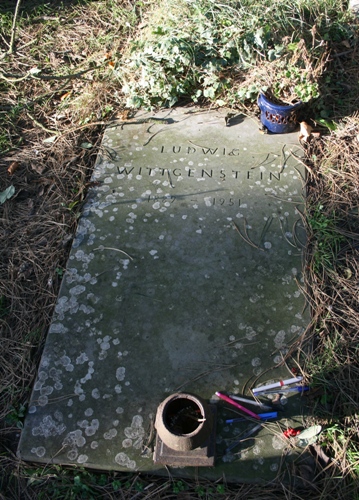 Burial place of Ludwig Wittgenstein. 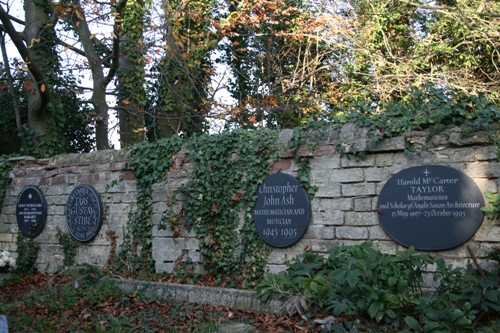 Our son handed in a PhD recently and on Saturday we went to see him graduate -lovely day, good party, lots of latin, funny hats, bowing and curtseying. On Sunday we went to a local graveyard where it is said that more I.Q. is contained in one small area than anywhere else in the world -The Ascension Parish Burial Ground, formerly St Giles and St Peter\'s Parish Cambridge. It was clear very quickly that a really good stonemason lives and works nearby; sure enough I looked on wikipedia and found that a small chapel was also built on the grounds, and currently acts as the workshop of local lettering artist Eric Marland. 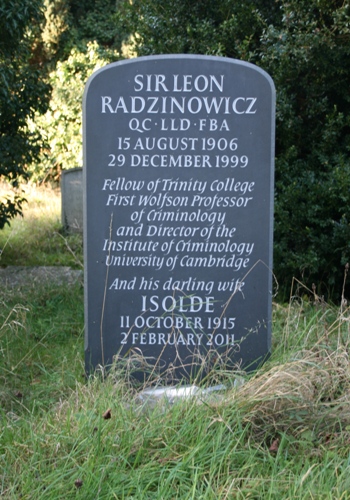 It was a cold sunny end of November day, difficult to imagine that we\'d had so much snow this time last year. 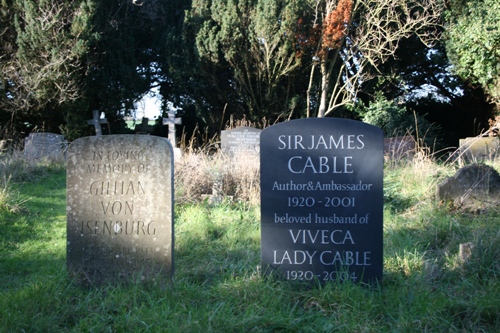 The graveyard had some wonderful overgrown areas, brilliant for wildlife -it was good to see that nothing had been tidied up too much. 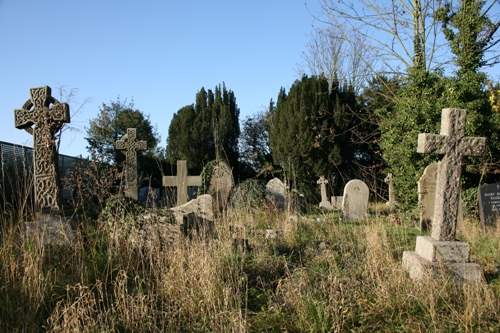 A couple of my favourite names were \'Ada Broom\' and this very aptly named philosopher... 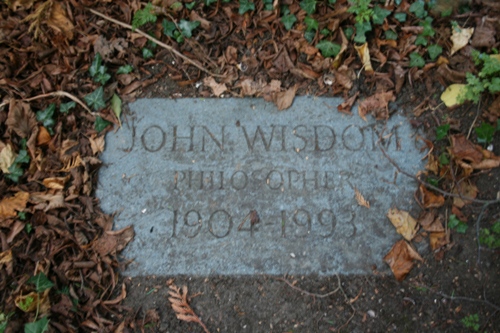 |
Fri, 25 Nov 2011 A collection of Dorset artists have got together to form a new group called The New Dorset Art Group. The area that many of our group live in and from which we constantly draw inspiration is the part of Dorset known as The Cranborne Chase. Many artists live (and have lived) and work on the Cranborne Chase, two of the more notable ones -Paul Nash and Graham Sutherland; and these artists have helped to place Cranborne Chase in the history of British Art and continue to do so today along with those who work there now. Cranborne Chase is rich in shape, form, texture, colour and compositional structure it's hard not to exalt in its sculptural qualities or to be beguiled by the intricate lace-work of ancient tracks and paths which cross its boundaries. Collected in one place on Cranborne Chase, alongside the Roman road known as The Ackling Dyke, is the single biggest varied collection of Iron Age burial mounds in any one place in the UK. Thomas Hardy based many of the places in his books on places within The Cranborne Chase; he described it as ‘a truly venerable tract of forest land, one of the few remaining woodlands in England of undoubted primeval date, wherein Druidical mistletoe was still found on aged oaks, and where enormous yew-trees, not planted by the hand of man, grew as they had grown when they were pollarded for bows’. We are The New Dorset Art Group - Visit our website at www.newdorsetartgroup.co.uk or look for us on facebook. 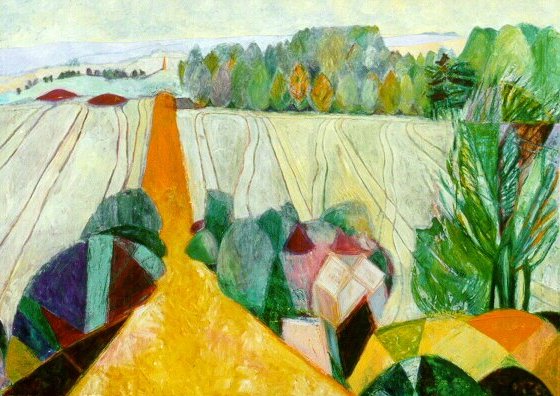 The Ackling Dyke at Handley Cross |
Wed, 23 Nov 2011 In December I'm going to Japan to see my son who lives in Osaka. So, for my birthday recently my daughter made me the definitive 'Osaka Travel Guide'.  My other son is joining us, luckily getting there before me and meeting me from the airport. He will no doubt love a trip to Osaka Castle. As a small boy he was obsessed with castles, knights, battles, armour etc. 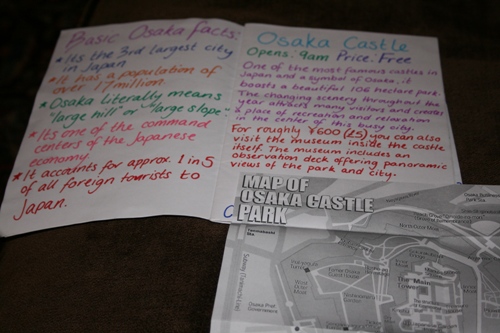 My daughter, however is keen that I take a day trip to Tokyo to visit the 'Baby, The Stars Shine Bright' clothing store specialising in baby-doll gothic style dresses... 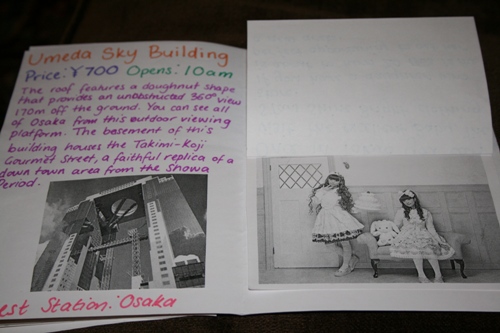 ...to bring one back as a present... but I prefer the thought of a visit to the aquarium, 11,000 tons of water filled with fish, invertebrates, batrachians (tail-less amphibians), reptiles and apparently birds and mammals too! 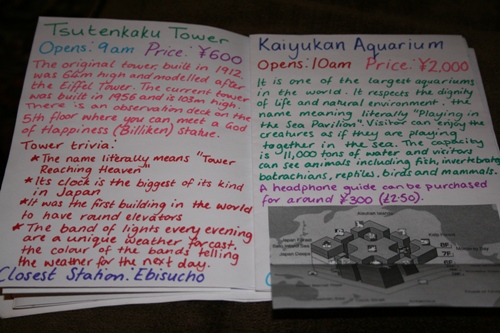 And finally (see below) at the end of my travel guide are some handy phrases such as 'Where's the toilet' and 'This person will pay for everything'...a phrase I intent to use often!  My blog page has been inaccessible for a while...glad to have it back!! I'll be blogging again here soon...yippeee!! |
Tue, 15 Nov 2011 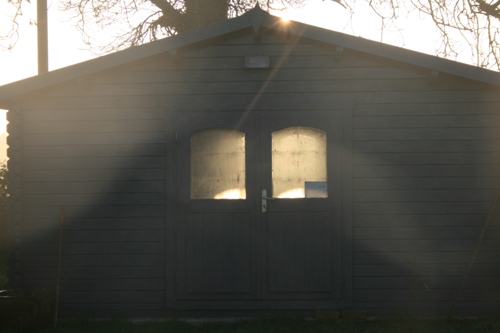 Sunrise through my shed this morning. |
Sun, 13 Nov 2011 We gave the house a haircut today; every climbing creeping, clinging plant was cut away from the walls except for a small tangle of Clematis Montana around the porch where Colin and her chattering friends gather. We cut SO MUCH away from the gutters and barge-boards with great care not to cut the telephone wire which is exactly the same colour and width as the Clematis stems -of course the Clematis stems camouflaged wonderfully the telephone wire which, in the past, Simon cut and we were off-line for four days. It's my job now. We grabbed up the cuttings and made a bonfire which we set in a crumbling old guinea-pig hutch -a beautiful, warm, blue-skied November day, we gardened all day and our bonfire burned until long after dark. 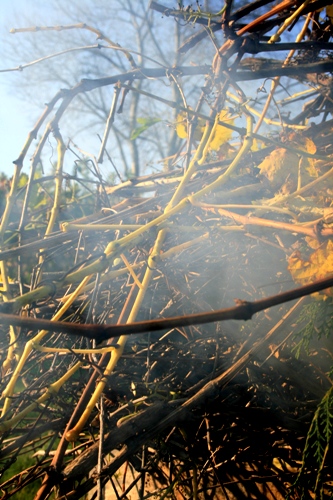 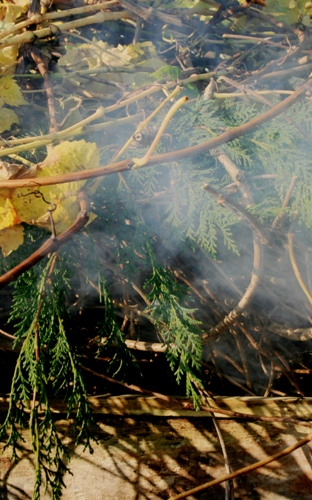 Watching the smoke glide out of the belly of the fire when it's just lit is lovely. The heat swishes it up and then it is swept away in the direction of the wind describing fullness of the air. |
Fri, 11 Nov 2011 An amazing moon rose in the north-eastern sky last night. 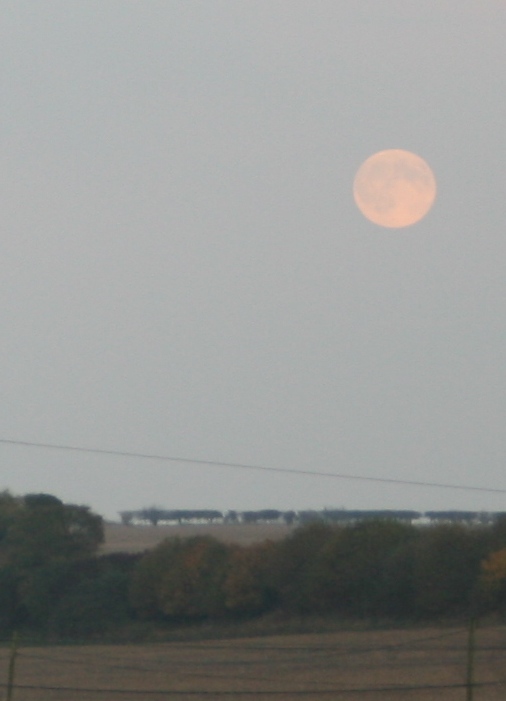 |
Mon, 07 Nov 2011 PUNISH PUNISH PUNISH Theresa May is shrieking at the immigration officers and border staff for relaxing entry checks on non-European immigration.. Does anyone believe that SHE DIDN'T tell her border staff to relax entry checks for non-Europeans? Does anyone believe she DIDN'T know what was happening on the front line? I've heard two immigration officers interviewed on the radio. Both of them said that the reason they've relaxed checks on non-European immigrants is because they were told from above to do so and that it is 100% wholly, fully, utterly and completely because the budget to the immigration staff has been cut so much that it is now impossible for them to fulfill their job as Theresa May is now shrieking at them to do. I'm tired of hearing screams for punishment and revenge. I was a bit unhappy to hear that the police are investigating the Taunton Rugby Club for the criminal offence of letting off their fireworks, when they obviously didn't intend to cause such a catastrophe and must be horrified to think that they might have done so. Today I heard that they have been cleared of having needed a licence to let the fireworks off so now the police are going to look into health and safety rules, no doubt to see if there is a way of somebody somehow punishing the Rugby Club for not conforming to rules which no-one seems to know exist. I can see that new health and safety rules might need to be put into place now -to do with letting off fireworks on a still night near a motorway or main road. I feel very sorry for all (and families of) those killed or injured in the crash and very sorry for the Rugby Club people who must be really distressed at the idea that they were instrumental in the deaths. But I am fed up with the adversarial nature of everything these days where nothing can be sorted out without someone in authority screaming PUNISH PUNISH PUNISH. I have the feeling they only shout it because they think its what 'The British People' want. What 'The British People' want is for those at the top to be quietly dignified and to unravel problems in an ordered and thorough way, to believe in and have confidence in people before blaming them in the public arena. It feels very much like Theresa May is too lilly-livered to take responsibility for something for which she is entirely responsible. She's happy to sling the blame. Pah! Yippeeeee!!!! The World at One is back to 3/4 hour slot from the half-hour slot it must have had for the last 8 years. Nick Clarke was the best best best World at One presenter ever; he used to host it when it was last a 3/4 hour slot. He died of cancer in 2006 after having a leg amputated in a struggle to control the cancer. Apparently he wrote a book, a social history of Britain in the second half of the 20th century called 'The Shadow of a Nation: How Celebrity Destroyed Britain'. This ties in with his ability to interview people with dignity whoever they were. For what it's worth, my next favourite news presenter/radio journalist is Ed Stourton, also a dignified interviewer, sadly taken off The World at One after short spell there and replaced on the 'Today Programme' by Justin Webb -quite why the second defeats me. I don't mind Justin Webb, but Ed Stourton is better. |
Sun, 06 Nov 2011 So a week has passed already since we were on Exmoor. It was as lovely as ever; plenty of walking, scrambling and drawing. I tend to draw out and come back to the cabin to paint. 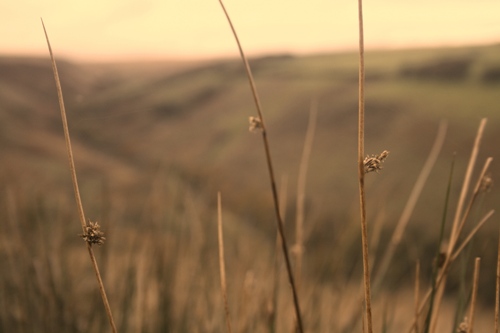 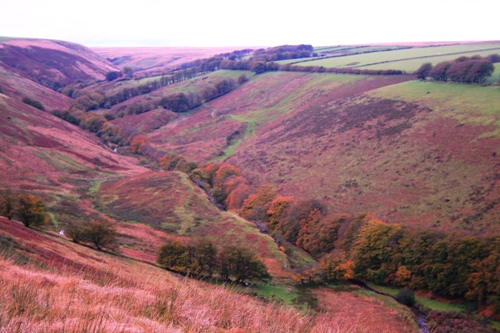 I've been looking over the drawings/paintings I did there and have been working from them in my shed here at home. 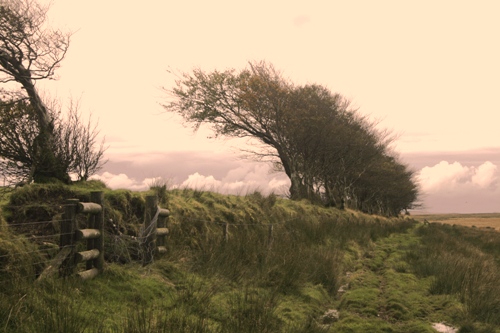 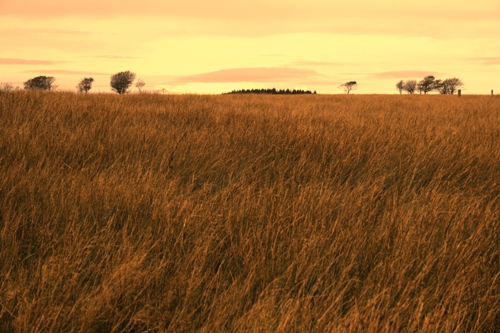 There is something perfectly bleak about Exmoor, about its shapes, colours and textures. I work at arranging and orchestrating the feelings on canvas that I have experienced out on the moors. The feelings are so personal I'm always amazed when they resonate with anyone else. |
Sat, 05 Nov 2011 Here is winter again -I've just thrown open the bedroom window and Orion is fastened to the sky in front of me. I planted alium bulbs today, and winter flowers. I collected apples and still there are hundreds under the apple trees -in fact walking down the garden, especially at night, is like going A over T on a never ending roller-skate. The neighbour's lad has an cider press and he's collected 100s of apples today; he tells me the small red apple is a 'Wagner', an old English desert apple. I took boughs of the red apples into my classes last week and asked for a visceral response to them from my students! Definition of VISCERAL 1: felt in or as if in the internal organs of the body : deep 2: not intellectual : instinctive, unreasoning |
Wed, 02 Nov 2011 It was another lovely week on Exmoor. I spent much of the time, after an encounter on the first day, stalking a stag. I was walking across the farm to one of my favourite haunts, Sparcombe Water, a stream which flows off the moors through a rugged gully and down into the River Exe. I climbed up a bank, an old dry stone wall which has become muddied and grown-over. It surrounds a wood on two sides and I followed the edge of the wood finally clambering down to walk the last bit inside the wood, sauntering and wittering to myself. I became aware of a really powerful smell, an earthy cow-smell, and it struck me that deer might shelter here. Within a second of the thought a stag leapt across my path, sailed over a little river cutting, leapt a wire fence and was off. It was all quick and surprising; I didn’t have my camera out in time but at moments like this I don’t want to waste time scrabbling for a camera. The stag was on the back of my eyeball and he was sumptuous. I followed the direction in which he’d gone, seeing hoof prints which were fresh enough to be his and when I eventually caught up with him I had come to an open gate and could see him at the other end of a large field in the company of just one hind. I hid by the gate under a beech tree and watched for a long time. They were grazing peacefully. 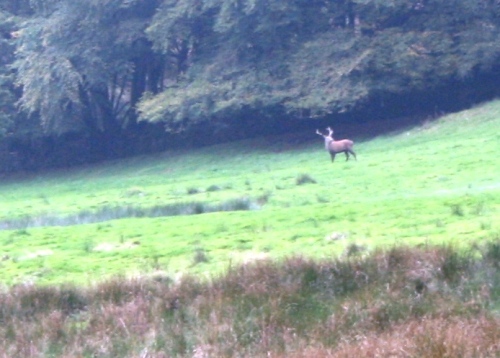 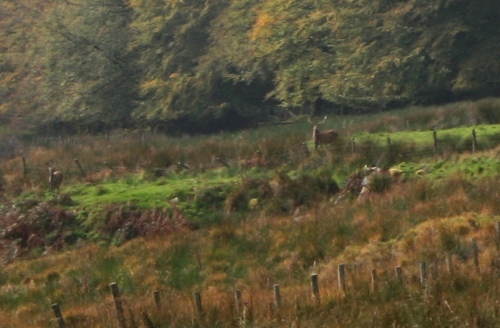 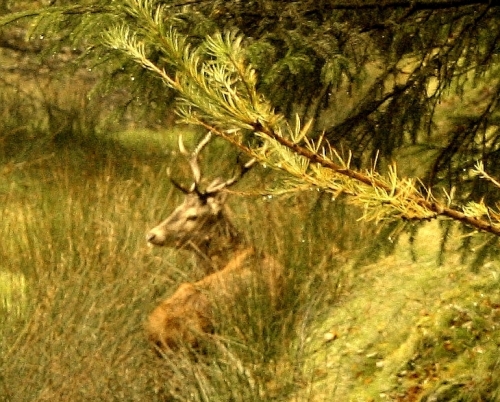 That had been a sunny day. The next day it was pouring with rain; that relentless hour after hour rain however I thought I’d go looking again. I went back to the wood but the other way around –up the Sparcombe Water gully, up the steep field in which I’d seen him the day before and along the bank around the wood in the other direction. It was about 90min walk there and the bits of me not covered by coat or welly were soaked but I was otherwise warm and dry. I couldn’t detect any smell in the same place which made me wonder if I had smelled HIM rather than his shelter. I had got to the furthest point and seen nothing, deciding I’d been very lucky the day before but at the last moment I caught that whiff again! I crept carefully around the edge of the wood, and there, downwind of me and sheltering in a ditch, sitting chomping the grass around him...he was! In that pouring rain, I so-very quietly unzipped my coat and reached for my camera. I got one shot, he looked to his side. I got another shot as he looked around and saw me. Within a flash he was up and lifting gracefully over the wire fence beside him and into the wood. I got the shot but he had already disappeared out of it! 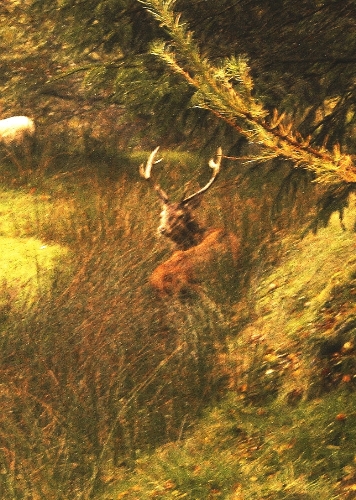 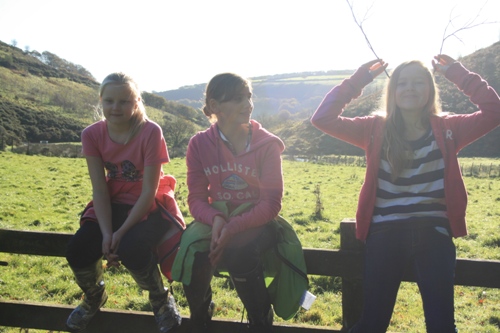 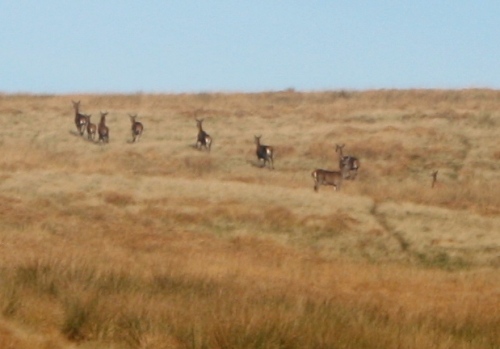 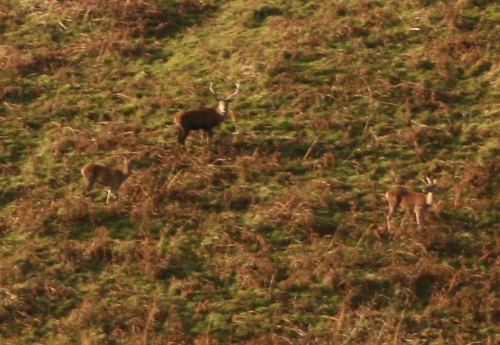 I didn’t go looking again until our last day. My sister’s two children and their friend were keen to find him so we headed up that way. As we approached the wood we discovered very fresh hoof prints in the mud on one of the main exit paths. I told them I was certain he was out but that we’d keep looking. We re-walked the bank, looking out to the moors all the time. The pheasant shoot was in action, not helping matters with their gunshot sounds; the girls were chattering and, although quietly, it was likely to be loud enough to be picked up by stag ears. We didn’t see him but we saw a group of eight hinds and a youngster disappear over the horizon. Later that evening I went out alone and found him with three hinds and a youngster, enjoying the evening sunshine, grazing and generally hanging out. 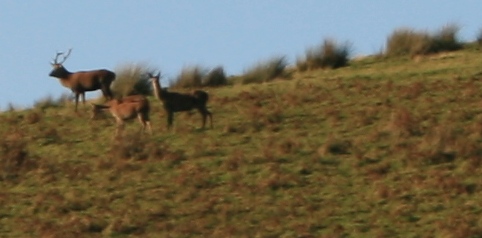 |
Fri, 21 Oct 2011 Had a wonderful week before the half term hols playing with an image in four parts; my students were each given two sections of a four part image on which to work, each section on its own meaning very little. It became clear when everyone had finished and we put the pieces together...here is a small selection.     Off to Exmoor tomorrow to paint, draw and breathe in the air. |
Sat, 15 Oct 2011 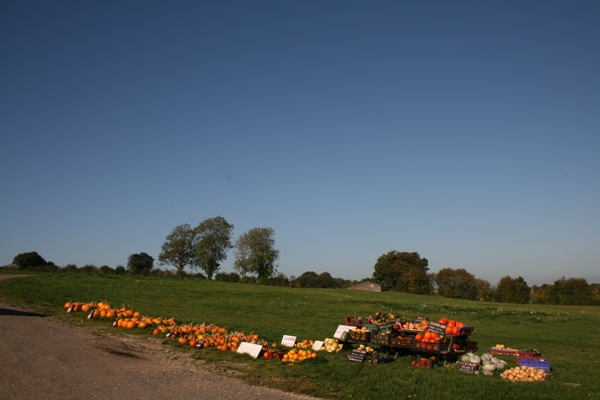 Which one for supper today...? 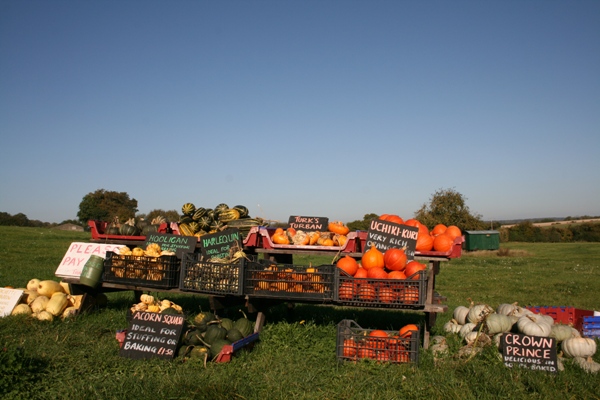 Could you live beside a better shop??? |
Fri, 14 Oct 2011 My neighbours have grown the most amazing collection of gourds, marrows, pumpkins and squashes. We've been trying to eat a different one each night; turk's turban, butternut, acorn, pattypan, spaghetti squash and more. If anyone who is coming to the Sunday workshop is reading this...we are going to paint them on Sunday! They look so beautiful stacked and set out for sale by the farmer I couldn't resist stocking up...and I nip out each evening for a different one to cook. Contrary to the luck of most farmers this year whose pumpkins are smaller than normal, my neighbours pumpkins are as good as ever! I'll photograph them tomorrow. On another note -I'm fed up with the Liam Fox witch (not Wizard?) hunt although I don't approve of the way he's behaved. I'm glad we live in a country where over-active nepotism is so very much disapproved of. In many countries it's an expected past-time, leading at its worst to impenetrable tiers of society and people like 'The Untouchables' stuck beneath every other layer. |
Wed, 12 Oct 2011 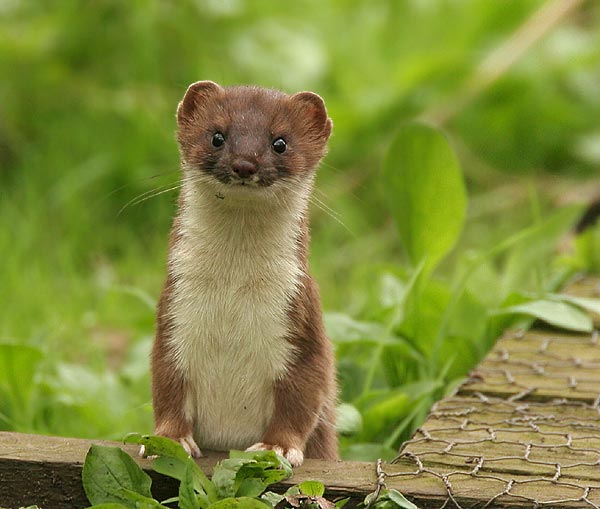 I just saw a stoat clambering around some old wood and twiggage behind my shed! It was gorgeous, glossy and sleek. I have never seen one so close for so long. I reckon it was about 30cms from head to the end of its black tipped tail...and it didn't know I was there admiring it. What a treat for a dull Wednesday morning. |
Tue, 06 Sep 2011 Heavy grey duvet of clouds, the thin strip of light between the horizon and the clouds above bodes no more than another blast of wet air filled with leaves and autumn detritus; I love it because it makes me feel alive but I know how it affects my friend who was born in another country filled with heat and sunshine; she made me laugh when she described the pills like hockey pucks she takes to stave off the depression. In their prams, my kids had hood and rain cover, but once they’d graduated to a buggy I shunned rain covers, wanting to nurture in them a love of rain and wind; perhaps at best a tolerance of rain and wind. Outside the rain is so insistent I can’t even contemplate running down to my shed for a minute. Its rain which soaks through every layer, and for the first time this early-onset autumn I feel too chilly to want to be wet while I’m working so I wait a bit and enjoy the turmoil from behind a glazed door. The largest of the cooking apples are being blown off their tree and will need collecting; the plums are in desperate need of picking, of being collected off the ground, of being ‘used’ usefully. I bought twenty allium bulbs today and I’m ready to find a place where I can squash them into the sodden earth. They’re unusual, Allium Bulgaricum, with big open bells. I’m impatient to see them flower before I’ve even planted them. On the horizon, in a wheat-field that the farmer must be very relieved to have harvested, I can see three deer meandering through the neat rows of straw now too wet to collect. The deer here, Roe deer, have good thick hedges for protection and know all the gaps to aid smooth travel from field to field. When we see them leap its more through tall wheat than over hedges or fences, whereas on Exmoor we see the Red deer leap huge barbed wire fences with gracefulness and seemingly no effort. It’s still blowing a gale outside but the rain has died down so I’m off with my coffee to my shed. |
Wed, 31 Aug 2011 On Monday evening we went to The Globe; we saw The Mystery Plays. We were among the crowd standing, the Penny Stinkants as were known in the past. The plays were stories and tablets from The Bible, from Adam and Eve, through Jesus and the Crucifixion to a Day of Judgement at the end. It was three hours of both humour and profound reminders of what the Bible is about. For one fleeting moment on the stage, The Last Supper -Leonardo style, slid into place, hovered...and then moved on. The Crucifixion was both powerful and very funny; they shoved a barbed wire crown on Jesus’ head then convincingly and brutally nailed him to the Cross. One of the Roman workmen, dressed in modern orange overalls, hammered his own thumb by mistake and leapt about in pain while the others worried over him; Christ was writhing on the Cross. Once they’d hauled the Cross upright, the workmen took pictures of themselves posing and gesturing, facebook style. Back home, yesterday, I was doing some gardening, cutting back some overgrown and savage bramble bushes. Even with the thickest gardening gloves on the thorns struck through to my hands but I had to keep grabbing and tugging the stuff down once I’d cut it at the base. I gathered it all up and made a small bonfire in an old dustbin and bit by bit I fed the stuff into the bin, continuing to be cut and scratched by the thorns. It was lovely watching the smoke rise up through the apple tree, obscuring the apples, leaving traces and silhouettes through the clouds. I know that cows love to stand in smoke; it kills the bugs on their skin. I wondered if smoke through the apple tree would kill fruit bugs if the tree had them. By this morning one of the fingers on my right hand, which had been stabbed by a thorn, was very sore and stiff. Although I can’t find a thorn I’m certain a thorn has caused an infection which has spread through to my hand. At the end of Monday’s play the audience were divided into ‘The Saved’ and ‘The Damned’. Our party were all in ‘The Saved’ , we had a completely unjustified feeling of triumph over the poor people on the other side of the barrier. It reminded me of a game we’d played at college called ‘The Star Game’. Depending on what you’d been handed at the beginning, your fate was sealed. Players have little or no control over the possibility of winning. Those who win have unwittingly won as soon as the game begins. I’m looking forward to the Polly Toynbee radio programme about...’social mobility’...a phrase that flows effortlessly from Govt. lips as if bestowing its benevolence upon us by tripping it off their tongues as lightly as butterflies around a buddleia. |
Sun, 28 Aug 2011 Playing around with some photos from my phone. 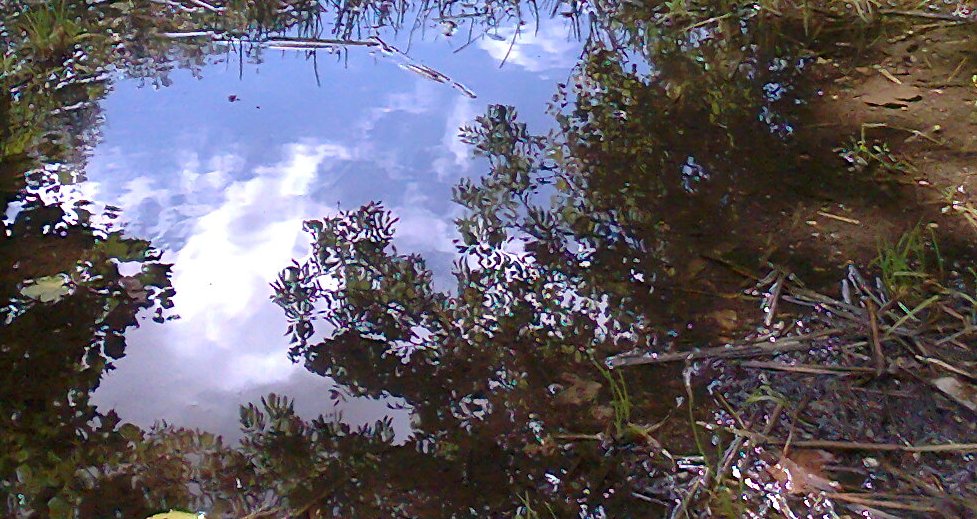 Nice 'edge' quality. 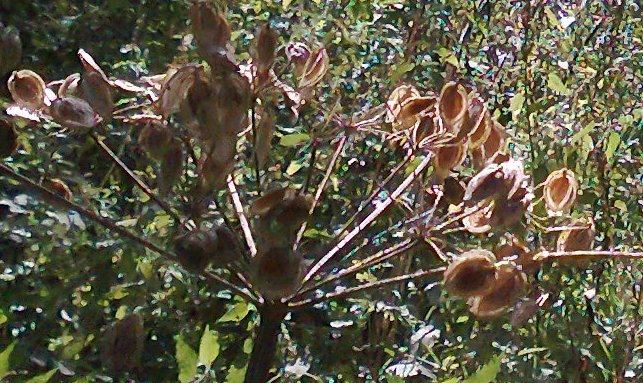 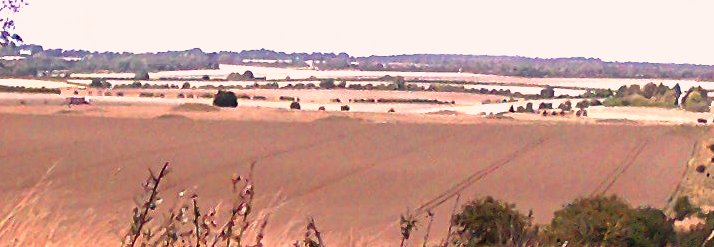 Through the middle of the photo are eight iron-age burial mounds and one ditch&bank burial which doesn't show so well. 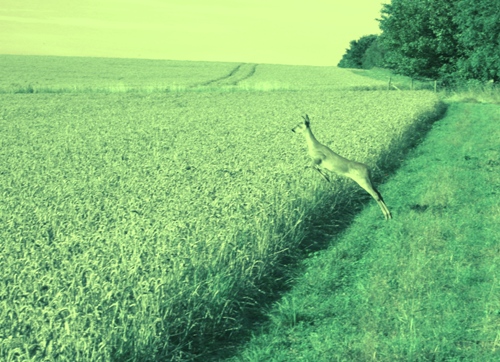 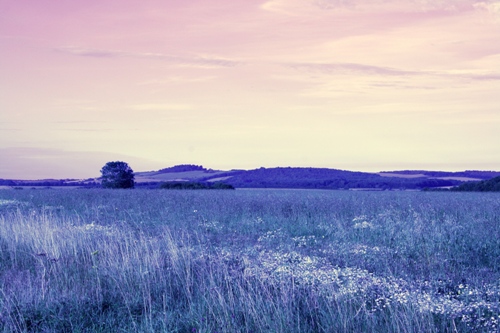 My son, home for a week after six months in China, went out with my camera. He wanted to take pictures of our area (Cranborne Chase in Dorset) to show to his Chinese friends who are always asking him about where he comes from and are often taken aback when he says ‘the country’. In many cultures the country-side is synonymous with peasant-like status and poverty. So my son took my camera and went for a long walk. He somehow managed to reset the white-balance to completely the wrong setting and so the pictures all came out blue. He was disappointed but I think it only served to enhance what seemed to me to be an incredibly artistic set of photos from one who is a physics graduate and has always referred to art as ‘fart’. He even caught several shots of one of the local roe deer that live in abundance on the Cranborne Chase. Our kids used to catch the bus to school, through The Cranborne Chase, and I remember one day when this particular son came home and stated, slightly surprised, that we live in a beautiful part of the world and he’d been enjoying the view from the top deck of the bus. I suppose it’s a privilege of a rich country that we enjoy the countryside, that we pay more to live in it and that people aspire to retiring to it if they don’t live it permanently. Some years ago we had a boy called Freddy from Peru staying with us, and he too was taken aback the further we reached into the country as we drove him home from the Salisbury bus station. It got worse – the next day we were heading up to Exmoor for a week and he came with us. Every day we walked across the moors in wind and rain. Gradually and stoically he came round to it and trudged on through the week. He was very proud of the fact that he’d visited every city in Peru, and he told us that usually his non-school days were spent in the local mall with his friends. It was inconceivable to him that we should walk across cold wet moor for enjoyment.   It dawned on me then that people in poorer countries are moving en masse to cities for work, stability of income and social structures; that to them the notion of enjoying the countryside for its own sake makes no sense as it is only synonymous with hard work and little possibility of employment. I’m sure Freddy was expecting a far more luxurious and cosmopolitan existence during his time in UK; a step up from where he may feel himself to be at home -in terms of city-life, metropolitan delights, the stylish hoards on the smart streets and so on. But for all the wonder of them, cities depend on the countryside more than seems immediately obvious. Un-balance the countryside and nothing goes right for anyone. Just one example much in the news -no bees, no pollination. Einstein gave the world just four years of existence if the bee population collapses. With the designated wildflower meadow behind our house, now in its fifth year, it’s clear how beneficial to wildlife it is to return land to its own devices; particularly to Lapwings, Hares, Butterflies, Bees, insects in general and therefore the Swallows...and so on and so on. So it’s worth giving Govt. grants to support what seems to be a luxury but whose practical benefits reach far beyond the field itself. And every day I have the good fortune to be able to look at the field and love every single manifestation of it including the wildflowers that now self seed in our garden. Wildlife might be a monitor for the health of the land. Presumably, the healthier the land, the better it will support everyone, in country and in city. |
Thu, 25 Aug 2011 Listening to Toby Young, an advocate for the new ‘Free Schools’, on radio 4 today it occurred to me he is living proof that style of education does not equal certain success. He berated the comprehensive schools to which he went while visiting one of them recently which, by his own account, is completely different in its apparent ethos and style now to the way it was when he was there. He left school with one O-level and one GCE, but after re-takes he just about accrued enough to get into William Ellis Grammar school to do A-levels. There, in that very different ethos, he thrived and gained three A-levels. He talked about his changed attitude to his own education, and that his high achieving sister (nine grade ‘A’ O-levels) had become disaffected with education and had dropped out to become a Buddhist nun. Once he no longer perceived her as ‘competition’ he was able to concentrate, not feeling that all his efforts would be outshone by hers. He went on to Oxford University although he didn’t quite achieve the three grade 'B' A-level offer he’d been given; a phone call from his father, Lord Young, smoothed that path. All kinds of emotions were whirling around in my head by then. Firstly, that teachers under all systems are governed (or restricted) by that system within which they work and the best Head-Teachers are the ones who give their staff trust and a loose rein to teach how and what they know best within that system. Think about it –were your best teachers the ones most likely to conform to systems? I taught adults under the Dorset Adult Education system for many years, full classes with waiting lists. By the time it came under the Ofsted body and I’d been classified as ‘satisfactory’ by my inspector too many times, I’d had enough. It was no longer about what or how I wanted to teach. It was the pointlessness of reams of meaningless paperwork which finally encouraged me to leave. Now I will only teach for myself, courses and classes over which I have control, still full to bursting and with waiting lists. Toby Young, in opposition to the Comprehensive system that he feels let him down, is setting up a Grammar-style Free School with an all-ability pupil intake where Latin will be mandatory in order to give pupils the rigorous education he was denied. The point is less about rigorous and prescriptive systems and much more about very good teachers. That wretched old saying ‘If you can’t do it, teach it’ is about as wrong-headed a saying as could possibly be. If you can’t ‘do it’ then certainly don’t teach it. Toby Young was described by his sister as having been a ‘naughty little boy’. Any child with a particular attitude can ‘fail’ in every system, and opposite is true too of course; any child can succeed. It will depend far more on an inspirational teacher, not even necessarily at the ‘right’ point in your life –there is no ‘right’ point for learning. Being taught by an inspirational teacher is going to inspire you whenever in your life it happens. Or it may be a change in circumstances, such as for Toby Young his sister dropping out of education, that moved his mindset on to a new path. Because Toby Young and all of us went to school, we all feel we have insight and an opinion on education. But to come up with another tight system is to do to the child in school exactly what was done to him –to force a model. His ‘Free-School’ model may be as likely to fail or succeed, be loved or hated by the pupils just as much as the Comprehensive model which forced on him was. Why can’t we get to the point where a teacher is allowed to teach their subject because they love it? And accept that some pupils will be interested in some things and others in other things? What is it Toby Young really wants? Rigour of curriculum or rigour of discipline? If he is developing his Free School to have an all-ability intake, does he intend to fit the Latin lessons to the individual pupil or will it be a ‘one lesson fits all’ approach? It seems to me that, Toby Young, a so-called failure of the system of education he went through, is actually a huge success (journalist and author of ‘How to Lose Friends and Alienate People) and a credit to the challenges which shaped him and difficulties which he overcame. Secondly, and possibly off the point, I was reminded that my father grew up in North London; he was the first child in his primary school to pass his 11+ exam. His Headmistress was so happy she danced around the school with him...and off he went to William Ellis Grammar School where I’m sure a rigorous education was delivered to him but in war torn poverty stricken London he had to leave aged 14 and go to work. He says that the teachers then were stuffy old men who were teaching because other men were off at war. As you might know from an earlier blog, my father went to University finally but not until he was 58 yrs old. He loved it nonetheless. It also had me thinking about my own education and that of my siblings. My twin sister and I went to a Grammar school; I left with nine O-levels and went to the local art school. Without A-levels I had to be accepted by a ‘special admissions board’ when it come to applying to The Slade School as it was part of London University. My twin sister left with A-levels but was married and having a family before she went further with education. My younger brother and sister both went to the local secondary modern school where they left with very few qualifications. Both have gone on to do degrees at University; my younger sister runs her own successful business (www.organicsforkids.com) after working for many years for the Sainsbury’s Charitable Trust as a researcher, and my brother, now fluent in German has done various things including translating Germen text books and living and working in Germany. It seems to me that none of our career paths were the obvious outcome of our earlier education paths, and most importantly nor were Toby Young’s or his sister’s (she’s now a hospice nurse). Our three children went through the local Grammar School education system; two thrived but our daughter, by year 10, hated it so much that she jumped at the chance of moving to the ‘Bog Standard’ (a description used by Alistair Campbell, Tony Blair's Director of Communications and Strategy, about the nation’s comprehensive schools) Comprehensive School where her father is Head of English and where she thrived and is now doing a BSc at King’s College, London in Mental Health Nursing. Until we give our teachers respect and freedom to teach, and encourage the very best to stay in the classroom and not be shoved up the greasy pole to Head-ship, we’ll continue to believe that education is all about the systems a government puts in place and the Head Teacher feels forced to implement. |
Sun, 21 Aug 2011 I'm very grateful to my friend John who yesterday lent me a humane mouse trap. We'd seen a little mouse running to hide behind the wood-basket in my gallery. I put mealworms (always kept in case we find another baby bird like Colin) in the trap and set it exactly as John told me. Sure enough in the morning I'd caught the little thing so I rushed around in order to get out and free him before he died of shock. I took him down to the hedgerow at the end of our track, but when I opened the trap I saw he was not a mouse but a lovely little shrew, long nose, shortish tail and very slow to leave the trap. He tried hiding at first but I turned the trap upside down and out he crept into the undergrowth. What a treat! He looked gorgeous. 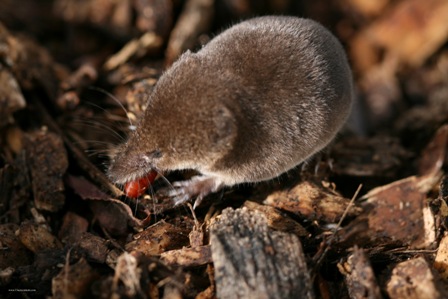 I've been reading since then that they are ferocious little things who will fight viciously to protect their own hunting ground. They eat insects and worms, and need to feed most of the time, day and night with short rests between hunting, in order to eat enough. They are extremely territorial and establish a range of between 370-630 sq.mtrs. Ohh crikey..In hope I put my shrew in a shrew-free zone! |
Sat, 13 Aug 2011 Memory: Inherited and Gathered. Thinking about next summer's exhibition. ******************************************************* We are nothing if not a collection of our memories, gathered from before the time we were conscious of doing it right up to the present moment. I think my first conscious memory was of sitting in a carry cot on a window sill looking across to my twin sister in her carry cot and seeing wall paper behind her with pictures of dolls. The dolls were about 8-10 inches high and were vertically placed up the wall, one on top of the next, about 3 inches apart. They were all slightly different. But how much, if at all, do we inherit memory? Why have I always felt that the Second World War was a turning point in my life even though I was born 13 years after its end? When I first made the calculation that I was born 13 years after the war I was staggered at my close proximity to it, because although it has seemed like a turning point sub-consciously, consciously I’ve known I was born long after. The places that I choose to paint are the places I love because they resonate so completely with the memories by which I am constructed. The shapes of Exmoor in North Somerset/North Devon must be the main building blocks through which I came to understand the look of a landscape. I remember deeply happy childhood days trudging across the moor with my family, wading rivers to follow our route, sometimes wading barefoot and feeling the sharp cold of the water. I believe that if a fashion designer came to Exmoor for a week they would change their cut, colour, texture, curve, every element of their design couldn’t fail to be influenced. Something profoundly satisfying and human-scale resides in the body of Exmoor –in my eyes something perfect. When we arrived at The Klein Karoo in Africa, when I first climbed out of the car, the initial surprise was the smell which brought my childhood rushing back. I smelled the smell of an ointment called Pomade Divine of which we’d had a tiny jar given us by our Great Granny. We called it Mardivine in our childish way and it was sparingly spread on cuts and bruises. This Klein Karoo had just that oily astringent smell of goodness and comfort. I’d had an inkling I would love the place before we got there. I knew we were coming to somewhere remote and wild. But getting there fulfilled and exceeded my expectation. The vegetation was utterly alien but it so clearly described distance in its diminishing size as it spread off to the far horizons. Like The Cranborne Chase where I live the skies were huge, and tormented as we’d arrived in the deluge of a rainstorm. The massive space was quiet except for the distant chatter of the rest of our group arriving at the cabin. I have since called the second painting of The Karoo Series ‘I Stood on That Rock and Saw Myself’ because, as I stood on the rock in the painting, as the surroundings resonated with my inner landscapes, I had a feeling of an inherited memory -of Colonialism. Did I feel or intuit the hardships of previous people? –Bushmen, Dutch settlers, English settlers? It was clearly (evidence through Bushmen rock paintings) a place previously inhabited and still sparsely populated, but it must have been and still be a tough place in which to survive. Survival would require an understanding of the most basic needs of a human being – Ray Mears style. Do my favourite landscapes give me closeness to the basics of humanity? to the locking-in point with our surroundings? and help me to forget about the fragile web of dependence we live on; four days of no fuel (remember 2000 fuel strikes?) and we come to a national standstill? I feel like I fit into these wild places like a well-fitting jigsaw puzzle piece. To survive in them might be a different matter. |
Sat, 06 Aug 2011 I was hearing on the radio today about Venezuela’s youth and children’s orchestras created under ‘El Sistema’, a publically funded voluntary sector music education programme. In the last few years it has moved on to include prisoners in Venezuelan jails. El Sistema now watches over 125 youth orchestras in Venezuela which means 250,000 children participate. 90% of those children come from poor socio-economic backgrounds. An important product of El Sistema is the Simon Bolivar Youth Orchestra which played at The Proms in The Albert Hall last night (Aug. 5th 2011); it’s Guy Dammann’s comment in the Guardian review today which is 100% accurate and about which I want to talk -“Much has changed since 2007, when the words "el sistema" rippled across the lips of a nation shocked to remember the self-evident truth that a youth educated in music are a youth ennobled and given hope.” About a year ago, John Humphries and The Today Programme on Radio 4 decided to broadcast a piece on ‘The Monetary value of a University Degree’. As I recall, a Physics degree was at the top and given a value of about £70,000, of course hovering nearby were the engineering and medical degrees, but right down at the very bottom, squashed beneath every other valuable and ‘valuableable’ degree came a Fine Art degree, value-worthless. I have, during any one working week, approximately 60 students who come to me wanting to learn to paint. They range from people in their 20s to people in their 90s and from the unemployed to the titled. I have young children and teenagers who come to me as well, and become an integral and unembarrassed part of my varied and mixed ability classes. My students come with all sorts of ideas about what ‘Art’ is and what they want to achieve. I clearly influence them about their objectives and how they might reach them. I give them a facility with all the different media, I engage them in the thinking processes behind the making of art and of self expression, but mostly I give them the confidence to get going on the ‘drawing out’ of something that is already within them. They pay me for this with money but also in their commitment to it. Perhaps one of the things that surprises them most is the amount of thinking we do, around making a picture, about ‘what and why to paint’ but most importantly practical help with what they think they ‘see’, what they actually ‘see’ and how they might respond. What is not in question is their desire to paint. I hark back to part of Guy Dammann’s assertion in The Guardian today… “…a nation shocked to remember the self-evident truth that a youth educated in music are a youth ennobled and given hope.” It is entirely comparable in art, and it isn’t reserved for youth alone; all ages benefit. My father left school aged 14 during the WW2. He worked in various jobs (farm worker, Café proprietor, mental health nurse) from then until at the age of 58 when he went off to University to do a degree in German and European Studies. In monetary terms you might wonder at the point of doing a degree at his age then. What he did afterwards was a TEFL course and subsequently taught English in Poland for four years. Now, at 80, he has finally stopped visiting his Polish friends on a yearly basis, but the effect of his degree has gone beyond the visible and the quantifiable in monetary terms, like the roots of a giant tree. While in Poland he worked on the English exams which were then used across Poland and he made significant links between English and Polish people, frequently having Polish friends here in UK and helping them to find work/placements etc. My point is that we all have to live a life; to value it in monetary terms is the least useful way to value it. Monetary value in no way equals happiness, fulfillment or even independence. I would suggest that those hooked on money and monetary values lack an independent way of thinking, having always to hitch their thought processes to a monetary quanitity. The South African archaeologist Christopher Henshilwood believes that we became human when we started to make art; it separates us from the animal world that we make something for its own sake and not for practical use. He has found possibly the oldest, at approximately 70,000 years old, piece of art ever found, in a cave on the Eastern Cape of South Africa, a small piece of stone carved with abstract but intentional patterns. It is entirely probable that people were singing then and possibly making percussive sounds too, but that is less likely to leave evidence of itself in the same way that art can. As our education system, in its infinite wisdom, devalues and cuts access to the expressive subjects, we lose that thing which above all makes us human and has effects beyond that which is quantifiable. Thanks to my worthless degree, many of my students have gone on to teach art and run courses in art and almost all of my students do some kind of art outside the class which they find completely fulfilling. Many of them talk about the art that they do with their children, or the collaboration they have with their children on their children’s work. And as well as the teaching and learning relationship, of course people come and buy my art, so I’m not, after all, on some kind of valueless scrapheap. This last point is remarkable considering that I do my art for myself and myself alone, or, it means that we all have a need to respond to some fundamental human experiences and when my experience coincides with another person’s, they feel moved to pay me for the result. Is it any surprise that the introduction of El Sistema into the prisons of Venezuela is having a marked effect? Or that the prisoners interviewed on the radio this morning said it gave meaning to their lives and that the one thing they were going to be sure to do on leaving prison was to find an orchestra to join, or to come back into prison to help keep the El Sistema programme running? I want to say to the whole world ‘OH FOR GOODNESS SAKE STOP LOOKING AT EVERYTHING AS HAVING A MONETARY VALUE OR BEING WORTHLESS’. Monetary value without expressive outlet will crush creative thinking and will take us away from that which makes us human. To make art is to be able to experience discovery first hand, every day of our lives, and to reap the benefit of it if, and when, any or everything else is going wrong! |
Tue, 19 Jul 2011 I found a perfect little field mouse -dead, and put him to one side because I was teaching for the day but wanted to keep him for my freezer. By the end of the day was amazed to find wasps gorging on him; they were voracious, climbing right inside to eat. 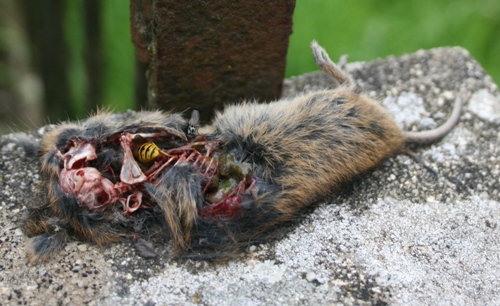 It reminded me of Samson's riddle (from The Book of Samson) "Out of the eater, something to eat; out of the strong, something sweet". It was conceived after he'd found a bees' nest in the carcass of a lion he'd killed. He ate some of the honey and took some to his wedding where he gives it to his parents and presents his prospective parents-in-law with the riddle which they must solve or give him thirty pieces of fine linen and garments. Of course his fiance is coerced into discovering from him the answer and telling her family who in turn reply to Samson\'s riddle with another riddle showing they clearly understand the first riddle...and so begins Samson's life of bloody slaughter, in his rage, with the killing of thirty of the in-laws' tribe whose garments he gives to thirty of his grooms-men. His life ends, of course, with the killing of himself as he pulls down the pillars of the temple and brings it tumbling down on 3000 men and women as well as himself. 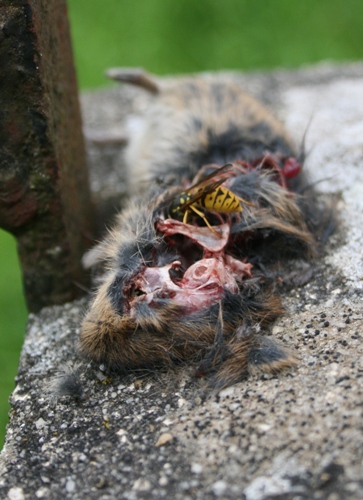 So, I found this on wiki-answers.com 'the mix up of bees and wasps is extremely common. wasps are mainly carnivores but will occasionally turn to both carnivorous and herbivorous (sic) to stock up on sucrose for the winter time. bees are only herbivores.' |
Fri, 15 Jul 2011 It's St. Swithun's day so I've kept my fingers crossed and watched the skies become overcast after a lovely sunny beginning. 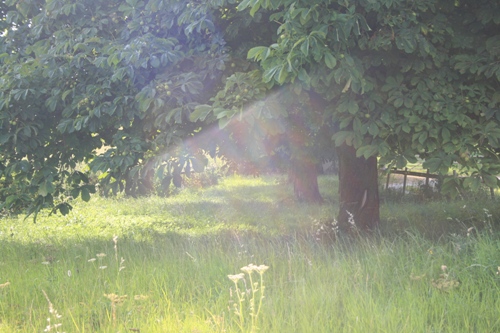 This morning I was out photographing for two reasons; 1. we had just made an early morning drive back from an amazing evening in London last night seeing David Tennant and Catherine Tate in 'Much Ado About Nothing' which was very very very funny and 2. I'm fairly sure it's going to rain heavily next Monday -my first day of Chettle Summer School, so I wanted a fall-back if I can't send my students out to draw. I have quite specific criteria that I want them to look for in a landscape so I went taking appropriate photographs and they may well have to draw from them on the first day. After that I would get them to work from their drawings only, casting the original photographs to one side. Maybe the sun will shine on the Tuesday (fingers crossed!). |
Thu, 14 Jul 2011 Pigs are like magical animals; we threw mounds and mounds of Virginia Creeper which had been growing up the sides of our house and grass cuttings from a third of an acre garden into their space a few days ago and today when I wander down to give them bread-ends from Simon's home made bread and (a real treat) some stale digestive biscuits, all that remains of the clippings are a few bits of Virginia Creeper stalk and four incredibly good natured pigs (three black teenage boys and a larger ginger female). I feed them the bread and biscuits which they cheerfully chomp, and I look behind me to the wild-flower meadow which this morning had had a deer sitting quietly under the apple tree but he'd disappeared by the time I arrived with my camera; I'd seen his big ears in silhouette sticking up above the grass. The sun is shining and the sky is littered with white fluffy clouds; I've walked through a door -my kids have all left home and are scattered, Japan, China and London so the world is like a concertina either drawn in and small and everyone feels close-by, or stretched out and huge and everyone seems far too far away. One minute I'm happy, freer than I've been for years, and the next minute anxious and too far to be able to help or influence matters. 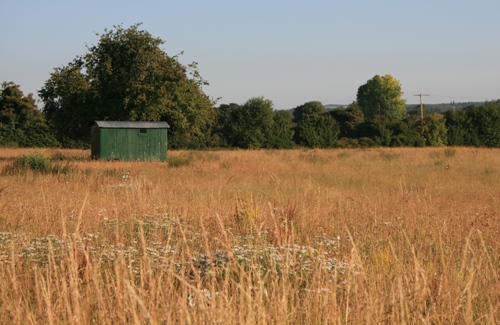 This was moments after the deer had skipped away. |
Sat, 09 Jul 2011 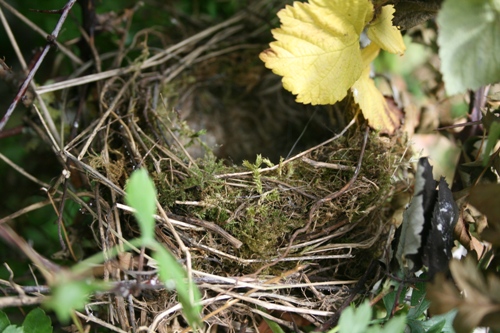 The two little dunnocks have fledged; It must have happened the only day I wasn't able to sit out and watch them! They left behind their perfect nest. I don't know if the nests are re-used; I\'ll keep an eye out next year. I think its a bit late to begin another clutch of eggs this year. 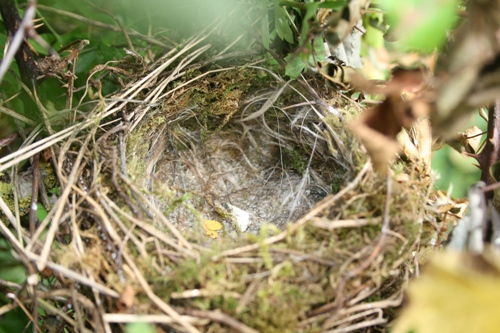 Alain de Botton, well known philosopher, was saying on his 'point of view' last night on radio 4 that he had largely ignored the animal kingdom until he started taking his two sons to the zoo. I was flabbergasted. I thought for sure every thinking person could find no greater delight or satisfaction than in coming eyeball to eyeball with a wild creature, even if it has to be in a zoo. I feel I should congratulate Alain de Botton on his belated realisation of the truth! |
Wed, 06 Jul 2011 I went up onto Maiden Castle today with my Dad. I reminded him that many years ago -I must have been about 10, we nagged him to take us there from Taunton, and he took us! but he's forgotten. Maiden Castle is an Iron age earth work, built initially in about 600BC but considerably upgraded in about 450BC. 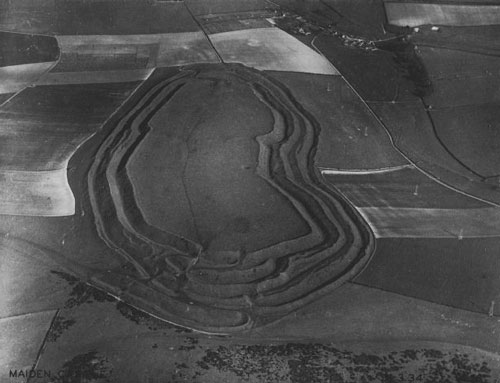 The amazing thing is that the earliest ramparts were built using antler picks and oxen shoulder-blade spades. I guess once iron was made they will have used that for the upgrade! 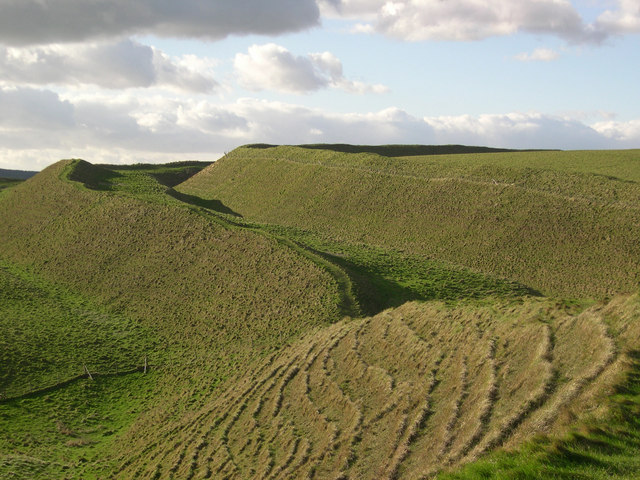 In the Thomas Hardy novels Maiden Castle is known as Mai Dun Castle; 'Mai Dun' being British Celtic for 'Great Hill'. The wind was powerful up there and we watched a raven grapple with it; it sort of described the flow or air as it was tugged through. Every now and again it tucked its wings right in and made a 360deg swirl; it reminded me of winding myself up on a rope-swing as a child, then pulling all my limbs in. The closer I tucked in my limbs, the faster I un-swirled on the swing. Was the raven doing it for fun too? **** |
Sun, 03 Jul 2011 My neighbour's son was cutting our hedge back a bit yesterday and found a nest with two little birds (he stopped the cutting there). I made sure that we put foliage across where it was looking thinner and I've been watching to see what happens. It's a Dunnock! I sit quietly on a near-by bench and watch her; she flies into the hedge a way down the garden and from there travels through the hedge until she gets to the nest. The first I know she's reached the nest is a tiny tweet that she makes, the squeaking of the chicks and a slight movement of the hedge moments before she flies off again. At one point I was sitting beside a twig bower in the garden, she hopped on fairly near-by but amazed me by hopping closer and then even closer; I think to get a look at me and work out what sort of threat I am. Her head feathers were raised up like a little crest...not sure if that was meant to frighten me off! I sat tight despite the threat! She carried on assessing me with a sideways look. |
Fri, 01 Jul 2011 Until a week ago there were dozens of sparrows -on the bird table, the doorstep and chatting away in the bushes, but now a good few of them seem to have gone. I think these are the teenagers off on walkabout because I can hear the squeakings of the new clutches in the nests calling for food. Ohhh it all reminds me so of Colin -I sat on the doorstep today in her favourite dress...and sure enough in her favourite thorn-bush there was a female sparrow tweeting at me.....I wish I knew but I never will! I love buzzards, I love the way they mew. I've just watched one cut through the blue sky across our garden, wings stretched out like spades; mewing and causing a ruckus among the pigeons! Thank goodness for buzzards, they remind me I can dream of seeing the world from their viewpoint. |
Tue, 28 Jun 2011 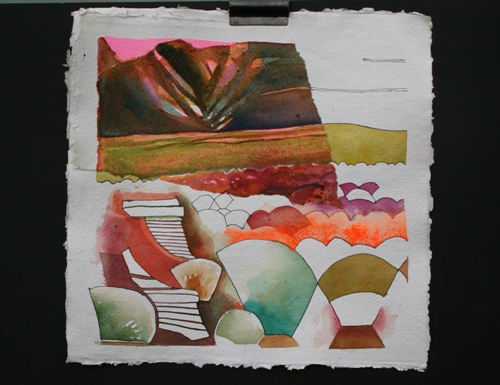 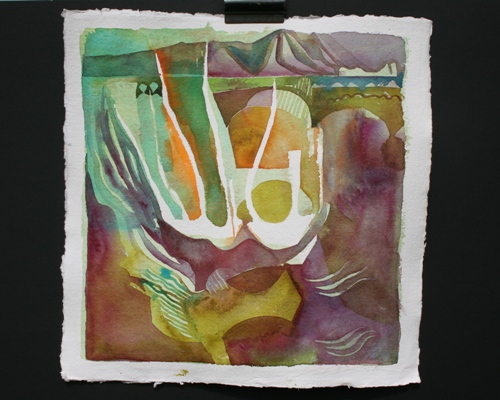 Moments of Impact: Karoo Series. Watercolour/mixed media on watercolour paper. 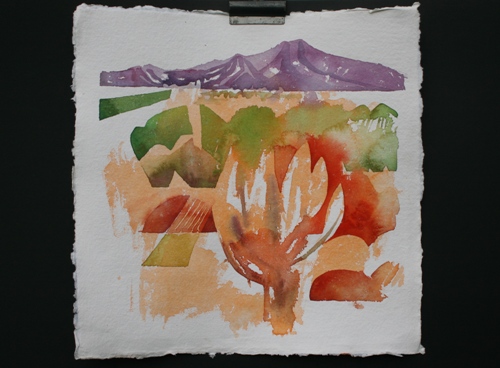  |
Mon, 27 Jun 2011 In my classes we've been looking at rapid early response to a subject, recording with a certain amount of speed as much colour, tone, texture and 'edge' as possible. Then the original resource/subject is put to one side and all subsequent pieces of work are based on the working drawing and nothing else. It's the way I work and am continuing to work at the moment on the Klein Karoo drawings. Today I've been using watercolour, making paintings, tearing them up and re-positioning them or adding to them slightly differently than the way they began. I bought some lovely Indian watercolour paper from The Tate when I was at the Watercolour exhibition; the paper is high cotton content, deckle edged and has a very smelly size in it but is very workable thanks to the size. I've bought two more packs on-line. |
Sun, 26 Jun 2011 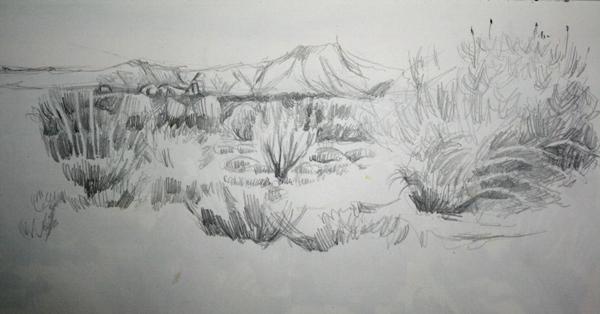 Drawing in The Klein Karoo In a perfect world every child would have a stream to dam, a hill to scramble down and a moor on which to lose themselves. When I am in a wild landscape I am ageless, genderless and almost non-existent except that I become a monitor; a receiver of everything around me. I’m an essential and integral piece in the massive jigsaw puzzle around me. This is what I love. In this state I finally sit and record in my drawing book. Looking at the world like a child means we don’t judge it; we become a monitor and receive it with wonder. |
Tue, 14 Jun 2011 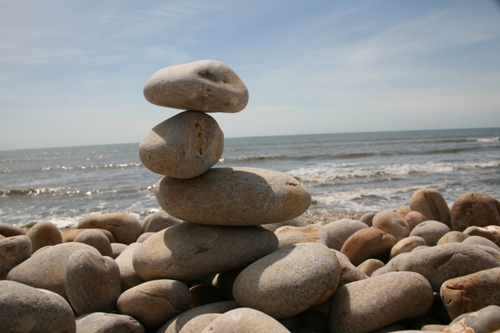  I’ve decided being an artist is best accomplished by being like being a child; I’ve spent a very happy day on the beach with my twin sister and her husband, all three of us able to potter or read, and I couldn’t have been more content. First I found a lump of the blue lias clay which banks the back of the beach but this lump was at the water’s edge beautifully damp and malleable. It was a wonderful thing and it made absolute sense that early man will have come along and have done exactly what I did, made a pinch pot and dried it in the sun. 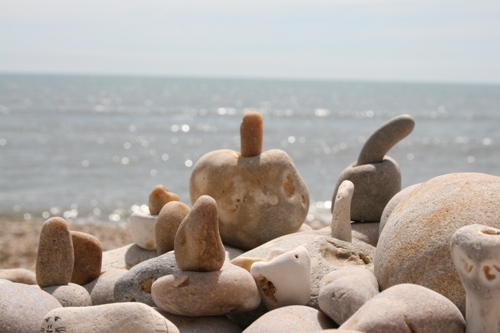 Then I got my drawing things out and had a long look at the structure of the beach/cliffs/sea and Portland in the distance. The drawing I made was immediate; I used line but rapidly moved on to watercolour and was at pains to ‘get stuff in’ without worrying about the quality of the drawing. I love my sketch book; it’s like my heartbeat. Then I set about photographing various things; my brother-in-law was making some lovely pebble -sculptures, the structure of a breaking wave is endlessly fascinating and so I thought I could analyse it through a series of photographs, my sister, as always, was making me laugh so I photographed her too.  We had a picnic lunch and caught up with family chat, kids etc., and I started building columns with the pebbles. I was trying to get either a very tall column or a column with a completely irrational placing of the pebbles. I can see how the people who take column building on the beach to the n-th degree develop an acute understanding of size, weight, shape and ‘balance-ability’ of a pebble.  And now reader...are you asking yourself ‘Did she swim?’ If the water and the weather make swimming an even half feasible idea you can be sure I’ll be in there, splashing and bobbing, floating and looking up at the seagulls and aeroplanes. I stay in the water until I can no longer feel my hands and always wish I could stay longer. Once I was dry I had my drawing stuff out and was looking the other way along the beach towards Lyme Regis, again drawing rapidly with a little bit of urgency. I had a wonderful foreground reference in a clump of dead trees sticking almost horizontally out of the bank at the back of the beach. After a cup of tea and a biscuit at the cottage where my sister is staying I’ve come home sunburnt and happy. 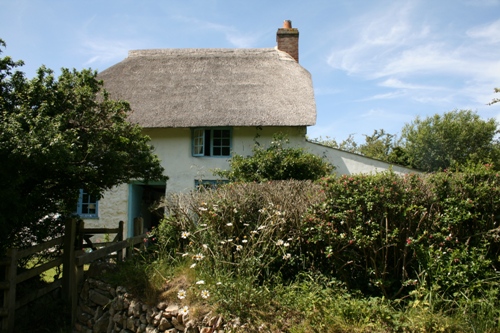 |
Sun, 12 Jun 2011 Eyes and light: I’ve always thought that, contrary to or perhaps enhancing Anthony Gormley’s assertion that our bodies are the thing from where we engage with the world, that I am more of a ‘monitor’ receiving information and dealing with it internally. I know where I like to be to receive information; alone and in any wilderness. Last night on telly David Attenborough was talking about eyes. Millions of years ago ‘eyes’ were light sensitive cells on small water-dwelling creatures. Either the cells developed because the organisms needed to react, or the organisms with the light sensitive cells reacted and survived where those without didn’t. It’s clear that the only reason for the existence of eyes is the existence of light. Eyes monitor light; light from the source or light reflected off objects and surroundings. Our brains interpret the information allowing us to walk about without smashing into things. Other helpful interpretations occur; we understand that a tiny tree on the horizon is, in fact, very large and would require a certain amount of time to walk to it. We know that the colour ‘green’ suggests plant life and if you’ve been in a desert you’ll know exactly what that means. As light diminishes, so too does colour. Leonardo said ‘Don’t paint colour in the shadows, just paint tone’. Look around wherever you are now at the shadows and the things in shadow. Ask yourself what true colour can you see in the shadows? Sometimes your brain will interpret what it knows rather than what it sees. You might see a scarlet rug, half in light and half in shade. If you isolate a small section in shadow (make a small hole with your finger and thumb and look through it at arm’s length) and compare it with a small section in the light you’ll see they are completely different. So, I love to ‘monitor’ the world visually but to add to the experience by ‘monitoring’ with all my senses. |
Fri, 10 Jun 2011 Today I found myself anthropomorphising a piece of grass! It looked so funny; I picked it and quickly had to pick another so that it wasn't alone. It has the look of a scatty old lady who has forgotten to brush her hair or a kid who has stuck his fingers in the electricity socket. 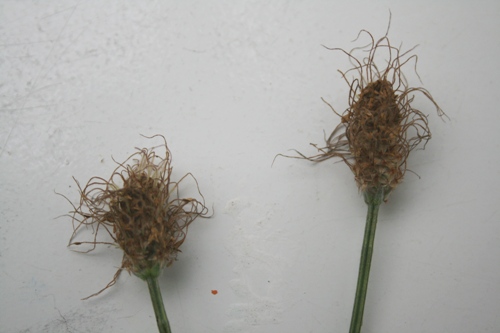 |
Thu, 09 Jun 2011 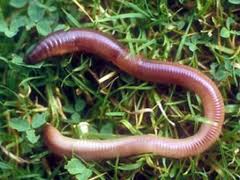 Today I saw a lady pick something up from the path on which she was walking and drop it carefully into a grassy bank. It was a worm that she rescued from the perils of a path frequently used by cyclists as well as pedestrians. It was a pleasure to catch her in a kind act, no doubt anthropomorphising the worm into a sentient being relieved to have been taken out of the path of very probable danger. I wonder what the worm was thinking as he was lifted gently up and placed a distance several times his own length away from where he’d started, into an environment completely different from that which he’d been taken...but there I go doing exactly what that lady did –anthropomorphising the worm . |
Fri, 27 May 2011 I watched a male sparrow on the grass in the garden today, followed by two young female sparrows. He hopped about and they followed at a hop, nagging him occasionally. I'm not sure if he was teaching them about worm-hunting, or they were nagging him to feed them, just as he must have been doing in the nest for the last few weeks. The youngsters certainly reminded me of Colin. Fay Wheldon is speaking on the telly just now suggesting that men don't read women's novels because the endemic feeling is that women are not as important as men and therefore their writing not as important...writing is serious for men and a hobby for women. I wonder if that man-sparrow was feeling the same about his daughters hopping about behind him. I DON'T THINK SO!!!!! |
Wed, 25 May 2011 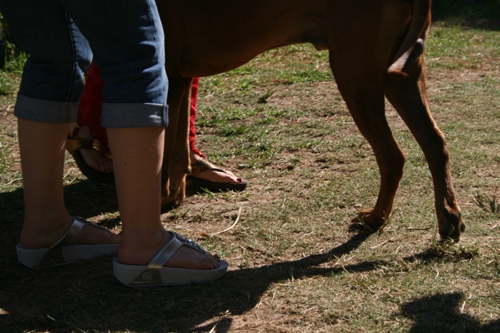  These four, I thought, were the best of my 'Legs' pictures. 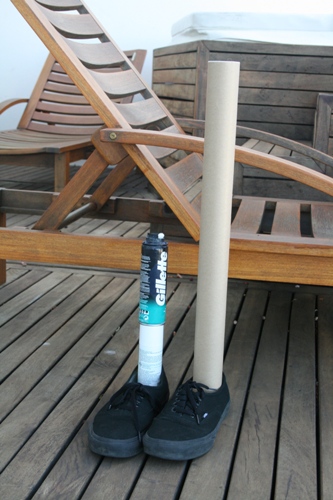  |
Tue, 24 May 2011 So tonight I’m going to my life drawing group where I’m attempting to draw tiny tiny drawings of the figure because I want to see the form and shape of the figure as a whole and I came to the conclusion that when making large drawings, I’m working on a foot at one end and have little idea of what’s going on with a hand at the other end. Something like ‘the left hand doesn’t know what the right hand is up to’ –no such misunderstanding if I make the figure drawing tiny! I still find it an incredible challenge as my inclination is to work large. That doesn’t detract from the fact that I’ve been working here at home on a giant drawing of Mary; but she was looking up at me and therefore me down on her so I’m seeing her almost through a fish-eye, with her figure disappearing beneath her chin and not a stretched out image. I began the drawing before she left for Greece (from which she may not return on time thanks to an Icelandic ash cloud) but I also made a photograph because I knew she’d be gone for a while; she’ll return from her trip straight to London for a 9-week placement on a deaf children’s ward. I’ve been working on heavily negotiated chalk, charcoal and white paint drawings of heads (including my own as I’m the one mostly around, can’t be denied!) and the Mary drawing is part of that set. Drawing with line is a lovely thing; line can be tentative, insistent, tremulous, confident –whatever description you find, you can rustle up an equal but opposite type of line, however its limitation is that it doesn’t deal with the weight of shape. Using ‘Shape’ means that you can show an area where the light doesn’t fall, in other words, shadow. This in its turn means you are describing to the viewer a 3-dimensional form, a form which, because of its particular shape, can catch the light in some places but not in others according to the light source direction and the position of the object. If you put together the shapes of tone you see on and around an object you’ll create the illusion of 3-dimensions on your 2-dimensional page. Some drawing contains both line and areas of tone (shape). The tonal areas can either conform to an earlier drawn line, sitting within the boundaries of the line and giving an indication of tone, or can work separately from a line, without a line surrounding them, their edges becoming the boundaries of that shape. One drawing which incorporates shape (tone) and line perfectly, and is beautifully understated, is this small brush and ink drawing by Rembrandt. He makes linear marks with the brush and also shapes of tone so that we understand that he was looking at a sleeping girl. This drawing has the look of a drawing made because he wanted to understand what he was looking at in the language of light and dark. My intuition tells me he wasn’t making it as a preparatory sketch for a painting; he looked across, saw the girl sleeping and grabbed the utensils to make the sketch. He was satisfying his soul’s desire to understand at a time when no such thing as photographs existed to aid visual understanding– he probably wasn’t conscious of anything other than the flow of information to his eye, his brain and then his hand. 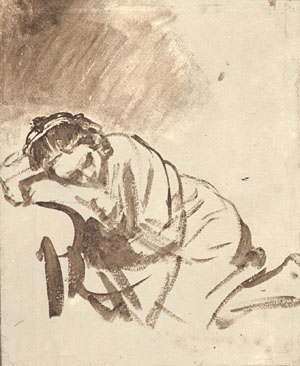 |
Sun, 22 May 2011 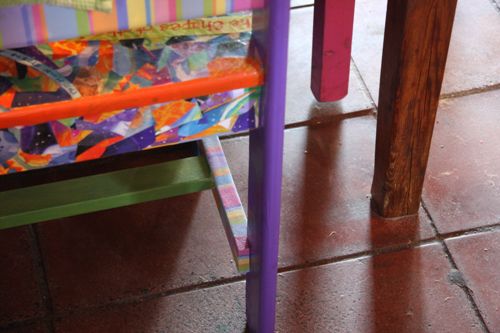 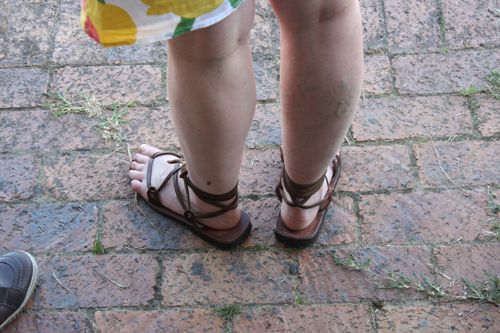 One of our day's projects in South Africa was 'Legs'. It had all of us looking for things other than that which we might ordinarily photograph on our travels. Here are some of my favourites of Alan's 'Legs'. 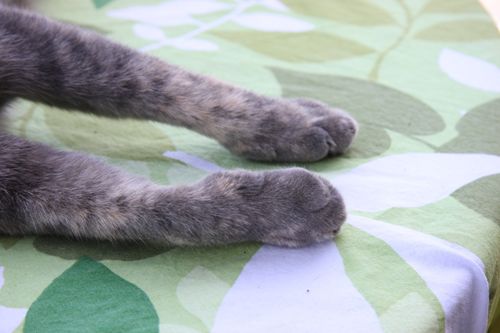   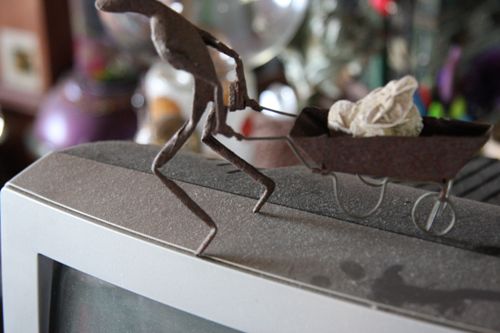 Legs are everywhere -where you least expect them and beyond. |
Wed, 18 May 2011 Feed All Your Senses With Experience. I’ve talked about memory being one of the most important elements when it comes to inspiration. Whatever we encounter each day is understood by being placed alongside a complex collection of memories and experiences. I can walk along a street I know well and predict where I’ll end up. I can also walk along a street I don’t know at all and because of my many experiences of walking along streets I can cope very well with what I encounter. I also manage rather well in foreign countries, navigating my way through unfamiliar streets and finding the right places to eat, to buy presents, to window-shop. In a foreign country my senses are heightened. I use them all to help me. I smell the new food smells, I watch more carefully for threats, perceived or real; I use my intuition to work out how to present myself. Every part of me is absorbing information. This is a level of sensitivity which intensifies experience. A bakery in Aqaba sticks in my mind for its smell and the fact that people were shopping late into the night for their freshly baked bread; being dark outside the shop was lit up like a European shop at Christmas time. Incongruities fix the memory. The more I paint faces the more I am delighted by the surprises I discover each time I study a new face. It’s a bit like the discovery that the older we get the more we realise the less we know. However the collective memory of many faces reassures me that I am actually looking at a face. Although every face in the world is so very different there must be enough in the similarities for me to be able to say –that’s a face. If our brains worked to understand detail rather than making sense of a collection of stimuli, we would be newly confused every time we came to a new face, the differences of one face not matching up to the criteria of another. But there’s more. We become attached to our familiar faces. When painting them we are constantly, if subliminally, thinking about our close attachment. Like the Bakery in Aqaba, more than one sense stimulated adds to a visual picture so a painting becomes expressive rather than photographic. Look at how much this portrait of Stephen Spender by Lucien Freud has a profound look of the artist, suggesting all sorts of subliminal information went into the painting! 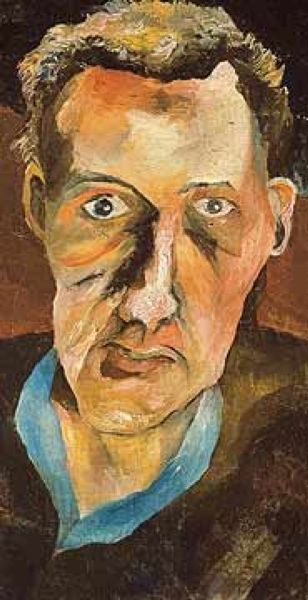  |
Tue, 17 May 2011 Look at this******** ‘Highlighting Dorset's recent achievements in commissioning art and design for the public realm it will use examples from the Jurassic Coast public art programme, projects at Weymouth for the 2012 Olympics and the new Wide Open Space programme of research on context specific, cross-disciplinary art, design and heritage collaborations. Speakers include Minister of State, The Rt Hon Oliver Letwin MP, an architect of Localism, Professor Malcolm Miles, art and regeneration specialist, a speaker from the Lake District National Park Design Programme on art, landscape and heritage in Cumbria, artists Michael Pinsky and London Fieldworks, public art specialist Maggie Bolt, curator of Wide Open Space Alex Murdin, Tom Munro (Manager for Dorset Area of Outstanding Natural Beauty), David Lohfink (Land and Planning Manager for developers C G Fry), Kevin Morris (Policy Manager for the Environment at North Dorset District Council). Featuring two participation sessions “Agora” by artist co-operative The People Speak. This meeting is an initiative of The Dorset Design and Heritage Forum, whose aim is to promote quality design that respects the county's landscape heritage within community planning, land use planning and arts practice.' ********All this leaves me cold. I get emails about this kind of thing all the time. If there were a spark of creativity in a person, to have to channel it through so much planning and bureaucracy would kill it dead. Who becomes part of these things and who or what funds it and for what? What does it all mean??? There seems to be a dubiously supported web of gossamer-weight which apparently creates art and ‘environment’ for the people of Dorset but for which I see little evidence as a resident of Dorset for the last 27 years. Like the little boy who outed the Emperor with no clothes I’d like to do the same but the powers that be seem to have protected themselves behind a veneer of respectability and importance. |
Mon, 16 May 2011 Saturday night was a surprise birthday treat for Simon –something in Salisbury I had booked for a while but hadn’t realised that, Torquay being in the playoffs, a large Sky-TV screen would be a Saturday night necessity. It was serendipity that screen-time was from 5.30pm-7.30pm and the booked thing was from 8.30pm. I found a pub on Crane Street which has large screens showing football and was prepared to show the Torquay game but as I didn’t fancy two hours watching football I went off to the Cathedral where I was just in time for Evensong. Both my sons wore blue choir cassocks and sang Evensong in the Cathedral in the past as part of their commitment to their school choir, Bishop Wordsworth’s school within the Cathedral walls. So, it brought back all those memories and filled me with feelings and emotions. I had, of course, anticipated that I would wander off and draw while Simon watched the football but finding myself in the Cathedral was more a case of its gravity having pulled me there without too conscious a decision of where I was headed originally. It doesn’t get much better than sitting with my large drawing book, listening to Evensong and attempting to give a feeling of the vast vaulting above me, in pencil, on my page. Evensong ended with the hymn ‘All People that on Earth Do Dwell’ which I must have sung countless times in my school assemblies, so I was singing, listening, drawing and being in the Cathedral-lovely. I caught just a glimpse of the boys' choirmaster as the choir left the stalls. Afterwards I gathered up a picnic of sorts from Tesco and went to get Simon for a concert at St. Edmund’s Arts Centre by a singer songwriter called Sean Taylor. You can find him on-line and download some of his songs. Simon loved it –we both did, and although I don’t always get his taste in music I got it right in a big way this evening. And, Torquay beat Shrewsbury, 2-0. |
Fri, 13 May 2011 Drawing. Drawing is useful for many reasons. You might draw a simple map to give to a friend so that they can find the way to a meeting place. If computers really had superseded hand-drawing you might instead have booted up your computer, found a website featuring your meeting place, hoped that it had a map and if it did, convert it to printer-friendly and finally have printed the map. How much quicker it is to draw your own little map! Drawing is the most immediate way of testing an idea. To draw it, to sketch it, to correct it, to play with an idea means it is able to be at its most fluid when drawing it on paper. The pencil moving in your hand has a direct and intuitive link to your brain and thoughts. It moves in your hand almost before you realise you’ve had the idea. Drawing is not limited to line, it can utilise shape, tone, texture and edge. Line is very much linked to ‘mapping’. I can draw with line and in doing so show the boundaries of the shapes and areas. The line does not represent the edge of a shape; it represents the place where an edge may be. If I make an outline drawing of an apple, I show the shape of the apple, but which side of the line is the edge of my apple? Is it the outside or the inside? If I walk around my apple, where is the line which represented that apple? It no longer exists. If I take a piece of graphite, approximately 2cms long and, using it on its side, I create a complete tonal shape of the apple, I then have no queries about where the edge of the apple is...it is at the outer edge of my tonal shape. Here are two simple ways of representing the apple. I may want to describe the form of the apple on a different intuitive level; perhaps I could use line again, but rather than use it for outline, I can use line as with longitude and latitude lines around a globe. I might impose these lines over my tonal apple to amalgamate two layers of information into one drawing. This apple will not look like a photograph of an apple and nor do I want it to. Drawing can be rapid and frenetic or slow and deliberate. It can be stated and negotiated. It can be pale toned, dark, contrasting in tone or texture, many things. As an artist making drawn notes, you want to collect as many ways of marking your paper as you can possibly dream up...and then add to them by changing each one a tiny bit, and so on forever. You are always expanding your visual vocabulary which suggests that drawing, and art, are a language. They are. With your shapes, tones, textures and edges, you are creating something visually cohesive which will resonate in the eyes of the viewer. This is why I have a strong belief in the need to look, to see, to understand what you see and therefore to respond appropriately. The most abstract of images, if they resonate with our own inner blueprints, are aligning with something deep and visual within us. If we are free to enjoy them, not to feel we must judge them on some kind of skill merit or monetary value, we can find what it is that satisfies an inner desire. They can be equally satisfying to create as long as they come from some truth that you want to express. Thank goodness nothing has to conform to anything ‘normal’ or ‘expected’ or ‘mundane’! My advice? Never be prosaic in your painting! Never think of your final viewer until the work is done. Never think of your drawings as having a possible monetary value as you work on them. |
Thu, 12 May 2011 My neighbours’ 19 yr old son has just returned from a trip around the world. Certain that he would be itching to travel again I asked him if he had decided what he might do now he’s home. I guessed wrongly that he would want to return to New Zealand; his NZ facebook pictures were stunning, but what he said surprised me –He said that most of the people he met on his travels had grown up in cities and didn’t particularly hanker to be back in home in UK but he realised how much he loves the place he grew up in; he loves not just England but specifically Dorset too much to want to live anywhere else. He’d like to travel a bit more in Asia where the sun shone and the sea was as warm as a bath, but even more he wants to see more of UK; he knows New Zealand up and down but has barely travelled in this country and is making a start with a trip to Sheffield at the weekend! Cranborne Chase was looking beautiful again this evening; swallows by the dozen, a cuckoo who shut up when I echoed him, evening sun at one end and a waxing gibbous at the other, I spent some time in my shed but as I had forgotten to take my glasses down with me and couldn’t be bothered to run back and get them I’m not sure how the painting went! I find it rather aggravating depending on glasses, but perhaps I should play the glad game and be glad that I live in a time and place where glasses are readily available... |
Wed, 11 May 2011 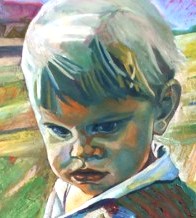 Colour for tone: We’ve been looking at the use of colour for its tonal value. My students have been drawing a piece of canvas ruckled up into very structured folds. Being canvas, it seems to be ‘one colour’ but, as I explain to my students, if they asked me to make a pair of curtains and I made one the colour of the high-lit cloth and the other colour of the cloth in shadow they’d be very angry with me because the curtains wouldn’t match. They had worked on tonal drawings of the cloth last lesson, using chalk on black paper to describe the folds, but this time I asked them to use colour to describe the different tones; for each different tone, use a different colour...but...the colour must of the correct tone for the area they’re working on. I use as an example a painting of Jack as a youngster. He, of course, had clear and regular skin, but with each tonal change across his face I changed the colour rather than mixing up one colour to a lighter or darker tone. If you have any doubts about your ability to see the tonal value of a colour, then take a blue pencil and press as hard as you can to make a dark tone. Then take a yellow pencil and, again, press hard to make as dark a tone as you can. Is it possible to make it as dark as the blue? 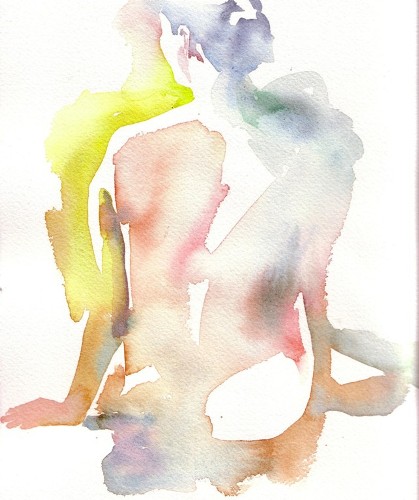 When it comes to watercolour, tone is of the utmost importance. Probably the most useful ‘rule’ is that you can’t paint a light place, you can only ‘reveal’ it. For that reason, I don’t even attempt to match the colour I think something should be, I use the colour which best gives me the tone I want. As Matisse said (and I couldn’t understand this at all when I first heard it) ‘Paint the colour you feel and not the colour you see’. |
Sun, 08 May 2011 So as each day goes by which is another day on from a new and unexpected starting point, one wonders if the future really is changed for good or if perhaps one can find the old future that had been all planned out for so long. The mistake is in the planning –‘live for the day’ might make change easier because, in expecting nothing, life would be a succession of changes which meet, greet and pass us by as we float in our moment. I can’t agree with it though. Everything we know or come to understand is only perceived in reference to ‘markers’ in our lives. How would we know that grey is grey without black and white either side against which to judge it? Sometimes when I want my students to think about tone I ask them to draw five boxes in a row, approx. 3cms square and fill them in this order -1st 4th 3rd 5th 2nd – I ask them to fill box 1 as pale as possible, just within the perception of a tone. Box 2 -I ask them to make as dark as possible. Box 3, I ask them to use boxes 1&2 in order to work out the tone exactly in the middle, between the tones in boxes 1&2. Box 4’s tone is exactly between boxes 1&3, and they use tones 1&3 to help them judge tone 4, and, I’m sure you’ve guessed, box 5 is the tone exactly between boxes 3&2. It creates a row of boxes with a lovely tonal journey from lightest to darkest in four equal jumps. None of it can be done without a future, without planning, without comparison. Years ago a singer-song-writing boyfriend of mine coined the line ‘In order to appreciate the sunshine-You gotta have a little rain’ |
Thu, 05 May 2011   During our time away, three of us decided to do a project each day involving taking photographs linked to a theme. Our first theme was ‘Dark Blue, Light Blue, Middle Blue and Not Quite Blue’. It meant that we were looking with a new eye and a different focus at the things around us, but possibly did not come home with the photos which show a person much about South Africa!  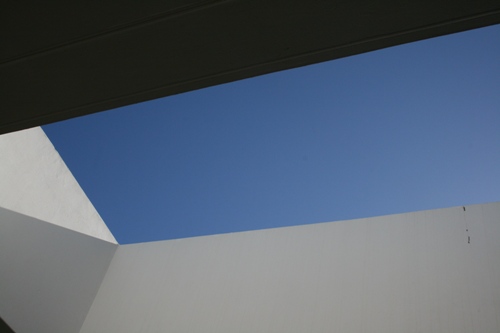 I see a new moon in the sky tonight, a waxing moon, so I lay on the grass, head to the north west, feet to the south east to look at the moon upside down and get a notion of what they are seeing in South Africa on this rising of a new moon -sure enough they see it the wrong way round. Still sad today. |
Wed, 04 May 2011 Sadness: I find myself extraordinarily sad at the ending of the relationship between my son and his girlfriend of three years. Tears are running down my face and the memory of the desolation I have felt at the breaking of my own relationships in the past comes back, not for me to wallow in but because I worry that these two people are suffering from that same desperate vacuum- ‘Vacuum- A space empty of matter’. I guess it is a measure of what I feel for this girl, like one of my own, that have given rise to feelings of such force, a force which is surprising me as I write this. As mother of one of them, is it normal to feel a twinge of culpability? as if I failed somehow to hold it together, or I can’t put things right with a plaster on the knee? Sadnesses like this temper everything; they bring into question all assumptions such as ‘flowers are beautiful’ or ‘I’d like to get up and do some drawing now’. It is so difficult to stand aside; I can’t comfort either of them, I can’t revert the situation back to that old and reliable union, I can’t even say ‘everything will be ok in the end’ because although it will be, at this moment equilibrium is on the far distant horizon. This amazing bright girl, a real ‘get up and get on’ sort of person, always good at being funny, a creative, lively, employable-in-these-days-of- meagre-employment person...may no longer be part of our family and that is very hard news which is grieving me to contemplate. |
Mon, 02 May 2011 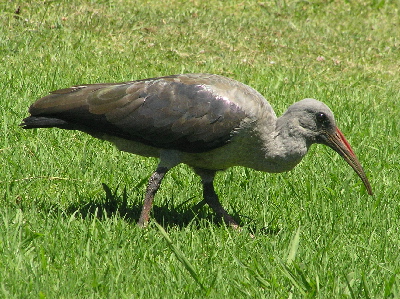 I love to keep an eye on the kinds of birds which are around whenever and wherever I’m away. South Africa is rich in both exotic and ordinary birds. The most noticeable of the exotic in Camps Bay where we spent much of our time were Hadeda Ibis, a funny dumpy bird with a heavy down-curved beak. It’s around everywhere on lawns and grassy areas usually prodding the ground with its long beak so I guess looking for those worms, grubs and things which live in the earth. Defying its weighty look, it flies with big broad wings and honks (haaadeedaaahaaadeedaaa) as it goes often sitting on high roofs or guttering. They seem to be very happy and settled in rural, urban and suburban areas. 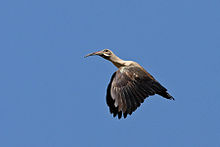 Another bird, a red-winged starling, is around in big numbers. The red wings are barely perceptible until it flies. When it crosses a bright sky you can see the ruddy wing ends as the light shines through. I can’t tell the difference between it and the Tristram’s Grackle, which I’ve seen in Jordan, except that the call is not quite the same. Perched, it looks sleek, dark and glossy. 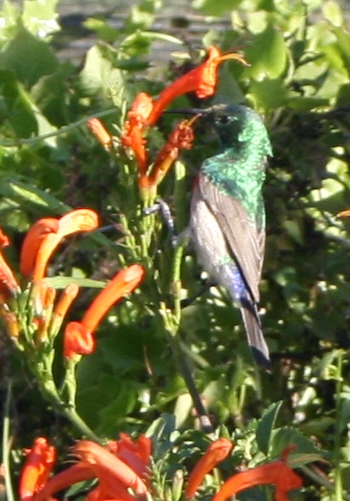 We visited the plant-nursery where I now have such good friends (family of my brother-in-law) -quite emotional to be back there as I hadn’t thought we would be, but Charlie pointed out a southern double collared sunbird, a gorgeous streak of iridescent green flitting through the flower-heads collecting nectar with its long beak, and a flash of red on its chest when it was the right way around. There were more and I’ll catch up with them in time, and I will also catch up with the photographic project we set up between myself, my nephew and my bother-in-law...a new subject each day had us looking at things with a new perspective! 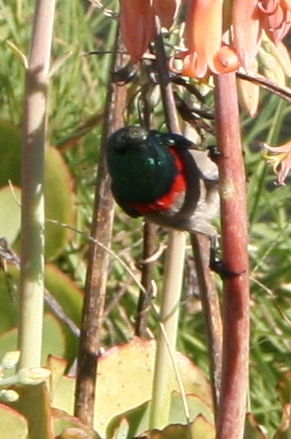 |
Sat, 30 Apr 2011 http://www.youtube.com/watch?v=c6NVIJ-yRoI&feature=player_embedded ........copy and paste link for a short film of a fish eagle (re: today's blog) 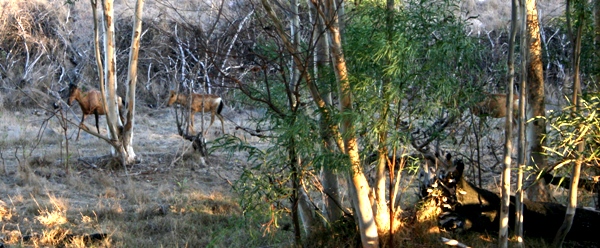 One day in South Africa one of my nephews looked up at the moon and we talked about it. It was an exactly half moon and the circular side of it was to the left of the straight edge. Without thinking I said ‘that’s a waning moon’. We talked about gibbous moons and full moons and waxing and waning moons and then enjoyed the rest of our day. A day or two later we were visiting a vineyard, the Villiera Vineyard. As part of diversification the vineyard has created a wildlife sanctuary through which they drive visitors in sort of open pick-up trucks with bus seats fitted in the back. We were able to see a variety of birds on the 10 dams across their land, and bok of all sorts that either inhabit the area or have been brought in, including springbok, steenbok, bontebok, eland and gemsbok. There were zebra, porcupine, bat-eared foxes and more. One hightlight was a fish eagle which had been sitting on a pole beside a dam but rose leisurely up and across the water as the sun was setting and was subsequently nagged and chased away by a pied crow. It seems the world over corvids nag raptors and raptors bother corvids. It was a moment later that I looked up and was shocked (not an understatement) to see the moon the wrong way round. It had been a half moon a few days earlier and on the wane, but what I was looking up at now was a waning gibbous –impossible that it could have gone from being a half moon to more than half if it was on the wane. It bothered me to the core. I thought ‘have I gone mad? And is the moon really not the way round I think it is?’ I had to put the idea away for the while; we spent the rest of the evening tasting the wines and champagnes which they make at Villiera, and later on, discussing the subject with my brother-in-law we decided that if Orion is upside down in South Africa, then the moon must be the wrong way round.  This is the offending moon... 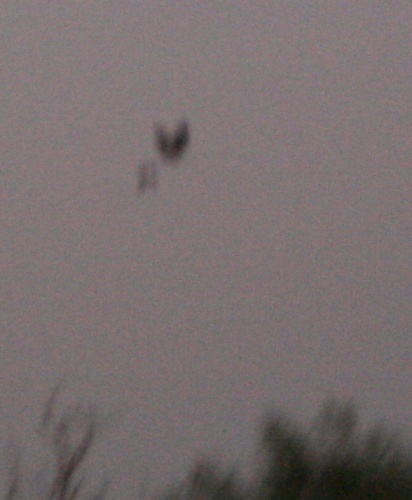 ...and. believe it or not, this is a pied crow nagging a fish eagle. The eagle was enormous. |
Thu, 28 Apr 2011 My daughter thinks this one looks like me... 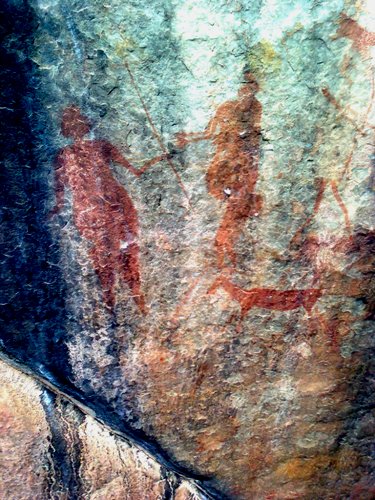 During our time at The Karoo we were looking for Bushman rock paintings, paintings made approximately 500 years ago by Bushmen artists. The theory is that the area was supportive enough for the Bushmen not to have to be hunting and gathering all the time; it gave them time to make art. Some years ago I was in the south of France with my family and we decided to visit the facsimile of the Lascaux caves. The original caves have been closed to all but about 5 people per day; the opening of the caves after discovery and the collective breath of the general public created damaging condensation on the cave walls so facsimiles were made and even these are limited to a maximum of 1000 people per day. We bought our our tickets the day before in the local town and arrived the next day at our allotted time. I’m not sure what I was expecting. I have seen many photographs of cave paintings but when we went down into the belly of the caves, from the hot day outside we felt the cold of the air conditioning, the lighting was dim so our eyes needed to acclimatise, what hit me with a wave of emotion was the size and veracity of four vast bulls, one of them 17ft long, on the cave walls either side of me. I was overwhelmed with the feeling that here I was shaking hands with my direct forebears, and that everything I am driven to do with paint has a direct relationship with what I was seeing on these walls. I was so loathe to leave the cave that I hid and stayed for the time slot of the next group too. Christopher Henshilwood, a South African archaeologist, believes that humans ‘became’ human when they started to make ‘art’. In a cave on his Grandfather’s property in South Africa he found a small piece of ochre mudstone which had been polished and then etched with geometric horizontal and diagonal patterns. This stone is about 70,000 years old and Henshilwood thinks it is the oldest piece of art, carved with design and intention by a human hand and for its own sake rather than for usefulness, ever found. It is a remarkable moment when a new consciousness led humans to make things of apparently no use. The Bushman art had the same effect on me as the paintings at Lascaux. The images are extraordinarily engaging because we find them so relevant to ourselves. We love to peer through people’s windows to see how their houses are decorated, or look back through old photographs which record lives and times, and this is no different. It is our chance to peer directly into the lives of people who lived so long ago and find that they are just like us. One thing I am convinced of is that the people who made these and the Lascaux paintings did it because they loved painting. There may have been other, perhaps spiritual, reasons attached, but it was those who loved to search for the truth of the way a thing looks that made these paintings. 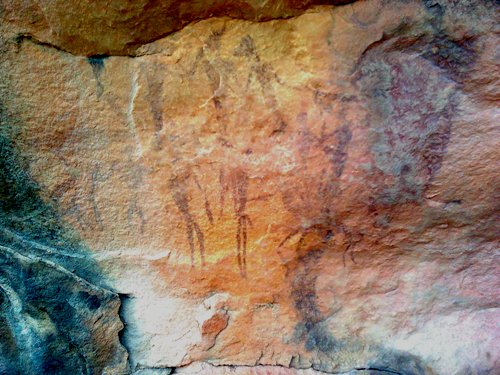 |
Wed, 27 Apr 2011 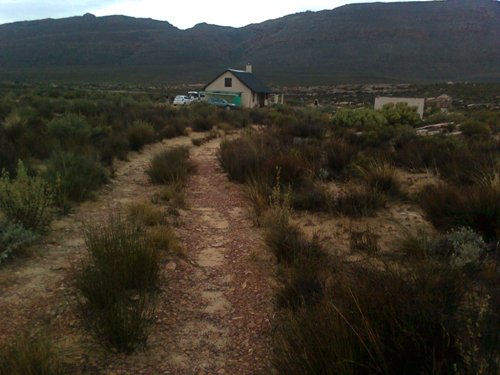 I found this poem by Thomas Hardy. When I mentioned to Simon that I’d found a poem about The Karoo by Hardy he said: ‘‘Drummer Hodge’? I was looking at it yesterday’’. How have I missed it until now? It would have meant less to me without the visceral memory of the landscape but now it adds to the greater picture. *** They throw in Drummer Hodge, to rest; Uncoffined--just as found: His landmark is a kopje-crest; That breaks the veldt around; And foreign constellations west; Each night above his mound. *** Young Hodge the Drummer never knew - Fresh from his Wessex home - The meaning of the broad Karoo; The Bush, the dusty loam, And why uprose to nightly view; Strange stars amid the gloam. *** Yet portion of that unknown plain; Will Hodge for ever be; His homely Northern breast and brain; Grow up a Southern tree. And strange-eyed constellations reign; His stars eternally. *** Hardy wrote this just after the start of the Boer war, a distinctly anti-war poem presenting Hodges as a comfortable and an unremarkable person who paid with his life for a war that was distant and alien. One of the oddest things in the Southern Hemisphere is to see foreign constellations come up in the evening sky. The only constellation we share is Orion, and in South Africa they see him the other way up–forever on his head! 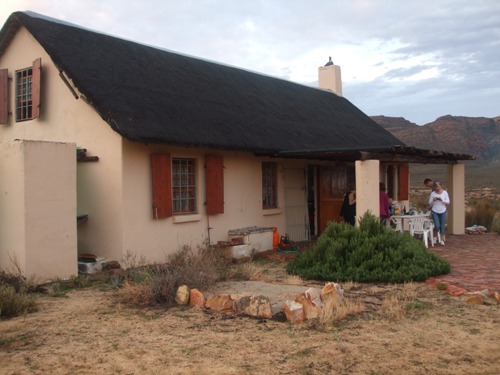 |
Tue, 26 Apr 2011  The Cabin was perfect. It had no running water or electricity. As I approached I could see the roof was thatch and on the inside the structure was apparent –round poles holding roof and thatch over a plain rectangular building with a large fireplace at one end and a kitchen area attached to the main room. There were also two small bedrooms, a loo and shower, and a big balcony/platform area in one corner accessed by a ladder where many mattresses were kept for overflow sleeping. We were a large family group including my sister-in-law and her partner (whose parents have part-share in this cabin, hence our ability to use it). The first necessities were to unlock and open all the window-shutters and connect up a gas bottle which runs a little fridge and stove. Water had to be pumped up from the river into three massive tanks, food needed unpacking and beds needed sorting and making. I did the beds. I like to be part of a group but separate. I like to know what I can do to be useful and then to get on with it by myself. I see this as having a direct correlation with the way I work. I like teaching because I am dealing with my subject but I am in charge. I like painting because I can immerse myself in it; it does not require collaboration or depend on anyone else doing anything else for me. I really love to have ownership of my own mind and thinking, and I’m sure this is why I might seem forgetful at times; I am so wholly involved with my own thoughts that I don’t take in things which are told me. It might be surprising to know that when my mind is totally wrapped up in itself I don’t notice the obvious. That evening we all walked down to the water-hole through the scrub and, as we approached the water, through taller plants and across a small muddy flat. I suppose the rain had soaked the ground so that the quality of the sand (and mud) was different to the way it might usually be. The waterhole is the part of the river which appears above ground. Much of it runs underground. The bit we could see was still and calm but not stagnant, the water was clean. I was expecting it to smell like the lake I swam in as a child in Ireland but it was fresher –no less weedy though. I reckoned I had a little more than an hour before it would be too dark to draw, so when the others left for the cabin I stayed, for a while just to look and then to draw by a smaller water-hole to one side of the large one. These drawings are incredibly precious. I talk about my sketch book as being a ‘bank’ into which I ‘deposit’ my drawings. For ‘drawings’ understand I mean ‘wealth’. They have and are everything when it comes to that particular motif. I can withdraw the ‘wealth’ from my sketch book at any point sooner or later in the future for a painting. Unlike a photograph, which may hold masses more information, your drawing will hold the information for every single bit of your subject that you looked at to make the drawing. For a photograph you might peep & snap and then look away. For a drawing you have to look at many elements and take time and thought to record them. However minimal your drawing may seem at the time it will hold so much more which is of use to you later than a photograph can hold. My advice is, always refer to your drawing; it will have what you need to know. And don’t take general information from it, take specific information from it. Trust it.  Struggling with the water pump. |
Mon, 25 Apr 2011 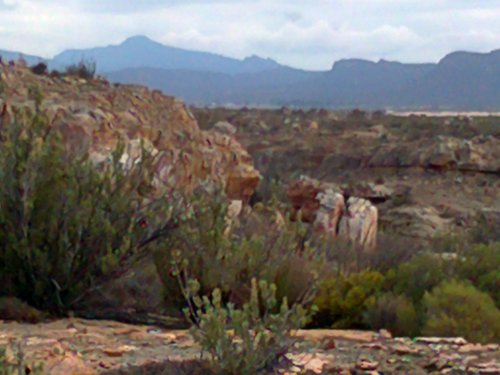 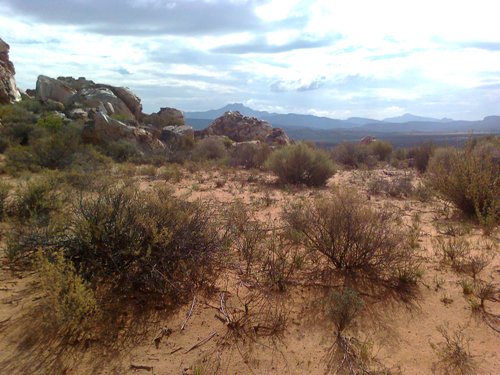 Africa 2011 I wrote this (below) two days ago, and the first two paintings are 1. finished and 2. well under way. From this piece I have the titles too, 1. 'I came to the Klein Karoo in a Deluge' and 2. 'I Stood on that Rock and Saw Myself'. I was amazed when listening to Karen Blixen's 'Out of Africa, first episode today on radio 4, to hear her say that she saw the wide scene and vast sky across to the mountains in the distance and she knew why she'd come to Africa -she said 'I Saw Me'. Just 30 seconds before I heard that I had written 'I Stood on that Rock and Saw Myself'.................................................................................................................................................................................................................................... I came to the Klein Karoo in a deluge; it was as powerful a rainstorm as I had ever been in. Our cars bumped along the remains of a track until we got out and let the drivers continue alone to avoid any more scraped exhausts across big sandstone boulders. The smell which hit me on climbing out brought my childhood racing back. My Mother had a precious little tub of ointment, given her by her Grandmother, called Pomade Divine but we in our childishness called mardivine. It had a rich oily-herby smell and was sparingly spread across knee and elbow wounds. As far as we knew this was the only tub in existence and no more could ever be got. It was precious to us. We knew of no-one else who had it and I’m sure part of its healing quality was based on our belief in it. A placebo maybe. A memory from childhood, most compellingly. The rain had stopped, but perhaps it’s force had unleashed smells from the surrounding mass of scrub and bush, and even more, perhaps some of the ingredients for the ointment had come from this far romantic place –in keeping with the reverence with which we held our mardivine; certainly I loved the place immediately. I climbed out of the car and instead of following the other walkers moved off through the scrub to a large rock which I could climb. The ground between the bushes was white sand. Ants were everywhere. Anthills, anything between 8ins and 2ft tall, grew up between the bushes and if, like me, you poked the apparently innocuous mound with a stick to check its texture, ants rush out and swarm over the breach. I climbed the rock and looked towards the cabin away in the distance. I could see the cars arrive, I knew there was a lot to do to get everything ready but I didn’t want to extract myself from the newness of this view and my part in it. For that moment, as I sucked in the oily air, it was all me. It moved like a film through my receiving brain as I turned slowly round the full 360 degrees. Because it wasn’t the burning hot sun we’d experienced earlier in the day and the sky was now filled with a blanket of pink and blue clouds, the whole vast scene seemed gentle and intimate. The smells were sublime. The bushes, like a collection of alizarin, sage and olive lollipops, receded perfectly in ever decreasing sizes to the horizons where they met the huge mountains surrounding this wide valley. My eyes were like fat lenses, bulging to take it all in and I could feel my brow furrow as I mourned my departure before I’d barely got here. Finally I walked to the cabin, my legs scratched and wet from this exotic scrub. 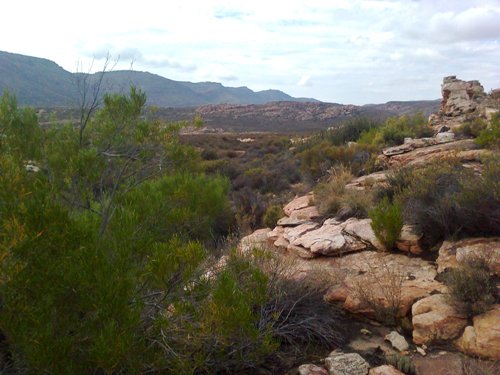 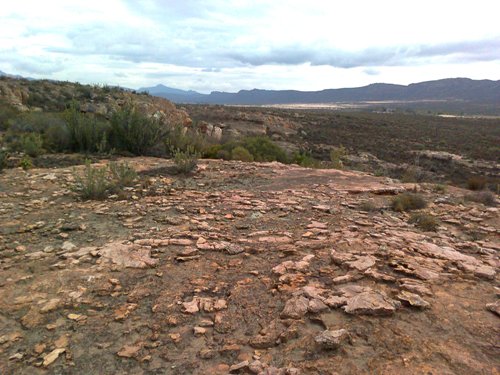 |
Wed, 06 Apr 2011 On Friday we're off to South Africa. I'm taking camera, drawing/painting stuff. Really looking forward to seeing that landscape again and all our friends who live in it. It'll be good to feel we're right at the bottom-end of that vast landmass...they, on the other hand, may feel that they are on top of the world and we live on the bottom of it...what a thought!!! That couldn't possibly be right...could it? So here are some pictures from my stroll around the bottom of the world last Monday morning where I also saw a pair of swallows -the first this year, meaning summer is officially here as it was a pair of swallows, not just one! 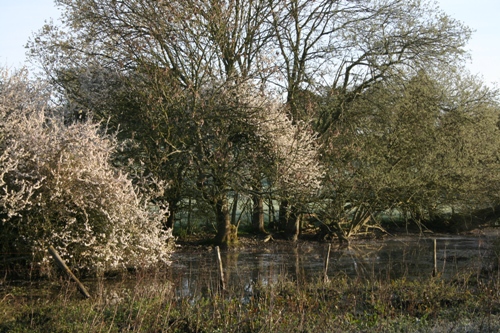 The Blackthorn was in flower everywhere. 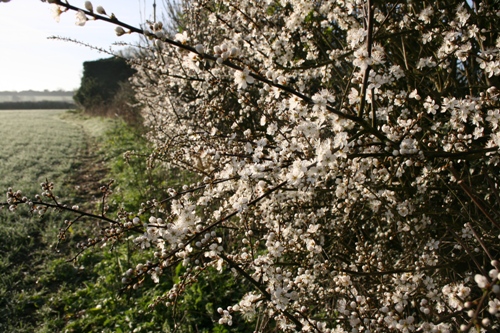 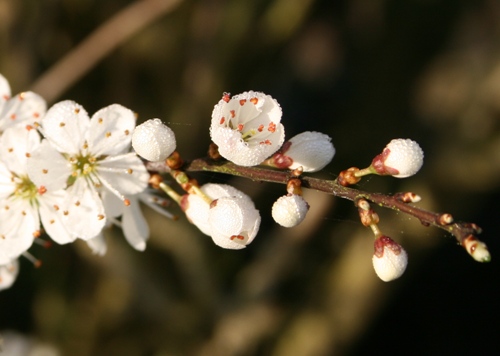  I was wondering what kind of moss this might be so due to it's look I put 'Star Moss' into google and sure enough it's official name is 'Star Moss'...Fab!! |
Mon, 07 Mar 2011 The last couple of days have been absolutely beautiful, clear blue skies and (almost) warm sun! We cut back loads of hedge from the garden yesterday and the day before, so that the hedges where Colin lives won't collapse. Some of the cuttings went onto the compost and some we burned in a bonfire bin from which the smoke created wonderful light patterns as it blew through the garden. It showed clearly the eddies and flurries of the wind which was coming from the the north.  Plum tree (Victoria).  We have a pheasant (Mary has called him 'Dinner') who visits our doorstep every day, probably because I put seed out for him. I caught him head down, wedged in this large flower pot and couldn't work out why until I saw that one of the Buggy-Fat-Balls had fallen off the main bird table and into the pot. Dinner was enjoying the feast  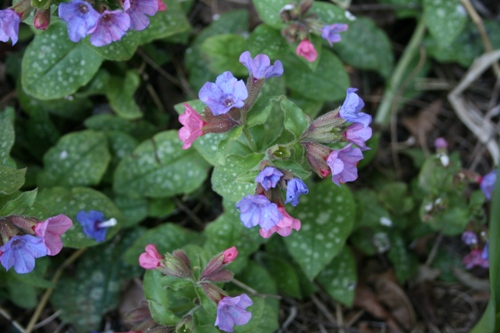 All around the garden little clumps of Lungwort (Pulmonaria) are flowering. It was called Lungwort because the leaves look like the inside of a lung. IN the old days it was thought that plants which looked like part of the human body n some way, were useful in treating ailments related to that part of the body. Today I drove to Salisbury to collect George from the station. My viewing tally was two large hares, a lapwing and a bit of black-bin-liner caught on a barbed wire fence which opened it's wings and took to the breeze. It turned out to be a lovely velvet-beaked crow; he tucked his feet tidily up under his body and just lifted off the fence. |
Sat, 05 Mar 2011 Finally, a week after we're home, I've downloaded the last Exmoor pics from my camera. On the last Friday I joined the others for a long walk beginning at Dunster, home of the castle. It was full of wanderings through a wide variety of landscape; hills, valleys, woods, moor, agricultural etc. We were following a 'walk' from Bridget's book; Bridget sticks rigidly to the instructions, reads carefully through every detail but made a slight mistake in thinking that a much mentioned village (Timberscombe) was one we were supposed to go through. It meant that in trying to fit the instruction to the assumption we went miles off-track, all the while hoping for the comfort of the pub at Timberscombe which we finally reached after quite a hike...we staggered up to the pub door at 2.25pm desperate for a drink and something to eat...but the rotters told us they close at 2.30pm and they could neither furnish us with drink nor food!!!! We were rather miffed, and not relishing the strenuous walk back up a steep hill and through a very muddy wood to get back to Dunster, we asked the advice of a chatty local woman and were told about an alternative way to Dunster along a narrow road just below steep wooded hills and with a some cottages and stables along the route. It was a gentle, relaxing end to a long walk and in Dunster we had tea and cakes in the old Victorian school house. Note: Give Timberscombe and it's pub a miss in future. 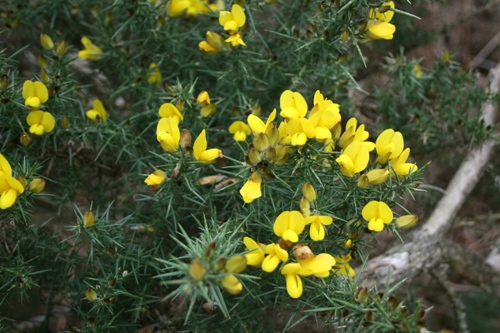 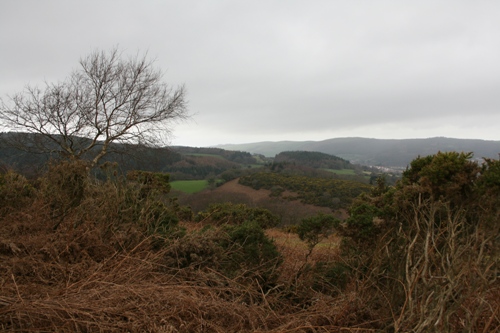 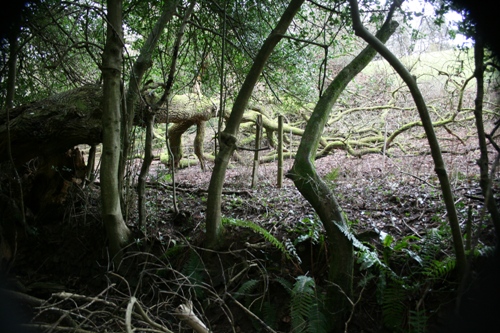 Fallen Giant 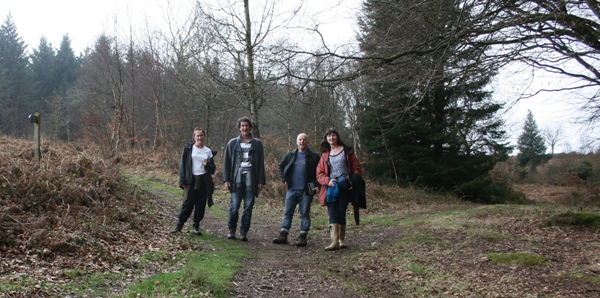 Funny Group |
Thu, 03 Mar 2011 Thursday 24th: A very lazy start with two cups of tea before I get out of bed. All these past years we’ve gone to South Molten Market on Thursdays but today we’re doing something different. The others are walking around the Porlock area and I am going to take our car and head off somewhere...maybe the place I drove to the very first day after I passed my driving test 34 years ago, Brendon Two Gates. From my bed...it looks a little less misty outside; maybe the sun will shine today. We are invited to eat down at the farm tonight, we’re doing pudding, baked apples with sultanas and honey as the farmer is on a diet! I hope he’s not unhappy at my revelation! Either the apples or the diet! Later: I went up to Brendon Two Gates, I found the gate where I parked my parents’ old Morris Oxford which I drove up there all those years ago and I felt the excitement I’d felt then. Either it’s the remembered feelings from a long time ago, or the feelings belong to my normal relationship with Exmoor, particularly the open moor where for miles into the distance you can see layer on layer of scoured empty moorland. It’s a difficult challenge to get the feeling onto a 2D surface. I parked, headed over the first layer of moorland and was amazed to see and hear larks singing and skittering up into the sky all around me. I tried to make a little film with my phone’s camera but it was so raw all I can hear on playback is the crackle of the wind. I remember as kids we came up here on a family walk one Sunday, we parked, wandered down a little stream cutting to the first valley, had a picnic from a lovely picnic-basket, tucked it carefully under a bush to retrieve later but at the end of the day came back up the wrong cutting. It took a while to find the car and we never retrieved the basket...so somewhere near here are the remains of our Sunday lunch in an old fashioned picnic basket. My day was lovely, solitary, walking, sketching, painting back at the cabin later. We ate at the farm, a happy, cheerful jovial evening, good pheasant and mash potatoes, baked apples of course...and cheese. 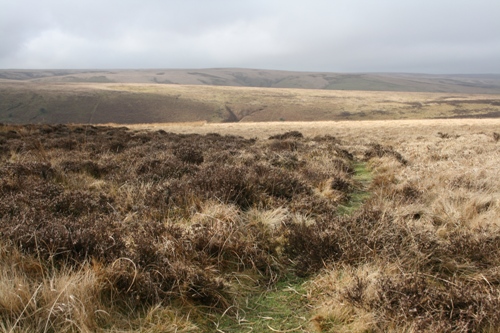 That first place I came to with my painting things all those years ago... 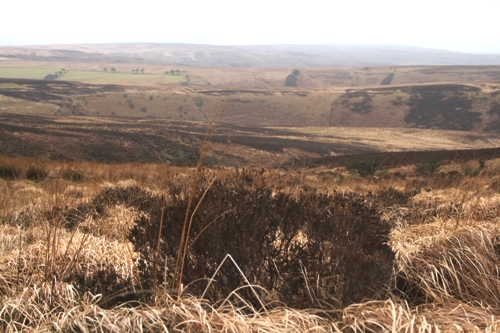 General area of the lost picnic basket. 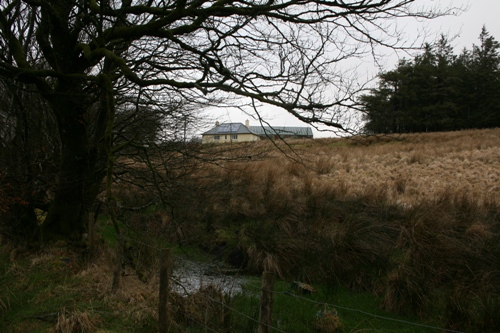 This is my favourite house on Exmoor (note the big studio-size barn behind it)... 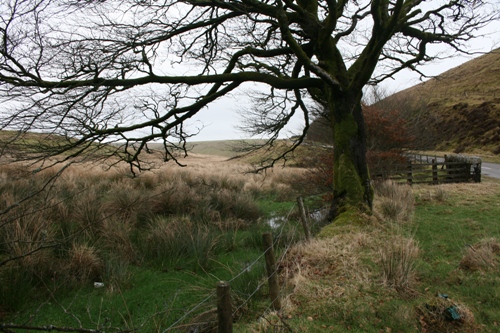 ...and this is the road from my favourite house down to Simonsbath. |
Wed, 02 Mar 2011 Wednesday 23rd: Simon whizzed over to Minehead this morning and so dropped me off on top of the damp and misty moors again. I was back at the cabin before he was back. There were various plans; Bridget’s friend Bridget was coming over with her dogs, to walk, and one of Dave and Bridget’s sons and a friend were coming to join us. I knew they’d be leaving late to walk, and again I decided to stay here and walk on my own. Back at the cabin things changed a bit, Bridget was late because the bridge at Simonsbath is down creating a long diversion, and the imminently arriving son‘s friend had trouble at home so they didn’t come. By 1pm the walkers left for their walk and I painted for a while. Then I set out for my own lovely scrambling, rambling walk. I made no plan; I went wherever the clues led me. After all the years of rambling here I encounter different things every time. This was a heart-thumping hill walk with a good deal of skidding and toppling down the steep slopes. I got back after about three hours and still had time to paint before the others returned. My turn to cook supper...spag bol and loads of salad. Wine, telly, news, updating this blog on a word doc. 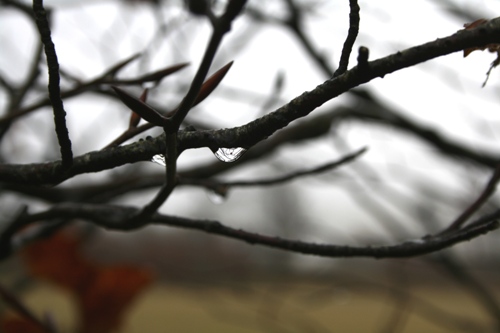 Beech buds 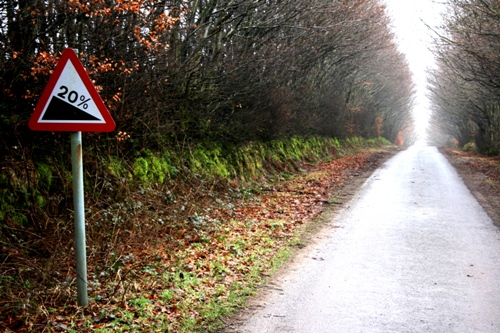 I was trying to work out how to describe the steepness of this road and realised the sign does it perfectly! 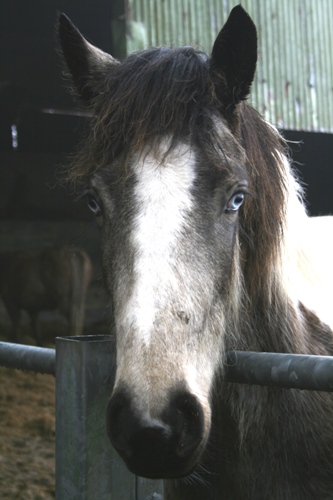 I met this beautiful horse with blue eyes...and... 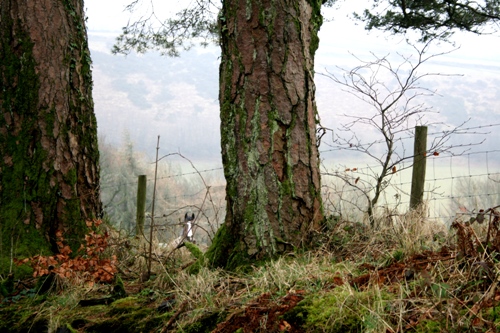 ...another curious horse in this field. Later: Much warmer tonight, fire lit but left to die down unlike previous evenings when we’ve kept the fire well fed. I’ve been meaning to do all sorts of work/drawing/mixed media etc. but other than the small inky sketches in my little book I find myself using almost entirely watercolour, and as, by policy, I’m doing exactly what I want to do...that’s what I’m doing. I’ve read a few articles about the watercolour exhibition at Tate Britain, but in not one of them do I detect any understanding of the nature of watercolour or the notions of working with it, rather like AGD’s BBC ‘Culture Show’ article I blogged about earlier. When I get home I’ll go and see the show and write my own essay. I am rather staggered that nobody talks about the process of watercolour, I don’t think they feel confident, or even know. They do a lot of talking about the images, the colours and the ‘glow’ but not one of them seems to have any idea about the beautiful logic behind the process of creation, and nor, from what I see and read, do some of the artists represented. |
Tue, 01 Mar 2011 Tuesday 22nd: Today is rather different (although still damp and misty). Simon has bought us tickets to travel on the steam train from Minehead to Bishops Lydeard near Taunton. The station at Minehead (and all the stations along the line) are exactly as you’d imagine a station from 50 years ago. Even the tickets are like tickets of 50 years ago, little rectangles of solid card. The ticket collector walks through the train clipping them with an old fashioned clipping machine. I went to look at the engine before we got on and climbed up on board to see closer. The fire box had a roaring fire in it already, like the bright pit of Hell in a huge metal box. There was enough coal in the back of the engine to run my little wood-burner (on its multi-fuel grate) for a whole winter. The engine driver asked me where I was from and didn’t expect me to say ‘Taunton’. The train travelled along the sea front, through Blue Anchor and Watchet, making all the proper steam-train noises (chug chug clackety clack parp parp) but the mist was too thick to see any sea. It turned inland and travelled south alongside The Quantock Hills where I spent plenty of time as a child and even once hunted with The Quantock Staghounds and the man, Commander Wickham, who ran the stables where my sister and I worked. The Quantocks were looking particularly beautiful; I think in all the years that I haven’t been there I forgot how lovely they are. We stayed on the train to Bishops Lydeard and when we got off had coffee and Eccles cakes at the platform cafe; big old gloss-painted wooden benches, milk churns and trailers, post card stands with vintage postcards and beautifully kempt and colourful station flower beds. Quick turnaround...we got back on the next train out! But we broke our return journey at Watchet getting off at the station which overlooks the seaside town to wander through the narrow streets and look for a pub to have lunch. Watchet’s claim to fame is that Coleridge might have written some lines of ‘The Rime of The Ancient Mariner’ there or based his mariner on a man from Watchet. A statue stands above the marina of a man with a crossbow at his side and an albatross slumped in his arm. As I was on the waterfront looking at the boats, a train left the station for Taunton, blasting its horn and completely engulfing the station in its velvet white steam. Back to Minehead for us and an entirely sleepy and soporific last leg of the journey it was. By the time we reached the cabin it was evening. On the evening news...updates on disaster at Christchurch in New Zealand and extraordinary goings on in Libya...keeps me riveted so that I have the radio on throughout the night to listen.  Train at Minehead Station 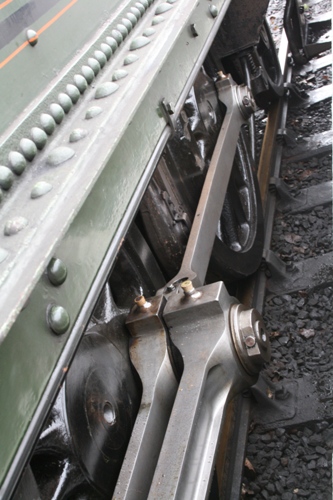  Boats at Watchet 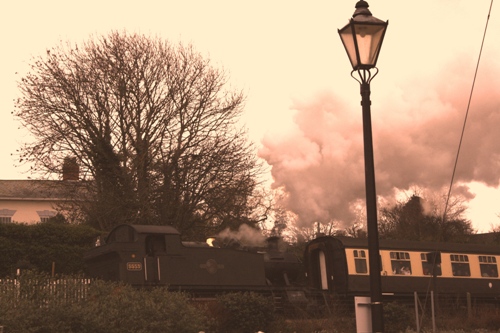 Train Leaving Watchet Station |
Mon, 28 Feb 2011 Monday 21st: Some friends of Bridget’s come today and everyone heads out for a walk. Their plan is to drive a way, walk and then eat lunch at a pub called ‘The Black Venus’. Tempting though that is, I decide to stay here and go out around the farm on my own walk. It was a lovely walk, not in any way a straight line but one way and then the other traversing the hills down into the valleys and then up the other side until I find myself on the moor side of Sparcombe water, scrambling through and on top of those beech banks. All the while I’m thinking ‘containment’. In the very olden times it must have meant the beginning of ownership. By containing livestock you ‘own’ it. The more you own the richer you are, the more power you have to feed yourself and your family, the bigger a family you can support and so on until you get right down to the well-stocked charity shops of Dulverton thanks to the well stocked farms of Exmoor! I cross back down to the valley bottom, it’s an incredibly steep drop in places and quite a scramble, I depend on overhanging beech branches to fall into, but I love it...across Sparcombe water, up, over and back to the cabin via the hill behind it. I know the others are away for quite a while giving me a long and happy time with the paintbrush extension on my right hand. 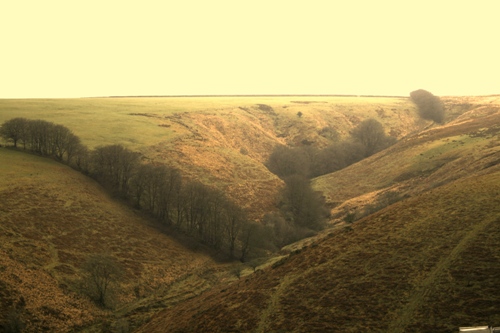 Ram's Coombe 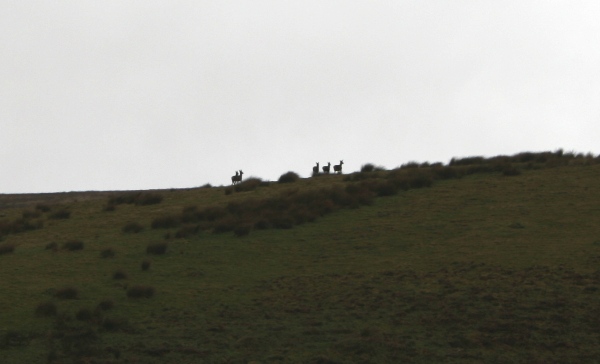 Red Deer disappear over the horizon. |
Sun, 27 Feb 2011 Sunday 20th: The others, by habit, head to Minehead (of Butlins fame) on the Sunday of our week away. On their way they drop me on the moor so I can walk back to the cabin. There’s a low mist this morning and very little view. It’s cold, damp and smells of Englishness and old fodder. I have my new camera and enjoy looking at things close-up. Although it’s a heavy wet mist and Simon was anxious about me getting lost, I know the area like the back of my hand and don’t have the slightest worry that I might not know well enough where I am to be able to make my way back. A project slowly develops in my mind, linked to the containing of wild places; how are livestock held in, and wildlife held out, of the wild places like Exmoor? 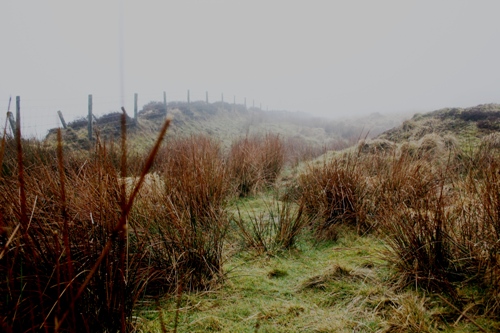 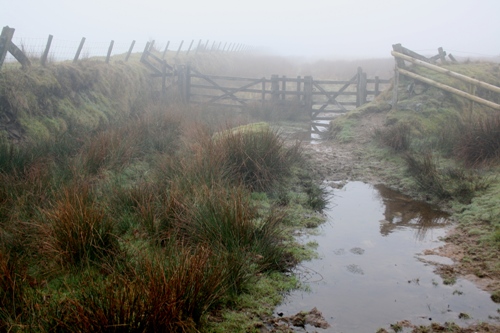 Exmoor is criss-crossed with ancient man-made dry-stone banks. The banks are planted with beech trees which grow huge, and over the years to a greater or lesser extent, are cut-and-laid to thicken the resulting beech hedges. Over the years the banks gather mud, clug, lichen, bracken etc., which completely covers the old stone-work. The beeches become older and more tangled and these banks create boundaries which hold in the livestock. The farmer often adds to this barbed or plain wire fencing on plain fence posts stretched along one side of the banks, particularly the banks without beeches. These fences lean out from the bank towards the moor side, I guess making it very difficult for a deer or stag to leap or cut through. I photograph and make small quick sketches, which is tricky in the damp drizzle, but these sketches are helpful out of proportion to their size when it comes to making a painting from them. I get back to the cabin, and before the others get back I have time to spread out across the table and paint. 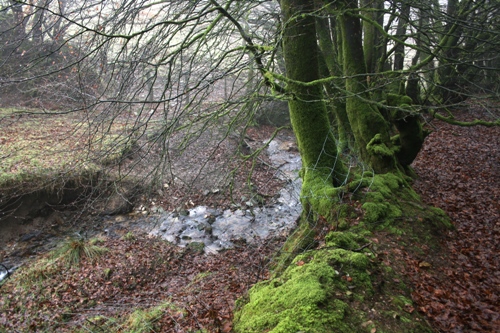 Where Sparcombe Water rises. 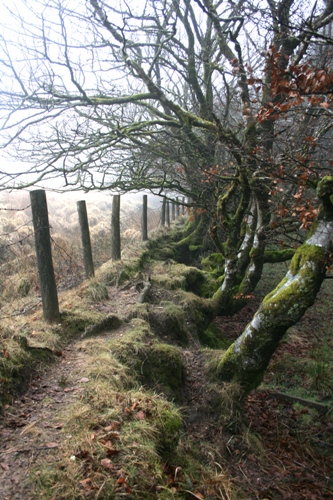 Beech bank between the moor and Sparcombe Water. Saturday 19th Feb: Our first stop on Exmoor is almost always the Red Lion in Dulverton where we meet up with the friends with whom we share the cabin. After a drink -Exmoor ale- and lunch, Bridget and I usually check out the charity shops...a good class of person in Dulverton (well heeled) means a good class of charity shop. I saw some as-new, unworn woollen shooting britches, reduced from £119 to £30. I was tempted to get them for Jack but thought better of it. I was also checking the trendy shops of Dulverton for Crabtree and Evelyn hand cream, by special request, but I can’t find any anywhere. We don’t get to the cabin until about 3pm but there’s still enough daylight for me to go for a walk, and that’s what I do, with my new camera and leave the others watching a football (or was it a rugby?) match. It’s lovely drab Exmoor weather. Good clean damp air. As I set off I bump into the farmer, his wife and their five sheep dogs. I take several pictures; I’m convinced one of the pictures will be their Christmas card. 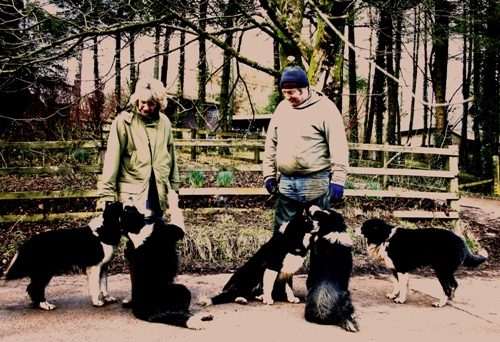 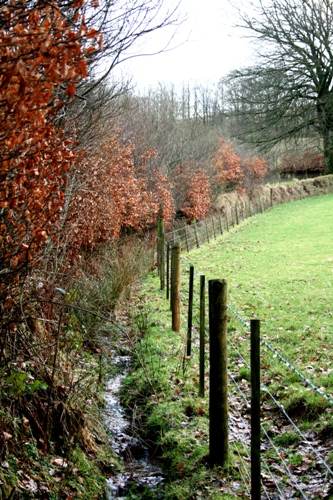 I head down across the Exe and follow it upriver for a while towards the place where it’s crossed by an upside-down V-shape wooden bridge, and although it’s shallow enough for wellies I cross via the bridge to an area planted with thousands of new trees, mixed hardwoods, by the farmer. For me the pleasure of walking around the farm is that it’s so mixed. There is The Exe of course, but many smaller tributaries which flow into it. There is old woodland and new woodland, there are the typical Exmoor Beech banks some huge and overgrown, some recently cut-and-laid and tidy. All the Aberdeen Angus are gone for the moment but sheep are everywhere. The open moorland is close at hand and very accessible. Today as the light is fading I continue up the steep hill above our cabin rather than to the moorland. It wouldn’t be a good place in the dark with thick cloud, but it is wonderful to look across to. Ahhh it’s great to be out and free, for a week of indulging in just exactly whatever I choose to indulge in...which is mostly a permanent paintbrush extension to my right hand. 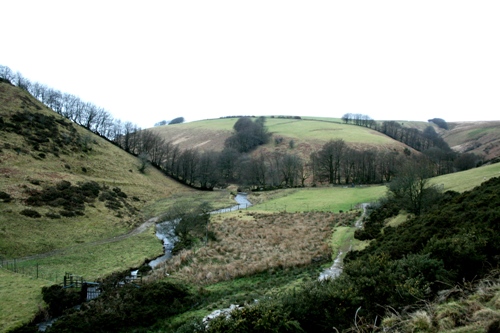 Exe, upriver through the Exe Cleave. 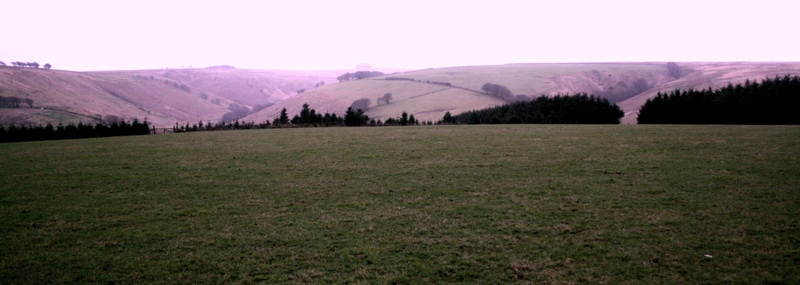 Exe Cleave and Ram's Coombe. |
Sat, 19 Feb 2011 I'm off to Exmoor for the week with my new arty camera, and all my painting stuff. As there is no internet connection, and far to much happy social eating, drinking and scrambling across the moors...I won't be blogging until we're back. I'm leaving a son here to ensure the sparrows have their buggy-fat-balls on the bird table each day. So, here's looking forward to a week of lie-ins, of rolling out of bed and into wellies/walking boots and heading out with all my expressive stuff on board. The cabin is in the middle of Exmoor, yards from the river Exe, life on the doorstep. I heard a scientist on the radio recently saying that human consciousness is part of the reason for our evolutionary success -we all have this fantastical internal world which we desire to feed and nourish, it's what makes us want to get up in the morning. I guess animals get up because the feeling of hunger nags them...but surely a faithful dog is a little closer to consciousness than that? |
Thu, 17 Feb 2011 I watched Andrew Graham Dixon on 'The Culture Show' taking a group of students to Tate Britain to see the new watercolour exhibition. He wanted to blow away their pre-conceptions about watercolour being rather dull and unfashionable. The students certainly came up with the old mis-conceptions that watercolour is boring, weak, pretty, for amateurs etc etc *yawn*. Initially what AGD took them to look at were the botanical-type exhibits of plants and birds. This served to show them that watercolour was used in the old days for illustration. He took them then through the illuminated manuscript section, more illustration. They saw Turner who was working with fresh strokes of paint through damp paper...not bad, and Andy Goldsworthy's page across which a snowball had melted and delivered it's sediment and detritus...fun. But...his most inspiring moment was when he arrived at a painting by Eric Ravilious. Here finally he had come to a painting where the process of watercolour was exquisitely understood by the painter. Ravilious knew how to perceive what he was looking at in the language of light and dark. He knew that a light place could not be 'painted', it has to be revealed by painting around it. In other words a painter in watercolour must be more aware of the shape he or she DOESN'T paint than the shape he or she DOES paint. I think AGD forgot to place this utter gem of information in the students' minds. The use of watercolour is so wonderfully deeply counter-intuitive and challenging; one of the students referred to 'those lines' on the painting. Watercolour is NOT a medium of line, it is a medium of shape and edge, and of tone built by layer. Three layers = darker than two layers..you see? a perfect logic. The edge of a shape is either hard or soft or a combination of the two. There is the concept of 'lost edges' where the area of one thing flows into, and becomes part of, another thing until the moment you decide that one side of the lost edge (i.e.a shadow beneath an apple) is darker than the other, and so the darker side takes the next layer of paint and creates the missing edge (i.e.between the apple and it's shadow). In not talking about these fundamental elements of the use of watercolour, it stikes me that AGD has dumbed down to reach students whose minds might REALLY have been blown if they had had just the beginnings of the notions of working with watercolour. Watercolour is a luminous medium designed to let the light shine through the paint and onto the surface of the page from where it bounces back THROUGH the layers of colour and into our eyes. IF ONLY the arty-clique would take it seroiusly...perhaps they're a little nervous of it. Maybe, if they take courage, they might one day be as good as the amateurs!!!! 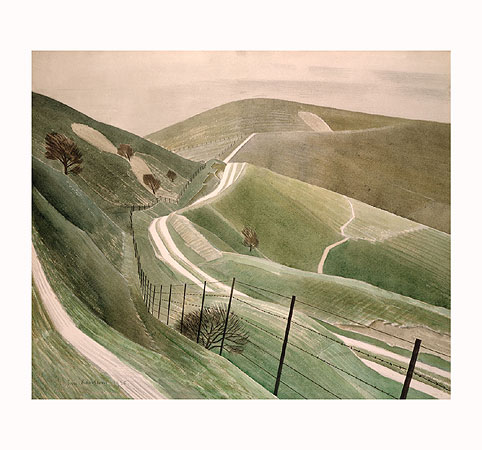 Two paintings by Eric Ravilious, Chalk Paths and Firle Beacon. Working sketch, the kind of sketch from which I'll make a large watercolour. 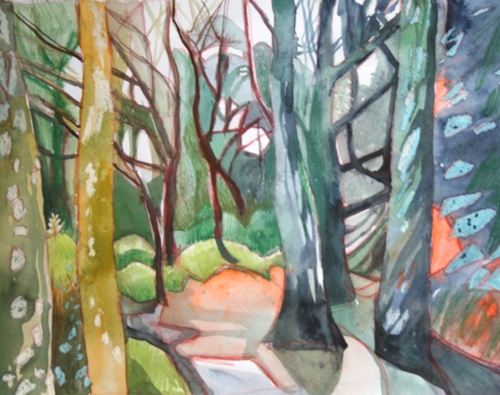 Barrow Hills, Blackwater Stream More large watercolours, various subjects, all very recent and some re-working of subjects.  River Allen at The Horton Inn (re-working)  Apples 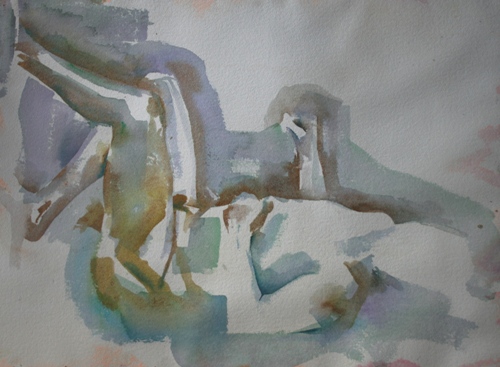 Life Group, Sleeping Man |
Sat, 12 Feb 2011 The Garden Awakes... 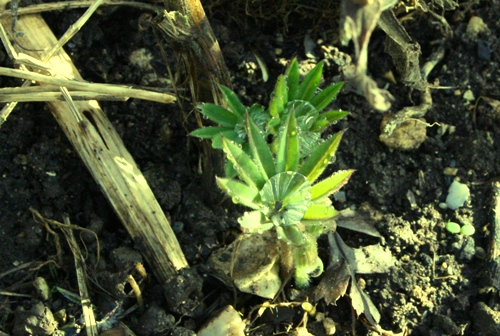 Lupins  Hyacinths and... 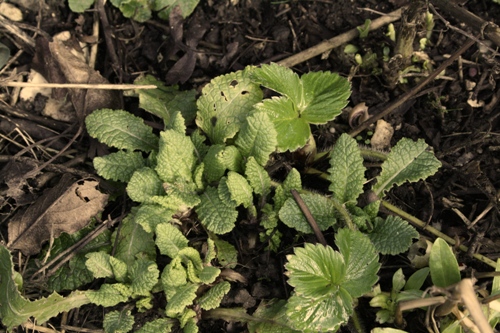 Primroses. I can't go without talking about Egypt. I was certain, until yesterday, that Mubarak was laying a powder trail; a man like him can't resign without harming his dignity and I thought revenge for a man like him would be imperative. It seemed to me the best revenge would have been NOT to resign, even in the face of such hate and opposition, and by remaining at the top he would bring about violence and possibly a civil war of sorts among the people and utter instability. I was (possibly) wrong. Perhaps even a man like Mubarak feels a loyalty to and a love of his country and people...he was just delusional for a while in thinking they wanted him. OR...did the army force his hand? with a threat from USA of the several billion $$$ per year ending? I asked my good friend Talat, a Jordanian who HATES talking politics, whether he thought it would change things there and he said...'...Maybe...'!!! That was all I got from him! Anyway, this sunny day full of the promise of spring and then summer, and the wonderful (tinged with apprehension) feeling for Egypt is prompting me to go and stretch up a huge canvas...the idea is growing in my mind and I shall say no more! The garden is coming to life. When I got downstairs the sun was streaming through the dining room door, and as my favourite place to sit is at the dining table where I can look along the length of the garden to my shed, it was a particular pleasure to do so with the door wide open...first time this year.  Once I 'd done the things I'd needed to do (write cheques, pay bills, file things) the view drew me out with my camera to find the things that had woken and the things waiting to wake. One of the comforting things I found were clouds of insects hanging in shafts of sunlight, but also these snowdrops which have grown fantastically in the last two days.  ...and there are more dotted all over the garden. My students have been talking about their Hellebores flowering, so I had to check mine, but as we are out of town and high up I'm sure things emerge later here. I was delighted to find a few flowers pushing out on sturdy stems: Owen Way if you're reading this...here is one of the Hellebores you gave me. 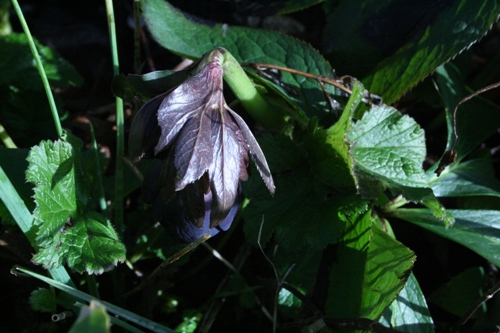 ...lovely lovely wine coloured flowers. I always see pansies as fragile looking (looks are deceptive) but loyal flowers, they soldier on all winter even with a dumping of snow on them and then they pop back up once the temperatures rise even the smallest bit. All around this one the tulips and grape hyacinths are just beginning to show. 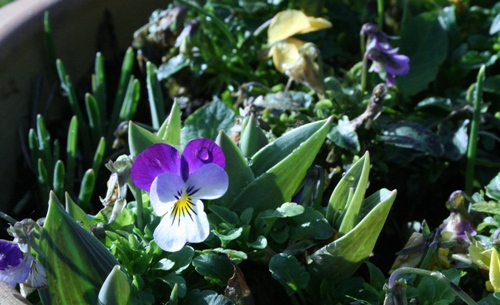 |
Tue, 08 Feb 2011 The River Allen; I made the original sketches for this painting to help me with the look of a river for the Wetherspoons commission. The river is between us and Broadstone, but the commission required a painting of a deeper river than exists any more in Broadstone. It meant a little 'weaving' of various images. Watercolour and oil pastel again today; part of the same commissioned series. 30" x 22" 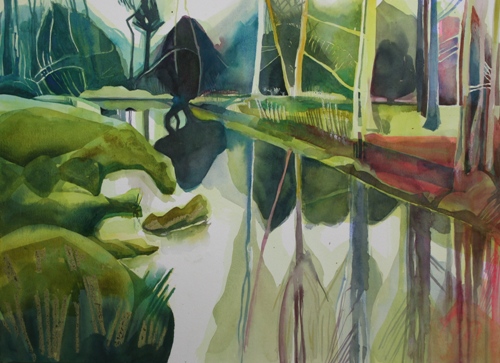 This is what I'd call a 'working watercolour', in other words I will probably make a larger oil painting from this motif. Life drawing tonight, I may work large. |
Mon, 07 Feb 2011 I've been using watercolour today, and some oil pastel resist. I'm never sure that the oil pastel resist works well with watercolour; possibly the oil pastel marks are too clumsy compared to the crisp edges you can achieve with watercolour...but I really enjoyed myself all day.  This is part of the series which has come about thanks to the recent commission (to be delivered Wednesday, I have only recently discovered it's a commission from JD Wetherspoons for a new Wetherspoons opening at the end of Feb.). This one is 'Blackwater Stream' Here we are...the first day of 2011 that I have put washing out on the line...yippeeeee!!!  And by all accounts tomorrow's weather will be even more washing-friendly, so I 'll have to make sure I do a load of it. Could it mean clean sheets all round?? |
Mon, 31 Jan 2011 Commission finished...I think. 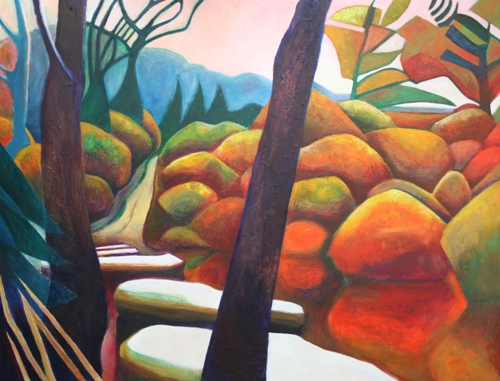 Of course I think it's perfect but whether or not the commissioner agrees is the reason why I'm normally a reluctant commissionee. Watch this space... |
Sun, 30 Jan 2011 Self portrait (Shadow-Self), with Penbury Knoll on the far horizon. Penbury Knoll is the hill above Pentridge, known as 'Trantridge' in the Thomas Hardy novels (Tess of the D'Ubervilles, particularly). 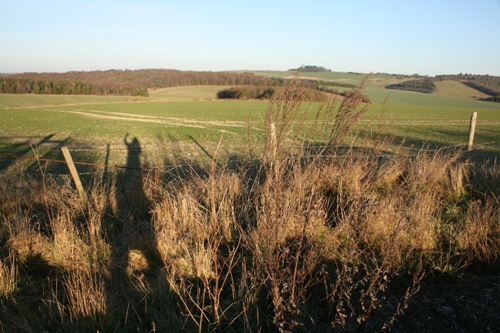 Later in the day, out on Cranborne Chase I saw these deer enjoying the sun. It's Roe deer that live on Cranborne Chase as opposed to Red deer on Exmoor. 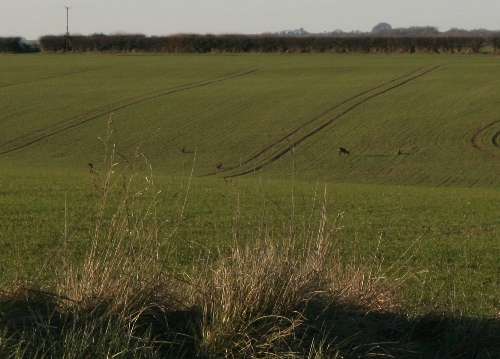 Cranborne Chase is littered with Iron Age burial mounds; it has the largest collection of different types of Iron Age burial mound in one place, and I went looking for some today.  Note the two burial mounds on the horizon. I found the following quote on a Visit UK website...I'm not sure I wholly agree with it!!! "The north-east of Dorset, encompassing the Cranborne Chase, has a sinister atmosphere. The whole area is dotted with burial mounds and has a long history of brutal struggles for existence. For centuries men killed men in this bleak corner of the county and when they were not so engaged, they killed the animals that roamed wild." 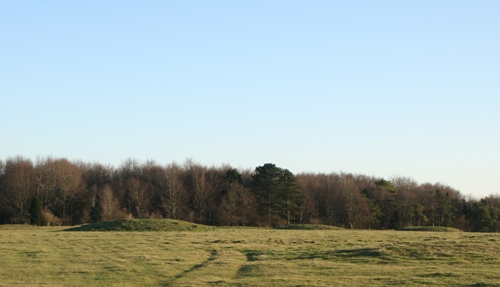 The burial mounds (also known as barrows) are about 5500 years old; this Roman road not so old at about 2000 years old. Imagine...the burial mounds were ancient when the Roman road was built! 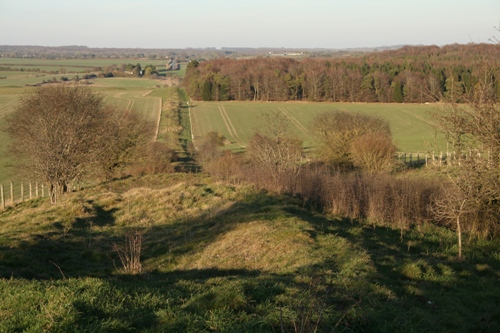 If you follow the bank of the Roman road, you can just make out in the distance where it joins up with today's main A354 to Salisbury. The Roman road has a name, The Ackling Dyke. Its always a relief when the winter river comes up, which it has done in the last week. It's a winterbourne, normally around between late November and mid April. This year it has come up a little late. Once upon a time it was a full-time river, apparently as late as Victorian times, but I guess as the local water boards extract more water for our taps, rivers drop or reduce in some way. This particular little river has in enigmatic name, the Terrig. With it comes the winter pond, a dip in the land where a spring comes up to feed the pond along with the Terrig running through it. We can sit up in bed in the morning (if its not still dark) and see the pond, and the ducks that come every year to it (very comforting!). 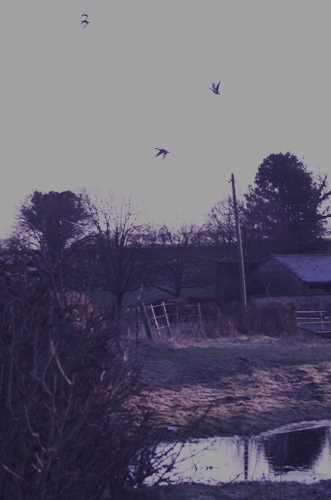 Ducks over the pond. It is such a sunny morning, after days of very cold, very cloudy weather it's a pleasure to experience the brightness. I took myself off for an early walk after I'd dropped Jack at the railway station in Salisbury. 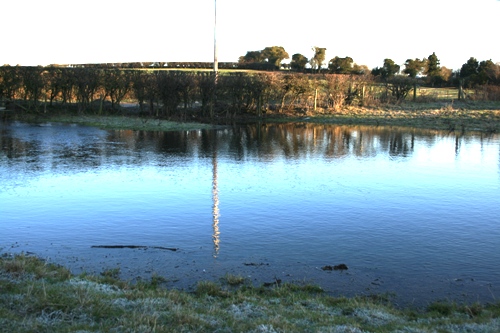 The Terrig runs alongside the lane which leads from our house to the village of Farnham. It's a chalk stream so the water is cold and very clean, and the chalk layer is visible through the pristine water. 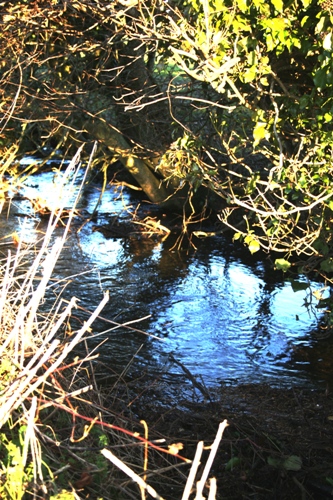 Half way along the lane to Farnham the water crosses the road so all vehicles have to drive through. When the water gets higher (as it usually does) the ford becomes impassable for most ordinary cars.  On my way back I could hear two mewing buzzards creating a ruckus in the rookery. The rooks were very tetchy and vocal...and much in evidence! |
Tue, 25 Jan 2011 I've been quiet for a while: I've been working on a commission. I don't tend to take commissions because I feel, so often, that the person commissioning me has too clear an idea of what they want without leaving me enough freedom for what I want...however I felt quite fired-up by this one, and free enough to create my own image. Commissions always come out best if the artist is given freedom to create the image. It is based on the Corfe Hills Nature Reserve at Broadstone, you'll recall I went there to have a look around. It began the night before when I went on a virtual tour via google.maps to have a good look around. It meant I was fairly clear on where I wanted to begin my scouting around the next day. I photographed while I was there and made a sketch in colour in my moleskin from which I came home and made a very large working watercolour. Although I had to flood the valley a little more than is actually the case, I knew as soon as I saw the two trees in my foreground that I had my composition. Sometimes compositions strike you immediately. 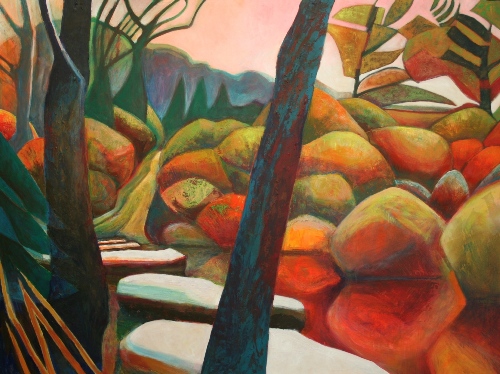 This is the not-quite-complete painting; I have intensified it slightly and generally worked a little more but the light is not good enough to photograph it today. I've called it 'Old River Crossing, Broadstone'. |
Wed, 12 Jan 2011 I went to my life drawing group last night. I love it. I love to use watercolour because line alone seems not to provide enough to work with. Watercolour can create both a shape and a significant edge. The edge is the 'boundary' of the shape and the tone of the paint gives weight to the shape. With line alone, what you have is the 'boundary' of the shape but less weight. Using watercolour in the life class feels more like drawing than painting. I would say I'm drawing...with paint. Here's one of the pieces from last night 'Leaning Man'. 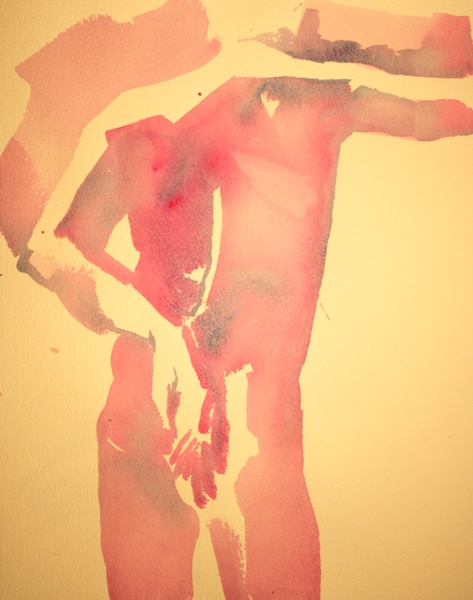 The shadow of his hand across his bottom was what I was trying to capture here. I found in the pocket of my little sketch book, one of the postcards I bought in Jordan recently. 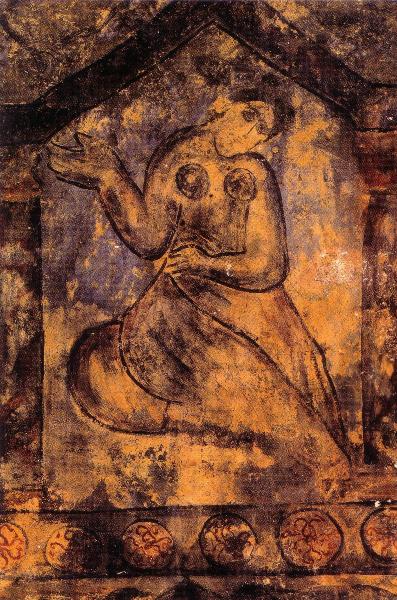 Isn't this a lovely life drawing? It comes from the walls of one of the Desert Castles, Qasr Amra, in Eastern Jordan near the border with Iraq. 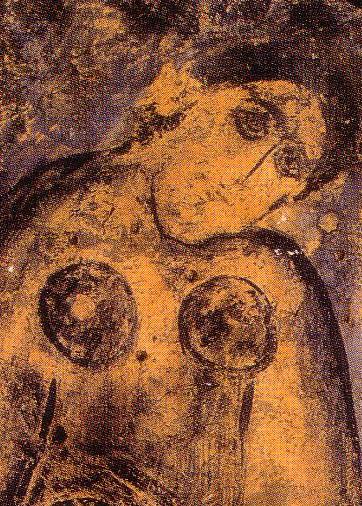 Look at her alluring bosom and lovely eyes. Qasr Amra was built between 711-715 by Walid 1st. What remains today is a small residential section covered in paintings of naked women, of animals doing human things (like playing music) and on a dome in one of the rooms, the earliest representation of the night sky on something other than a flat surface. Wikipedia says this about Walid 1st 'Al-Walid also began the first great building projects of Islam, the most famous of which is the mosque at Damascus. The long history of Islamic architecture really begins with al-Walid. This is also the period, however, in which Islamic court culture begins to germinate. With the caliph as a patron, artists and writers begin to develop a new, partly secular culture based on Islamic ideas'. We accept this painting of a woman as being of its time and yet it is so reminiscent of work by Matisse and Picasso 1200 years later. 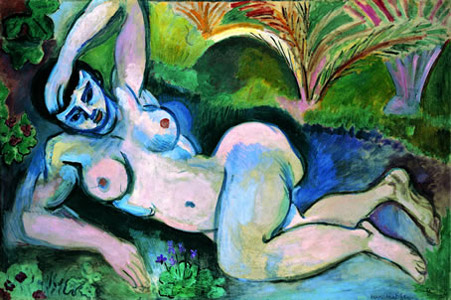 Matisse, Nude. |
Thu, 06 Jan 2011 I found this amazing wild place in the middle of Broadstone today...and I thought Broadstone was just a suburb of Poole. 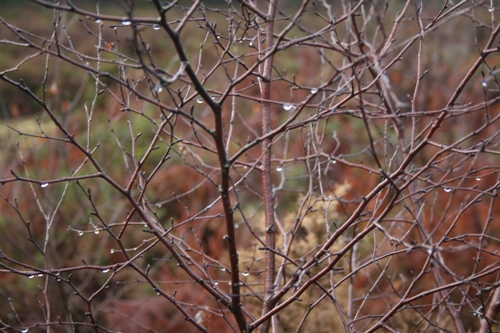 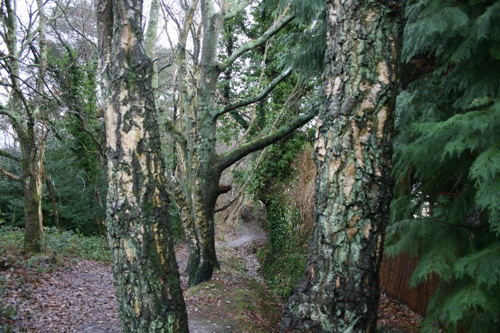 Broadstone was called Broadstone because wide stones were placed across the Blackwater Stream so that people could cross without getting wet feet. 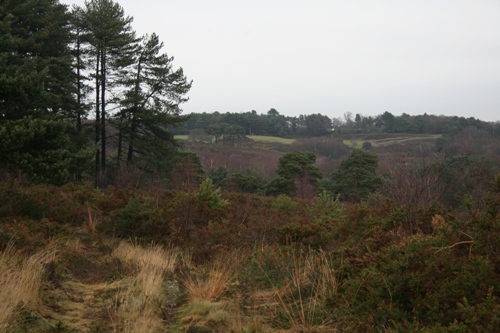 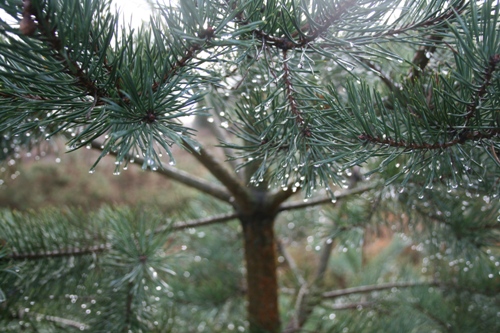 |
Sat, 01 Jan 2011 Jordan day five part four: We had tea in a cafe which was more of a Smoothie Bar than a cafe. Although we were sitting at a small table at the back of a long narrow room (more cupboard size), people were popping in off the street to have fruit smoothies made up with a combination of the fruits that the stall-holder had hanging above the shop-front. I get the feeling that fruit smoothies have been going on a lot longer in Amman than they have been fashionable here in UK, especially after seeing their fruit and veg markets. 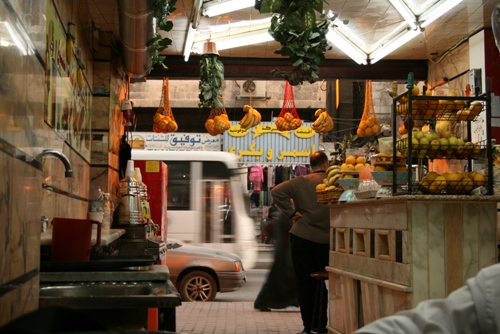 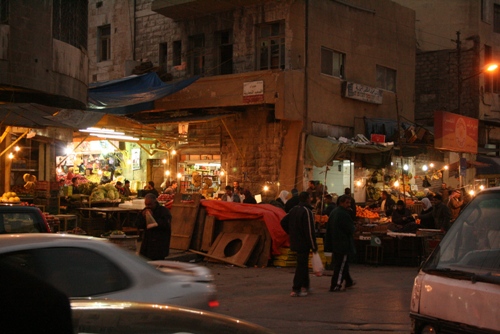 On the edge of the fruit and veg market in Amman. We heard a call to prayer and were due to meet Yasser at the Hussein Mosque so we headed towards the sound. In front of the Mosque is a large plaza with a fountain where the men wash before they go in; hands and faces, I even saw a man wash his feet with his socks still on. Men poured on to the plaza from every direction and in to the Mosque. They flowed in through three large open doorways, I could see rows of them gathering inside. It seems that the Mullah says/sings something and the men repeat it, a bit like responses in Church. This went on for about 15 minutes when the plaza began to fill with traders, boys with a mat selling hats and gloves, a man selling light-up helicopter toys, fruit barrows, cakes and sweet barrows, all facing the open Mosque doors, and at a certain moment, the cue for which we certainly missed, they ALL started shouting their wares. About two minutes later the men poured out of the Mosque and some busy and brisk trade was done. Yasser picked us up a little while later and dropped us at Al-Rainbow Street. This was entirely different from downtown Amman. It is an old and winding Ammani street which has been re-vamped in the original style, cream stone, small and pretty buildings and trendy shops. We stopped in The Green Turtle Tea Bar (which does expensive tea and coffee but has free WiFi) and checked our emails and the weather back home. It was full of foreign students on their laptops. The British High Commission is on the same street as is, what we think is, the Saudi Embassy. Yasser met us again, it was by now about 8pm, and took us to a smart shopping area, mall-type, where we found a 'Christmas' shop, Christmas trees, carols, baubles, tinsel and all things Christmassy. Nothing matched up to the downtown market. Yasser returned us to Al-Rainbow Street where we ate in a trendy cafe called 'Books@Cafe', a shop which sells almost exclusively English language books and has a 60s style cafe upstairs. We ate listening to 70s and 80s music on the juke box, it was where I had my third bowl of delicious lentil soup! 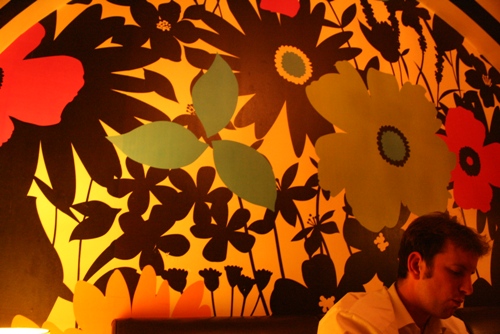 60s wallpaper in Books@Cafe. Finally Yasser took us to the airport and our night-flight to Rome and then London...amazingly...we were just 15 minutes late into Heathrow the next morning, despite all the snow and upset! 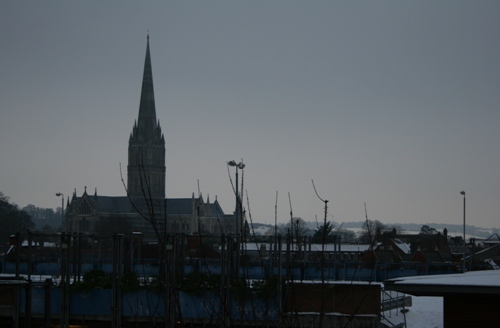 Salisbury Cathedral and nearly home!!!  Jordan day five part three: Above, Man carrying boxes through Amman fruit and veg market and below, More pictures from the top of a double decker bus on the road to Amman from Aqaba. 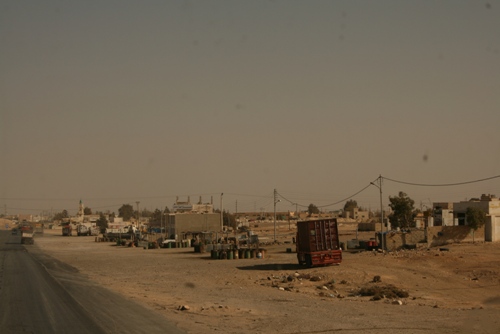 Another small roadside town. 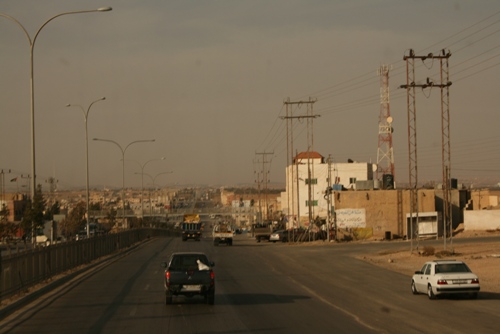 Getting closer to Amman. 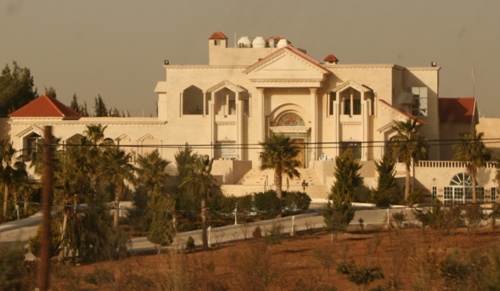 Smart house on the edge of Amman. When we got to the Abdali bus station in Amman, Yasser was there to meet us. He was great; he took our luggage and dropped us in the heart of Amman, downtown. We arranged when and where we would meet later. Downtown was busy, a market area with packed streets and alleyways. The shops are tiny and packed to the brim, predominanatly gold/watches, traditional ladies' wear (embroidered dresses-headgear), gadgetshops including kitchen gadgets, tons of music-systems shops (possibly for kitting out hotels etc.), shoes, mens suits, fabric shops (largely mens suit fabrics from China) and lots of tiny tailors' shops with working tailors inside...and the most amazing street of fruit and vegetable stalls; HUGE cabbages, aubergines, peppers, chillis, turnips, beetroot, sweetcorn, onions, herbs, salads, tomoatoes, oranges, clementines, apples, pears....and so on and so on.The smells were sublime, it was all so abundant and fresh. I find myself in a dilemma with my camera; I long to photograph everything and yet I also long to be an invisible 'receiver', that is, to walk through the area and absorb everything, smells, sights, sounds, comments etc. and NOT draw attention to myself or spoil the moments by getting my camera out. * |
Fri, 31 Dec 2010 Jordan day five part two: Pictures of the road to Amman from the top deck of a bus! 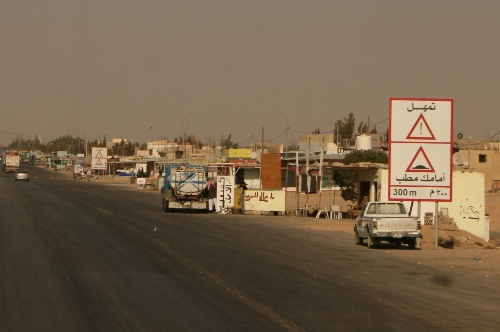 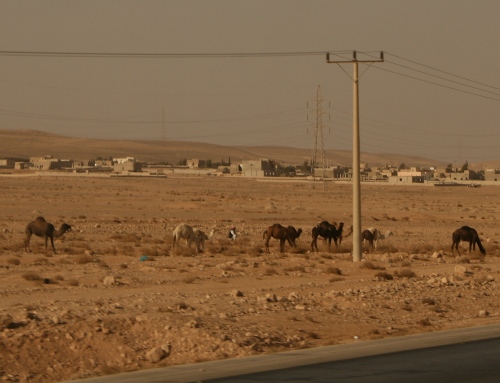 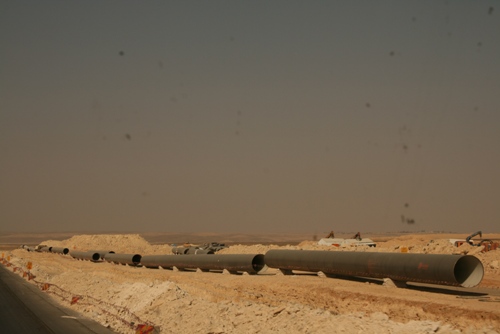 Miles and miles of pipe being laid in a ditch dug alongside the road, I guess for oil but I don't know. Below: Underneath the stickers it says 'Compulsory For Tanks and Trucks to Iraq'. 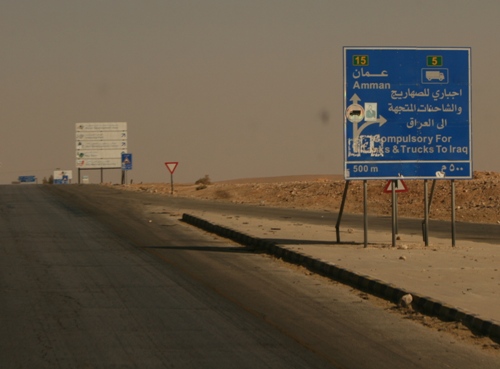 Jordan day five part one: We were up early and packed. We got ourselves to the Ali Baba Cafe and had good coffee and tea. 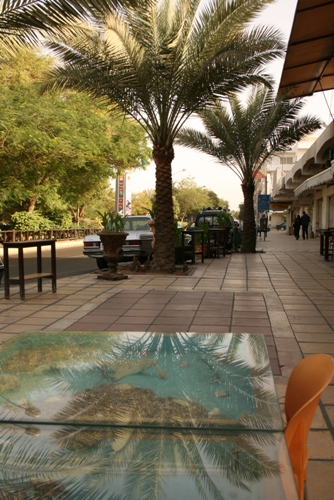 The Ali Baba Cafe has coral-scapes under glass tables - very enigmatic! Talat's group was late so he didn't make it to the cafe, but later, once we'd got ourselves to the Jett Bus station, he turned up to say goodbye. He had arranged for someone (Yasser) to meet us in Amman and look after our luggage for the day as our flight was a night flight so we had a day in Amman. The bus was great, a double decker and we were upstairs at the front. It was not full by a long way, but there was a stewardess who came round with snacks and drinks. 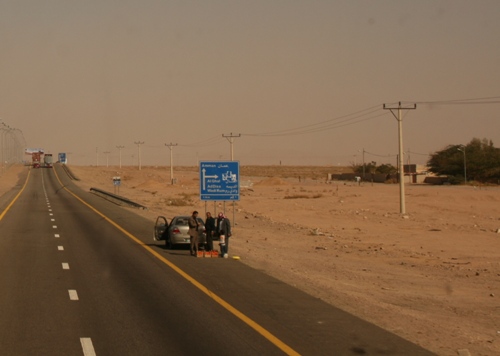 All along the road to Amman (about a four hour bus journey from Aqaba) people are out selling, mostly onions, potatoes and tomatoes. Nearer to Amman there are coffee sellers too, they are often out all through the night because we had bought coffee by the side of the road on our journey from the airport to Wadi Musa at about 4-in-the-morning. 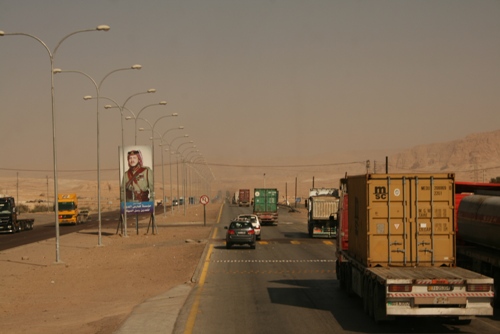 It's a patriotic country, so pictures of the King are in all sorts of places. (King Abdullah, married to Queen Rania). 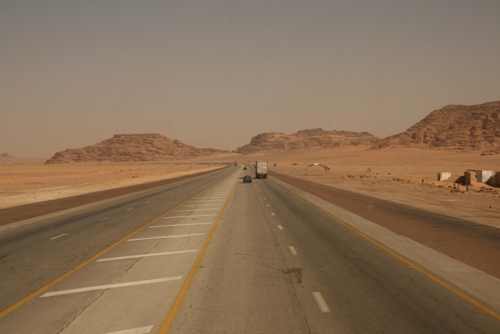 It was a long and dusty journey, but very enjoyable. 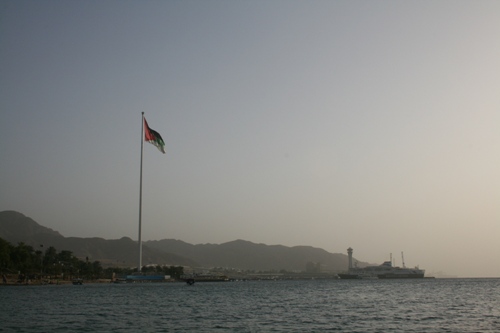 The giant flag flying over the Port of Aqaba - Saudi hills in the distance. 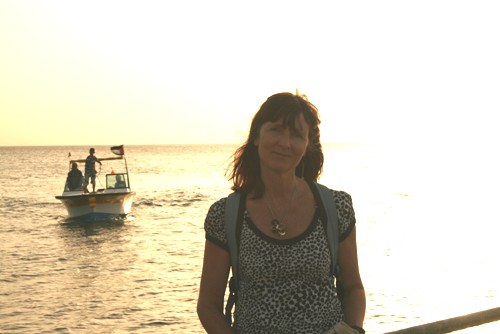 Jordan day four part four: I have a theory...Aqaba has a special arrangement which allows its citizens to buy many things tax-free, such as tellies, furniture and luxury items. Consequently Aqaba is growing rapidly, much faster than Eilat next door. I think that Jordan is trying to establish the stronger commercial foot hold on this bit of coast as its the only bit of coast Jordan has whereas Israel has its mediterranean ports for shipping. Jordan has a lovely spanking new port a little way down the coast from the beach and allotments. I took a ferry from there to Nuweiba with my sister in 2000. Jack and I wandered from the jetty back into town. This gives an idea of how close to the sea front the allotments are. 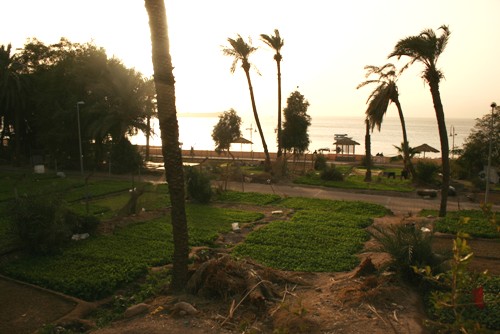 The whole town exists behind me. As I was craving a spag bol, and I have a favorite cafe in Aqaba which makes said dish...we ate there. Jack is veggie; Jordanian food may be full of meat but it is also full of the amazing salads and veg., at the cafe he had a veggie pizza with chilli -he said it was very good. 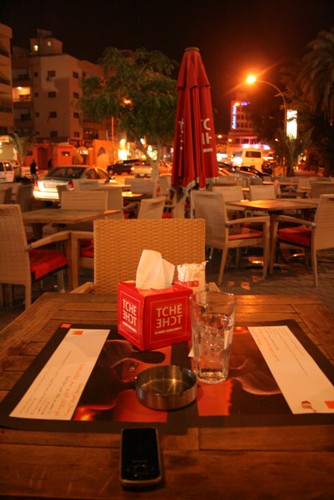 After we'd eaten we wandered for a bit, looked across to Eilat which is so close... 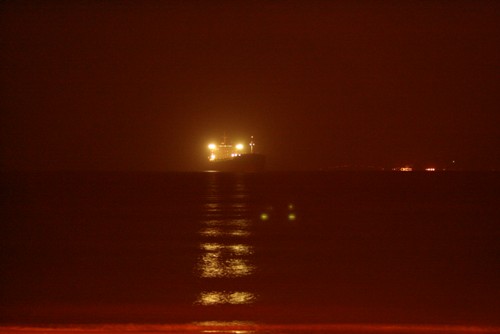 (Eilat's lights in the distance)...and then re-visited the markets we'd been to in daylight. At night the markets are more bustling than in the day time. There were bakers baking and the bread shops were full of people buying their fresh bread. Veg, meat fruit and clothes were all on sale and people were buying; mothers buying shoes for kids, people buying all kinds of different nuts, roasted, toasted, spiced and mixed. We bought some to take home. Massive sacks of teas, herbs and spices were out on the street for sale; one man had a huge sack of Myrrh (like little rocks) which he told me was to 'burn for the good smell'. We wound in and out of alleyways for a long time before we went back to the hotel and watched CNN news on telly and worried about our journey home the next day...Heathrow closed, massive dumping of snow in UK...I rang Simon who said there was at least 2ft of snow around the house, the little black car had disappeared under it, no journeys advised except those absolutely necesary. Talat called our hotel room and asked us to meet him at The Ali Baba Cafe next morning as he was going to be in Aqaba meeting a group and he wanted to say goodbye to us. |
Thu, 30 Dec 2010 Jordan day four part three: We wandered through the market part of town. Everything hangs in the street, grids of shoes, butchered lambs/goats, herbs, nuts, teas, vegetables, clothes, everything! except eggs which were on trays. We found a small street, or rather an alley restaurant, and had a plate of 'mixed starter' salads and bread. A man opposite was making the sand bottle pictures with his coloured sands and a long stick, of camels, suns, moons and deserts. Trade was quiet; we were the only tourists; he was selling underwear as well but it was quiet on that front too! Back at our hotel we checked emails on Jack's laptop, checked UK weather which sounded bad, Heathrow closed. We anticipated a fractured journey home. Jack wanted to find an English newspaper -last year he'd been in Alicante for UK's big freeze and had himself photographed in the sun with the 'Big Freeze' headline, he wanted to do the same here. We found a Daily Express...  ...in a book shop which sold predominantly English language books, and there was a lovely English lady buying The Guardian! We spotted this funny house crow as we headed back towards the beach. It was as curious about me with my camera as I was about it. 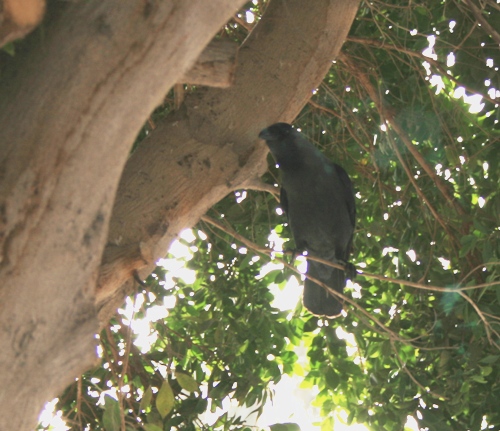 On a jetty, which either I never saw before because it was camoflaged by the tea-tents OR is new to Aqaba, we sat and read the paper, took photos and got splashed by a group of boys in the water beneath the jetty. I tried to photograph them through the slats but then persuaded them to come back up and dive off the end of the jetty for me (I had seen them do it earlier). They obliged happily (better to be friends than splashed) and were delighted with the results...so was I! 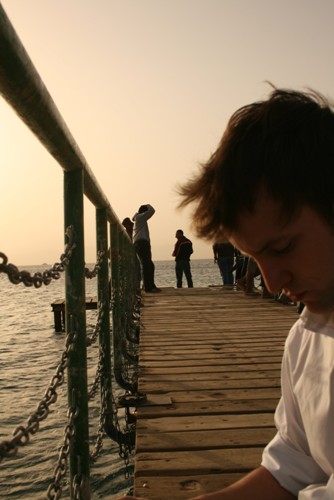 Their names were Osama, Mohammed and Omer... 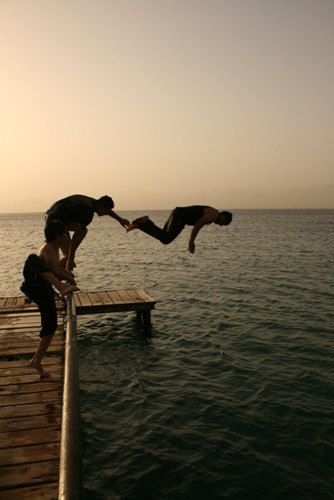 ...and sadly they have no access to email at all or we would have emailed them the photos I took; we were really sad about that. Jordan day four part two: The first thing we did in Aqaba was to find the Jett Bus offices and book tickets for the following day to Amman. Jett buses are not the cheapest buses; they are used mostly by locals/Jordanians and at 7.5 JD (approx £7.50p) each for the journey seemed good value to us. All along the beachfront in the middle of Aqaba are allotments in which the locals grow parsley, radishes, onions and more and then sell them from wheelbarrows in the market area of Aqaba. 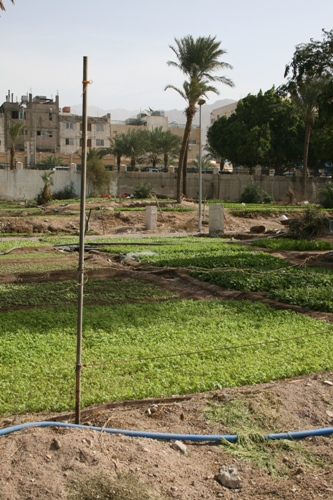 The allotments seem really well irrigated and organised, I've always been amazed at their existence in the middle of town. 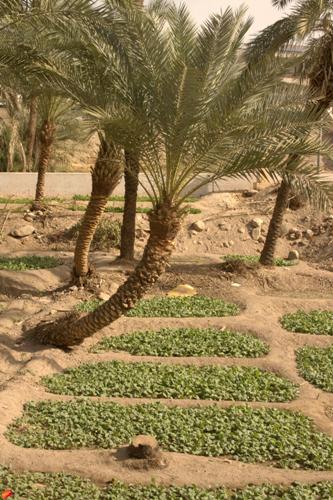 There is a poorer section of the town situated near to the allotments and I wander if it is a way of giving access to food and an income to the people of that area. Last time I was here Talat told me that the local authorities were trying to demolish that part of town; they haven't done that yet but they certainly have cleared away all the nik-nak markets and tea-tents which filled the sea-front...rather sadly, as they were always milling with life even though slightly scruffy. Aqaba claims to have the biggest flag in the world, and I was just apologising to Jack that it didn't seem to be flying when we noticed that it was just being risen up the flag pole at that moment. 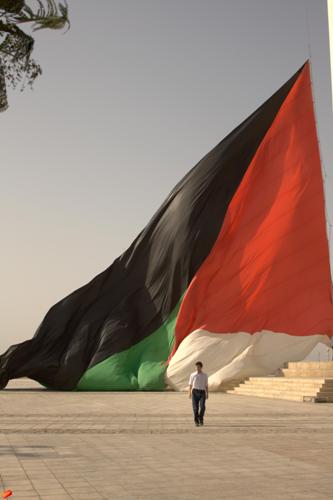 Jack and flag...  It was quite a spectacular feat raising this thing! It isn't the Jordanian flag, it is, apparently, The Great Arab Revolt flag of 1916. The castle in Aqaba was used during the revolt and later became the summer palace of King Hussein. It is now a museum and The Queen Noor Foundation (crafts) shop. We bought a few presents there and were given tea! |
Wed, 29 Dec 2010 Jordan day four part one: We had breakfast under a sun shelter and then tea in the sunshine to warm us up. I saw a mourning wheatear, some wagtails and lots more crows. 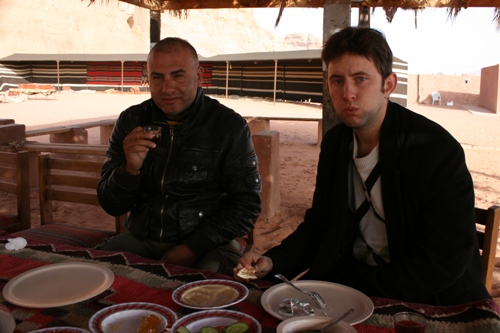 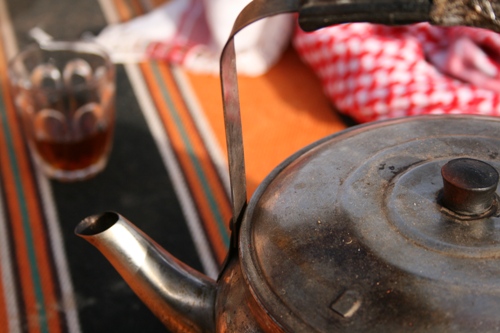 Mourning Wheatear 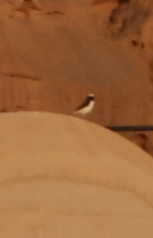 Last night a very good friend of both Waleed and Talat called Sami had come to the camp-site and stayed in one of the tents. Talat had to head back to Wadi Musa for work, so Sami gave us a lift to Aqaba, our next stop. He was telling us that compared to six weeks ago, before his liver transplant, Waleed is looking 180degrees better. I thought Waleed looked very well, all things considered, but tired. -early days- 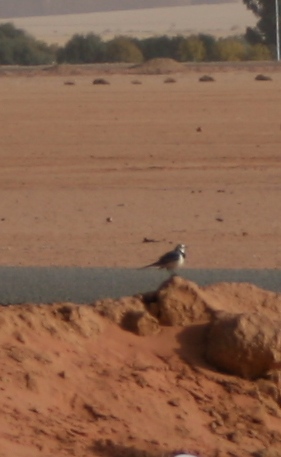 Wagtail. Jordan day three part six: Talat's camp consists of a large L-shaped bedouin tent, some outside sun shelters and fire places, about 20 box tents, some with three small iron bedsteads in each, others with bare floor (ground mat), some loos, a couple of showers and a small kitchen-room. We sat in the tent because as the sun went down it got very cold very quickly. I put a sheepskin over my legs and later borrowed a 'desert coat', a huge fleecy lined ground length felt coat. 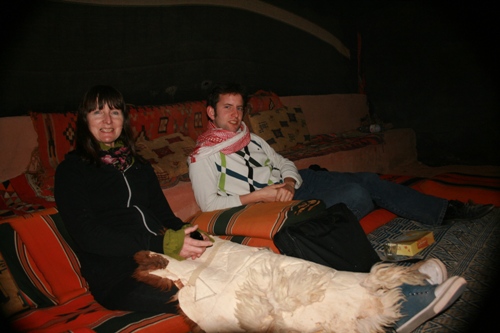 Even with the fire so near I was cold. 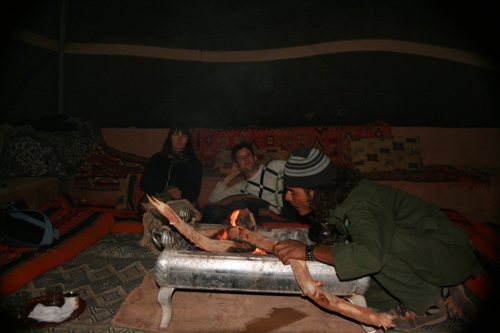 Throughout the evening various friends of Talat's appeared and were fed and watered. Once we'd eaten, the generator was turned off and we used just torch light and the light of the fire. Outside, the moon was so bright we could see perfectly clearly. 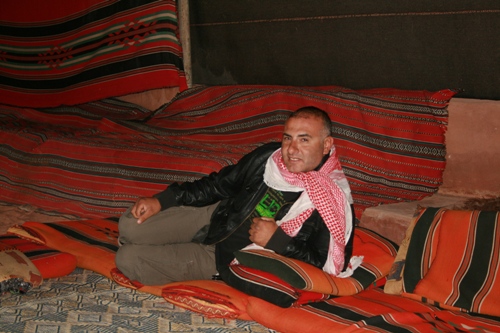 It was a very genial evening, with the lovely sounds of softly spoken arabic, lightly pronounced consonants and softest rolls of the toungue, for instance, the end of the name Omer...the rrrr at the end is repeated in a string of soft rolls dissipating out until it is no longer audible. Every now and again I caught words that I recognised from my knowledge of Hebrew...'Beit (or Bayt) Arabic and Hebrew for 'house', Wahad-Arabic for 'one', Ehad-Hebrew for 'one', Umma-Arabic for 'Mother' Imma-Hebrew for 'Mother' and so on. 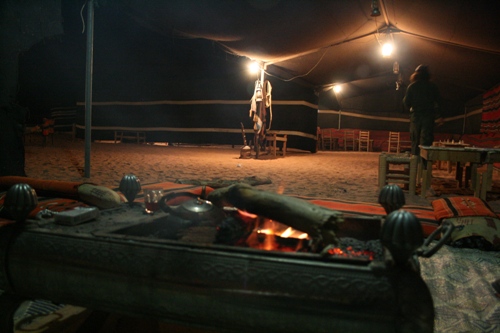 Towards the end of the evening the best burning wood had burned up, so Subieh, camp manager, found a large square tin box and placed it on top of the fireplace. He'd punched little holes in the sides so it worked very much like a woodburner and was much more effective at burning damp wood. Finally, at bedtime, I claimed one of the square tents, I took all three thick bed covers from the three beds and with my desert coat on top of the three covers and every stitch of my clothing still on I still could not get quite warm enough! 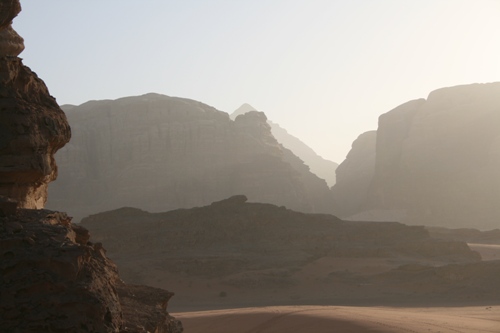 Jordan day three part five: As soon as we could, Jack and I got out and walking. We walked until we found the perfect climbable ledge where I could paint and Jack could work on his Chinese. The sun was really warm and apart from some boys we could hear playing a game of football, the only sounds were animal sounds, a small pack of feral dogs with a puppy, a lot of crows and a camel with a man on his back. 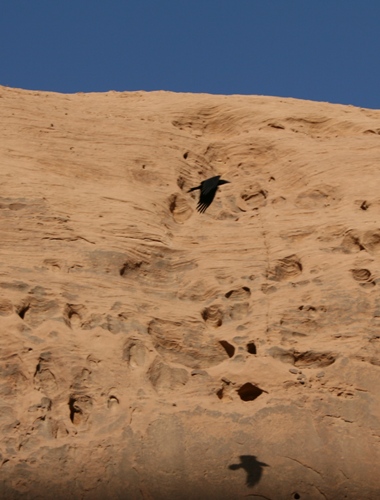 The line of rocks are an attempt to keep 4WD vehicles out of the protected zone. I remember when one was free to drive anywhere so this is a good sign. 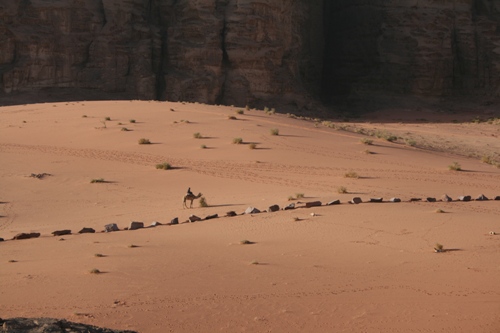 The camel decided he was hungry and started eating the bush. The man made the camel get down so he could get off, and then he noticed us on the ledge. He crouched down beside his sitting camel (who continued to eat) and watched us for a long time...probably wondering what on earth we were doing. Eventually he (noticing the dogs) got back on his camel and the feral dogs chased them off!  Camel tracks and car tracks -evidence of old and new everywhere. 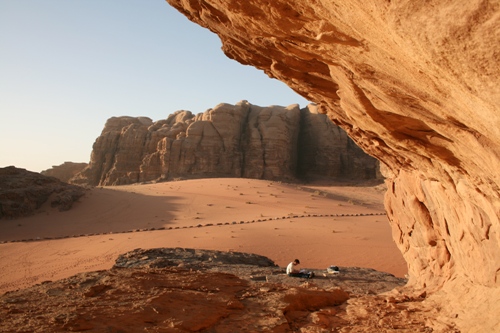 Jack doing his Chinese. We stayed there a long time...a long way from everyday life. Jordan day three part four: Jordan has no passenger train service, but they still run trains to carry phosphates, one of Jordan's important exports. 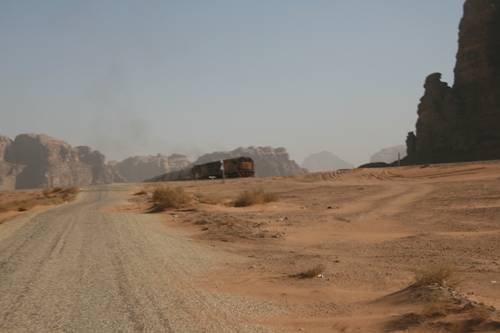 To get into the Wadi Rum area we crossed the railway lines 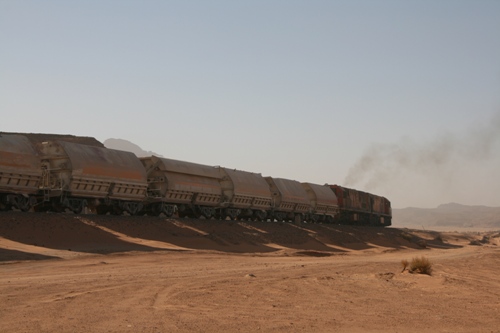 after this train had gone by. 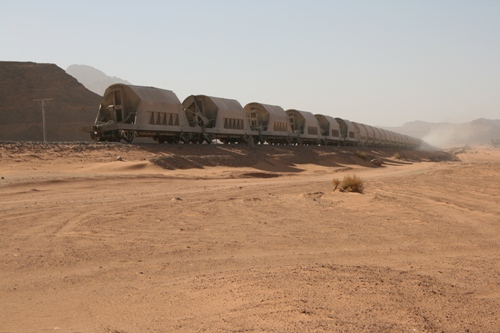 We crossed railway lines several times as we drove on tracks, roads and sand to get to Talat's current camp. He has two people working there permanently, a camp manager and a young man to help. We were in Jordan at one of the quieter times; next week, Christmas, would be very busy, and New Year too is a busy time. When we got there it was very very quiet; the quietness sort of hangs between the huge rocky blocks which rise out of the sand. I could hear plenty Tristram's Grackle (kind of starlings)which I remembered from my last visit. They wolf-whistle like a builder and have bright red wing-ends visible when you see them fly. 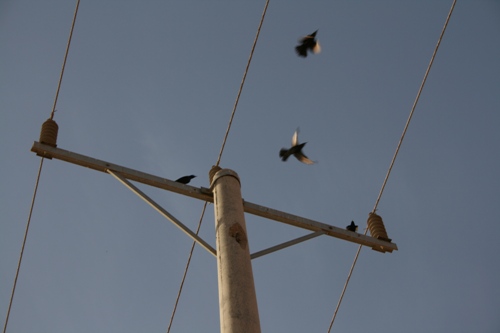 |
Tue, 28 Dec 2010 Jordan day three part three: At the new site, this is the open view facing south... 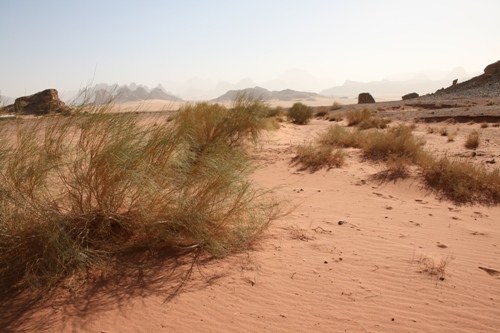 these, the rocks to the north (Jack is the tiny white speck part the way up)... 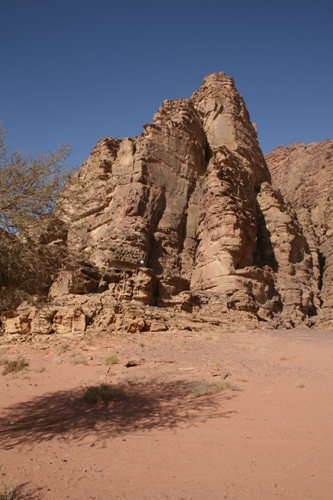 and this the east side. 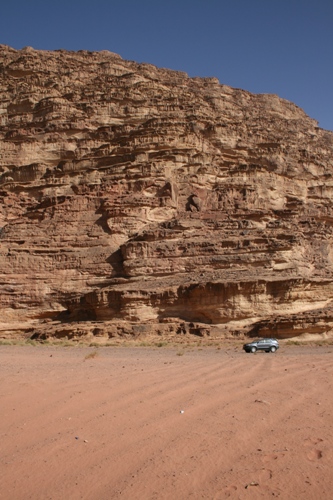 The area is pristine at the moment. I don't know how Jordan can ensure it remains that way and that the camp-sites are created with just the lightest touch on the land. Fingers crossed. 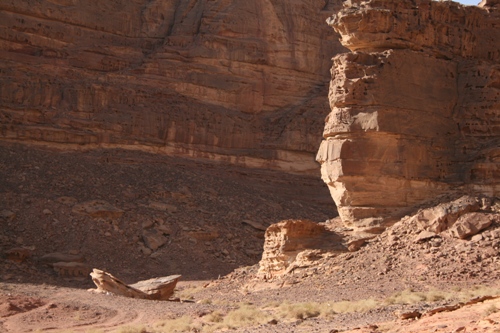 Rocks at the site. Jordan day three part two: Before he gets out into the desert sun and wind, Talat always sorts out his head gear. 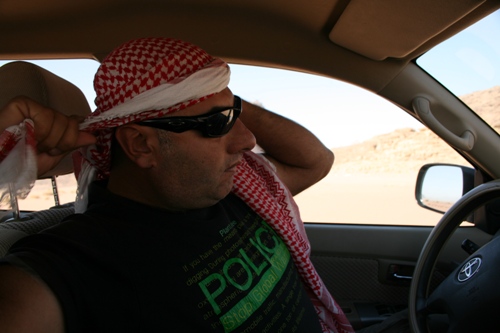 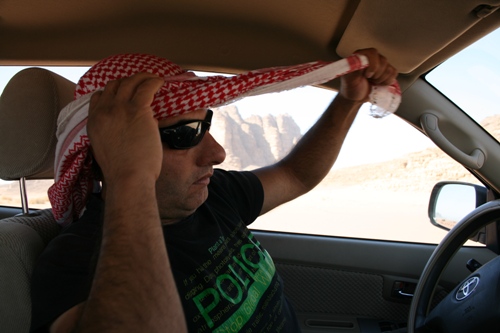 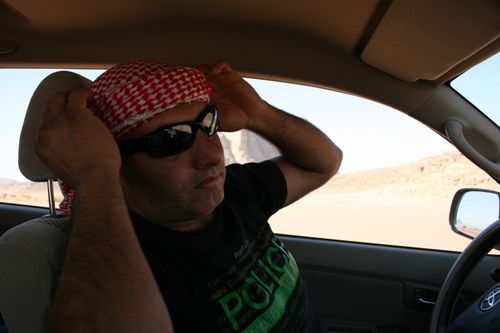 and we can clamber out of the car. This is what I see first, the light on the surface of this Tamarisk bush against the rocky western border of the new camp-site, and the shadow of the bush across the sand. 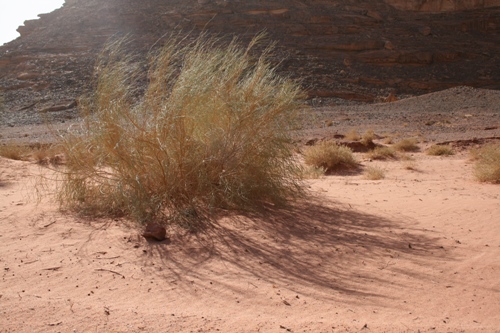 |
Mon, 27 Dec 2010 Jordan day three part one: Up early and off to Wadi Rum to camp in Talat's camp-site. I was a bit nervous, I camped there two years ago at the same time of year and the cold once the sun had set was overwhelming. As we leave Wadi Musa, the landscape becomes flatter and more desert for a while, before becoming moutainous again nearer Wadi Rum. We stopped for me to look at this bird; these were the best photos I could get. I don't know what it is yet and haven't had enough time to research but as soon as I know I'll put the info up on this blog. 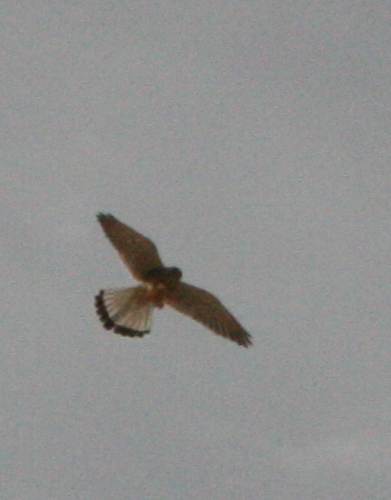 It was about Kestrel size. In fact I think it is s Kestrel, it seems lighter coloured than I'd expect. 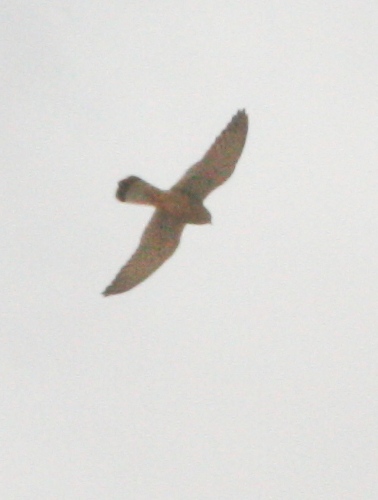 Talat has a camp-site in Wadi Rum, on the edge of the protected zone. But even within the protected zone there is the sad inevitability of the decline of the pristine quality of Wadi Rum. In the nine years I've been coming it has become more crowded and more scruffy. Talat's camp-site has about 20 square tents and a large bedouin tent for eating and congregating, but it is surrounded by more and more new and noisy camp-sites. For that reason Talat is looking at a much more quiet site to set up camp. He is in the process of applying for planning permission. We had come off the main Amman/Aqaba road and in towards the cliff and mountainous area of Wadi Rum when Talat took a left turn off the road and onto sand. We headed towards and crossed a vast flat area of what looked like a salt bed but was in fact white clay and sand baked hard in the sun. When it rains the flat becomes a vast muddy puddle. 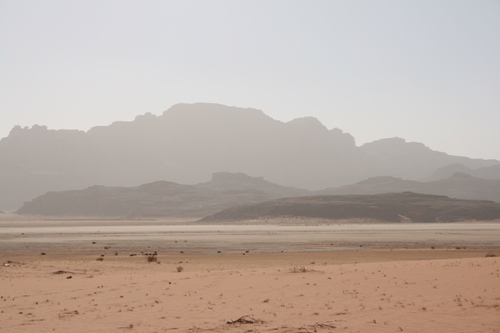 ...approaching the flats... 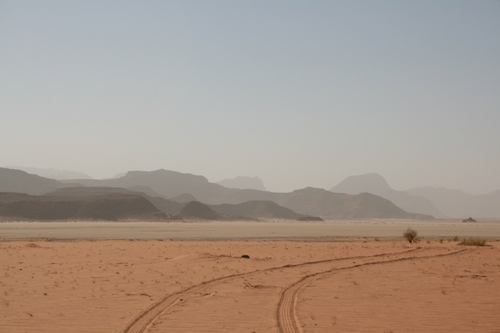 ...and looking back across them from Talat's new camp-site, note our car tracks. The new camp-site is surrounded on three sides by tall cliffs, and on the fourth side looks out across the white flats to the layers of Wadi Rum cliffs, perfectly diminishing in tone the further away they are. It gets the sunrise, and a short walk makes the sunset available too. I hope that if Talat opens a camp-site here, not too many follow suit. 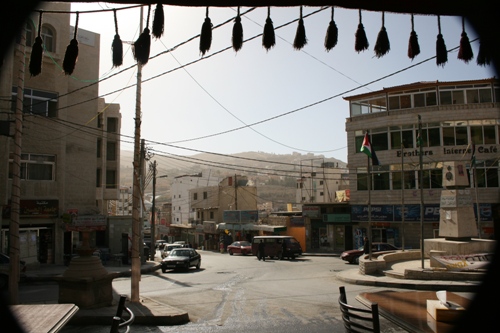 The main circle in Wadi Musa; we drank mint tea and ate lentil soup and aubergine salad. 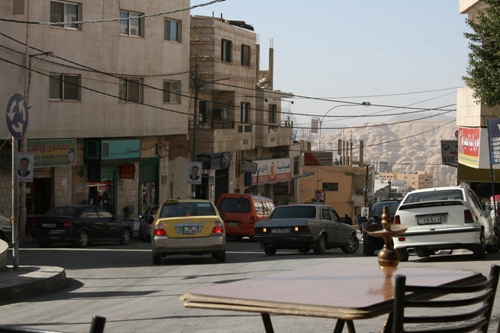 Chai ib nana in Wadi Musa 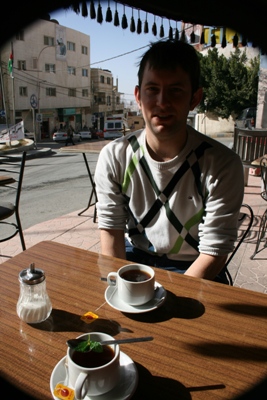 |
Sun, 26 Dec 2010 Jordan day two part three: Sand bottles at Little Petra. 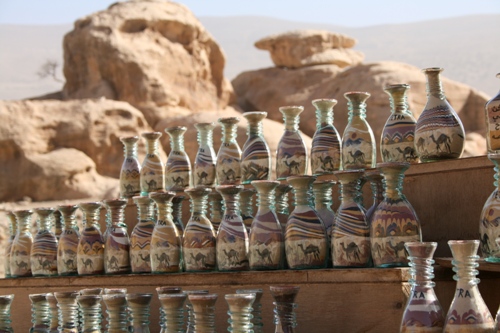 Talat collected us...  ...and drove us back along the road on which we'd seen the lines being painted the day before. 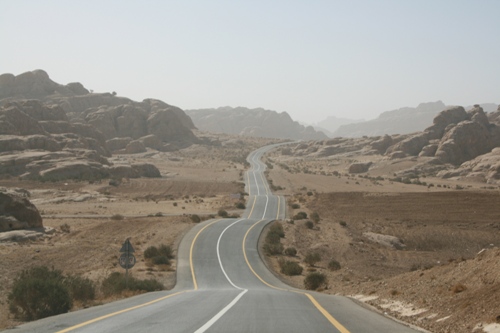 We went back to Wadi Musa through the little town built for the cave residents of Petra when the Government moved them out of the caves. Some of them return to live in the caves during summer time. 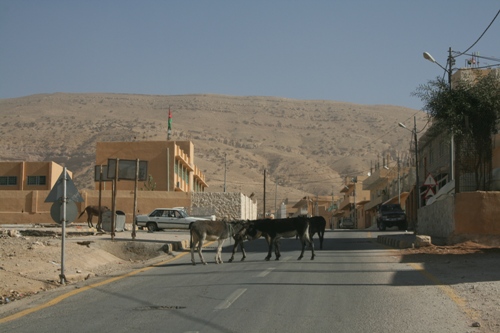 Talat dropped us at his office to check our emails. He was off to Amman for the afternoon with an Aunt, planning to join us later in the evening. He'd booked us a dinner in a new restaurant opened by his friend...after shopping for presents in the afternoon and wandering through the market section of Wadi Musa, (we had our second bowl of lentil soup and an aubergine salad overlooking the main circle of Wadi Musa -watched the world go round for a while) we headed back to our hotel for a rest and went up later to the restaurant for another classic Jordanian dinner of fresh salads and delicious mansaf (lamb cooked in yoghurt, rice with nuts). Talat met us in the restaurant and then took us to his Uncle's house on top of the hill overlooking the whole of Wadi Musa, Petra and desert beyond. It was an ornate and very new house with several 'reception' rooms all decoratively painted and furnished, but we sat in a family room upstairs and watched wrestling on the telly eating pastries (sweets) and drinking tea...a really enjoyable evening. This Uncle is the uncle who owns one of the shops where we'd done most of our present shopping earlier in the day. Umm Allah works behind the counter -she remembers me each time I come, we drink tea and ask about our children. She is 'Umm Allah' -Mother Of Allah, as I would be Umm Jack -Mother of Jack (or perhaps 'Jack's Mum'). A father is known as Abu..(the name of his eldest child, if he has sons, his eldest son). The Aunt who Talat took to Amman is the sister of the Uncle who owns the shop; as she is unmarried and when their mother (Talat's grandmother) died she moved in with her brother and his wife and family. Family ties are still very strong in rural south Jordan. On the ceiling of one of the rooms at Little Petra are these exquisite paintings restored within the last two years by the Courtauld Institute. 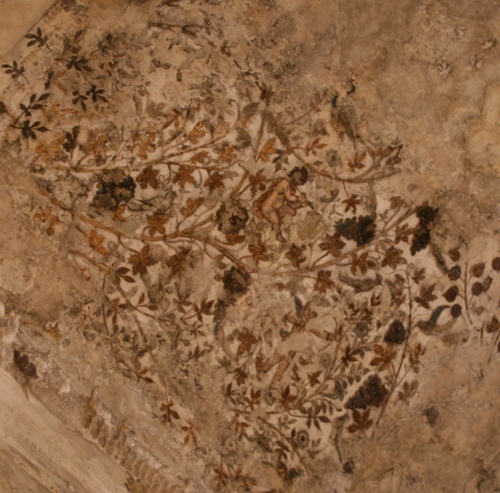 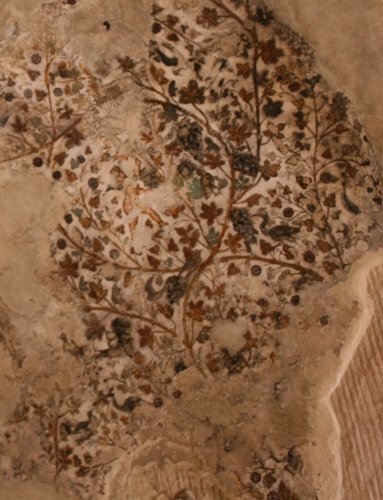 Like much of the carving styles at main Petra and Little Petra, these paintings seem to be a mix of Greek, Roman and Egyptian influences. They were on the ceiling of what is thought to have been a dining room and Little Petra was possibly a retreat for wealthy Nabateans. Evergreen Oak at Little Petra 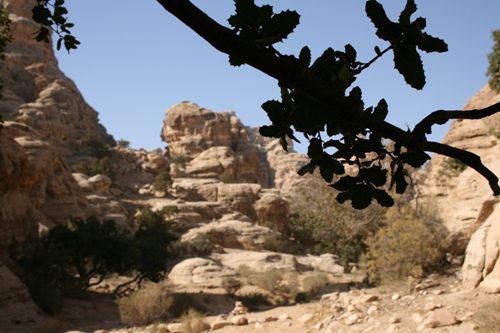 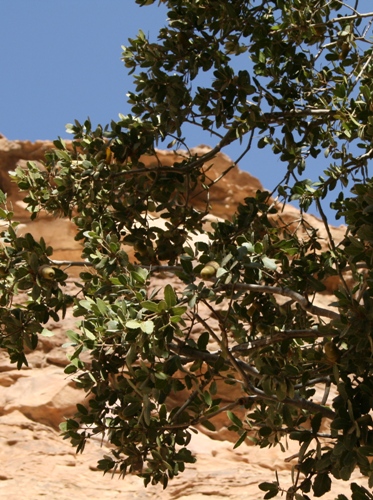 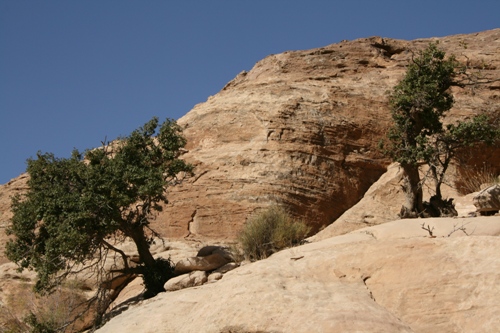 Jordan day two part two: As we'd driven down through through the rocks last night, we'd seen a man sowing an area of ground the old fashioned way with a small bag of seed, sowing as he walked. A young boy was at the side of the area with a large sack of seed for the man to re-fill with. As Talat took us from the neolithic ruins to Little Petra, we saw the same kind of sown areas of ground, looking too dry to sustain many growing things.  We asked Talat about it and he said that mostly it was wheat sown by the bedouin who are living in the area (we saw many tents and people) who sow it in the hope of rain. If it rains the crop grows and is food for the goats as a green crop before it ripens into wheat. I know that Waleed's family used to sow, grow and ripen wheat, harvest it as fully grown wheat and make their own bread from it. I'm not sure if they still do since Waleed's mother died; she had been in charge of it. We saw a couple of old tractors with ploughs attached on the back. Little Petra is another place I'd never been to. It has a Siq like main Petra, and many carved buildings, but is much much smaller, quieter and not garbed-up for tourists. There were a few Bedouin tents at the entrance selling nik-naks and tea, but peace and quiet within the Siq. 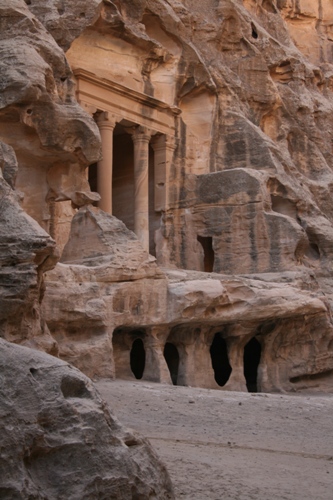 We walked through, climbed a bit, saw evidence of Nabatean channeling for water systems (of which they were the masters) and remains of a huge water cistern. These existed all over Petra and were camoflaged so that outsiders wouldn't know of their existence. They filled during the time of flash flooding, and although Jordan seems so dry, you can see evidence of water having carved the rocks everywhere. 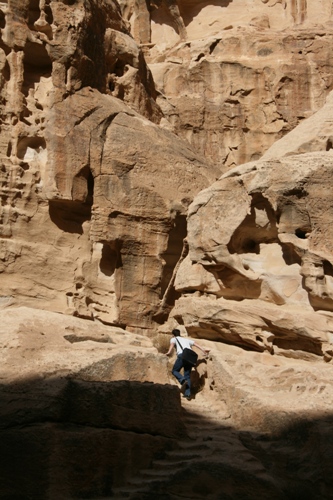 Jordan day two part one: Talat took us to some neolithic ruins that I'd heard about but never seen. 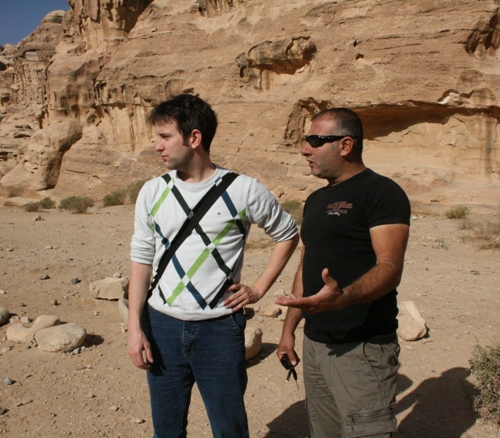 The precision of the stone building is startling, you can see how smaller stones were fixed between bigger stones and probably mud-based filler and maybe some kind of mud-based plaster on top. It's a shame that the ruins are revealed and in no way protected; they'll proobably deteriorate rapidly. 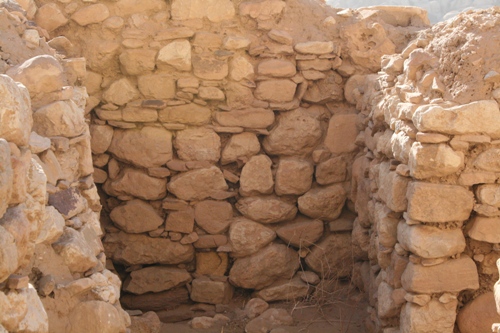  See Jack and me in Talat's specs! 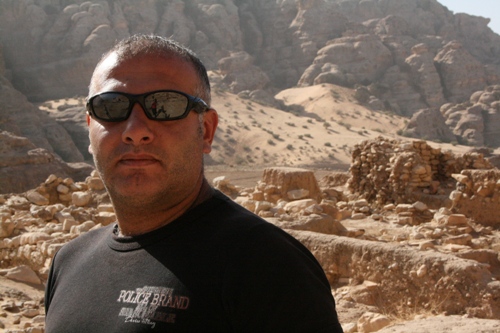 From sacredsites.com - "Primarily known as a commercial and ceremonial center of the Nabataean culture during the centuries before and after the time of Christ, the region of Petra was inhabited in far greater antiquity. Archaeological excavations have revealed a rock shelter of the Upper Paleolithic period, dating to around 10,000 BC, and a Neolithic village from the 7th millennium BC. While evidence of habitation during the Chalcolithic and Bronze ages has not yet been found, the region of Petra was again occupied in the early Iron Age, around 1200 BC, by the Edomite culture of the Old Testament (Edom, meaning red, is the Biblical name for this region of the Middle East)." 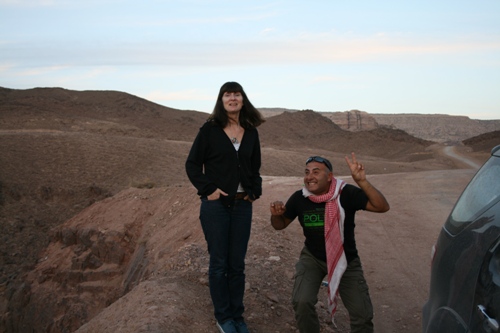 |
Sat, 25 Dec 2010 Day one part four: At the end of the long bumpy track, through dunes and banks, we reached sand flats where the remnants of groups of young men with clapped out old vehicles were leaving after a day of banger-racing on the flats. As they left it became increasingly quiet. The whole area was a soft pink light once the sun had dropped behind clouds. The dunes and banks became dark shapes, their diminishing sizes indicating the distance to the cliffs and mountains. Jack and Talat looked funny in the car headlights. 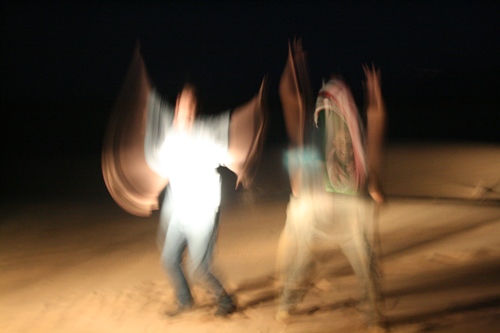 CarLight-Angels; detail. 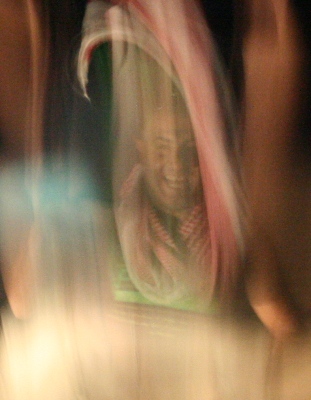 Jack poured the clean white sand through his hands like an egg timer and we pondered on their invention. By the time we left it was dark and quite a trek back up. We had supper at Waleed's house later that night, Camel meat cooked in tahini, lime and garlic with potato slices on top. We gave his little son Saleh a chess set and by the end of the evening he could set out the pieces and understood the notion of 'taking' his opponent's pieces, but not quite the different moves each piece makes. I'll leave the finer details to his cousins to teach him! The last thing we did that night, before finally collapsing into our beds, was to visit Talat's house which was milling with family -every generation, all sitting around a large family room, kids playing, babies being cuddled, tea coffee and pastries being handed around, sisters chatting, telly on, Grandad channel-hopping between cheesy bollywood movies and football. I had brought sticker-books and story-books for all the kids. One tiny little 2yr old kept us entertained dancing like a bride (her words), playing with a football and sticking stickers on various foreheads around the room...and yep...even I cuddled a baby, a little girl called Tala which means 'little tree'. |
Fri, 24 Dec 2010 Day one part three: The rest of the day was a whirlwind. Talat picked us up from our hotel; we wanted to go out and brew tea. (Recipe for brewing tea: collect sticks, light fire, boil water in kettle on fire, add tea leaves to kettle, boil more, add mint leaves to kettle, boil more, add lots of sugar to kettle, cool a little, pour into small tea glasses, serve.) It was a Friday evening meaning that lots and lots of local families do the same. As we drove we could see many families out on the rocks, all brewing tea on little fires. Talat said 'We're stopping on the way to see a friend...'...we pulled in beside a large rock and then up a steep bank and almost on top of the rock. And there was Waleed!!! with his wife and son, brewing tea! He looked fantastic considering he's been very ill recently. We all had tea and then we three moved on to find the sunset. Talat took us down a long, steep and twisting road through jagged cliffs and with hair-raising drops either side of the road (then track), the Arava Valley. It made me quite car-sick with the effect of the flight not having worn off so I took over the driving which puts a whole new gloss on things...there's nothing like hurtling down a hair-raising road if you're the one at the wheel!  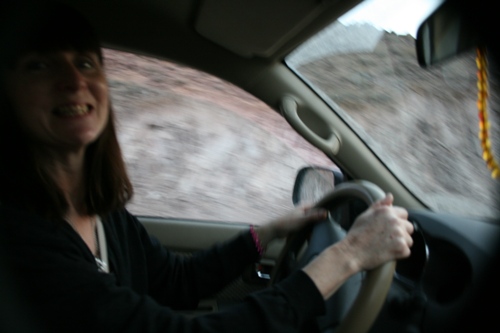 We stopped half way down for a photo opportunity and Talat promised he wouldn't do that 'Peace sign' thing... 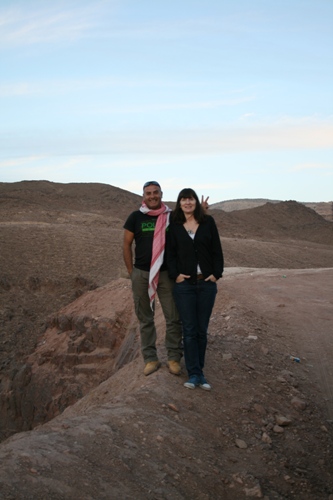 I see I'm a little naive!!! 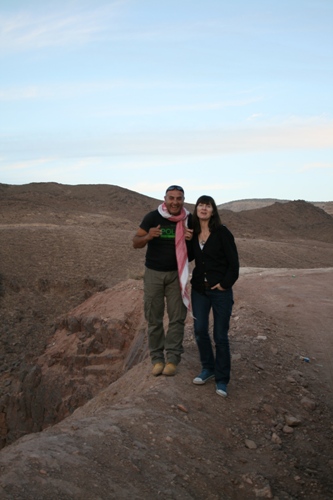 Day one part two: Jack and I ate lunch in a restaurant just up the road from the main entrance to Petra. Jordanian food is fantastic everywhere; always fresh, chopped, herbed, garlicked delicious food with lots of aubergine, tahini, yoghurt and bread. And three times I had lovely lemony lentil soup. This spread is called 'appetisers', the main course follows if you can manage that much.  We sat watching young men riding horses down the scrubby terraces across the valley and people passing on the street.  Jordan is a country whose ground struggles to grow anything, unlike UK where unless you put a building or a road on it, the earth grows stuff everywhere.  Jordan 2010 day one: We were due to fly on a Tuesday but Aliatlia moved us on to a Thursday. Rather than being upset, it meant I had two extra days to sort Christmas things out and Jack had two precious extra days on his PhD.  Waiting at Heathrow. I, like many people I expect, have a fear of flying. We were on an A321 Airbus...much relief as I'd been watching an expose on the poor workmanship in the building of Boeing aircraft. It was dark when we left. The plane rumbled along into position for take-off, the engines fired up, died back a bit and off we went. My fear just outweighed my excitement. The flashing lights on the wing were hypnotic as they lit up the fog through which we were rising. We got up above the clouds and into a starry sky and flew through the night with a stop-off in Rome. We arrived at about 3am. Talat was there to meet us (sleeping in his car) and we headed straight down to Wadi Musa (approx three hours drive) to meet the morning. 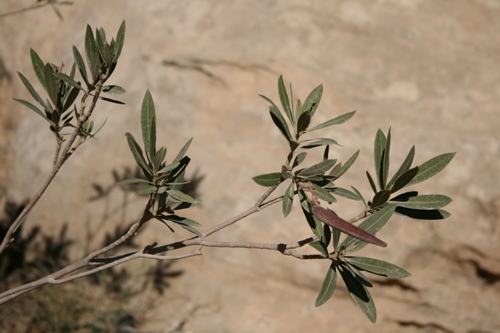 Talat was working that morning so Jack and I walked out towards the area called 'Little Petra'. I took my drawing things and Jack took his Chinese; we made a good working pair, Jack didn't mind how long I spent on my drawing as he always had his Chinese to do. 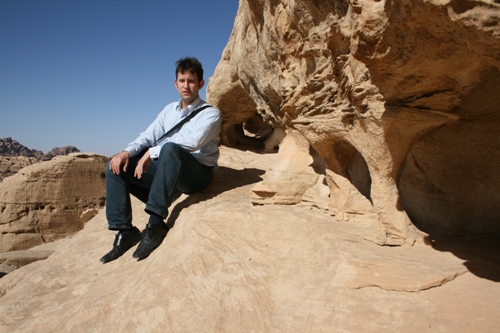 Later we sat outside in the sun at the Movenpick Hotel and had coffee. Smoking is endemic in Jordan. I loved the shape of the ashtray on our table. 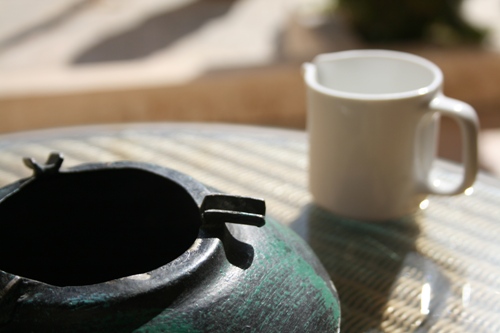 |
Wed, 22 Dec 2010 Back from Jordan, warm day time sun and cold desert nights...not one of the four flights cancelled, the tardiest flight just 20mins late, today we arrived only 15mins late into Heathrow but I'm still swaying gently -mild travel sickness, travel 'sway' perhaps. I wrote each day, I'll catch up on this blog. |
Wed, 15 Dec 2010 I'm sorting everything out to leave life in order while I'm away (with Jack, in Jordan for a few days)...beds for guests, food for a few days, washing, putting junk away etc. This was my shed this morning with the rising sun coming through it. 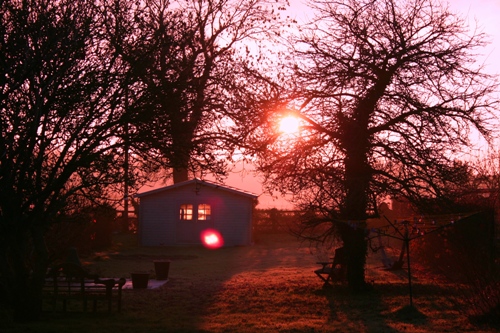 Right...off to post last cards/letters and collect George from Salisbury station. Keep thinking about how much I'm enjoying the life-drawing evenings. |
Tue, 14 Dec 2010 I've been to my life class tonight -brill- and, nothing to do with life class, Ive been experimenting with a very high iso setting on my camera. This would be like, in the old days, using a very fast film indeed. The only time I ever used very fast film in my old Nikon was when Jack was in an incubator and I wanted to photograph him without a flash. This time my iso number is set at 1600 and I'm photographing in our dimly lit dining room. These are the glorious flowers my Friday class gave me last week. I'm photographing entirely without any extra flash or light and nothing to steady my hand. 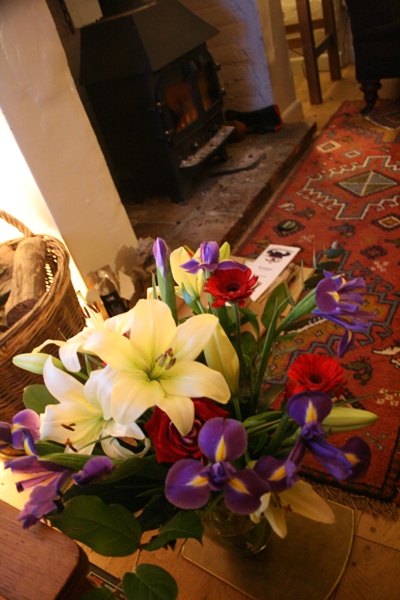 I've also been experimenting with photographing the telly through my specs, held up in front, to see where and on what the automatic focus rests. I can set everything manually on the camera too, if I want to. 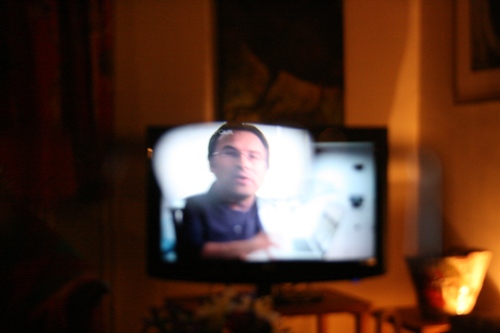 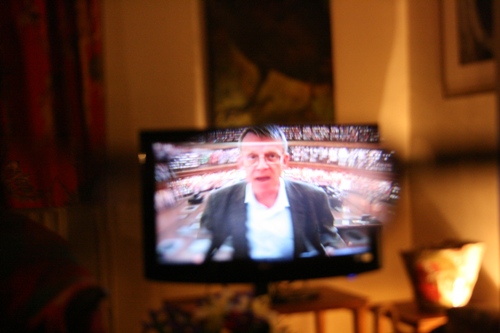 and a straightforward telly photo... 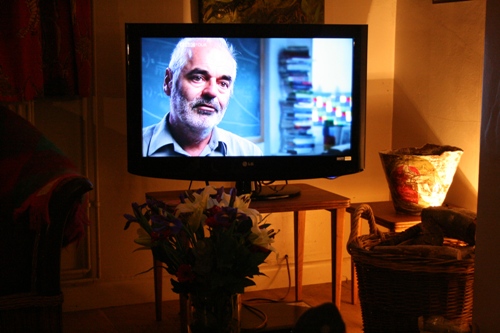 His eyes are rather striking -he was talking about statistics. |
Mon, 13 Dec 2010 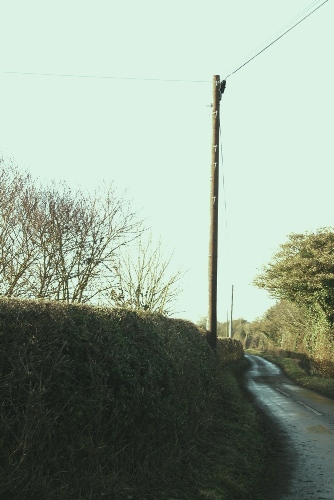 This one (below) is called 'Lovers do The Two-Step' 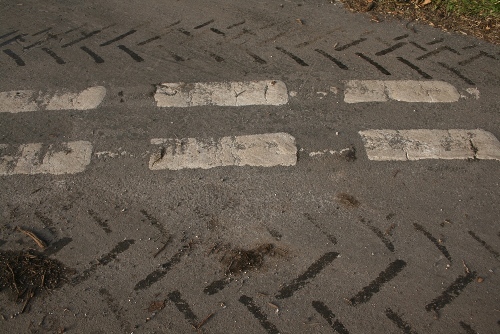 Yesterday was my last day of teaching before Christmas so, partly because our flights have been shunted forward by two days from tomorrow to Thursday, I'm feeling I have a breather -space to have to do nothing- I went out again with my new camera and a particular plan...to find poles, posts, gates and roads. 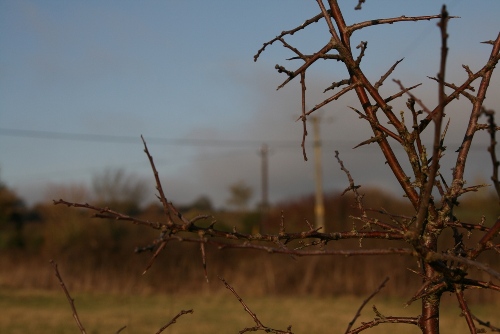 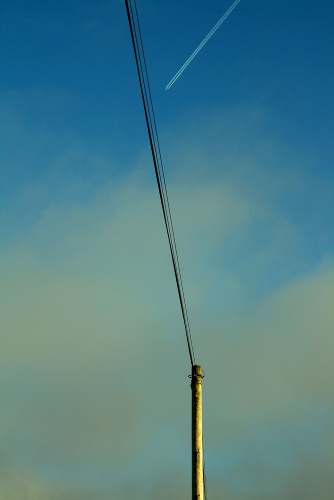 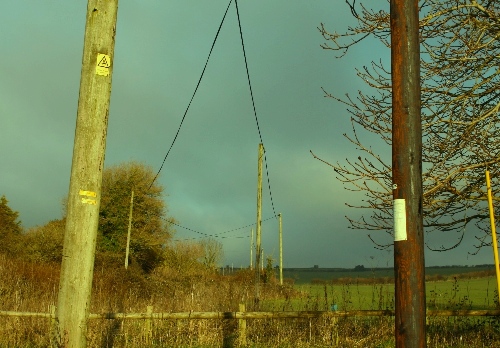 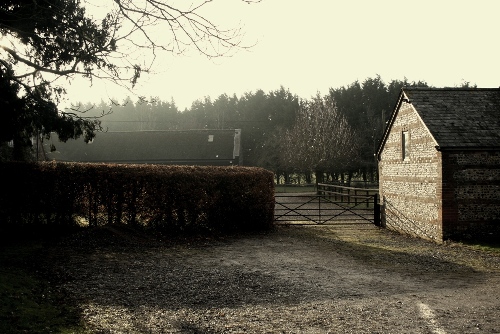 The snow has all gone and its been feeling balmy (almost) but the weather forecast keeps warning of more VERY cold weather to come and snow alerts from Friday onwards. I've been working from some drawings I made of Colin in the summer...finally; making more drawings and small paintings. When I'm working in my gallery where there's a woodburner I draw. When I'm in my shed its the large oil paintings I work on. |
Sun, 12 Dec 2010 I have fallen silent! I think the cold weather has stopped my tongue...or maybe its the rush of Chritmas before I head off to Jordan for a whistle-stop trip. I'm debating whether or not to take my new camera...its big. I think I can't resist taking it but if I do will it stop me doing the drawing I normally do there? |
Thu, 02 Dec 2010 A lovely snow day today and because so few turned up to class, after a coffee and chat, we decided to call it off. It meant I could come home and go out in the snow with my new (to me) camera. http://www.facebook.com/photo.php?pid=7394583&l=de6aa9199e&id=756081583 I've uploaded some of the pictures to facebook and I believe you can look at them if you cut and paste the link above into your web-address bar. I've just heard that we've been knocked out in the first round of the FIFA world cup 2018 bid -ppeeeuuuyyyrr..sickened- I'm sure now Russia will win it and Putin has known all along and probably already knew which is why he didn't turn up in Zurich today. I don't particularly care for football but FIFA is pathetic in its inability to curb corruption. Yep, I'm just hearing ..its Russia.. Bah!!! 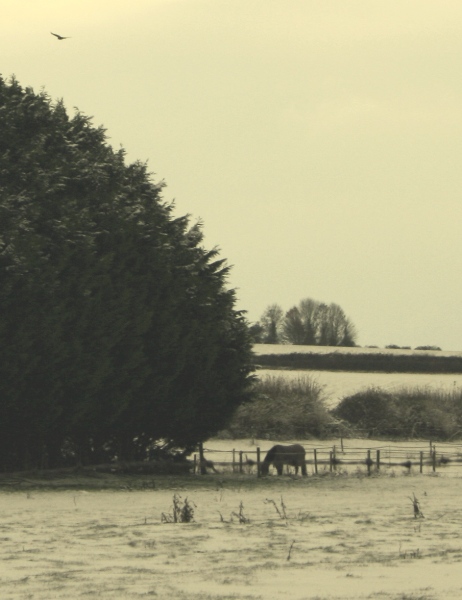 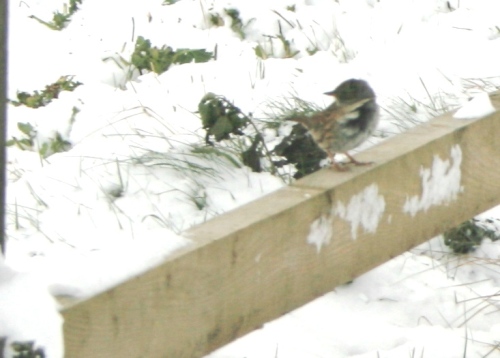 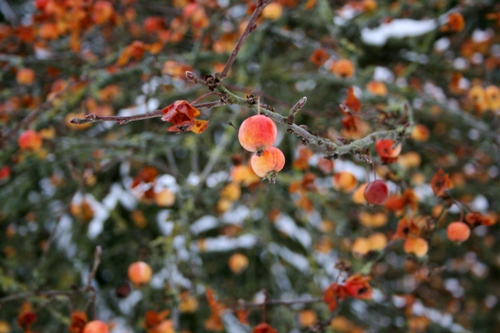 ...and Qatar have won the 2022 bid...the smell of money...what a reek. |
Sun, 28 Nov 2010 I've been using watercolour again today, working with one of the drawings from summer 'Mr. William's Forbidden Wood'. Mr. William lives in Tollard Royal and I took perverse pleasure in climbing (with my bike...I got severely scratched) into his 'Keep Out' wood (keep it a secret though) to draw. 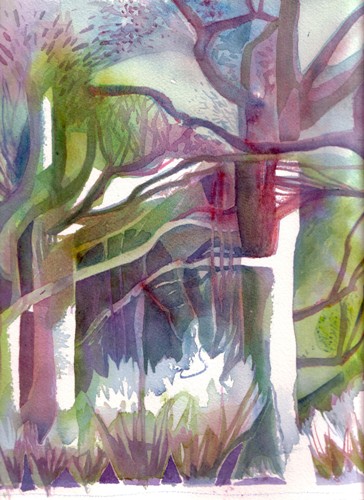 Another sketch from the other night, 'Man Walking'.  ...again enjoying watercolour. |
Sat, 27 Nov 2010 Okay...so I'm off my soapbox for the moment, but here's a link to an article from The Independent yesterday. http://www.independent.co.uk/opinion/commentators/michael-mccarthy-the-end-of-abundance-2143902.html |
Thu, 25 Nov 2010 I am really tired of hearing that painting is dead. 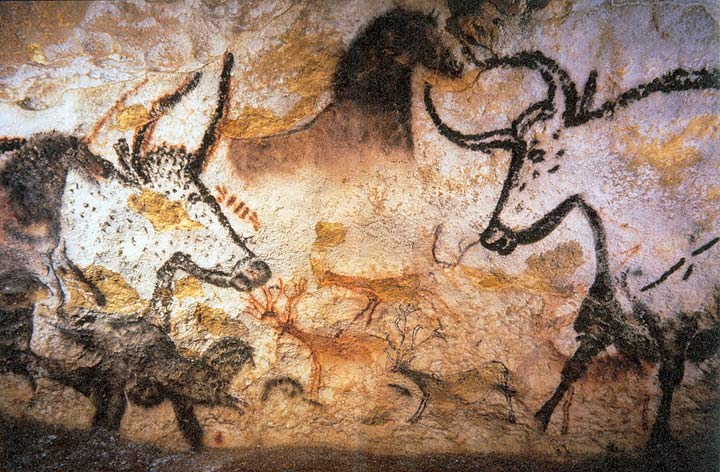 Lets look at these Lascaux paintings, more than 17,000 years old. Does the theory go -after 17,000years of painting that, within the last ten years or so, it is now obsolete? Ask yourself why the people who made these paintings were really doing it. It may well have been as part of a hunting rite, or for religious or superstitious reasons that they were doing it, but does anyone for a minute imagine that the people who actually painted these paintings did it for any other reason than they loved doing it? When I walked into the caves at Lascaux, for the first time in my life I had some insight as to why I feel such a drive to paint. It was such a relief; I was shaking hands with my very own personal forbears, with the race from which I've come -the painting human race. I think the 'painting is dead' group are urban, london-(or city)-centric, unengagingly self obsessed and out of touch with the most important elements of this world -the wildlife which we are in the process of destroying and oursleves too therefore. When I come face to face with wildlife, when I'm eyeball to eyeball with a wild animal (yes-remember Colin) thats when something extraordinary happens and one feels part of something much greater than that which humanity has created in the form of a city. Through wildlife and a close proximity to it one understands exactly where one's loyalty should lie. Perhaps when urban life has spread across our country, all that will remain are the paintings which in some way 'crystalised' the feelings of nature and wildlife. Finally, painting is not so dead that the 60 students per week who have managed to get into my classes don't want to do it any more. The problem is that 'painting' for a small, elite, rarified and removed group who congratulate themselves and each other on living right outside the loop have decided that they want us to watch their art-videos or admire their installations, but these things just don't compare with the moment on Exmoor recently when I came eyeball to eyeball with the Barn Owl and she held my gaze for what felt like 120 seconds...I'd have that any day rather than...a huge mound of wax squeezing through my sitting room. 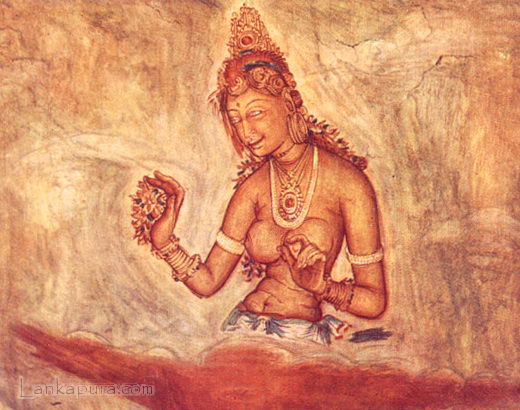 Rock Art at Lion Rock, Sigiriya Ceylon, 5th Century AD. 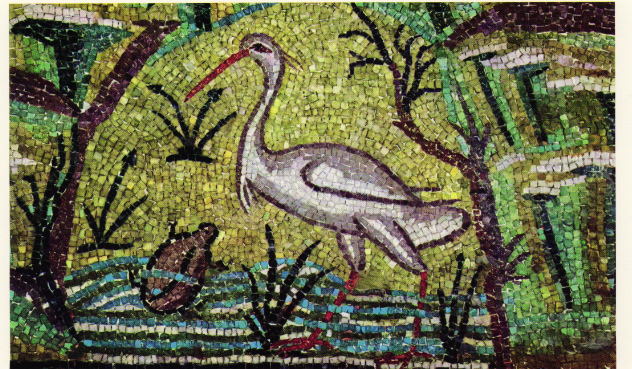 A sixth century mosaic from Ravenna.  St. Benedict, by Hans Memling (1430-1494). |
Wed, 24 Nov 2010 I joined a new life class last night, the first time in a while that I've done some life drawing. The two hours felt like 10 minutes and I could have done with two hours more -drawing a lovely eccentric young man called Milan (his Mum is Czech) who made his own glasses frames and got specsavers to put the lenses in. They had something of a Heath-Robinson look to them, or perhpas like glasses Phileas Fogg might have worn on his journey around the world in 80 days. I like to draw with watercolour when I'm life-drawing because I can use shape and edge rather than line. Shape beside a hard edge gives weight to the area left un-painted (the irony of watercolour -you have to be more aware of the shape you don't paint than the shape you paint). Here is one of the sketches from last night. 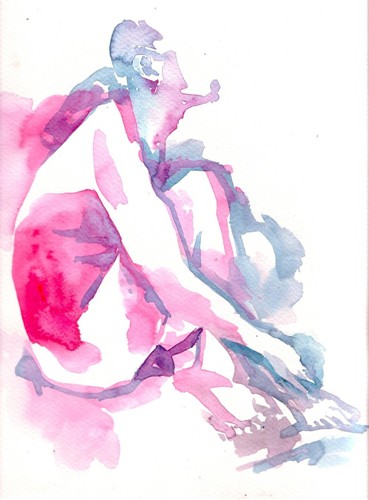 |
Mon, 22 Nov 2010 Saw Hamlet at The National last Saturday, with Rory Kinnear. He was fantastic and although the play was long and wordy at times it provokes thought long after it's over. I hadn't known that 'To be or not to be' came from Hamlet...or Ophelia's drowning... 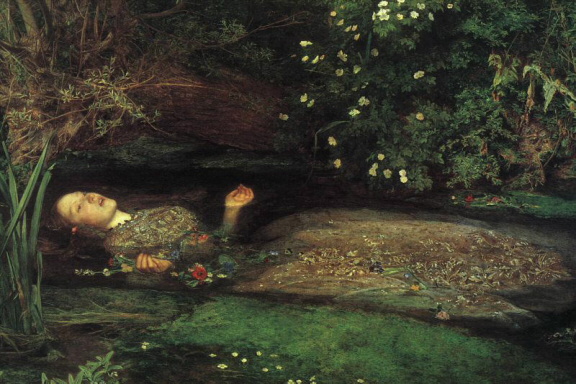 'Ophelia' by Sir John Everett Millais, completed between 1851-52. Currently held in the Tate Britain in London. |
Fri, 19 Nov 2010 Yesterday, as I was hearing the poem below, without thinking about it, I saw the loved 'you' as Exmoor, and the interloper as the one who might attempt to look at Exmoor through my eyes...is that mad of me? Reading it again today, I guess MacCaig may have been in love with someone who had another lover. I'm amazed I didn't see it sooner. |
Thu, 18 Nov 2010 ""A Man in My Position"... Hear my words carefully. /Some are spoken /not by me, but /by a man in my position. /What right has he /to use my mouth? I hate him /when he touches you /the wrong way. /Yet he loves you also, /This appalling stranger /Who makes windows of my eyes. /You see him looking out. /Until he dies /of my love for you /hear my words carefully - /for who is talking now?" -----I heard some poems by Norman MacCaig thisevening. I was particularly taken with this one. |
Mon, 15 Nov 2010 I know winter is here when it reads -2.5 on the car thermometer coming home from work on a Monday night; and when I get back Orion is popping up over the south eastern horizon. Apparently it is one of the most conspicuous, and most recognisable constellations in the night sky and can be seen throughout the world. This is what Wikipedia says about Orion: The current configuration of stars now known as the constellation of Orion formed roughly 1.5 million years ago; stars move relatively slowly from the perspective of Earth. Orion will remain recognizable in the night sky for the next 1 to 2 million years, making it one of the longest observable constellations, parallel to the rise of human civilization. Because it is so bright and distinctive, the pattern of stars that forms Orion was recognized as a coherent constellation by many ancient civilizations, though with different representations and mythologies...  ...might this say something about our need to make connections out of apparent random? I suppose Orion's movement across the night sky as a comlete collection make it seem like a 'whole'. It's only now that we know there must eons of light years between the actual stars themselves. |
Sun, 14 Nov 2010 So, while thinking of The Epiphany window in Robinson College Chapel, I looked again yesterday at the enormous Rubens painting of the same subject at the far end from the main entrance in King's College Chapel. I suppose it's down to fashion, but it's difficult to be moved in the same way by this painting (dated 1634) as by the Piper window. 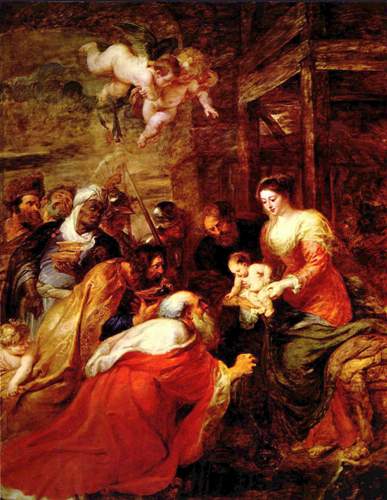 I found the same subject painted by Murillo, working in 17th Century too, and such a similar construction to the Rubens. This leads me to think that either the patron insisted on the composition or fashion was so strong as to dictate the composition. (Note the seemingly discarded bits of wood in the top left hand corner which have 'fallen' into the shape of The Cross.) 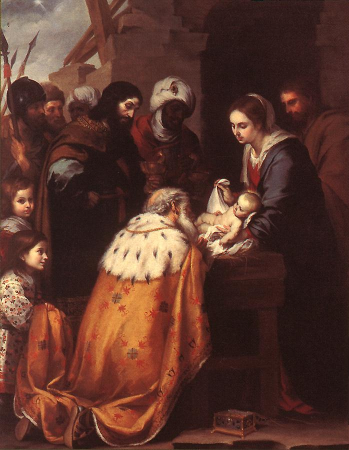 In the Murillo painting I love the clarity of edge. Edge is something I talk about a lot when teaching. Of course there are all qualities of edge between hard and soft -so soft the change from one tone to another is almost imperceptible. I find the wooliness of Ruben's edges and the slightly cheesy emotion portrayed in the 'tilt' of the figures a little bit less satisfying. (Not sure 'cheesy' is a technical term in art!). I therefore prefer the more reserved emotion that we see in the Murillo. Just to throw another one into the mix... 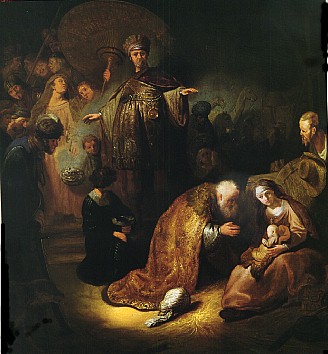 ...look at Rembrandt's version of the same. Look at the way Mary leans in to hear the whisper of the old Magus (even Joseph behind Mary is craning his neck to listen). For a moment she's so absorbed in what the old man is saying she's forgotten about the baby on her lap. Its the circle of light holding them in the corner, picking up on the old man's wispy white hair, Mary's beautiful teenage face and the top of the baby's head which keep us focused on the subject. In deference to The Son of God he has uncovered his head and Rembrandt shows us the hat cast to one side. In Jewish law men cover their heads to remind them the 'Divine Presence' is above their heads. In this painting the Divine Presence is well and truly on the knee of Mary and a touchingly real baby for the manifestation of God on earth. This painting should be called 'The Whisper', in counter-balance to the Magus behind, in shadow, desperately trying to proclaim and be heard in a big and pompous voice -The Birth of The Living God. |
Sat, 13 Nov 2010 We went to see Jack today in Cambridge. After 8 years there he's looking for new stamping grounds (China most likely) and we went up to collect some of his stuff and bring it home. As we drove in past Robinson College Simon said 'I think there's an interesting chapel there...'. Sure enough... a chapel with John Piper windows (he of the Coventry Catheral Window fame). 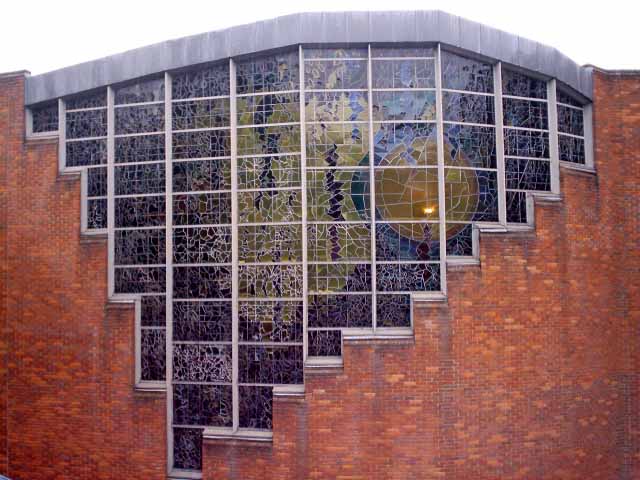 This is the ouside, resonant of the same section-style of the Coventry windows, and again not a flat wall of window but windows with a collective curve. 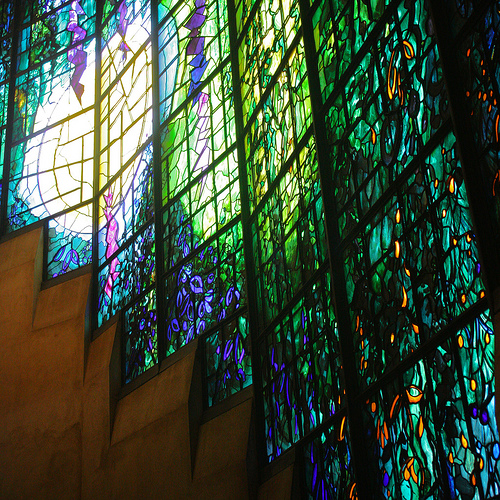 Inside, it was clear that the sun is the central theme, again like Coventry, and that its brightness is intensified by the deeply coloured windows around it. This was all gorgeous enough, but in a quiet little side chapel... 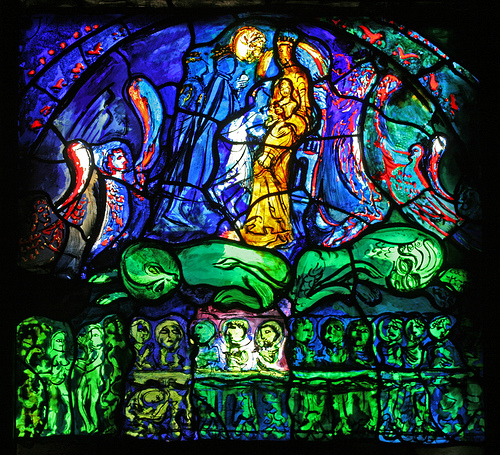 ...is this window, designed by John Piper again and depicting the Epiphany. Captivating and sublime. See the two animals surrendering gracefully, a lion and a goat I think, that have crossed tails beneath the main scene. We had lunch in Jack's college hall (Trinity) possibly the last time for us, so I was able to look again at the huge Holbein of Henry VIII glaring out across the diners in that provocative bold manner as they eat...and today the bread-and-butter pudding was DEEEElicious! Of all the Masters' portraits around the walls of the dining hall, my favourite by far is that of Amartya Kumar Sen, Master 1998-2004. I've never photographed the painting and nor can I find it on-line so I'm afraid I can't show it. I'll ask Jack to take a picture before he finally leaves early next year. Journey home in less than three hours...not bad going. |
Fri, 12 Nov 2010 I've been working on a huge watercolour (40" X 27") of the Emperor of Exmoor, as he was killed about the time we were there last month. The lovely piece of paper (Indian, hand made I think) was given to me by a friend and student of mine Sue Bates (www.suebates.net). 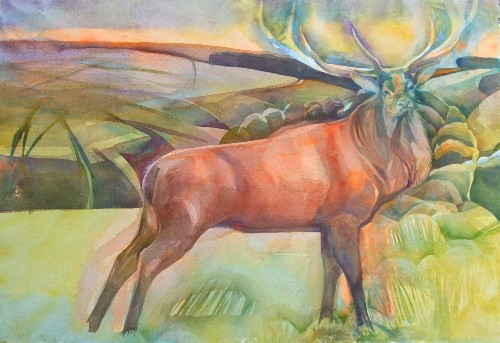 Of course I'm filled with trepidation about its being too much of a cliche like 'Monarch of The Glen' but in the end the desire to make the painting must have overcome my worries. My aim at the beginning had been to place and integrate his head against the busier area behind him of Exmoor, Ram's Coombe leading down to the Exe Cleave, and place his great muscly flank against the open moor. Oh my God I love Exmoor!!! |
Thu, 11 Nov 2010 So today was wild and wet, and when I got to the hall where I teach, the huge arched windows were covered in those evocative raindrops which remind you of school days and being trapped behind the classroom window when the whole of life was going on outside. From my school in Taunton there were views of the Blackdowns; I would look across to the Wellington monument, a tall needle of a memorial built in honour of the Duke of Wellington on the highest point of the Blackdowns, and on the wildest days wish I was out there in the thick of it. Through my hall windows is a little garden, which until recently was a wild thing overgrown with buddleia and brambles, but has been recently gentrified...rightly so...I would have done it if it were mine. The owner has built a small outside room at the far end of the garden and made a little path to its door, an entirely more usable space but I miss the small wild patch which reminded me of wanting to be part of it. 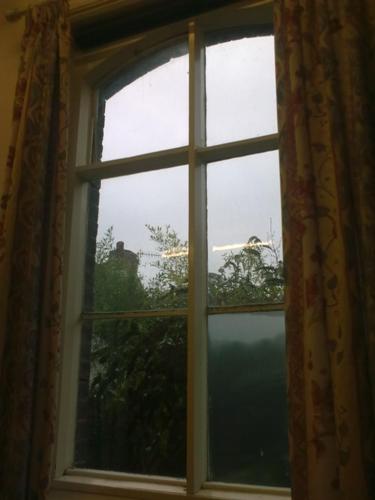  |
Tue, 09 Nov 2010 Just about to start a Brag Book..feels slightly out of character but I think it's an incredibly good idea to keep a fluid narative recorded about one's work. Here's my first page...I found a person who had blogged about my work...very nice person! The following images are paintings by the English artist Clare Shepherd. You can find her website at www.clareshepherd.com 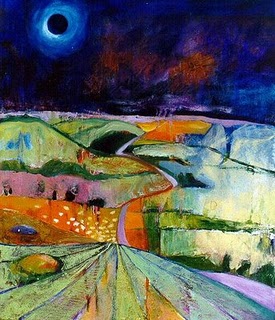 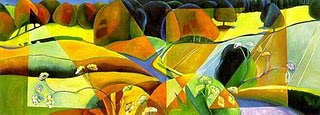 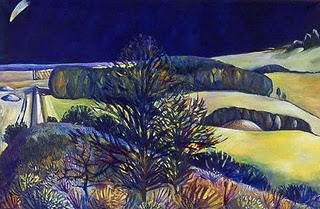 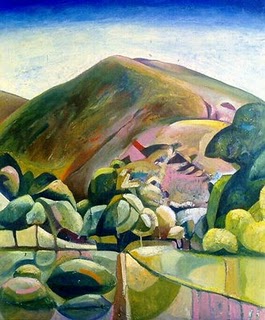 My featured artist this week is Clare Shepherd who is an English artist living in Dorset. She also enjoys teaching art. She has a wonderful colour sense and her paintings are very contemporary with lots of light and colour. She uses shapes to advantage and these veer slightly toward the abstract. Her work covers a very wide spectrum and on her beautiful website www.clareshepherd.com you can find a huge quantity of artwork. I especially enjoy her landscapes of Dorset and Exmoor. Posted by Cathy at 11:31 AM 10 comments Labels: Birds, Chickens, Christmas Cards, Christmas Tree, Clare Shepherd, Deer, digitally coloured, Figurative, Hats, Illustration, Painting, Pen and Ink Drawing, Stars. ----- Of course I wish I'd been more careful in keeing all articles and write-ups...but it's no good crying over spilt milk and there's no time like the present (to coin two well used phrases...and now a third!!!) |
Sat, 06 Nov 2010 Here it is! The sofa in its new clothes! It struck me that my Mum had it re-upholstered when I was 18 years old and that I've had it re-upholstered now that Mary is 18 years old...is there a pattern emerging?  Talking of clothes...the apple tree has shed her clothes for the winter (as we're putting on our warmest ones); here she is, clothes cast down beneath her like a Hollywood Starlet! 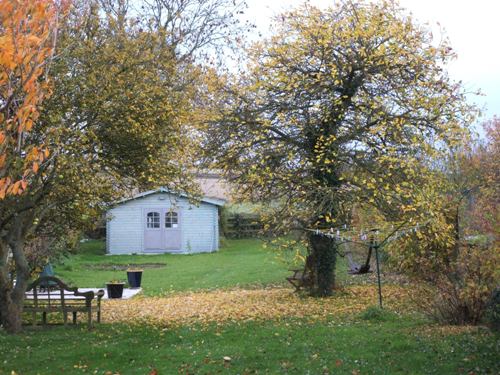 |
Thu, 04 Nov 2010  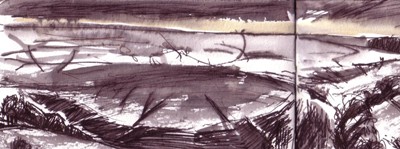 This is one of the sketches from my small sketch book which I carry in wet weather or on long walks. I was sitting beneath an Exmoor stone bank sheltering from sweeping horizontal Exmoor rain coming in on my left. Although I used the two page sides and created a l-o-n-g view, I have cropped some of the sections which interest me and from which I may well work further. I can squeeze a huge amount of information out of every drawing I do. Partly its because memory plays a role i.e. I know the area; and partly because when you sit and draw you see so much more than when you take a photograph. The drawing requires that you look for, and see, every little bit about which you subsequently make a response on your page. I say to my students 'Always refer to your drawing...it'll tell you exactly what you need to know'. Every drawing that looks like it took 5 mins took at least 50 mins! 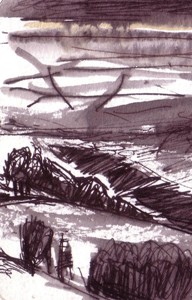 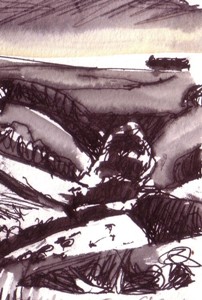 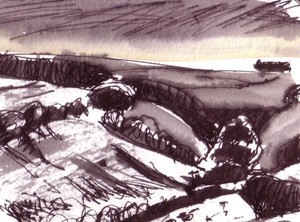 |
Wed, 03 Nov 2010 I love this pot for its wild frenetic scratchings, colours and gold bits, for the Martin on it and the deer swimming, trying to escape the hunt. It gives a real feeling of wild Exmoor. It was the most enigmatic of the pots, the least easy to decipher the drawings. Its made by Jacqueline Leighton Boyce and you can see more at www.jacquelineleightonboyce.co.uk 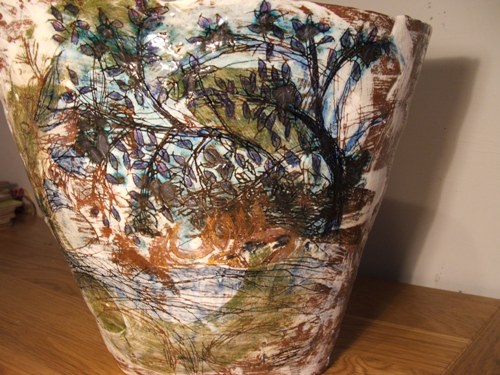 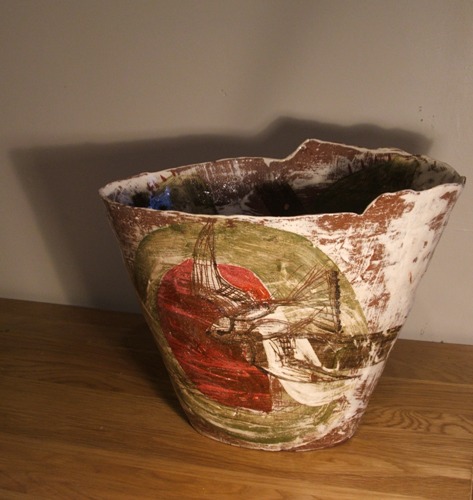 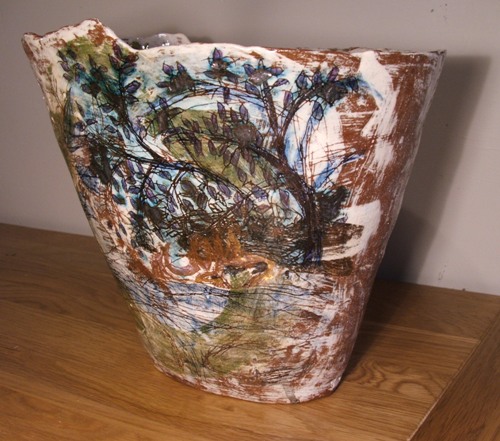 Well....I turned up a week early for the lecture last night. I know I'm legendary for being early but last night could be said to have been ridiculous if I hadn't found myself instead at a debate: Darwinian Evolution - Intelligent Design. Serendipity I think, and a debate RIGHT up my street! I met... 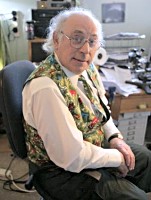 Professor Jack Cohen, who was speaking on the side of Darwinian Evolution but aka 'Honorary Wizard of The Unseen University' as bestowed upon him (and Ian Stewart) by Terry Pratchett with whom he's collaborated on many books. I had such a great evening! 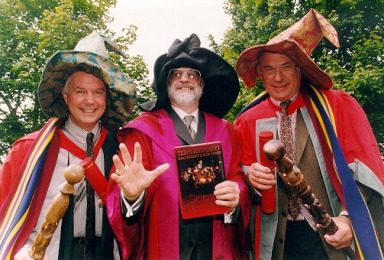 Ian Stewart, Terry Pratchett, Jack Cohen...and I wasn't persuaded to believe anything different to that which I believed before...but reader...I'll keep that to myself!!! (for once). |
Tue, 02 Nov 2010 'Supper at Emmaus' Caravaggio  Tonight I'm off to Bath to a lecture at the Bath Scientific and Literary Society on Caravaggio. I don't know much about him but I do know that I cribbed his composition and his Jesus for my painting 'Black Mates in Seven'. It feels like an incredibly grown up thing to; cook early for everyone here, head off about 4pm having sorted all the paintings to go to The Acanthus Gallery tomorrow (with my Dad's help), I'm really looking forward to my evening- 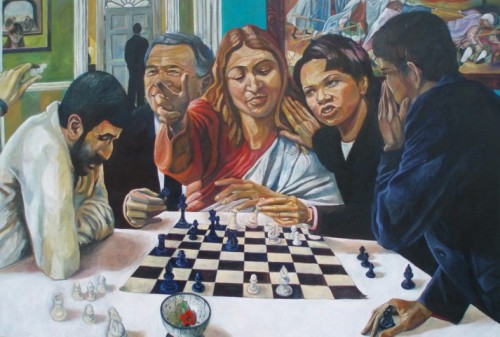 |
Sun, 31 Oct 2010 I ran a really enjoyable workshop today; some people doing their own thing and some following a watercolour lesson. Whatever people choose to do I can guide them, and generally help to focus their ideas. It felt like a really productive and happy day. I have more Exmoor photos to upload within the next few days. My Goodness Me it was a wonderful week! Can't wait for next Feb. and our return. |
Sat, 30 Oct 2010 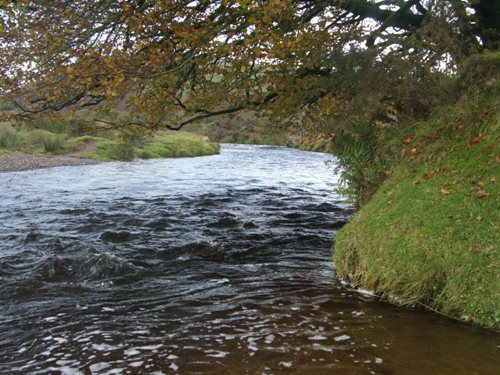 Fallen living tree. 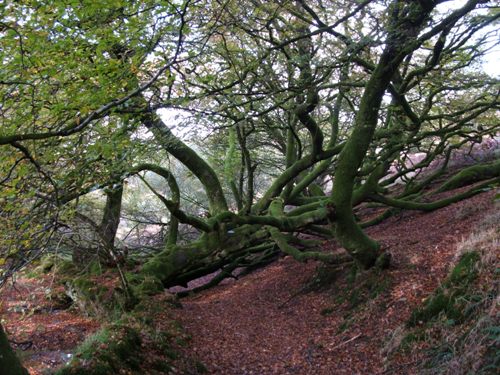 Looking down on White Water.  Exmoor October 2010 day five I was dropped at Landacre (pronounced Lanacre; cross between Lineker and lanoline)Bridge today. It crosses the River Barle with a chunky and impressive five-arched stone bridge. I had an urge to follow a larger river than the Exe and the Barle was the one. It is a rapid river, always in a hurry, slithering through the landscape like a giant snake. Sometimes its banks are steep, peaty and vertical from the water but in other places the river creates beach-like stretches of flat Exmoor stone and silt, where the water is quieter collecting in side eddies off the main run. I joined a footpath for a short while and followed the river to Cow Castle, an earthwork on top of an odd hill in the middle of a place where three valleys meet. This was the only place where I saw a soul today-that’s how I like it! The moors around Cow Castle are quite a lot higher but I guess it was a good lookout for an Iron-age group who wanted to see who might be coming from any one direction. How you’d hide from an enemy once you’d spotted them on one of the surrounding hills I’m not sure! I moved off the footpath and up a steep hill; I had to cross a little river called White Water and was trying to do it so that the soul I saw didn’t see me do it. I walk a lot off the beaten track...I don’t want anyone else to notice! This was probably the only place I wasn’t sure of today; I knew I was looking for a track or small road and had to keep my eye out for anything recognisable to tell me I was in the right direction. Once I got to the top of the hill I could see Dunkery Beacon in the distance and felt a bit more certain of which way to head. I saw and heard plenty of buzzards, some being nagged by rooks and jackdaws. I saw two squirrels in two different places –unusual- I don’t often see them on Exmoor. I was relieved to find the road, which was the least interesting part of the walk as the sides were steep beech hedges and I couldn’t see through them. I kept hearing an amazing fighter plane practising over Exmoor but I only ever caught sight of it when it crossed above the road. Once when I sat down to draw I was surrounded by a flock of long-tailed tits all chittering around and swapping places in a little thorn bush. Where the little road met a bigger road at a T-junction I crossed and climbed over a dry-stone wall. Once over the wall I knew exactly where I was, on the moor over the Exe Cleave. It was about another hour to the cabin, down a hill we call ‘Heart Attack Hill’ because it’s so steep but has breathtaking views along the Exe valley in both directions. I know this whole area well –it always feels good to get to this bit. In all about four hours, including some drawing-stops. It was intermittent sunshine all the way...no rain! 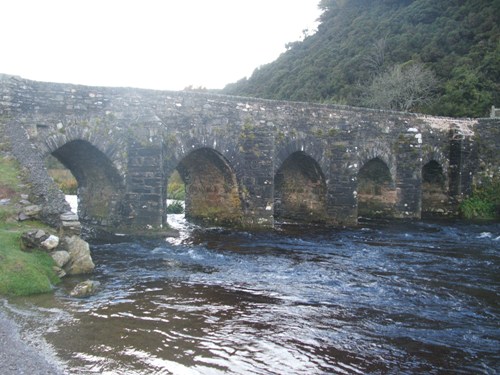 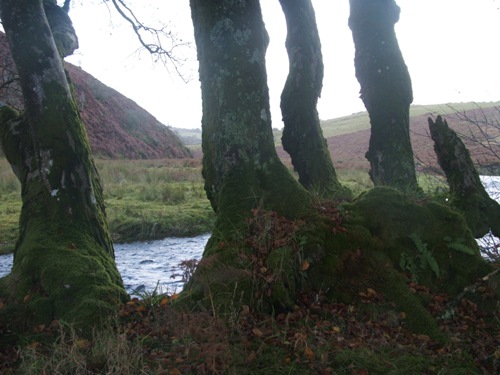 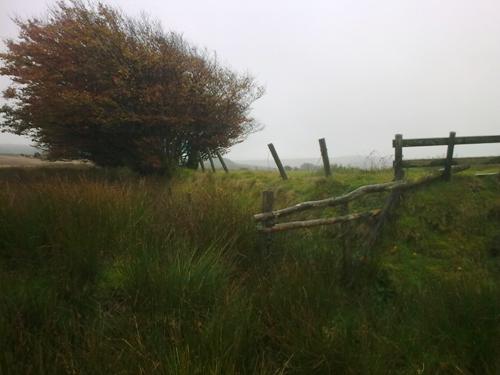 Exmoor October 2010 day four Today I was dropped on top of the moor, in the driving rain, to make my way back to the cabin. My way down was across the top for a while and then down through a cut in the hill where a small river called Sparcombe Water rises and runs down to the Exe. Before I’d even moved down I was soaked where my coat and wellies didn’t reach and attempting to take photos with my phone-camera of places I’d return to draw in dry weather. It’s an ankle turning scramble down, through mud, rocks, gorse and overhanging beech trees, but the leaves are turning tan, gold and ruby and the last gorse flowers are out on the tips of the prickly stems. All the way down I was bumping into young Aberdeen Angus bull calves and using the trails they’d made between gorse and the crumbling man-made stone banks which carry the beech trees (and have probably crumbled as the beeches grow bigger). I’m amazed at the bullocks’ tenacity and, for such big lumpy things, their agility in accessing some of the trails I followed. It was definitely bovine tracks I was seeing as well as the Red Deer tracks. I suppose they have the benefit of a leg in each corner whereas I have to hope there’s a beech branch to grab to stop me tumbling down the steep slope. Every now and again I tumble but into soft peaty mud, or occasionally gorse or the tall prickly grass which grows in clumps. When I got to the bottom of the valley I paddled across the Exe; it’s not so full at this time of year so at the wider parts easy to wade. Unlike today, our first two days here have been clear blue skies and morning to evening sunshine so I’ve been out in it and drawing as much as possible. In the end I prefer today’s weather and, as I was battling with it, I was thinking that every inner city child should have access to this. I was re-mis-quoting to myself Anthony Gormley’s ‘we ignore the figure at our peril’ to ‘we ignore landscape at our peril’ and contemplating the knowledge that I am a rural person and about as far removed from being urban as a goldfish is from riding a bicycle. Yesterday Simon and I were in Dulverton and visited a small exhibition of pottery, glass-work and prints. I was absolutely bowled over by the pots and the images on them...reader we bought one! When we take ownership of it I’ll photograph it for all to see. 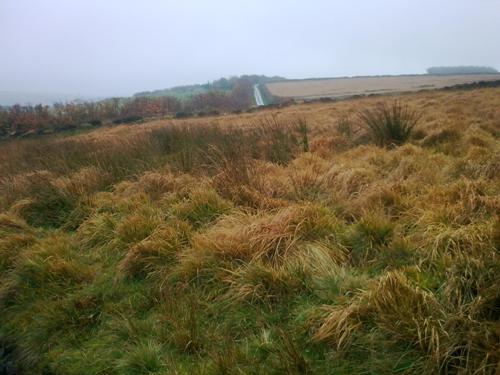 Exmoor October 2010 day two Walking up above the cabin, and drawing; I sat and drew in a field of young Aberdeen Angus Bullocks. They were very inquisitive. One of them pulled the laces of my (lace-up) wellies un-done, twice! And they tried to nibble my drawing book and my phone when I filmed them. I also saw a barn owl in bright sunshine, like a great white ghost. I was by an old barn from which it flew out in front of me. It sat on a beam at the edge of another barn and looked round at me with its great black eyes. I saw a Heron too, lifting up across a small lake beside the Exe and creating its own perfect reflection in the water. 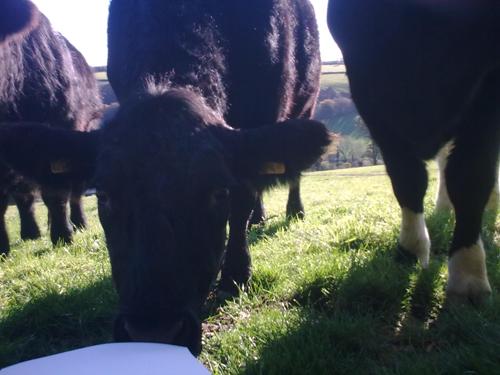 |
Tue, 19 Oct 2010 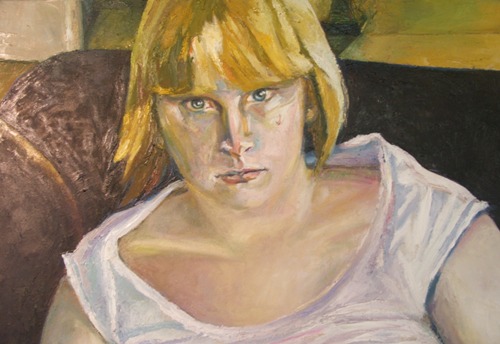 ...after another sitting from Mary this weekend just gone...Next Saturday I'm off to Exmoor for a week, more painting etc. As there's no phone signal or internet connection I'll save all thoughts on word and upload them on return. |
Mon, 18 Oct 2010 I've been very busy getting things ready for the exhibition in November/December. It has meant I haven't been blogging here as much as usual. Don't imagine I have less to say...I had another letter in the paper last Friday -another political rant. After hearing about a new bee which is inhabiting Uk and was first seen in Dorset, the Ivy bee, I went looking and for the first time had a really close peer at ivy flowers in full bloom at the moment. 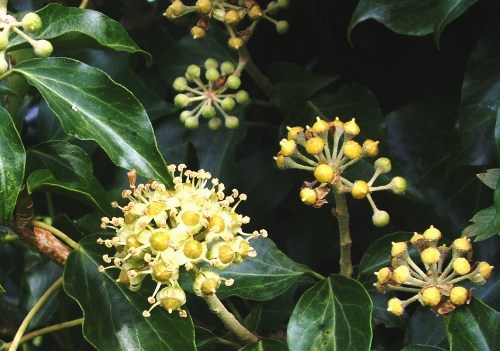 I'd heard about the flowers dripping with nectar which the bees love. You can bet I was amazed when I saw exactly that, and the most delicate stamens, five on every round blob...how had I missed them until now as our garden is full of ivy?? Mary was home for the weekend and so I had a glorious sitting from her...she was making funny faces but I bore with it! However look at this...the sofa after less than one day!!!! JUNK!!! 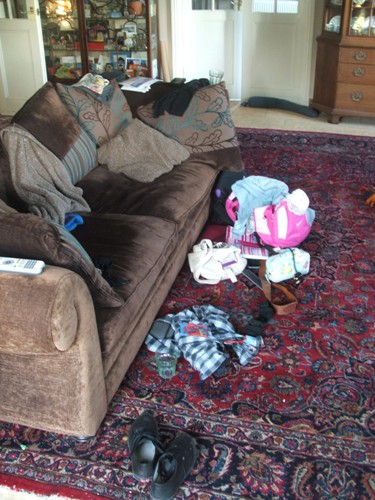 Apropos of nothing I'm going to have a little rant...George Osborne goes on about fining fraudulent benefit claimants and for three offences cutting their benefits for three years...well I'd like him to cut the expenses claims for all MPs who claimed expenses fraudulently...and if they did it fraudulently for seven years, then for seven years they should not be able to claim any expenses at all...bloody MPs. Double standards are fascinating and compellingly interesting. |
Fri, 15 Oct 2010 Ohhhh no!!! I've just uploaded a picture of some Victorian Moustache cups to 'A History of The World in 100 Objects' and although I've spelled it correctly thoughtout, I've spelled 'commemorative' wrong in the title...Ahhhhh..Simon will tell me off!! I've seen mother pigeon with what I assume is her young one several times in the garden, usually in the apple tree in which she normally sits, and the hedge beside the house and Colin's thorn-bush. 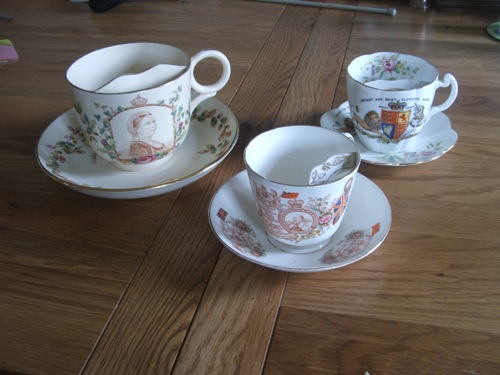 These three cups commemorate Queen Victoria's Jubilee, 1887, her complete reign, 1837-1897, and the Coronation of Edward VII and Queen Alexandra, 1902. |
Mon, 11 Oct 2010 Listen to the deafening clunk as the nation's collective jaw drops at the news that Linda Norgrove was 'probably' killed by the detonation of an American grenade. The point is that if this were the first and only mistake made in this 'war' we may have had the confidence to believe that nothing would or should have gone wrong, but so many awful mismanageMENTAL mistakes have happened that really we should hoist our jaws back up and not be surprised. I'm hearing on the radio about the 'Suicidal Terrorists' who held her, but firstly I'd love to know in depth how they describe themselves and secondly why they do what they do (kidnapping, guerilla warfare etc) and what they feel they are fighting for. Until we know more specifically what we're fighting for and against I can't see an end in sight to the war. Our continued fighting ensures the continued guerilla warfare by the opposition, such as we know them. It brings to mind that old Einstein theory 'Action and reaction are equal and opposite'. |
Sun, 10 Oct 2010 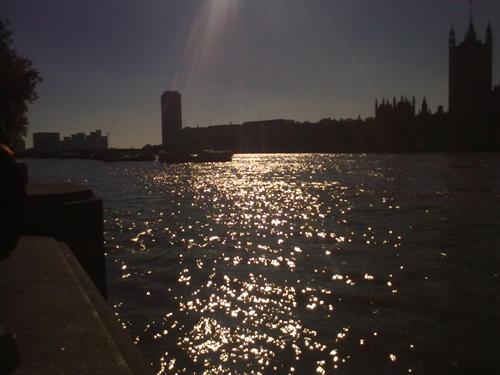 Looking west along the Thames from the Albert Embankment (just across the river from The Houses of Parliament). We've had a wondeful day in London with Mary, delivering her bike to her and between the three of us working on the best wording for a letter to 'student-finance-england'. Who knows if it will change things this year but, even though we've had two sons go through the application process, I couldn't remember if students re-apply each year...turns out they do so next year shouldn't be the same as this year as long as Mary gets it straight with them. Mary's digs are within ear-shot of Big Ben and so everyone registers the time by the chimes...all through the night but unobtrusively so I'm informed! We wandered out via Archbishop Park to Waterloo where we stopped for coffee and watched the train-travelling-world go by, and then on towards the river where the London Eye looks over it. 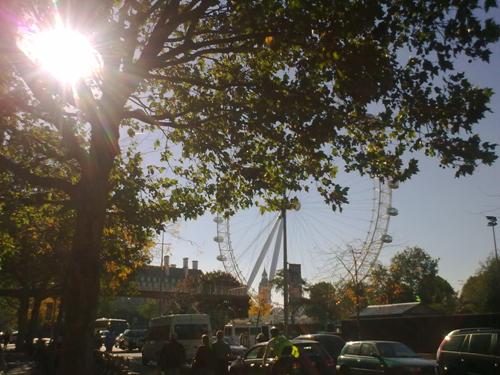 It has been an unbelievably balmy blue-skied day, 22degrees and it seems everyone was out to enjoy it.  The queue for the Eye was long but it wasn't in our plans to try, there was as much pleasure in watching people picnicking, buying ice-creams and cycling (on Boris's Bikes -I'm sure I was seeing one Boris Bike for every civilian bike), tourists photographing, ambling in 'outfits' and being a huge diverse slow moving crowd. 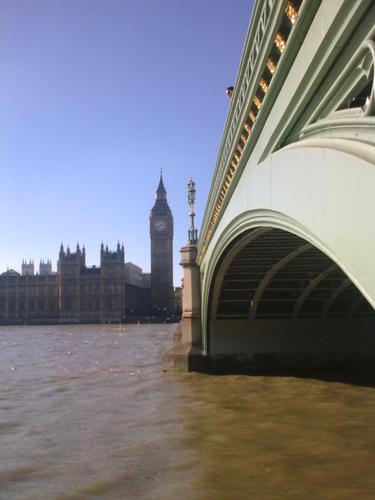 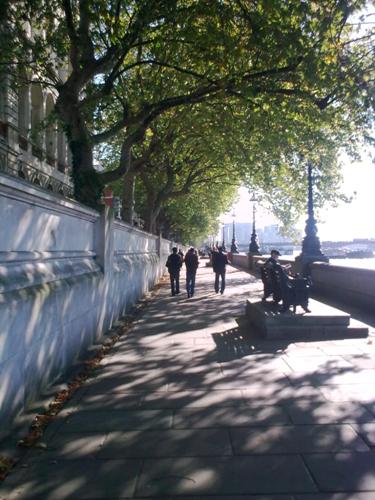 We walked back to Mary's digs along the Albert Embankment, a remarkably relaxing day for such a whistle-stop trip. |
Fri, 08 Oct 2010 I was driving home behind a Ford Ka this evening, and although perspective is a thing I know about inside out, I was still amazed at how I could see both the front wheels of the Ka BETWEEN the rear wheels (see picture) 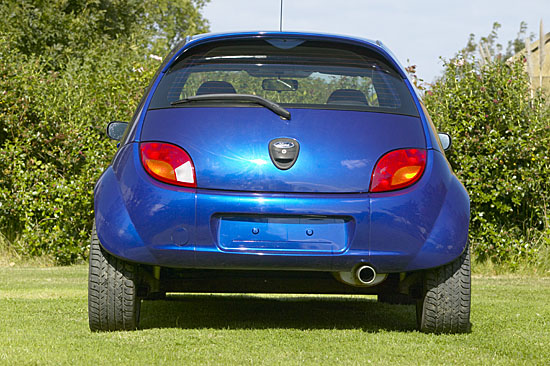 I know, and I'm constantly telling my students, that within a very short distance any certain width appears significantly shorter than it is and therefore the front wheels MUST fit between the rear wheels, but it didn't stop me feeling that it was an entirely magical and impossible thing that I was witnessing all the way home. Its like peering into the corner of a mirror and finding you can see the reflection of the things around the corner behind you in-real-life. |
Thu, 07 Oct 2010 Frustration! Mary was sent two letters by student-finance saying she was eligible for a yearly loan of £4995; she's in the cheapest student halls, £4600 for the year so she can just about manage with some weekly food money from us, but today she gets a letter from student-finance saying that she's actually only being given a yearly loan of £3325. Are they absolutely bonkers? You cannot imagine how livid I am, not least because its impossible to get to the bottom of this, its like trying to swim through a bowl of spaghetti. How exactly are young people supposed to manage? Its not as though she's asked for a hand-out, just the loan for which she's eligible and will have to pay back one day. *fume*frustration*fume* So...I put the words 'calming images' into google and it came up with this funny picture! 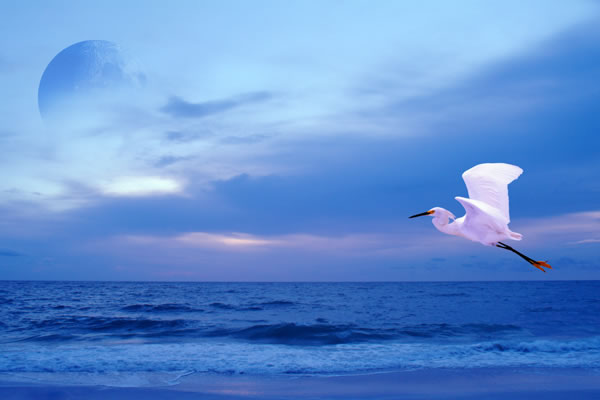 I don't think its calming me much but the oddness of his red feet is intriguing. |
Tue, 05 Oct 2010 Art can describe several things: a study of creative skill, a process of using the creative skill, a product of the creative skill, or the audience's experience with the creative skill. The creative arts (art as discipline) are a collection of disciplines (arts) that produce artworks (art as objects) that are compelled by a personal drive (art as activity) and echo or reflect a message, mood, or symbolism for the viewer to interpret (art as experience). Artworks can be defined by purposeful, creative interpretations of limitless concepts or ideas in order to communicate something to another person. Artworks can be explicitly made for this purpose or interpreted based on images or objects. Art is something that stimulates an individual's thoughts, emotions, beliefs, or ideas through the senses. It is also an expression of an idea and it can take many different forms and serve many different purposes. The nature of art has been described by Philosopher Richard Wollheim as "one of the most elusive of the traditional problems of human culture". It has been defined as a vehicle for the expression or communication of emotions and ideas, a means for exploring and appreciating formal elements for their own sake, and as ‘mimesis’ or representation. Leo Tolstoy identified art as a use of indirect means to communicate from one person to another. Benedetto Croce and R.G. Collingwood advanced the view that art expresses emotions, and that the work of art therefore essentially exists in the mind of the creator. 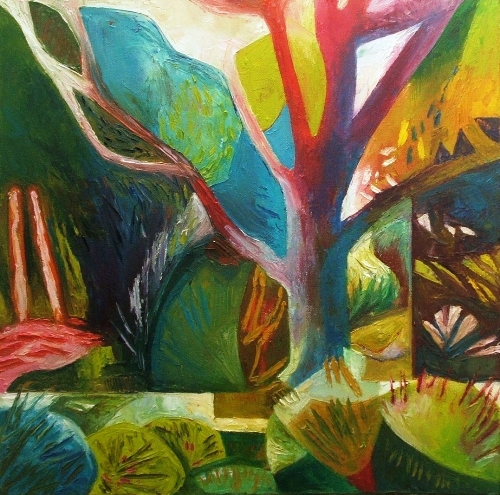 Summer 2010: Clare College Gardens |
Thu, 30 Sep 2010 I've been working on the painting of Mary. Really, it's a study of the sofa she frequented and the clutter she left around it. Now that same sofa is bereft of its clutter...it's all in my shed so I can paint it into the picture 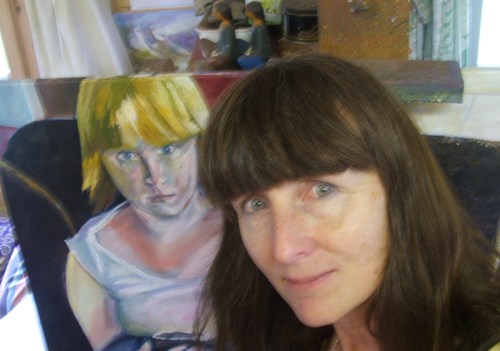 Having spent last winter cursing the clutter, it has surprised us just how much we miss it...  ...but not enough to spew it all over the sitting room floor again! 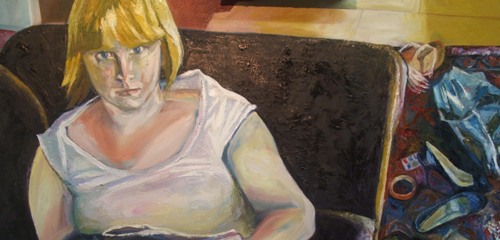 I'm dying to work more on the face but I'll wait now until Mary comes home which most likely won't be until Christmas time. |
Tue, 28 Sep 2010 There's a great series on radio 4 at the moment, each week they take a piece of music and find people to whom it has significant meaning to talk about it. Last week was Faure's Requiem and Sir David Willcocks talking about his time as a very young man seeing death at Normandy in 1944 (he won the Military Cross for his actions as a temporary captain 10/11th July 1944). Whenever he thinks of those who died he hears in his head Faure's Requiem in memory of them. Throughout the programme he questioned the morality of war both then and now. This week it was a Swedish hymn 'How Great Thou Art'...I have it now...on Spotify...I'm listening to all sorts of versions of it, favourite thus far? Tammy Wynette!! Johnny Cash a close second! Last blog about Coventry Cathedral (unless I get there soon to see it in real-life), as you walk up the nave, this is what you see; the baptistry window, the non-supporting wood-and-concrete vaulted ceiling and Graham Sutherland's tapestry which designed to be best seen from half way along the nave. 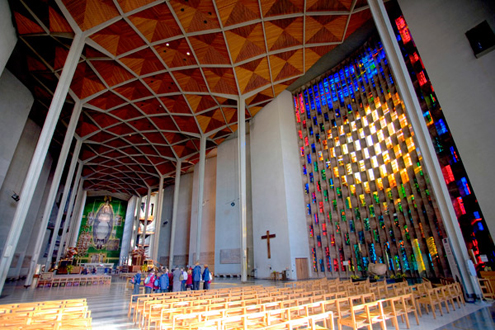 The side walls (beyond the baptistry windows) are zig-zagged and on the zig, plain wall, so that as you walk towards the tapestry THAT is what you concentrate on...but when you turn around...  THIS is what you see...on the zag, the walls are glazed, floor to ceiling, and filled with abstract colour and pattern, throwing light back towards the tapestry. |
Sun, 26 Sep 2010 Christ in Glory, tapestry designed by Graham Sutherland, 1962; in Coventry Cathedral, England. 23.94 × 12.05 metres. 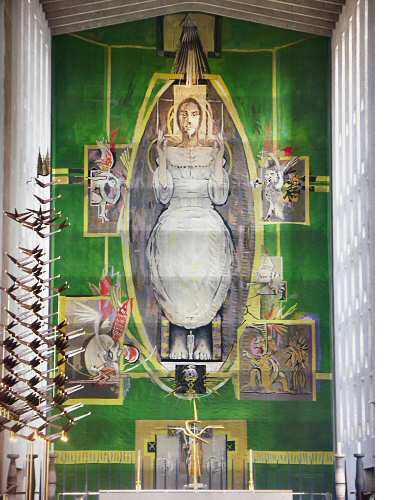 GRAHAM SUTHERLAND (1903-80): He was born in London, trained initially as a railway engineer; and then as an artist (in etching and engraving) at Goldsmith's College, (1921-6). From 1928-39 he taught at Chelsea School of Art. His experiences during the war as a war artist altered his style. He moved from romanticism (he had as a student been heavily influenced by Samuel Palmer) to a harsher approach reflecting the horrors of war. He undertook several religious paintings before he accepted the commission for the Coventry Tapestry. He had strong links with Pembrokeshire and with France where he bought a house in 1955.  Sutherland had to work within guidelines provided by Spence and by the Cathedral authorities. Both wanted a design which would speak to the ordinary person and not something highly abstract. He was asked to depict Christ in glory in the Tetramorph (four forms) with the marks of suffering (ie. the wounds from the nails hammered through Jesus' feet and hands) visible. The initial cathedral brief asked the artist to use four themes: 1. the Glory of the Father (light unapproachable); 2. Christ in the Glory of the Father, Christ to be shown either standing, sitting, blessing, helping, ruling, giving the sacrament or drawing humanity up to himself; 3. the Holy Spirit and the church (represented by some symbols and by the apostles); 4. the Heavenly Sphere (represented by angels or saints). Sutherland was told that depicting the face of Christ would be difficult: 'Victory, serenity and great compassion will be a great challenge to combine. Just as the Italians boldly conceived an Italian face for Christ and the Spanish a Spanish face, it may come to you to conceive an English face, universal at the same time'. 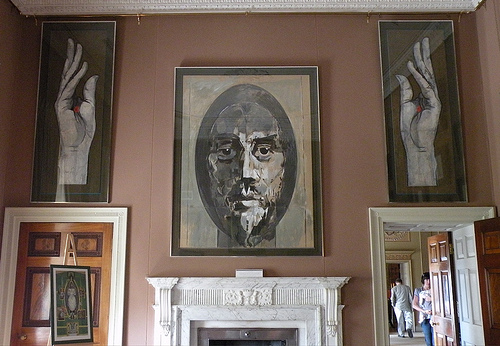 Cartoons, among the preparations for the final piece. |
Fri, 24 Sep 2010 I'm watching a programme about Coventry Cathedral and I'm astonished by the building and every element of it that we're being shown. The Baptistry window on the right of the nave with 100s of abstract segments which together create a rising sun came almost 50 years before Eliasson's 'The Weather Project' at the Tate Modern, and I think feels more profound, more complex and more subtle; the purpose of the Baptistry window to suggest the rising of the new Cathedral out of the destruction of the old? 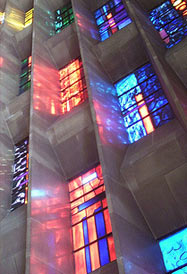 It was designed by John Piper, who said among other things "The trouble is to keep up a really interested feeling for your subject AND painting, letting one play itself off against another. Sometimes it seems to me that the ability to do this constitutes the whole of the art". 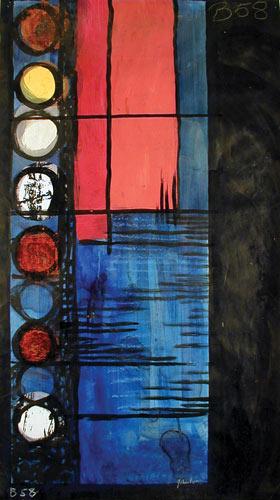 Cartoon by John Piper for one of the Baptistry window segments. Everything about Coventry Cathedral looks breathtaking. It's a place to which I'm going to have to make a pilgrimage, sooner rather than later. To me it's come like a blast out of nowhere -I knew of the existence of both the old and new Cathedrals but had no idea that the new one is quite as it is. 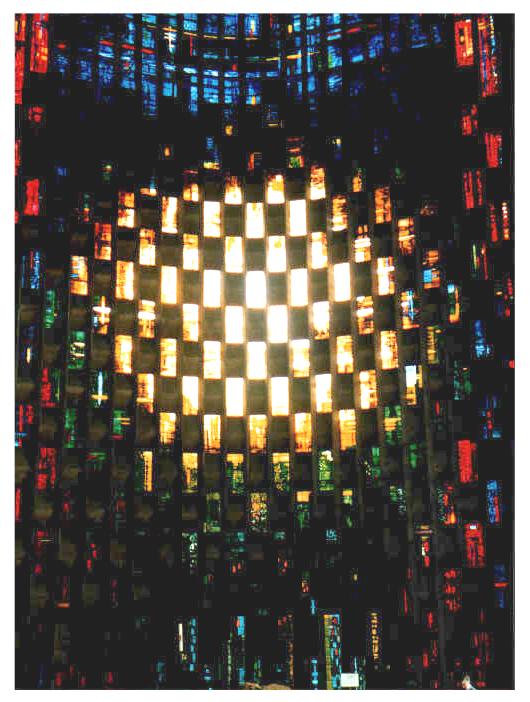 The full Baptistry window, Coventry Cathedral 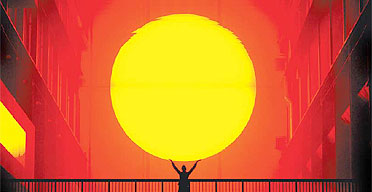 Olafur Eliasson's 'The Weather Project' at the Tate Modern in 2003 |
Tue, 21 Sep 2010 It's 7.30pm on a rapidly darkening early autumn evening, it's warm enough to leave the dining room door wide open, there's a full moon rising above the garden and a robin is singing loudly. I was trying to think of words that the singing evokes...and the word I came up with is 'English'. When we were away from UK for a year, a homesick moment occurred while watching 'Howards End' and seeing hedgerows, cowparsley and churchyards. They evoke the same feelings as the robin. The young pigeon seems to be okay even though I had thought her mother might have abandoned her three days ago. She's alive and whacking about with her wings in the nest. In my mind I've called her 'Chance' because I'm not sure how much she has of one. On 'Front Row' they're discussing ways that artists make a living. It's something artists are cagey about perhaps because they're not always sure. In the end the art work should be done without a potential buyer in mind, battling insecurities but retaining enough sensitivity to be careful, thoughtful and tenatious, no tricks, nothing slick, profound honesty. Sometimes the work is successful, sometimes not, but it usually takes six weeks from the time you finish before you know. This creates a problem; the work may be deemed successful by you but not by the viewer therefore not saleable. To want to be 'the best' must be to want to be 'the best' within an entirely self-created set of criteria. Depending on outsiders to define your 'best' will lead you to making work with which you are not happy and certainly won't guarantee a saleable product either...dissatisfaction all round. A line from Martin Gayford's new book about Lucien Freud... "What he always looks for in art is honesty, thus he prefers Gwen John to her brother Augustus", I wonder if Lucien Freud knew that Augustus John was supposed to have said "One day they'll talk about the artist and her brother" |
Sat, 18 Sep 2010  I'm told that the pigeon has made a nest because she's been confused by the day-length -its like spring. She may just have enough to time to fledge this baby but it's possible it might not be strong enough to survive winter. 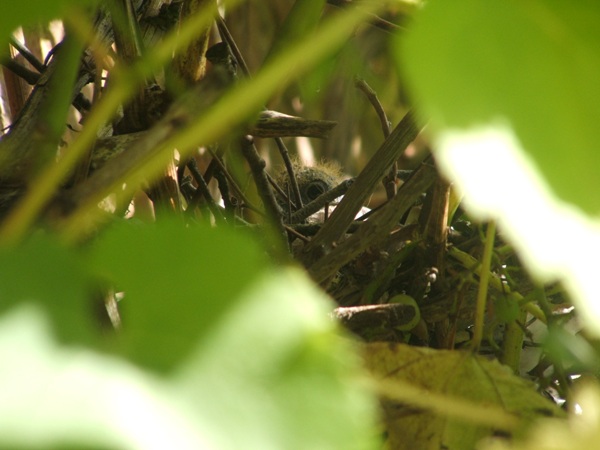 The baby sits as still as a statue if I'm anywhere near...here he is with his hair like an old man's! |
Thu, 16 Sep 2010 I've just been listening to a radio programme about a five year old's brain and best learning techniques...among the many things which were said was one point, that things which were harder to learn were best remembered. SO...all my good students...every time you feel we're dealing with a challenging lesson, I shall rejoice in the knowledge that it will be well learned! (Let me polish my halo). I'm frantically working on a painting of my daughter. For their 18th birthdays I've always done a celebratory painting of the kids. Mary was 18 last December but it seems to have taken me until now, until the week she's about to leave home, to get going on this painting! I'm working on a square canvas and seeing her as she's been these last couple of years...relaxing on a big brown sofa. She likes to have her stuff all around her, books, makeup, shoes, clothes, STUFF!! Watch this space. |
Wed, 15 Sep 2010 I had a tooth out yesterday; it had been badly crowned about 8-years ago...I knew it (and the dentist who did it) was/were bad at the time...and my now, wonderful, Polish dentist said it couldn't remain in place. Sure enough, once it was out and I could closely inspect it, I could see decay under the bad fitting. Reeeeaaaaallllyyyy GORY! Here it is (look away if you're squeamish)  It meant that the gap where my tooth once sat was rather aching when I went to talk to the camera club, however the work was stunning and my mind was swiftly taken from the gap in my skull to the images put in front of me for discussion. It's as I had thought; when it comes to photography, it's more about setting up and waiting for the perfect shot, whereas with a painting every square inch of the canvas needs planning and then paint applied to every bit, one way or another. I believe the painter has more control over the image, and that the photographer finds more surprises when he/she uploads the image to a screen (as happens now). I talked my head off, and really enjoyed it. ---I went to sleep remembering the quiet noise of my tooth coming out of my jaw---and imagining the skull from which it was pulled. |
Mon, 13 Sep 2010 A pigeon has been building her nest in the vine over the front doorstep (that same doorstep where I spent so much time with Colin). I was puzzled because I thought it was far too late to be laying eggs...but sure enough...this morning, I saw a little grey bundle stretching its fluffy wings. So, at least one little pigeon in the nest! |
Sun, 12 Sep 2010 So... on Tuesday I am going to talk to The Blandford Camera Club about their photographs. I thought I had better jot down some of the ways of thinking I use before beginning a painting, as I suspect (and they may prove me quite wrong) that some very practical soloutions have to be worked out before making a painting which are not quite the same solutions used for making a photograph. The following is what I came up with. In my mind, without ever finalising what they were, I had decided there are five fundamental 'rules' in art...I ended up here with six, but the sixth one is the magic one which almost can't, by its nature, be a 'rule'. ---Fundamental concepts to grapple with before beginning a painting... Edge; the boundary between two differing areas which come together and create the place where we might feel we want to draw a line. No such thing as a line exists in reality. If I look at a tea-pot and make a line drawing, I only have to move my head an inch and the line drawing is no longer relevant to the tea-pot. Neither do I see a line on the tea-pot that my original drawing was representing. Rather than draw a line, I might, using tone, create the tone of one area at the place where it meets the next i.e. the tea-pot against its background. Tone; This allows us to register the difference between the two areas which meet to create the edge. Sometimes the tones either side of an edge have vastly different tones and sometimes the tones are subtly close. Leonardo da Vinci was one of the first to suggest that in the dark we don’t see colour...therefore paint tones in the shadows and not colours. Composition; Composition is not just about the various elements of the subject and where they sit in relation to each other, it is also profoundly about where the subject-elements sit within the boundaries of the page. It’s lovely to sit in a landscape and see the vastness of it and want to capture that within the page. The trouble is that when we analyse the scale of the different distances in relation to each other, we discover that the wide and important looking middle distance is a long thin horizontal strip across the composition. One has to crop and manoeuvre the edges of the page to contain the subject. Under this heading we talk a lot about the Golden Section, often we simplify it to approximately ‘third’ divisions both vertically and horizontally when placing key elements in our compositions. Shape; I have a theory that we have a certain amount of imagery hard-wired into our brains from before we’re born. Like two of the same negative, held up to the light and then slid together until their images exactly line up, occasionally a landscape or a collection of objects line up with one of our own ‘inner blueprints’. This is why some things look fundamentally ‘right’, engaging and satisfying. Some people are compelled to paint it, some to photograph but many have a deep desire to respond in some way...hence, and luckily, I have 60 students a week doing just that!! Texture; each area within a painting is in some way representative of either parts of a specific subject or (in an abstract) the mood which the artist is trying to portray. Each area needs some practical thought as to how to cover it. As well as the colour and the tone, the artist has access to creating varying and various textures. I talk to my students about building up their ‘visual vocabulary’ and we frequently practice this simply by experimenting with all the different kinds of mark we can make in all the various media that we use. Enigma of the image; When my students first come to me they have seen a certain amount of art/painting, and frequently have an idea of what they think a painting is, why they think it has been done and, therefore, that with a few tips and techniques that I can give they’ll be painting a good painting. The magic ingredient is more elusive. It is that one response, unique to a particular individual, drawn out of them for the right reasons...those being not a ‘painting-by-numbers’ formula for making the type of paintings we see a million and one times over, but something deep, personal and individual which the artist/practitioner notices beyond the predictable and when presented in the painting resonates with something the viewer knows or has seen or recognises. I always ask my students not to aim to conform to the norm, but to look for the things that no-one else has noticed. Be un-embarrassed in the search for the oddness of things; slough off any desire to conform to someone else’s idea of a ‘good painting’. Forget your ultimate viewer until the painting is done. 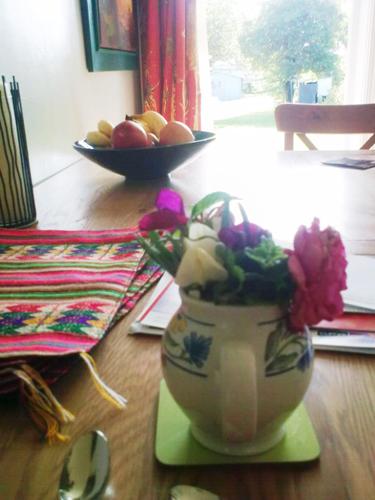 At the dining room table, having cleared it after a great meal last night with friends, I catch sight of the fruit bowl behind the little bunch of flowers our friends brought and think to myself how fabulous a still-life looks when set out ALONG the table instead of seen from the side of the table...the different scales describe the distance giving immediately understandable depth. |
Sat, 11 Sep 2010 All those people living on the dole and being told they can't choose it anymore as a 'lifestyle choice'...must be delighted if it means they now have a choice...they'll obviously choose a satisfying job and £100,000 a year...won't they?? |
Wed, 08 Sep 2010 I'm back at work for the winter term, and really enjoying it. Here is this week's lesson, I brought in some complex folding wooden garden chairs and put them on the table in front of my students - Winter Term 2010. Understanding what you see... Lesson 1. Building on your visual understanding. • Take five or ten minutes to draw a complex item from memory i.e. a bicycle or a dining chair. Are you mapping what you know with line? Or are you trying to represent what you ‘know’ you see from a certain angle? • Place a complex article on a table in front of you (a chair with many struts, legs etc., a bicycle, clothes drying rack etc.). Look at it exclusively and not at the drawing you’re about to make. This requires concentration not to look at your drawing as you make it. Cast your eye on the subject. As your eye travels across and around the subject let your pencil respond accordingly on your page. Spend at least 20 minutes doing this, more if you can bear it. I am not interested in the ‘so called’ quality of this drawing. I am giving you a chance to respond to your object but relinquish you from the worry of what your drawing looks like. • Now move yourself or the object so that you see it from a completely different angle. This time you can look at your drawing and make judgements about it as you draw...but...you are going to draw... not the object but the in-between spaces. Start with one in-between space and once you’ve drawn it see the next one in relation to this first shape you’ve drawn. Gradually the object emerges as the default image. Some of the in-between spaces will be ‘open’ (i.e. around the outside of your object where it ‘relates’ to the background area). • Finally, move again (either yourself or the object). This time start by looking for the greater shapes. Is there a whole shape you can find before searching out the details? Can you simplify some of the greater shapes into squares, triangles and rectangles before curving some of those lines? Do some of these greater shapes overlap before they finally slip into their places? Your eraser is a drawing implement too...negotiate with the pencil, paper and eraser to create a representation of your chosen object. Now compare all the drawings you’ve made today. --- The most interesting secret...to which I am already a party but takes my students till the end of the lesson to realise, is that it's drawing no.2 which is often the most interesting, particularly for the line quality and the enigmatic conviction of this collection of abstract marks. Drawing no.4 benefits hugely from having done drawing no.3 (the in-between spaces) and it's also while doing drawing no.4 that it becomes clear what was missing while doing drawing no.1 !!! When I was teaching for Adult Ed., the above was not considered a proper lesson plan. I suppose I never got to the bottom of what exactly they wanted of me because I was so clear about what I knew I wanted; but I think what they wanted was for me to structure the lesson much more closely, break it up into smaller time-blocks and to give a very much clearer idea of what the outcome should be ---stuff and nonsense!!! --- If I gave too clear an idea of what the outcome should be then everyone would have made the same picture and no-one would have learned anything for themselves...you can understand why I left them! |
Tue, 07 Sep 2010 Our previous GCD Tony thinks himself a foolish nincompoop for passing the Freedom of Information act but not one of the callers in to 'You and Yours' today agrees with him (other than with the foolish nincompoop bit perhaps). 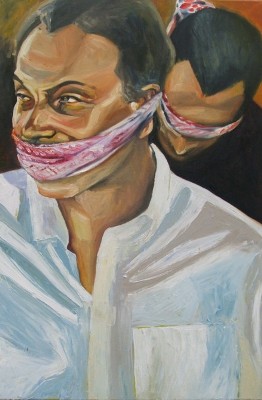 'Freedom of Information' This was my take on the matter a few years ago when GCD tried to rescind said law. Its a lovely day today of wild skies and pouring rain or massive sailor-blue patches and sparkling sunshine. And I have a day in my shed working on the 'Clare College Gardens' painting and 'Wicken Fen'. |
Mon, 06 Sep 2010 ...Just harking back to this painting after listening to The Today Programme this morning... 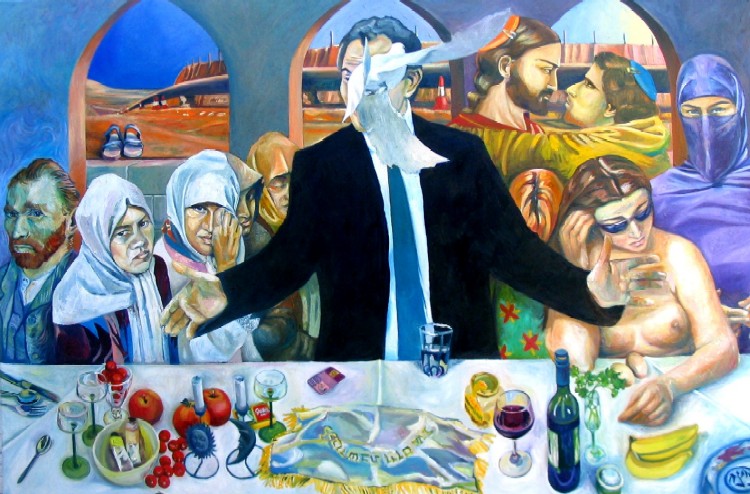 'The Baku-Tbilisi-Ceyhan Oil Pipeline' Fancy! Ken Clarke, Tory MP says we need to bring as many prisoners out of prison as possible and re-habilitate them, but our previous Great Christian Dictator Tony Blair thinks otherwise..'We must imprison those who do wrong'.....(hear my jaw drop). He suggested we look at third world countries where they exercise zero tolerance to wrongdoers...where they practice stoning? imprisonment without representation? torture? chopping off hands? If Tony Blair had been born in poverty to a disfunctional family he would undoubtedly be many times more likely to be a delinquent than a successful high earning family man. We can continue the cycle of dysfunction or we can attepmt to pull people out of the void of not knowing how to live a happy fruitful life...good on Ken, btw his radio programmes about Jazz are among the best broadcast on BBC Radio 4, and I don't particularly like Jazz either! And I would like to exercise zero tolerance on GCD Tony's decision to go to war in Iraq. |
Sat, 04 Sep 2010 Cycling with George; this is Colin's field, from where I gleaned for her wheat, now nicely havested and populated with enormous straw tower blocks. The style of straw baling has changed again recently; firstly several years ago from small rectangular to big round bales and now back again to rectangular bales but much bigger than the original. 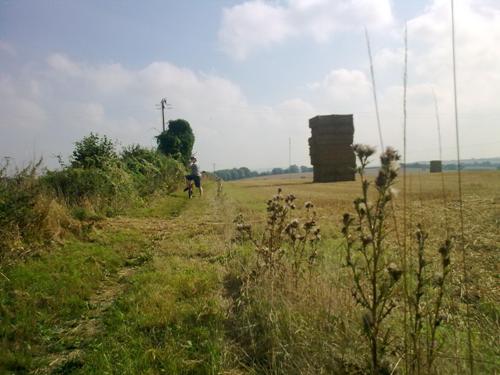 I love the rectangular bales when they're built into towers. 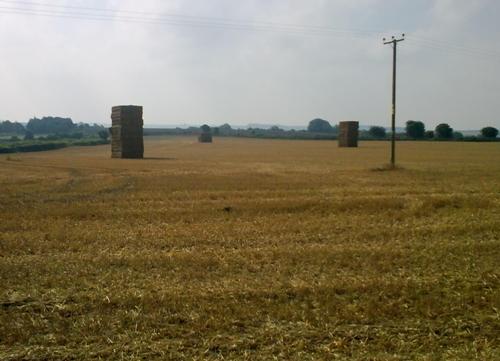 |
Fri, 03 Sep 2010 A little gripe: I hear complaints about bad grammar among young people and frequently the schools being blamed for it but I've just listened to an interview by The Today Programme of Ed Balls and his grammar is absolutely appalling. He constantly muddles his sentences with singular and plurals, never the two matching, and along with many other ministers uses the word 'less' instead of 'fewer' which drives me bonkers...so imprecise. The most annoying misdemeanor is not one of Ed Balls' alone, David Milliband does it too, and that is to use (what I call) The-Blair-Glottal-Stop. It seems to be their way of reaching the masses, of dumbing down for fear that we won't listen otherwise. I find I can't listen to them when the grammar is like a veil that obscures the message. Ed Balls is the Shadow Education Secretary and was educated at Oxford and Harvard...conclude...Is it the man who delivers the speech or the places which educated him that can be berated? (That bloody Harvard!)  Ed Balls |
Tue, 31 Aug 2010 There's a great section in 'Habit of Art' where the 'Words' of WH Auden discuss the nature of themselves with the 'Music' of Benjamin Britten. 'Words' says to 'Music' "Look, I have to come clean...We, the poems, the stuff he's written...we are sometimes hated" and 'Music' says "Hated? But he wrote you". 'Words' then says "We embarrass him, we embarrass him so much several of my colleagues never made it into the COLLECTED POEMS" ---It was another moment of recognition; its very important to question what you do, to be certain that when you put your work out into the viewers' realm its as good as you can get it, and even then it'll embarrass you in years (or even weeks) to come. Any tiny niggle that you let your work emerge with will grow one-hundred-fold when you see it in an exhibition...you may be the only one who notices...but don't risk it. |
Sun, 29 Aug 2010 Two great things have happened today, we went to see Alan Bennett's play 'The Habit of Art', and afterwards in the bookshop Simon bought a copy of a book I'd heard reviewed on the radio the other day, Seamus Heaney's 'Human Chain'. One of the reviewers of this book said 'a great thing about his writing is that he keeps his readers within the loop'. That struck a chord. So much art is exclusive, restricting and keeps people well out of the loop. It's hard to engage with, understand or be intersted in. It creates a feeling of inadequacy in the viewer who finds nothing to connect with. Perhaps it reveals a lack of honesty in the work, work which is made to confuse and overwhelm, but having come from outside rather than from the marrow of the artist's bones fails to resonate with the experience of the viewer. An artist should be working with the full force of his/her own focus and forget everything about the outside world other than the set of elements that have drawn them to the piece they currently work on. In 'The Habit of Art' Alan Bennett has WH Auden saying to Benjamin Britten 'Art isn't tennis Ben, you don't have to win'. It reminds me of the time, when I was a student, an elderly Sir William Coldstream leant over to a student-friend of mine, tapped him on the knee and said 'My boy, when I was your age I never had time to paint...now I never have time for anything else'. At the time I couldn't understand him but now I know exactly what he meant. Get the full force of your focus on your work while you can...really not much else matters... More later...currently enjoying playing 'Guess the intro..' on Springbok Radio Top 40 with Simon and my sister and brother in law in their kitchen...singing along to such classics as Pussycat's 'Mississippi..' and the Hollies 'The Air That I Breathe' Here I am swimming out to sea.  The thing about swimming in the sea is that you feel part of something vast and wild. I'm not a tiny element bobbing on the waves, I belong to the ocean of water backed up behind me to the other side of the atlantic. I can't bear to get out until my fingers and toes are completely numb with cold and even then I can't bear to get out; I leave it until the last moment so that it takes the rest of the day to get warm again. 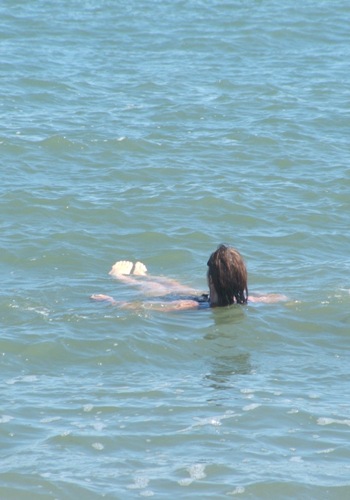 I sat drawing, wrapped in a very warm coat, trying to analyse the structures of a breaking wave.  Its easier with a camera; the movement is so fast and frenetic it feels extraordinarily hard to find in a drawing. I made one drawing which I might take further. One challenge is to decide on the light at the top of a breaking wave, is it lighter or darker than the ocean behind? Is it light 'caught' on the surface or light seen through the water at the top of the wave? Its moving so fast it seems impossible to discern, and its different with every wave. 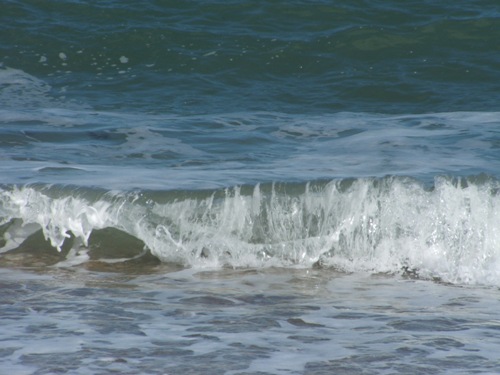 |
Sat, 28 Aug 2010 We've been in Devon for a few days, staying with friends. The soil in Devon is extraordinary, its red. Not pillar-box red of course! but in the way that red hair is called red but is something more subtle Devon soil is like a rich and warm boeuf bourguignon, a deep orange-red. 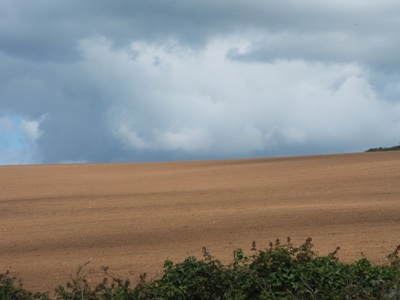 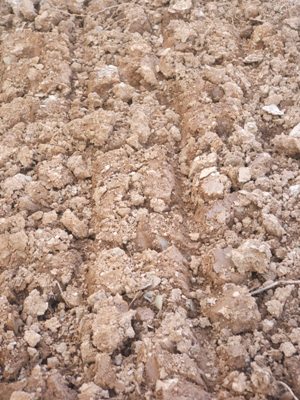 The colour reminds me very much of the Medieval red brick we've encountered while national trusting this summer. 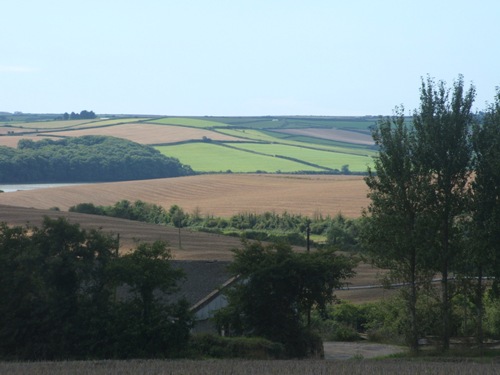 On our way down we diverted a little and went to visit Compton Castle (National Trusting again). Its a Medieval Castle which has belonged to the Gilbert family for 600 years, including Sir Humphrey Gilbert, half brother to Sir Walter Ralegh and adventurer for Elizabeth 1st. He travelled the atlantic and arrived in Newfoundland looking for places to colonise. He saw the benefit of the riches of the fishing grounds but his crew were less interested in cod and more interested in gold so disastrously he sailed south , lost the largest ship in his fleet the 'Delight' when it was run aground and wrecked; he had to head home with the tiny ship 'Squirrel' and the 'Golden Hind'. He was in 'Squirrel' when they approached the Azores in a storm and were swallowed up by the sea, all life lost, in late 1583. 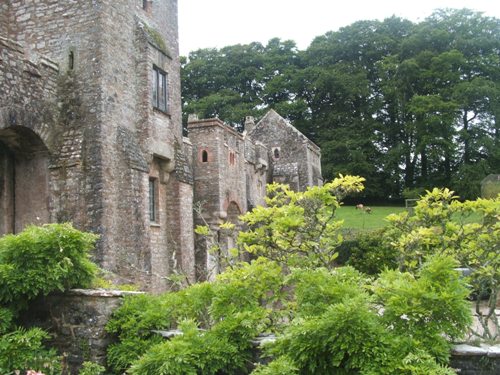 Compton Castle from the gardens. 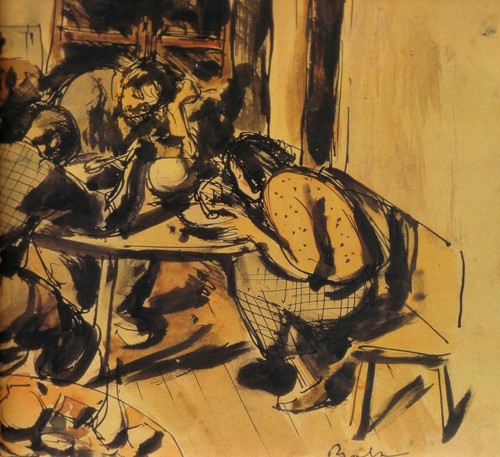 'The Tea Room' Corneliu Baba  'Sleeping Girl' Rembrandt |
Wed, 25 Aug 2010 My book on Corneliu Baba was passed on to me by a friend, Jane, of my friend Olga. Jane cleared Olga's shed after Olga's death and handed her things on to friends. I wish I knew how Olga came upon Corneliu Baba; she was someone who was frequently surprising in what she did, what she knew and what interested her and it could be her interest in an almost unknown-in-the-west artist was because her own heritage was Russian and Ukrainian. You'll find hardly anything about Baba online; he was well known in Romania as a painter and tutor but earlier in his life spent some time in both prison and removed from a teaching post. Two series of paintings, 'The Mad King' and group-paintings 'Fear' are where he said he found refuge from the control of the outside world. He was obsessed by Rembrandt which is clear from his watercolour and ink drawing 'The Tea-Room'. I'm having some trouble loading pictures so I'll try and do it separately as I want to compare a Baba drawing with a Rembrandt drawing. |
Mon, 23 Aug 2010 Its been a rare and wonderful weekend with most of my family here for three days. Jack was home with friends and as the house was full to the gunnells they were accommodated in my shed (luxury of course). Jack has been importing tailored suits from China, individually measured and fitted, so I was charged with photographing both him and his friend Alex in their suits for forthcoming brochure...what better place to do it in than my gallery? 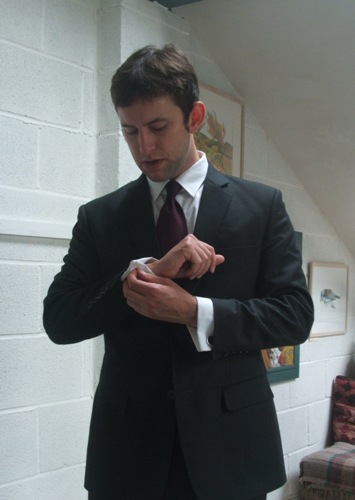 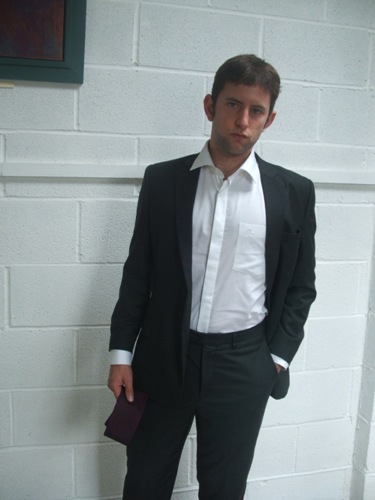 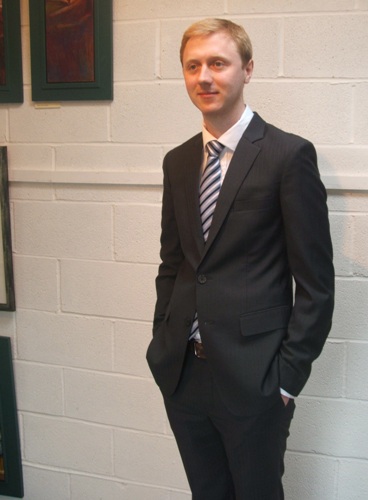 My brother and his wife were here for three days too; its exactly a year since they were here, we'd eaten supper and at 11pm he'd got the call from Oxford to go for his pancreas/kidney transplant. We were so nervous a year ago but at that time had no idea of quite how difficult it would all be. He's so much better now, its a pleasure to see...although he has to take huge amount of drugs but that should diminish with time. I went to collect my Dad from Oxford, so he was here, helping scrub potatoes and washing up all dishes which couldn't fit into the dishwasher. George and Mary are around too (Mary had her A-level results and got one of the new A* and her place at Uni.) and on Sunday Mum, Frank and my twin sister Kate came for lunch...silly me I didn't get the camera out and now I really wish I had! -perhaps I was rushing round feeding people... We also had our friends Dave and Bridget here for the three days, and next week we are going to down to them; they live outside Kingsbridge in Devon, beside a bird sanctuary estuary. Chris was here Sunday too, he confirmed what my friend and student John Sansom had identified the fish photo in Wicken Fen as -a young pike. The only people not to be here were my younger sister Jane and her family...on their summer hols in Greece. |
Fri, 20 Aug 2010 I heard on the radio that peace talks between Israelis and Palestinians are opening soon. I still feel (like Tony Judt) that the one-state solution is the fairest way to go. Imagine if we divided UK along religious lines to form our borders...we'd be a country of city-states. That might have advantages...it worked in the past and meant that wars were only city-state size. Also one might have a clearer idea of where one's vote went. Back to the one-state solution, one person/one vote, what should there be to fear? (That was not a rhetoric question.) Coversely, regarding retaining a Jewish state, read the following passages from wikipedia about populations in Israel and you'll see that the Jewsish population have everything to fear in demographics.---- "In the northern part of Israel the percentage of Jewish population is declining. The increasing population of Arabs within Israel, and the majority status they hold in two major geographic regions — the Galilee and the Triangle — has become a growing point of open political contention in recent years. Dr. Wahid Abd Al-Magid, the editor of Al-Ahram Weekly's "Arab Strategic Report" predicts that "The Arabs of 1948 (i.e. Arabs who stayed within the bounds of Israel and accepted citizenship) may become a majority in Israel in 2035, and they will certainly be the majority in 2048. "Among Arabs, Muslims have the highest birth rate, followed by Druze, and then Christians. The phrase demographic threat (or demographic bomb) is used within the Israeli political sphere to describe the growth of Israel's Arab citizenry as constituting a threat to its maintenance of its status as a Jewish state with a Jewish demographic majority. Israeli historian Benny Morris stated in 2004 that while he strongly opposes expulsion of Israeli Arabs, in case of an "apocalyptic" scenario where Israel comes under total attack with non-conventional weapons and comes under existential threat, an expulsion might be the only option. He compared the Israeli Arabs to a "time bomb" and "a potential fifth column" in both demographic and security terms and said they are liable to undermine the state in time of war. Several politicians have viewed the Arabs in Israel as a security and demographic threat. The term "demographic bomb" was famously used by Benjamin Netanyahu in 2003 when he noted that if the percentage of Arab citizens rises above its current level of about 20 percent, Israel will not be able to maintain a Jewish demographic majority. Netanyahu's comments were criticized as racist by Arab Knesset members and a range of civil rights and human rights organizations, such as the Association for Civil Rights in Israel. Even earlier allusions to the "demographic threat" can be found in an internal Israeli government document drafted in 1976 known as the Koenig Memorandum, which laid out a plan for reducing the number and influence of Arab citizens of Israel in the Galilee region." ----I'd concede that with a two-state solution the Israeli Government may find an easier way of 'expelling' Israeli arabs in the future to the 'other' state, but although these things might be easy to talk about they wouldn't be easy and they would be illegal to enact. Israelis at least have the feeling that their Government is in support of them and their interests. A while ago (obviously) an Israeli friend said... "..the Arabs hate Ariel Sharon but they are incredibly envious of him and the loyal support the Jewish people can expect from him; Arafat, on the other hand, is despised by many of his own people for not working in their favour." An example of this, if it can really be true, and as told to me by a Jordanian, is that a cement factory I saw in Jordan was part-owned by Arafat and was making the cement that was being used to build the wall between Israel and the West Bank. The simplicity and fairness of a one-state solution seems obvious...a no-brainer??? How wrong can it be? On another note, I take issue with all the Islamic states which ban conversion to another religion. I was being berated by a Jordanian friend about the fact that so many children in UK are not brought up by their fathers -divorce etc., (not that I'm an example of that!!!) but I said to him that I disapproved of the intransigence of Islam and that in our wonderful UK, religious freedom is protected by law...ahhh well...where one's feet are planted with regard one's beliefs and ideas depend so much on where one was born. I've always felt that if George Bush had been born and brought up in the Gaza Strip he'd have been a stone-throwing radical... |
Mon, 16 Aug 2010 So Blair is giving the profits from his book to The Royal British Legion and they say they'll build a rehabilitation hospital for soldiers. There's no-one else whose picture gives me such a physical feeling of repulsion, revulsion and fury. For the sake of my niece's husband and those like him who have lost legs and hands/arms, a rehabilitation hospital is certainly a positive thing. From the point of veiw of Blair and his debt to them does it cut the mustard? I don't think so. Does it take into account the burdens war placed on other countries than our own? Not at all. Jordan, population approx. 6,000,000, has officially absorbed 1,500,000 Iraqi refugees but on the ground Jordanians estimate closer to 3,000,000...a country with poverty like we don't see here, no welfare state etc., did Blair ask them what they felt war would do for them? Nope, I don't think so! I can't understand how the Afghan and Iraq wars haven't contributed to the financial position we find oursleves in at this time. Can we have spent as much as we've spent over the last ten years and it not have a financial impact on our current situation? Of course not. Most of all I cannot concieve of how Blair believed in what he was doing but even more I cannot understand how or why Blair cleaved to Bush quite so intensely, and did it against the common feeling among the UK population. How did it happen? My mother-in-law has recently moved out so we've cleared rooms in our house and are now filling them carefully. Today we found four chairs, three dining chairs and one huge basket arm-chair with cushion, at the local dump. We paid £10 for the four. I can't understand why its taking so long for people to respond to the floods in Pakistan. Are we suspicious of Pakistan and the part they play in the Afghan war? Or do we feel more skint than normal? The Tsunami and the earthquake killed many more people rapidly, but these floods will kill in large numbers in slow motion...all the crops in the vulnerable areas gone, no clean water, no dry wood to cook with or boil water. I've given the biggest one-off payment I've ever given to Oxfam for this flood...not all altruism...I hope when disaster hits here one day, Oxfam will be on hand to help us. There was a possible tsunami across the Somerset levels about 400 years ago. On 30 January 1607 the Bristol Channel floods resulted in the drowning of an estimated 2,000 or more people, with houses and villages swept away, an estimated 200 square miles (518 km2) of farmland inundated and livestock destroyed, wrecking the local economy along the coasts of the Bristol Channel, in what was then the Kingdom of England. It was completely unexpected and came in one enormous wave. The water receded before the wave rushed 'faster than a man can run'. At the time it was thought to be the judgement of an angry God. It was possibly caused by an underwater earthquake on a known unstable fault off the coast of Ireland. I never assume things like that won't happen here. When asked what we should look forward to in terms of weather with future global warming, James Lovelock said 'Many surprises'. My friend Chris calls me a pessimist...I say I'm a pessimistic realist or a realistic pessimist, either will do! I've been looking at this painter recently, Corneliu Baba, a Romanian painter 1906-1997. 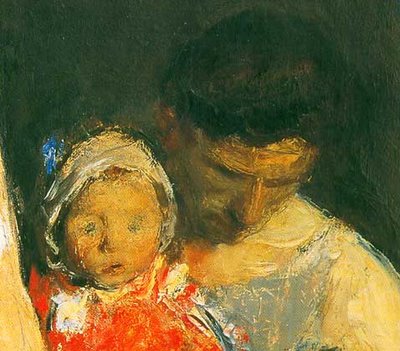 |
Wed, 11 Aug 2010 One painting I came upon unawares recently was while National Trusting in Cambridgshire on our latest trip there. We went to a place just north of Cambridge called Anglesey Abbey, first a hospital in 1135 and later an Augustinian Priory until Henry VIII dissolved them in 1536. The ruined remains were built into a house in early 17th century and the house was finally bought by Huttlestone Broughton (Lord Fairhaven) and his brother in 1926. Huttlestone Broughton collected many things which he set out in his house including French clocks and tapestries, English silver, marquetry furniture, German Renaissance sculpture and...some fantastic classic English paintings. The library is upstairs. Finding it is a little like walking through the wardrobe into Narnia...you walk along a corridor of bedrooms and unusually luxurious bathrooms. At the end of the corridor you pass though a door into the corner of a room and, expecting another bedroom, you gradually realise yourself to be in an unbelievably large library. This is where we came upon a painting called 'The Opening of Waterloo Bridge' by John Constable. This was a working painting for a final piece which is much more 'finished off' and belongs to the Tate Collection. I know which one I would take home and it's not the one that belongs to the Tate Collection. The brush marks on the Anglesey Abbey painting are so expressive. They give the feeling of having been made rapidly so that strokes of colour sweep up against other strokes, just budging and moving them slightly. Nothing is over-finished-off, nothing slick. The bridge itself is tiny; he seems much more interested in the interaction of water and boats/boatmen, sky and distance and, best of all, the quality of the brushmarks as opposed to the finest details. It kept me caught for a good long time and now I know here is a painting to which I would be happy to make a pilgrimage in the future. 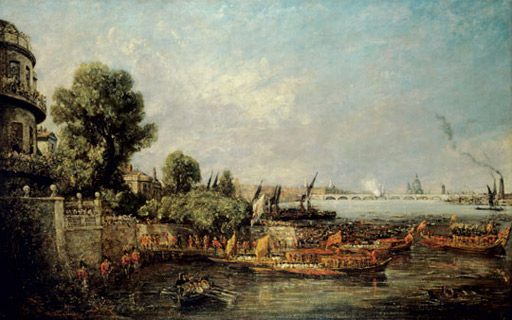 This photograph doesn't begin to do justice to the abstract nature of the brushmarks when seen close-up. The painting is very large, you can stand right in front of it and be completely absorbed. Constable is so surprising. I associate him with such chocolate-box paintings, but painting in the raw, he really was a genius. The impressionists must have looked at his work and trembled! |
Mon, 09 Aug 2010 Thomas Keneally (talking about Bruce Chatwin) says that all critics know that creative people 'steal fire' and critics use it as a weapon of criticism. Bruce Chatwin certainly seemed to be influenced by other people's ideas (i.e. Songs of Central Australia, T G H Strehlow) and work on them or from them. I avoid seeing too many exhibitions, I'm anxious about being too influenced by them, or feeling I should in some way be working like those particular artists. I love to come upon amazing paintings unawares, but rarely make a pilgrimage to them. I can't deny that I'm influenced, but I don't want the pressure of feeling I'm doing the wrong stuff because I'm not doing what other painters are doing. If I am doing what other painters are doing then equally I don't want to know about it! 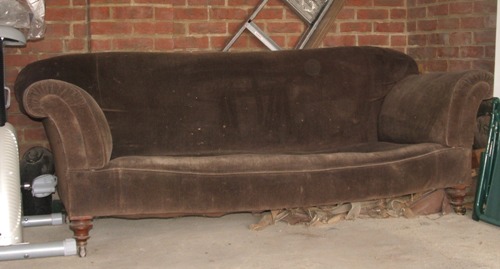 I'm working on larger versions of the chalkland meadow, trying to use marks which individiually mean nothing more than tone, texture and shape but as a collection begin to describe distance, depth, and the kinds of 'light' quality of the field. We have an old Victorian sofa, wonderful thing, which has been in the family since I was young and in dire need of repair (and a little rebuilding!)...the man from Summerlock Upholstery came today to assess it...as salvageable...do we go to DFS for the cheaper version which we can pay for on the never never? Or do we reinstate this lovely old thing from our garage (current place of abode) to our reclaimed dining room via the upholsterers where although I can pay for the fabric up front for a bit of a discount, we'd have to keep our fingers crossed for the moment of collection?!? When we got married 26 years ago, one odd piece of advice the vicar gave us was 'If you can afford it, its probably not worth it...' |
Fri, 06 Aug 2010 We travelled home via Oxford to where my Dad has recently moved, to a flat in Jericho just down the road from my sister Jane. Fab flat! All light and airy. In the thick of trendy Jericho's shops and cafes. On the last evening we walked into Ely and ate at Pizza Express...mmmmm...pasta. I admired these Medieval chimneys through the restaurant window. 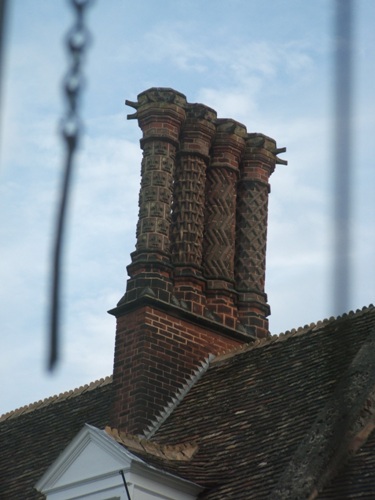 ...and on the way back I took a picture of these almshouses. Almshouses across the UK have a similar feel and are testament to a very early kind of welfare system. The first recorded Almshouse was founded by King Athelstan in York in the 10th century AD. The oldest charity still in existence is thought to be the Hospital of St. Oswald in Worcester, founded circa 990. 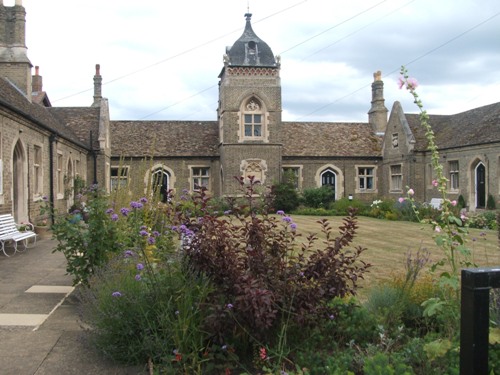 Jack is in the process of writing up his thesis. He's been working at the Cavendish Laboratory on superconductors, specifically a compound of strontium, iron, arsenic and a little cobalt. He's been making crystals of these compounds in varying mixes and testing the temperature at which they superconduct, higher temperatures being the holy grail as at the moment superconducting happens at very low temperatures but superconducting (resistance-free electricity through the wires) at normal temps would probably slash our electricity bills!!! 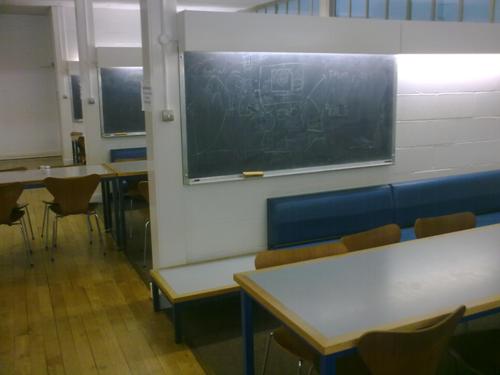 The Cavendish canteen isn't quite like other canteens; you can get a good mug of tea and all the normal canteen foods and snacks, but there are also these blackboards where you can work around your formulae and ideas. Apparently plenty of brainstorming and discussion goes on at these tables and blackboards in The Cavendish Lab canteen! Simon and I both love National Trusting (yes...its a verb!). Simon decided we'd visit Oxburgh Hall, a 15th century moated manor house, built in 1482 by Sir Edmund Bedingfeld and has been inhabited by Bedingfelds ever since although it belongs to the National Trust now and parts of it are open to the public. Its well known for its priest-hole, the tiny space behind what was the latrine to the main bedroom. During times when it was a problem to be Catholic (dissolution etc.) many Catholic families kept a priest who would have to hide in well concealed priest-holes. We clambered in oursleves, it must have been incredibly claustrophobic, especially in the dark. It was under a corner of where several rooms met so the various meetings of different directions of brickwork were fantastic to look at. We also climbed up to the roof and had a close look at the ornate chimneys and the Medieval brickwork. They used longer flatter bricks than we use now and placed them one row longways (stretchers) and one row across to tie them to an inner layer of brick (headers), so tying the thickness of the wall. It gives the appearance of small and larger bricks. 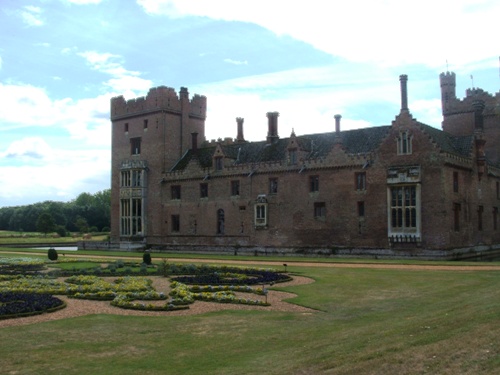 I'd hoped to get behind the lovely large window but that particular part of the house is still inhabited by Bedingfelds. 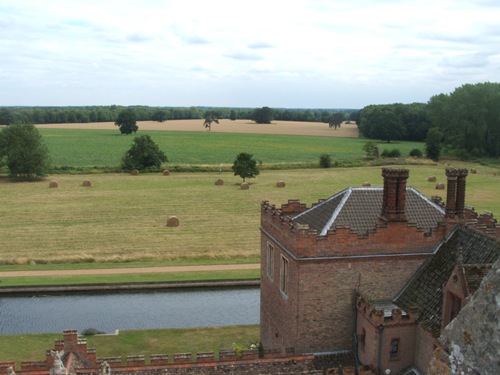 The house had some interesting paintings including a small and sensitive portrait of Robert Deveraux, 2nd Earl of Essex. He was very well connected, ambitious, a favourite of Elizabeth 1st -his downfall? executed for treason aged 35, after a failed coup against the government. This is the most famous painting (miniature) of the Earl of Essex, by Nicholas Hilliard (not the painting at Oxburgh) 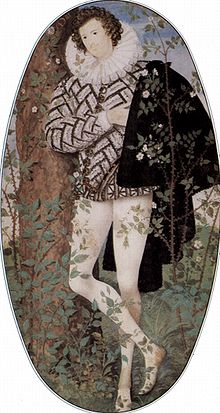 and here is an example of Medieval brickwork up on one of Oxburgh Hall's turrets. 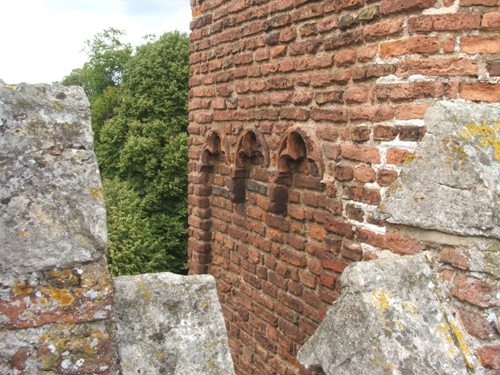 |
Thu, 05 Aug 2010 I have more to catch up but will do it tomorrow...meanwhile... We were actually staying near Ely, that part of the world is so flat and intriguing, we wanted to see a bit more. Its largely fenland in that area (on-line dictionary definition)'fenland - low-lying wet land with grassy vegetation; usually is a transition zone between land and water; "thousands of acres of marshland"; "the fens of eastern England"' We wanted to see a well known fen called Wicken Fen which is also a national nature reserve. It means that whereas much of the fenland has been drained for farming, Wicken Fen has been protected in its natural state since 1899 and therefore supports all sorts of indigenous wildlife. Again, I had quiet time to paint. I sat up in an old tower bird hide and looked across the fens and a large lake. And again I made a drawing which I think is something I can work from back in my shed. 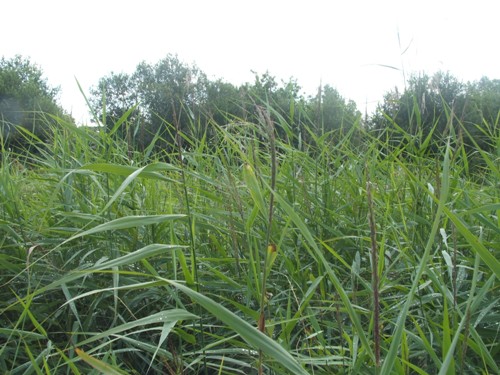 The earth is dark and peaty, the water brackish and the grasses very distinctive. I walked towards a large backside in the air which turned out to be a woman crouching to film a 'Holly Blue' (butterfly) http://www.ukbutterflies.co.uk/species.php?species=argiolus Looking at this link, I'm sure what we saw was a female 'Holly Blue'. 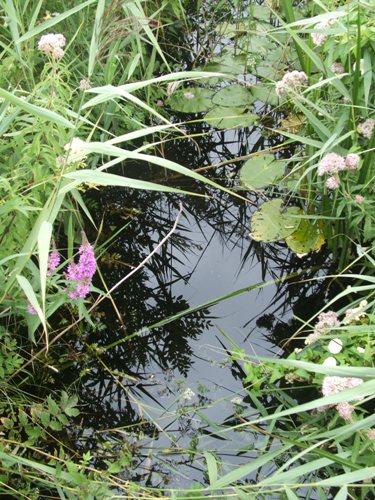 I also found this Peacock butterfly  and this fish, but I can't identify it, I'll have to wait until I've shown it to my friend Chris who knows about those sorts of things!  One of the loveliest college gardens is Clare College garden. I was left there in a quiet corner where I could relax and paint. I've been using a mix of coloured pencils, watercolours, watecolour pencils etc (very portable) and looking for shape, texture, weight of tone and of course...reasons to make marks...I devise ways of making visual notes, a visual vocab for note-taking. 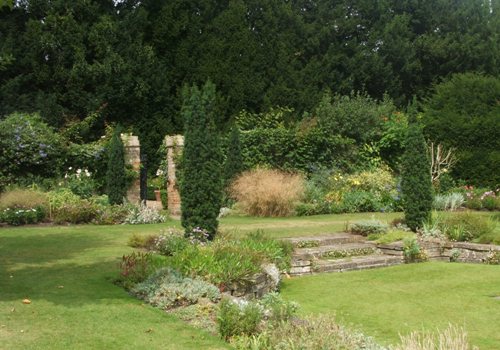 I'm quite excited by one drawing I made and will be taking it further in my shed. 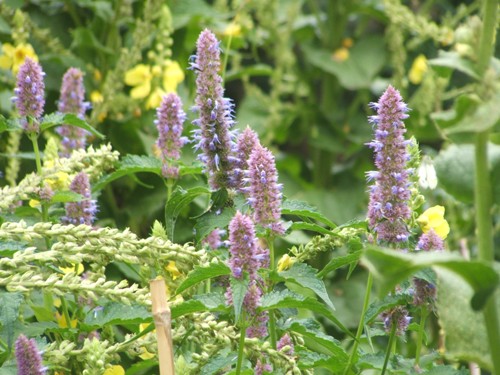 A lot of the garden borders are a mix of yellow and purple-blue flowers, and as these are complimentary colours the whole thing looks stunning. I just can't seem to make our garden like that!! We tried to make the most of our time in the Cambridge colleges because Jack is about to finish his PhD and we may not have the chance again. He's been part of Trinity College for nearly eight years and although eating in the Great Hall is a common occurance for him, for us its like having the best of old fashioned school dinners. We ate in the Great Hall two nights running and even popped in for a lunch time slice of baked cheesecake as well. Jack can take us in to any of the colleges with his student card so we re-visited Kings College Chapel which is a chapel of fragile fan vaulting and vast stained glass windows, they stretch up for miles and exist in two layers, the top windows telling old testamant stories and the windows below which tell new testament stories, the 'realisation' of the old testament stories above. My favourite window shows the Ascension of Jesus, you can see his little feet disappearing in the top left hand corner as he departs up to Heaven. 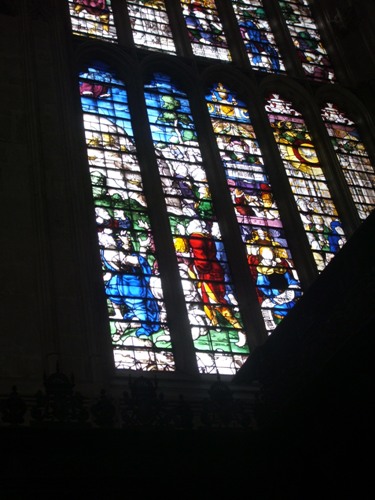 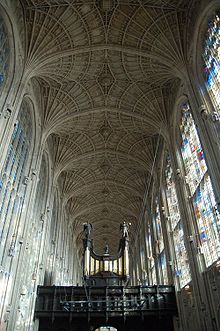 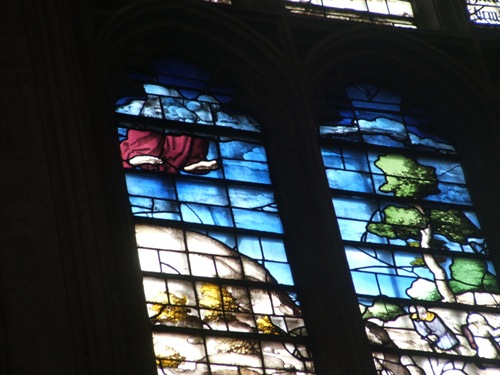 I based a painting on that window -Tony Blair ascending to Heaven as his spin doctors protect him from the clamour of the commoners below- 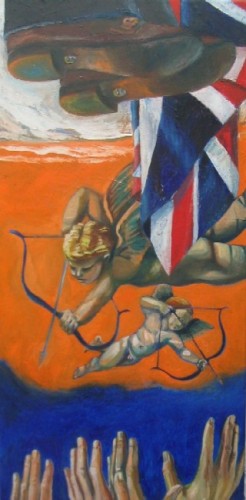 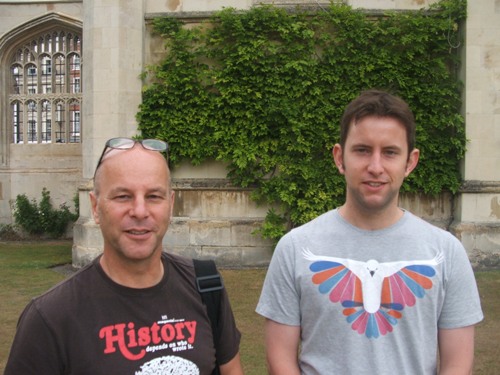  Been to Cambridge to see Jack and Oxford to see my Dad and sister...will catch up, had a lovely time and needed more days. |
Sat, 31 Jul 2010 More happy cycling. Harvesting continuing apace...  creating all sorts of patterns and stripes across the fields. We are off to Cambridge for a few days to punt, paint, relax and see Jack; hope also to visit Kettle's Yard and some National Trust properties. Kettle's Yard has in its collection some paintings by one of my favourites, William Congdon. 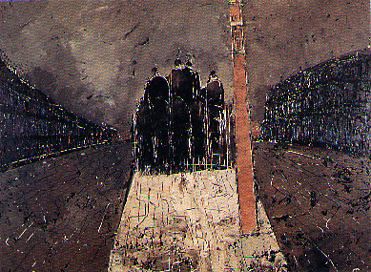 It also has a gallery with a non-permanent exhibition. http://www.kettlesyard.co.uk/ |
Fri, 30 Jul 2010 George and I have been cycling again, off road along a bridleway which in places was so overgrown we had to walk...or rather struggle through. Its an amazing place for wildlife because it seems nothing disturbs anything there...it didn't look like it had been used as a bridleway recently -maybe in winter when eveything's died back a bit. The wildflowers were lovely, scabious, harebells, various thistles and lots that I don't know the names of.  We could see a long view across North Dorset, golden wheat fields either being harvested or waiting just a bit longer, and Win Green in the far distance which I've told people for years is the highest place in Dorset...that would be fine but for the fact that it's in Wiltshire! Ahh well!... we also passed this grass meadow, I'm afraid my phone-camera doesn't do justice to the grass-seed-heads which appeared to hover across the field in a golden halo. 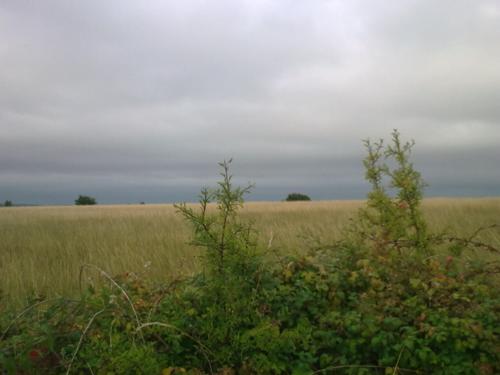 |
Thu, 29 Jul 2010 Here's number 9 of the series 'Chalkland Wildflower Meadow' 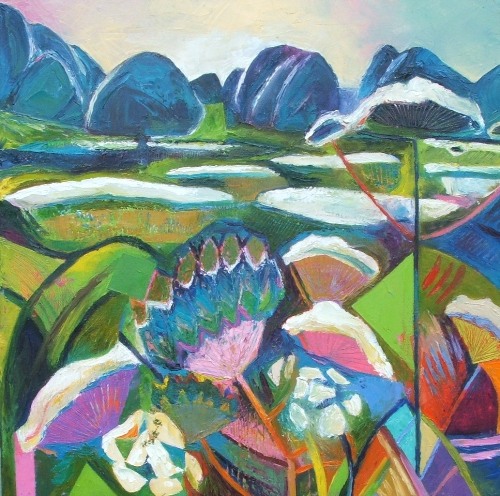 I feel completely gripped by this meadow beside which I've lived for 22 years. This one is called 'Sun Beginning to Set Across the Chalkland Wildflower Meadow' and sums up the look as far as I see it of just what it says. I'm still attempting to make each individual mark more abstract, and as this is number two of this particular composition, and I'm planning a bigger version still, number three, I suspect that some changes/progressions/experiments are afoot...All of the meadow paintings are on a square format, but I'm keeping most of it under wraps until November/December when they'll go on exhibition at Acanthus Gallery in Wareham. Still no Colin. 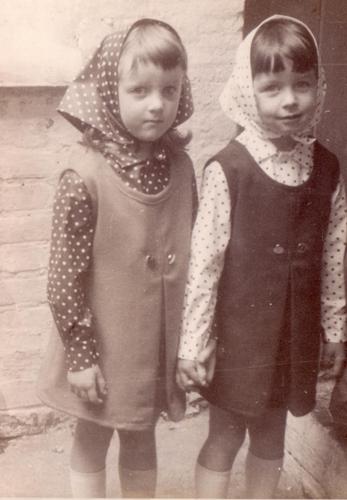 My twin, Kate, and me...of maypole dancing age? |
Wed, 28 Jul 2010 Still nothing on Colin to report; I hope my instinct, that she's away with the gang, is right. It seems that the third brood this summer, now flying, have ousted the now teenage brood who are off in the fields gleaning. I really miss seeing her but of course have to keep a perspective on things. The longer I don't see her (five days now) the more marvellous it would be to have her fly down to the doorstep again. A little field vole has discovered seed left on the step for Colin and keeps zipping back for it. I've been on the bathroom roof at the back of the house looking over the cut meadow; its a collection of tracks, grass-cutting tracks, tractor tracks and my imaginary threads which the swallows weave as they criss-cross the meadow catching bugs. It reminds me of the way that patterns are woven around the maypole by the children weaving in and out...I have a bugbear about maypoles -Miss Hake, dreaded headteacher of our primary school- ALWAYS chose my twin sister to dance around the maypole but never me...yes I resent it to this day, I don't of course resent my sister but I do DESPISE Miss Hake for it...still. Be fair to young children; I so much wanted to do it, I must have had the face that she disliked!! Link to film from bathroom roof http://vimeo.com/13716403 |
Mon, 26 Jul 2010 I've been enjoying skies full of marks. 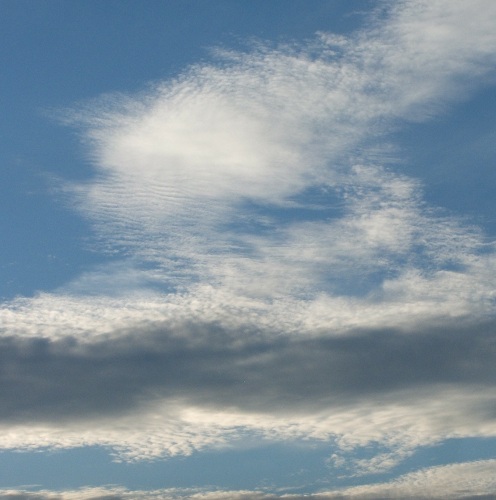 Layer on layer, enigmatic, like a good painting. 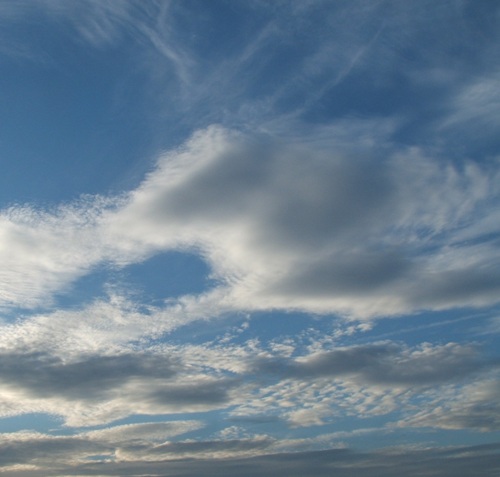 The wildflower meadow has been cut and baled. The swallows are still skimming it for bugs. If they dragged a silk behind them like a spider, they'd have woven a thing as thick as a rug by now. 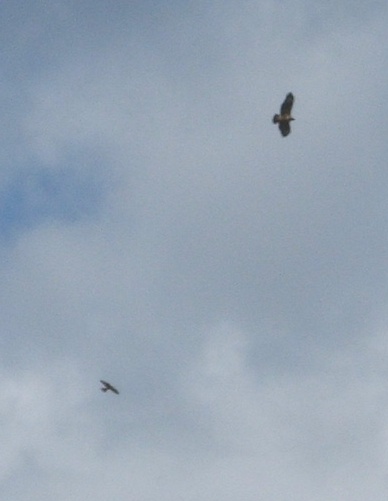 I watched a buzzard and a kestrel hunting on the same thermal the other day, round and round. I couldn't tell if they were paying attention to each other or not. The bird I haven't seen in the last three days is Colin. There are sparrows around but it seems not Colin. None of the seed which is out is being taken by them at the moment so I'm hoping the gang of young sparrows is off among the wheat fields. 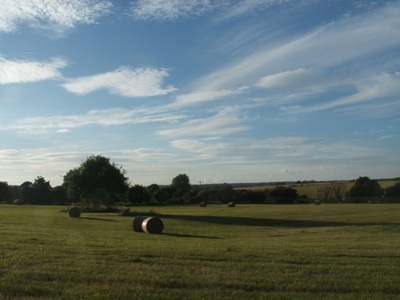 The cut meadow. |
Fri, 23 Jul 2010 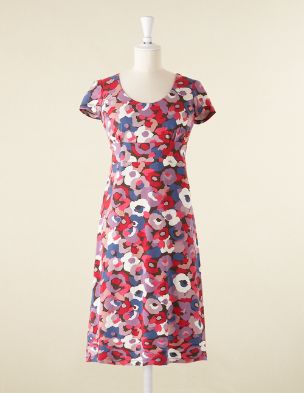 Colin's favourite dress Sitting rather folornly on the doorstep this morning as its two days since I've really seen Colin when she breezes in with a gang of youngsters and comes straight to the step for a mealworm! I was wearing the dress she recognises best so maybe that has something to do with it...she loves her mother in pink! |
Thu, 22 Jul 2010 Hmmmmmmmm....no sigh of Colin at all today, in fact very quiet on the sparrow front. Even my bird feeder, which is sometimes emptied within a couple of hours by sparrows, is still half full from yesterday. I guess they're all off with the combining. .. http://vimeo.com/13525815 .. Martha Waintwright at Larmer Tree Festival last Sunday .. 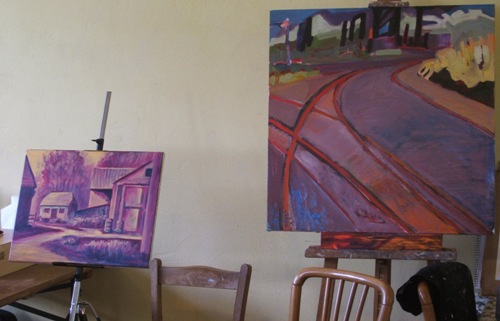 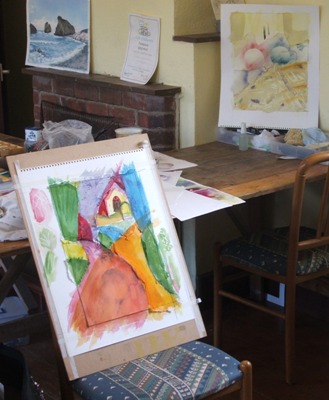 A fleeting visit from Colin last night and nothing thismorning; the farmers were combining yesterday, I reckon the sparrows were gleaning the leftovers. Here's a bit of whats going on at Chettle Village Hall this week. 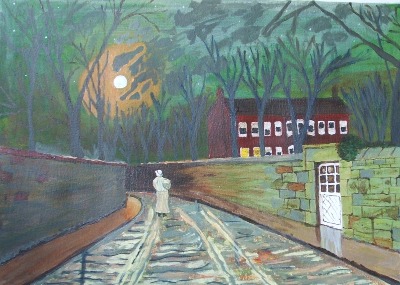 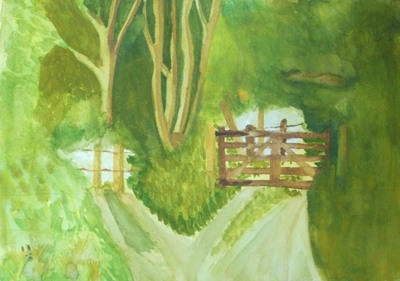 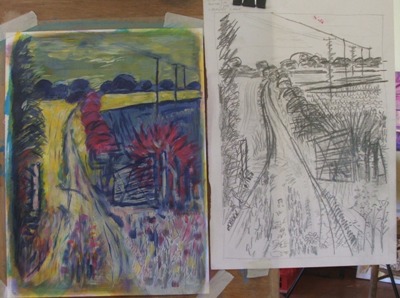 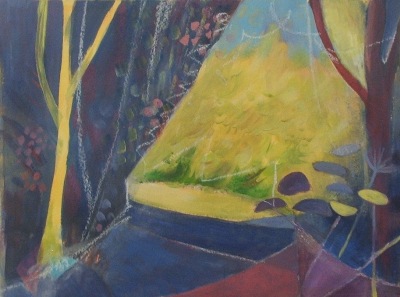 |
Tue, 20 Jul 2010 This morning I had a spare half hour to blog or to sit on the doorstep with Colin...Yesterday I hadn't seen her all day (for the first time since we found her) so Colin won. She's cracking tougher seeds but still has those yellow marks at the side of her beak, relic from the time her beak opened much wider and was bright yellow around the edges. I don't know if those yellow bits will fade entirely in the end, but she still seems not quite fully grown. She perched on my sandals, my knee and my hand and chomped mealworms and sat right in the middle of her seed bowl again and flung the seeds far and wide looking for her favorites (golden linseed I think; hard to tell...everything flies in all directions). Last night with my Monday class and two people from my Chettle course we went to the Blandford Museum to draw. Its a museum full of local history from neolithic (think Knowlton!) through Iron Age, Romans, Saxons, Medieval, civil war, local gentry, the great fire of Blandford 1731 (town re-built by the Bastard brothers), war time, farming implements and a model railway of the track and Blandford Station blown up by Beeching (quoted by wikipedia as 'lifted') in 1969. Everyone drew, including me. I found a small human skull and a collection of bones and bowls, but everyone drew a variety of things from the eclectic collection. Tonight I've been in my shed working on more 'marks'. 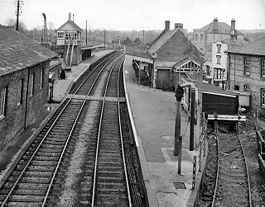 Blandford Station April 1963 |
Sun, 18 Jul 2010 These are the the two definitions of 'exotic' which pertain to my summer school (and my classes in general); 'Strikingly unusual or strange in effect or appearance' (this is how I'd like my students to think about their finished work) and 'Of a uniquely new or experimental nature' ( this is the attitude I'd like my students to have during the making of their work) 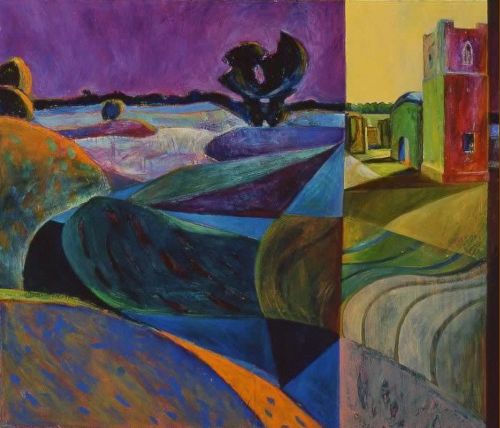 Knowlton Church and Henge; painted possibly eight years ago? Now in Tokyo. |
Sat, 17 Jul 2010 George and I cycled to Knowlton today, a 14th century ruined church (with earlier Saxon remains in evidence) built in a Bronze-age pagan earth circle (early 'Christianisation' of local religions). 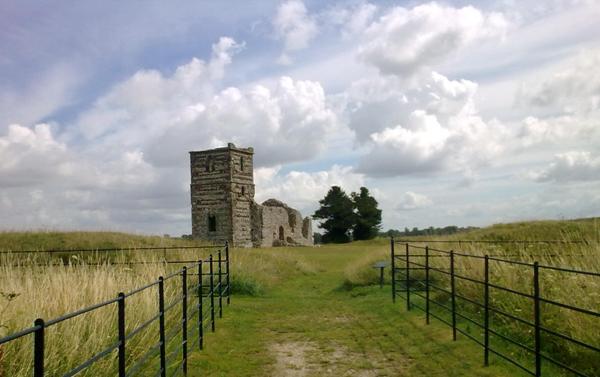 I thought I had mentioned it in an earlier blog but couldn't find it... Colin and I spent time on the doorstep, although she was reluctant to come to me initially because I was wearing a different dress...black instead of pink. The other day she had been wary of me because my hair was up. Her mother wears pink and has her hair down! I put my pink cardigan on and things were fine again. She pecked my toenails until I fed her. 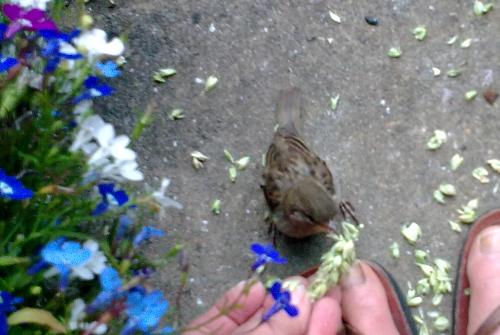 I put a bowl of mixed seeds down and she got right into it experimenting with all the varieties. Some were too much for her beak to crack, others she loved, like the linseed. She flung quite a lot out of the bowl if she disapproved.  Once again I've been working on my 'marks'. 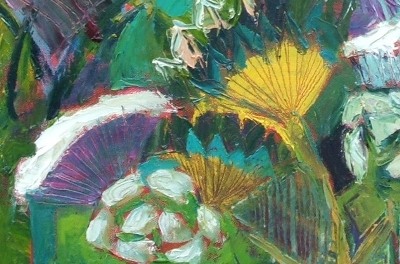 This is a section of another painting -as yet too figurative for the marks not to immediately mean something- but I'm working on another version from the same drawing...and as a whole the painting might be more enigmatic...but thats for a later date! Tomorrow I set up the hall for the first day of my 2010 summer course on Monday...an exotic and busy week. Its hard work but I really look forward to it every year...thank goodness its only a week! |
Wed, 14 Jul 2010 Colin still visits the doorstep for wheat and mealworms. I know she's feeding herself because often she'll arrive with a beak covered in what looks like the white stuff from the wheat-heart. We have wheat fields within her distance, I'm sure thats where she goes. It was wet and windy this morning, she came for as much as she could eat because she was wet already and I assume she doesn't want to be out getting wetter as she can't change her clothes like we do! This was Colin yesterday on my knee. She'll still jump and sit on my necklace so she can peck my chin. 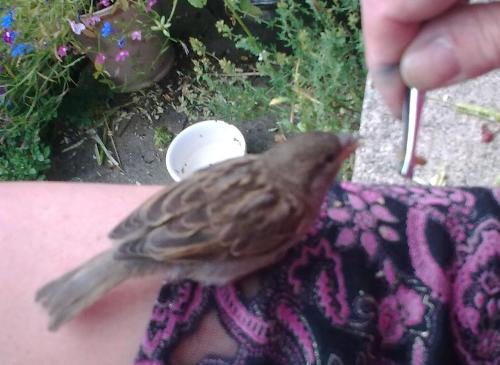 I'm still working on my 'marks'. Here are two rather poor photos taken with my phone (and reflecting the flash). These are from two of the square field paintings; At the moment the paintings are not big, the next ones will be big. Its affecting the way I shall be painting and handling paint for the next while. 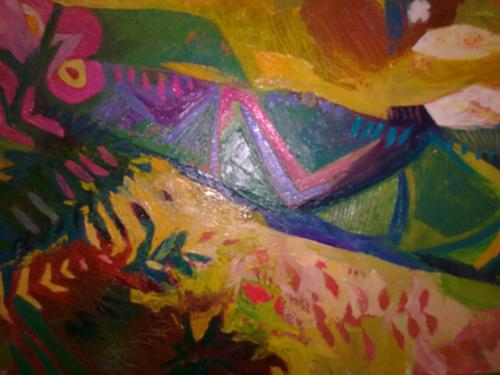 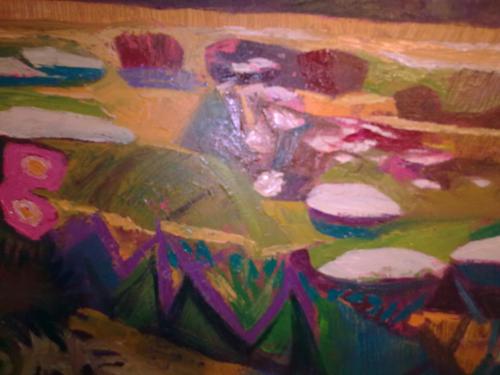 Its still a case of being completely enraptured by this chalkland wildflower meadow behind our house. Oh dear!! Just realised my bad maths...should be 0.1% of the population might respond to a spam email...not 1%... |
Tue, 13 Jul 2010 The 'comments' facility was becoming clogged up with spam..for insurance comapnies and 'cialis' sales...what the hell is cialis??? And who on earth buys it because they've been spammed with all these junk emails??? I'm completely fed up with people trying to sell stuff that 99.9% of spammed recipients don't want (including me). Do 1% of the population really make it worthwhile spamming the other 99.9%? I suppose I don't need to ask the quesion. I've just been reading about Gillian Ayres - "Gillian Ayres is a contemporary painter, mural artist and teacher. Her exuberant work is in the vein of American abstract expressionism and European tachism, which is characterised by the spontaneous brushwork and drips and blobs of paint direct from the tube." I really love a lot of what Gillian Ayres paints, I love the shapes, colours, marks and the way the paintings suggest elements such as plants or people. I can't bear to read about an artist who is described as using 'drips and blobs' or is placed under a tag such as 'European tachism'...what is that? Wikipedia tells me that it is 'considered to be the European equivalent to abstract expressionism' but actually it tells us nothing about Gillian Ayres' paintings other than someone, probably not Gillian Ayres, has placed her in a box to which she most likely would not confine herself. 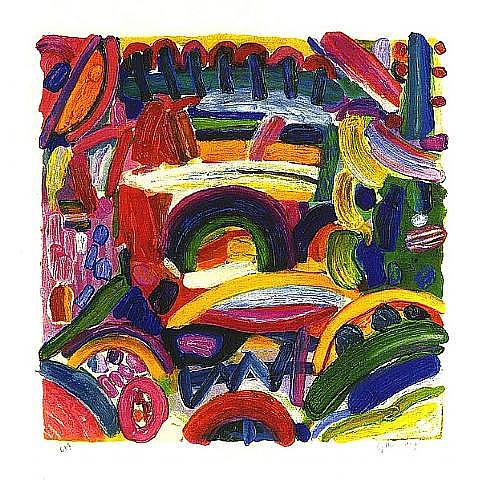 |
Sun, 11 Jul 2010 It was a really genial family gathering yesterday at the big oak dining table in my gallery. The hedge-row vase was moved to the fire hearth beause it so completely blocked the view across the table in all directions and not least because it also was covering the tray which Simon requisitioned from the Table Mountain Cafe when we were in South Africa. Colin, in her newer persona of being nervous of everyone except me, disappeared as soon as everyone arrived and couldn't be more than coaxed to peep out of the hedge and cheep quietly. Within about 30 seconds of them driving away down the track Colin was on the doorstep! I suppose its naive of me to think its amazing that she is so sensitive about other people. I am clear that the best thing is for her to be nervous, and when she was with me on the doorstep she was cowering at a noisy bi-plane going over. I'm not sure if it was the shadow or the noise (or both of course) which spooked her. She seems to be spending time away for longer, and eating less with me so I'm assuming she's learning to forage with the other sparrows. She's still wont to sit on my necklace and peck my chin so I think she sees me as one enormous mother but she can't quite work out where my beak is because she pecks my toe-nails too! |
Sat, 10 Jul 2010 Forgot to mention, Colin and I spent some happy moments on the doorstep, I endured her attacking my toes when I didn't hurry up with the wheat seeds. I'm trying to teach her to twist the seed off the main stem, she's getting better and better, also her beak is becoming stronger and she is more dextrous at manipulating the seed in her beak to squeeze the seed out of the chaff. She turns the covered seed around and around in her beak and gradually it breaks the outerlayers off and she can squeeze the white heart of the seed into her beak. She goes mad for wheat, really loves it! I've been writing tonight but its so stilted. I can write here easily and I can pour forth on any subject by voice...various people threaten to get me a soap box, but writing for other reasons...tough, I'll have to keep practising. We've put our new reclaimed-oak dining table up in my gallery for a big family lunch party tomorrow. I had been watching the Hampton Court flower show on telly this evening and was suddenly inspired to make a vase of hedgerow weeds and flowers for the middle of the table. I went out and picked large poppy seed-heads, aquilegia seed-heads, various cow-parsley-like umbellifers, dock seed-heads, tall grasses and some creamy-pink dog roses and put them all in the glass vase that came from Grace. 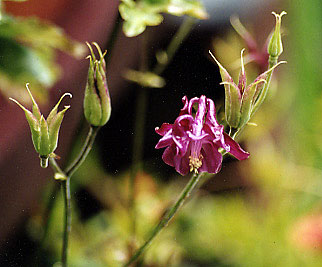 Of course they look fab! So I'm hoping that Simon's friend, who is sleeping tonight on the sofa-bed in my gallery doesn't suffer from hay-fever! 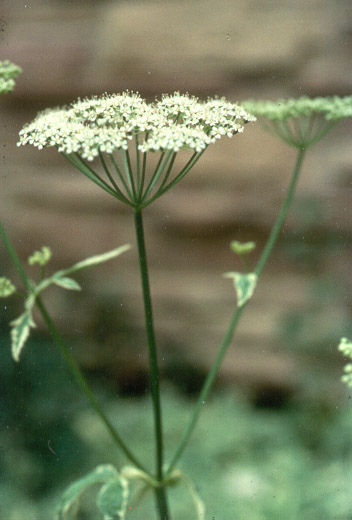 Umbelliferae, as my students know so well already, make wonderful foreground references in a painting, and combine a lovely sturdy structure with very delicate flowers (although its the overall structure which interests me). Apparently the word 'Umbelliferae' comes from the same root as the word 'Umbrella'...they certainly do look very umbrella-like. |
Tue, 06 Jul 2010 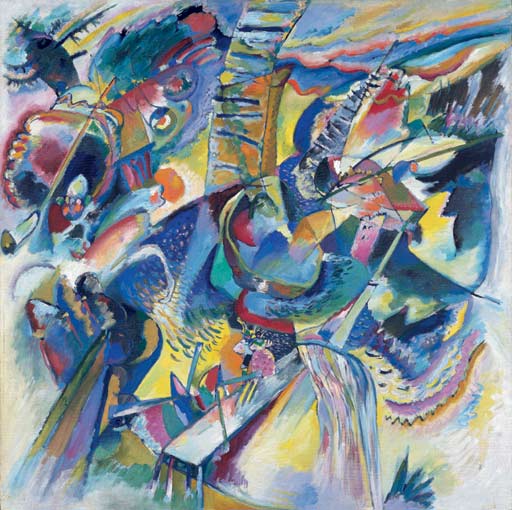 Another painting by Kandinsky.  I was looking through a book and came across this painting by Wassily Kandinsky. It comes close to what I think John Epstien was talking about. The marks seem to be a response to something looked at but not a direct representation of what he saw. They give the feeling of close-up, distance and space in-between but are suggestive rather than precise about what the subject is. There's movement, texture, colour and balance...or off-balance...and it comes together in something intriguing, exciting and exquisite. I'm still completely taken with the daisy meadow at the back of our house. I hadn't realised its a chalkland wildflower meadow being carefully managed by my neighbour the farmer. I'm looking at it for the marks it leads me to make which individually mean less than they do combined. The field is probably why we have new wild flowers such as Hawksweed growing in our garden...self seeded from the field...I love it! Best of all..when someone was talking about Hawksweed on the telly the other day they said it grows on 'low quality soil'!!! I've seen Colin several times today. She's still loving wheat and will tug-o-war over a mealworm. |
Sun, 04 Jul 2010 I've discovered Colin's new favourite food; this morning when I was cycling with George I picked three heads of not-quite-ripe-wheat and brought them back for Colin. She absolutely loved them. When I squeezed the seed heads a kind of milky squidge came out and Colin couldn't get enough. I wondered if, as the seed wasn't quite ripe, perhaps it had a slightly alcoholic effect. Colin was on the doorstep frequently today, pecking my toes and hands and generally nagging for wheat! I've continued to think about John Epstein and his 'marks', and continued to work with that in mind. |
Sat, 03 Jul 2010 Is it really Wednesday since I blogged? Its all got rather busy! Colin is spending her third night in a row out. I think she's moved out finally and fully, I can't even imagine her flying back into the house. Its very odd but she's become nervous of everyone except me. I still mess about with her on the doorstep playing tug of war with her mealworms. I think it trains her to tug at things such as seeds which need tugging from their moorings in order to be eaten. Although she will still hop onto my hands or feet, I don't feel I can pick her up and cuddle her anymore. She used to love it, need it even, but now I would certainly be invading her space to do it. Instead I nudge her or gently shove her like an irritating sibling might. She's spending more and more time away, foraging for herself I hope, between her visits to the seed pot and the mealworm pot on the doorstep. In my mind I'm planning amazing sparrow-houses for Colin and the winter...something to keep her warm and dry...Thisevening I went back to Grace's house, her daughters have been clearing it out. Among the things set out from which I was able to choose -I took a wonderful glass jug and a lovely simple glass vase. Grace would know why I chose those...in class we paint flowers in glass vessels, always with the water at half-full to show the distortion of the stems through the surface of the water. I see too many paintings where its clear the artist hasn't looked at the effect water and glass have on what they contain. The house is now sold to someone who is going to call it 'Grace's Cottage'..perfect! |
Wed, 30 Jun 2010 Colin must have heard the weather forecast; she's sleeping idoors tonight...on the bookcase behind the curtain ruffle! I'm working on a new set. I've been thinking a lot lately...while sitting with Colin...and remember way back to my first Art School in Taunton, a teacher called John Epstein. He'd look at my work and draw l-o-n-g on his cigarette and say '...try and make marks which respond to something but don't represent them exactly; marks which show foreground, depth and distance without having to be something specific...I shouldn't have to see a mark which tries to represent something like an elbow or a tree...but should be a response to looking at those things...(l-o-n-g drag on fag)'. With my recent cycle rides and the chance to look at close and initimate landscape I'm finding John Epstein's words coming back to me. Colin spent the night out again but came back for some breakfast. Tonight is going to be wet and windy...hope its not too much of a shock! |
Tue, 29 Jun 2010 I spent a very happy hour on the doorstep with Colin yesterday. Its easy to pass more time than I realise. 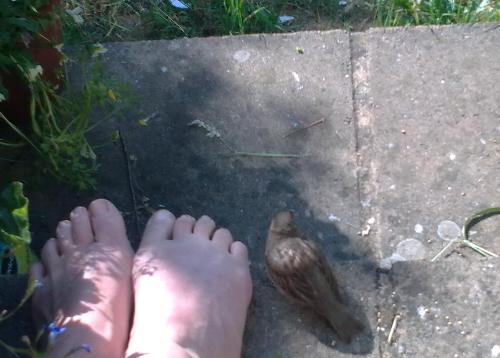 She seemed fine after her previous night out but last night returned for a night back up on her bookcase; she rests on the corner of a very tall book/dvd case behind a ruffle of the curtain. Earlier in the day I had been in my shed and thought I heard Colin which is unusual for the far end of the garden. Finally, trusting my instinct (there are a million sparrows down by my shed) I went looking; I found her caught in the neighbours fruit nets, she could have been there quite a while. I got her out and I think she was so shattered she slept in my hand for about half an hour before recovering. 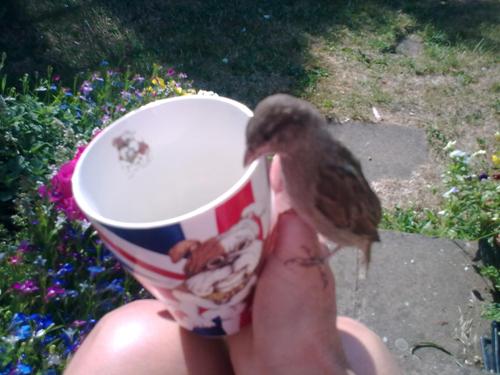 We whiled away yet more time on the doorstep... |
Mon, 28 Jun 2010 6.45 this morning and Colin is back feeding on lightly crunched seeds. I squish them in the tweezers which have fed her since the beginning. As she still hasn't quite the strength in her beak to crunch them open from dry, I assume that that is what I saw the parent sparrows doing down at my bird feeder last night for their youngsters. I was great to see Colin back, I knew if she hadn't returned something would have happened, so last night I didn't dare say I was expecting to see her in the morning. |
Sun, 27 Jun 2010 So...this is the first night Colin hasn't come back. I'm gutted. She fed several times today, and I even saw other young sparrows down by my shed, both feeding themselves and being fed by a parent so I think she still needs food from us. I'll just hope that her first night out is successful an she comes back tomorrow for more seed and mealworms. I notice the other youngsters were fluttering their wings like Colin does..either to say they want food or in deference to their parents. |
Sat, 26 Jun 2010 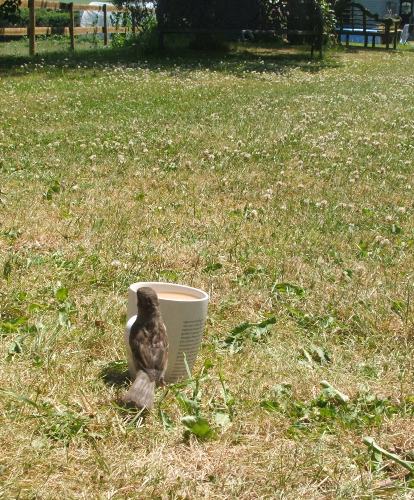 Colin now spends almost the entire day away. She'll pop back sporadically for some mealworms or an attempt on my tea; and she comes home to sleep each night on her spot in a ruffle of the front-door curtain. I'm not sure how far afield she goes when she's away, but she seems to have forged a tentative friendship with a group of predominantly female sparrows. We've been off line for a while because Simon cut the telephone line. He insists that its the same colour as the clematis he was cutting back, hence his mistake...we forgave him partly because it hurts him more than anyone else to be off-line. Another day slowly bringing an idea into a clearer focus...a little bit of drawing outside and a little bit of painting. Looking forward to a day in the shed with no outside responsibilities other than iron some shirts and roast a chicken.... |
Tue, 22 Jun 2010 Colin is out in this big wide world somewhere and its fairly nerve-racking not to know where. 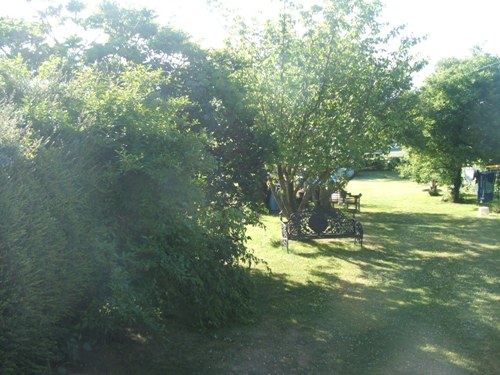 but after walking around the garden tweeting, I find her in a thorn bush near to the house. She seems to realise she's a bird...or at least recognise some affinity with the other sparrows in her neighbourhood, but I think it'll be some time before they accept her so I spend a fair bit of time out in the garden just watching. 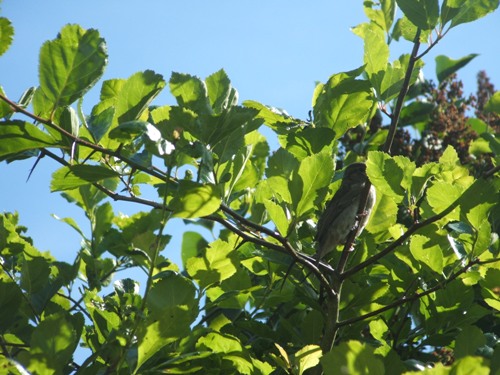 Colin has been good for me in that, while watching her, I have had some real thinking time around my next set of paintings. Today twenty square canvasses arrived via FedEx, but for days now I've had images forming in my head. Of course an image in the head bears only partial resmeblance to the final images on the canvas but they are a strong driver towards getting to the next and the next and the next and the end stage. I can't imagine my life without those drivers...ooooppppss...Colin is pecking my toes on the bottom doorstep! Means she wants maggots! |
Sat, 19 Jun 2010 Colin has had a day being busy. This morning she went outside for the first time. She flew quite a way from her cage and then realised she was some distance both from me and the cage. She came back to the cage but was a little more nervous; she tried to burrow under my hand and hide for a bit. She's loving live maggots, no trouble eating them by herself whereas she had a lot of trouble getting mealworms down her throat by herself. She's pecking at her millett and drinking from a pot of water by herself. All good moves! Today for the first time we saw her doing nest-like things. She's collecting strands of grass and placing them on nest-friendly ledges or in nooks and corners. She's also attempting to take my hair and Simon's arm hair. 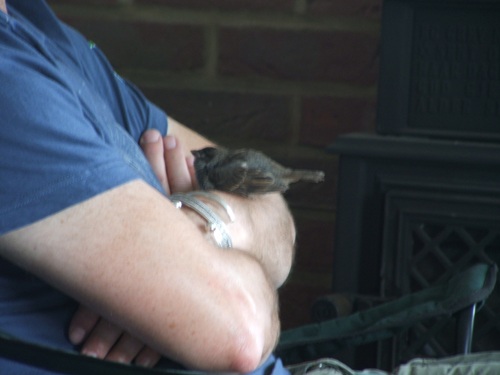 If she thinks she hasn't been given enough food recently she'll fly to whom ever seems most available. Here she's landed on George's shoulder, but also she'll land on any of us, close to our faces, and peck our lips until we get maggotts for her. 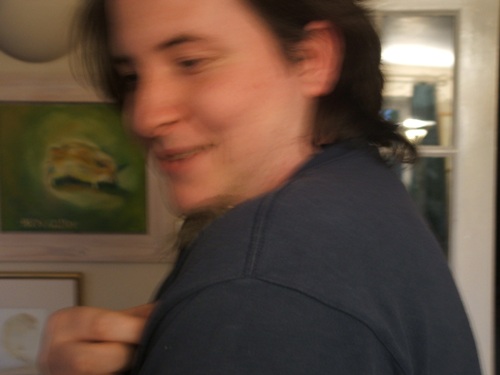 I've been writing today. Thinking about things and writing. Winding down from Dorset Art Weeks is always a time for thinking. Cycling with George every day has given me a chance to look at some fundamental elements of landscape, particularly close up landscapes...landscape of the prosaic, rural, every-day, small. |
Fri, 18 Jun 2010 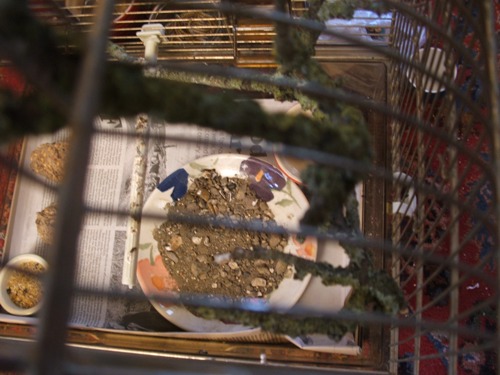 I've made Colin a dust bath and she's been bathing away in it...instinct kicked in again. 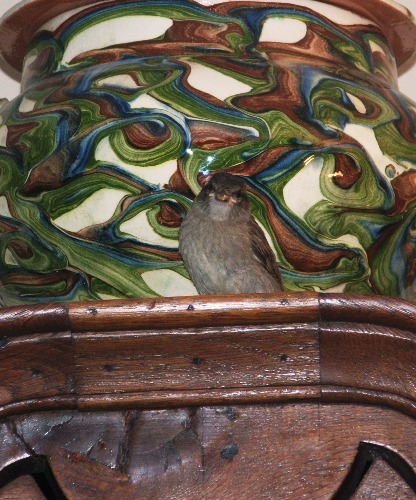 And here she is up on the dresser camoflaged by a large French soup tureen, one of her favourite places to watch an England game. |
Thu, 17 Jun 2010 George and I have been on a bike-ride thisevening and so I took the opportunity to look for foreground references.  I love these hogweed type umbellifers, they have such great overall structure and stature, and then are so delicate when you get close. 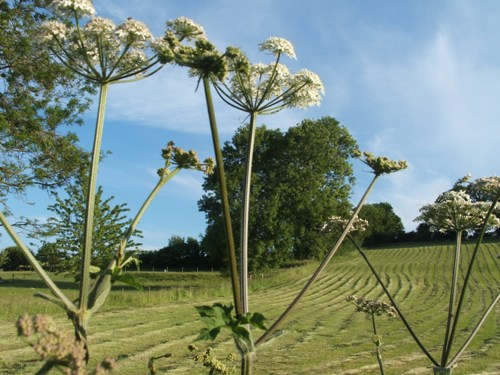 Its another of those things I'm constantly nagging my students about; see a view through a foreground reference, relate the distance to the near-ground and you'll get the perspective and scale of distant elements right. 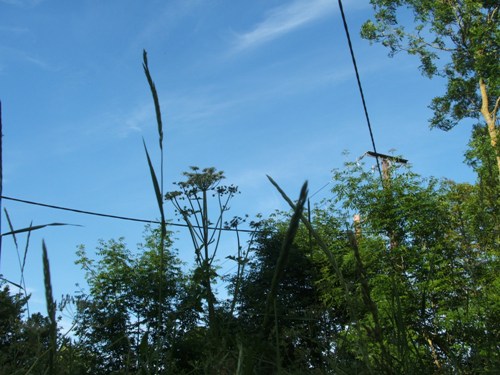 It is a lovely evening, Colin is flying around the sitting room, she's found a hiding place right on top of the dresser, behind the pots and bowls up there. She's as hungry as ever, as chirpy as ever, as funny as ever...and I'm thinking I might take her outside into the garden this weekend...into the outside world.  |
Tue, 15 Jun 2010 so...don't let 'technique' be the first thing people notice...they'll miss the message otherwise. I have been sitting quietly in my gallery writing emails and Colin has joined me, having a fly around and checking out the perching places. 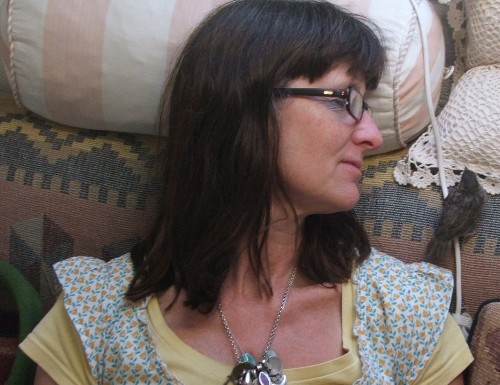 After a while she wanted to know what my laptop was all about (I have radio 4 'listen live' on), she's fascinated by the sound. 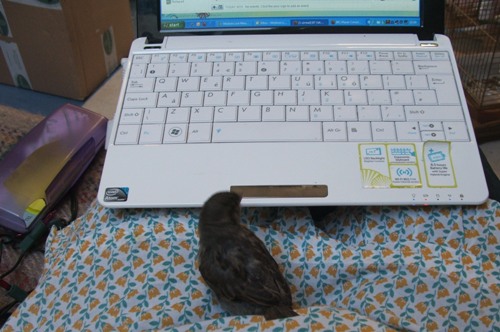 I let her sit in my lap until she pooped twice, at which point I sent her off for a flutter. Today I put dry 'eggfood' in my hand and she was eating for the first time by pecking from my hand rather that having mealworms and suchlike shovelled down her throat (in the manner of a parent-sparrow). I have seen her pecking her fresh parsley and pecking a hanging half-coconut filled with fat and seed in her cage, but not from the flat of a hand. I really need advice on how to teach her to feed in the outside world...I think this will be quite a challenge. |
Mon, 14 Jun 2010 Its Monday night so I don't blog because I teach on Monday night...but I know how keen you all are to keep up with Colin...she's really well, been really hungry today although I'm trying to get her to feed herself (from her various hanging seedy things). She's preening and nagging her feathers and pulling them into some sort of shape but she still looks like a scruffy nipper. I've been increasing the amount of seed I give her. I've had a woodburner installed in my gallery; its great, will be much better for the paintings and particularly work on paper in the winter. Tomorrow I'm delivering a painting to South Petherton and our dining table and chairs to my niece and nephew just outside Taunton...hired a nice big U-drive van! |
Sun, 13 Jun 2010 Colin has had a lovely evening flying around the sitting room. She's met a lot of interested people today and tasted some new delights but there's no doubt her favourites are minced beef and fresh parsley 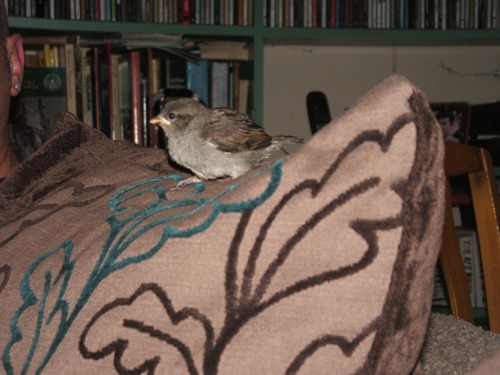 She's now on her top rung chirruping to the Germany - Australia game...and has now in fact fallen asleep...must be a dull game! 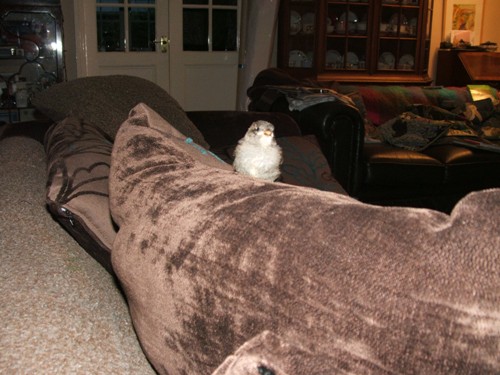 Had rather a lot in today which is joyfully the last day of DAW and tomorrow its full steam ahead in my shed on something that is burning in my brain...but enough of that, I'm not telling what it is! I've just been on a very pleasant debrief at the pub with all the other artists on the A354 |
Sat, 12 Jun 2010 Colin is flying!!! She was airborne for the first time today at about 5pm and hasn't looked back. We have to put the cage over her which she doesn't seem to mind; it gives her a frame to pratice hopping from twig to twig (so to speak. I took her outside in her cage to listen to the birds singing, she joined in, and is now on her top rung watching Dr. Who and singing. Today she's eating baby-beef food mixed with the 'eggfood' we got from the petshop. 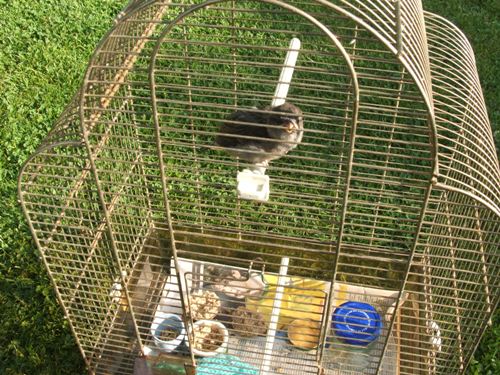 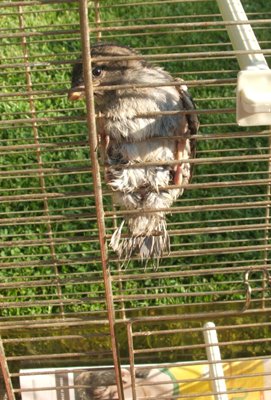 Colin has a slightly mucky butt in this picture because she sat in her baby-apple food. I've cleaned her up since then because she's not so good at that yet! She's loving sitting on her top rung and singing at us all! On another note, its a mad weekend, I'm booked to be in two places at once and flitting between the two. Tomorrow is the last day of Dorset Art Weeks and I'm off to the pub with fellow DAW-ers to ... |
Fri, 11 Jun 2010 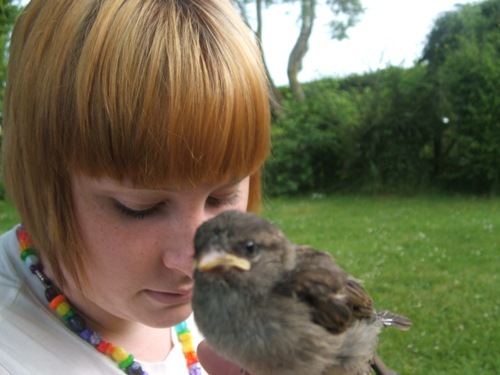 Colin; Day eight...flapping his/her wings, eating heartily, she's a joy! Mary brings her into the garden each day to hear the birdsong. 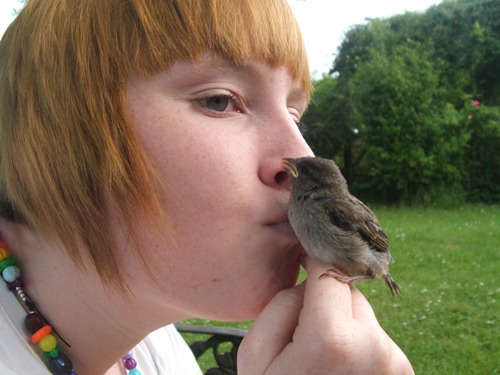 |
Thu, 10 Jun 2010 Here is Colin on day seven, trying to go walkabout off my hand onto the fender seat. I'm thinking he might be a Coleen as he's developing those pale stripes behind his eyes like the female sparrows have. I guess he might be still too young to be sure. 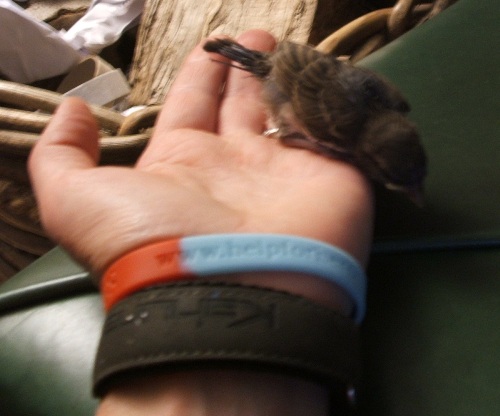 When he's not out and about he loves being in this little woolley hat which Mary knitted a long time ago for one of her teddies. Colin nestles up under the kind of rim he's created, it seems very much like a nest, and when he's nuzzling I imagine its like his mother rustling about in the nest beside him. 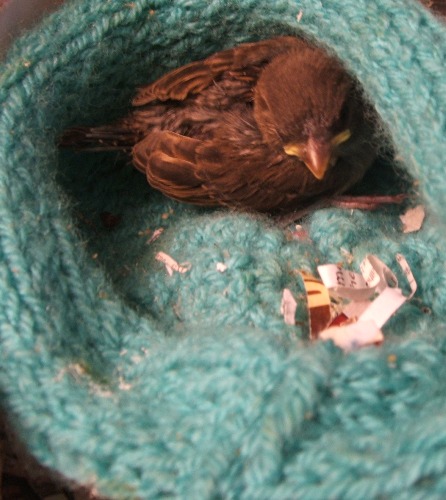 He's been preening and scratching at the waxy tubes on his feathers, and gradually they're all fluffing up, but I think until they're clear of the waxy stuff they itch and irritate him...nature's way of clearing the wax off! He's still as hungry as ever, but really doesn't like to get up before 7am which amazes me. I thought he'd be awake with the dawn chorus (4.30am) but thats just Simon and me...because the cockerel is crowing in the field beside the house at that time; you can be sure that Colin is still snoring. I went to see the paintings of my friend Claire Thomas today and they took my breath away...I recommend a visit. |
Wed, 09 Jun 2010 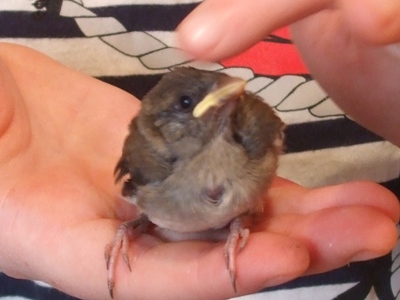 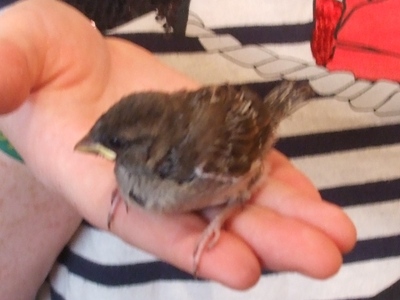 Day six: I'm sure now...and only since this afternoon...that Colin is a sparrow! A House sparrow. He's scratching and plucking all those waxy tubes off his feathers to reveal very sparrow-like looks; he's also tweeting like a sparrow. His appetite is as good as ever, he's stretching his wings and perching. It all happens so fast!!!!! I think its all pointing to one thing...a sparrow!!!!! |
Tue, 08 Jun 2010 Day five; Colin is looking so grown up now, he's eating a huge amount and chirping all the time. Like a baby he has day time naps, but is a very good night sleeper and doesn't like to be disturbed until about 7am. His feathers are beginning to make him look like a real bird and he's just able to perch on our fingers and almost hold his own weight. He's still very good at pooping while his rear end is held over the side of his woolly-hat-nest. He practices wing flapping when he's on our hands and replies to our attempted chirrups. He's so gorgeous, we all love him! 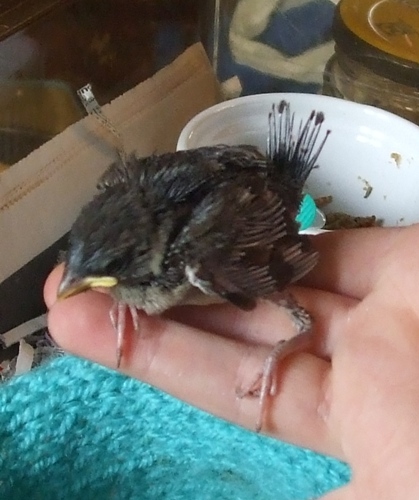 Its been unexpectedly busy today (DAW) with some really interested and interesting people. Caught me off-guard...I was planning to be holed-up in my shed all day! |
Mon, 07 Jun 2010 Colin is alive and well, enjoying the caterpillars and mealworms. His feathers are growing visibly longer each day and he's moving about much more on his sturdy legs. Mary has found that if she feeds him then holds his butt over the edge of his wolly-hat-nest, he'll poop to order! I'm in charge of him today as Mary has a 2hr revision session in school this morning and then an exam this afternoon -for that reason I did night-duty with him too although on the whole he sleeps through the night. Yesterday morning was the quietest day on the planet for Dorset Art Weeks, but I guess everyone had a lie-in, went off to the pub for lunch and then all came to see me in the afternoon! It went mad for a while!! Lots of very lovely people! |
Sun, 06 Jun 2010 Colin is alive and kicking! he had his first live food this morning...a little caterpillar..and it went down vey well. Mary's giving him a while to check it digests well before he gets the next one. Otherwise he's having mealworms and some baby bird mix called 'eggfood' 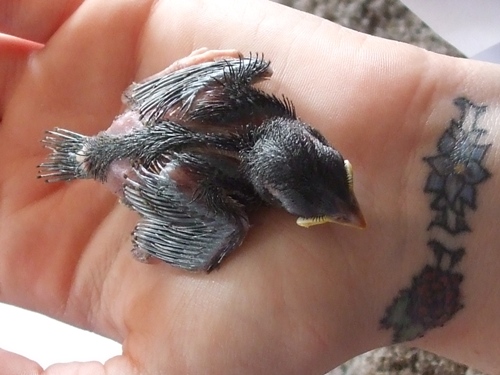 Another busy Dorset Art Weeks day yesterday. Today is sunny but with a cooler breeze. |
Sat, 05 Jun 2010 Just to let you all know that Colin is doing fine...he's sturdy and eating well. |
Fri, 04 Jun 2010 L-o-n-g day and I'm tired! Mary has rescued a baby bird. We waited several hours to make sure it was completely abandoned and since then she's made a nest and been feeding it mealworms. It's a vigorous little thing, its little life is tenaciously clung on to. I think its a blackbird because its legs and feet seem too big for a smaller bird.  Mary and Dan have called him Colin |
Thu, 03 Jun 2010 These are the two drawings from which the painting is growing. Spiderman is picking an apple but of course he won't be able to eat it... he is a masked hero... 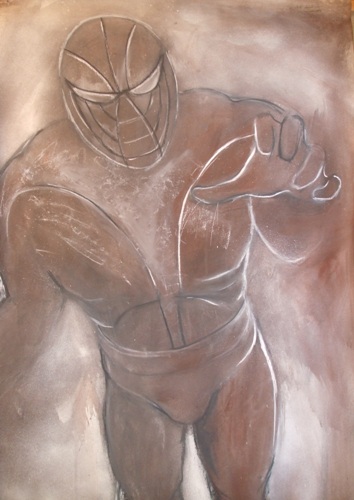 ...and here, she, is masked, anonymous and her testimony is worth half that of a man's (hence two of them in the emerging painting). 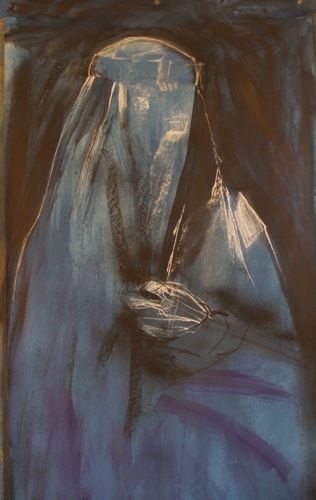 Busy time for Dorset Art Weeks, I have had a lot of painters visiting and asking what/how I do what I do etc. Simon says I'm a painter's painter, I'd say he's right. |
Tue, 01 Jun 2010 I'm beginning to make sense of some large drawings; putting the elements into one drawing which is the basis for a bigger painting (stretched a big-ish canvas yesterday). 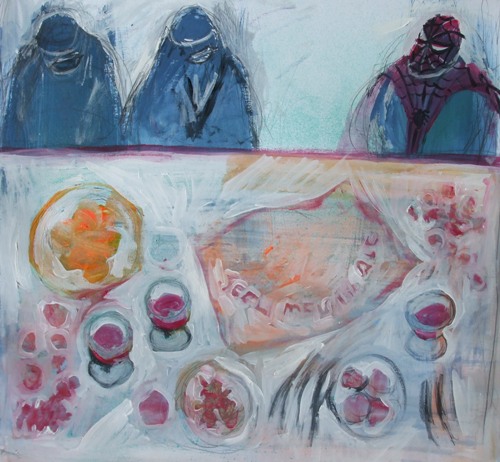 I love still-life so the excuse to bring it in to any painting is worth taking up. 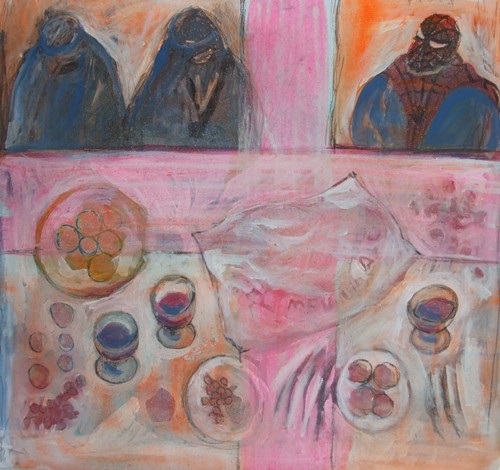 These are three stages through the same draiwing. I realised I needed a stronger light-source and thats what happened towards the end. I was listening to a fantastic radio play at the time. I often associate paintings with the plays I've been listening to while making them. This particular play was about a stolen Dragon's egg. 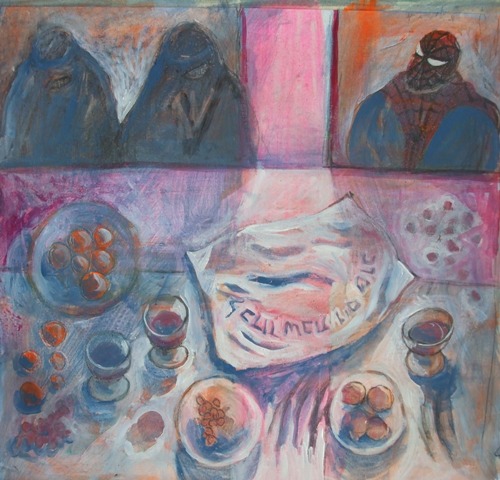 Forbidden Fruit. |
Mon, 31 May 2010 I keep thinking about a line in the Book of Ruth 'Call me not Naomi'. Naomi means 'nice' in Hebrew but she felt she'd been dealt a bad hand by God and so said 'call me Mara'. Mara means 'disobey'. Actually she didn't disobey anyone, she went with her daughter-in-law (Ruth, who promised to 'cleave' to her) to Bethlehem, home of her kinsmen, where Ruth met Boaz and eventually married him...fantastic story and well worth reading, but that phrase 'Call me not Naomi' keeps ringing in my head. I heard Arvo Part interviewed on TV the other night. He apologised when asked if he had a message for his public; he replied 'I'm sorry but I'm not really interested in them. I'm searching for the truth of my own soul. The outside world sometimes looks amazing but is not all it's cracked up to be and so I try to ignore it'. Oh I fell in love with him then! |
Sun, 30 May 2010 It's 11.33pm and I've just wandered back from my shed. I love the vast skies full of stars and the sound of owls hooting. I logged Ursa Major and found the North Star...in the right place! Some lovely visitors today, a lot of them interested in joining classes...so when I'm lacking confidence with my painting I know my teaching is valuable. 'The Artist' magazine have asked for an article, I've said yes, I'm looking forward to that...have many ideas and am not sure which one to follow. |
Fri, 28 May 2010 So today has been very busy, not without a moment of recreation and relaxation, though, when I went with some of my students to The Forum Cafe in Blandford where an ex-student of mine, Claire Thomas, has her work up; and sublime some of it is too, particularly a little watercolour of Knowlton Church. Knowlton is a 14th Century ruined church (possibly on the site of an earlier Saxon church; Knowlton was a thriving Saxon town.) built within a Pagan earth circle. This was almost certainly case of the 'Christianisation' of the local population away from their Pagan religion to Christianity by linking the new to the old. The earthwork which encirlces the Church is Neolithic and probably about 3500years old. Here are photos of my gallery. It was once the woodshed and pigsty at the back of our house. In 2000 I had a eureka moment...I asked myself what on earth were we doing using the back sheds to store junk when there was valuable wall space within them? 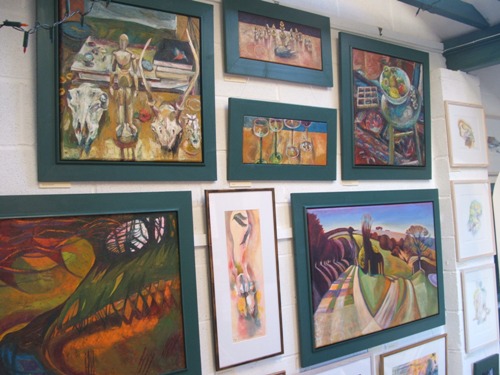 I hauled out all the junk we'd gathered and took it all to the dump. I painted the walls white and I put up two large canvasses and started to paint. This was before I had my large new cabin and was working in a smaller shed in the garden, so the wall space was a massive new freedom. 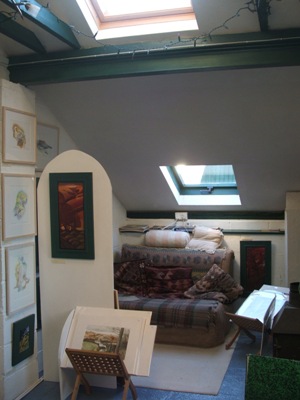 Over the years we've re-roofed it, had the ceiling plastered and turned it into a great little gallery in which I keep an exhibition at all times. I work hard not to let this place get junked-up again...not always easy! 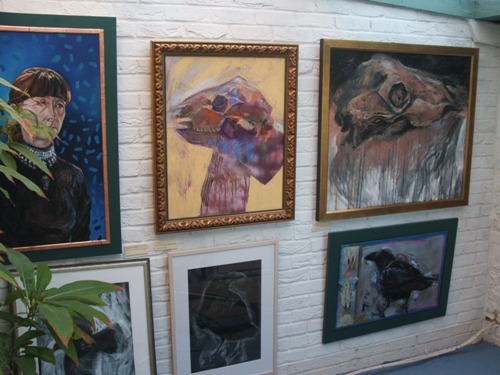 The yard between the house and the gallery is a covered with a three-skinned plastic roof and so that too has become part of the space which I can use to exhibit. 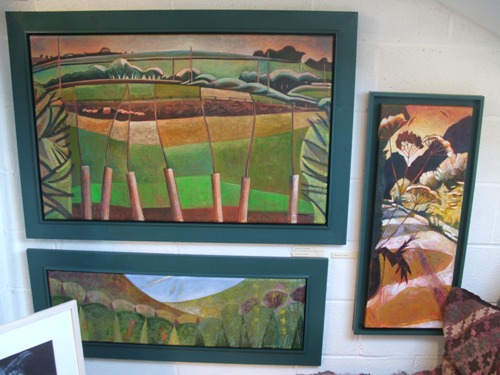 I have, of course, been changing things around, even since these pictures were taken yesterday, so it all looks a little like this...but not quite. Tomorrow we open...10am -so I can have a lie-in first! |
Thu, 27 May 2010 It's been an evening of putting out signs and hanging and re-hanging for DAW so only enough time really to say there was an amazng moon tonight although the cows seemed prosaic about it. 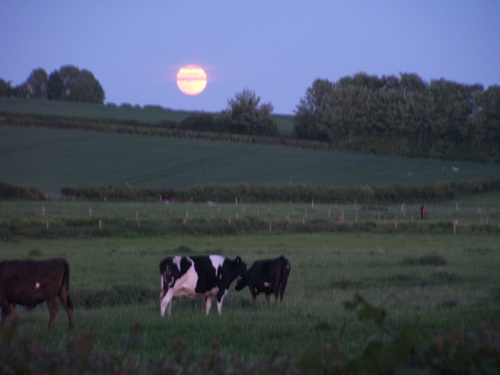 Its a fragile time, setting out these things which have surfaced from the depths of your soul and knowing that so many people who you don't know will pass judgement. Tomorrow -white wash, deliver cards to local shop, put out the recycling, poster to the local pub, teaching all afternoon, exhibition up in the evening at The Gorge Cafe..home for a tankard of wine! |
Wed, 26 May 2010 I've been reading about another suicide in China; 21yr old Nan Gang, after his ten hour shift making motherboards for Foxconn in Shenzen, southern China. He'd come from Hubei province in the middle of China and was most likely the only child of his parents. Probably they thought he was making his way in the world having left home for a job in one of the fastest 'growing' places in China. Looking on-line at pictures of Hubei, I see it has two huge rivers running through it including the Yangtze with one of its significnt dams, the Three Gorges Dam. The pictures on-line of Hubei and the Yangtze are absolutely beautiful but perhaps Nan Gang felt trapped and unable to return home for fear of failing his family and utterly unfulfilled making motherboards on ten hour shifts during which workers were not allowed to speak to each other.  This giant baby was born in Hubei province; the Chinese authorities think that the increase in the birth of giant babies is down to mothers' better nutrition. Whatever we wish for our children we probably mostly wish they could talk to us if they ever feel half as bad as Nan Gang. I wish he'd had someone to whom he could have talked about his life, even better I wish he'd had a life with normal friendly relationships and pastimes -happiness and fulfilment- and if he was the only child of his parents they've lost their life's biggest investment. |
Tue, 25 May 2010 Hooooray!!!! I'm so sorry ! My site has been off line for a few days now. Its because the company who host my site made an automatic update but it re-set my Domain Name Server to a default setting which was appropriate to the previous company who were taken over by the new one...now they've sorted it and I'm very grateful...Phew! I hate being without access to it! |
Fri, 21 May 2010 ...been working hard getting it all together for Dorset Art Weeks (begins a week Saturday). I'm painting floors, walls, hanging and re-hanging pictures, labelling, writing blurbs, price lists and generally sorting things. It means not much time to pass on my meandering thoughts... |
Tue, 18 May 2010 I'm working on this painting of my Mum. I thought it would be a whole lot harder but I'm finding it incredibly enjoyable. My Mum is eccentric. Among her many exploits she started parachuting at about 40 and got a pilot's licence aged about 48 I think. She and a friend flew themselves to various places and countries..with some hair raising adventures and outcomes. This painting is called 'Cuppa Tea Anna Biscuit' and I've put our most eccentric tea cups in the background, all 'Limoges'.  Today, every time I opened my shed door, two hopeful swallows flew in thinking it a perfect place to nest. Of course I feel incredibly guilty because it IS a perfect place to nest but I can't really let them, so I called my friend Chris to ask him what I could do. He came round with an old Guinea-pig hutch which we've rigged up under the eaves at the back of my shed and we're just hoping they may take up the offer. Watch this space... 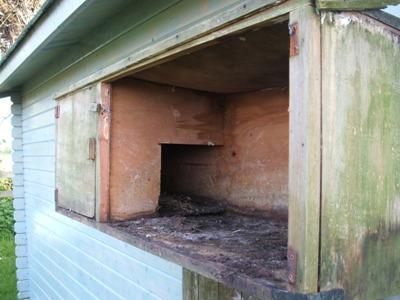 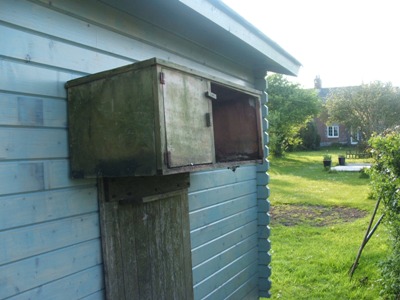 Meanwhile a little wren is building his nest in the tangle of old ivy branches clinging to the ash tree behind my shed...I have a perfect view from my window and I've been watching him carry in green moss all day. He has an extraordinarily strong voice for such a tiny bird. |
Sun, 16 May 2010 I went to Cambridge yesterday for a graduation ceremony. Jack and his friends were getting their M.A.s, an honourary degree awarded four years after their initial graduation. The ceremonies there are always a visual archaic feast! -ladies and gents in funny headgear and furry edged cloaks speaking very polite latin to each other as they hand the graduates over for the receiving of their M.A.s. No photos inside I'm afraid but... once outside again... here are Seigo, Jack and Anna 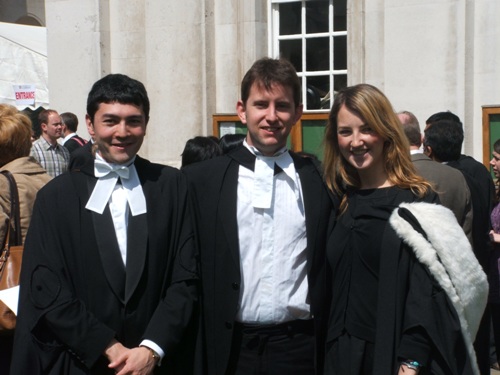 Seigo was the first person Jack met when we dropped him more than 7 years ago for the beginning of his University life, and Anna is a good friend whose father helped Jack at a difficult time. 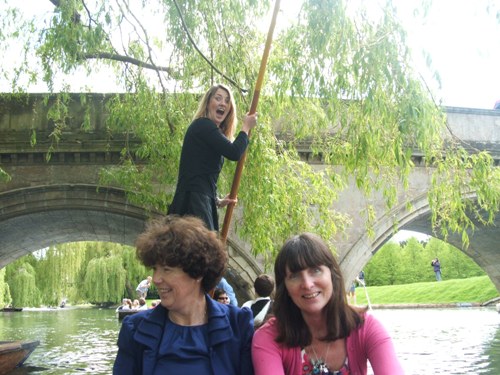 You can see...we spent the rest of the afternoon punting..and then to Tatties for tea and cakes. The graduates got to punt, the parents to relax and reflect (thats Anna punting and her mum Linda with me). 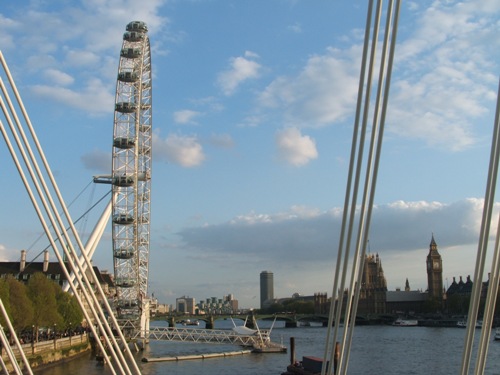 On the way home (I did a day return by train, saved me hours of driving) through London I nipped out of the underground at Embankment because I love walking over the Jubilee bridge to Waterloo Station. A lovely evening with The London Eye and The Houses of Parliament in view. On the train home I comforted a very distraught girl who is 20weeks pregnant and had just eaten a piece of undercooked chicken in a restaurant; she was convinced she was going to lose her baby. I suggested that she not worry until she knew there was something to worry about and gave her my water and admired the scan photos of her little baby which were truly lovely (I'm convinced its a boy...but I didn't say so, of course!). |
Wed, 12 May 2010 The oil-seed rape fields around us are an intense yellow at the moment, especially when the sun shines on them. The yellow is so intense that frequently at the horizon its hard to tell if the yellow is lighter or darker than the sky. The difference between 'bright' and 'light' can be difficult to discern. The first way to try and discern the difference between two areas of tone/colour is to squeeze your eyes increasingly towards shut and see which area diminishes first. The darker tone will diminish soonest and the lighter tones will remain in your vision longer. Sometimes a white object (such as a tea cup) is darker than the white wall behind it. It all depends on how much light falls where. We can tell that the tea cup has an inside and an outside. Being an object in three dimensions, straight beams of light from the light-source cannot reach every part of that cup; the light cannot bend around a corner and light the cup on both sides at the same time. It means that parts of that white cup will be darker than other parts and therefore if you're painting a picture of it you're going to need 'tones'...and a variety of them. You can make 'tones' with charcoal on paper, from the darkest your charcoal will make to the white of your page and an infinite amount of tones between the two. You can also make 'tones' with colour. You'll probably have an understanding of the various colours' 'natural' tones i.e. If I ask 'which is darker, yellow or blue?' you'll reply 'Blue'. Quite right too..on the whole. But if I put a lemon in a cupboard and shut the doors and put a blue bouncy ball out in the sunshine...which then is darker? The lemon or the bouncy ball? Ultimately tone depends on how much light is falling on..and is then reflected off.. the thing you are looking at. So although the oil-seed rape looks incredibly bright, I'm not sure that it can be actually 'lighter' than the sky. |
Sun, 09 May 2010  I've been cycling along the lane delivering my Dorset Art Weeks invitations to everyone in Minchington this evening. I passed the nearby pond which has normally dried up for the summer by now, and saw lots of swallows dipping over the surface. I'd wondered where they were as I usually see many more over our garden and on the telephone line at this time of year, but the bug life is so dense over the pond as it begins to recede and the weed emerges all thick and smelly that the swallows will obviously remain there until it has dried up. The bug life was dense along Minchington lane too and I got them in my eyes and hair. Simon came back from his bike ride tonight complaining about the midges, but as I heard on radio4 yesterday that bug life is in decline worldwide I'm actually very happy that we were plagued by them. Once again it feels like this is a small corner of the world where things work. A winter river runs along Minchington lane (it feeds the pond). On the other side of the river are grazing pastures which are frequently filled with cattle and it struck me while I was pedalling that both the river and the cow pats must contribute to the abundance of bug life along the lane. 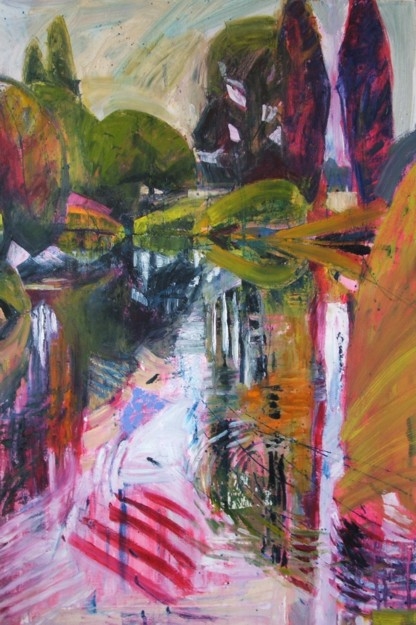 This is 'Swallow over The Stour' which my friend Chris bought when he was feeling flush! and below is the detail of the swallow and its reflection as it dips down over the surface. 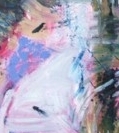 |
Sat, 08 May 2010 Blimey!!! I was just reading up on chaos theory(see following). What current situation does it most clearly describe?...Chaos theory is a field of study in mathematics, physics, and philosophy studying the behavior of dynamical systems that are highly sensitive to initial conditions. This sensitivity is popularly referred to as the butterfly effect. Small differences in initial conditions (such as those due to rounding errors in numerical computation) yield widely diverging outcomes for chaotic systems, rendering long-term prediction impossible in general. This happens even though these systems are deterministic, meaning that their future behaviour is fully determined by their initial conditions, with no random elements involved. In other words, the deterministic nature of these systems does not make them predictable. This behavior is known as deterministic chaos, or simply chaos.  It goes on...Sensitivity to initial conditions is popularly known as the "butterfly effect," so called because of the title of a paper given by Edward Lorenz in 1972 to the American Association for the Advancement of Science in Washington, D.C. entitled Predictability: Does the Flap of a Butterfly’s Wings in Brazil set off a Tornado in Texas? The flapping wing represents a small change in the initial condition of the system, which causes a chain of events leading to large-scale phenomena. Had the butterfly not flapped its wings, the trajectory of the system might have been vastly different. |
Thu, 06 May 2010 Here comes the third result...Sunderland central...my heart's thumping...and its...LABOUR again!!!! Sunderland now has three women MPs, one of them only 26 years old. I have to declare here that I voted LibDem. Our LibDem candidate, Emily Gasson, was a student of mine for many years until she married Ed Davey and started a family. At the last election she polled just over 21,470 votes, Conservative 23,714 votes and Labour 4,596 votes. She took 2nd place with many more votes than some people won their seats with. We (north Dorset) are a very big rural constituancy, spread over a large area...renowned for being the constituancy with the highest life expectancy for men in the UK. I've been very impressed by the amount of political discussion I've heard among younger people this time, and their general raised political awareness compared to previous general elections. Its great also to hear there have been unexpectedly long queues outside polling stations...glad to hear we still queue! I'm sitting in bed with my laptop, polling day 2010, radio4, totally gripped by the first two counts called, up north, both for Labour. Gordon must be feeling good at this moment. I wish it could last. In the interests of fairness I've been checking other political party websites and came across this engaging picture of George Galloway looking the spitting image of Tom Jones (you'll remember we bumped into Tom on the waterfront in Cape Town!). Maybe there's a bit of body-double going on and it was actually George Galloway we saw on the stage swinging his hips and singing 'The Green Green Grass of Home' at the Grand Arena in Cape Town last month...what a thought!!!!  What I'm unsure about is...Is George Galloway smiling like that to lure us in to voting for him or is he laughing at us? Whether he intended it or not, it has a feel of the latter. |
Tue, 04 May 2010 I've started work today on some almost life size drawings. Isn't it funny how intentions lead to things you never dreamed of in attempting to execute them? Today I had finished some framing, stretched two large canvases and rabbit-skin-glued them, been thinking of political images involving scales, money-magnets (yes magnets, not magnates), tables etc. and somehow ended up with a female body builder. I'm going to juxtapose...juxtapose women's bodies with men's bodies, nearly life size...the first pair being a female body builder and the crucified Jesus. Make of it what you will but I'm loving it!!! Can't wait to get back to my shed! |
Mon, 03 May 2010 Here she is, Alice Rate (nee Candy). She was my grandmother's grandmother and she lived at Milton but had a house in London where my grandmother used to stay. 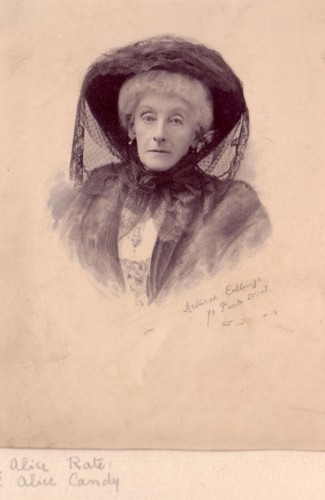 Her son Lachlan married Nita and they had four daughters. 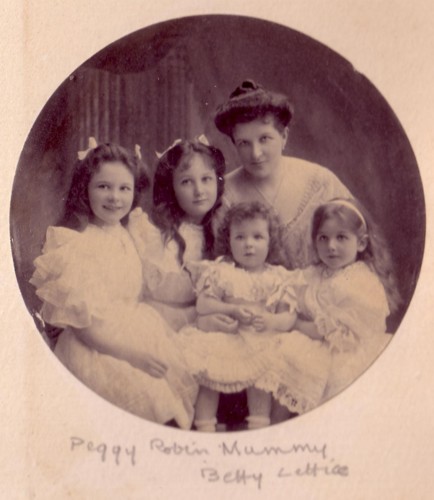 Nita and their daughters. Betty was my grandmother. |
Sun, 02 May 2010 I'm a pea-brain! I've just realised to whom Nita must have been companion...my great great grandmother Alice Candy. She was a formidible Victorian matriarch, I have a photo of her somewhere which I'll scan and post. They lived in a house in Surrey called Milton Court, my mother was born there because her mother returned there to give birth. Milton is the house from which Lachlan and Nita were rejected when they married. After they were re-united with the family they went to live at a house called Stonewick which is where Nita died. They moved to Milton after that; I guess that is the house to which Gran returned from school after 'the event'. 'The event' was never talked about. How do I know about it? I think Aunt Lettice (Gran's sister) talked to my mother. |
Fri, 30 Apr 2010 I've been working on 'Three Ways' again this morning. I'm just now heading in to Blandford to put a small exhibition in Blandford Museum...the new idea..'Painting of the Month', Blandford Museum..starts today! 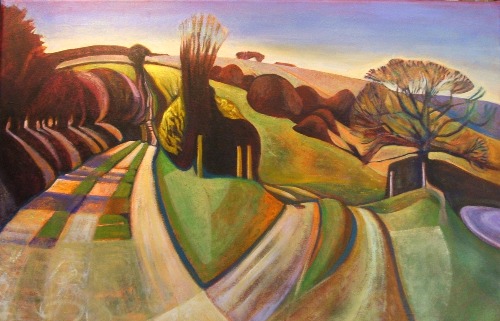 |
Thu, 29 Apr 2010 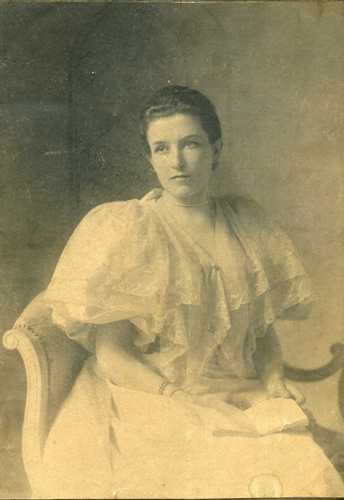 This was my great grandmother, Nita Rate (nee Bennett). She was a companion to a wealthy lady in Linconshire (possibly?) whose son Lachlan was engaged to an heiress but fell in love with Nita. They married at a house called Wolverstone belonging to Lachlan's best friend Buppup and were promptly ejected from the family, but invited back into the fold after the birth of two daughters Peggy and Rob. I believe Lachlan had been working in a tanner's yard...not sure...sounds unlikely! They went on to have two more daughters, Lettice and my grandmother Elizabeth Angela (Betty). Nita was not ever really accepted, often referred to as 'the serving maid'. When my grandmother was 12, away at school, Nita drowned in the lake at the end of their garden, very possibly suicide. The newspapers were kept away from my grandmother and she never returned to that house and never really knew why. I have a silver sixpence on my necklace which I wear all the time. On one side its a sixpence, dated 1888 and on the other side is engraved 'Nita Bennett 1892'. My mother found it among my grandmother's things after she died. When my sons were born it was exhilarating, amazing and wonderful, but when my daughter was born, as soon as I realised she was a girl, Involuntarily I thought of my mother, my grandmother, my great grandmother; I understood the links of the chain. It felt like a continuous flower, opening and opening and opening and for one brief moment I also felt incredibly sad. |
Tue, 27 Apr 2010 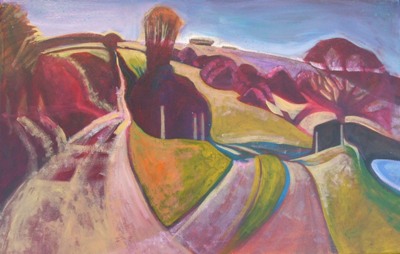 'Three Ways'...thus far. What a luxury Tuesday is! I can work all day in my shed and then in the evening too. I should give you an idea of my shed. I have sofa, rug, radio, old paintings, new paintings, paints, drawings, clutter, table covered in clutter, shelves full of paper, sketch books and drawings, old portfolios, a plastic crow, two heaters, a rolled up hammock, a laminator, a drawing donkey, an incredibly posh easel with a winding handle, electric tools (saw, drill, screwdriver etc.), a mangle, five hefty roof beams, two double windows and three glazed doors, peace, solitude...its a heaven! 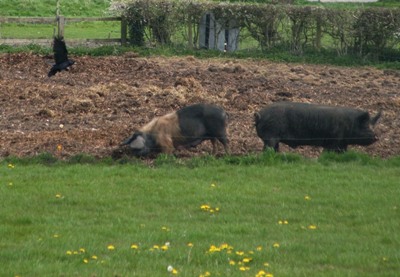 Mr and Mrs Pig seem to have reached a modus vivendi...she was fairly hacked off at his arrival yesterday whereas he seemed delighted! Even though he sometimes shoves the piglets away, they are unruffled by it, other than a bit of a squeal, and continue to run around his ankles irritating him. I\'ve decided he\'s actually rather good natured, because he\'s digging with Mrs Pig but has refrained from nagging her today and she\'s very happily digging with him.  Out drawing the other day I came to this glorious place with three roads/tracks disappearing into the distance from the one spot. In this sketch there are two of the tracks, however I've begun the painting with all three. 'Three Ways' I think... |
Mon, 26 Apr 2010 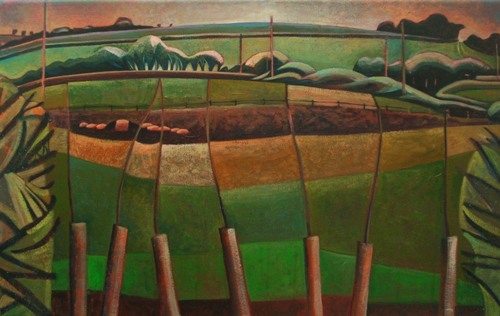 Saplings and Sleeping Pigs. I'm teaching tonight...as yet no car to get there...Simon not home with the big car and Mary not home with the little car... :) |
Sat, 24 Apr 2010 Looking at the photo of Grace again is strange. Her face 80 years ago is so much like the face I know, all I can see is 90yr old Grace in school-girl clothes! And then of course comes the problem of believing someone has died. That photo brings an involuntary l-a-r-g-e smile to my face. I'm sure it was taken on the brink of Grace scampering off with that little dog. |
Fri, 23 Apr 2010 I've been working on my 'pigs' painting. I'm layering and layering with colour and some spay-can texture but all the while trying to retain a gentle and rural quality. I'm back to the idea that some parts of the world seem to 'work' and this is one of them. I'm under no illusion about this being a cliche but sometimes a cliche is exactly in order! The duck hatched her eggs on Wednesday afternoon while I was at Grace's funeral. All but two hatched, the unhatched were addled so the neighbours dog ate them! and the duck was away almost immediately, not to the nearest pond but one a little further away. As soon as I can I'll get down there and check on them. 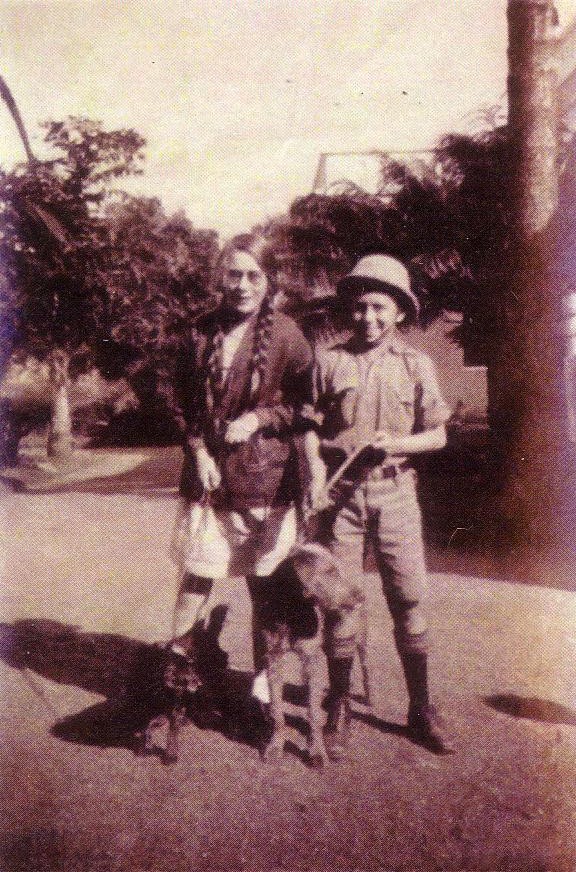 This is Grace as a girl in India with her brother. The remarkable thing is just how much her face is hers -the picture must be 80 years old if not more and I've known Grace for only about 12 years. Grace was feisty, opinionated and, according to herself, 'vain' because she refused to use a wheely-walker right up to the end. What she called 'vain' I call 'strong-willed' which surely kept her determined not just to manage but to live a social and generous life until she died. She was very very funny and had a gently wicked sense of humour...I'm sure I can see it in this photo. She was really great, and deeply thoughtful. Its been a busy few days. We've been looking at colour in class. This week I asked my students to find two each of the following colours; red, blue, yellow, green, orange, purple, by cutting out small samples from the pile of National Geographics which Grace had given me a while ago. All the samples had to be different so the two reds had to be entirely different although within the category 'red', similarly the blues, yellows etc. Inevitibly it lead to questions like 'When does the red become an orange?' and so they were questioning the nature of the colours they were looking at, thinking about the boundaries between colours, purity of colour-in other words what does it take to knock the character of a colour back a little so that it becomes a 'dull' or an 'earthy' colour? They had to mix, with waterolour, exact matches of the samples they'd cut out and get both the tone and colour so close that I couldn't tell which was magazine sample and which was their paint. It seemed a simple exercise and a gentle one to begin the term with but it became as intense as I'd hoped it would. |
Thu, 22 Apr 2010  First thing yesterday morning over our house... Driving to work yesterday the once clear blue skies were a weave of sky tracks in all directions, like a muslin veil. Ahh well, it was lovely while it lasted, a rest for the skies, but another event which confirms what a fragile web our lives depend on. It was Grace's funeral yesterday, I'll blog later on that. |
Tue, 20 Apr 2010 Finally coming down to earth. I was about to set off with all my clobber to paint the other day...I walked out of my shed and saw through a gap in the hedge...eight little piglets fast asleep in the sun beside their mother, and I walked no further with the clobber, set up right there. So this is deep in the middle of the process of the painting, still many enigmatic layers covering the composition waiting to be resolved/restored. 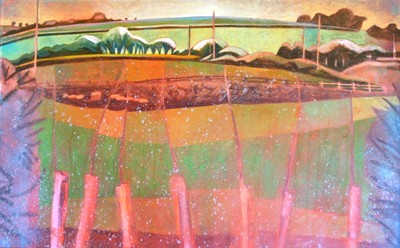 Although the painting is of a complete view, its really about the saddleback mother and her eight piglets. 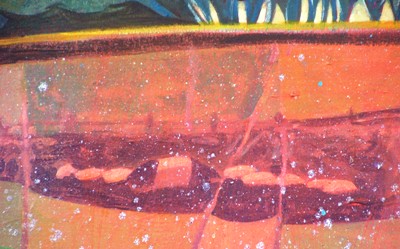 ..and here are some of them..  |
Mon, 19 Apr 2010 I'm finding it hard to get going again. Yesterday I went out and about, found a great place and did some drawing, but I've been looking at things -at other people's work- and that always leads me astray somewhat, feeling I should be doing this and that, and not looking to the kernel of my own ideas. Hey ho... First class of the summer term tonight, that always grounds me! One of my oldest and loveliest ladies died the last weekend we were away, Grace, aged 95 who'd been coming to me for several years. She was born in India to missionary parents. She used to cross India to get to school on a three day train ride. She didn't leave India until she was 17yrs old, landing at Liverpool docks, and was amazed to see white men labouring. Grace became a nurse and married a doctor. He'd died before she started coming to me so I didn't know him. Grace said there was never a day when she didn't miss India even though she never returned. She was absolutely compus mentus to the end. What I'm really grateful for is that I always gave her a kiss and a hug, and I last saw her just before we went away. Another of my students died sooner than expected (she'd been ill), the last time that I saw her I didn't say goodbye properly and I regret it. |
Sat, 17 Apr 2010 Mum and Frank came too, Sadie and Stephan are only 20mins from them by car, on the edge of Taunton. This is the main sitting room...you'll be interested to see a Clare Shepherd gallery emerging! 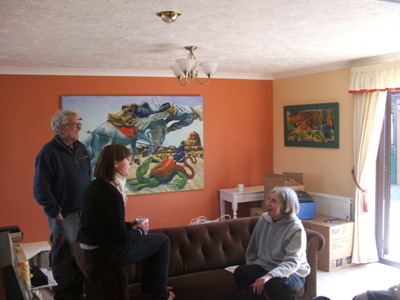 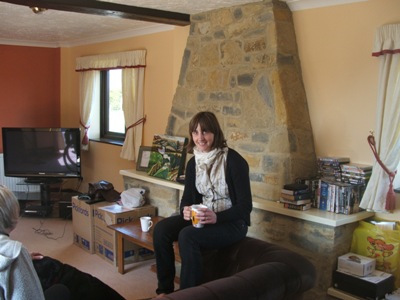 They're also buying the field beside the house...Sadie has a horse...the field is rough at the moment, and L-shaped like the house. They'll get it clear in time.  This is the garden side of the house...they have a sit-on mower...came with the house! 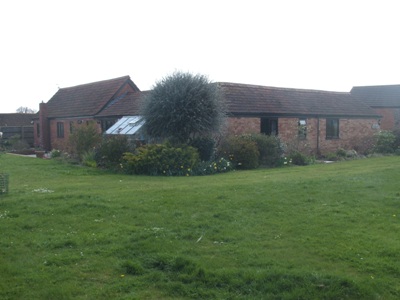 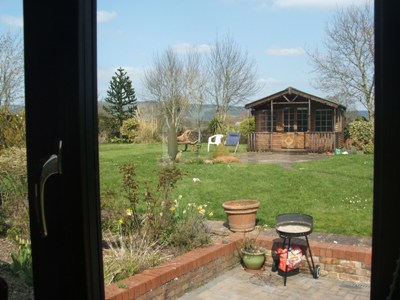 This the summer house from the kitchen window...and this is the way into the garden from the kitchen. 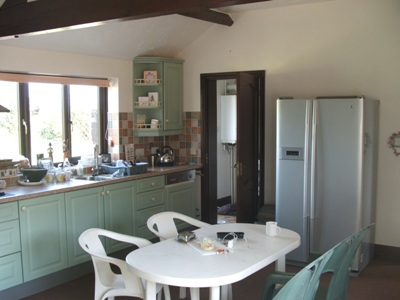 They look out over the quantocks to the north, to the east from the garden is this lovely field and view. 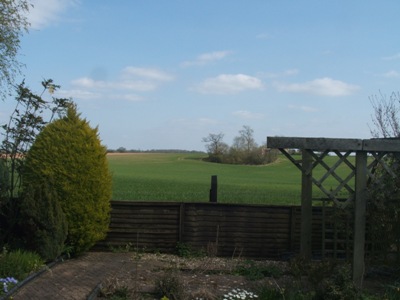 I went to see my niece and her husband (who lost his legs in Afghanistan last October) in their new house yesterday. Its great, plenty of space for everything including things like parking your car and having enough room to get yourself out of the car if you have wheel-chairs etc. to contend with. They have a car each, both automatic so that Stephan can drive either. 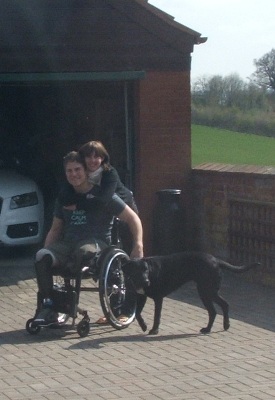 The house is a bunglaow so easy access for Stephan everywhere. 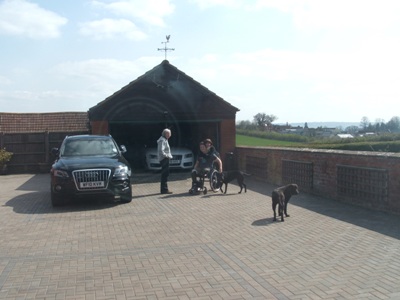 I'm uploading these pictures so that my brother (Sadie's Dad) can see them; they've only been in the house a week so he hasn't had a chance to get down there yet.  The house is L-shaped and has a big garden all around in on three sides, overlooking fields...lovely! |
Thu, 15 Apr 2010 Leaving the house, last picture from the balcony.  I took several pictures with my phone camera as we drove to the airport. We passed the hospital where the first heart transplant was done in 1967, by Christian Barnard, and we passed shanty towns and apartment blocks with names like Tip-Toe, Chiltern, Dawlish and Dorchester. 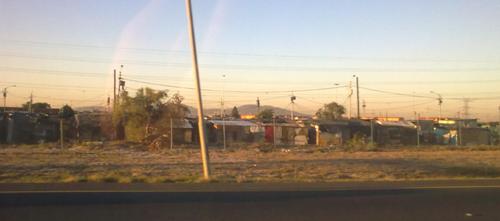 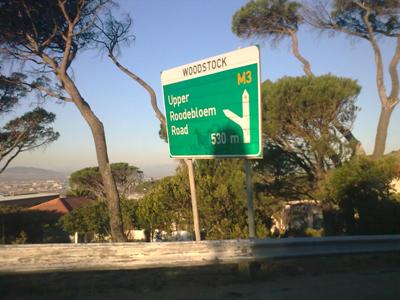 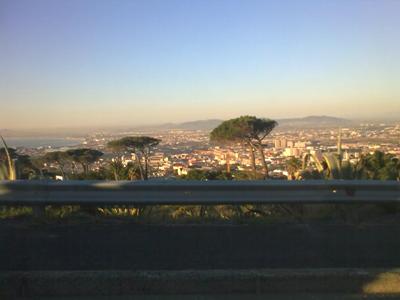 Sad to be leaving. Bo-Kaap 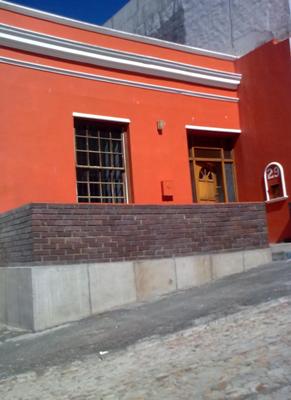 The Bo-Kaap is an area of Cape Town formerly known as the Malay Quarter. It's essentially a Township on the slopes of Signal Hill above the city centre and is an historical centre of Cape Malay culture in Cape Town. The Nurul Islam Mosque, established in 1844, is nearby. Bo-Kaap is traditionally a multicultural area known for its steep cobbled streets and beautifully multi-colourerd terraced houses. We decided, after a quick last visit to Green Square Market (where I bought some wonderful excellent lovely ethnic sandals), to drive up in our tiny car to Bo-Kaap...Simon and Mary in the front, me in the back with my nephews Charlie and George. I don't think we were prepared for quite how vertical the dear little cobbled streets are...Simon came to a halt on the brow of one of these vertical hills having premature heart faliure as he tried to haul the little car up and over what felt like a ledge...didn't make for a calm atmosphere (only momentary of course!). The houses are eye-poppingly painted and lovely. If I lived in Cape Town thats where I'd be. 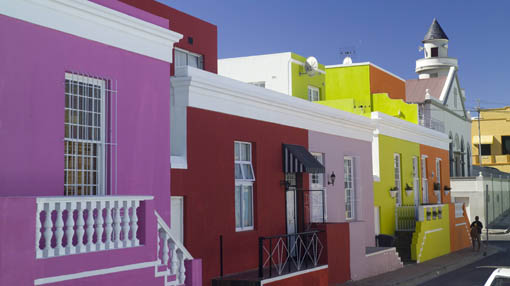 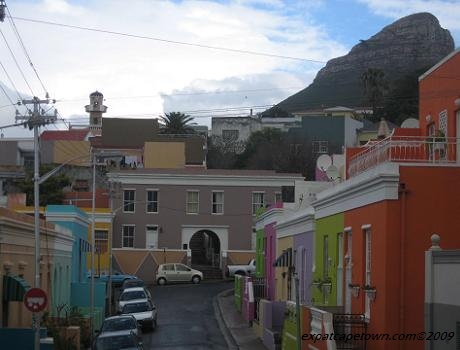 Last day in South Africa...I wandered around Camps Bay to find some 'unseen' places/plants/secrets. Just around the corner I found these burned logs. I couldn't work out if they'd been part of a disaster-type fire or a naturally occuring fire but they made a splendid foreground to Table Mountain. 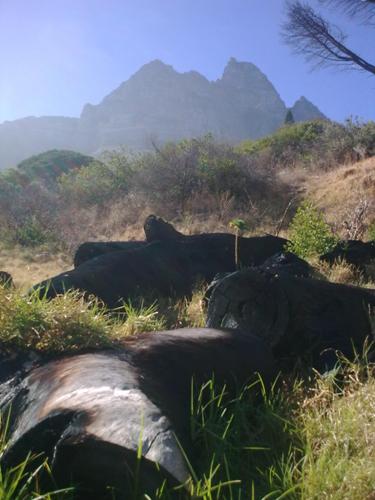 If it had been a disaster-fire then the surrounding grass has grown around the logs thick and matted and tough. I tripped and scrambled several times. 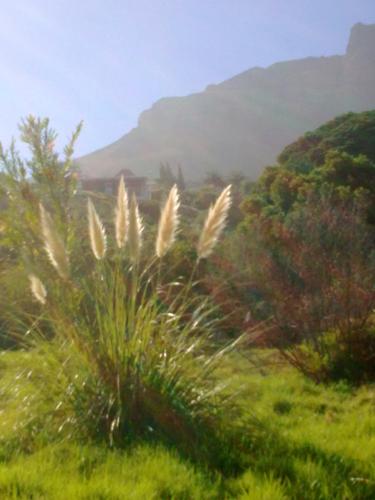 This lush green grass is part of that same matted cover. It looks so lush because I think there's a watercourse running under it but the thick weave of growth is like a mattress holding firm over the actual ground which seemed some way below. I bounced and tripped on the surface and got my ankle caught a few times. 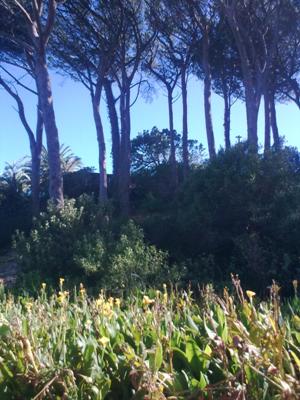 I think the main watercourse runs under these plants (lilies?) in the foreground. |
Wed, 14 Apr 2010 This is how close Robben Island is from Cape Town...you can see across to Cape Town and Camps Bay, under Table Mountain, from the island. 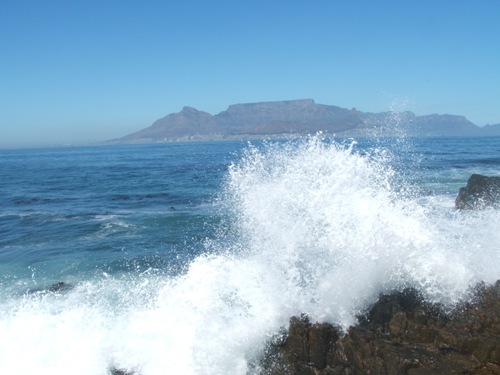 We were taken to the prison on the island. The man who showed us the prison was another ex-convict, a very quiet man, he seemed resigned...to his past? to the still troubled present? to the future which isn't coming fast enough? He was born in Soweto and had been an active member of the ANC from a teenager. I asked him if he was the only member of his family who had been active, he said his father was very political and had given him books and pamphlets to read but no-one else in his family was interested and his mother was very frustrated with his activism. I wanted to ask him much more but I think it would have been too personal and too explosive in front of the group...so I bottled. 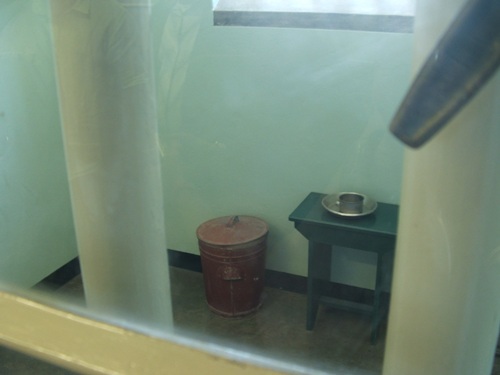 Nelson Mandela's cell Cape Town is a working port. Huge ships come in and out all the time, but the area known as The Waterfront is really the heart of the old working port; mostly fishing boats, day-trip boats, some cruise-liners and the ferry to Robben Island use The Waterfront. We had tickets booked for Robben Island, 11am on Sunday morning but had time to sit and watch as we were early by an hour (and I was nagged for it).  -waiting for the ferry- Robben Island is so popular that you have to book about a week in advance. We were lucky that we were able to re-book our cancelled tickets within three days. 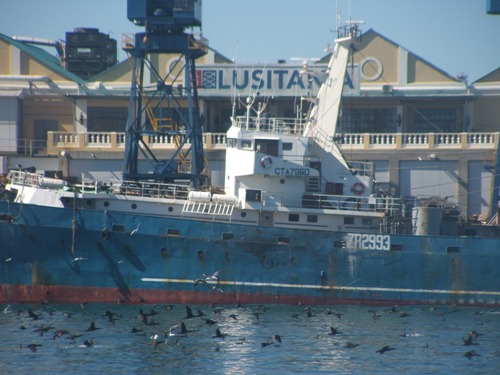 -Leaving the port- Robben Island is remarkably close to Cape Town, in fact its remarable that no-one ever escaped by swimming, except that what looks 'close' is about half an hour of ferry ride over very choppy sea. 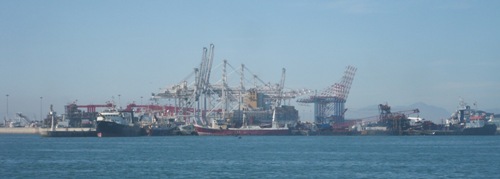 -Passing the working port of Cape Town- We got to Robben Island and were met by a coach and an ex-Robben Island convict and taken all around the Island. We were told about the impact various countries had had on the fight for freedom (UK came out ok! -sanctions etc.). We were shown lovely buildings lived in by governers and their families on one side of the Island, chuches, a leper graveyard, a muslim memorial building, an old cannon built for WW2 but only finished in 1947 and referred to by our guide as Robben Island's weapon of mass destruction. 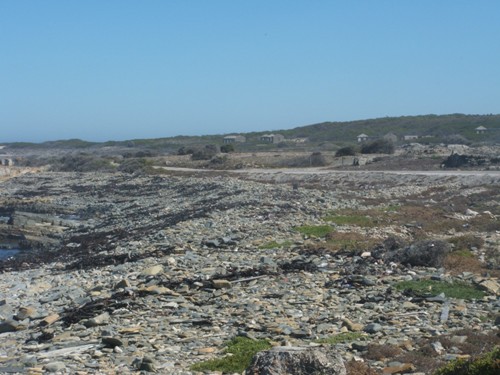 -derelict buildings on the north east side of the island- The indigenous island is scrubby, low-rise planting, but the eucalyptus tree has taken over much of the other side of the island and soaks up so much water that there is no longer fresh clean water avaiable to drink other than that which is brought across in bottles. The island is currently populated with ex-convicts who work as guides, and their families. If they didn't have their memories to contend with the island is a beautiful place to live, reminded me of Tiree. |
Tue, 13 Apr 2010 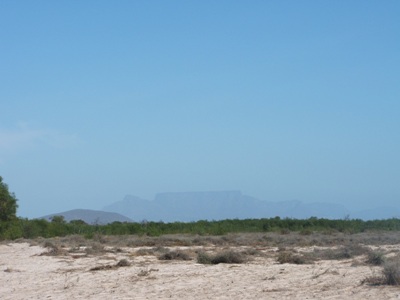 Table Mountain from the parachute landing site. Alan said he had a sense for the first time (even though he grew up here) of how vast the land is, how far it stretches and dwarfs Cape Town which had always seemed so big. The airstrip was ... basic, a wooden refreshments shed and an awning with benches, a corrugated iron hanger, a tiny wooden-shed-flying-school and a lot of parachuting/flying enthusiasts...all miles down a bumpy dust track. Alan was jumping from 9000ft after an aerial saunter around the Cape Town bay and further inland. He was strapped in tandem to the parachutist and, alongside, a man with a camera on his head was jumping to film it all. 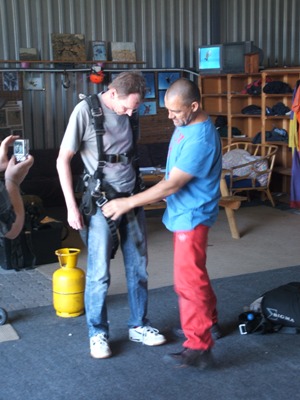  The Flying School 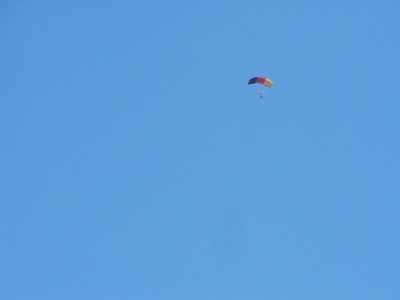 On his way down...they free-fell for 33 seconds before the chute opened.. 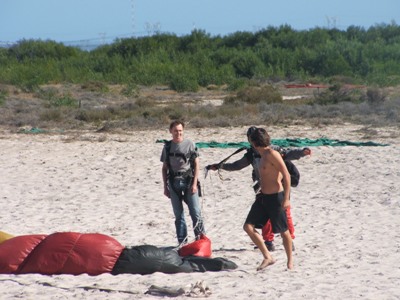 ..back on the ground. Lying in bed at dawn watching the ships come out of Cape Town harbour, they’re lit in street-light orange and remind me of watching the lorries at night coming down the A354 into Cashmoor. The ships are lorries of the ocean...or lorries are ships of the road! One wall of our bedroom here is a slab of glass, facing the sea, sunrise is fast, one minute dark, the next minute daylight and I can see what kind of day it’ll be by the amount of cloud coming off Table Mountain. Saturday and Sunday have had something of an internet connection problem, so I’m catching up on word and will update the website asap. On Saturday morning Mary and I got up early to get to the Table Mountain cable car for the first run up. It was so different from the other day; we drove up to the cable car base, no traffic, found an easy parking place, not one of the spaces where you have to parallel park along-side a sheer drop, and we got onto the first cable-car up with no trouble. At the top the views were expansive...understatement! and the weather was freezing. There is so much interesting vegetation you can see from the cable car but up on top not quite so diverse. On top we took ourselves to the cafe for a great breakfast, we bought two postcards and I stamped and wrote one to Jack who is China just now so won’t get it for a while. We were back down the mountain not much later. Our whole group headed across Cape Town and out the other side to what I think is fabulous scrubby land. Still loads of eucalyptus but plenty of what must be indigenous too. We met all of Alan’s family again (except for Lindsay and husband) at a tiny air strip where Alan was doing his free-fall-birthday-present-jump. It was incredibly exciting. 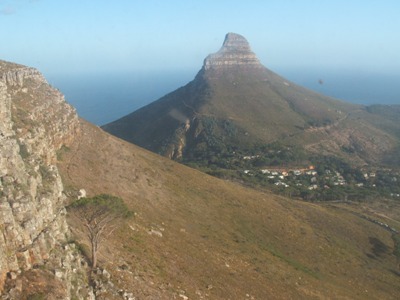 View of Lion's Head from the cable-car half way up Table Mountain. 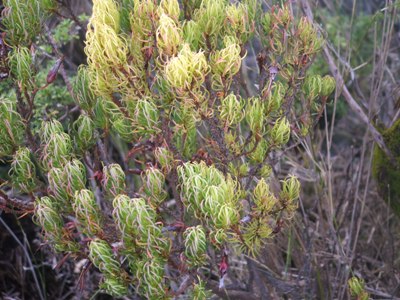 Plant on Table Mountain 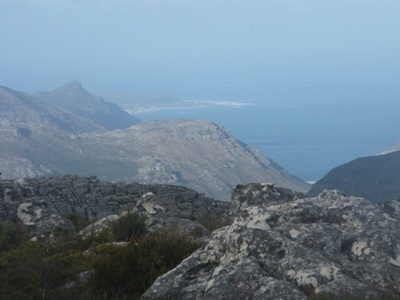 View south along Table Mountain 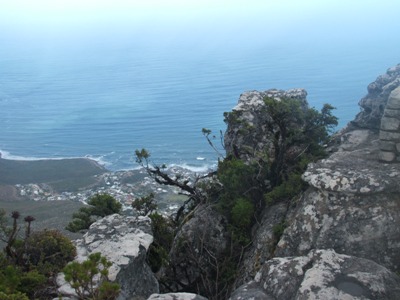 Looking down! (see the houses) |
Fri, 09 Apr 2010 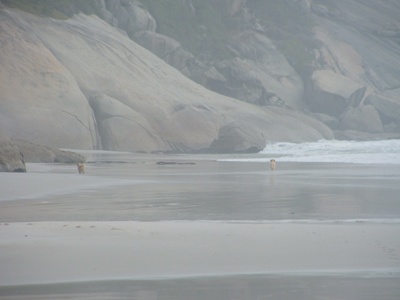 Couldn't go to Robben Island...went to Llandudno instead! Wonderful beach, massive south atlantic waves.  Atmospheric, mist and sea spray in the air and lots of happy dogs. The beach was empty but for a few people walking and playing frisbee. 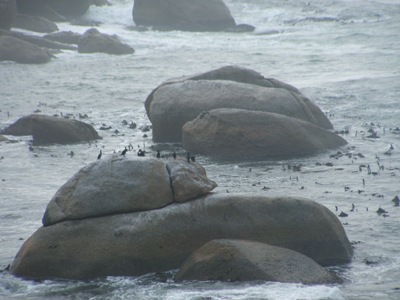 There are at least three kinds of Cormorant that live along this coast but these were too far away to see which they were. Mary is off with the others to see 'Grease' tonight. Perhaps Simon and I will go out for supper along the seafront. 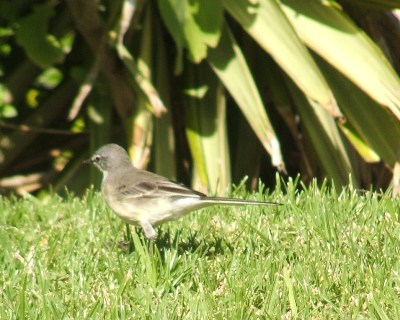 Cape Wagtail  Last night, just before going out to eat we went down to the sea for a swim. The light was lovely but the water was freezing. Some swam, some drank bubbly and watched...I did both. 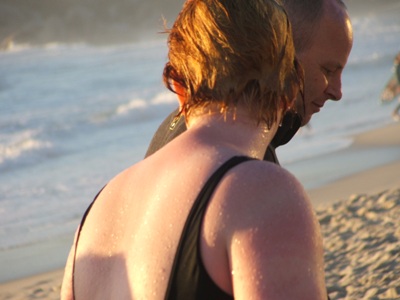 This morning Mary and I had intended to go up Table Mountain in the cable car but the weather was wet and windy...no cable car running...so we headed into the waterfront in Cape Town to take the ferry to Robben Island...all ferries cancelled due to bad weather! Ahh well...we shopped. I bought a silver thing to join the collection on my necklace. We got talking to the lady who sold it to me, Maya. She'd been born in Poland during the war. All her family died in Auschwitz but she had been given to the nuns in a convent and brought up a Christian. She had no idea she was Jewish until she was 15yrs old and Israel had been looking for and collecting up Jewish children in her situation to take them to live in Israel. She said the nuns said 'Oh yes..we have two of those' and they were handed over. There was more to her story, she'd lived in Israel very close to the Kibbutz where I had spent a year. She'd married an Israeli who was posted in South Africa, she divorced him and has never been back but her two sons are doing very well in Australia and UK. She said 'When Nelson Mandela dies the whites will flee South Africa -the blacks hate them'.  |
Thu, 08 Apr 2010 Today is hotter, sunny. The others have walked up Table Mountain. I stayed behind so that Mary could work on an essay. Our plan was to take the cable car up later, but when we got to the cable car base it was so crowded, about a two hour queue, so we left and have plans to go up early one morning...or maybe later today as its only a five minute drive to the base. So, we've been relaxing by the pool and sunbathing a bit, although earlier I went out and found a wooded valley. I sat and drew for a couple of hours. Great plants, exotic black butterflies. Yesterday was a cool and misty day. The others went shopping so I took the little car and went back south down the coast again. I came slowly home, stopping and taking time to look, and painting at one spot looking north towards the Cape Town bay, and at another wooded place where I saw pied crows and another sort of crow, possibly what they call 'black' crows, they're not carrion crows like we have. 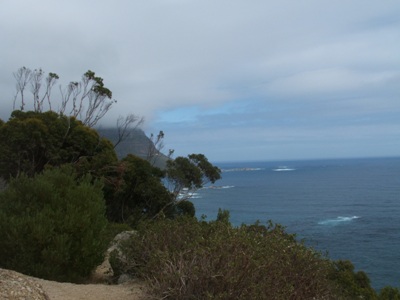 When I got back I sat on the beach at Camp's Bay and watched this family. I got talking to a young lad trying to sell me wooden carvings. He is from Malawi...no work there...everyone wants to be here in South Africa. There's a huge migrant population, about 6 million in and around Cape Town, in shanty towns, many contributing to the local economy but entirely off record so no one knows quite how much they account for. 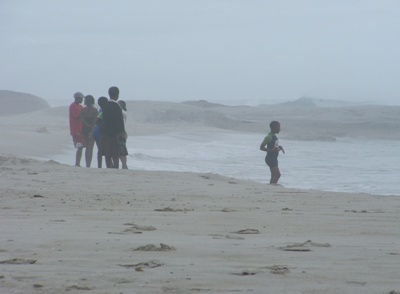 This little gull kept tip-toe-ing up to me so I caught him on camera!  In the evening we saw Tom Jones at the Grand Arena in Cape Town...it was BRILL!!!  but not a great pic...via my phone, doesn't do him justice!!!! |
Wed, 07 Apr 2010 Finally..Camp\'s Bay 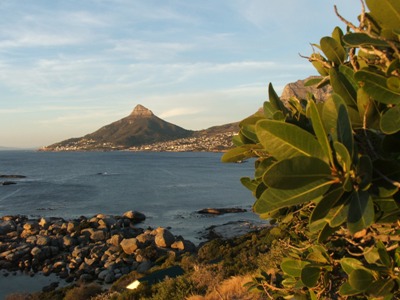  This little bird, I now know, is a Cape Bunting. 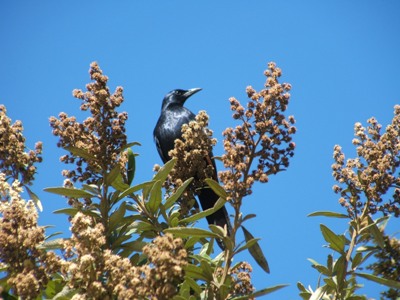 and this a red winged starling  Slangkop lighthouse  Cape coast looking north Some of the pictured didn't load succesfully so I'm loading them separately now. 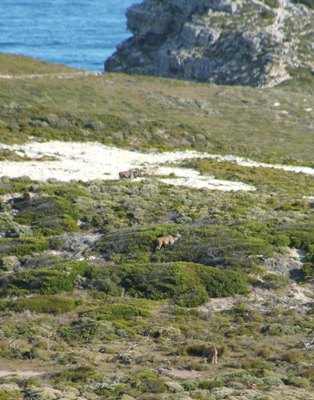 If you look into this photo you'll find three Eland; at the Cape of Good Hope 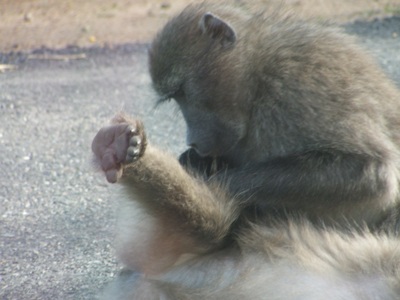 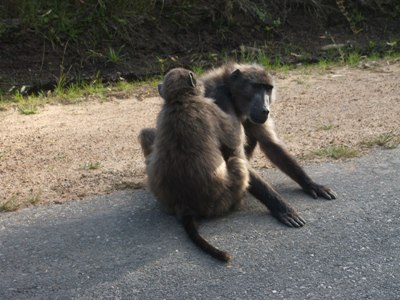 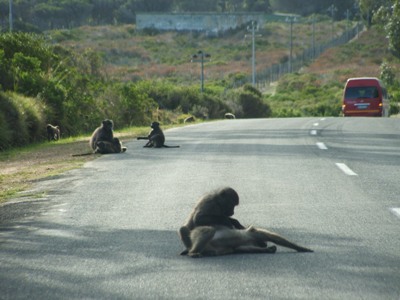 Baboons grooming on the road. Yesterday, a trip to The Cape of Good Hope...was a wonderful drive along coast roads and through older established towns. We stopped in Simon's Town which has a distinct colonial feel with verandah-ed buildings and a small town square. It had been a naval base and so has plenty of boats in its harbour, but running right into the middle of the town is small railway with trains coming out from Cape Town. in the square there's a statue of a great dane called Just Nuisance who was made an able seaman on his death as he had spent so many years escorting the sailors on the train to Cape Town to visit the bars and then rounding them up at the end of the evening and bringing them safely back. 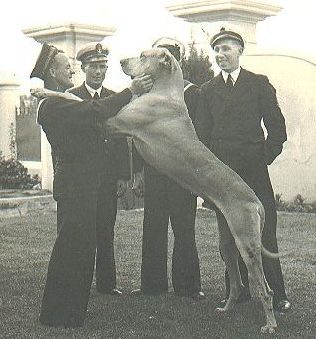 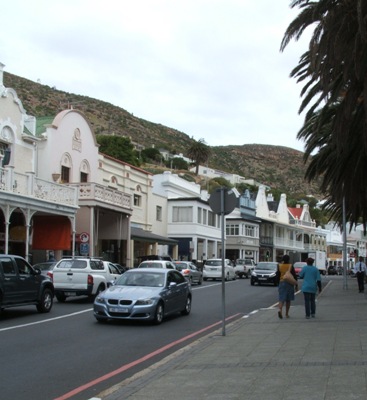 At Simon's Town we also saw Cape Penguins. Its hard not to anthopromorphize them, they are so funny! Mary got very close...  We were heading down the Cape Peninsula to Cape of Good Hope, but I was surprised to discover that the most southerly point is not Cape of Good Hope but Cape Agulhas to the East of Good Hope...so, behind the penguins you can see another point out to sea, and Cape Agulhas is beyond this point. 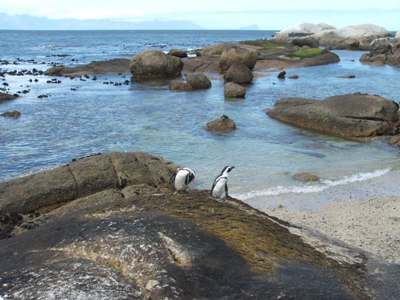 Cape Point, Cape of Good Hope, is much like Scotland, scrub, heather, rocky, and even like the Isles...no trees (well, few trees), a sort of scoured landscape...lovely! and some cottages exactly like crofter's cottages. I'm sure the first settlers must have come from Scotland! This is looking towards Cape Agulhas and the Antarctic. It was hot, sunny and busy at Cape Point so nice to get on the road again. Fairly soon we saw Eland (in pic), a White Necked Raven (Mary saw another one later which I missed) but funniest by far were the baboons, strewn lazily across the road grooming. We had to slalom slowly through them so as not to hit them...they were like a complete family group with Big Dad, mothers, babies, teenagers etc. The Red Winged Starlings are very tame on Cape Point, and so are the Sparrows. I'm not sure yet what this little striped headed Sparrow is...need to research a bit, the other is a Red Winged Starling. The coast on the way home was wild and stunning. I wish I could spend at least a week at every bay, village and town, especially a town called Scarborough. Finally returing to Camp's Bay in the evening and supper at a Thai restaurant in Cape Town. The day before yesterday was a gathering of Alan's family at a hotel in the winelands called Devon Valley to celebrate Alan's birthday. We drove through mediterranean flavoured landscapes with cypress trees and stretches of vinyard. The skies here are are deep clear blue with a slight sharp egde to them, maybe autumn coming on. The vinyards are just turning yellow and copper, again maybe autumn. 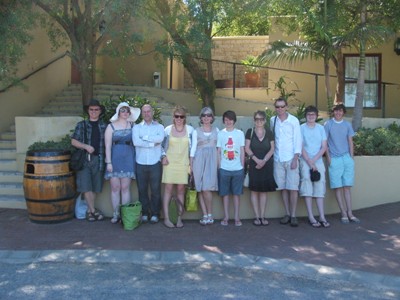 Alan's sisters have given Alan an in-tandem freefall parachute jump for his birthday present...we'll all be going to see him do it next Saturday!  After lunch at the hotel we went to Alan's parents' house for a cuppa...and to see the watercolour I had done of their dog Tess which they've framed. They live in a retirement village with health centres, an arts centre, club centres, golf courses and an incredibly social community. Derek meets up to paint in a group at least once a week -not a class- he seems to have learned an awful lot from his group, his watercolours are really good. 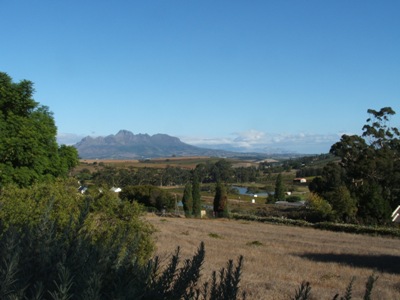 The radio is talking endlessly about Eugene Terre Blanche, the white supremacist who was murdered three days ago, and the song with the line 'Kill The Boer' being encouraged by Julius Molema, head of South Africa's youth movement. Their question is...are the two linked? I'm not sure if the incident is polarising people or revealing the polarisation more clearly. Mary bought a new hat!  |
Tue, 06 Apr 2010 Its been a long and wonderful day and I'm feeling very guilty that I haven't blogged fully...so...here's a picture of some baboons we saw grooming on the road and... I'll have some more time tomorrow in which to update.  We're off today to the Cape of Good Hope after an English breakfast in Camp's Bay...  looking out over the sea. |
Mon, 05 Apr 2010 At 7.30pm we were home, whacked out after a lovely day and I thought...'I'll blog early and go to bed early...I lent my laptop to Simon who handed it on to Mary and now at 10.30pm I have very little battery left...of course I'm not moaning but tomorrow I shall do all the blogging I want to do before I hand over! Meanwhile...here's a picture of Mary communing with the Hyrax that come running up the rocks (loads of them) from the bay at the other end of Camps Bay 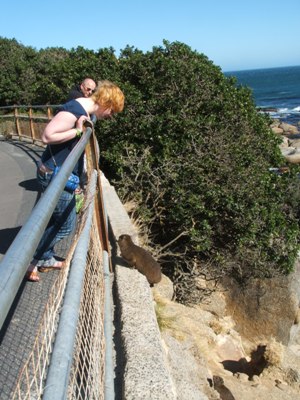 and here's the odd little thing close up, apparently they are closest skeletally to an Elephant...not sure about that! Will look it up and blog further about today tomorrow!...was another wonderful day... 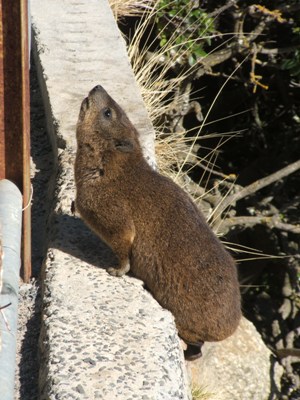  More from yesterday...Weaverbird... 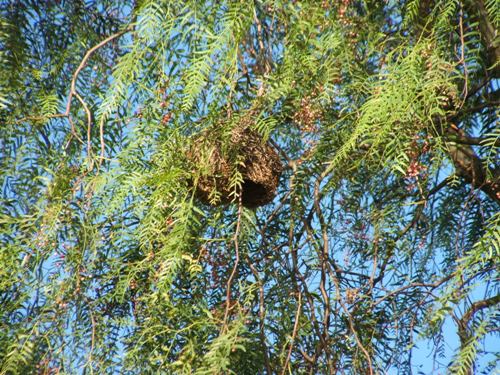 and two Weaverbird's nests in the tree... 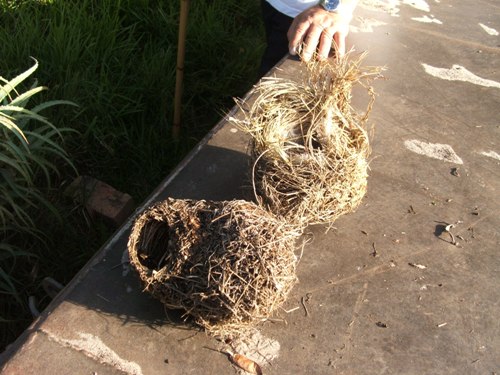 ...and two more which had fallen out, all lined with feathers. 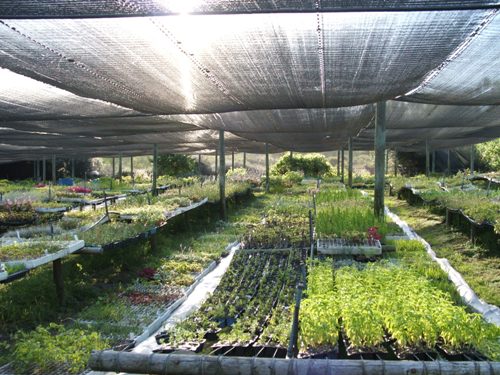 Here is where the seeds are propogated... 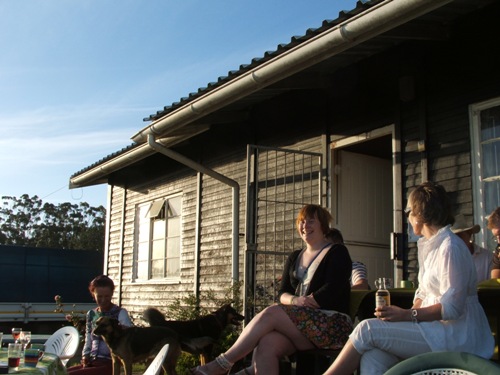 ...and Heather, Mary and Victoria outside the house. |
Sun, 04 Apr 2010 Today we went to Alan's sister's farm, about an hour away the other side of Cape Town. We drove through vast open flat land, grass and scrub, which being the end of summer was dry and crisp. We saw cattle that looked like beef cattle, townships made of corrugated iron, roads being improved for World Cup football, volcano-shaped hills which rose out of the flat land to a point and then swept back down to the flat land. We saw Table Mountain, at a distance, as the table shape which gave it its name. We saw eucalyptus lined roads which reminded me of Israel, and place-signs to 'Bantry Bay' and 'Malmesbury' on the same board as 'Stellenbosch'. 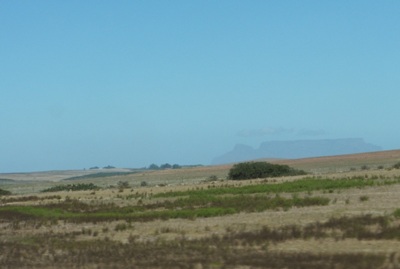 The gathering at Alan's sister's farm was a big family Easter party with sisters and brothers-in-law, nephews, parents, grandparents and all of us from UK. The farm is a nursery garden farm, supplying organically grown flowers and plants for large town displays/hotels and garden centres. We walked right through and saw amazing flowers even though the season is late, we saw the worm farm which produces a rich fertilizing compost and water and we were shown all the different ways and from where the seeds are collected and propogated. 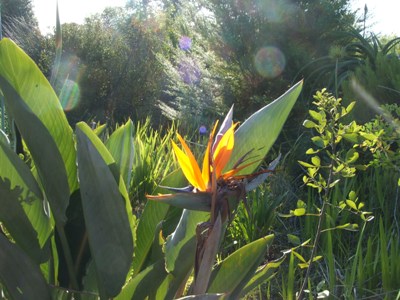 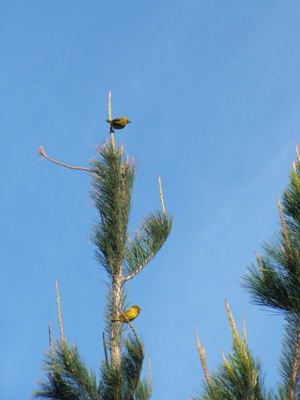 We saw more birds, several of which I photographed but haven't yet identified. The house is lovely, built by Charlie, Alan's brother in law, a wooden house built around its chimney-breast. We had a great lunch and then a boiled-egg-rolling competition, here are Mary and her cousin Lucy in full swing... 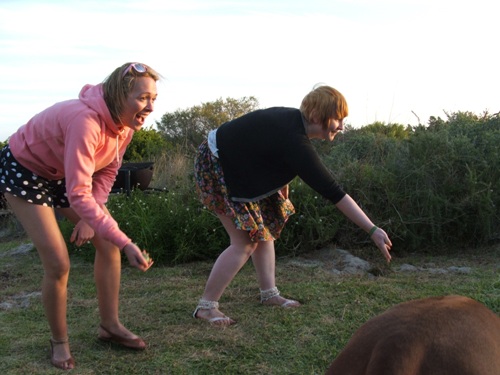 ...I love that place! I hope I'll go again one day. Another of Alan's sisters lives and works there too, in her own wooden house which is like being in a jewel...something amazing in every corner...loved it!! |
Sat, 03 Apr 2010 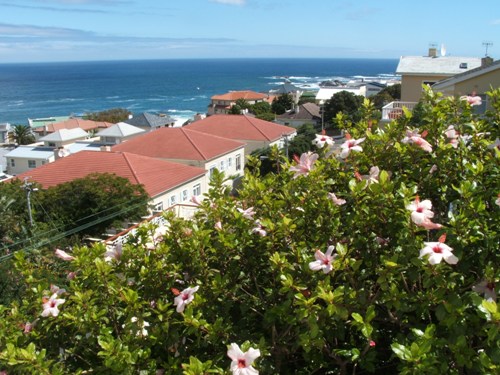 and we bumped into Tom Jones...he was lucky enough to have his photograph taken with my sister in law Victoria. This is the morning view of Camps Bay...and the evening view...  We've been on the waterfront today, booking tickets for the Robben Island ferry. Saw a great group of orange-overall and welly-wearing singers and dancers performing...and Chris Yates if you're reading this I've bought you the CD but I'm going to burn it first!! They reminded Mary of a peformance some year 13s at her school had produced about Guantanamo Bay last year. There's plenty about South Africa that seems very western, but this group have the feel of modern indigenous Africa...and I really liked it. |
Fri, 02 Apr 2010 Saw the southern cross and learned how to work out due south with the southern cross and two stars beneath it. Saw also Orion..upside down. Put my head upside down and there it was the right way up! Right...bed finally...for the first time in 36 hours. The first birds we saw when we arrived were Indian House Crows, lots of them, at a garage near the airport. I'm now reading on-line that they are a pest and that the Cape Town council has funding to eradicate them...I think it sounds like they have a vendetta against them, noses put out of joint by their success perhaps...and listen to this extraordinary claim...'Furthermore, their droppings at roosts and feeding areas have been known to strip paint off walls and deface statues' Shock! Horror!...sounds like London and its pigeons. To me the Indian House Crows looked rather spelndid, elegant and thick-beaked; attractive.  Its the end of Friday, we flew all night and arrived here this morning at 8.30am in thick fog...as you can see the fog has lifted and the view of Table Mountain is clear from Alan and Victoria's house, including the cable car wire at the top.  It so hot I've forgotten what its like to be cold! Red winged Starlings fly over the pool, with red wings, like Tristram's Grackle (Starling) in Wadi Rum but a different squawk. We wandered down to the beach and ate on the main street, here's Alan, and Mary with my sunglasses on. Her own sunglasses were the only casualty of the journey...cracked lens. Did I really say it was hard to leave our garden in Dorset?? It was then, but now its all amazing!!!   We've hired a little white car to cart us further afield...but just now everyone is on the balcony watching the sun go down. |
Thu, 01 Apr 2010  and these have opened since the last blog!   This is the day we're leaving behind. Moving between two such different and distant places gives an extraordinary feeling of dislocation. At the moment I can't see why I would leave the garden coming into bloom and the duck on her eight eggs tucked behind a bush. She endured the hailstorm last night (hailstones still on the ground this morning) and is now enjoying the sunshine; she's absolutely stock still and thinks I can't see her. I'm hoping, when the eggs hatch, she can get all eight ducklings to the pond which is about 500mtrs away and across a small road.  The way I feel about this place is that there are corners of the world which work. I saw the first bee out and about a couple of days ago, a big mother pig is digging in the field beside our house and her eight enthusiastic piglets are learning to do the same. The chickens, which came all scraggy and featherless from a local egg-farm earlier this year, are now plump and feathered. It's really hard to leave. |
Tue, 30 Mar 2010 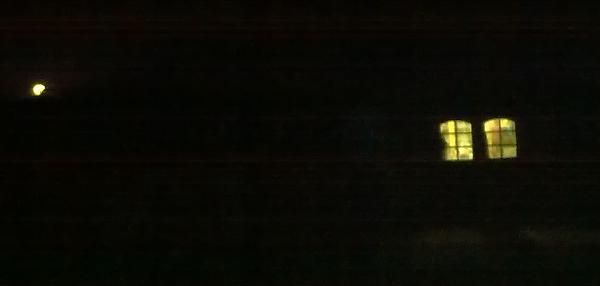 An amazing full moon appeared on the horizon tonight as I was heading down to my shed. I caught it on my phone camera, hence the quality. I've been trying to pack the essentials for travel, some watercolours, three brushes, arches rough block of paper, glitter spray, pencil case with blacks, whites and carbons, the multi-colour pencils from Royal Academy children's section, pencil sharpener and eraser, small watercolour moleskine and middle size plain moleskine and fine black pens...plenty of them. |
Sun, 28 Mar 2010 Long conversation with my brother today, he's feeling so much better, putting on wieght and eating (quote) 'lovely food'. Four more weeks of antibiotics to go -hopefully it'll do the trick- Follow the 'comments' section of the previous paragaph to discover that my numbers were a little out!..and what the right ones are. (Although I think I was remarkably close, closer than I might have had confidence in being!) On broadcasting house thismorning they were asking us to look at numbers in terms of seconds in order to understand them, i.e. a million pounds become approx 30 years, a billion become 3000 years and a trillion became 30,000 years. Some of my students have trouble understanding tone, so I have often talked of it in similar way, in other words try to describe tonal difference in terms of distance. If a dark tone and a light tone sit side by side they have a greater 'distance' between them than if two similar tones sit side by side. I ask them to try and understand the 'distance'; eventually it becomes an intuitive perception. |
Sat, 27 Mar 2010 At last some lovely weather and flowers in the garden. I planted bulbs all over the place last autumn and it feels like I've waited so long to find out what they are. So far we have primroses, oxslip, lungwort, crocuses, daffodils, last of the snowdrops, blue bell thingys and the beginnings of tulips and hyacinths...and black hellbore. There's a duck in the garden, tucked behind a bush, sitting on eight eggs. I'm not sure if I should do something (like put up a paddling pool) once they've hatched. Today I pegged a line full of washing and it dried fully outside for the first time this year...no having to air it indoors anywhere. My students' exhibition is finished now, there was one sale and plenty of great feedback. My Dad is staying and he hepled me take down the work. I found this photo of him recently...aged 17 in Oxford Street 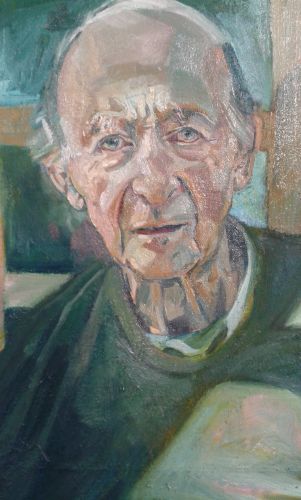 (he's nearly 80 now). I can't believe the weather forecast has just told me that alhtough tomorrow will be warm and fine, by Monday it'll be cold and wet again. Barring BA strikes etc., I'm thinking Easter in South Africa is going to be very welcome indeed. I'm really excited about seeing strange birds...pied crows, white necked ravens and mouse-birds. 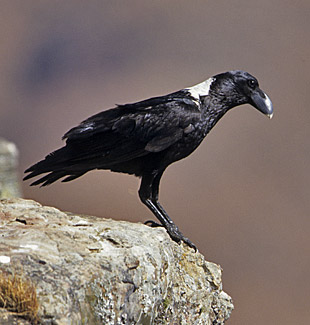 White Necked Raven (corvus albicollis). |
Fri, 26 Mar 2010 Tentative news about my brother, he's at home and gradually feeling better. He is still taking the six-weeks-worth of antibiotics; the telling time will be when they end. Finally...a face to a name...here is my brother before the transplant with his wife Christiane. 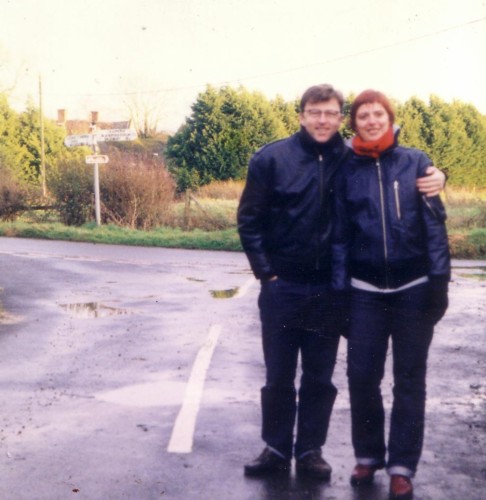 |
Thu, 25 Mar 2010   Two more paintings by William Congdon (of the 'Dying Vulture' painting posted earlier on this blog). These two, 'Cross' and 'Crucifixion', come as close to perfect as I can imagine at the moment.  |
Wed, 24 Mar 2010 Now we're applying a more practical bias to perspective...looking at how objects relate to each other as they go back into the distance, however small that distance is. Sometimes I paint a still-life, but rather than set it up I swing round in my shed and 'see' what I find. Or, I'll set up the foreground and 'find' whatever is in the background. Probably the most important shapes to be looking for when painting a still-life are the in-between spaces...do I repeat myself?? They are the two dimensional manifestations of the relationships between two or more things even if those things have significant distance betwen them. They can't fail to help you get the shapes of the objects right, even when those objects are boxes with perspectives going in all directions. Its why a foreground reference is so important in a landcape painting...something in the foreground against which you can 'read' the whole view; othewise the view is without scale. 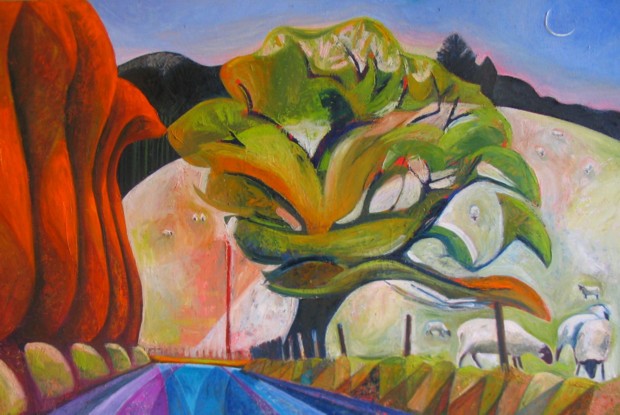 This painting has various ways of describing distance, the road, the fence posts, the diminishing sheep but most of all the way the major elements relate to each other as they sit at different stages through the landscape's distance. |
Mon, 22 Mar 2010 We've been looking at perspective, one point, two point and three point. The trouble is that I've never been taught so I've had to unravel it all myself and although my intuition is fairly robust, occasionally I think 'Well what the hell's going on here?'  This evening, with one of my students, we were trying to understand exactly how Escher had fooled us with this everlasting staircase. It seems that the whole building conforms to three point perspective and that the viewer (and therefore the horizon) is well above the whole building...but that the staircase somehow doesn't conform to the same perspective...but blow me down I can't work out why! Anyone enlighten me? |
Sat, 20 Mar 2010 'God was angry both with Ahab and his people for their idolatry and persecution of his priests, who were put to death in great numbers; and, as a punishment for these sins, He sent Elijah to tell Ahab that for three years and a half neither dew nor rain should fall in the land of Israel. As soon as Elijah had foretold this great evil, God bade him hide himself from the rage of Ahab in a certain place near the brook Cherith, where He had commanded the ravens to feed him. So he went and dwelt by the brook, which afforded him water to drink, while the ravens, as God had said, brought him food morning and evening.' This isn't the first mention of a raven in the bible. The raven is first mentioned by Noah, the first bird named in the bible, when Noah sends a raven (before the dove) to find dry land and it never returns. 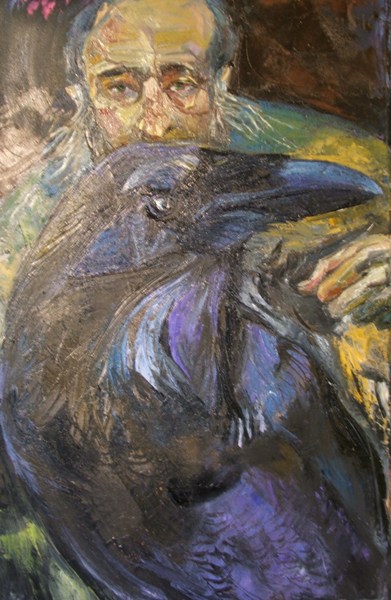 This is a detail from the 'Elijah' painting...in progress. I've given Elijah wispy white payos (hair above the ear) as an old man in hiding might have. 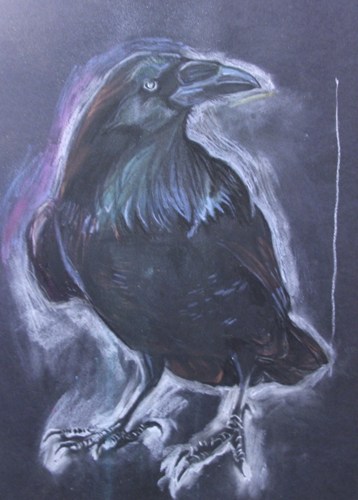 I make drawings from which I work when making a painting; Whenever I'm stuck I refer to the drawing and I stick to the information it gives me. My drawings tell me what I want to know. If I need to know more, I work more on the drawing. They are the place to resolve the problems of shape, context, detail etc. 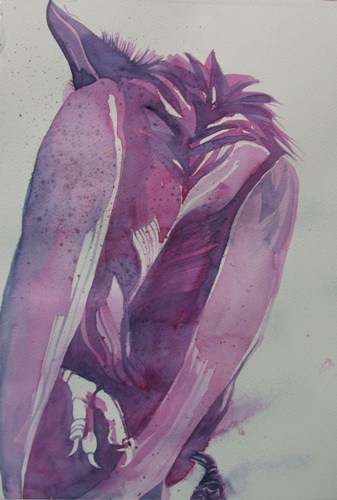 I've had my dead raven out of the freezer again today. I truly love it and am thinking seriously of having it stuffed eventually.  In the Quran, the story of Cain and Abel (Quabil and Habil) is much the same as in the old testament other than the following...'Then God sent down a raven, which dug the earth to show him how to bury the naked corpse of his brother.' -- Sura 5:31 But in a Jewish work called 'Pirke Rabbi Eliezer' (written possibly 8th century) we find this story: Adam and his companion sat weeping and mourning for him (Abel) and did not know what to do with him as burial was unknown to them. Then came a raven, whose companion was dead, took its body, scratched in the earth, and hid it before their eyes; then said Adam, "I shall do as this raven has done", and at once he took Abel's corpse, dug in the earth and hid it. |
Thu, 18 Mar 2010 I\'ve begun to look at the raven in myth. A raven is the first bird mentioned in the Bible, Noah sends one out to find dry land and it never returns so Noah sends a non-carrion eating bird, the dove. In the epic of Gilgamesh there was a flood, a boat and birds...but the first bird sent out was a dove, the scecond was a swallow, they didn\'t return but the third was a raven and he returned to the boat. I have just begun work on a raven painting called Elijah. When Elijah spent time in the desert he was fed by ravens. 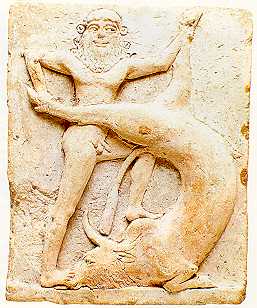 from 'Gilgamesh', Enkidu rips a thigh off the bull of Heaven to throw at the goddess Ishtar. |
Tue, 16 Mar 2010 I've been remiss about blogging lately...I blame the new series of 'The Shield' which Simon has on DVD...I'm totally gripped, it leaves me on a cliff-hanger at the end of every episode -unsurprisingly! I even forewent a slideshow of a family trip from years ago...I must be mad!! or hooked. Anyway, I had a long conversation with my brother today; yet another scan last Friday, the results of which, disscused yesterday, are better news than expected. The surgeon had worried that some ducts from the new pancreas to the gut were blocked. These ducts feed enzyme into the gut to help break down the food (my brother had been taking pills for that reason before the transplant). If the ducts had been blocked the pancreas would have had to come out, but it seems no blockage. There has been a compromised blood supply to the new pancreas, but whatever that event was, apparently its over. The scan also showed that his most recent antibiotics have significantly shrunk the bag of pus which has been causing so much trouble in his gut. He's going to stay on these antibiotics for at least six weeks...and best of all, his surgeon said 'When do you want to go home? Today or tomorrow?'. He also said...if anything happens when the antibiotics are finished...by pass the Royal Free and come straight to Oxford. I promise I won't watch any more (not much more anyway) of The Shield...once this DVD is finished. 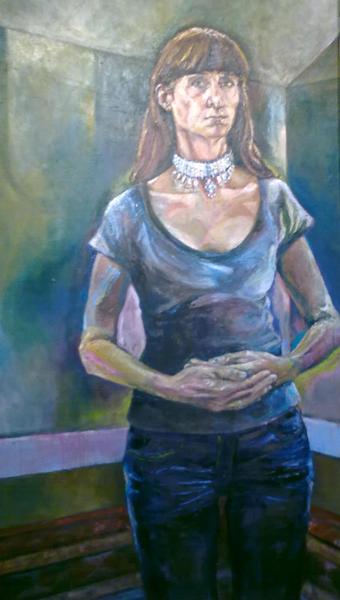 Here is a rather stern painting of me wearing a necklace given to me by my mother. It's an extraordinarily lovely Butler and Wilson necklace but I have so few times and places to wear it...roll out a red carpet please! |
Sun, 14 Mar 2010 I put the second half of my students' exhibition up in the cafe last night...it looks fantastic. I had so many paintings handed in, towards the end of hanging I had to edit out some by those who'd had paintings in the first two weeks. Hopefully I can book the cafe again next year. 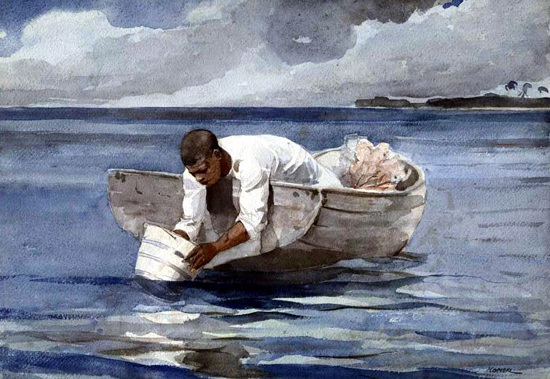 This man was a master with light and dark, Winslow Homer's watercolour 'The Water Fan'. Note that the first layers of paint were the palest, they 'revealed' the lightest places only, subsequent layers were darker (increasingly), covered a smaller surface area, were placed on top of previous layers (in other words they didn't interrupt with previously 'revealed' lighter places) and the more layers the darker the tone. The shapes describing the swell of the water are much more simple and clearly seen than one might anitcipate, and the planning and finding of the lightest places right at the beginning are sublime, so that the finished piece appears effortless and completely convincing, and gives nothing away of how challenging the whole piece must have been to create! I'm off to Oxford to see my brother..yep! He's finally at The Churchill in Oxford! |
Thu, 11 Mar 2010 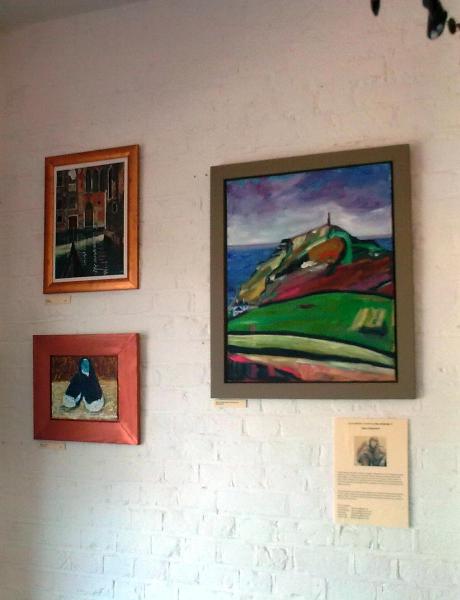  A selection of pictures (taken with my phone camera)from the exhibition of my students' work. 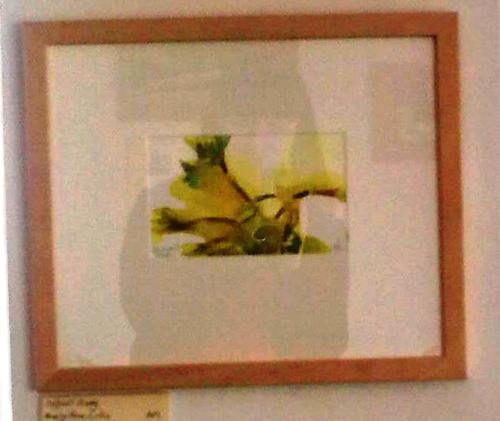 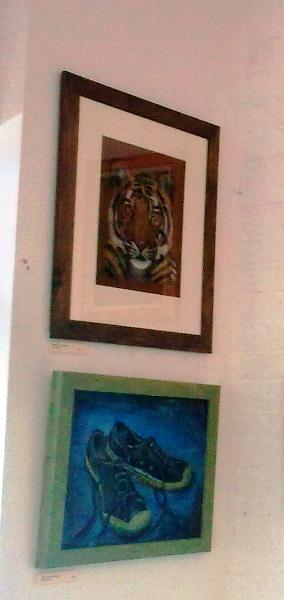 Note the reflection in the small daffodil watercolour... |
Wed, 10 Mar 2010 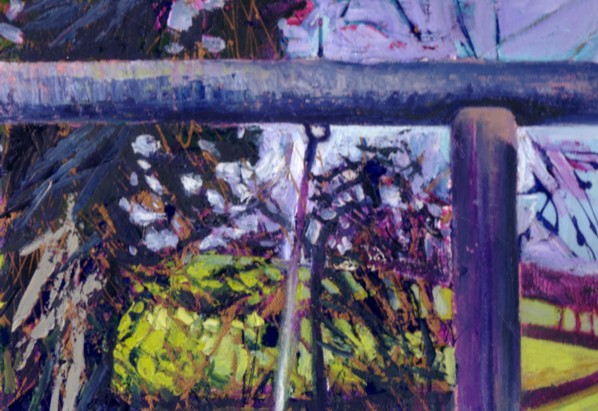 In praise of in-between spaces... The in between space IS the relationship between two or more objects or elements chosen for your composition. It is FAR more useful to you as an artist to start by looking for in-between spaces and building the composition around them. By looking for a shape which relates to two or more things and on which you can ‘hang’ the related elements you are more likely to see the elements of your subject correctly. This is because by looking at the in-between spaces you are making comparisons between the main elements. By making comparisons, you are asking questions about what you are looking at; you begin to understand how one thing appears as compared to another. An in-between space tells you about two or more things simultaneously, whereas seeing one element in isolation makes it much harder to understand what it actually looks like. Look at the working sketch by Carole Katchen. Visualise the shape between the man’s vest and the woman’s elbow. This shape has as much right to exist as the man’s hat or the woman’s hair. We know in reality it describes a gap, but in two dimensions it exists as a flat shape just as the man’s trousers do. Look at the underside of the woman’s skirt, the darker red shapes. What lovely shapes and how well they define where her legs are! It’s all too easy to ignore these shapes and expect the elements of your subject to sit successfully together on your painting; they won’t without an understanding of the spaces between them. I would also say, look at how certain elements relate to the edges of your page...otherwise you’ll find your subject ‘floating’ aimlessly somewhere in the middle of your page. See, on the left hand side of the drawing, how an in-between shape exists between the man’s hand, the woman’s hair, arm and skirt, and the edge of the page...there it is, showing you exactly where and how to compose the drawing within the edges of your page. On a slightly different kind of in-between space...I watched with pleasure today as one of my students ‘found’ a tree by creating it’s whole shape across the left hand side of her page and then proceeded to ‘reveal’ it by painting the shapes between the branches and twigs. The crop-section here is from one of my own paintings, where the tree and the child’s pole swing were ‘revealed’ by painting the in-between spaces. It makes for an exciting life!!!  |
Mon, 08 Mar 2010 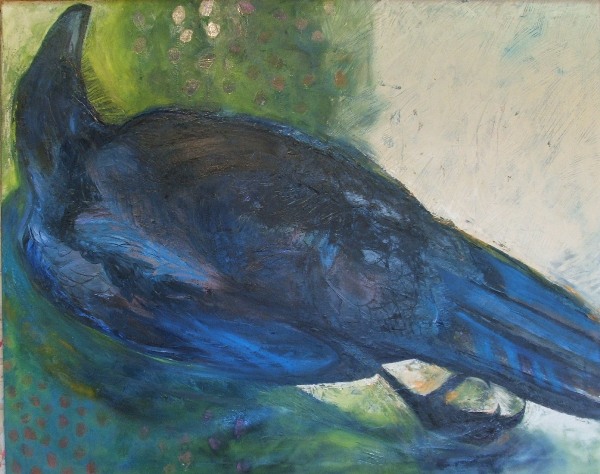 I've been working on this raven today, and made another nice frame for another painting. I like my frames exactly the way I make them...the colour and contruction...I'm teaching tonight. |
Sun, 07 Mar 2010 It was wonderful to see my brother. He is thin and tired but he perked up with a good political converstion and we had a good laugh over memories of a friend of his, Bugs, who is big in the Tattoo world and has now become a painter too, some of his paintings are rather wonderful (I found him on-line) 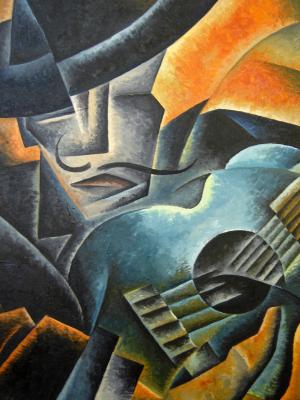 This one is called 'Guitariste'. My brother has a large abcess in his gut which is difficult to reach but needs to be removed with an operation requiring a general anasthetic. He's in a catch 22 trap; he can't live with the abcess, it's what keeps re-infecting him, but he's not strong enough for an anasthetic to have it removed. When it's removed (its been described as trying to scoop up lump of mashed potato) many of the various bugs contained within it are likely to be released and bring about a massive new attack on his body...so things must get worse before they get better. He'll probably go to Oxford this week although the Royal Free want to hold on to him for a bit to 'build him up'. On a very happy note, his daughter and her husband (the soldier who lost his legs in Sangin) are expecting their first baby!!! Yippeeee...I'll be a great aunt!!! and my little brother will be a grandad!!!hhahahahaaray...there is a God in Heaven!! |
Sat, 06 Mar 2010 Here is the William Congdon painting \'Dying Vulture\'...isn\'t it brilliant?? I love it. 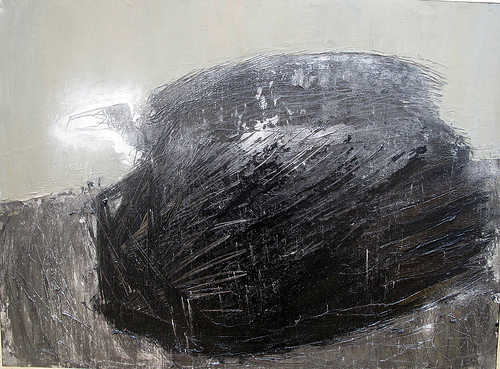 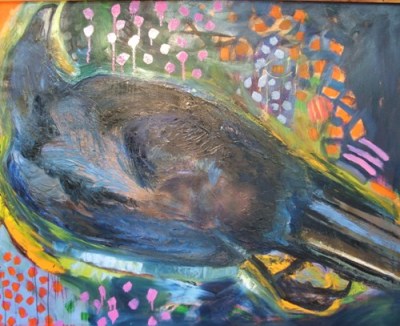 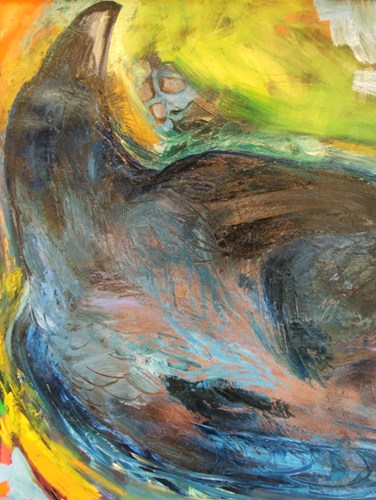 IN my shed I'm working on my Raven, I saw a painting about two years ago called 'Dying Vulture' by William Congdon (1957). I've only seen it once (it's at Kettles Yard, Cambridge) but it must have lined right up with one of my inner blueprints because I think of it all the time. There's no doubt it has influenced me because when I saw it I was working on another large Raven painting and seeing it resolved the way I was going to continue with my painting. Now I'm working on my 'Dying Raven'. I'm still thinking about William Congdon's painting but obviously on my own path now. I'm using a lot of colour with a view to knocking it back later on without losing it altogether. I've bought some liquin which I believe allows me to increase the transparency of oil paint and will try some transparent layers over the painting...glaze and scumble. The old masters used 'glaze and scumble' several times on one painting. With a transparent colour (Indian yellow)they would cover the whole surface of a painting then wipe the paint off certain areas such as the face. By picking up the bright face area with light paint (Naples yellow, white etc.) the background became darker and the face became brighter and glowing. It adds an extraordinary cohesion to the whole image too. I do this with my own paintings of faces but also with landscapes and other subjects. I'm hoping I can vary the colour of my transparent layers (normally I use only Indian yellow or Alizarin crimson for their high transparency) with my liquin. Howard Hodgkin uses wondeful colours and textures, many of which are not quite obscured, under subsequent calming semi-transparent layers. I've also been working on a self portrait version of my Jane Seymour. I'm off to London any minute now to see my brother. 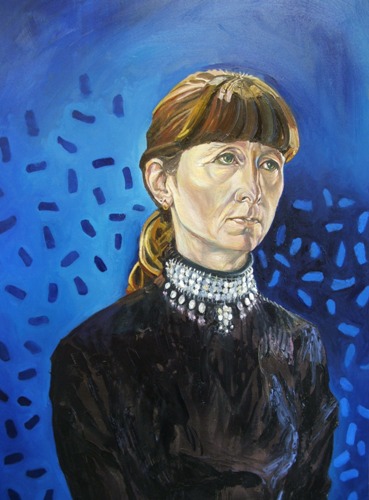 |
Thu, 04 Mar 2010 3rd:Re-reading what I've said about Lord Ashcroft; I need to say that we give by direct debit to four charities every month and have done for more than 20years. We do more for other charities too including being trustees of a gorilla charity and raising money in various ways for it. www.G4G.co.uk Even so it never feels like enough, and I don't have a concept of -if every very wealthy person gave the same proportion we give, of their income, how far would it go to meeting the needs of the poorest parts of the world? Is the pit so bottomless that its not worth doing? On another note, my brother took a dive yesterday, I wonder if he's reached the bottom of his particilar pit yet...I wish...then it might be upwards from here. I'm going on Saturday to see him, still at the Royal Free in London. 2nd: http://news.bbc.co.uk/1/hi/world/africa/8537696.stm A link to Esther. 1st: Just looking at the pictures of Michael Foot (I think his dad was called Isaac Foot, what a wonderful name), I so completely approve of his duffle coat which he wore to lay a wreath at The Cenotaph in 1981; I approve now and I approved then. We’re plagued with the need to dress smartly. In our time of spin and shiny smiles, there’s something refreshing, real and appealing about Michael Foot’s duffle coat, as there was then in 1981. So many people have spoken lyrically about Michael Foot, not least Enoch Powell who said of him ‘He was the outstanding parliamentarian of our time’ and much more. I would so much have preferred Michael Foot to lead government rather than Tony Blair in whom it was hard to have trust -right from the beginning, with his evangelical zeal and his repellent look of ecstasy. My husband stayed up all night during that count. He was sure that if Blair were to win the election we would be heralding in the new age...I suppose we were doing so, of sorts, the age of see-only-what’s-on-the-surface-and-no-further, or the-means-justify-the-end-but-we-don’t-need-to-know...just-have-faith-in-our-glorious-leader. I was more cynical. I went to bed. Now with the Lord Ashcroft situation –how measly of him- we have to understand that smart suits are de rigueur, and the face of things is what we get until secrets are revealed by the media. Lord Ashcroft so coveted a title that he was happy to mislead even his close friend William Hague (how mortifying for Hague and what treachery from Ashcroft)...in other words we didn’t get quite what we were lead to believe we were getting, those supposed 10s of millions of £s in the tax coffers. Proportionally of course my dustbin man is probably paying more tax pro-rata, not wearing a smart suit (a green council overall instead) and I would much much much much much prefer to see him sitting in the house of Lords asking questions and voting on decisions than I would Lord Ashcroft. I wish that some of Lord Ashcroft’s 10s of millions of £s could trickle down to the tragic little girl Esther I saw last night on ‘Zimbabwe’s Forgotten Children’. Aged about 8yrs and suffering from HIV aids, she was saying ‘I’m so hungry; my body hurts in every place’. Maybe it would help if we knew more rather than less about Lord Ashcroft now, hopefully that quite a lot of his 10s of millions of £s are reaching small girls like Esther, who is so desperately aware of the sadness of her life. |
Tue, 02 Mar 2010 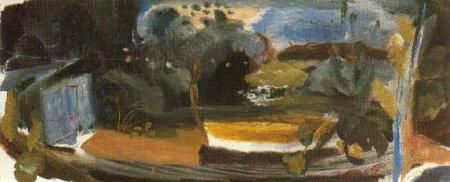 This one is 'Garden Cove' the last one 'Twisting Stream'. As english as cow parsley and village church yards. 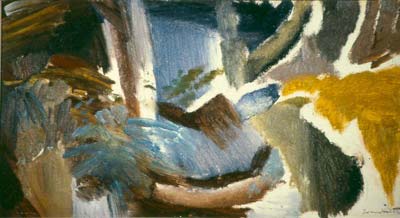 We've been looking at landscape painters in class, I took in a scruffy but favourite little book about Ivon Hitchens. After years of looking after my own small children and feeling I never had anywhere near enough time to begin, let alone immerse myself in, painting, I remember finding this book on what must have been the first day of school for my youngest child. And so the re-awakening of my freer mind began; it was pouring with rain and I was looking at the view through the back window of my old shed. I worked on the same format using very similar colours to this painting, it wasn't a big painting, but the one which was the beginning of everything since...Although I never stopped painting when the children were small, and in fact often painted them, I was afraid of looking out at the world in case I suffered the frustration of not being able to respond to it. There's a particularly stunning view near here, above Tollard Royal, for years I wouldn't look out of the car window at it, it was too unbearably frustrating. Ivon Hitchens' paintings make me want to paint, look at paintings, talk about them, show them to people, they make me wish I had done them! |
Sun, 28 Feb 2010 I heard my daughter wishing her boyfriend 'good luck' for tomorrow, he has his driving test. It reminded me of the day after I passed my driving test...I drove up on to Exmoor. The family had one car, an old Morris Oxford, and we all used it; consequently it ran on just above empty. I drove up to Brendon Two Gates with my painting things and sat looking across layers of moor with my canvas on the ground. I had to roll much of the way back down off Exmoor to hold on to the little bit of petrol. My teachers at the art school in Taunton loved the painting. It hung in the family home for several years and then I lost contact with it until recently when a friend told me she had a painting of mine in her attic...It now is stacked away in my shed but was an incidental admission in this painting (see crop) as I had been looking at still-lives and including whatever occured in the composition. 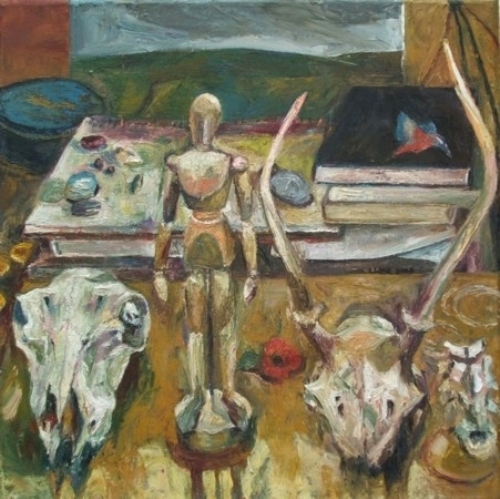 It felt at the time like it had taken me years to realise the desire to do what I had just done -old enough and free enough to take myself up on to the top of Exmoor. Between Simonsbath and Brendon Two Gates is my favourite house, not much to look at but in a landscape which so closely aligns with my inner blueprint of a perfect landscape that I harbour desires to live there one day...Simon says he'd slit his wrists if we lived on Exmoor...  ...even though he loves it there. I spoke to my brother today...its called a Gallium scan...all complex again, I'll collate the information in my head and say something about it tomorrow. Yesterday I put up the exhibition of my students' work in The Forum Cafe. Though I say it myself it looks really great. It entirely overcomes the challenge of being a diverse collection of work and looks cohesive and interesting and really great! |
Fri, 26 Feb 2010 Finally there's a possible reason for my brother's sickness. The Galleon scan and a CT scan have been looked at together and show fluid on his cecum...(thats a new one on me)...it looks like a little appendix at the join of the small and large intestines. He's still at the Royal Free and very weak. The fluid wil be drained and if it turns out to be amylase it means his new pancreas is in trouble and he will have to be opened up and 'all fixings checked' (to and from the new pancreas I guess). If the fluid is something else it may just be an infection which can be treated, but so far John is still not taking anitbiotics and has a temperature. A temperature is one way of fighting infection so maybe he has some immunity of sorts. 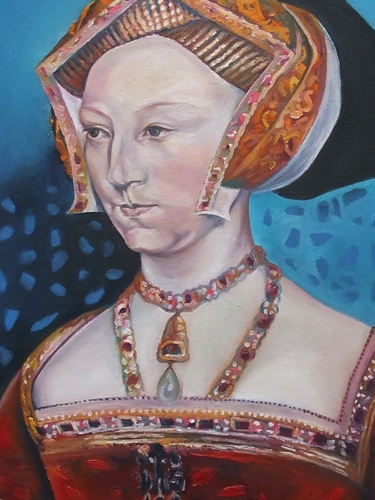 Jane Seymour and happy memories of history lessons with Miss Pike. Jane Seymour in her lovely frame. 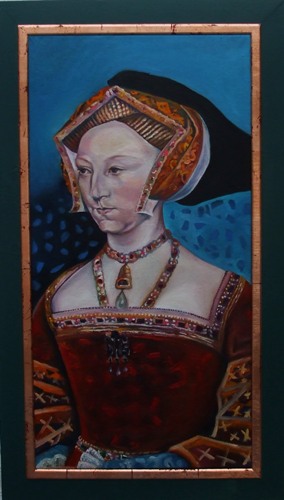 |
Thu, 25 Feb 2010 I'm gathering work by my students for an exhibition at The Forum Cafe in Blandford. I have the cafe for a month so in order to accommodate everyone who is giving me work I shall be dividing the exhibition into two lots of two weeks. My students are an impressive lot and there is some fine work going in to the show. I will photograph the show when its up, meanwhile...here is a watercolour of some apples. No more on my brother just yet. 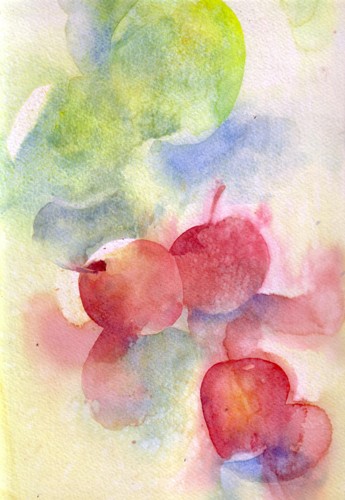 I have made an exquisite (yep...I can hardly believe it) frame for the Jane Seymour painting. I hope I'm not deluding myself! |
Wed, 24 Feb 2010 So Dad has been to see John today at the Royal Free in London and says he seems a little brighter; I can explain the complications now. Since the transplant, every five weeks John has gone into collapse with an infection. He ends up at the A&E of his nearest hospital, Royal Free where they treat him with antibiotics and move him on to Churchill hospital in Oxford where the transplant was performed. After a few days he’s responding to the antibiotics so the Churchill send him home, where he feels better for a while and even manages to combat his almost constant sickness and eat something. Five weeks later and he’s down again. This time he has refused antibiotics at the Royal Free because he wants to go straight to Oxford where that they can assess him before treatment, but Oxford are short of beds and can’t take him until possibly the weekend. Now John is very ill, very weak, having only fluids by drip and the Royal Free feel they need to do a super-duper scan which requires a radioactive injection and then the scan two days later. Being radioactive, it means he can’t have another injection for a few weeks. If he misses the scan day two days later he misses the chance of this particular kind of scan for some weeks to come. He had the injection yesterday and now hopes Oxford won’t come up with a free bed until after tomorrow when he has had the super-duper scan at the Royal Free, but he’s still struggling to hang on without antibiotics, against the advice of his consultant. Dad asked John did he regret having had the transplant and John said absolutely not...a small mercy, and a relief to any relative of an organ donor who might be reading this. |
Tue, 23 Feb 2010 I’m in Oxford, with my younger sister Jane at her baby-clothes warehouse. I’ve just dropped Mary for an interview at Oxford Brookes. Jane and I are about to find Dad, he’s at Jane’s house waiting for news of our brother John. John was at A&E in London yesterday; at some point today he’s arriving by ambulance at the hospital here in Oxford which performed his transplant six months ago. He’s very dehydrated, not compus mentus either I gather. The decision is whether to open him up and look at the pancreas with a view to treating him, or whether to cut losses and take it out. I believe he’ll keep the kidney. It means he’ll be diabetic again and I’m not sure of the implications of that; it seems better than the condition he’s been struggling to live with since the transplant. I remember when we were living in USA, I had such a bad tooth, a molar near the back. I went to the dentist who was all for root canal treatment and what-not...I said absolutely NOT. I can live without it, just PULL it out please. I think it cost me $120 for the pleasure of it! What a relief it was; every time I poke my tongue into the gap I’m glad. I wish we had several pancreases in the same way we have several teeth; a synthesised evolutionary furrow to plough if diabetes becomes the endemic problem forecast? Why else do we have two kidneys, when we can live on 25% function of one of them, if not to mitigate the loss of one? And by the same reasoning several teeth? And two eyes? (although that may be for binocular vision, and in the case of birds, all round vision too.) I suppose stem cell research is dealing with these questions...growing one’s own spares for these eventualities. Update: My brother still in London, in Royal Free, waiting for a bed in Oxford. He's having liquids only and refusing all other treatment at the moment...complicated...too upsetting to explain. |
Sun, 21 Feb 2010 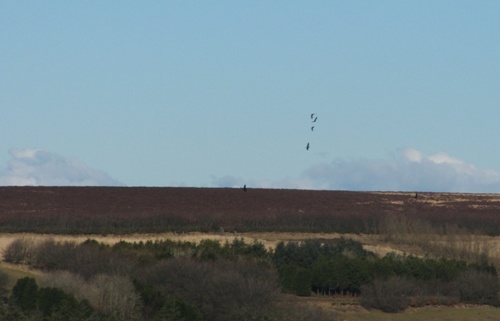 This photo was taken on the first day when I was drawing on top of the black bales. The ravens are on the horizon. 19.2.10 3. I found a round fibre-resin tea tray, selected various good steep slopes, made some ice-runs and had a great time whizzing down them and trudging up to the top again. The nice thing about being on my own is that I didn’t have to share my tea tray, I just skidded down and trudged up until I was soaking wet and whacked!  2. I haven’t found the sledge so I’m going to search out something else which will do. The snow looks wonderful, on the hills it reveals every scar, every sinew and every crevice, but the fields are as smooth as an iced wedding cake. If I’d had an iced wedding cake an Exmoor scene on it would have been nice. As it was we had Wonder Woman and SuperMan cakes at our wedding. I’ve been on a favourite walk around Sparcombe Water; I could feel myself smiling all the way as the sun shone on the snow. I sent a picture message of a white Exe Cleave back to all my students who have hired a hall near Blandford and are spending the week painting without me!  1. Quantum physics: A particle can exist in two places at once? The act of looking makes the particle change its behaviour? Slippery!! Anecdotal: MP? I’m still fussing in my mind over this false-passport/sanctioned-state-murder in which we might have colluded. It’s been snowing hard again and I’ve been told there’s a sledge in a nearby field so I’m off to look for that and a hill with a gentle incline at the bottom...I don’t mind if it’s steep at the top. I shall only exist at the top or at the bottom...or anywhere in between but not all at the same time; maybe going so fast that I shall APPEAR to be in every place at the same time.  18.2.10 Robert Fisk in today’s paper is suggesting that although Israel is behind the Mahmoud al-Mabhouh murder it was done with British collusion and in the past similar things have been done with active US support. The people who committed the murder and were in Dubai at the time of the murder, presumably helping, must be such small-fry-pawns in the greater game it probably doesn’t matter what they feel about what they’ve done, and those whose passports they’ve used rank even lower; abused with no comeback and placed in a very vulnerable position. It’s been snowing hard all day again today so we walked to Exford to the pub to read the papers, have lunch etc. Snow well and truly settled, it’s hard to believe that this end of the week belongs to the same beginning! That warm sun and those clear blue skies with the ravens tumbling about...another time another place! Earlier today I was watching a flock of starlings feeding at the edges of the cabin where the snow is thinner. After prodding the ground with their beaks they were finding big fat worms and swallowing them down whole. One of the starlings has a completely deformed leg, he seems to have no trouble flying or feeding on the ground but I can’t see how he can perch. It struck me that he probably doesn’t know he’s disabled! 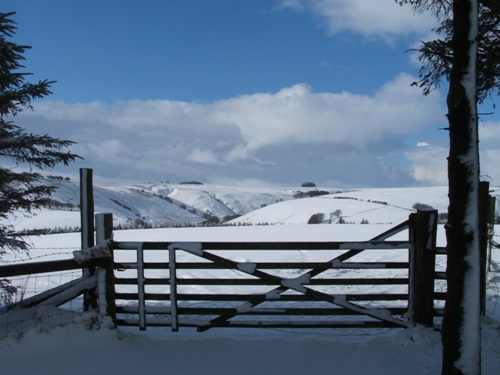 Once again I’ve been working from drawings I’ve made this week...making clear the advantages of drawing while the sun shines. As ever at the start of a painting you wonder what the hell is going to happen with it, and is it worth sticking to? If you can disengage yourself from your feelings about the painting itself, simply continue with carefully found revelations, edges, areas and tones from your subject or the drawing from which you’re working, it sometimes happens that something interesting results. Looking out of the window...it’s unbelievable that we have more snow than we’ve ever had on Exmoor at this half-term time, and in Vancouver they have the least they’ve had in 100 years. ‘Law’ and ‘Murphy’s’ comes to mind. I don’t envy those in charge of this year’s winter Olympics. 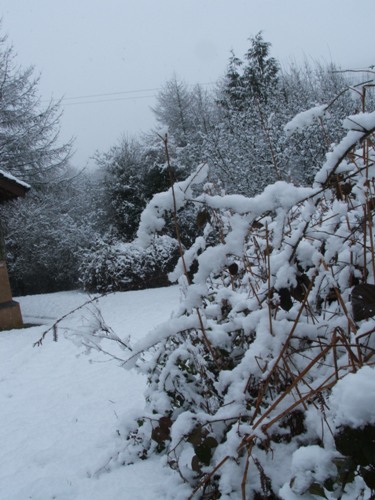 17.2.10: woke up to this outside our window. The cabin is much warmer even though it’s been snowing hard again, sustained fire in the woodburner at least during the day. We went to Exeter to see George...a treat! I got up early, lit the fire and worked on a painting from a drawing I made yesterday above Chetsford Water. I’m shocked, perhaps naive...by the killers on false passports who murdered a Hamas man in Dubai...does every nation do it? How justified is it? Would they have done it/authorised it if they’d known it would be revealed? Are they smug? Worried? Ashamed? Embarrassed? Pleased with themselves? Satisfied? Ready to do more? Well paid? Unaffected? Affected? Just doing their jobs? In full support of what they’ve done? I’d be stomping mad if I were one of the stolen ‘identities’ -and worried for my safety. I spent £23 on three tubes of watercolour paint in Exeter today. 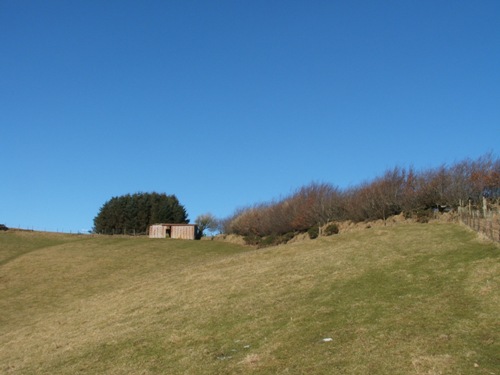 2. Sometimes I paint on location and at other times I’ll paint from drawings made on location. Today I’ve done a bit of both. There’s no doubt that the painting done on location has a much lighter touch, an immediate response to what one is looking at, with the subject available to be gleaned from as the eye jumps from page to view to page again. However the paintings made from drawings are much more likely to deal with composition, structure, shapes and tones...and an overall ‘feel’. They don’t have that same light touch but they have a stronger initial impact and clearer divisions between ‘light’ and ‘dark’. One very important result of filling my drawing books is that I can use them like a bank...I fill them with drawings from which I can extract visual information at any time in the future. I use the drawings and re-use some of them, as often as I like, as a basis for paintings on canvas. They have structures and compositions which have endless possible manifestations. The drawings in my drawing books are not lovely; they are an efficient method of note-taking and when I’m working from them in my shed they evoke very strong memories of what I was looking at when I made them. Here on Exmoor, if I’m not painting on location, I try to make watercolours from my drawings as soon as I get back to the cabin from my walks. These watercolours may be framed and exhibited when I’m back at home but they may prompt paintings on canvas as well.  1. Yesterday I walked with the others, along the coast, over North Hill and down into Minehead which has an extraordinary ‘old town’ with tiny thatched cottages and little streets...its places like that which give us an idea of the scale of the old days, certainly of the days when people walked everywhere unless they were wealthy enough for space and horses. Worlds, I suppose, were measured by walking distances - Lorna Doone is a great book for its descriptions of 17th century life on Exmoor, plenty of walking in deep snow to rescue sheep! There’s quite a lot of ‘new’ Minehead which is not so engaging –a main street filled with £-shops! I missed my stretch of strolling and sketching so I had the others drop me off a way from the cabin and I walked back. Today is the oddest day; we’ve had heavy snow and now streaming sunshine. I’ve been out drawing in the snow and am now going into the glorious sun...everything is glistening. |
Sat, 20 Feb 2010 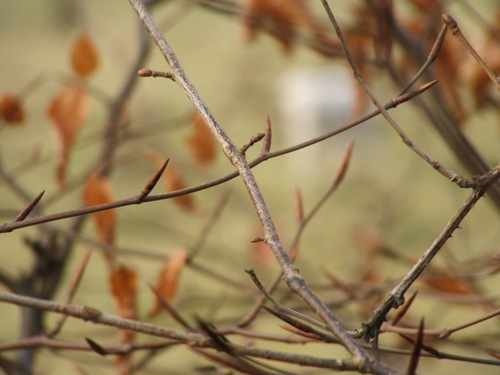 14.2.10: It’s 10pm now and the fire is banked up and popping. The temperature is about 1deg. outside. The day has been lovely. I found a stack of black bales –like a castle- and sank in a dip right on top, between two bales, with my feet up on the bale in front. I had a wide view, the sun was shining and a half dozen ravens hove into view, scrabbling and gobbling...I was amazed! Eventually they flew north but two pairs peeled off and gave wonderful dual aerobatics which then became a display of four...watch and learn Red Arrows...the difference is that ravens can improvise their swings and dives and they seem to delight in doing just that, but the Red Arrows must spend hours choreographing and practising. Right...bedsocks...blankets...zzzzzzzzZZZZZZZZZ It was a cold night but two duvets, several blankets and bed socks sorted that out. Simon was up early and got the fire going and then set off to Exford to get the papers. He dropped me half way so I could walk back with my camera, take photographs and suck in deep breaths of Exmoor air. You have to be careful with a camera not to miss the things you look at. The camera often means you peep through the viewfinder, snap and then never look again. I need to look and keep looking before snapping, and generally I’m looking for a ‘composition’ which the camera viewfinder then helps me with, and helps me to understand better once I’ve downloaded it to the computer. This time I found I was interested in the way the foreground beech banks veil the hills in the background, and exactly how much of the view behind the beech-veil was visible. When I look at the view my eye- focus jumps between the foreground and the background, compensating and re-focussing accordingly, but my camera will only focus on one layer giving me a chance to see how one layer of view relates to another with just a single focus. I suppose it’s called ‘depth of field’ in camera terms, and I could get the whole lot in focus if I wanted. I spent last night playing with my new paper...it was lovely! Last time I was here I was feeling dark and moody. I scrambled in the undergrowth along covered streams and small rivers looking for dark places with moments of light. Perhaps it was three things; it was autumn and the end of summer always feels like a loss, my nephew-in-law had just lost both his legs and some fingers off both hands, in Afghanistan, a couple of days before we came up here. Four months later he seems to be doing really well. He’s been selected to train for two Paralympics’ teams; shooting and tennis I think, and he and my niece are in the process of buying a bungalow. I’m feeling more open and ready for the blooming year this time; the only cloud and the third thing is my brother’s transplant. He had a kidney/pancreas transplant last August; it’s taking a long time to get better. I thought I’d be able to ‘tweet’ about him and the process, I found I couldn’t...all too painful to put into single sentences. Home!! I blogged on a word doc while away and will update bit by bit: 13.2.10. We’ve head to Exmoor today, very cold day, and met friends at The Red Lion in Dulverton...it’s how our Exmoor weeks begin and its where we step out of our lives which belong to other things and into our lives which belong entirely to ourselves. I have 100 sheets of Fabriano paper which I couldn’t stop thinking about all the way here. I remembered to bring my gum strip and already I have a stretched sheet drying on a board. We’re in the cabin, the woodburner’s lit but it’s still pretty cold. Bridget is cooking so not only do I not have to think about what to cook, I don’t have to cook it either. I can’t stop thinking about my new paper, about loading my brush with colour and off-loading onto my paper...I’m not even sure I mind what the image will be at the moment. I simply want the pleasure of negotiating with watercolour on my new paper. Exmoor, even at this drab time of year, has the most wonderful colours and textures as well as the eye-grabbing shapes of the hills and valleys. If a fashion designer were to spend time on Exmoor I can’t see how it could fail to influence the cut of a pattern or the texture and colour of a fabric. The hills are as sumptuous as body curves clad in rich earthy colours, the lines of beech banks clearly describe the hills’ edges... edges again...beech seems to hold on to its autumn leaves well into spring so they haven’t lost the orange glow. Now I just wish I had Mary’s ‘onesy’ with me, her all-in-one fleecy sleep suit...I’d happily put it on over my jeans! Because my time is my own here, I tend not to hang out with the others. I trudge off on my own with my drawing things and ‘fill the bank’ with sketches, structures, compositions, colours and notes. Its evening so all that has to wait until tomorrow. As soon as the first sheet dries I’ll test it out tonight with some colour and shape...I think I’ll try a bit of resist as well, I have my oil pastels here. %*&^$£)(& Can’t Wait!!!&)(£$^&*% 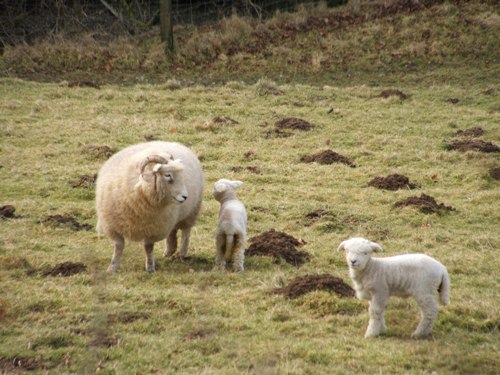 |
Fri, 12 Feb 2010 I'm off to Exmoor tomorrow for a week, to a place with no phone signal or internet connection. I've been watching a film about the Graf Zeppelin airship which travelled around the world in 1928. It's inner workings, engines, steering room etc look like something out of Metropolis (which I believe was released the year before). They flew in luxury, bedrooms and beds, tables, cultery and served meals, a chef and a bedmaker...it was gripping though, the most challenging moments being only just gaining enough height to surmout some Russian mountains, and surviving a storm and disappearing for two days over the pacific. The landscapes were beautiful in the black and white crackly film. I believe large lost chunks of 'Metropolis' (which had been cut after the film flopped on its first release) were found in Argentina. The newly found footage was in poor condition but has been restored using new techniques designed precisely to deal with the depth of damage. I saw metropolis when I was a student at Somerset College of Arts and Technology...made a big impression...two exrtaordinary things to come out of Germany at the same time. I've just read that the new version of Metropolis has had its first release today...what a co-incidence! |
Thu, 11 Feb 2010 Kilvicheoun Beach  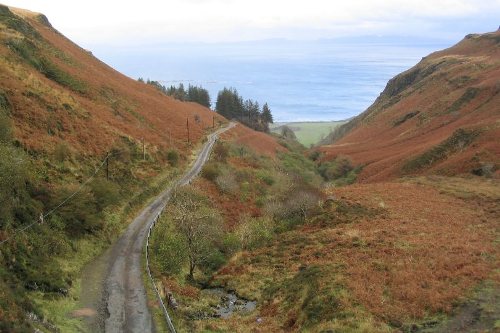 When I was teaching on Mull there were two girls from Shetland working at the same place. They’d never been off Shetland and were amazed by the massive blue skies and warm sunshine further south (they said it always rains on Shetland). We were coming home one day from a trip to Kilvicheoun beach, one of those vast white sandy beaches on the south coast of Mull, it had been unusually hot and sunny even for Mull. In the far distance on the other side of the road we could see what looked like a pony and trap coming towards us which is exactly what it turned out to be, but sitting at the reigns of the trap was the unmistakable Harry Secombe. I thought it was hilarious but the girls were speechless with excitement, there were wide eyes and sharp intakes of breath! They’d never seen a famous person before. It felt like we were moving through a ‘Songs of Praise’ special on the road from Iona to Carsaig. This photo is of the road down to Inniemore Lodge where I was teaching. |
Wed, 10 Feb 2010 I caught sight of this picture as I was searching rapidly through some pictures on google-images. I thought ‘That’s Scotland’ It reminded me of when I was teaching on Mull, at Pennyghael just off the road to Iona. The view south across the water to Jura had a clear light and pine trees too, much like this painting. Actually it wasn’t Scotland after all. It’s a painting called ‘Girl in a Landscape’ by an American artist, Fairfield Porter, who painted on Long Island and in Maine. Although I was wrong this time, I think we all have an inner hard-wiring for landscape recognition. When I was 18 I travelled from New York to Denver on a train. It took three days and, apart from the nights, I spent practically every minute at the window taking in the passing landscape. Of course it changed gradually from the green and wooded east, via Philadelphia and Chicago, a gently hilly Iowa and on across the plains of Nebraska to the Rocky Mountains. Almost twenty years later I followed the same route but by road (which parallels the railway) with my family and I was surprised at how much the passing landscape matched my memories of it so exactly. It got me thinking about how important the ‘interpretation’ of landscape must have been to our survival as a species. If you were in the jungle and a puma is hiding in a tree nearby, you need to be interpreting every rustle and shadow or you’ll be his dinner. Try holding your thumb up about four inches from your eye. How does it compare with whatever is twelve feet away? Would you say your thumb looks as big as a door? And yet you know your thumb is NOT as big as a door. If you were in the desert and saw a distant oasis, luckily your brain will interpret the tiny size you see it as, and you’ll understand that it’s big enough to be somewhere you might get a drink. You’ll also understand that ‘green’ might mean sustenance of some sort and you’ll understand that it will take you a certain amount of time to walk to it. I heard yesterday on the radio that to be in the countryside is important for our wellbeing. It gives very positive benefits to troubled people...and I’m thinking... 'did anyone ever think otherwise???’ I’d like to misquote Anthony Gormley who said about art that ‘We ignore the figure at our peril’ and say ‘We ignore landscape at our peril’. 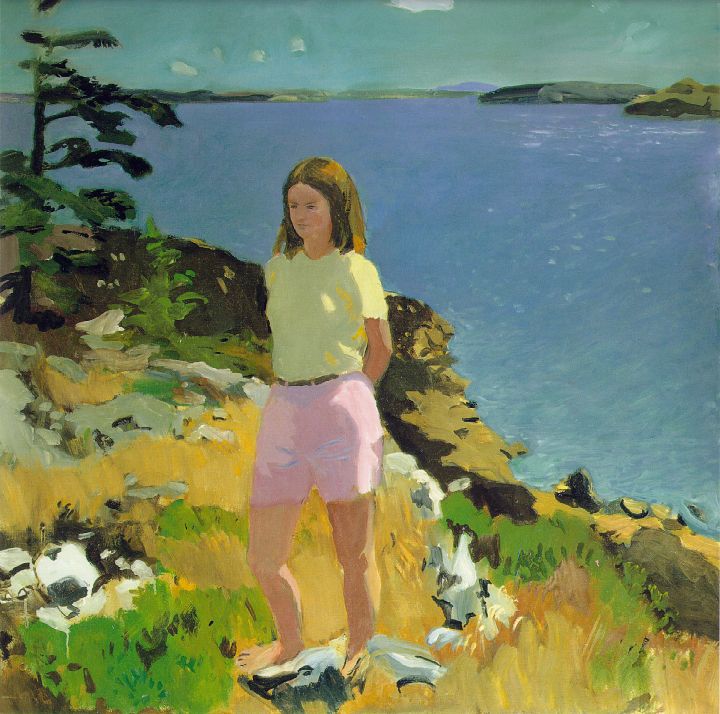 |
Tue, 09 Feb 2010 I'm still working on Jane Seymour. What caught me (and catches me) most about Holbein's portraits are his hard edges and the colour blue he uses in so many portraits. I'm trying to marry the blues, the hard edges, the 'sfumato' painting he uses on faces AND a freer style of painting which I would natually use in my painting ordinarily. I want all these notions to sit together in one painting. It seems I am pushing forward with these techniques and ideas and then 'knocking' the paint-work back a bit. The difficulty is...how far does one go with the looser style of painting? How much do I match the paintwork back in once I've let loose with it? 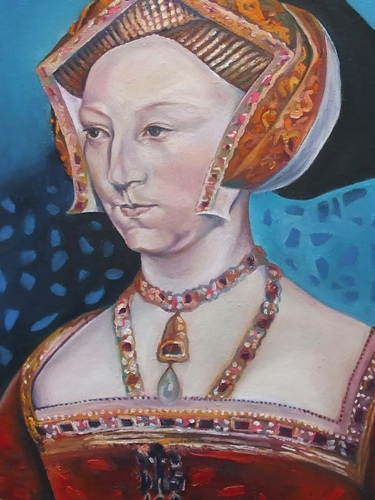 |
Sun, 07 Feb 2010 Here\'s my version of Jane Seymour thus far. I\'m keeping as much control of her face as I can, as near as I can manage to Holbein (its very hard) but I\'m going to go whacky and experimental around the edges and on her dress with colour, texture and freedom. 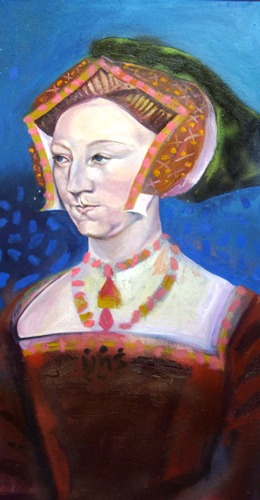 I told Simon this morning about the youngsters who think the Hamed Karzai painting is Darth Vader; he said 'You bring to a painting the World you know'. |
Sat, 06 Feb 2010 A field vole has made his home under the bird feeder behind my shed. When he peeps his little twitching nose out of the undergrowth to have a look around and then darts out to grab the fallen seeds, its impossible not to see him as Beatrix Potter might have done. Sometimes he\'s quite brave and sits for a while, nibbling and washing...until something like a chaffinch comes along which is, by comparison, ENORMOUS! He turns tail and thats the last I see of him for an hour or two. Apparently field voles leave trails along their pathways to repel other voles...but the trails emit UV light which is visible to all the hunting birds...seems a little unfair! 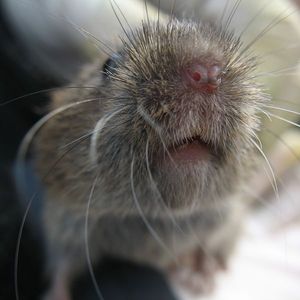 Tony, the manager at the cafe where I hang the political stuff says that, more than once, the youngsters have asked about the bottom picture in the triptych...'Is that Darth Vader?'...Doh! |
Fri, 05 Feb 2010 So...Cherie Blair spares a man jail because of his religion...does that mean that if I thump a man and break his jaw I will go to prison if Cherie is the judge at my court case? Paul Woolley, in support of Cherie says in The Independent today that ‘Cherie Booth was taking into account Mr. Miah’s membership of a faith community. Evidence indicates that belonging to a community reduces the likelihood of reoffending’. Perhaps this suggests that a community as large as a country, any country, even the smallest country, where a person from one end of the country couldn’t possibly know, or feel accountable to, someone from the other end of the country, is too large. Surely we should all reduce our allegiances down to the size of a city-state at most and then we might all feel that we ‘belong’ to a community and therefore both accountable and responsible. The logical conclusion is that Cherie, in handing down this lenient non-sentence, has in one fell swoop negated all the years her husband was Prime Minister of the United Kingdom of Great Britain??!!!! Because it left so many of us in a position where we were unable to ‘belong’ to a community small enough for us to feel ourselves ‘members’, ‘accountable’ or even safe at the hands of our judges??? Phew...I feel better after that! |
Thu, 04 Feb 2010 I have gone one stage further with this painting. You can look at stage three and see how it conforms to the ideas I've been talking about. There are probably two more layers after this one, and the last layer is the moment when the whole image comes together. Watercolour has a perfect logic behind it. You'll see it beautifully practiced in the work of John Sell Cotman. He was able to deal with those long stages of abstraction of shape and tone before his paintings co-alesced into a cohesive image. 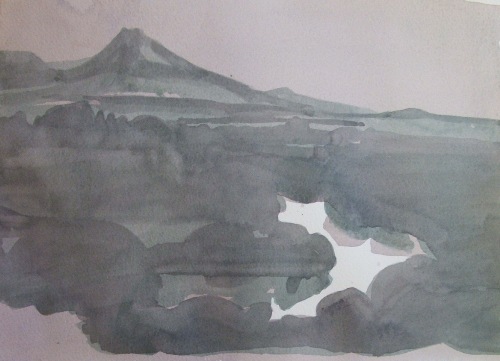 Stage two becomes more tricky. You have to decide where layer two must go and where it must not go...in other words...what shapes and areas do you 'reveal' with the next layer of paint. 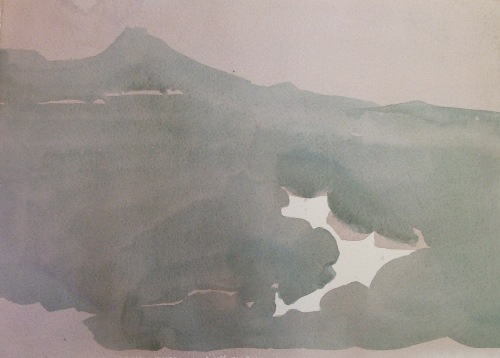 This is Claude Lorrain stage one. All I have done with this first layer of paint is \'reveal\' the lightest place. Every other area has \'tone\' and therefore needs to take some of this first layer. 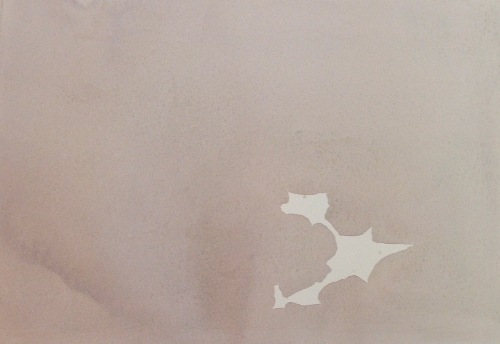 In class we've been looking at watercolour again. The counter-intuitive way of thinking needed is always a challenge even for my veteran students...and for myself too. I have to remind myself of the process of watercolour painting every time I use it. Look at this Claude Lorrain watercolour painting. Ask yourself about the shapes and positions of the lightest places. The point about watercolour is that you cannot 'paint' a light place, you can only 'reveal' it by painting around it. I am also going to post what I consider the first two stages of Claude Lorrain's watercolour might have looked like. 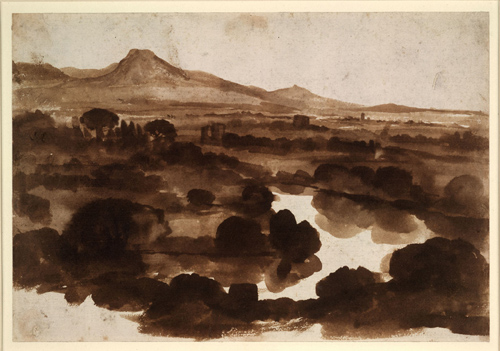 |
Wed, 03 Feb 2010 And now look at this equally marvellous head by Frank Auerbach, with equally subtle and complex tonal changes across the surface of the face. 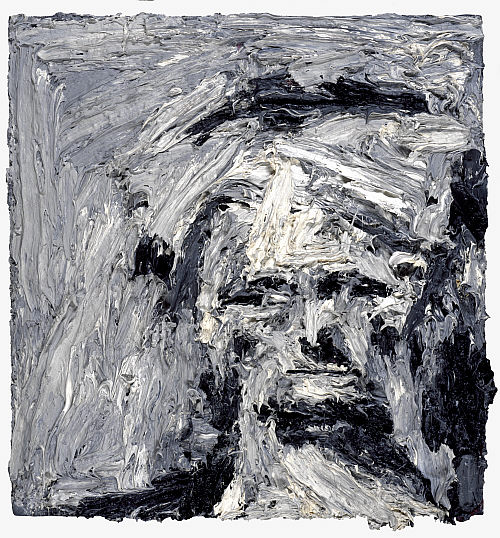 |
Tue, 02 Feb 2010 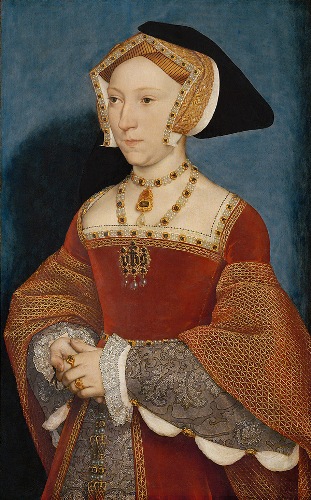 I've been looking at this Holbein painting of Jane Seymour...for two reasons. Firstly I think Holbein was a master of 'edge' and 'edge' is one of my five fundamental elements of painting. Edges come both 'hard' and 'soft' and amazing examples of both exist on this painting. The egde between Jane and her background is a 'hard' edge. Either side of that edge the tones contrast enough for the edge to show clearly. You can see that Holbein even changed the background blue to contrast differently with the figure, on the left Jane's sleeve is lighter than the background but on the right it is the background which is lighter than the sleeve. Much much more subtle edges exist on Jane's face. It might look like it's one rather bland tone but close up you can see the softest change from one subtle tone to another all across her face. Her face is a collection of soft-edged close-toned shapes. My second reason for looking at this painting is in defernce to our history teacher. She told us that Henry had 'really loved' Jane Seymour; he had wanted so much to 'show her off' after the birth of their son that he insisted she get up and dressed to be presented to the court too soon after giving birth. She was more ill than Henry realised. She probably died of a haemorrhage about two weeks later and it was several years before Henry married again. He buried her in the tomb he'd been preparing for himself and so he is now buried there with her. I am (along with many others who have done so in the past) painting my own version, its more a case of 'Looking for Jane Seymour' rather than a straight copy. She was rumoured to have a 'calm and gentle demeanor', but most Holbein paintings give that feeling. Its that same feeling I'm looking for with my own version, plus the same complexities and subtleties with 'edge'. |
Sun, 31 Jan 2010 I hardly dare say what I\'ve been given today, I\'m so grateful. I have a raven in my freezer which was found dead out on The Cranborne Chase. I\'m caught in that between-world where I can preserve it but not look at it, or look at it but not preserve it. I shall have to hope that the temp in my shed remains below zero for a couple of hours tomorrow (not unusual!) 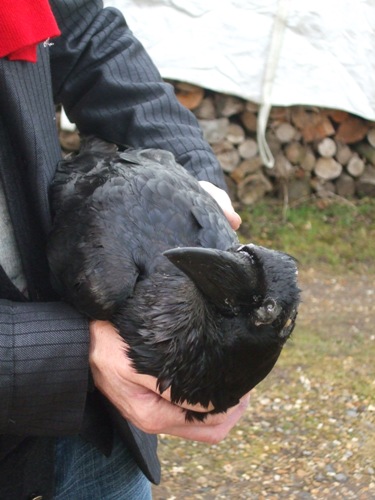 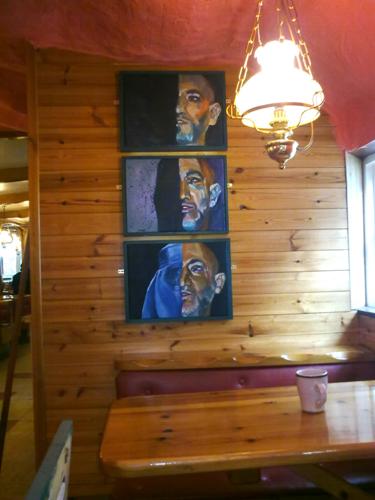 I've been to my local cafe thismorning. There's a space set aside for me to hang political stuff which I appreciate very much. The cafe ought to have a preservation order placed on it, its built like cave on the inside and painted orange; in fact it's like sitting in a tonsil, must have been designed in the 70s. I've put up the Hamed Karzai triptych. He presides over a country where half the population are covered up, invisible, and that same half of the population need two of themselves in order to witness a legal document or testify and be heard in a court of law. So I've decided anyone who presides over that kind of a country must only be half a person, and live only a half life.. I tried to stuff him fully under a burqa but then I realised we wouldn't know who he is so in the third piece he's half under the burqa. I've been so excited waiting for 'Sunday' on radio 4, Ed Stourton has moved in to the place of Roger Bolton. I really like Roger Bolton and have loved the presenting he's done but, after Nick Clarke (who prsented 'the world at one'and died of cancer in 2006) and who was the monarch of presenting, Ed Stourton comes a very close second. Ed Stourton is a complete gentleman who gets the absolute best out of his interviewees with quiet respect and not a single bit of ear-bashing. There was a very funny line thismorning when they were discussing the merits (or not) of lying. The interviewee said to Ed 'If you were my wife and you asked me 'Does this dress make me look fat' would I reply 'Absolutely not darling, it's your fat that makes you look fat'...?' |
Sat, 30 Jan 2010 "There is a marvellous peace in not publishing. It's peaceful. Still.." J.D. Salinger. Perhaps more extreme than necesary but I am constantly telling my students not to have a 'viewer' in mind as they paint. A 'viewer' might be dictating their painting to them rather than their own thoughts, desires and responses. A chunk of my job as their teacher is to swing their aspirations away from wanting to create something 'competent' to wanting to search their own souls to discover what it is they DO want to paint and then to give them some facility with various media to help them do just that. Today is a wonderful day, full of sunlight and birds on the bird table. I\'m in my shed laughing because I can always tell when the woodpecker visits the birdtable...I hear \'bangbangbang\' and there he is attacking the birdfat. The sparrows fling stuff everywhere and the greenfinches eat in a gentle and considered way, by far the best manners. I\'ve put some of Simon\'s bread out too and the rooks love that... Rook on the fence behind my shed. 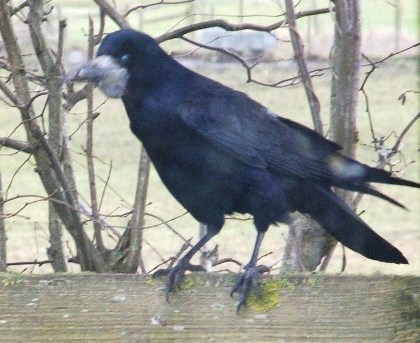 |
Fri, 29 Jan 2010 I think Aunt Peggy and Uncle Hugh's marriage was very much a partnership of equals unusual at that time. There was a long driveway leading to where they lived and one time Kate and I were in the car with Aunt Peggy heading down the drive and Uncle Hugh was driving up the other way. There was more than enough time for them to avoid each other but instead they bumped into each other. Aunt Peggy got out of the car and said 'Hugh, you should have gone into the hedge', to which he replied 'Nonsense Peggy, you should have gone into the ditch'. Photographs are so evocative. I can remember the moment that the photo below was taken. I had asked my twin sister to take the picture and someone else to stand over to the right (of me) so that Novio would look around me at what was going on. Our own memories are the fabric of what we are, and having a photo to jog that memory is, I suppose, why we take them. I imagine someone set up the photo of Aunt Peggy and Uncle Hugh in the same way, and although I wasn't there I'm certainly glad to have the photo...I was very fond of Aunt Peggy (and Uncle Hugh too), she was funny, opinionated and keen to find out what the modern world was about into her nineties (when she died). My sister and I would be put on a plane at Heathrow and sent over during the summer holidays to stay with them from quite a young age (7yrs old I think). There was a lake to swim in and always horses to ride and the Dublin Horse Show to visit. |
Thu, 28 Jan 2010 And now an indulgence, my favorite picture of me aged 17 with a horse called Novio...hmmmmm...he was lovely. 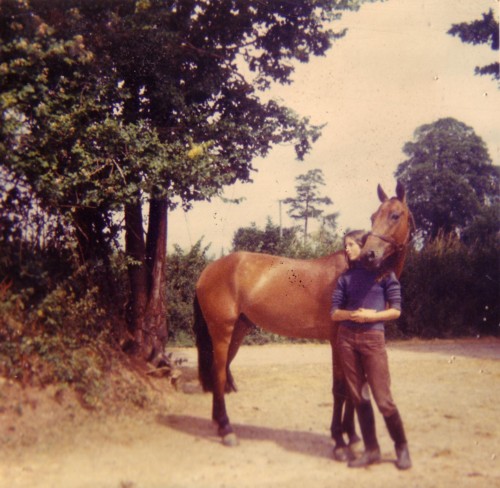 Uncle Hugh and Aunt Peggy 1931 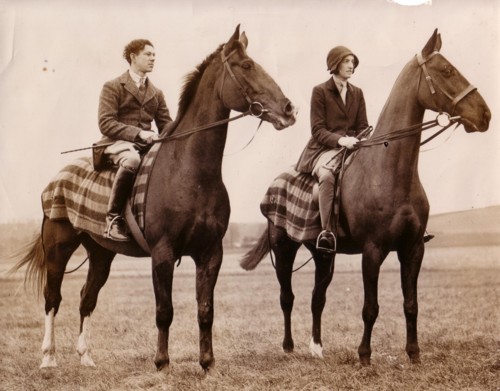 Here is one of the paintings from our recent study of Van Gogh and old boots. These were painted by Norah. Norah grew up in Ireland, and as a girl she was given a pony by my great aunt and Uncle which she says changed ger life. The pony was called Merrilegs. It was something she and I had no idea about until one day when I took in an old photo of my aunt and uncle on horses. My aunt had been top racing trainer in Ireland for four years running but had to do it in Uncle Hugh\'s name as women were not allowed to be trainers. Later I\'ll scan the photo of aunt Peggy and uncle Hugh and post it here. Norah\'s father had been the local doctor and the hunt doctor. They all hunted together. 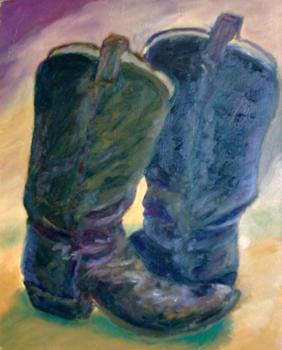 This photo was taken with my phone camera -excuse the quality. |
Tue, 26 Jan 2010 Yesterday was not an easy day in my shed...everything went wrong. It was one of those days when the mood is \'why the hell did I think I could do this?\'. Howevever, it seems that yesterday was set up to support today. That doesn\'t mean one can be complacent. There\'s nothing to ensure that great things emerge today, its just that moments of \'possibility\' are recognisable where they definitely were not yesterday. Here is my shed in the snow this winter.  |
Sun, 24 Jan 2010 Here are four of them...then my camera battery ran out. 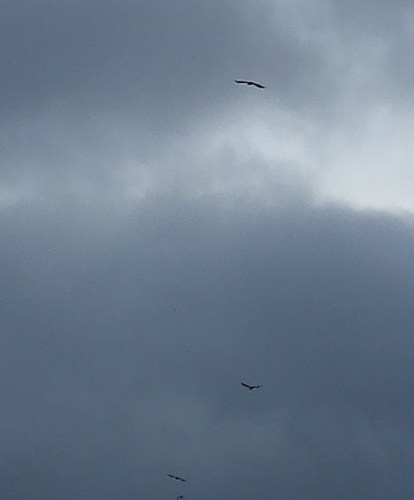 I went over to Chris's today to watch the ravens. Every evening at about 5pm they head to a certain barn, Chris says it can be over 100 sometimes. They sort of saunter across the sky in twos and threes, grumbling and croaking at each other with an occasional display of dual acrobatics. They are the crucifixes of the sky, great black crosses but far too chatty to be really ominous. I've been working on these dream like paintings again.Thery are all based on drawings of real places but have taken on their own enigma. I think I'll call them the 'Nocta Lucca' set, I heard those words last night. Its difficult naming paintings, it doesn't always feel straight forward. One of my teachers was John Hoyland, he said that he used to call all his work 'untitled' with a reference number but he could never remember which was which when referring to them so he began to name in order to make reference. He said the names didn't mean anything, but its a little like naming your children. You wouldn't 'reference-number' your children, you wouldn't give them a name you didn't like, naming something is meaningful whether you intend it or not. |
Sat, 23 Jan 2010 The first snowdrops are up behind my shed under the ash tree...always a good sign. I've been working on paintings with a very dream-like quality to them and its probably a reaction to the cold, dark,blanket grey of the skies at the moment. My edges are soft and my colours orange! |
Thu, 21 Jan 2010 So today in class we were looking at ways of drawing with pencil. From the moment you walk into your first class in school, and in fact before then, its probable that you've been using line and almost exclusively line unless you've been encouraged to do otherwise. Today 'outline' was discouraged. Line was only encouraged as 'hatched' line. I asked for 'fluid' hatching, making large areas of shadow indicative of the subject they were looking at (old boots!). I asked them also to use an eraser to carve back into the hatched area to begin to sculpt the shapes of the boots. It became a conversation between the pencil and the eraser, gradually the pencil marks and shapes becoming darker and more detailed and the light places revealed with the eraser. Some great pieces were produced. At the moment there's a glitch uploading pictures to this blog, as soon as its sorted out I'll upload some of my students' work. |
Wed, 20 Jan 2010 I’ve been teaching watercolour painting to adults and children for 25 years. It is both a lovely moment and a relief when my students begin to ‘see the light’. Watercolour is a challenge. To use it successfully you must switch your way of thinking to something which is so counter-intuitive as to seem outrageous initially but will eventually be the bedrock of your way of seeing in every medium you use. Once you are using it, it will affect every part of your life, a big claim for a seemingly unassuming medium. I have had some students walk out of a class in their frustration and inability to take on board the notion that with watercolour you can't paint a 'light' place, you have to 'reveal' a light place by painting around it. It means that you have to be as conscious of the shapes you do not paint as you are of the shapes you do paint. |
Tue, 19 Jan 2010 I wrote to the paper today, sometimes they publish it sometimes they don't...as follows Sir: I hope and think that David Baddiel's film will be very interesting (Baddiel courts controversy with a film about 'Muslim Jew'. 'Race' is a non-description of anyone I contend. When I was last in Jordan I met a mother and daughter. The mother was telling me that her parents were a Jewish Zionist settler and a Muslim Palestinian boxer. They married in 1947 and were disowned by their respective families. In 1948 they were put in prison and then freed on condition they 'went away'. 'Went away' meant going east and for the wife to live as a Muslim. Presumably the mother and daughter I met may return to Israel under the law of return, they are both Jewish being daughters of Jewish mothers. 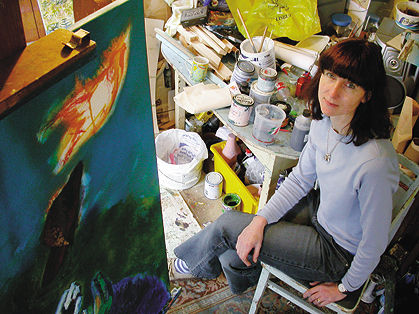 Last September in an open exhibition I won a prize with money attached and one of the things I bought myself was a net book...The idea is that I have a line of banter via my website about the painting and teaching that I'm doing. Its in its nascent stages, there may be hiccoughs, but if you tune in here you might find enlightenment and there again you might not! |
clare.shep@btinternet.com
Back to home